
Date: 2019-12-26 18:30:06 CET, cola version: 1.3.2
Document is loading... 
First the variable is renamed to res_list.
res_list = rl
All available functions which can be applied to this res_list object:
res_list
#> A 'ConsensusPartitionList' object with 24 methods.
#> On a matrix with 4116 rows and 72 columns.
#> Top rows are extracted by 'SD, CV, MAD, ATC' methods.
#> Subgroups are detected by 'hclust, kmeans, skmeans, pam, mclust, NMF' method.
#> Number of partitions are tried for k = 2, 3, 4, 5, 6.
#> Performed in total 30000 partitions by row resampling.
#>
#> Following methods can be applied to this 'ConsensusPartitionList' object:
#> [1] "cola_report" "collect_classes" "collect_plots" "collect_stats"
#> [5] "colnames" "functional_enrichment" "get_anno_col" "get_anno"
#> [9] "get_classes" "get_matrix" "get_membership" "get_stats"
#> [13] "is_best_k" "is_stable_k" "ncol" "nrow"
#> [17] "rownames" "show" "suggest_best_k" "test_to_known_factors"
#> [21] "top_rows_heatmap" "top_rows_overlap"
#>
#> You can get result for a single method by, e.g. object["SD", "hclust"] or object["SD:hclust"]
#> or a subset of methods by object[c("SD", "CV")], c("hclust", "kmeans")]
The call of run_all_consensus_partition_methods() was:
#> run_all_consensus_partition_methods(data = m, mc.cores = 4, anno = anno, anno_col = anno_col)
Dimension of the input matrix:
mat = get_matrix(res_list)
dim(mat)
#> [1] 4116 72
The density distribution for each sample is visualized as in one column in the following heatmap. The clustering is based on the distance which is the Kolmogorov-Smirnov statistic between two distributions.
library(ComplexHeatmap)
densityHeatmap(mat, top_annotation = HeatmapAnnotation(df = get_anno(res_list),
col = get_anno_col(res_list)), ylab = "value", cluster_columns = TRUE, show_column_names = FALSE,
mc.cores = 4)
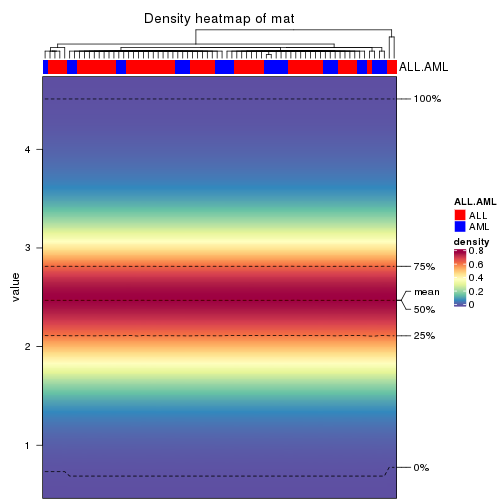
Folowing table shows the best k (number of partitions) for each combination
of top-value methods and partition methods. Clicking on the method name in
the table goes to the section for a single combination of methods.
The cola vignette explains the definition of the metrics used for determining the best number of partitions.
suggest_best_k(res_list)
| The best k | 1-PAC | Mean silhouette | Concordance | Optional k | ||
|---|---|---|---|---|---|---|
| ATC:kmeans | 2 | 1.000 | 0.982 | 0.992 | ** | |
| ATC:NMF | 2 | 0.972 | 0.927 | 0.973 | ** | |
| ATC:skmeans | 3 | 0.961 | 0.932 | 0.973 | ** | 2 |
| MAD:skmeans | 3 | 0.866 | 0.872 | 0.946 | ||
| CV:skmeans | 3 | 0.837 | 0.857 | 0.938 | ||
| MAD:mclust | 2 | 0.824 | 0.927 | 0.932 | ||
| SD:skmeans | 3 | 0.745 | 0.836 | 0.918 | ||
| CV:kmeans | 3 | 0.739 | 0.864 | 0.901 | ||
| MAD:NMF | 2 | 0.680 | 0.811 | 0.925 | ||
| SD:kmeans | 2 | 0.662 | 0.836 | 0.911 | ||
| MAD:pam | 2 | 0.651 | 0.824 | 0.925 | ||
| SD:mclust | 5 | 0.634 | 0.721 | 0.790 | ||
| SD:NMF | 2 | 0.633 | 0.823 | 0.928 | ||
| CV:NMF | 2 | 0.633 | 0.787 | 0.916 | ||
| MAD:kmeans | 2 | 0.623 | 0.805 | 0.904 | ||
| ATC:pam | 2 | 0.597 | 0.808 | 0.918 | ||
| ATC:hclust | 2 | 0.574 | 0.813 | 0.911 | ||
| SD:pam | 2 | 0.548 | 0.686 | 0.876 | ||
| CV:pam | 2 | 0.546 | 0.784 | 0.904 | ||
| CV:mclust | 2 | 0.489 | 0.908 | 0.895 | ||
| ATC:mclust | 2 | 0.360 | 0.711 | 0.828 | ||
| SD:hclust | 2 | 0.236 | 0.777 | 0.851 | ||
| MAD:hclust | 2 | 0.227 | 0.737 | 0.838 | ||
| CV:hclust | 2 | 0.214 | 0.570 | 0.805 |
**: 1-PAC > 0.95, *: 1-PAC > 0.9
Cumulative distribution function curves of consensus matrix for all methods.
collect_plots(res_list, fun = plot_ecdf)
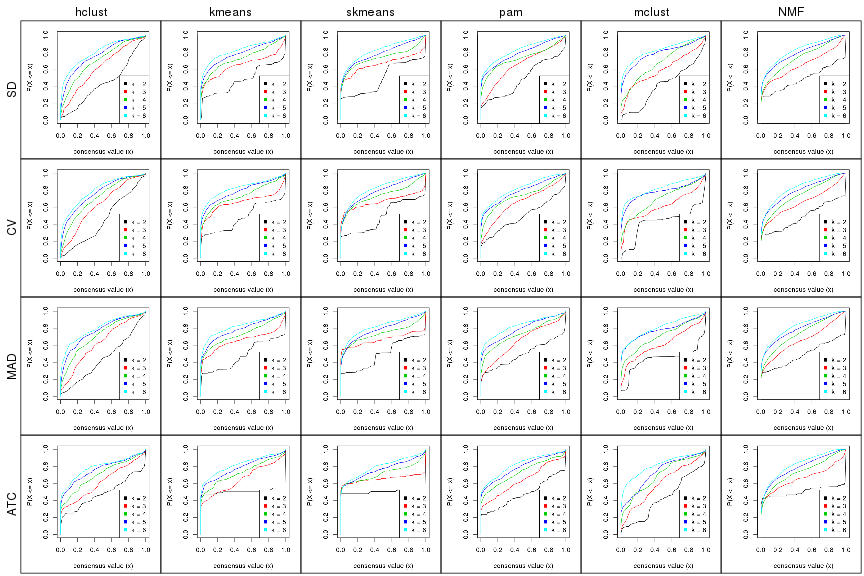
Consensus heatmaps for all methods. (What is a consensus heatmap?)
collect_plots(res_list, k = 2, fun = consensus_heatmap, mc.cores = 4)
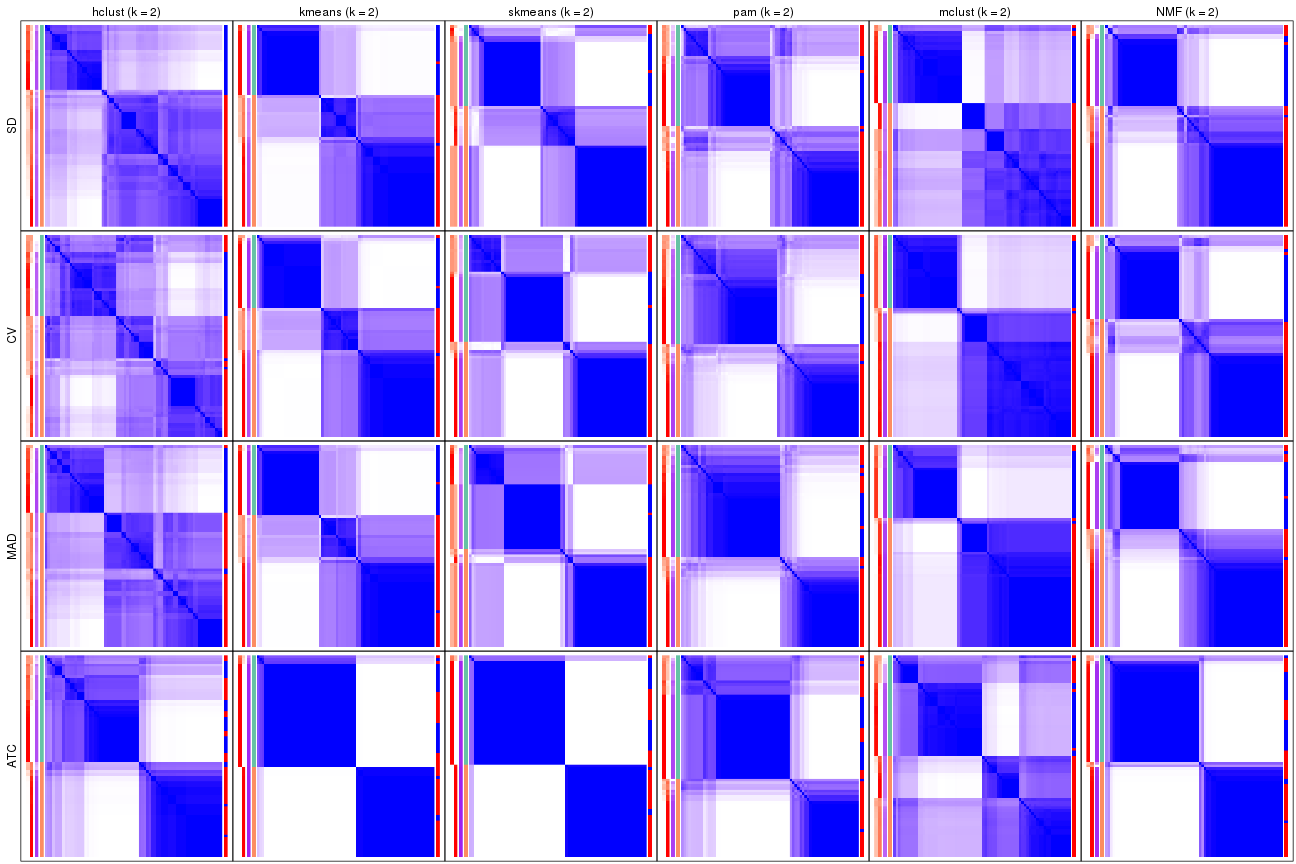
collect_plots(res_list, k = 3, fun = consensus_heatmap, mc.cores = 4)
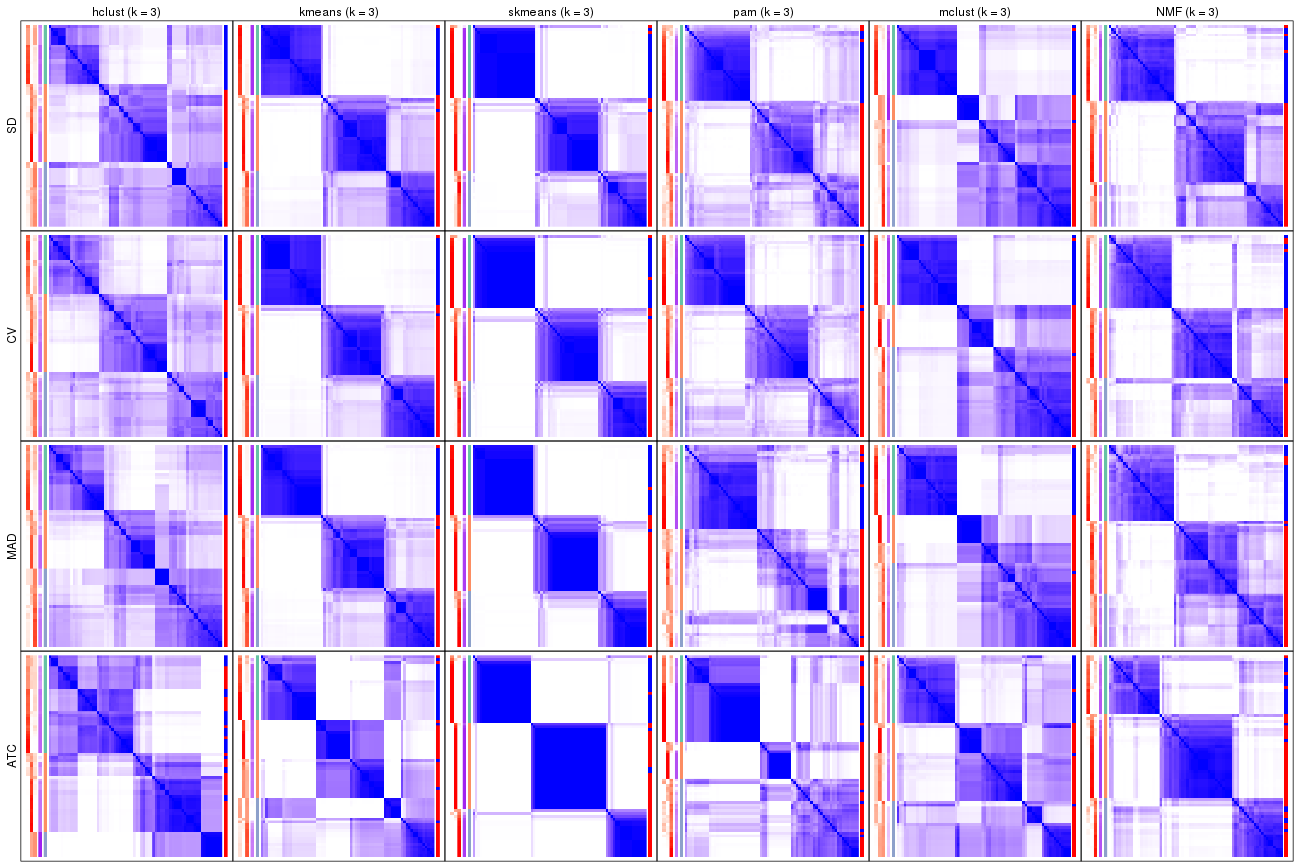
collect_plots(res_list, k = 4, fun = consensus_heatmap, mc.cores = 4)
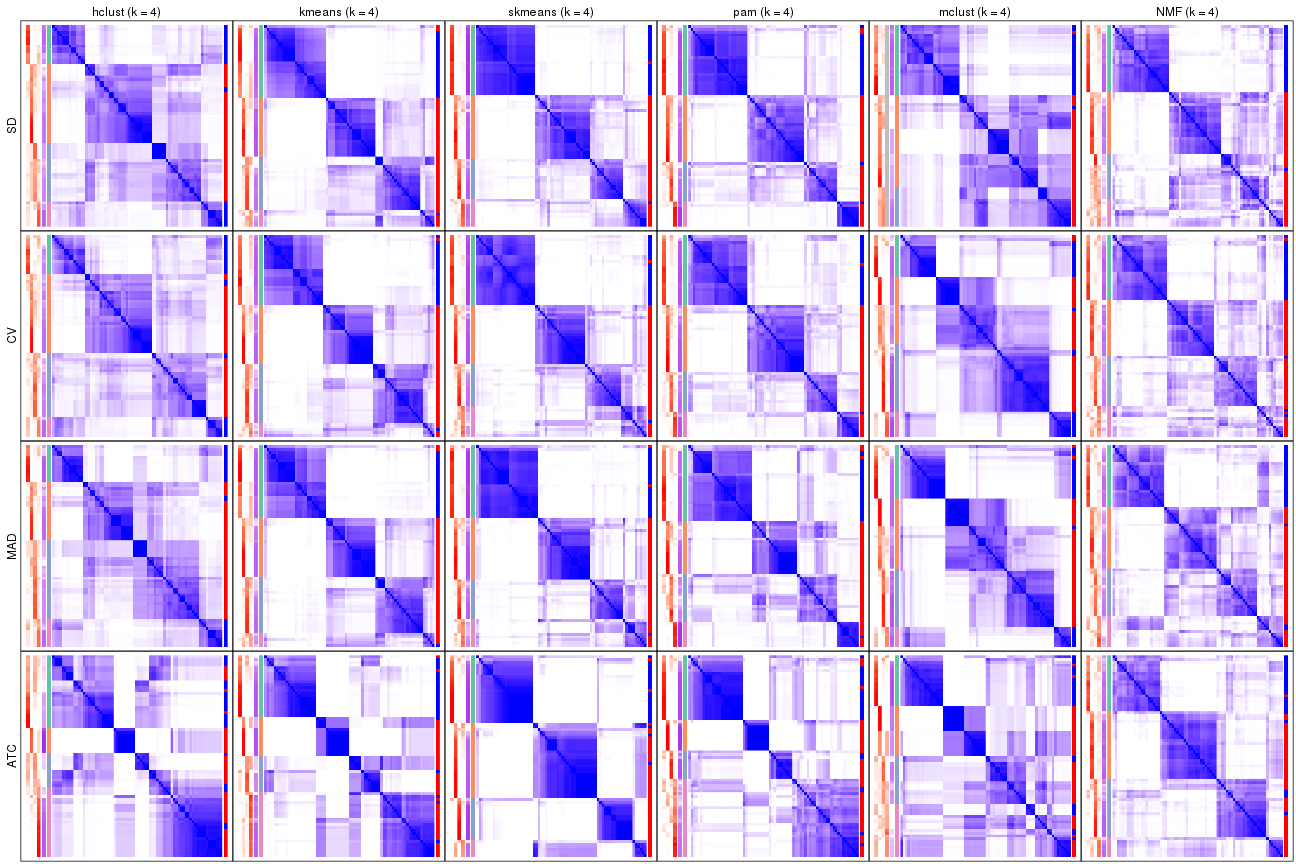
collect_plots(res_list, k = 5, fun = consensus_heatmap, mc.cores = 4)
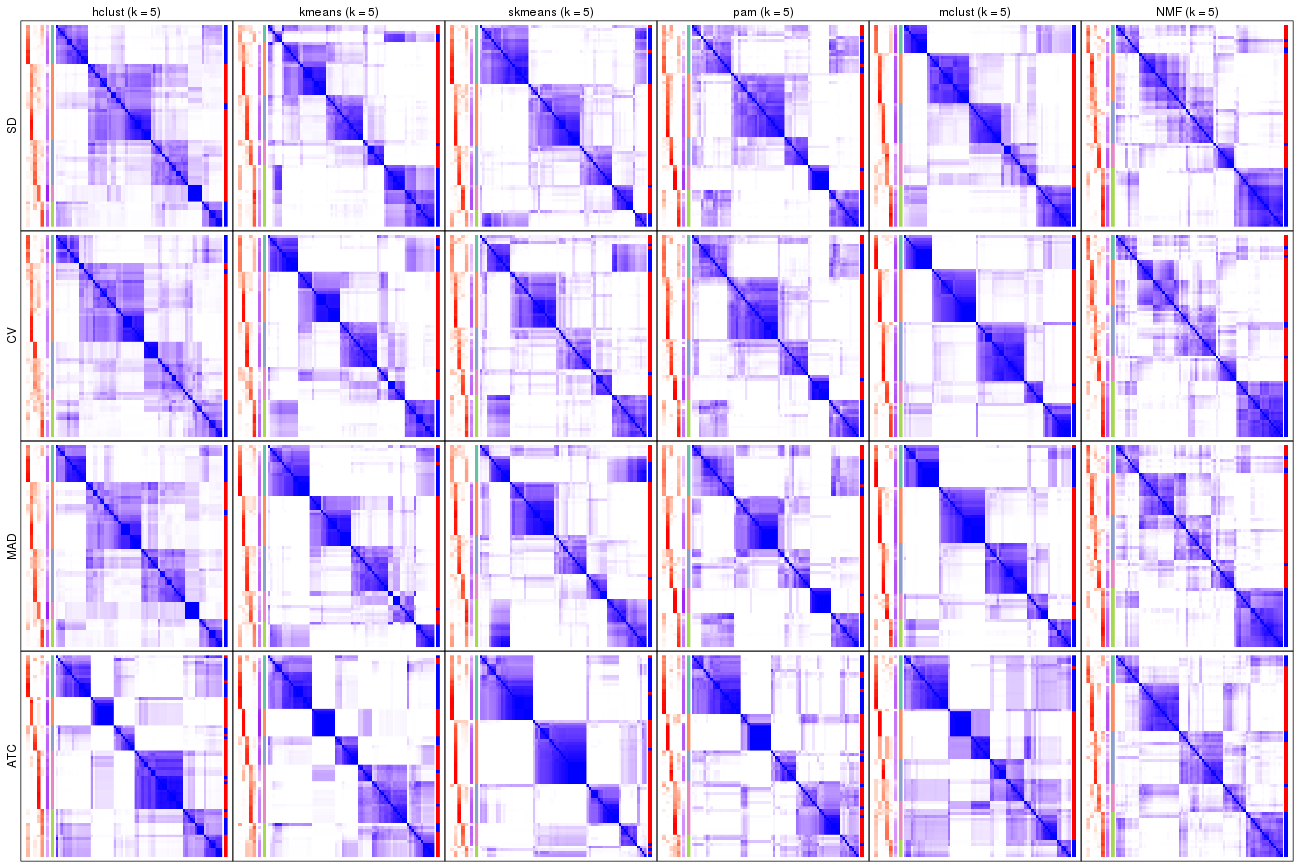
collect_plots(res_list, k = 6, fun = consensus_heatmap, mc.cores = 4)
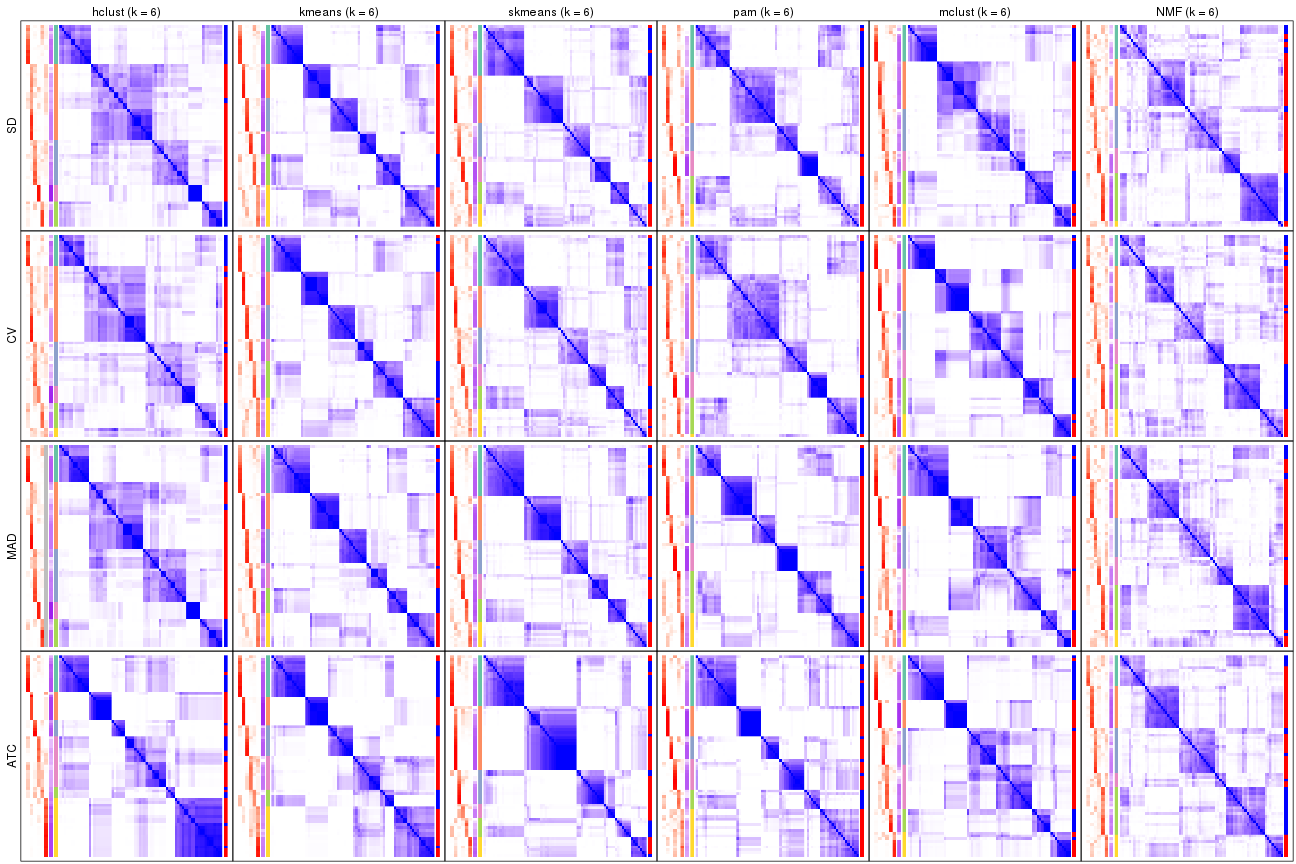
Membership heatmaps for all methods. (What is a membership heatmap?)
collect_plots(res_list, k = 2, fun = membership_heatmap, mc.cores = 4)
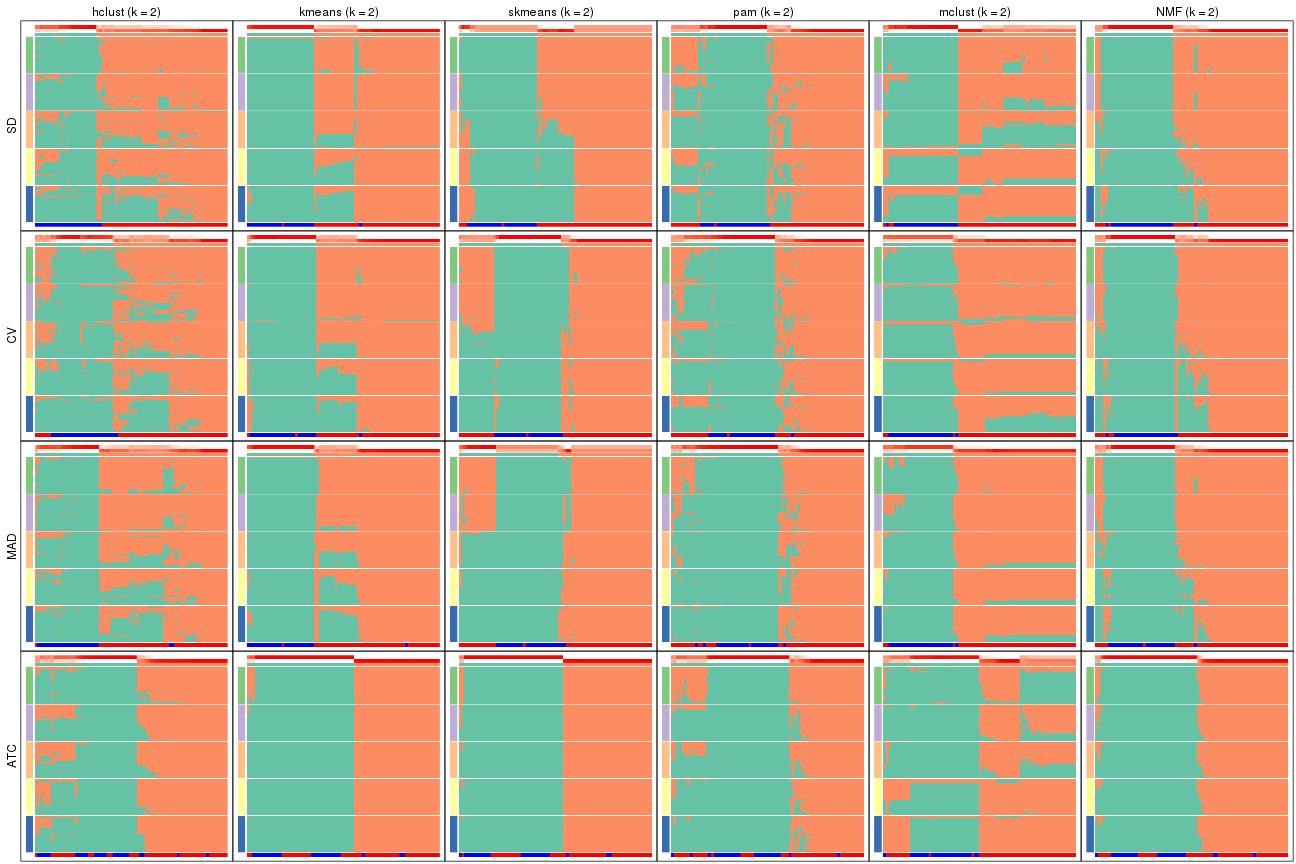
collect_plots(res_list, k = 3, fun = membership_heatmap, mc.cores = 4)
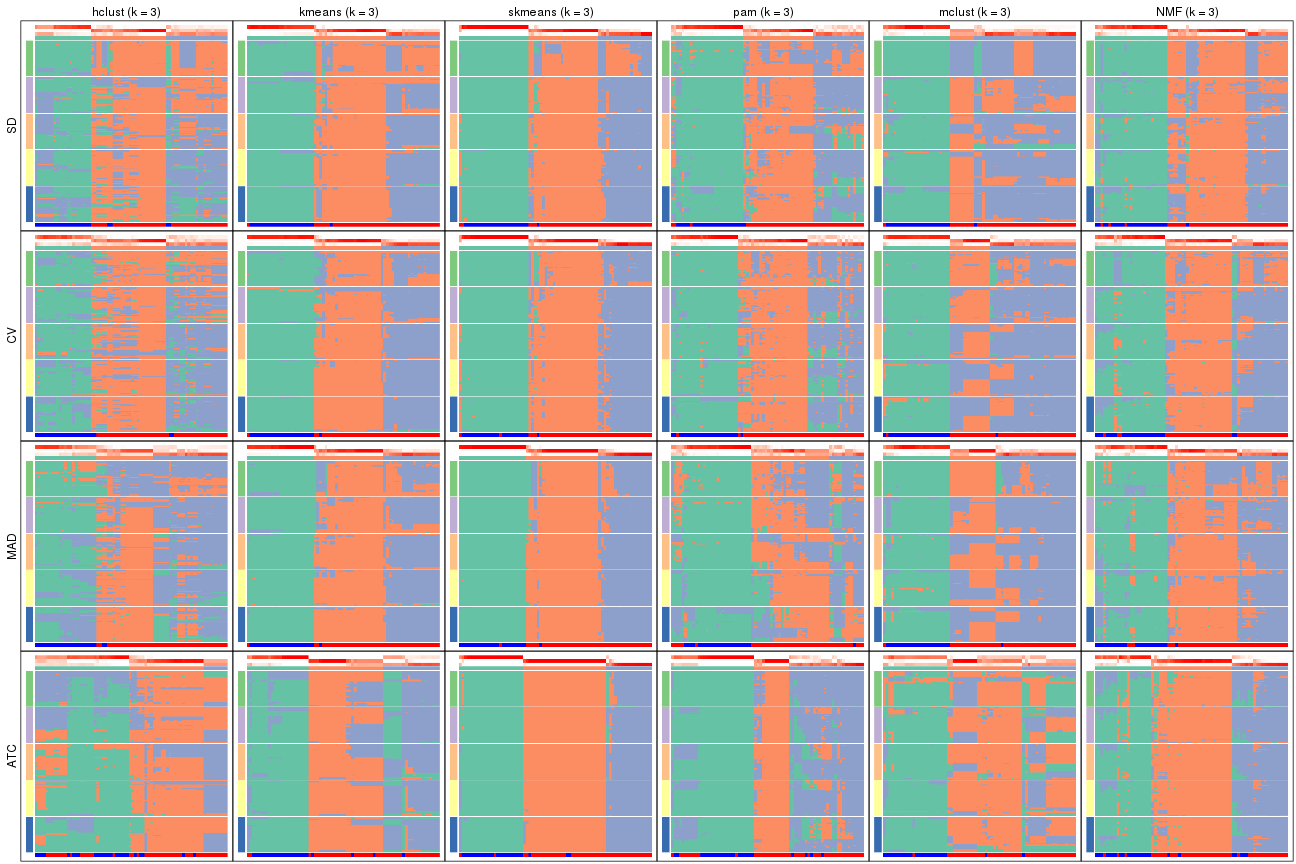
collect_plots(res_list, k = 4, fun = membership_heatmap, mc.cores = 4)
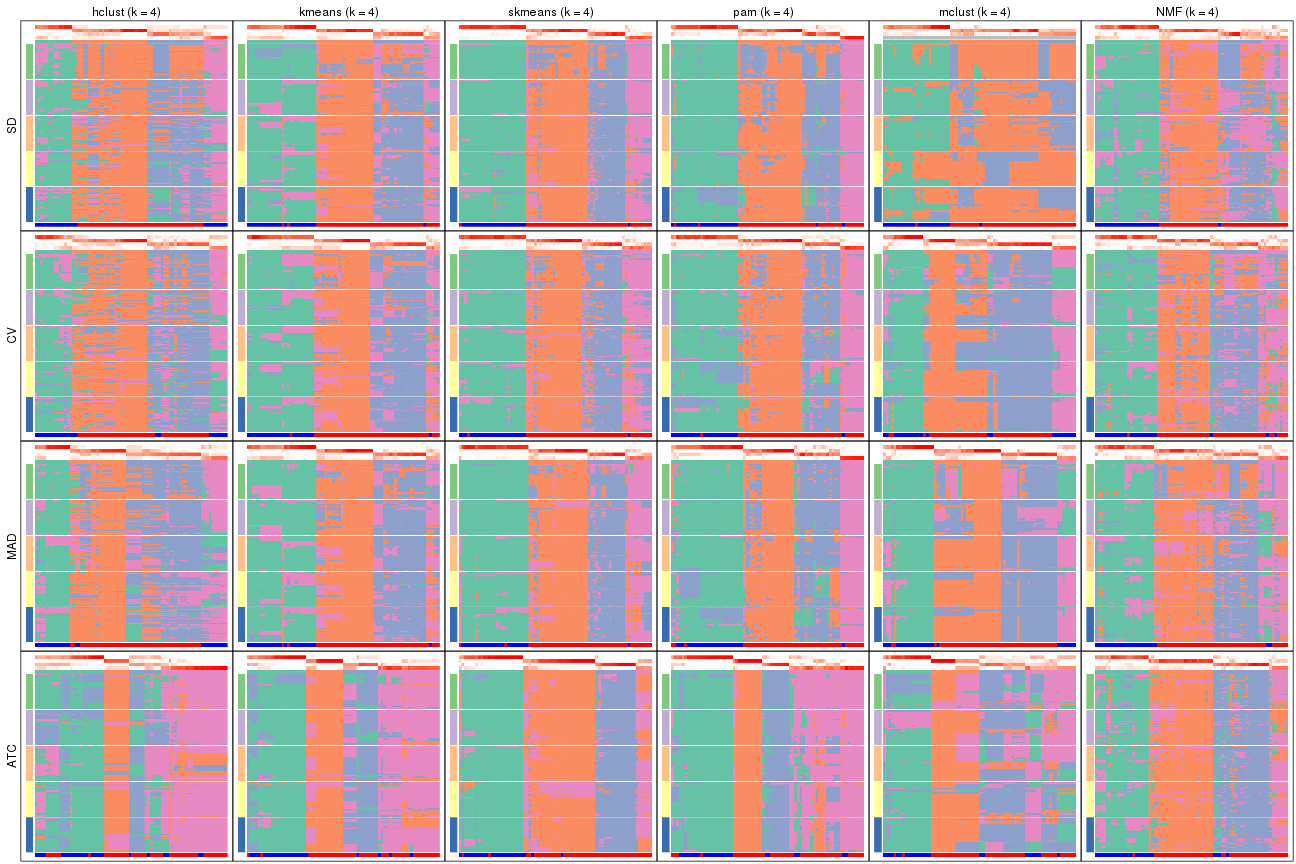
collect_plots(res_list, k = 5, fun = membership_heatmap, mc.cores = 4)
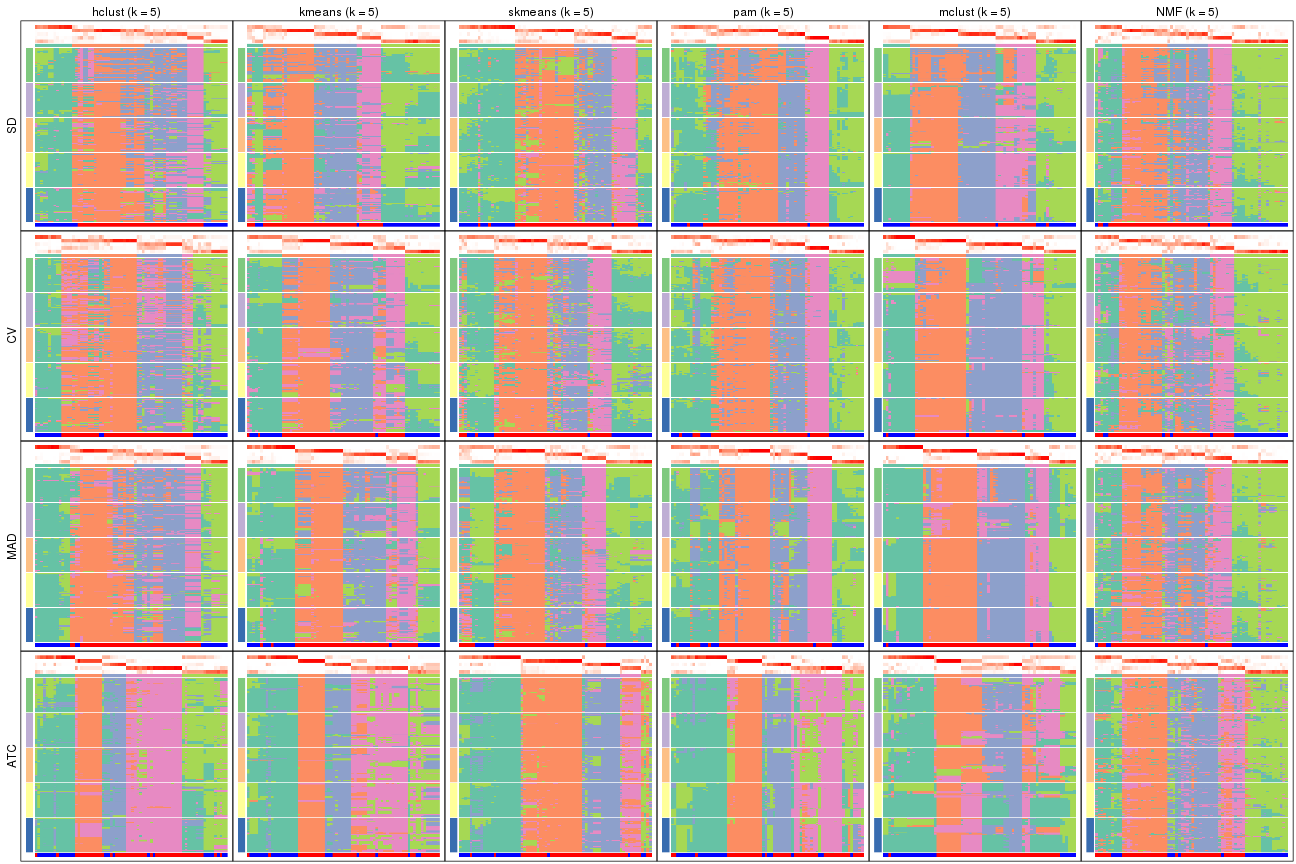
collect_plots(res_list, k = 6, fun = membership_heatmap, mc.cores = 4)
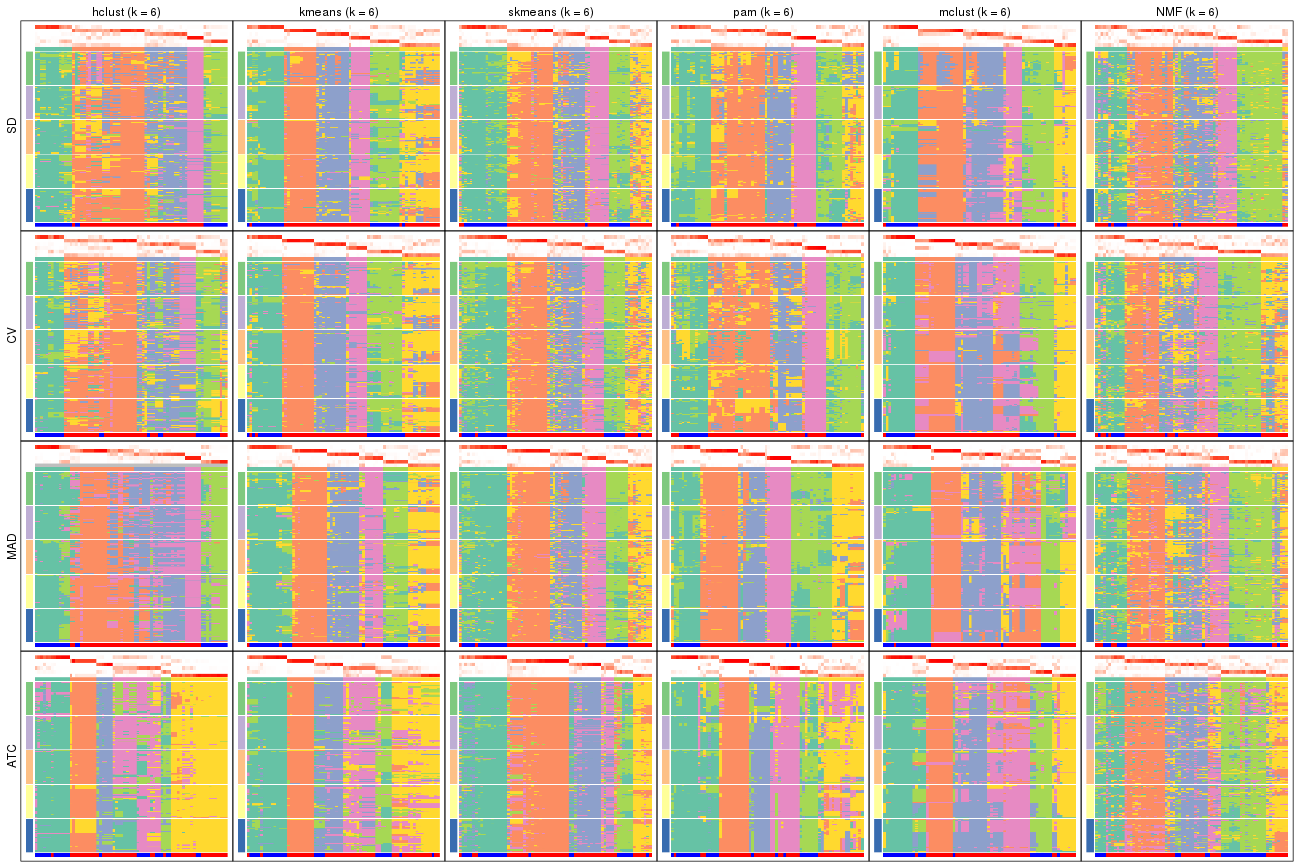
Signature heatmaps for all methods. (What is a signature heatmap?)
Note in following heatmaps, rows are scaled.
collect_plots(res_list, k = 2, fun = get_signatures, mc.cores = 4)
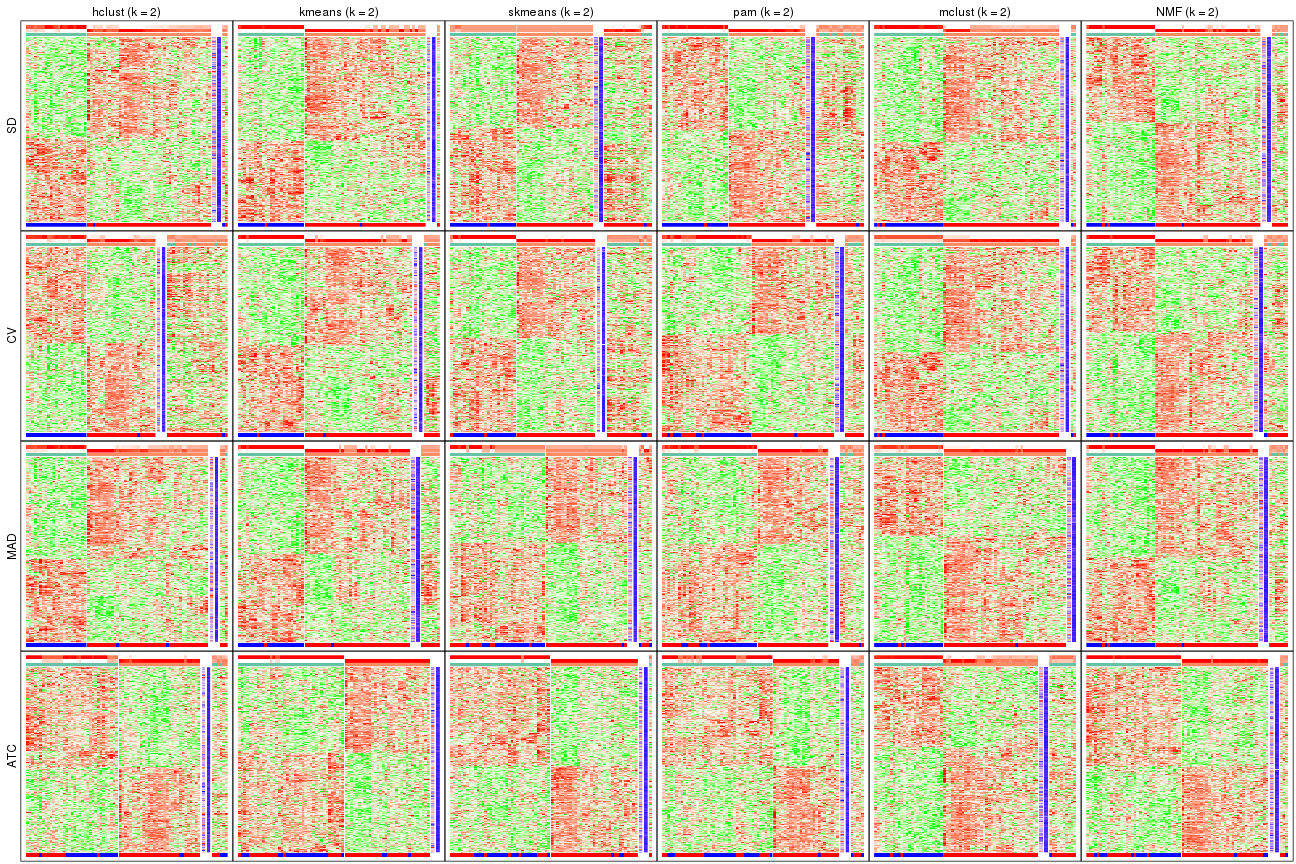
collect_plots(res_list, k = 3, fun = get_signatures, mc.cores = 4)
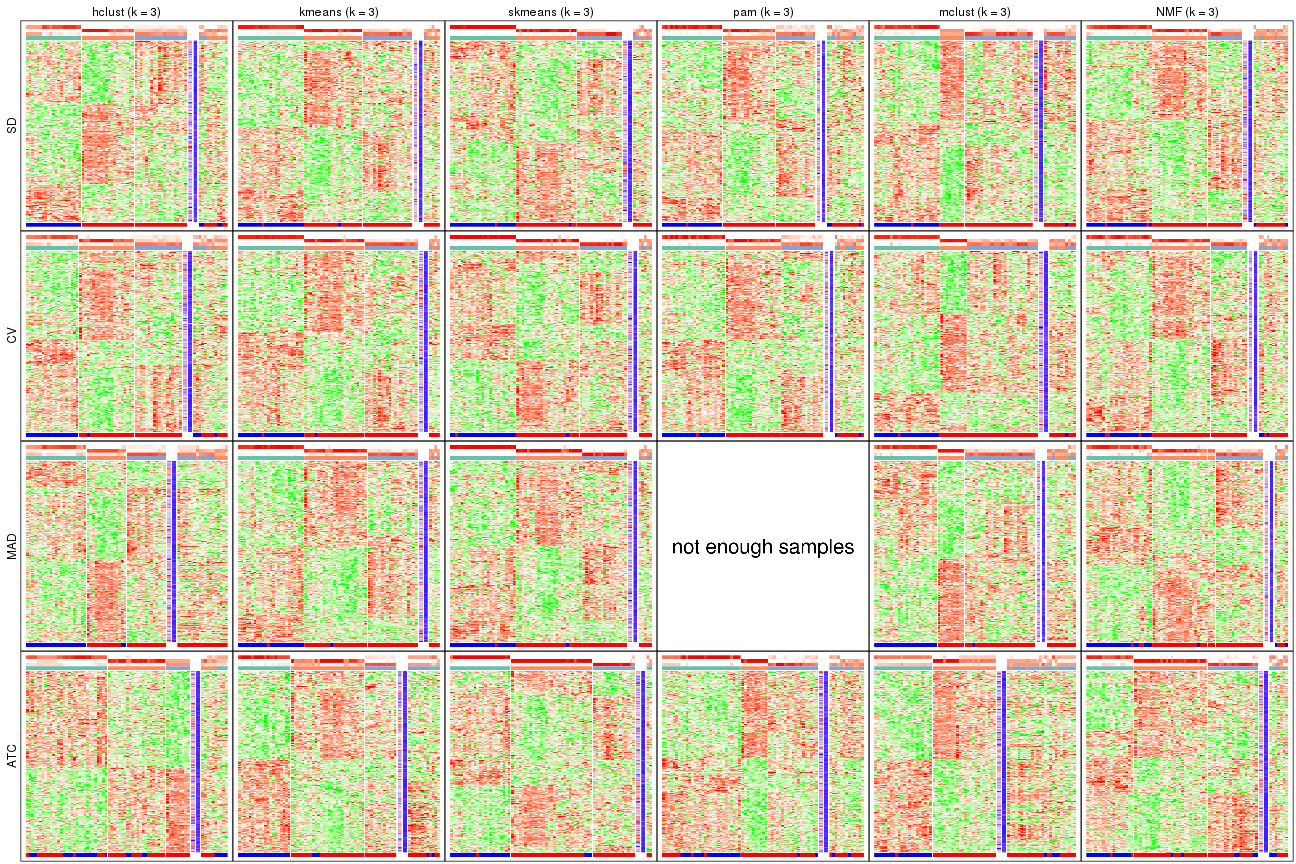
collect_plots(res_list, k = 4, fun = get_signatures, mc.cores = 4)
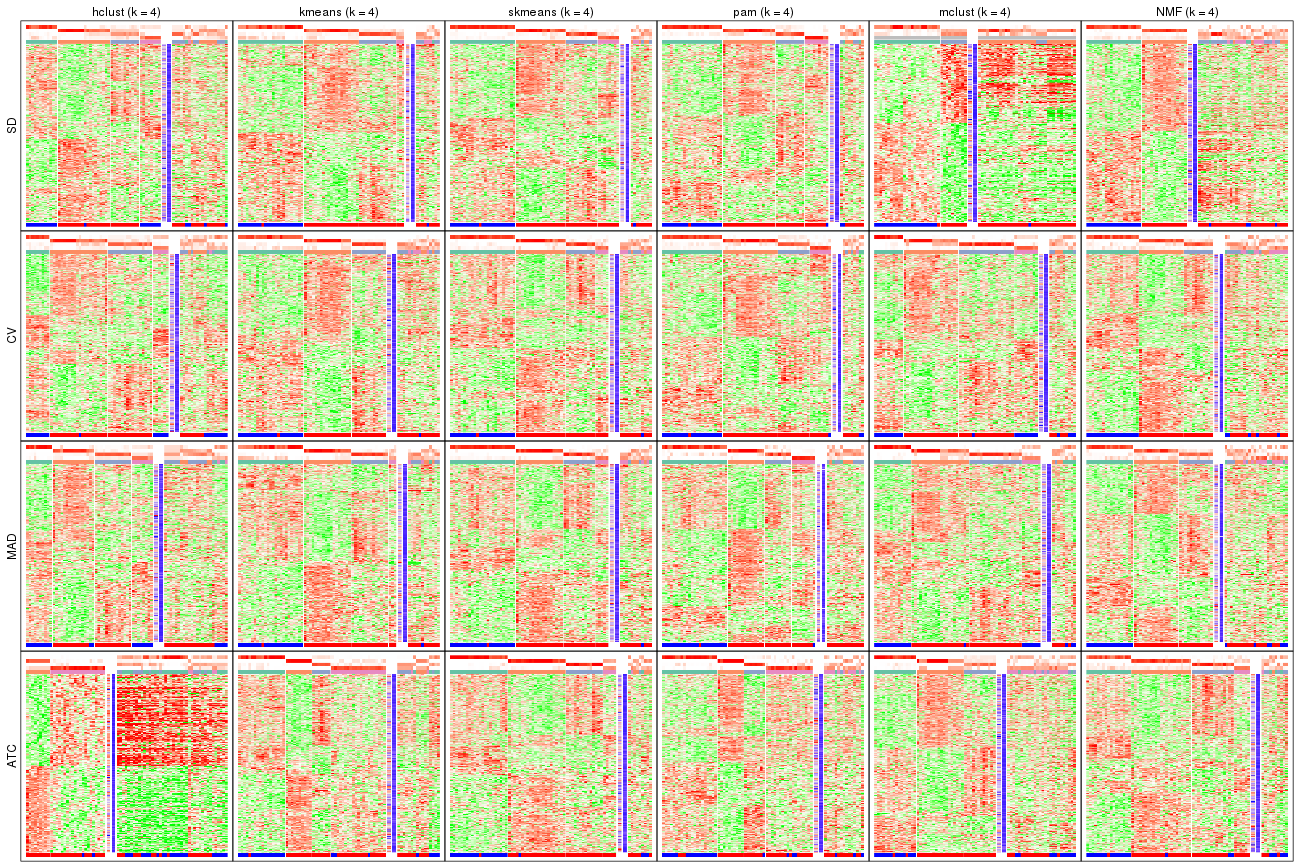
collect_plots(res_list, k = 5, fun = get_signatures, mc.cores = 4)
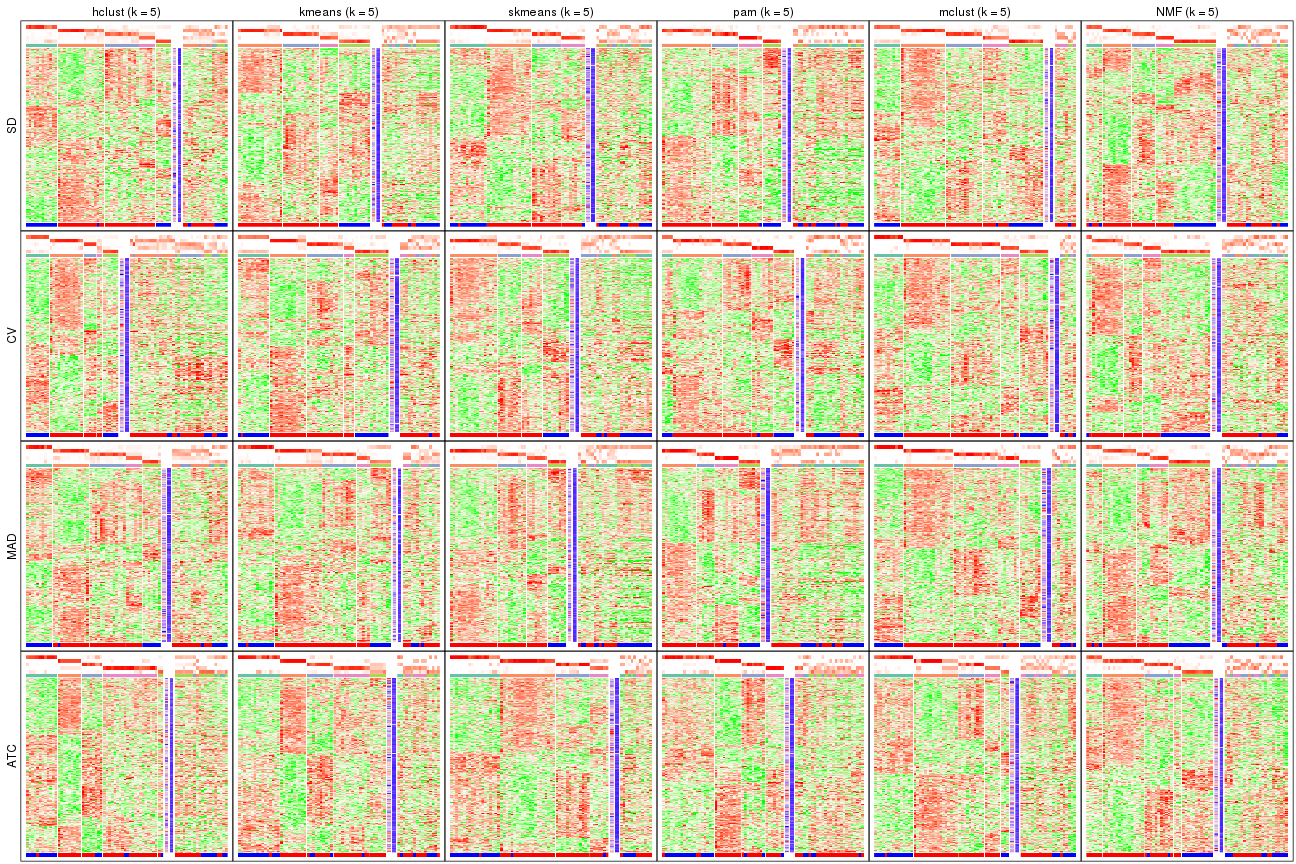
collect_plots(res_list, k = 6, fun = get_signatures, mc.cores = 4)
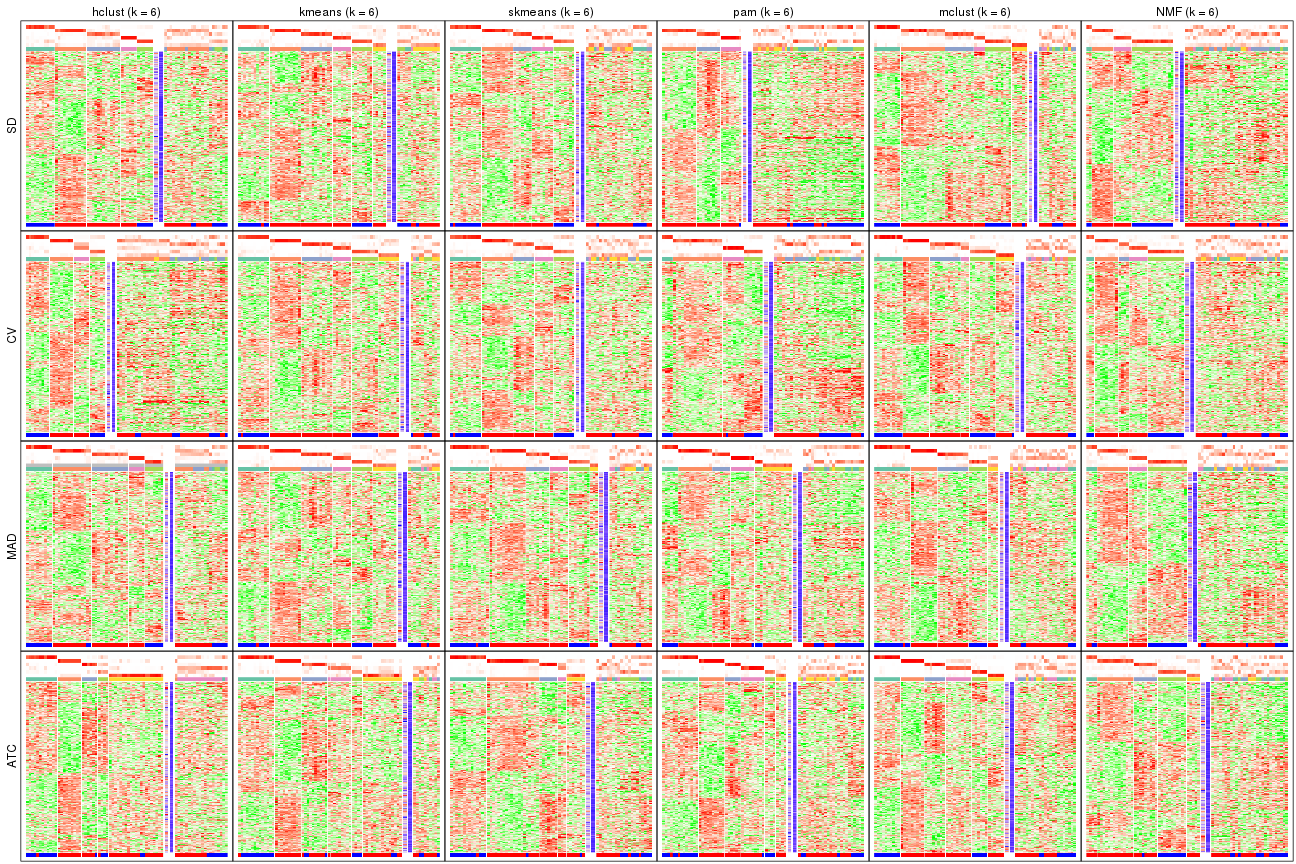
The statistics used for measuring the stability of consensus partitioning. (How are they defined?)
get_stats(res_list, k = 2)
#> k 1-PAC mean_silhouette concordance area_increased Rand Jaccard
#> SD:NMF 2 0.633 0.823 0.927 0.489 0.512 0.512
#> CV:NMF 2 0.633 0.787 0.916 0.491 0.507 0.507
#> MAD:NMF 2 0.680 0.811 0.925 0.490 0.507 0.507
#> ATC:NMF 2 0.972 0.927 0.973 0.505 0.495 0.495
#> SD:skmeans 2 0.617 0.659 0.865 0.497 0.512 0.512
#> CV:skmeans 2 0.629 0.748 0.890 0.497 0.495 0.495
#> MAD:skmeans 2 0.640 0.728 0.884 0.497 0.493 0.493
#> ATC:skmeans 2 1.000 0.977 0.991 0.505 0.496 0.496
#> SD:mclust 2 0.373 0.801 0.818 0.410 0.518 0.518
#> CV:mclust 2 0.489 0.908 0.895 0.431 0.532 0.532
#> MAD:mclust 2 0.824 0.927 0.932 0.442 0.532 0.532
#> ATC:mclust 2 0.360 0.711 0.828 0.426 0.493 0.493
#> SD:kmeans 2 0.662 0.836 0.911 0.479 0.540 0.540
#> CV:kmeans 2 0.653 0.806 0.905 0.484 0.532 0.532
#> MAD:kmeans 2 0.623 0.805 0.904 0.483 0.540 0.540
#> ATC:kmeans 2 1.000 0.982 0.992 0.503 0.499 0.499
#> SD:pam 2 0.548 0.686 0.876 0.490 0.493 0.493
#> CV:pam 2 0.546 0.784 0.904 0.496 0.496 0.496
#> MAD:pam 2 0.651 0.824 0.925 0.496 0.499 0.499
#> ATC:pam 2 0.597 0.808 0.918 0.475 0.518 0.518
#> SD:hclust 2 0.236 0.777 0.851 0.435 0.559 0.559
#> CV:hclust 2 0.214 0.570 0.805 0.454 0.512 0.512
#> MAD:hclust 2 0.227 0.737 0.838 0.444 0.549 0.549
#> ATC:hclust 2 0.574 0.813 0.911 0.486 0.495 0.495
get_stats(res_list, k = 3)
#> k 1-PAC mean_silhouette concordance area_increased Rand Jaccard
#> SD:NMF 3 0.582 0.651 0.826 0.337 0.809 0.635
#> CV:NMF 3 0.555 0.703 0.837 0.344 0.737 0.521
#> MAD:NMF 3 0.484 0.709 0.818 0.351 0.787 0.594
#> ATC:NMF 3 0.642 0.776 0.885 0.309 0.782 0.584
#> SD:skmeans 3 0.745 0.836 0.918 0.335 0.763 0.560
#> CV:skmeans 3 0.837 0.857 0.938 0.347 0.743 0.525
#> MAD:skmeans 3 0.866 0.872 0.946 0.346 0.734 0.511
#> ATC:skmeans 3 0.961 0.932 0.973 0.292 0.823 0.652
#> SD:mclust 3 0.518 0.704 0.795 0.454 0.806 0.654
#> CV:mclust 3 0.641 0.708 0.817 0.423 0.796 0.625
#> MAD:mclust 3 0.562 0.688 0.821 0.401 0.786 0.606
#> ATC:mclust 3 0.376 0.532 0.683 0.400 0.718 0.490
#> SD:kmeans 3 0.686 0.822 0.870 0.354 0.789 0.609
#> CV:kmeans 3 0.739 0.864 0.901 0.366 0.774 0.583
#> MAD:kmeans 3 0.721 0.848 0.896 0.361 0.786 0.605
#> ATC:kmeans 3 0.553 0.621 0.800 0.302 0.777 0.575
#> SD:pam 3 0.427 0.654 0.797 0.335 0.748 0.531
#> CV:pam 3 0.462 0.713 0.835 0.326 0.754 0.539
#> MAD:pam 3 0.448 0.417 0.706 0.317 0.716 0.503
#> ATC:pam 3 0.525 0.658 0.843 0.345 0.690 0.478
#> SD:hclust 3 0.245 0.570 0.676 0.432 0.737 0.543
#> CV:hclust 3 0.226 0.635 0.734 0.393 0.723 0.505
#> MAD:hclust 3 0.243 0.613 0.697 0.421 0.759 0.569
#> ATC:hclust 3 0.479 0.645 0.709 0.277 0.842 0.698
get_stats(res_list, k = 4)
#> k 1-PAC mean_silhouette concordance area_increased Rand Jaccard
#> SD:NMF 4 0.517 0.454 0.690 0.130 0.863 0.632
#> CV:NMF 4 0.497 0.556 0.731 0.127 0.869 0.633
#> MAD:NMF 4 0.493 0.522 0.720 0.123 0.865 0.627
#> ATC:NMF 4 0.558 0.673 0.788 0.118 0.900 0.717
#> SD:skmeans 4 0.718 0.768 0.857 0.111 0.913 0.745
#> CV:skmeans 4 0.655 0.698 0.828 0.107 0.896 0.700
#> MAD:skmeans 4 0.735 0.726 0.847 0.102 0.886 0.681
#> ATC:skmeans 4 0.789 0.740 0.857 0.102 0.925 0.789
#> SD:mclust 4 0.414 0.463 0.587 0.144 0.784 0.560
#> CV:mclust 4 0.550 0.668 0.806 0.133 0.768 0.457
#> MAD:mclust 4 0.550 0.636 0.787 0.149 0.813 0.535
#> ATC:mclust 4 0.424 0.471 0.640 0.161 0.733 0.362
#> SD:kmeans 4 0.580 0.653 0.780 0.125 0.900 0.718
#> CV:kmeans 4 0.615 0.639 0.792 0.115 0.957 0.869
#> MAD:kmeans 4 0.646 0.655 0.796 0.119 0.938 0.817
#> ATC:kmeans 4 0.620 0.644 0.808 0.118 0.818 0.526
#> SD:pam 4 0.648 0.737 0.840 0.118 0.912 0.747
#> CV:pam 4 0.608 0.723 0.822 0.116 0.937 0.812
#> MAD:pam 4 0.644 0.662 0.813 0.123 0.824 0.565
#> ATC:pam 4 0.619 0.692 0.842 0.143 0.861 0.645
#> SD:hclust 4 0.388 0.570 0.714 0.134 0.940 0.820
#> CV:hclust 4 0.370 0.544 0.706 0.132 0.962 0.883
#> MAD:hclust 4 0.409 0.566 0.706 0.137 0.949 0.845
#> ATC:hclust 4 0.495 0.470 0.695 0.138 0.869 0.676
get_stats(res_list, k = 5)
#> k 1-PAC mean_silhouette concordance area_increased Rand Jaccard
#> SD:NMF 5 0.608 0.548 0.765 0.0718 0.873 0.576
#> CV:NMF 5 0.595 0.529 0.738 0.0700 0.874 0.573
#> MAD:NMF 5 0.598 0.532 0.740 0.0694 0.876 0.575
#> ATC:NMF 5 0.590 0.557 0.763 0.0700 0.876 0.587
#> SD:skmeans 5 0.653 0.551 0.750 0.0682 0.929 0.750
#> CV:skmeans 5 0.617 0.503 0.671 0.0677 0.887 0.609
#> MAD:skmeans 5 0.679 0.465 0.693 0.0684 0.887 0.614
#> ATC:skmeans 5 0.706 0.678 0.825 0.0633 0.941 0.804
#> SD:mclust 5 0.634 0.721 0.790 0.1525 0.761 0.398
#> CV:mclust 5 0.774 0.787 0.849 0.1273 0.905 0.670
#> MAD:mclust 5 0.719 0.729 0.853 0.0984 0.885 0.615
#> ATC:mclust 5 0.471 0.479 0.646 0.0578 0.910 0.666
#> SD:kmeans 5 0.656 0.530 0.683 0.0757 0.922 0.732
#> CV:kmeans 5 0.687 0.620 0.740 0.0721 0.862 0.553
#> MAD:kmeans 5 0.683 0.605 0.761 0.0716 0.879 0.603
#> ATC:kmeans 5 0.689 0.624 0.780 0.0746 0.857 0.530
#> SD:pam 5 0.615 0.575 0.770 0.0794 0.889 0.631
#> CV:pam 5 0.633 0.600 0.793 0.0736 0.892 0.635
#> MAD:pam 5 0.661 0.486 0.746 0.0759 0.861 0.547
#> ATC:pam 5 0.644 0.521 0.770 0.0768 0.896 0.653
#> SD:hclust 5 0.526 0.612 0.703 0.0851 0.948 0.819
#> CV:hclust 5 0.503 0.450 0.665 0.0734 0.922 0.748
#> MAD:hclust 5 0.573 0.598 0.745 0.0754 0.901 0.674
#> ATC:hclust 5 0.601 0.663 0.797 0.0839 0.832 0.492
get_stats(res_list, k = 6)
#> k 1-PAC mean_silhouette concordance area_increased Rand Jaccard
#> SD:NMF 6 0.623 0.415 0.697 0.0416 0.903 0.606
#> CV:NMF 6 0.599 0.459 0.665 0.0441 0.895 0.558
#> MAD:NMF 6 0.611 0.438 0.670 0.0424 0.885 0.530
#> ATC:NMF 6 0.597 0.514 0.685 0.0426 0.942 0.734
#> SD:skmeans 6 0.673 0.561 0.755 0.0479 0.922 0.675
#> CV:skmeans 6 0.629 0.505 0.717 0.0443 0.884 0.524
#> MAD:skmeans 6 0.708 0.641 0.797 0.0465 0.888 0.536
#> ATC:skmeans 6 0.719 0.590 0.786 0.0431 0.914 0.681
#> SD:mclust 6 0.694 0.612 0.778 0.0494 0.940 0.718
#> CV:mclust 6 0.751 0.617 0.762 0.0509 0.922 0.653
#> MAD:mclust 6 0.672 0.573 0.713 0.0392 0.886 0.543
#> ATC:mclust 6 0.701 0.599 0.790 0.1118 0.869 0.485
#> SD:kmeans 6 0.710 0.652 0.782 0.0496 0.852 0.445
#> CV:kmeans 6 0.727 0.715 0.802 0.0472 0.915 0.614
#> MAD:kmeans 6 0.745 0.692 0.795 0.0480 0.917 0.629
#> ATC:kmeans 6 0.712 0.656 0.769 0.0471 0.926 0.674
#> SD:pam 6 0.651 0.449 0.724 0.0473 0.878 0.524
#> CV:pam 6 0.651 0.483 0.711 0.0433 0.962 0.830
#> MAD:pam 6 0.731 0.602 0.801 0.0519 0.852 0.419
#> ATC:pam 6 0.676 0.582 0.763 0.0422 0.856 0.458
#> SD:hclust 6 0.591 0.587 0.716 0.0493 1.000 1.000
#> CV:hclust 6 0.555 0.431 0.637 0.0435 0.918 0.708
#> MAD:hclust 6 0.663 0.590 0.726 0.0402 1.000 1.000
#> ATC:hclust 6 0.622 0.687 0.782 0.0352 0.975 0.882
Following heatmap plots the partition for each combination of methods and the lightness correspond to the silhouette scores for samples in each method. On top the consensus subgroup is inferred from all methods by taking the mean silhouette scores as weight.
collect_stats(res_list, k = 2)
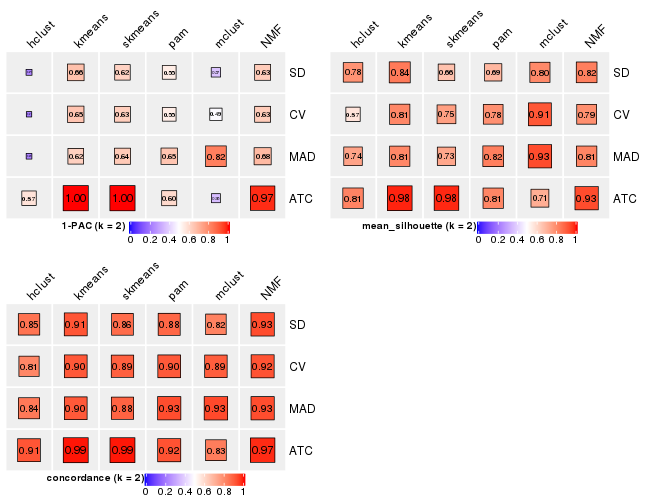
collect_stats(res_list, k = 3)
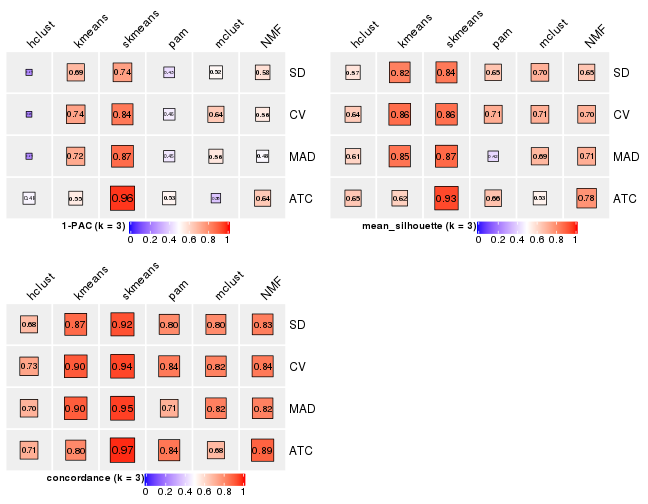
collect_stats(res_list, k = 4)
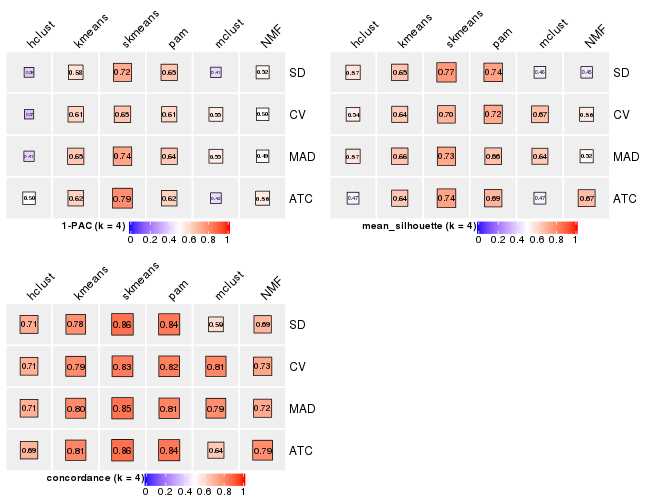
collect_stats(res_list, k = 5)
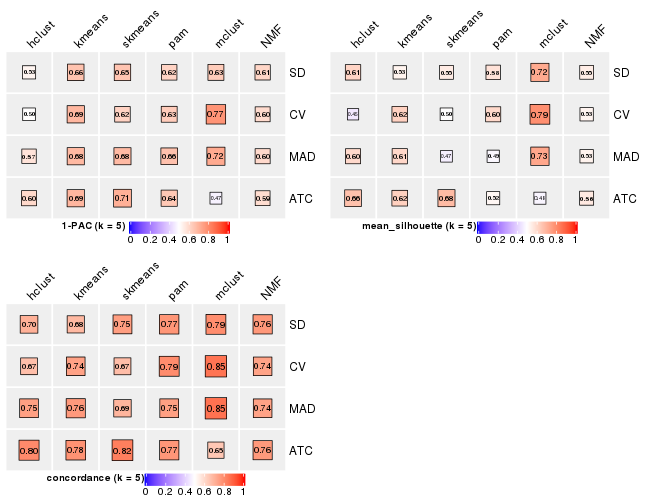
collect_stats(res_list, k = 6)
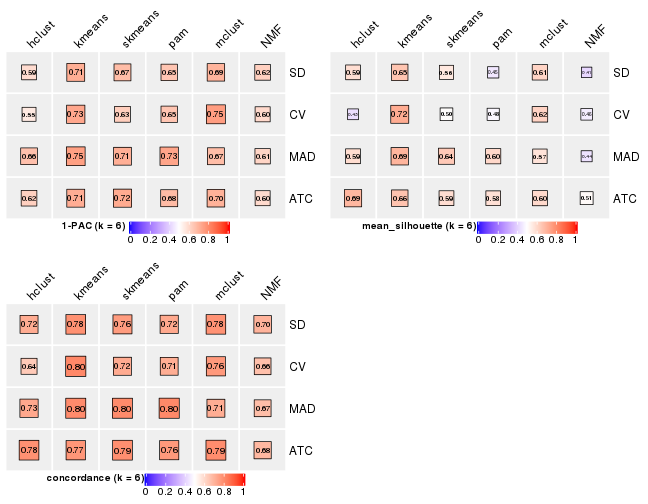
Collect partitions from all methods:
collect_classes(res_list, k = 2)
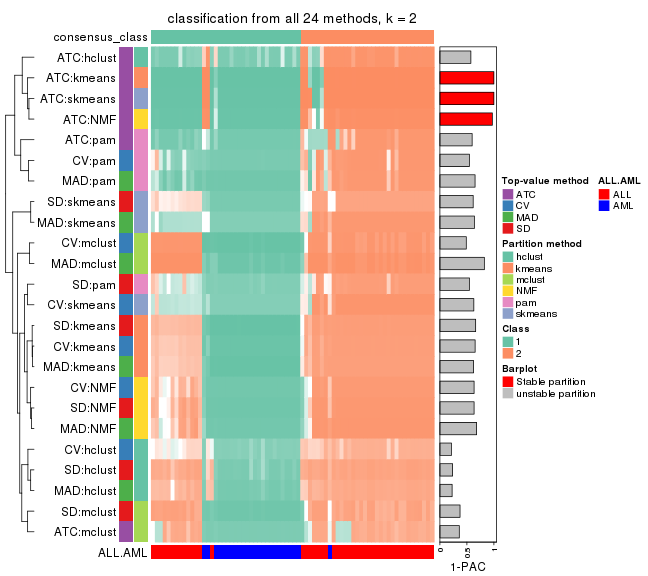
collect_classes(res_list, k = 3)
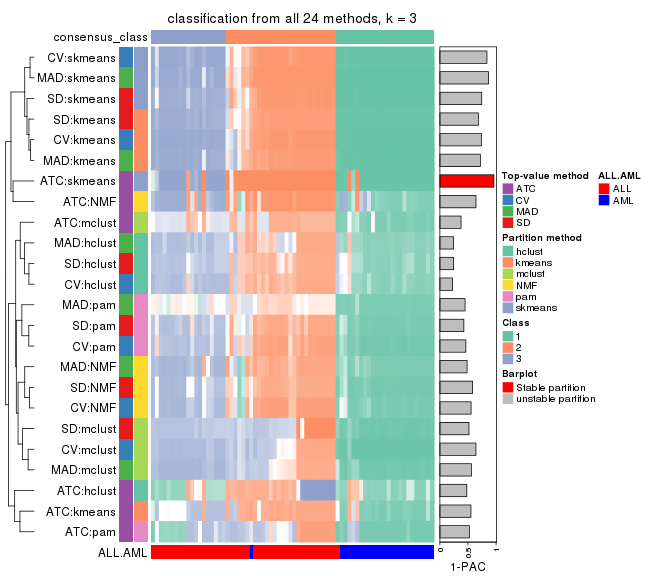
collect_classes(res_list, k = 4)
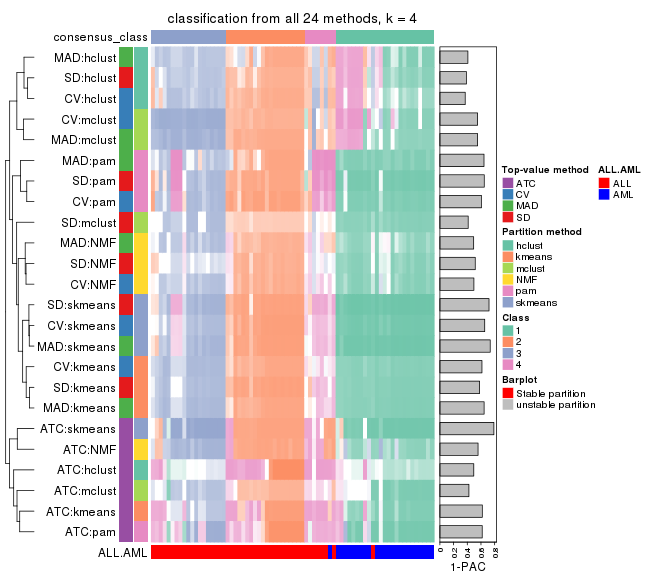
collect_classes(res_list, k = 5)
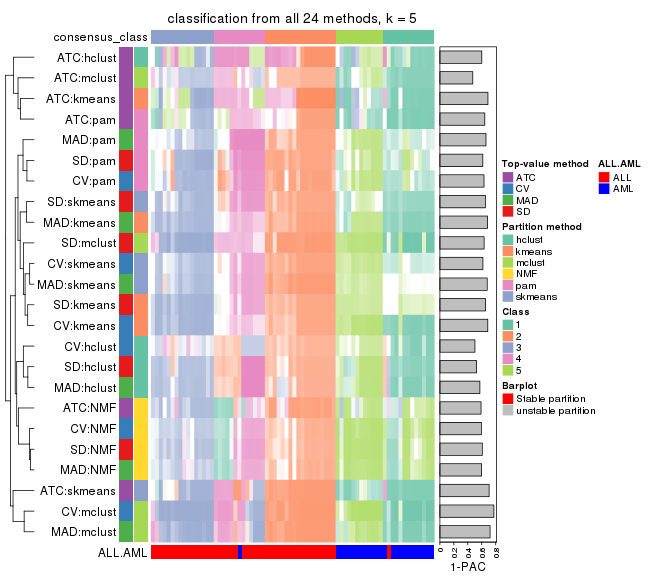
collect_classes(res_list, k = 6)
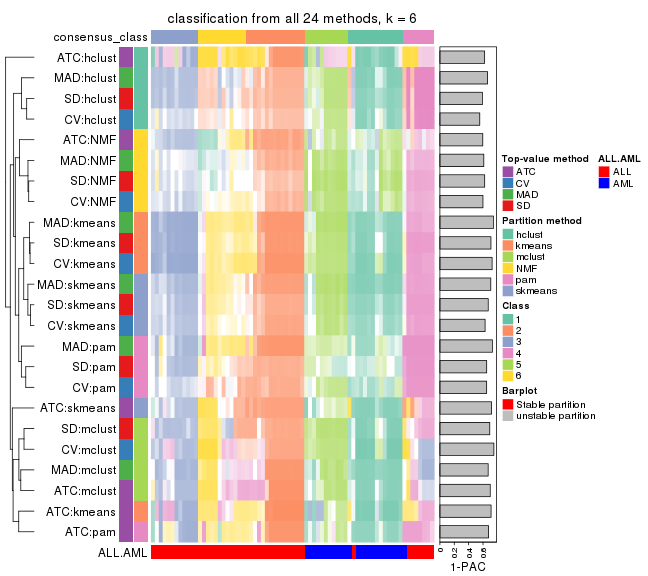
Overlap of top rows from different top-row methods:
top_rows_overlap(res_list, top_n = 412, method = "euler")
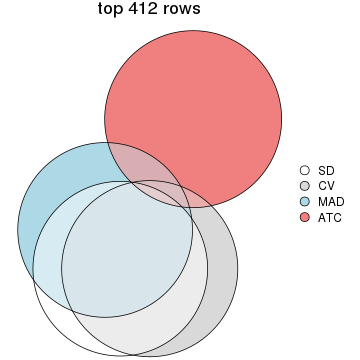
top_rows_overlap(res_list, top_n = 824, method = "euler")
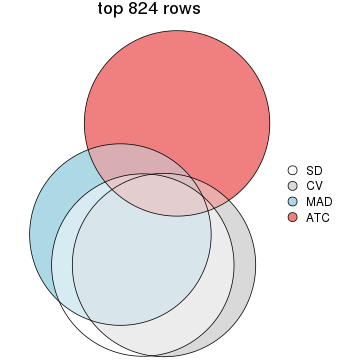
top_rows_overlap(res_list, top_n = 1235, method = "euler")
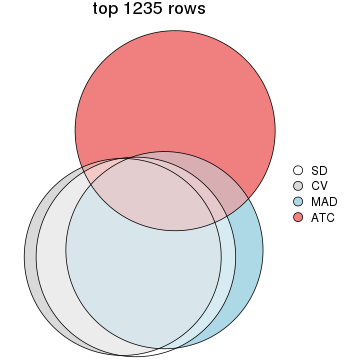
top_rows_overlap(res_list, top_n = 1646, method = "euler")
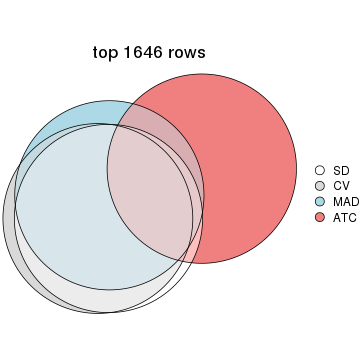
top_rows_overlap(res_list, top_n = 2058, method = "euler")
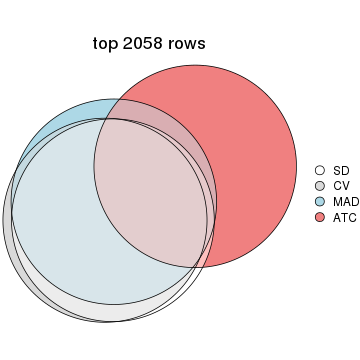
Also visualize the correspondance of rankings between different top-row methods:
top_rows_overlap(res_list, top_n = 412, method = "correspondance")
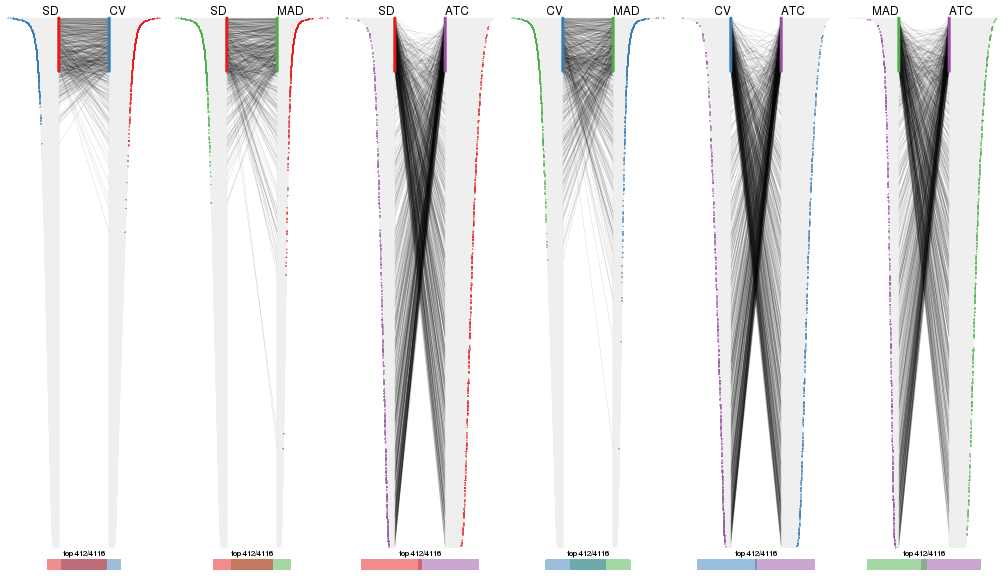
top_rows_overlap(res_list, top_n = 824, method = "correspondance")
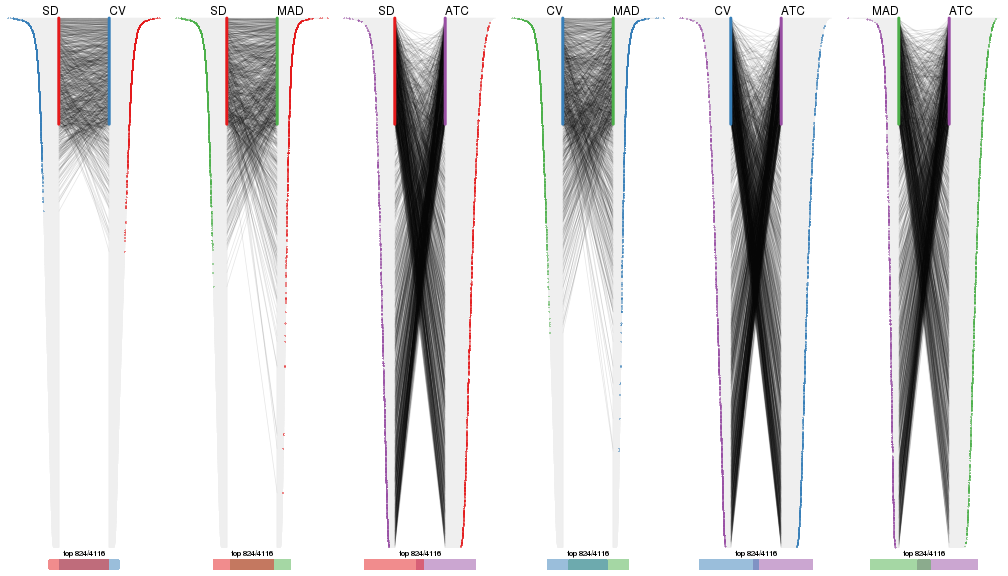
top_rows_overlap(res_list, top_n = 1235, method = "correspondance")
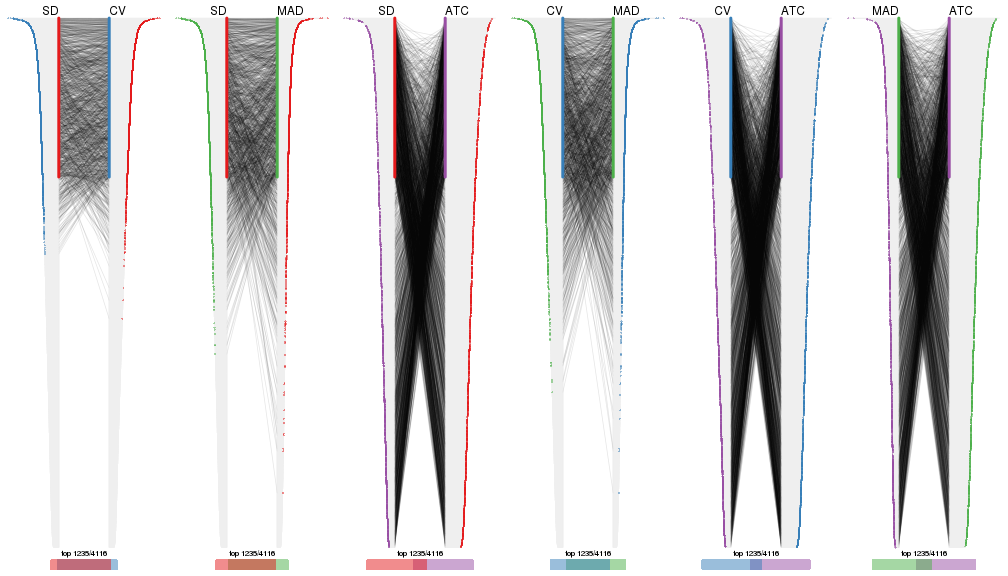
top_rows_overlap(res_list, top_n = 1646, method = "correspondance")
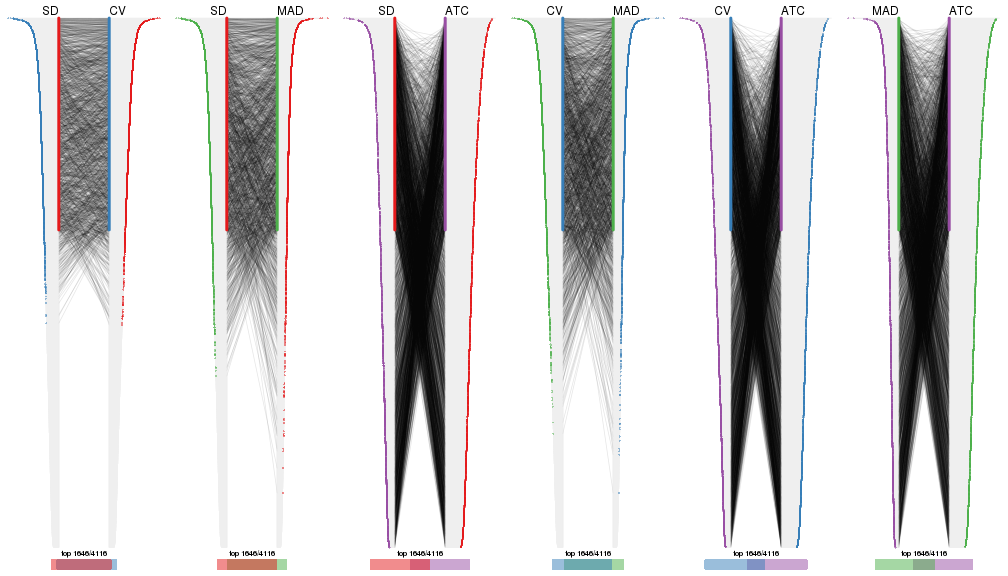
top_rows_overlap(res_list, top_n = 2058, method = "correspondance")
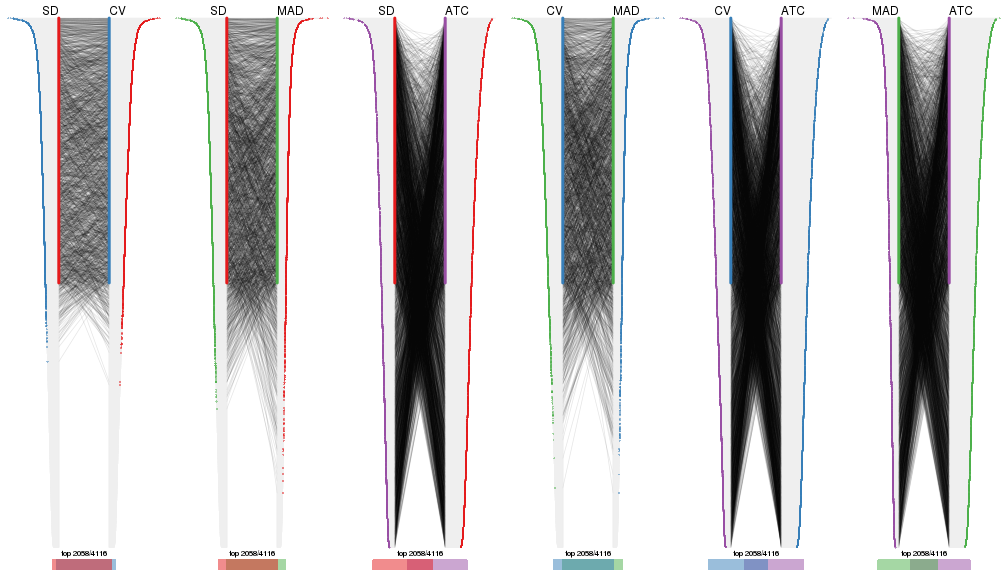
Heatmaps of the top rows:
top_rows_heatmap(res_list, top_n = 412)

top_rows_heatmap(res_list, top_n = 824)

top_rows_heatmap(res_list, top_n = 1235)

top_rows_heatmap(res_list, top_n = 1646)

top_rows_heatmap(res_list, top_n = 2058)

Test correlation between subgroups and known annotations. If the known annotation is numeric, one-way ANOVA test is applied, and if the known annotation is discrete, chi-squared contingency table test is applied.
test_to_known_factors(res_list, k = 2)
#> n ALL.AML(p) k
#> SD:NMF 66 1.35e-12 2
#> CV:NMF 63 7.82e-13 2
#> MAD:NMF 65 2.13e-12 2
#> ATC:NMF 69 5.41e-05 2
#> SD:skmeans 54 1.01e-11 2
#> CV:skmeans 55 3.77e-11 2
#> MAD:skmeans 67 2.39e-06 2
#> ATC:skmeans 71 5.23e-05 2
#> SD:mclust 70 2.94e-14 2
#> CV:mclust 70 2.94e-14 2
#> MAD:mclust 72 8.75e-14 2
#> ATC:mclust 62 1.26e-12 2
#> SD:kmeans 71 2.08e-14 2
#> CV:kmeans 66 2.15e-13 2
#> MAD:kmeans 65 3.43e-13 2
#> ATC:kmeans 72 1.50e-04 2
#> SD:pam 54 1.01e-11 2
#> CV:pam 65 1.04e-07 2
#> MAD:pam 63 2.89e-07 2
#> ATC:pam 67 1.65e-04 2
#> SD:hclust 70 4.70e-15 2
#> CV:hclust 49 1.25e-10 2
#> MAD:hclust 69 5.21e-14 2
#> ATC:hclust 66 4.16e-05 2
test_to_known_factors(res_list, k = 3)
#> n ALL.AML(p) k
#> SD:NMF 59 7.38e-12 3
#> CV:NMF 61 1.74e-11 3
#> MAD:NMF 67 8.26e-12 3
#> ATC:NMF 65 2.97e-08 3
#> SD:skmeans 65 4.40e-13 3
#> CV:skmeans 67 1.71e-13 3
#> MAD:skmeans 67 1.71e-13 3
#> ATC:skmeans 70 1.85e-12 3
#> SD:mclust 60 6.91e-13 3
#> CV:mclust 62 2.60e-13 3
#> MAD:mclust 61 4.15e-13 3
#> ATC:mclust 46 5.78e-10 3
#> SD:kmeans 66 2.72e-13 3
#> CV:kmeans 68 1.06e-13 3
#> MAD:kmeans 68 1.06e-13 3
#> ATC:kmeans 60 2.70e-11 3
#> SD:pam 58 1.94e-12 3
#> CV:pam 61 4.37e-13 3
#> MAD:pam 24 NA 3
#> ATC:pam 59 3.74e-06 3
#> SD:hclust 61 5.68e-14 3
#> CV:hclust 59 1.23e-12 3
#> MAD:hclust 53 1.00e-10 3
#> ATC:hclust 62 3.04e-03 3
test_to_known_factors(res_list, k = 4)
#> n ALL.AML(p) k
#> SD:NMF 38 5.34e-09 4
#> CV:NMF 48 3.78e-11 4
#> MAD:NMF 48 3.78e-11 4
#> ATC:NMF 62 1.00e-09 4
#> SD:skmeans 64 6.16e-13 4
#> CV:skmeans 60 4.20e-12 4
#> MAD:skmeans 60 4.20e-12 4
#> ATC:skmeans 63 8.36e-12 4
#> SD:mclust 35 2.99e-07 4
#> CV:mclust 62 1.78e-12 4
#> MAD:mclust 63 1.06e-12 4
#> ATC:mclust 46 6.40e-09 4
#> SD:kmeans 63 9.95e-13 4
#> CV:kmeans 57 1.78e-11 4
#> MAD:kmeans 60 4.20e-12 4
#> ATC:kmeans 56 7.62e-09 4
#> SD:pam 63 6.74e-12 4
#> CV:pam 64 4.11e-12 4
#> MAD:pam 58 6.37e-11 4
#> ATC:pam 57 5.47e-07 4
#> SD:hclust 51 3.35e-10 4
#> CV:hclust 54 1.06e-10 4
#> MAD:hclust 48 7.21e-09 4
#> ATC:hclust 30 8.73e-01 4
test_to_known_factors(res_list, k = 5)
#> n ALL.AML(p) k
#> SD:NMF 49 9.13e-09 5
#> CV:NMF 47 4.06e-09 5
#> MAD:NMF 47 2.27e-08 5
#> ATC:NMF 48 4.17e-08 5
#> SD:skmeans 51 4.27e-09 5
#> CV:skmeans 45 9.25e-10 5
#> MAD:skmeans 44 1.51e-09 5
#> ATC:skmeans 60 2.60e-10 5
#> SD:mclust 64 2.68e-12 5
#> CV:mclust 66 9.88e-13 5
#> MAD:mclust 63 4.79e-12 5
#> ATC:mclust 51 1.68e-09 5
#> SD:kmeans 50 7.99e-11 5
#> CV:kmeans 57 7.59e-11 5
#> MAD:kmeans 58 5.31e-11 5
#> ATC:kmeans 56 9.68e-08 5
#> SD:pam 45 1.81e-08 5
#> CV:pam 50 3.20e-09 5
#> MAD:pam 37 4.82e-07 5
#> ATC:pam 46 1.05e-05 5
#> SD:hclust 55 2.43e-10 5
#> CV:hclust 35 4.65e-07 5
#> MAD:hclust 51 1.57e-09 5
#> ATC:hclust 52 8.51e-06 5
test_to_known_factors(res_list, k = 6)
#> n ALL.AML(p) k
#> SD:NMF 33 3.22e-07 6
#> CV:NMF 37 1.80e-07 6
#> MAD:NMF 38 2.02e-07 6
#> ATC:NMF 44 1.87e-07 6
#> SD:skmeans 48 2.14e-08 6
#> CV:skmeans 47 9.43e-09 6
#> MAD:skmeans 56 5.18e-10 6
#> ATC:skmeans 51 1.22e-07 6
#> SD:mclust 58 1.74e-10 6
#> CV:mclust 53 1.78e-09 6
#> MAD:mclust 47 9.40e-09 6
#> ATC:mclust 49 2.22e-09 6
#> SD:kmeans 56 5.63e-10 6
#> CV:kmeans 61 5.20e-11 6
#> MAD:kmeans 60 9.09e-11 6
#> ATC:kmeans 62 8.55e-08 6
#> SD:pam 31 3.96e-01 6
#> CV:pam 38 2.03e-07 6
#> MAD:pam 49 2.89e-08 6
#> ATC:pam 47 1.08e-06 6
#> SD:hclust 48 9.44e-10 6
#> CV:hclust 30 1.38e-06 6
#> MAD:hclust 52 4.99e-09 6
#> ATC:hclust 52 1.57e-06 6
The object with results only for a single top-value method and a single partition method can be extracted as:
res = res_list["SD", "hclust"]
# you can also extract it by
# res = res_list["SD:hclust"]
A summary of res and all the functions that can be applied to it:
res
#> A 'ConsensusPartition' object with k = 2, 3, 4, 5, 6.
#> On a matrix with 4116 rows and 72 columns.
#> Top rows (412, 824, 1235, 1646, 2058) are extracted by 'SD' method.
#> Subgroups are detected by 'hclust' method.
#> Performed in total 1250 partitions by row resampling.
#> Best k for subgroups seems to be 2.
#>
#> Following methods can be applied to this 'ConsensusPartition' object:
#> [1] "cola_report" "collect_classes" "collect_plots"
#> [4] "collect_stats" "colnames" "compare_signatures"
#> [7] "consensus_heatmap" "dimension_reduction" "functional_enrichment"
#> [10] "get_anno_col" "get_anno" "get_classes"
#> [13] "get_consensus" "get_matrix" "get_membership"
#> [16] "get_param" "get_signatures" "get_stats"
#> [19] "is_best_k" "is_stable_k" "membership_heatmap"
#> [22] "ncol" "nrow" "plot_ecdf"
#> [25] "rownames" "select_partition_number" "show"
#> [28] "suggest_best_k" "test_to_known_factors"
collect_plots() function collects all the plots made from res for all k (number of partitions)
into one single page to provide an easy and fast comparison between different k.
collect_plots(res)
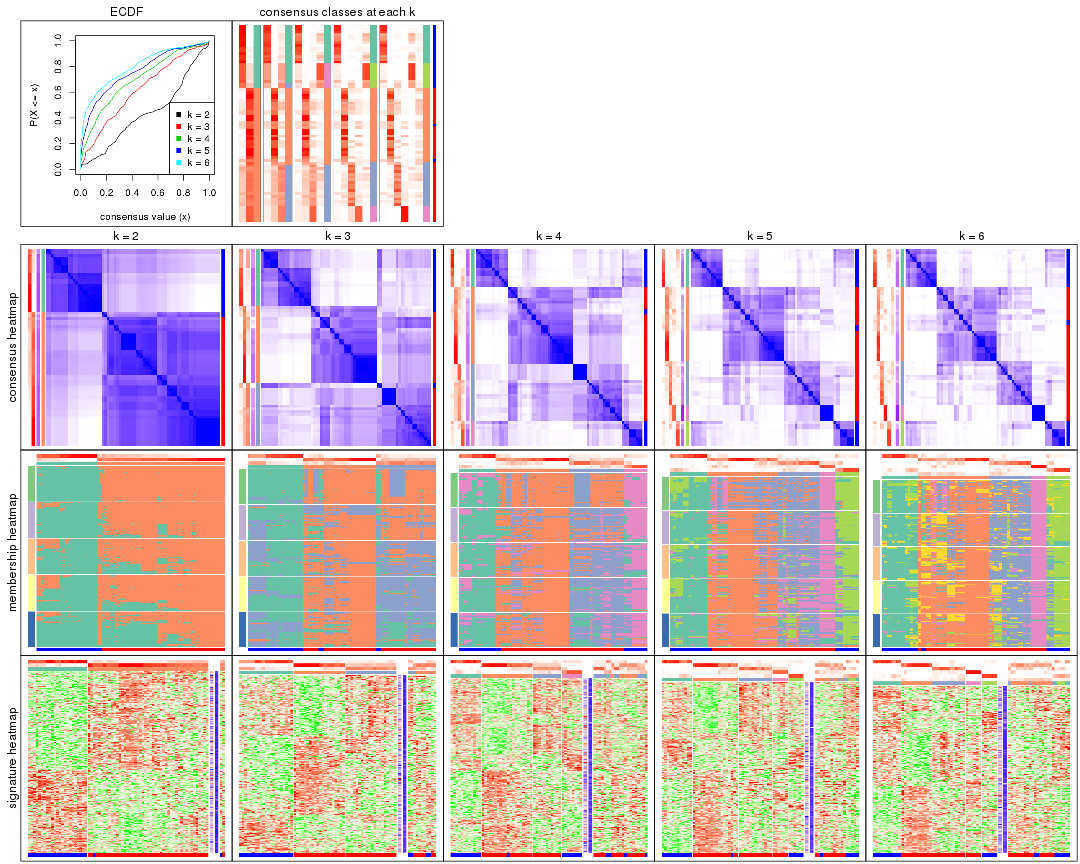
The plots are:
k and the heatmap of
predicted classes for each k.k.k.k.All the plots in panels can be made by individual functions and they are plotted later in this section.
select_partition_number() produces several plots showing different
statistics for choosing “optimized” k. There are following statistics:
k;k, the area increased is defined as \(A_k - A_{k-1}\).The detailed explanations of these statistics can be found in the cola vignette.
Generally speaking, lower PAC score, higher mean silhouette score or higher
concordance corresponds to better partition. Rand index and Jaccard index
measure how similar the current partition is compared to partition with k-1.
If they are too similar, we won't accept k is better than k-1.
select_partition_number(res)
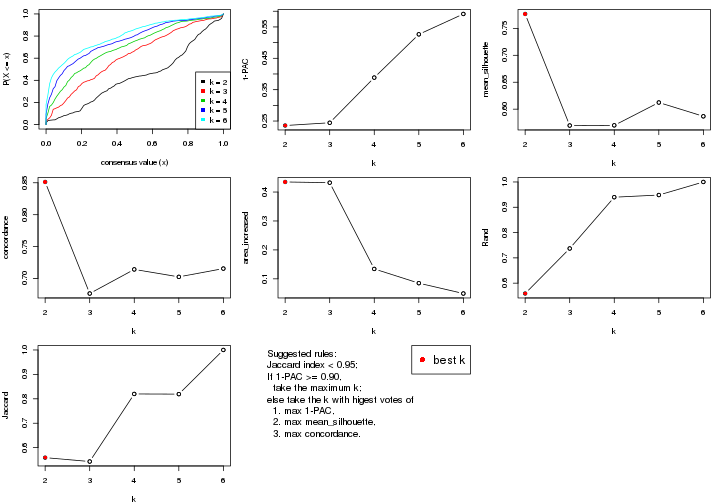
The numeric values for all these statistics can be obtained by get_stats().
get_stats(res)
#> k 1-PAC mean_silhouette concordance area_increased Rand Jaccard
#> 2 2 0.236 0.777 0.851 0.4348 0.559 0.559
#> 3 3 0.245 0.570 0.676 0.4324 0.737 0.543
#> 4 4 0.388 0.570 0.714 0.1342 0.940 0.820
#> 5 5 0.526 0.612 0.703 0.0851 0.948 0.819
#> 6 6 0.591 0.587 0.716 0.0493 1.000 1.000
suggest_best_k() suggests the best \(k\) based on these statistics. The rules are as follows:
suggest_best_k(res)
#> [1] 2
Following shows the table of the partitions (You need to click the show/hide
code output link to see it). The membership matrix (columns with name p*)
is inferred by
clue::cl_consensus()
function with the SE method. Basically the value in the membership matrix
represents the probability to belong to a certain group. The finall class
label for an item is determined with the group with highest probability it
belongs to.
In get_classes() function, the entropy is calculated from the membership
matrix and the silhouette score is calculated from the consensus matrix.
cbind(get_classes(res, k = 2), get_membership(res, k = 2))
#> class entropy silhouette p1 p2
#> sample_39 2 0.8763 0.742 0.296 0.704
#> sample_40 2 0.9866 0.489 0.432 0.568
#> sample_42 2 0.5519 0.808 0.128 0.872
#> sample_47 2 0.1843 0.804 0.028 0.972
#> sample_48 2 0.0000 0.793 0.000 1.000
#> sample_49 2 0.9358 0.682 0.352 0.648
#> sample_41 2 0.0000 0.793 0.000 1.000
#> sample_43 2 0.4562 0.810 0.096 0.904
#> sample_44 2 0.5294 0.821 0.120 0.880
#> sample_45 2 0.5294 0.821 0.120 0.880
#> sample_46 2 0.5519 0.820 0.128 0.872
#> sample_70 2 0.6048 0.818 0.148 0.852
#> sample_71 2 0.7602 0.759 0.220 0.780
#> sample_72 2 0.7602 0.759 0.220 0.780
#> sample_68 2 0.0000 0.793 0.000 1.000
#> sample_69 2 0.0000 0.793 0.000 1.000
#> sample_67 2 0.7883 0.702 0.236 0.764
#> sample_55 2 0.8713 0.744 0.292 0.708
#> sample_56 2 0.8861 0.737 0.304 0.696
#> sample_59 2 0.8443 0.766 0.272 0.728
#> sample_52 1 0.7139 0.781 0.804 0.196
#> sample_53 1 0.0376 0.866 0.996 0.004
#> sample_51 1 0.0000 0.865 1.000 0.000
#> sample_50 1 0.0000 0.865 1.000 0.000
#> sample_54 1 0.7219 0.774 0.800 0.200
#> sample_57 1 0.6973 0.789 0.812 0.188
#> sample_58 1 0.0000 0.865 1.000 0.000
#> sample_60 1 0.7219 0.774 0.800 0.200
#> sample_61 1 0.0672 0.868 0.992 0.008
#> sample_65 1 0.1184 0.869 0.984 0.016
#> sample_66 2 0.8016 0.607 0.244 0.756
#> sample_63 1 0.7139 0.781 0.804 0.196
#> sample_64 1 0.8763 0.560 0.704 0.296
#> sample_62 1 0.7139 0.781 0.804 0.196
#> sample_1 2 0.8555 0.753 0.280 0.720
#> sample_2 2 0.7453 0.727 0.212 0.788
#> sample_3 2 0.7299 0.801 0.204 0.796
#> sample_4 2 0.8499 0.757 0.276 0.724
#> sample_5 2 0.0000 0.793 0.000 1.000
#> sample_6 2 0.7299 0.801 0.204 0.796
#> sample_7 2 0.8555 0.754 0.280 0.720
#> sample_8 2 0.8661 0.750 0.288 0.712
#> sample_9 2 0.7299 0.801 0.204 0.796
#> sample_10 2 0.7299 0.801 0.204 0.796
#> sample_11 2 0.7299 0.801 0.204 0.796
#> sample_12 2 0.9522 0.640 0.372 0.628
#> sample_13 2 0.0000 0.793 0.000 1.000
#> sample_14 2 0.3274 0.803 0.060 0.940
#> sample_15 2 0.0000 0.793 0.000 1.000
#> sample_16 2 0.4161 0.819 0.084 0.916
#> sample_17 2 0.2948 0.800 0.052 0.948
#> sample_18 2 0.8081 0.791 0.248 0.752
#> sample_19 2 0.4161 0.819 0.084 0.916
#> sample_20 2 0.0000 0.793 0.000 1.000
#> sample_21 2 0.0000 0.793 0.000 1.000
#> sample_22 2 0.8861 0.737 0.304 0.696
#> sample_23 2 0.7299 0.801 0.204 0.796
#> sample_24 2 0.0000 0.793 0.000 1.000
#> sample_25 2 0.9044 0.725 0.320 0.680
#> sample_26 2 0.4298 0.820 0.088 0.912
#> sample_27 2 0.9358 0.682 0.352 0.648
#> sample_34 1 0.6247 0.814 0.844 0.156
#> sample_35 1 0.8555 0.606 0.720 0.280
#> sample_36 1 0.0672 0.867 0.992 0.008
#> sample_37 1 0.0376 0.867 0.996 0.004
#> sample_38 1 0.3584 0.853 0.932 0.068
#> sample_28 1 0.4022 0.850 0.920 0.080
#> sample_29 2 0.9248 0.365 0.340 0.660
#> sample_30 1 0.0672 0.867 0.992 0.008
#> sample_31 1 0.3584 0.863 0.932 0.068
#> sample_32 1 0.2948 0.867 0.948 0.052
#> sample_33 1 0.0000 0.865 1.000 0.000
cbind(get_classes(res, k = 3), get_membership(res, k = 3))
#> class entropy silhouette p1 p2 p3
#> sample_39 3 0.7828 0.6469 0.068 0.340 0.592
#> sample_40 3 0.7596 0.5801 0.100 0.228 0.672
#> sample_42 2 0.5757 0.6360 0.056 0.792 0.152
#> sample_47 2 0.3116 0.6799 0.000 0.892 0.108
#> sample_48 2 0.0237 0.7183 0.000 0.996 0.004
#> sample_49 3 0.8875 0.6245 0.136 0.336 0.528
#> sample_41 2 0.0424 0.7185 0.000 0.992 0.008
#> sample_43 2 0.4748 0.6545 0.024 0.832 0.144
#> sample_44 2 0.6126 0.1650 0.004 0.644 0.352
#> sample_45 2 0.5929 0.2492 0.004 0.676 0.320
#> sample_46 2 0.6228 0.0877 0.004 0.624 0.372
#> sample_70 2 0.6587 -0.1208 0.008 0.568 0.424
#> sample_71 2 0.7281 0.5634 0.148 0.712 0.140
#> sample_72 2 0.7281 0.5634 0.148 0.712 0.140
#> sample_68 2 0.0424 0.7185 0.000 0.992 0.008
#> sample_69 2 0.0237 0.7183 0.000 0.996 0.004
#> sample_67 2 0.8685 0.4351 0.192 0.596 0.212
#> sample_55 3 0.8043 0.5980 0.072 0.372 0.556
#> sample_56 3 0.7867 0.6207 0.068 0.348 0.584
#> sample_59 3 0.7990 0.5380 0.064 0.404 0.532
#> sample_52 1 0.7581 0.5308 0.496 0.040 0.464
#> sample_53 1 0.1964 0.7555 0.944 0.000 0.056
#> sample_51 1 0.1753 0.7617 0.952 0.000 0.048
#> sample_50 1 0.2165 0.7650 0.936 0.000 0.064
#> sample_54 1 0.7584 0.5254 0.488 0.040 0.472
#> sample_57 1 0.7484 0.5387 0.504 0.036 0.460
#> sample_58 1 0.3941 0.7552 0.844 0.000 0.156
#> sample_60 1 0.7584 0.5254 0.488 0.040 0.472
#> sample_61 1 0.3918 0.7627 0.856 0.004 0.140
#> sample_65 1 0.3826 0.7662 0.868 0.008 0.124
#> sample_66 2 0.7437 0.4972 0.200 0.692 0.108
#> sample_63 1 0.7581 0.5308 0.496 0.040 0.464
#> sample_64 3 0.7363 -0.2749 0.372 0.040 0.588
#> sample_62 1 0.7581 0.5308 0.496 0.040 0.464
#> sample_1 3 0.7676 0.6440 0.056 0.360 0.584
#> sample_2 2 0.8578 0.4475 0.172 0.604 0.224
#> sample_3 3 0.7697 0.5048 0.084 0.272 0.644
#> sample_4 3 0.7589 0.6384 0.052 0.360 0.588
#> sample_5 2 0.0424 0.7185 0.000 0.992 0.008
#> sample_6 3 0.7697 0.5048 0.084 0.272 0.644
#> sample_7 3 0.7676 0.6401 0.056 0.360 0.584
#> sample_8 3 0.7600 0.6466 0.056 0.344 0.600
#> sample_9 3 0.7697 0.5048 0.084 0.272 0.644
#> sample_10 3 0.7697 0.5048 0.084 0.272 0.644
#> sample_11 3 0.7697 0.5048 0.084 0.272 0.644
#> sample_12 3 0.9633 0.5556 0.216 0.340 0.444
#> sample_13 2 0.0237 0.7183 0.000 0.996 0.004
#> sample_14 2 0.6355 0.5092 0.024 0.696 0.280
#> sample_15 2 0.0424 0.7185 0.000 0.992 0.008
#> sample_16 2 0.4861 0.5837 0.012 0.808 0.180
#> sample_17 2 0.5384 0.6192 0.024 0.788 0.188
#> sample_18 3 0.7839 0.3787 0.052 0.464 0.484
#> sample_19 2 0.4805 0.5880 0.012 0.812 0.176
#> sample_20 2 0.0237 0.7183 0.000 0.996 0.004
#> sample_21 2 0.1031 0.7122 0.000 0.976 0.024
#> sample_22 3 0.8546 0.6397 0.108 0.348 0.544
#> sample_23 3 0.7697 0.5048 0.084 0.272 0.644
#> sample_24 2 0.0592 0.7173 0.000 0.988 0.012
#> sample_25 3 0.9141 0.5769 0.152 0.360 0.488
#> sample_26 2 0.4915 0.5767 0.012 0.804 0.184
#> sample_27 3 0.8875 0.6245 0.136 0.336 0.528
#> sample_34 1 0.6529 0.6185 0.620 0.012 0.368
#> sample_35 3 0.7091 -0.3436 0.416 0.024 0.560
#> sample_36 1 0.3030 0.7715 0.904 0.004 0.092
#> sample_37 1 0.2165 0.7534 0.936 0.000 0.064
#> sample_38 1 0.4099 0.7107 0.852 0.008 0.140
#> sample_28 1 0.4413 0.7209 0.860 0.036 0.104
#> sample_29 2 0.8082 0.3748 0.296 0.608 0.096
#> sample_30 1 0.3030 0.7715 0.904 0.004 0.092
#> sample_31 1 0.5167 0.7522 0.792 0.016 0.192
#> sample_32 1 0.4602 0.7650 0.852 0.040 0.108
#> sample_33 1 0.1860 0.7561 0.948 0.000 0.052
cbind(get_classes(res, k = 4), get_membership(res, k = 4))
#> class entropy silhouette p1 p2 p3 p4
#> sample_39 3 0.7328 0.625 0.040 0.244 0.608 0.108
#> sample_40 3 0.8260 0.378 0.036 0.160 0.416 0.388
#> sample_42 2 0.6202 0.604 0.052 0.728 0.144 0.076
#> sample_47 2 0.3674 0.659 0.000 0.848 0.116 0.036
#> sample_48 2 0.0188 0.695 0.000 0.996 0.000 0.004
#> sample_49 3 0.8442 0.609 0.112 0.244 0.532 0.112
#> sample_41 2 0.0817 0.693 0.000 0.976 0.024 0.000
#> sample_43 2 0.5481 0.618 0.024 0.764 0.140 0.072
#> sample_44 2 0.6869 0.173 0.000 0.564 0.304 0.132
#> sample_45 2 0.6592 0.289 0.000 0.612 0.260 0.128
#> sample_46 2 0.6835 0.147 0.000 0.560 0.316 0.124
#> sample_70 2 0.7192 -0.131 0.000 0.472 0.388 0.140
#> sample_71 2 0.7227 0.544 0.140 0.652 0.152 0.056
#> sample_72 2 0.7227 0.544 0.140 0.652 0.152 0.056
#> sample_68 2 0.0336 0.695 0.000 0.992 0.008 0.000
#> sample_69 2 0.0188 0.695 0.000 0.996 0.000 0.004
#> sample_67 2 0.8327 0.409 0.180 0.520 0.244 0.056
#> sample_55 3 0.8441 0.489 0.024 0.288 0.408 0.280
#> sample_56 3 0.8174 0.533 0.020 0.248 0.464 0.268
#> sample_59 3 0.8327 0.416 0.016 0.312 0.388 0.284
#> sample_52 4 0.3940 0.774 0.152 0.020 0.004 0.824
#> sample_53 1 0.0895 0.762 0.976 0.000 0.020 0.004
#> sample_51 1 0.1109 0.768 0.968 0.000 0.004 0.028
#> sample_50 1 0.1824 0.767 0.936 0.000 0.004 0.060
#> sample_54 4 0.4020 0.772 0.128 0.020 0.016 0.836
#> sample_57 4 0.4178 0.771 0.140 0.020 0.016 0.824
#> sample_58 1 0.5510 0.403 0.600 0.000 0.024 0.376
#> sample_60 4 0.4020 0.772 0.128 0.020 0.016 0.836
#> sample_61 1 0.5497 0.569 0.672 0.000 0.044 0.284
#> sample_65 1 0.5038 0.581 0.684 0.000 0.020 0.296
#> sample_66 2 0.7557 0.516 0.172 0.632 0.104 0.092
#> sample_63 4 0.3988 0.773 0.156 0.020 0.004 0.820
#> sample_64 4 0.6854 0.543 0.136 0.004 0.260 0.600
#> sample_62 4 0.3940 0.774 0.152 0.020 0.004 0.824
#> sample_1 3 0.7960 0.617 0.040 0.272 0.536 0.152
#> sample_2 2 0.8217 0.413 0.164 0.524 0.260 0.052
#> sample_3 3 0.5216 0.497 0.100 0.120 0.772 0.008
#> sample_4 3 0.7920 0.603 0.036 0.272 0.536 0.156
#> sample_5 2 0.0469 0.695 0.000 0.988 0.012 0.000
#> sample_6 3 0.5216 0.497 0.100 0.120 0.772 0.008
#> sample_7 3 0.7955 0.604 0.036 0.272 0.532 0.160
#> sample_8 3 0.7199 0.627 0.040 0.248 0.616 0.096
#> sample_9 3 0.5216 0.497 0.100 0.120 0.772 0.008
#> sample_10 3 0.5216 0.497 0.100 0.120 0.772 0.008
#> sample_11 3 0.5216 0.497 0.100 0.120 0.772 0.008
#> sample_12 3 0.8927 0.524 0.192 0.248 0.468 0.092
#> sample_13 2 0.0188 0.695 0.000 0.996 0.000 0.004
#> sample_14 2 0.6651 0.432 0.016 0.596 0.320 0.068
#> sample_15 2 0.0469 0.695 0.000 0.988 0.012 0.000
#> sample_16 2 0.5350 0.544 0.008 0.744 0.188 0.060
#> sample_17 2 0.5872 0.563 0.012 0.704 0.216 0.068
#> sample_18 3 0.8306 0.316 0.036 0.376 0.420 0.168
#> sample_19 2 0.5310 0.548 0.008 0.748 0.184 0.060
#> sample_20 2 0.0188 0.695 0.000 0.996 0.000 0.004
#> sample_21 2 0.2036 0.677 0.000 0.936 0.032 0.032
#> sample_22 3 0.7636 0.617 0.084 0.256 0.588 0.072
#> sample_23 3 0.5216 0.497 0.100 0.120 0.772 0.008
#> sample_24 2 0.1022 0.692 0.000 0.968 0.032 0.000
#> sample_25 3 0.8509 0.549 0.136 0.264 0.512 0.088
#> sample_26 2 0.5466 0.532 0.008 0.732 0.200 0.060
#> sample_27 3 0.8442 0.609 0.112 0.244 0.532 0.112
#> sample_34 4 0.7337 0.224 0.400 0.004 0.136 0.460
#> sample_35 4 0.7135 0.509 0.200 0.000 0.240 0.560
#> sample_36 1 0.3585 0.730 0.828 0.004 0.004 0.164
#> sample_37 1 0.1109 0.756 0.968 0.000 0.028 0.004
#> sample_38 1 0.3652 0.682 0.856 0.000 0.092 0.052
#> sample_28 1 0.3840 0.698 0.860 0.012 0.076 0.052
#> sample_29 2 0.7923 0.427 0.268 0.560 0.076 0.096
#> sample_30 1 0.3631 0.728 0.824 0.004 0.004 0.168
#> sample_31 1 0.6013 0.414 0.600 0.004 0.044 0.352
#> sample_32 1 0.5364 0.651 0.720 0.016 0.028 0.236
#> sample_33 1 0.0927 0.763 0.976 0.000 0.016 0.008
cbind(get_classes(res, k = 5), get_membership(res, k = 5))
#> class entropy silhouette p1 p2 p3 p4 p5
#> sample_39 3 0.3886 0.6632 0.000 0.084 0.828 0.068 0.020
#> sample_40 3 0.5410 0.4043 0.000 0.040 0.644 0.028 0.288
#> sample_42 2 0.6725 0.5607 0.032 0.644 0.160 0.116 0.048
#> sample_47 2 0.3982 0.6570 0.000 0.816 0.088 0.084 0.012
#> sample_48 2 0.1124 0.6870 0.000 0.960 0.036 0.004 0.000
#> sample_49 3 0.4894 0.6534 0.040 0.084 0.792 0.040 0.044
#> sample_41 2 0.1216 0.6820 0.000 0.960 0.020 0.020 0.000
#> sample_43 2 0.6084 0.5737 0.012 0.684 0.144 0.116 0.044
#> sample_44 2 0.7194 0.0156 0.000 0.440 0.372 0.132 0.056
#> sample_45 2 0.6914 0.2459 0.000 0.544 0.268 0.132 0.056
#> sample_46 2 0.7097 0.0927 0.000 0.492 0.320 0.132 0.056
#> sample_70 3 0.7238 0.2063 0.000 0.360 0.444 0.140 0.056
#> sample_71 2 0.8113 0.4712 0.120 0.520 0.196 0.120 0.044
#> sample_72 2 0.8113 0.4712 0.120 0.520 0.196 0.120 0.044
#> sample_68 2 0.0324 0.6856 0.000 0.992 0.004 0.004 0.000
#> sample_69 2 0.0865 0.6860 0.000 0.972 0.024 0.004 0.000
#> sample_67 2 0.7658 0.4456 0.164 0.496 0.024 0.268 0.048
#> sample_55 3 0.7621 0.6150 0.004 0.144 0.524 0.132 0.196
#> sample_56 3 0.6709 0.6434 0.004 0.088 0.624 0.116 0.168
#> sample_59 3 0.7877 0.5478 0.004 0.168 0.492 0.148 0.188
#> sample_52 5 0.2840 0.7569 0.108 0.012 0.004 0.004 0.872
#> sample_53 1 0.0865 0.7522 0.972 0.000 0.000 0.024 0.004
#> sample_51 1 0.1251 0.7581 0.956 0.000 0.000 0.008 0.036
#> sample_50 1 0.1877 0.7562 0.924 0.000 0.000 0.012 0.064
#> sample_54 5 0.3179 0.7575 0.072 0.012 0.012 0.028 0.876
#> sample_57 5 0.3329 0.7567 0.088 0.012 0.012 0.024 0.864
#> sample_58 1 0.5775 0.3136 0.520 0.000 0.048 0.020 0.412
#> sample_60 5 0.3179 0.7575 0.072 0.012 0.012 0.028 0.876
#> sample_61 1 0.5821 0.5082 0.600 0.000 0.072 0.020 0.308
#> sample_65 1 0.5393 0.5261 0.620 0.000 0.040 0.020 0.320
#> sample_66 2 0.7237 0.5515 0.160 0.604 0.028 0.124 0.084
#> sample_63 5 0.2891 0.7553 0.112 0.012 0.004 0.004 0.868
#> sample_64 5 0.6024 0.4888 0.084 0.000 0.348 0.016 0.552
#> sample_62 5 0.2840 0.7569 0.108 0.012 0.004 0.004 0.872
#> sample_1 3 0.5578 0.6751 0.004 0.128 0.724 0.068 0.076
#> sample_2 2 0.7520 0.4380 0.144 0.496 0.020 0.292 0.048
#> sample_3 4 0.4221 1.0000 0.044 0.000 0.188 0.764 0.004
#> sample_4 3 0.6376 0.6385 0.000 0.192 0.636 0.080 0.092
#> sample_5 2 0.0451 0.6856 0.000 0.988 0.004 0.008 0.000
#> sample_6 4 0.4221 1.0000 0.044 0.000 0.188 0.764 0.004
#> sample_7 3 0.6247 0.6472 0.000 0.176 0.652 0.076 0.096
#> sample_8 3 0.3706 0.6408 0.000 0.064 0.840 0.076 0.020
#> sample_9 4 0.4221 1.0000 0.044 0.000 0.188 0.764 0.004
#> sample_10 4 0.4221 1.0000 0.044 0.000 0.188 0.764 0.004
#> sample_11 4 0.4221 1.0000 0.044 0.000 0.188 0.764 0.004
#> sample_12 3 0.8176 0.5101 0.176 0.144 0.520 0.112 0.048
#> sample_13 2 0.1124 0.6870 0.000 0.960 0.036 0.004 0.000
#> sample_14 2 0.5447 0.3753 0.000 0.532 0.008 0.416 0.044
#> sample_15 2 0.0451 0.6856 0.000 0.988 0.004 0.008 0.000
#> sample_16 2 0.5760 0.5018 0.004 0.644 0.252 0.084 0.016
#> sample_17 2 0.5015 0.5544 0.000 0.652 0.004 0.296 0.048
#> sample_18 3 0.8009 0.4658 0.008 0.256 0.448 0.192 0.096
#> sample_19 2 0.5610 0.5249 0.004 0.668 0.228 0.084 0.016
#> sample_20 2 0.1124 0.6870 0.000 0.960 0.036 0.004 0.000
#> sample_21 2 0.3113 0.6438 0.000 0.872 0.048 0.068 0.012
#> sample_22 3 0.5327 0.5983 0.060 0.068 0.748 0.116 0.008
#> sample_23 4 0.4221 1.0000 0.044 0.000 0.188 0.764 0.004
#> sample_24 2 0.1741 0.6802 0.000 0.936 0.040 0.024 0.000
#> sample_25 3 0.7669 0.5574 0.116 0.156 0.568 0.128 0.032
#> sample_26 2 0.5787 0.5052 0.004 0.648 0.240 0.092 0.016
#> sample_27 3 0.4894 0.6534 0.040 0.084 0.792 0.040 0.044
#> sample_34 5 0.6833 0.2094 0.356 0.004 0.168 0.012 0.460
#> sample_35 5 0.6503 0.4989 0.148 0.000 0.304 0.016 0.532
#> sample_36 1 0.3245 0.7151 0.824 0.004 0.004 0.004 0.164
#> sample_37 1 0.1041 0.7481 0.964 0.000 0.000 0.032 0.004
#> sample_38 1 0.3450 0.6843 0.848 0.000 0.008 0.084 0.060
#> sample_28 1 0.3737 0.6983 0.852 0.008 0.040 0.040 0.060
#> sample_29 2 0.7337 0.4842 0.252 0.544 0.012 0.104 0.088
#> sample_30 1 0.3285 0.7127 0.820 0.004 0.004 0.004 0.168
#> sample_31 1 0.5651 0.4029 0.572 0.004 0.056 0.008 0.360
#> sample_32 1 0.5250 0.6274 0.696 0.016 0.016 0.036 0.236
#> sample_33 1 0.0898 0.7524 0.972 0.000 0.000 0.020 0.008
cbind(get_classes(res, k = 6), get_membership(res, k = 6))
#> class entropy silhouette p1 p2 p3 p4 p5 p6
#> sample_39 3 0.3993 0.6747 0.000 0.040 0.800 0.108 0.004 0.048
#> sample_40 3 0.5866 0.4010 0.000 0.028 0.624 0.028 0.228 0.092
#> sample_42 2 0.6609 0.4571 0.032 0.512 0.104 0.020 0.012 0.320
#> sample_47 2 0.4035 0.6186 0.000 0.788 0.048 0.028 0.004 0.132
#> sample_48 2 0.1257 0.6487 0.000 0.952 0.028 0.000 0.000 0.020
#> sample_49 3 0.3920 0.6497 0.008 0.020 0.824 0.048 0.020 0.080
#> sample_41 2 0.2032 0.6408 0.000 0.920 0.024 0.020 0.000 0.036
#> sample_43 2 0.5993 0.4790 0.008 0.548 0.104 0.012 0.012 0.316
#> sample_44 2 0.6638 0.0334 0.000 0.380 0.340 0.012 0.012 0.256
#> sample_45 2 0.6352 0.2579 0.000 0.488 0.204 0.012 0.012 0.284
#> sample_46 2 0.6609 0.1420 0.000 0.440 0.252 0.012 0.016 0.280
#> sample_70 3 0.6936 0.1542 0.000 0.284 0.404 0.028 0.016 0.268
#> sample_71 2 0.7906 0.3907 0.112 0.428 0.184 0.044 0.004 0.228
#> sample_72 2 0.7906 0.3907 0.112 0.428 0.184 0.044 0.004 0.228
#> sample_68 2 0.1074 0.6454 0.000 0.960 0.012 0.000 0.000 0.028
#> sample_69 2 0.1257 0.6487 0.000 0.952 0.020 0.000 0.000 0.028
#> sample_67 2 0.7454 0.4222 0.156 0.432 0.000 0.184 0.008 0.220
#> sample_55 3 0.6890 0.5711 0.000 0.076 0.524 0.020 0.148 0.232
#> sample_56 3 0.5499 0.5955 0.000 0.020 0.644 0.008 0.128 0.200
#> sample_59 3 0.7004 0.5029 0.000 0.100 0.472 0.008 0.140 0.280
#> sample_52 5 0.2056 0.7356 0.080 0.004 0.000 0.000 0.904 0.012
#> sample_53 1 0.1364 0.7507 0.952 0.000 0.000 0.012 0.020 0.016
#> sample_51 1 0.1152 0.7555 0.952 0.000 0.000 0.004 0.044 0.000
#> sample_50 1 0.1732 0.7535 0.920 0.000 0.000 0.004 0.072 0.004
#> sample_54 5 0.2457 0.7368 0.044 0.004 0.016 0.000 0.900 0.036
#> sample_57 5 0.2697 0.7349 0.064 0.004 0.016 0.000 0.884 0.032
#> sample_58 1 0.5958 0.2821 0.460 0.000 0.036 0.000 0.408 0.096
#> sample_60 5 0.2457 0.7368 0.044 0.004 0.016 0.000 0.900 0.036
#> sample_61 1 0.6061 0.4722 0.536 0.000 0.060 0.000 0.312 0.092
#> sample_65 1 0.5371 0.5108 0.576 0.000 0.024 0.000 0.328 0.072
#> sample_66 2 0.6862 0.4917 0.156 0.500 0.000 0.040 0.032 0.272
#> sample_63 5 0.2110 0.7342 0.084 0.004 0.000 0.000 0.900 0.012
#> sample_64 5 0.6675 0.3969 0.060 0.000 0.312 0.016 0.496 0.116
#> sample_62 5 0.2056 0.7356 0.080 0.004 0.000 0.000 0.904 0.012
#> sample_1 3 0.5354 0.6679 0.000 0.076 0.728 0.080 0.060 0.056
#> sample_2 2 0.7408 0.4152 0.136 0.436 0.000 0.212 0.008 0.208
#> sample_3 4 0.0363 1.0000 0.012 0.000 0.000 0.988 0.000 0.000
#> sample_4 3 0.6288 0.6238 0.000 0.124 0.648 0.084 0.068 0.076
#> sample_5 2 0.1218 0.6454 0.000 0.956 0.012 0.004 0.000 0.028
#> sample_6 4 0.0363 1.0000 0.012 0.000 0.000 0.988 0.000 0.000
#> sample_7 3 0.6001 0.6317 0.000 0.100 0.676 0.084 0.068 0.072
#> sample_8 3 0.2617 0.6580 0.000 0.012 0.872 0.100 0.000 0.016
#> sample_9 4 0.0363 1.0000 0.012 0.000 0.000 0.988 0.000 0.000
#> sample_10 4 0.0363 1.0000 0.012 0.000 0.000 0.988 0.000 0.000
#> sample_11 4 0.0363 1.0000 0.012 0.000 0.000 0.988 0.000 0.000
#> sample_12 3 0.8275 0.5131 0.168 0.096 0.472 0.108 0.028 0.128
#> sample_13 2 0.1257 0.6487 0.000 0.952 0.028 0.000 0.000 0.020
#> sample_14 2 0.5943 0.3436 0.000 0.500 0.000 0.360 0.032 0.108
#> sample_15 2 0.1218 0.6454 0.000 0.956 0.012 0.004 0.000 0.028
#> sample_16 2 0.5732 0.4398 0.000 0.580 0.264 0.016 0.004 0.136
#> sample_17 2 0.5846 0.5099 0.000 0.604 0.008 0.244 0.036 0.108
#> sample_18 3 0.8117 0.3973 0.000 0.196 0.412 0.120 0.076 0.196
#> sample_19 2 0.5461 0.4869 0.000 0.632 0.212 0.016 0.004 0.136
#> sample_20 2 0.1257 0.6487 0.000 0.952 0.028 0.000 0.000 0.020
#> sample_21 2 0.4238 0.5391 0.000 0.724 0.028 0.016 0.004 0.228
#> sample_22 3 0.4878 0.6298 0.060 0.012 0.732 0.152 0.000 0.044
#> sample_23 4 0.0363 1.0000 0.012 0.000 0.000 0.988 0.000 0.000
#> sample_24 2 0.2677 0.6363 0.000 0.884 0.056 0.024 0.000 0.036
#> sample_25 3 0.7730 0.5432 0.112 0.104 0.520 0.120 0.008 0.136
#> sample_26 2 0.5644 0.4706 0.000 0.612 0.224 0.020 0.004 0.140
#> sample_27 3 0.3920 0.6497 0.008 0.020 0.824 0.048 0.020 0.080
#> sample_34 5 0.6890 0.1595 0.328 0.000 0.164 0.016 0.444 0.048
#> sample_35 5 0.6926 0.4207 0.120 0.000 0.300 0.020 0.484 0.076
#> sample_36 1 0.2882 0.7116 0.812 0.000 0.000 0.000 0.180 0.008
#> sample_37 1 0.1369 0.7472 0.952 0.000 0.000 0.016 0.016 0.016
#> sample_38 1 0.3238 0.6795 0.848 0.000 0.000 0.056 0.024 0.072
#> sample_28 1 0.3597 0.6957 0.844 0.004 0.024 0.028 0.028 0.072
#> sample_29 2 0.6881 0.4313 0.248 0.444 0.000 0.016 0.032 0.260
#> sample_30 1 0.2915 0.7093 0.808 0.000 0.000 0.000 0.184 0.008
#> sample_31 1 0.5704 0.4120 0.540 0.000 0.048 0.004 0.356 0.052
#> sample_32 1 0.4934 0.6332 0.672 0.012 0.000 0.008 0.240 0.068
#> sample_33 1 0.1346 0.7510 0.952 0.000 0.000 0.008 0.024 0.016
Heatmaps for the consensus matrix. It visualizes the probability of two samples to be in a same group.
consensus_heatmap(res, k = 2)
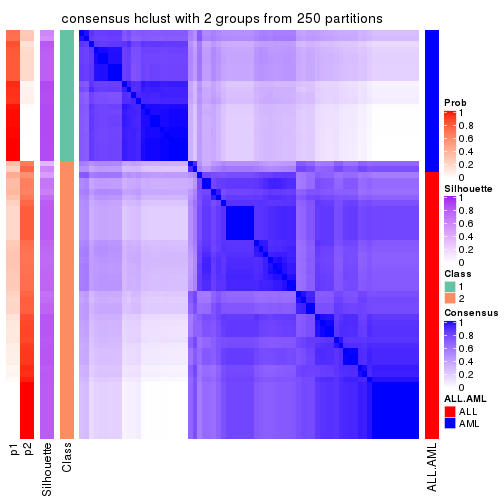
consensus_heatmap(res, k = 3)
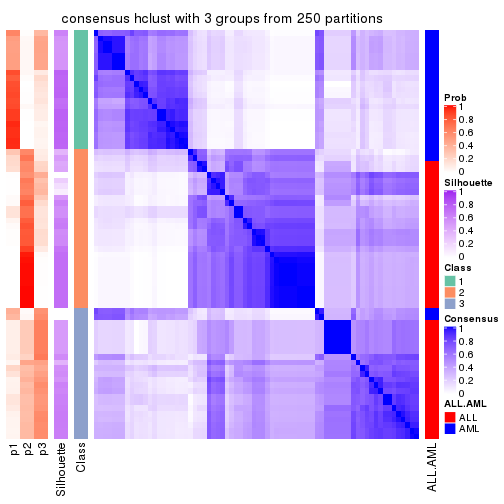
consensus_heatmap(res, k = 4)
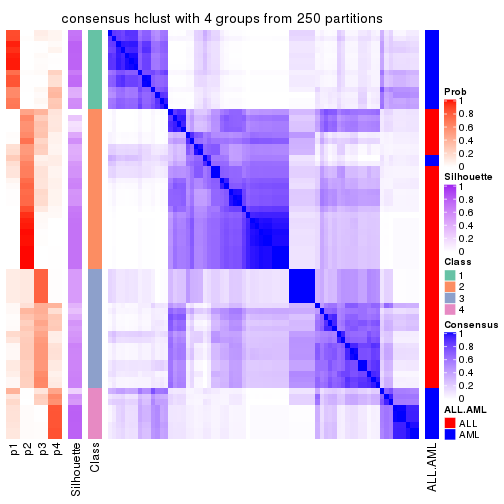
consensus_heatmap(res, k = 5)
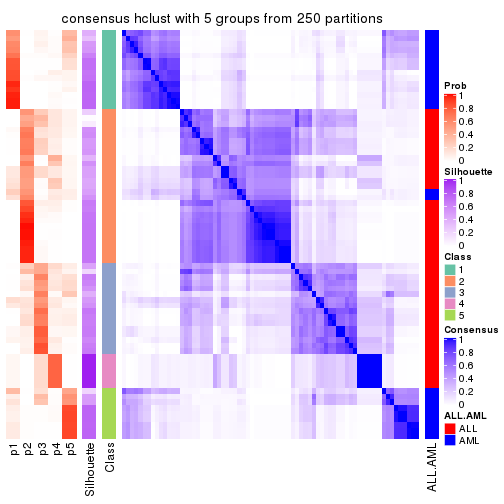
consensus_heatmap(res, k = 6)
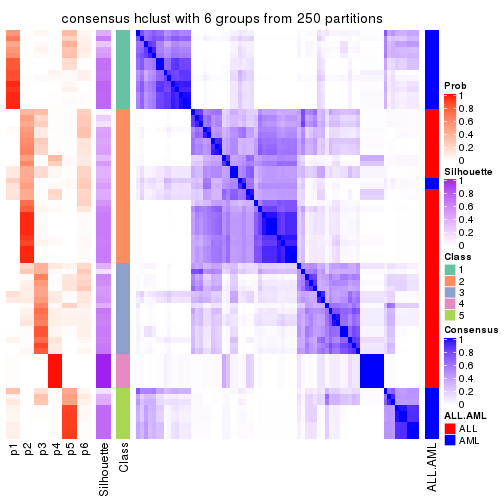
Heatmaps for the membership of samples in all partitions to see how consistent they are:
membership_heatmap(res, k = 2)
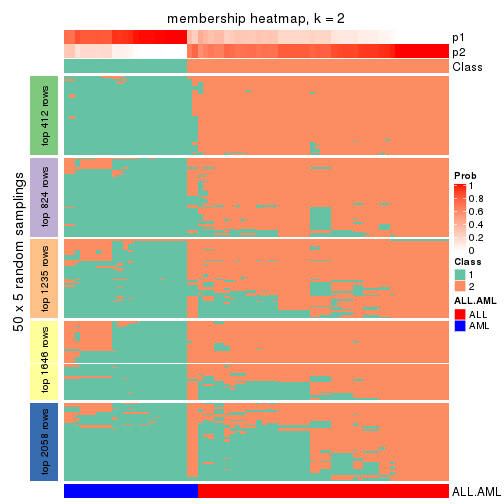
membership_heatmap(res, k = 3)
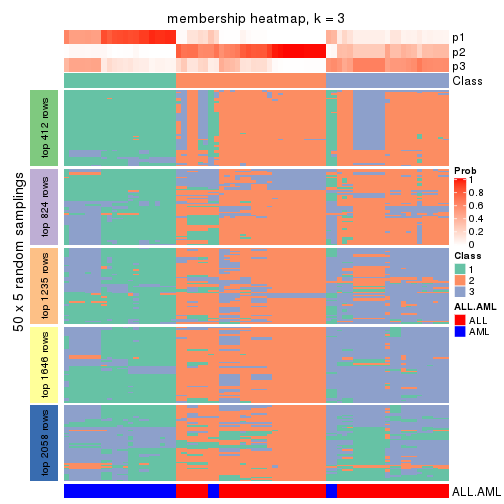
membership_heatmap(res, k = 4)
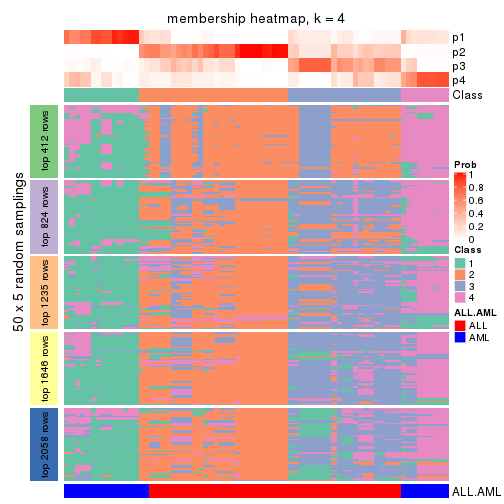
membership_heatmap(res, k = 5)
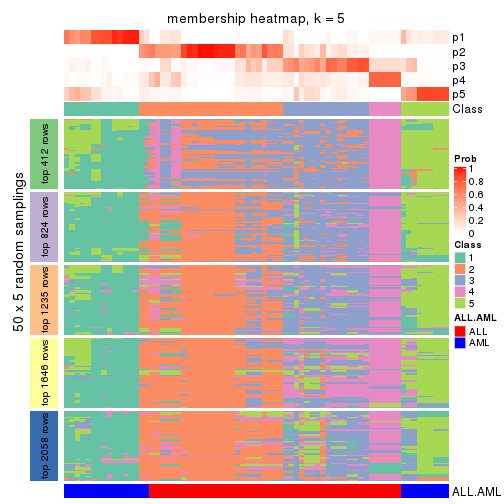
membership_heatmap(res, k = 6)
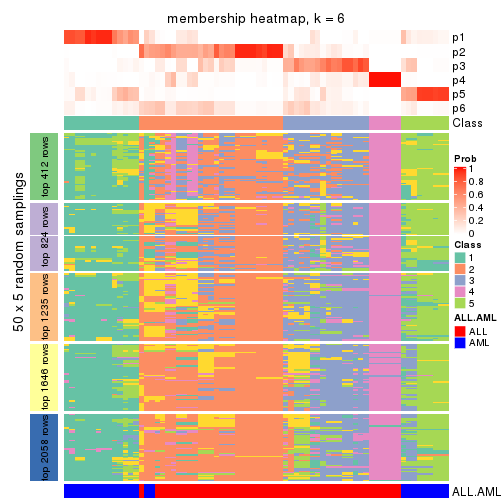
As soon as we have had the classes for columns, we can look for signatures which are significantly different between classes which can be candidate marks for certain classes. Following are the heatmaps for signatures.
Signature heatmaps where rows are scaled:
get_signatures(res, k = 2)
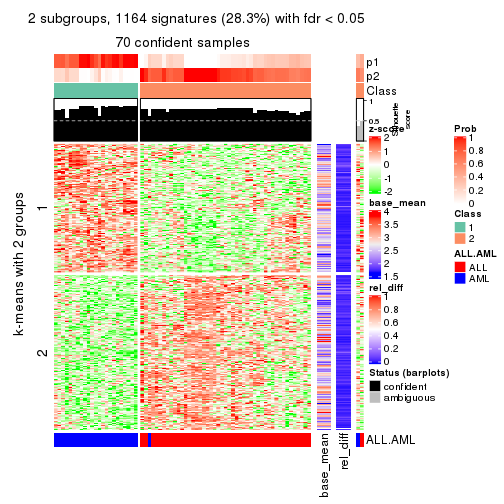
get_signatures(res, k = 3)
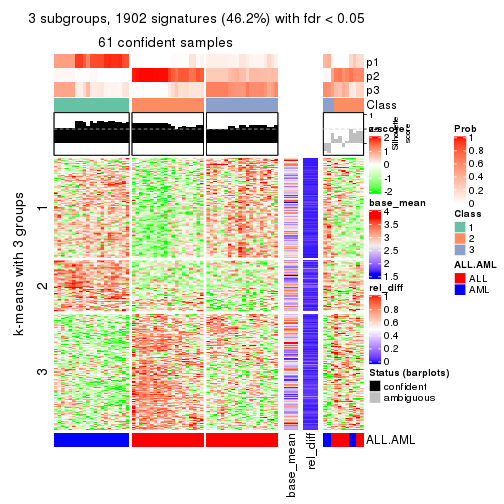
get_signatures(res, k = 4)
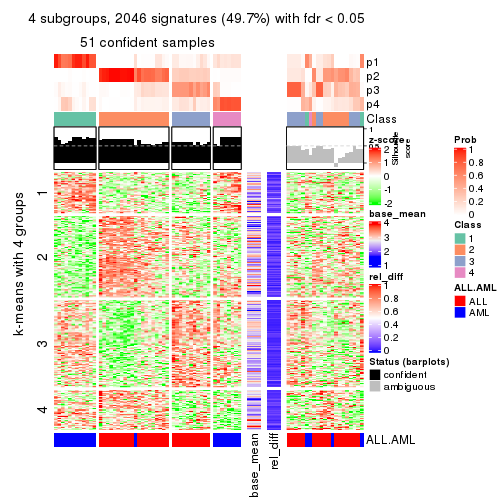
get_signatures(res, k = 5)
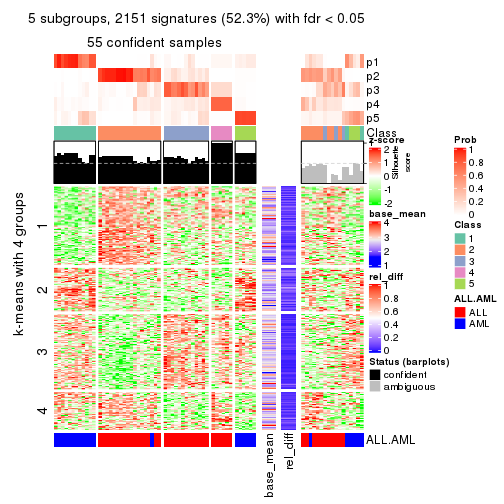
get_signatures(res, k = 6)
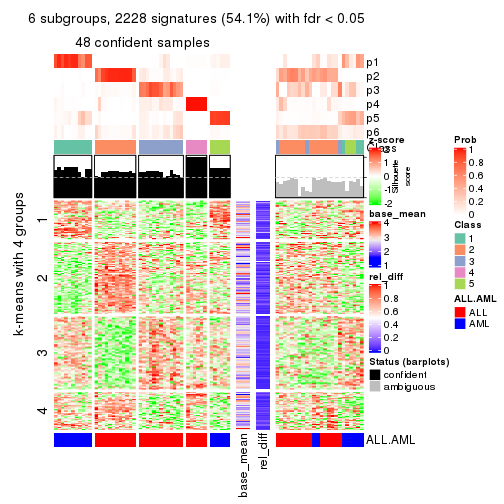
Signature heatmaps where rows are not scaled:
get_signatures(res, k = 2, scale_rows = FALSE)
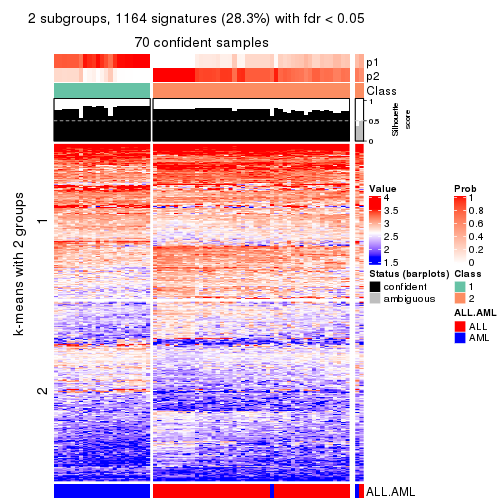
get_signatures(res, k = 3, scale_rows = FALSE)
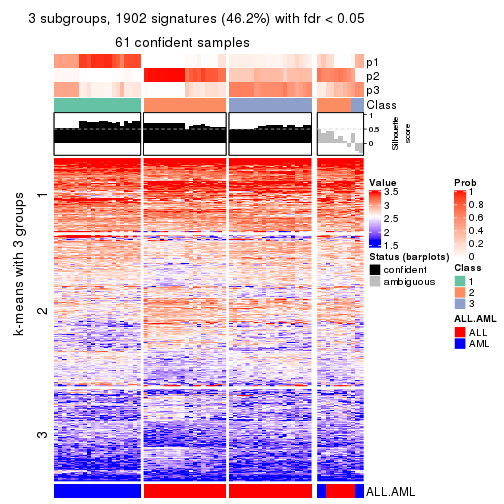
get_signatures(res, k = 4, scale_rows = FALSE)
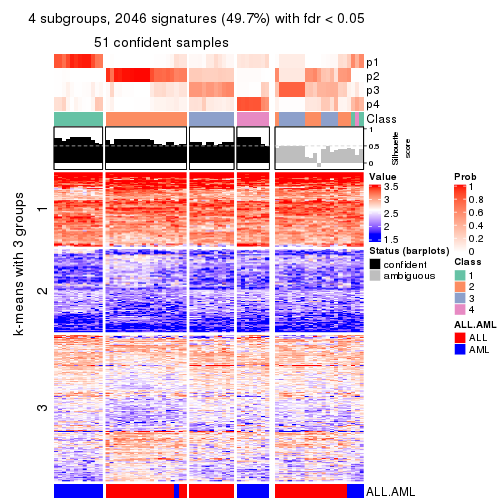
get_signatures(res, k = 5, scale_rows = FALSE)
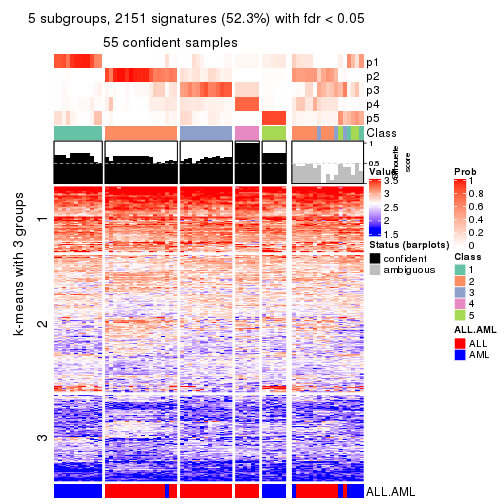
get_signatures(res, k = 6, scale_rows = FALSE)
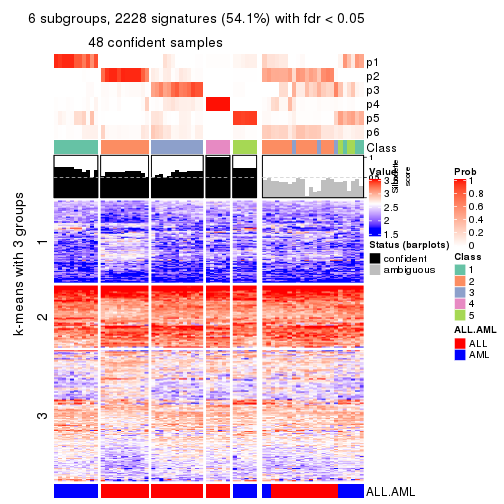
Compare the overlap of signatures from different k:
compare_signatures(res)
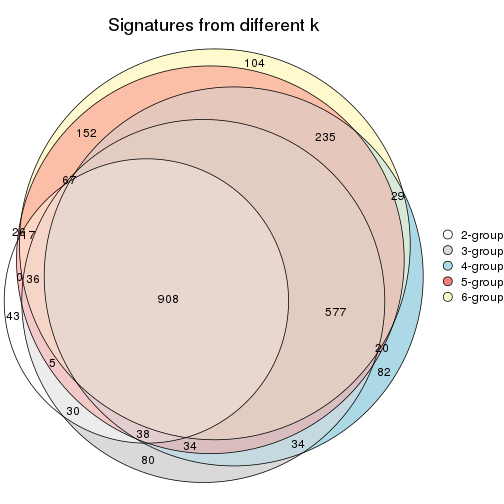
get_signature() returns a data frame invisibly. TO get the list of signatures, the function
call should be assigned to a variable explicitly. In following code, if plot argument is set
to FALSE, no heatmap is plotted while only the differential analysis is performed.
# code only for demonstration
tb = get_signature(res, k = ..., plot = FALSE)
An example of the output of tb is:
#> which_row fdr mean_1 mean_2 scaled_mean_1 scaled_mean_2 km
#> 1 38 0.042760348 8.373488 9.131774 -0.5533452 0.5164555 1
#> 2 40 0.018707592 7.106213 8.469186 -0.6173731 0.5762149 1
#> 3 55 0.019134737 10.221463 11.207825 -0.6159697 0.5749050 1
#> 4 59 0.006059896 5.921854 7.869574 -0.6899429 0.6439467 1
#> 5 60 0.018055526 8.928898 10.211722 -0.6204761 0.5791110 1
#> 6 98 0.009384629 15.714769 14.887706 0.6635654 -0.6193277 2
...
The columns in tb are:
which_row: row indices corresponding to the input matrix.fdr: FDR for the differential test. mean_x: The mean value in group x.scaled_mean_x: The mean value in group x after rows are scaled.km: Row groups if k-means clustering is applied to rows.UMAP plot which shows how samples are separated.
dimension_reduction(res, k = 2, method = "UMAP")
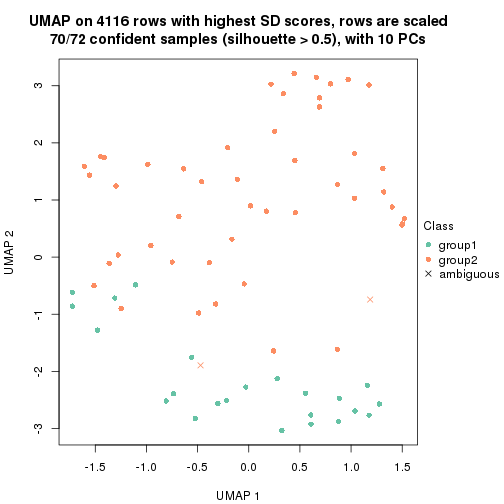
dimension_reduction(res, k = 3, method = "UMAP")
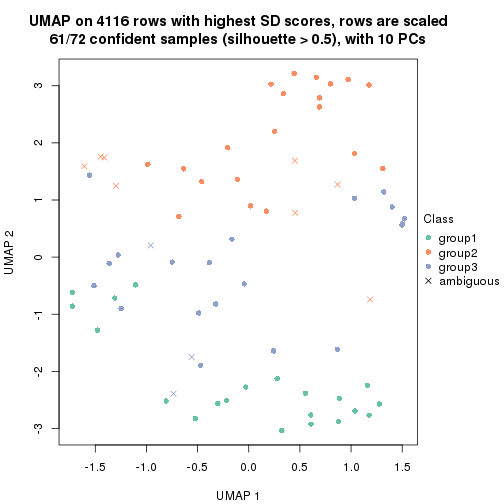
dimension_reduction(res, k = 4, method = "UMAP")
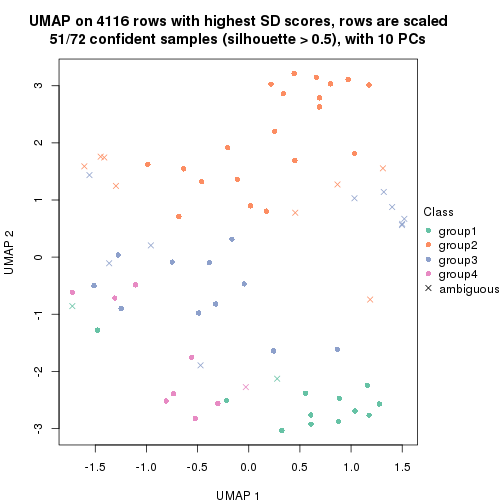
dimension_reduction(res, k = 5, method = "UMAP")
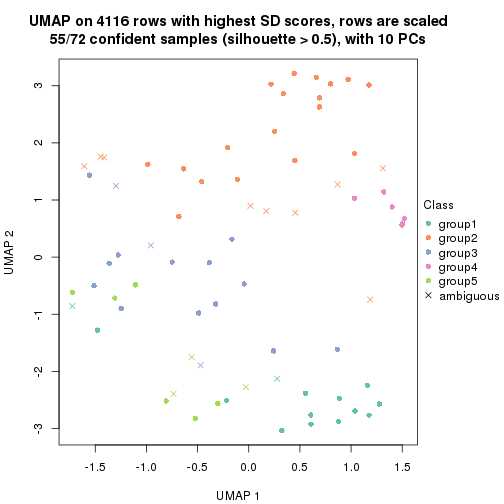
dimension_reduction(res, k = 6, method = "UMAP")
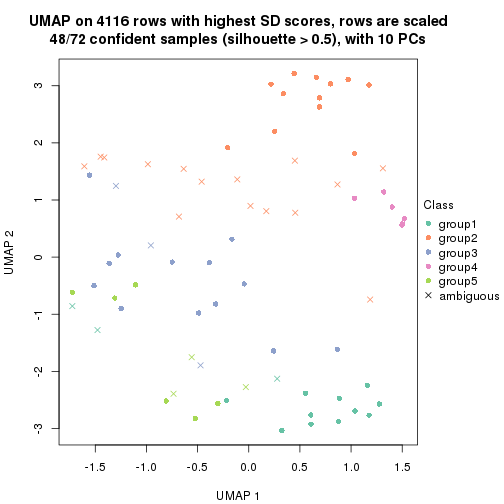
Following heatmap shows how subgroups are split when increasing k:
collect_classes(res)
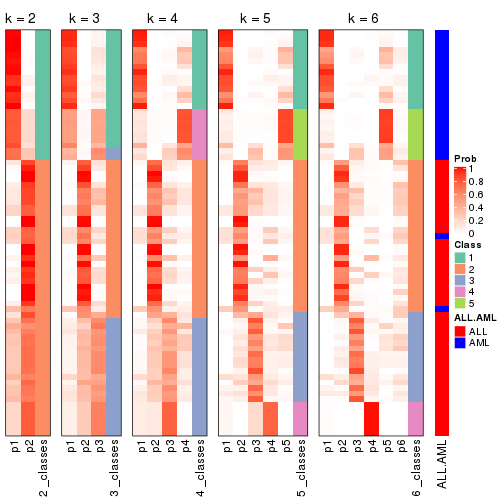
Test correlation between subgroups and known annotations. If the known annotation is numeric, one-way ANOVA test is applied, and if the known annotation is discrete, chi-squared contingency table test is applied.
test_to_known_factors(res)
#> n ALL.AML(p) k
#> SD:hclust 70 4.70e-15 2
#> SD:hclust 61 5.68e-14 3
#> SD:hclust 51 3.35e-10 4
#> SD:hclust 55 2.43e-10 5
#> SD:hclust 48 9.44e-10 6
If matrix rows can be associated to genes, consider to use functional_enrichment(res,
...) to perform function enrichment for the signature genes. See this vignette for more detailed explanations.
The object with results only for a single top-value method and a single partition method can be extracted as:
res = res_list["SD", "kmeans"]
# you can also extract it by
# res = res_list["SD:kmeans"]
A summary of res and all the functions that can be applied to it:
res
#> A 'ConsensusPartition' object with k = 2, 3, 4, 5, 6.
#> On a matrix with 4116 rows and 72 columns.
#> Top rows (412, 824, 1235, 1646, 2058) are extracted by 'SD' method.
#> Subgroups are detected by 'kmeans' method.
#> Performed in total 1250 partitions by row resampling.
#> Best k for subgroups seems to be 2.
#>
#> Following methods can be applied to this 'ConsensusPartition' object:
#> [1] "cola_report" "collect_classes" "collect_plots"
#> [4] "collect_stats" "colnames" "compare_signatures"
#> [7] "consensus_heatmap" "dimension_reduction" "functional_enrichment"
#> [10] "get_anno_col" "get_anno" "get_classes"
#> [13] "get_consensus" "get_matrix" "get_membership"
#> [16] "get_param" "get_signatures" "get_stats"
#> [19] "is_best_k" "is_stable_k" "membership_heatmap"
#> [22] "ncol" "nrow" "plot_ecdf"
#> [25] "rownames" "select_partition_number" "show"
#> [28] "suggest_best_k" "test_to_known_factors"
collect_plots() function collects all the plots made from res for all k (number of partitions)
into one single page to provide an easy and fast comparison between different k.
collect_plots(res)
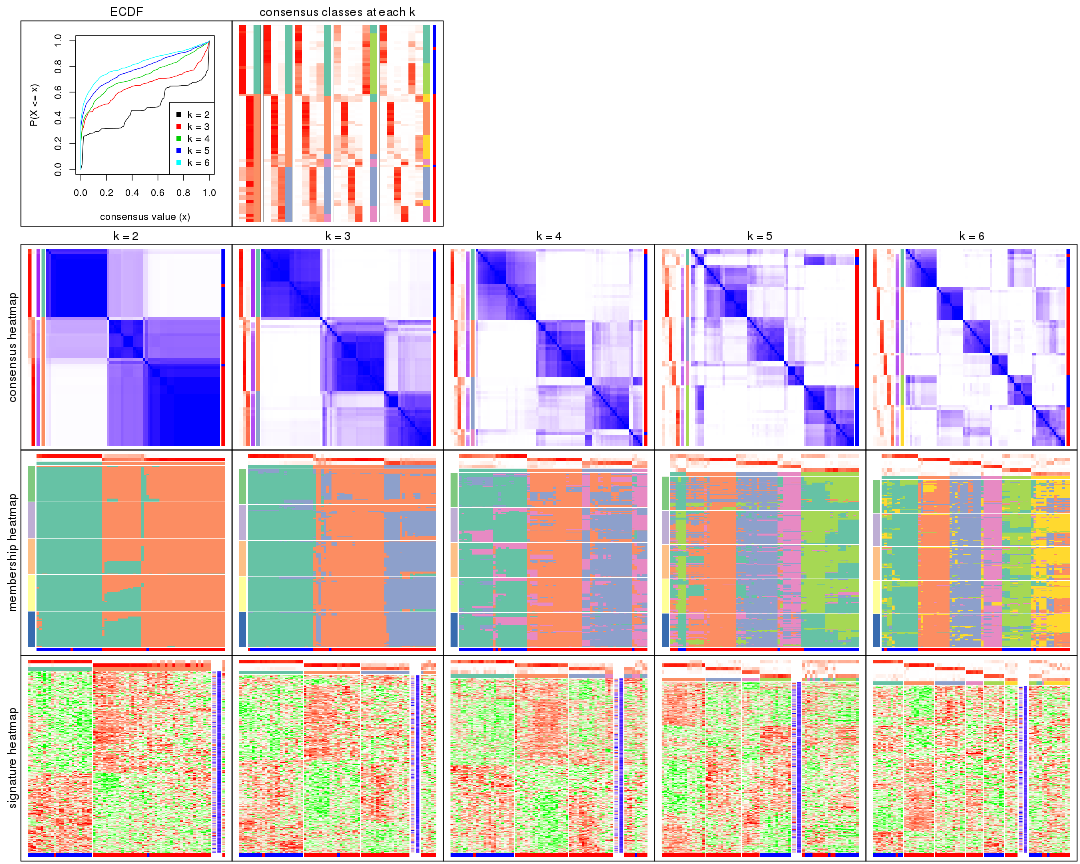
The plots are:
k and the heatmap of
predicted classes for each k.k.k.k.All the plots in panels can be made by individual functions and they are plotted later in this section.
select_partition_number() produces several plots showing different
statistics for choosing “optimized” k. There are following statistics:
k;k, the area increased is defined as \(A_k - A_{k-1}\).The detailed explanations of these statistics can be found in the cola vignette.
Generally speaking, lower PAC score, higher mean silhouette score or higher
concordance corresponds to better partition. Rand index and Jaccard index
measure how similar the current partition is compared to partition with k-1.
If they are too similar, we won't accept k is better than k-1.
select_partition_number(res)
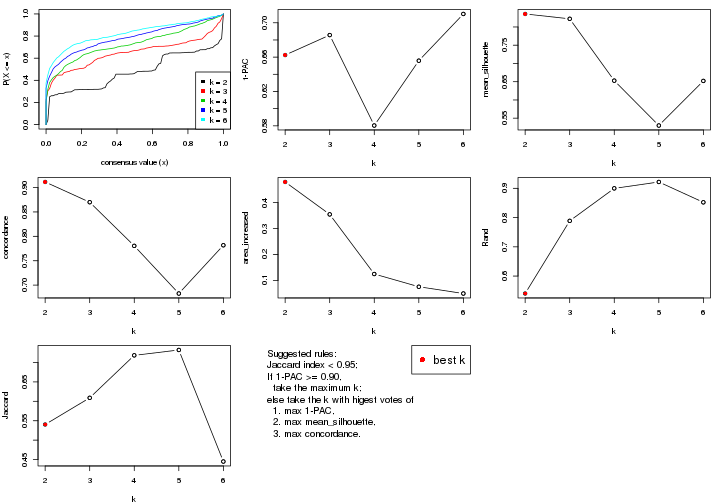
The numeric values for all these statistics can be obtained by get_stats().
get_stats(res)
#> k 1-PAC mean_silhouette concordance area_increased Rand Jaccard
#> 2 2 0.662 0.836 0.911 0.4793 0.540 0.540
#> 3 3 0.686 0.822 0.870 0.3544 0.789 0.609
#> 4 4 0.580 0.653 0.780 0.1247 0.900 0.718
#> 5 5 0.656 0.530 0.683 0.0757 0.922 0.732
#> 6 6 0.710 0.652 0.782 0.0496 0.852 0.445
suggest_best_k() suggests the best \(k\) based on these statistics. The rules are as follows:
suggest_best_k(res)
#> [1] 2
Following shows the table of the partitions (You need to click the show/hide
code output link to see it). The membership matrix (columns with name p*)
is inferred by
clue::cl_consensus()
function with the SE method. Basically the value in the membership matrix
represents the probability to belong to a certain group. The finall class
label for an item is determined with the group with highest probability it
belongs to.
In get_classes() function, the entropy is calculated from the membership
matrix and the silhouette score is calculated from the consensus matrix.
cbind(get_classes(res, k = 2), get_membership(res, k = 2))
#> class entropy silhouette p1 p2
#> sample_39 2 0.9286 0.614 0.344 0.656
#> sample_40 2 0.9522 0.575 0.372 0.628
#> sample_42 2 0.0376 0.858 0.004 0.996
#> sample_47 2 0.0376 0.858 0.004 0.996
#> sample_48 2 0.0376 0.858 0.004 0.996
#> sample_49 2 0.9552 0.568 0.376 0.624
#> sample_41 2 0.0376 0.858 0.004 0.996
#> sample_43 2 0.0376 0.858 0.004 0.996
#> sample_44 2 0.0376 0.858 0.004 0.996
#> sample_45 2 0.0376 0.858 0.004 0.996
#> sample_46 2 0.0376 0.858 0.004 0.996
#> sample_70 2 0.0672 0.857 0.008 0.992
#> sample_71 2 0.0000 0.856 0.000 1.000
#> sample_72 2 0.0000 0.856 0.000 1.000
#> sample_68 2 0.0376 0.858 0.004 0.996
#> sample_69 2 0.0376 0.858 0.004 0.996
#> sample_67 2 1.0000 -0.047 0.500 0.500
#> sample_55 2 0.9393 0.599 0.356 0.644
#> sample_56 2 0.9393 0.599 0.356 0.644
#> sample_59 2 0.0376 0.858 0.004 0.996
#> sample_52 1 0.0672 0.992 0.992 0.008
#> sample_53 1 0.0938 0.988 0.988 0.012
#> sample_51 1 0.0672 0.992 0.992 0.008
#> sample_50 1 0.0672 0.992 0.992 0.008
#> sample_54 1 0.4690 0.887 0.900 0.100
#> sample_57 1 0.0672 0.992 0.992 0.008
#> sample_58 1 0.0672 0.992 0.992 0.008
#> sample_60 1 0.0672 0.992 0.992 0.008
#> sample_61 1 0.0672 0.992 0.992 0.008
#> sample_65 1 0.0672 0.992 0.992 0.008
#> sample_66 2 0.2423 0.838 0.040 0.960
#> sample_63 1 0.0672 0.992 0.992 0.008
#> sample_64 1 0.0672 0.992 0.992 0.008
#> sample_62 1 0.0672 0.992 0.992 0.008
#> sample_1 2 0.0672 0.857 0.008 0.992
#> sample_2 2 0.6148 0.744 0.152 0.848
#> sample_3 2 0.9323 0.619 0.348 0.652
#> sample_4 2 0.0672 0.857 0.008 0.992
#> sample_5 2 0.0376 0.858 0.004 0.996
#> sample_6 2 0.9323 0.619 0.348 0.652
#> sample_7 2 0.9358 0.604 0.352 0.648
#> sample_8 2 0.9580 0.562 0.380 0.620
#> sample_9 2 0.1633 0.849 0.024 0.976
#> sample_10 2 0.9323 0.619 0.348 0.652
#> sample_11 2 0.1633 0.849 0.024 0.976
#> sample_12 1 0.0672 0.992 0.992 0.008
#> sample_13 2 0.0376 0.858 0.004 0.996
#> sample_14 2 0.1633 0.849 0.024 0.976
#> sample_15 2 0.0376 0.858 0.004 0.996
#> sample_16 2 0.0376 0.858 0.004 0.996
#> sample_17 2 0.1414 0.852 0.020 0.980
#> sample_18 2 0.5842 0.788 0.140 0.860
#> sample_19 2 0.0376 0.858 0.004 0.996
#> sample_20 2 0.0376 0.858 0.004 0.996
#> sample_21 2 0.0000 0.856 0.000 1.000
#> sample_22 2 0.9552 0.562 0.376 0.624
#> sample_23 2 0.9323 0.619 0.348 0.652
#> sample_24 2 0.0376 0.858 0.004 0.996
#> sample_25 2 0.8955 0.650 0.312 0.688
#> sample_26 2 0.0376 0.858 0.004 0.996
#> sample_27 2 0.9580 0.562 0.380 0.620
#> sample_34 1 0.0672 0.992 0.992 0.008
#> sample_35 1 0.0672 0.992 0.992 0.008
#> sample_36 1 0.0672 0.992 0.992 0.008
#> sample_37 1 0.0672 0.992 0.992 0.008
#> sample_38 1 0.0938 0.988 0.988 0.012
#> sample_28 1 0.0672 0.992 0.992 0.008
#> sample_29 1 0.3431 0.928 0.936 0.064
#> sample_30 1 0.0672 0.992 0.992 0.008
#> sample_31 1 0.0672 0.992 0.992 0.008
#> sample_32 1 0.0672 0.992 0.992 0.008
#> sample_33 1 0.0672 0.992 0.992 0.008
cbind(get_classes(res, k = 3), get_membership(res, k = 3))
#> class entropy silhouette p1 p2 p3
#> sample_39 3 0.6287 0.8560 0.024 0.272 0.704
#> sample_40 3 0.6226 0.8634 0.028 0.252 0.720
#> sample_42 2 0.0747 0.8499 0.000 0.984 0.016
#> sample_47 2 0.0000 0.8528 0.000 1.000 0.000
#> sample_48 2 0.0237 0.8529 0.000 0.996 0.004
#> sample_49 3 0.6187 0.8644 0.028 0.248 0.724
#> sample_41 2 0.1529 0.8440 0.000 0.960 0.040
#> sample_43 2 0.0424 0.8515 0.000 0.992 0.008
#> sample_44 2 0.0747 0.8507 0.000 0.984 0.016
#> sample_45 2 0.0592 0.8516 0.000 0.988 0.012
#> sample_46 2 0.0592 0.8516 0.000 0.988 0.012
#> sample_70 3 0.5905 0.7804 0.000 0.352 0.648
#> sample_71 2 0.2261 0.8079 0.000 0.932 0.068
#> sample_72 2 0.2165 0.8120 0.000 0.936 0.064
#> sample_68 2 0.1411 0.8461 0.000 0.964 0.036
#> sample_69 2 0.0000 0.8528 0.000 1.000 0.000
#> sample_67 2 0.7841 0.0517 0.472 0.476 0.052
#> sample_55 3 0.5849 0.8599 0.028 0.216 0.756
#> sample_56 3 0.6226 0.8634 0.028 0.252 0.720
#> sample_59 2 0.6252 -0.3283 0.000 0.556 0.444
#> sample_52 1 0.2625 0.9576 0.916 0.000 0.084
#> sample_53 1 0.0747 0.9588 0.984 0.000 0.016
#> sample_51 1 0.0747 0.9588 0.984 0.000 0.016
#> sample_50 1 0.0592 0.9596 0.988 0.000 0.012
#> sample_54 1 0.3112 0.9525 0.900 0.004 0.096
#> sample_57 1 0.2878 0.9536 0.904 0.000 0.096
#> sample_58 1 0.2796 0.9551 0.908 0.000 0.092
#> sample_60 1 0.2878 0.9536 0.904 0.000 0.096
#> sample_61 1 0.1643 0.9627 0.956 0.000 0.044
#> sample_65 1 0.1643 0.9629 0.956 0.000 0.044
#> sample_66 2 0.5680 0.6667 0.024 0.764 0.212
#> sample_63 1 0.2711 0.9566 0.912 0.000 0.088
#> sample_64 1 0.2796 0.9551 0.908 0.000 0.092
#> sample_62 1 0.2711 0.9566 0.912 0.000 0.088
#> sample_1 3 0.5678 0.8231 0.000 0.316 0.684
#> sample_2 2 0.8616 0.4682 0.148 0.588 0.264
#> sample_3 3 0.3112 0.7825 0.004 0.096 0.900
#> sample_4 3 0.5327 0.8388 0.000 0.272 0.728
#> sample_5 2 0.1411 0.8461 0.000 0.964 0.036
#> sample_6 3 0.3112 0.7825 0.004 0.096 0.900
#> sample_7 3 0.5894 0.8601 0.028 0.220 0.752
#> sample_8 3 0.6264 0.8635 0.028 0.256 0.716
#> sample_9 3 0.4399 0.7249 0.000 0.188 0.812
#> sample_10 3 0.3112 0.7825 0.004 0.096 0.900
#> sample_11 3 0.5988 0.3704 0.000 0.368 0.632
#> sample_12 1 0.1647 0.9529 0.960 0.004 0.036
#> sample_13 2 0.0237 0.8529 0.000 0.996 0.004
#> sample_14 2 0.6244 0.2863 0.000 0.560 0.440
#> sample_15 2 0.1411 0.8461 0.000 0.964 0.036
#> sample_16 2 0.1163 0.8445 0.000 0.972 0.028
#> sample_17 2 0.3752 0.7568 0.000 0.856 0.144
#> sample_18 3 0.5692 0.8554 0.008 0.268 0.724
#> sample_19 2 0.0592 0.8510 0.000 0.988 0.012
#> sample_20 2 0.0000 0.8528 0.000 1.000 0.000
#> sample_21 2 0.1411 0.8476 0.000 0.964 0.036
#> sample_22 3 0.6596 0.8615 0.040 0.256 0.704
#> sample_23 3 0.3112 0.7825 0.004 0.096 0.900
#> sample_24 2 0.1529 0.8440 0.000 0.960 0.040
#> sample_25 3 0.7222 0.7093 0.032 0.388 0.580
#> sample_26 2 0.5138 0.4580 0.000 0.748 0.252
#> sample_27 3 0.6187 0.8644 0.028 0.248 0.724
#> sample_34 1 0.2261 0.9606 0.932 0.000 0.068
#> sample_35 1 0.2796 0.9580 0.908 0.000 0.092
#> sample_36 1 0.0424 0.9612 0.992 0.000 0.008
#> sample_37 1 0.0747 0.9588 0.984 0.000 0.016
#> sample_38 1 0.0983 0.9575 0.980 0.004 0.016
#> sample_28 1 0.0983 0.9575 0.980 0.004 0.016
#> sample_29 1 0.0983 0.9571 0.980 0.004 0.016
#> sample_30 1 0.0237 0.9608 0.996 0.000 0.004
#> sample_31 1 0.2165 0.9612 0.936 0.000 0.064
#> sample_32 1 0.0424 0.9621 0.992 0.000 0.008
#> sample_33 1 0.0747 0.9588 0.984 0.000 0.016
cbind(get_classes(res, k = 4), get_membership(res, k = 4))
#> class entropy silhouette p1 p2 p3 p4
#> sample_39 3 0.4819 0.67129 0.004 0.152 0.784 0.060
#> sample_40 3 0.2926 0.71108 0.004 0.096 0.888 0.012
#> sample_42 2 0.6994 0.56098 0.012 0.604 0.128 0.256
#> sample_47 2 0.2596 0.81643 0.000 0.908 0.024 0.068
#> sample_48 2 0.0336 0.82986 0.000 0.992 0.008 0.000
#> sample_49 3 0.2861 0.71000 0.004 0.092 0.892 0.012
#> sample_41 2 0.1545 0.81601 0.000 0.952 0.040 0.008
#> sample_43 2 0.4419 0.77663 0.000 0.812 0.104 0.084
#> sample_44 2 0.4673 0.76617 0.000 0.792 0.132 0.076
#> sample_45 2 0.3834 0.79510 0.000 0.848 0.076 0.076
#> sample_46 2 0.4100 0.78716 0.000 0.832 0.092 0.076
#> sample_70 3 0.5875 0.60802 0.000 0.204 0.692 0.104
#> sample_71 2 0.7146 0.52216 0.016 0.596 0.132 0.256
#> sample_72 2 0.7013 0.53504 0.012 0.604 0.132 0.252
#> sample_68 2 0.1356 0.81813 0.000 0.960 0.032 0.008
#> sample_69 2 0.0336 0.82955 0.000 0.992 0.008 0.000
#> sample_67 1 0.8033 -0.02386 0.488 0.212 0.020 0.280
#> sample_55 3 0.3619 0.66518 0.004 0.100 0.860 0.036
#> sample_56 3 0.3221 0.71204 0.004 0.100 0.876 0.020
#> sample_59 3 0.6280 0.50968 0.000 0.304 0.612 0.084
#> sample_52 1 0.4836 0.76925 0.672 0.000 0.008 0.320
#> sample_53 1 0.0336 0.79640 0.992 0.000 0.000 0.008
#> sample_51 1 0.0188 0.79765 0.996 0.000 0.000 0.004
#> sample_50 1 0.0188 0.79765 0.996 0.000 0.000 0.004
#> sample_54 1 0.6825 0.70709 0.556 0.008 0.088 0.348
#> sample_57 1 0.6439 0.72143 0.576 0.000 0.084 0.340
#> sample_58 1 0.6135 0.74118 0.608 0.000 0.068 0.324
#> sample_60 1 0.6523 0.71280 0.564 0.000 0.088 0.348
#> sample_61 1 0.4782 0.79838 0.780 0.000 0.068 0.152
#> sample_65 1 0.3808 0.80376 0.812 0.000 0.012 0.176
#> sample_66 4 0.7782 0.00808 0.080 0.408 0.052 0.460
#> sample_63 1 0.5173 0.76532 0.660 0.000 0.020 0.320
#> sample_64 1 0.6338 0.73656 0.600 0.000 0.084 0.316
#> sample_62 1 0.5271 0.76377 0.656 0.000 0.024 0.320
#> sample_1 3 0.3910 0.69878 0.000 0.156 0.820 0.024
#> sample_2 4 0.8174 0.49359 0.188 0.184 0.068 0.560
#> sample_3 3 0.5614 -0.26529 0.008 0.012 0.568 0.412
#> sample_4 3 0.3306 0.65895 0.000 0.156 0.840 0.004
#> sample_5 2 0.1545 0.81601 0.000 0.952 0.040 0.008
#> sample_6 3 0.5614 -0.26529 0.008 0.012 0.568 0.412
#> sample_7 3 0.3172 0.67541 0.004 0.112 0.872 0.012
#> sample_8 3 0.2466 0.70936 0.004 0.096 0.900 0.000
#> sample_9 4 0.6407 0.52600 0.008 0.048 0.424 0.520
#> sample_10 4 0.5577 0.45338 0.008 0.008 0.460 0.524
#> sample_11 4 0.6965 0.61441 0.008 0.100 0.344 0.548
#> sample_12 1 0.3916 0.72171 0.848 0.004 0.092 0.056
#> sample_13 2 0.0336 0.82986 0.000 0.992 0.008 0.000
#> sample_14 4 0.7178 0.60794 0.000 0.156 0.324 0.520
#> sample_15 2 0.1545 0.81601 0.000 0.952 0.040 0.008
#> sample_16 2 0.2408 0.80791 0.000 0.896 0.104 0.000
#> sample_17 2 0.5705 0.52086 0.000 0.712 0.108 0.180
#> sample_18 3 0.4046 0.70455 0.000 0.124 0.828 0.048
#> sample_19 2 0.4458 0.77258 0.000 0.808 0.116 0.076
#> sample_20 2 0.0188 0.82988 0.000 0.996 0.004 0.000
#> sample_21 2 0.1610 0.81865 0.000 0.952 0.032 0.016
#> sample_22 3 0.4821 0.66538 0.024 0.088 0.812 0.076
#> sample_23 3 0.5614 -0.26529 0.008 0.012 0.568 0.412
#> sample_24 2 0.1970 0.79947 0.000 0.932 0.060 0.008
#> sample_25 3 0.7376 0.47043 0.016 0.236 0.580 0.168
#> sample_26 3 0.6752 0.10797 0.000 0.440 0.468 0.092
#> sample_27 3 0.2861 0.71000 0.004 0.092 0.892 0.012
#> sample_34 1 0.4212 0.79874 0.772 0.000 0.012 0.216
#> sample_35 1 0.5783 0.77430 0.692 0.000 0.088 0.220
#> sample_36 1 0.0707 0.80135 0.980 0.000 0.000 0.020
#> sample_37 1 0.0336 0.79640 0.992 0.000 0.000 0.008
#> sample_38 1 0.2124 0.76243 0.924 0.000 0.008 0.068
#> sample_28 1 0.1807 0.77306 0.940 0.000 0.008 0.052
#> sample_29 1 0.2530 0.73173 0.888 0.000 0.000 0.112
#> sample_30 1 0.0469 0.80077 0.988 0.000 0.000 0.012
#> sample_31 1 0.3933 0.80105 0.792 0.000 0.008 0.200
#> sample_32 1 0.0927 0.80175 0.976 0.000 0.008 0.016
#> sample_33 1 0.0336 0.79640 0.992 0.000 0.000 0.008
cbind(get_classes(res, k = 5), get_membership(res, k = 5))
#> class entropy silhouette p1 p2 p3 p4 p5
#> sample_39 3 0.3589 0.76090 0.084 0.032 0.848 0.036 0.000
#> sample_40 3 0.2086 0.78722 0.000 0.028 0.928 0.016 0.028
#> sample_42 1 0.8187 -0.28465 0.388 0.284 0.168 0.160 0.000
#> sample_47 2 0.5495 0.64954 0.220 0.684 0.048 0.048 0.000
#> sample_48 2 0.0912 0.76262 0.012 0.972 0.016 0.000 0.000
#> sample_49 3 0.1729 0.78458 0.004 0.032 0.944 0.012 0.008
#> sample_41 2 0.1095 0.75438 0.012 0.968 0.012 0.008 0.000
#> sample_43 2 0.7095 0.53773 0.264 0.520 0.164 0.052 0.000
#> sample_44 2 0.7328 0.48667 0.228 0.496 0.220 0.056 0.000
#> sample_45 2 0.6027 0.63074 0.228 0.644 0.076 0.052 0.000
#> sample_46 2 0.6513 0.60323 0.228 0.604 0.112 0.056 0.000
#> sample_70 3 0.5802 0.62765 0.232 0.040 0.656 0.072 0.000
#> sample_71 1 0.8380 -0.28127 0.324 0.308 0.164 0.204 0.000
#> sample_72 2 0.8374 0.11846 0.316 0.320 0.168 0.196 0.000
#> sample_68 2 0.0693 0.75718 0.012 0.980 0.000 0.008 0.000
#> sample_69 2 0.1211 0.76119 0.024 0.960 0.016 0.000 0.000
#> sample_67 1 0.8192 0.18424 0.416 0.088 0.012 0.240 0.244
#> sample_55 3 0.3847 0.74394 0.056 0.064 0.844 0.028 0.008
#> sample_56 3 0.1706 0.78787 0.012 0.016 0.948 0.016 0.008
#> sample_59 3 0.6564 0.56616 0.256 0.092 0.588 0.064 0.000
#> sample_52 5 0.3867 0.57094 0.144 0.000 0.004 0.048 0.804
#> sample_53 5 0.4219 0.29396 0.416 0.000 0.000 0.000 0.584
#> sample_51 5 0.4201 0.30913 0.408 0.000 0.000 0.000 0.592
#> sample_50 5 0.4201 0.30913 0.408 0.000 0.000 0.000 0.592
#> sample_54 5 0.5809 0.49726 0.212 0.000 0.052 0.068 0.668
#> sample_57 5 0.5401 0.53295 0.184 0.000 0.044 0.064 0.708
#> sample_58 5 0.4775 0.55573 0.160 0.000 0.032 0.052 0.756
#> sample_60 5 0.5783 0.50833 0.200 0.000 0.056 0.068 0.676
#> sample_61 5 0.3530 0.54640 0.104 0.000 0.028 0.024 0.844
#> sample_65 5 0.1830 0.56053 0.068 0.000 0.000 0.008 0.924
#> sample_66 4 0.7379 0.12455 0.344 0.224 0.016 0.404 0.012
#> sample_63 5 0.3989 0.57051 0.144 0.000 0.008 0.048 0.800
#> sample_64 5 0.4978 0.54686 0.140 0.000 0.068 0.040 0.752
#> sample_62 5 0.4058 0.56953 0.144 0.000 0.008 0.052 0.796
#> sample_1 3 0.1997 0.78867 0.016 0.028 0.932 0.024 0.000
#> sample_2 4 0.6342 0.32452 0.320 0.088 0.012 0.564 0.016
#> sample_3 4 0.3636 0.70975 0.000 0.000 0.272 0.728 0.000
#> sample_4 3 0.3342 0.72663 0.008 0.136 0.836 0.020 0.000
#> sample_5 2 0.0854 0.75620 0.012 0.976 0.004 0.008 0.000
#> sample_6 4 0.3636 0.70975 0.000 0.000 0.272 0.728 0.000
#> sample_7 3 0.2616 0.76792 0.008 0.068 0.900 0.016 0.008
#> sample_8 3 0.1518 0.78845 0.012 0.020 0.952 0.016 0.000
#> sample_9 4 0.3098 0.76669 0.000 0.016 0.148 0.836 0.000
#> sample_10 4 0.2732 0.76298 0.000 0.000 0.160 0.840 0.000
#> sample_11 4 0.3193 0.76182 0.004 0.032 0.112 0.852 0.000
#> sample_12 5 0.6376 -0.00821 0.388 0.000 0.080 0.032 0.500
#> sample_13 2 0.0912 0.76262 0.012 0.972 0.016 0.000 0.000
#> sample_14 4 0.3476 0.74547 0.000 0.076 0.088 0.836 0.000
#> sample_15 2 0.0854 0.75620 0.012 0.976 0.004 0.008 0.000
#> sample_16 2 0.4514 0.62916 0.024 0.736 0.220 0.020 0.000
#> sample_17 2 0.4859 0.53344 0.032 0.740 0.032 0.192 0.004
#> sample_18 3 0.3716 0.76714 0.072 0.036 0.844 0.048 0.000
#> sample_19 2 0.7105 0.52595 0.216 0.536 0.192 0.056 0.000
#> sample_20 2 0.0798 0.76254 0.008 0.976 0.016 0.000 0.000
#> sample_21 2 0.0740 0.75819 0.004 0.980 0.008 0.008 0.000
#> sample_22 3 0.3514 0.74802 0.088 0.016 0.848 0.048 0.000
#> sample_23 4 0.3636 0.70975 0.000 0.000 0.272 0.728 0.000
#> sample_24 2 0.1095 0.75438 0.012 0.968 0.012 0.008 0.000
#> sample_25 3 0.7512 0.38966 0.348 0.092 0.448 0.108 0.004
#> sample_26 3 0.7167 0.47689 0.220 0.148 0.548 0.084 0.000
#> sample_27 3 0.1729 0.78458 0.004 0.032 0.944 0.012 0.008
#> sample_34 5 0.0798 0.57805 0.016 0.000 0.008 0.000 0.976
#> sample_35 5 0.2756 0.55600 0.024 0.000 0.092 0.004 0.880
#> sample_36 5 0.4530 0.34139 0.376 0.000 0.004 0.008 0.612
#> sample_37 5 0.4227 0.28696 0.420 0.000 0.000 0.000 0.580
#> sample_38 1 0.4430 -0.10635 0.540 0.000 0.000 0.004 0.456
#> sample_28 1 0.4448 -0.16001 0.516 0.000 0.000 0.004 0.480
#> sample_29 1 0.4882 -0.12385 0.532 0.000 0.000 0.024 0.444
#> sample_30 5 0.4530 0.33769 0.376 0.000 0.004 0.008 0.612
#> sample_31 5 0.1059 0.57677 0.020 0.000 0.008 0.004 0.968
#> sample_32 5 0.4520 0.37971 0.296 0.000 0.008 0.016 0.680
#> sample_33 5 0.4219 0.29396 0.416 0.000 0.000 0.000 0.584
cbind(get_classes(res, k = 6), get_membership(res, k = 6))
#> class entropy silhouette p1 p2 p3 p4 p5 p6
#> sample_39 3 0.3276 0.7517 0.004 0.008 0.812 0.004 0.008 0.164
#> sample_40 3 0.2650 0.8556 0.000 0.004 0.888 0.016 0.036 0.056
#> sample_42 6 0.4976 0.5731 0.044 0.080 0.044 0.048 0.016 0.768
#> sample_47 6 0.4928 0.2835 0.000 0.464 0.024 0.004 0.016 0.492
#> sample_48 2 0.1500 0.8854 0.000 0.936 0.012 0.000 0.000 0.052
#> sample_49 3 0.1198 0.8705 0.000 0.004 0.960 0.012 0.020 0.004
#> sample_41 2 0.0665 0.8971 0.000 0.980 0.000 0.008 0.008 0.004
#> sample_43 6 0.5687 0.5293 0.004 0.300 0.092 0.004 0.020 0.580
#> sample_44 6 0.6106 0.4981 0.000 0.316 0.172 0.000 0.020 0.492
#> sample_45 6 0.5328 0.4064 0.000 0.404 0.060 0.000 0.020 0.516
#> sample_46 6 0.5410 0.4208 0.000 0.396 0.068 0.000 0.020 0.516
#> sample_70 6 0.4642 0.1774 0.000 0.012 0.452 0.000 0.020 0.516
#> sample_71 6 0.6180 0.5174 0.036 0.080 0.068 0.108 0.028 0.680
#> sample_72 6 0.6467 0.5345 0.036 0.088 0.084 0.108 0.028 0.656
#> sample_68 2 0.0520 0.8989 0.000 0.984 0.000 0.008 0.008 0.000
#> sample_69 2 0.1701 0.8722 0.000 0.920 0.008 0.000 0.000 0.072
#> sample_67 6 0.7288 -0.0366 0.372 0.048 0.000 0.144 0.048 0.388
#> sample_55 3 0.4076 0.7915 0.000 0.084 0.800 0.004 0.064 0.048
#> sample_56 3 0.1036 0.8684 0.000 0.004 0.964 0.000 0.024 0.008
#> sample_59 6 0.5394 0.2297 0.000 0.036 0.412 0.000 0.044 0.508
#> sample_52 5 0.2520 0.7676 0.152 0.004 0.000 0.000 0.844 0.000
#> sample_53 1 0.1387 0.7832 0.932 0.000 0.000 0.000 0.068 0.000
#> sample_51 1 0.1387 0.7832 0.932 0.000 0.000 0.000 0.068 0.000
#> sample_50 1 0.1387 0.7832 0.932 0.000 0.000 0.000 0.068 0.000
#> sample_54 5 0.3296 0.7399 0.056 0.000 0.040 0.008 0.856 0.040
#> sample_57 5 0.3255 0.7557 0.076 0.000 0.040 0.004 0.852 0.028
#> sample_58 5 0.3436 0.7713 0.108 0.000 0.028 0.004 0.832 0.028
#> sample_60 5 0.3296 0.7399 0.056 0.000 0.040 0.008 0.856 0.040
#> sample_61 1 0.6001 -0.1745 0.464 0.000 0.036 0.008 0.416 0.076
#> sample_65 1 0.4983 -0.1871 0.484 0.000 0.000 0.008 0.460 0.048
#> sample_66 6 0.6888 0.3290 0.108 0.088 0.000 0.196 0.044 0.564
#> sample_63 5 0.2340 0.7701 0.148 0.000 0.000 0.000 0.852 0.000
#> sample_64 5 0.4936 0.7289 0.100 0.004 0.060 0.016 0.752 0.068
#> sample_62 5 0.2482 0.7701 0.148 0.004 0.000 0.000 0.848 0.000
#> sample_1 3 0.1624 0.8615 0.000 0.008 0.936 0.012 0.000 0.044
#> sample_2 4 0.7114 0.0846 0.148 0.024 0.004 0.396 0.048 0.380
#> sample_3 4 0.2278 0.8297 0.000 0.004 0.128 0.868 0.000 0.000
#> sample_4 3 0.3368 0.8074 0.000 0.124 0.828 0.016 0.004 0.028
#> sample_5 2 0.0520 0.8989 0.000 0.984 0.000 0.008 0.008 0.000
#> sample_6 4 0.2278 0.8297 0.000 0.004 0.128 0.868 0.000 0.000
#> sample_7 3 0.2979 0.8408 0.000 0.080 0.868 0.016 0.012 0.024
#> sample_8 3 0.1836 0.8644 0.000 0.004 0.928 0.012 0.008 0.048
#> sample_9 4 0.1124 0.8533 0.000 0.008 0.036 0.956 0.000 0.000
#> sample_10 4 0.1299 0.8533 0.004 0.004 0.036 0.952 0.004 0.000
#> sample_11 4 0.1180 0.8483 0.004 0.008 0.024 0.960 0.004 0.000
#> sample_12 1 0.5595 0.5130 0.632 0.000 0.028 0.016 0.080 0.244
#> sample_13 2 0.1500 0.8854 0.000 0.936 0.012 0.000 0.000 0.052
#> sample_14 4 0.1887 0.8348 0.000 0.024 0.020 0.932 0.016 0.008
#> sample_15 2 0.0520 0.8989 0.000 0.984 0.000 0.008 0.008 0.000
#> sample_16 2 0.4449 0.5167 0.000 0.696 0.216 0.000 0.000 0.088
#> sample_17 2 0.4492 0.7035 0.020 0.784 0.012 0.112 0.044 0.028
#> sample_18 3 0.4624 0.6378 0.000 0.004 0.724 0.024 0.060 0.188
#> sample_19 6 0.5552 0.5141 0.000 0.328 0.108 0.004 0.008 0.552
#> sample_20 2 0.1563 0.8825 0.000 0.932 0.012 0.000 0.000 0.056
#> sample_21 2 0.1371 0.8927 0.000 0.948 0.004 0.004 0.004 0.040
#> sample_22 3 0.3612 0.7648 0.016 0.000 0.804 0.012 0.016 0.152
#> sample_23 4 0.2420 0.8294 0.000 0.004 0.128 0.864 0.004 0.000
#> sample_24 2 0.0520 0.8989 0.000 0.984 0.000 0.008 0.008 0.000
#> sample_25 6 0.5010 0.4766 0.024 0.020 0.224 0.024 0.012 0.696
#> sample_26 6 0.5408 0.3514 0.000 0.080 0.384 0.004 0.008 0.524
#> sample_27 3 0.1198 0.8705 0.000 0.004 0.960 0.012 0.020 0.004
#> sample_34 5 0.5471 0.3041 0.408 0.004 0.004 0.016 0.512 0.056
#> sample_35 5 0.6976 0.4355 0.292 0.004 0.112 0.016 0.492 0.084
#> sample_36 1 0.1814 0.7656 0.900 0.000 0.000 0.000 0.100 0.000
#> sample_37 1 0.1267 0.7819 0.940 0.000 0.000 0.000 0.060 0.000
#> sample_38 1 0.1769 0.7206 0.924 0.000 0.000 0.004 0.012 0.060
#> sample_28 1 0.1625 0.7338 0.928 0.000 0.000 0.000 0.012 0.060
#> sample_29 1 0.3251 0.6699 0.828 0.000 0.000 0.008 0.040 0.124
#> sample_30 1 0.1663 0.7734 0.912 0.000 0.000 0.000 0.088 0.000
#> sample_31 5 0.5214 0.2145 0.444 0.004 0.004 0.012 0.496 0.040
#> sample_32 1 0.4613 0.5409 0.700 0.000 0.000 0.008 0.204 0.088
#> sample_33 1 0.1444 0.7830 0.928 0.000 0.000 0.000 0.072 0.000
Heatmaps for the consensus matrix. It visualizes the probability of two samples to be in a same group.
consensus_heatmap(res, k = 2)
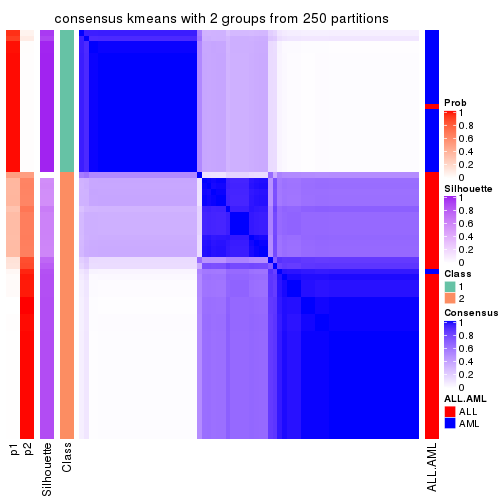
consensus_heatmap(res, k = 3)
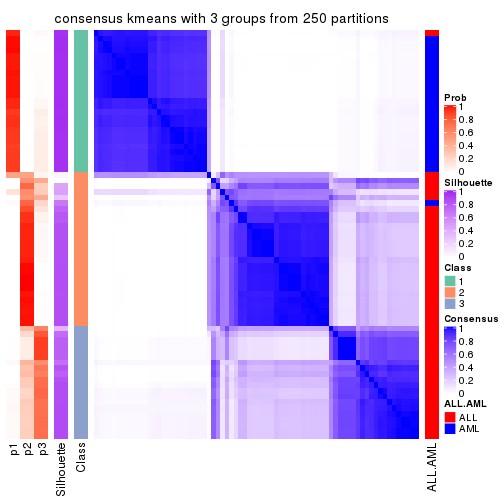
consensus_heatmap(res, k = 4)
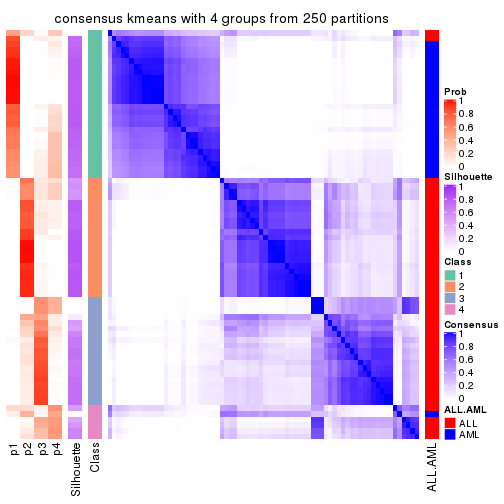
consensus_heatmap(res, k = 5)
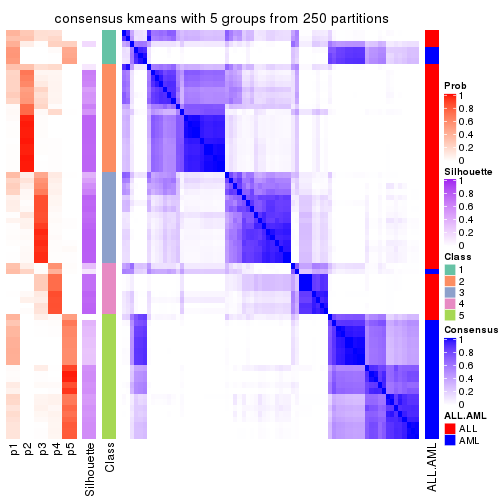
consensus_heatmap(res, k = 6)
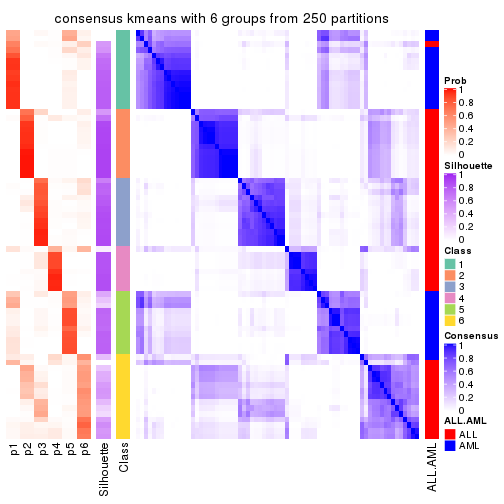
Heatmaps for the membership of samples in all partitions to see how consistent they are:
membership_heatmap(res, k = 2)
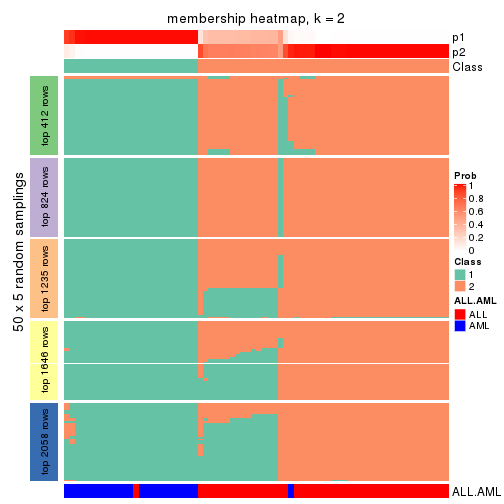
membership_heatmap(res, k = 3)
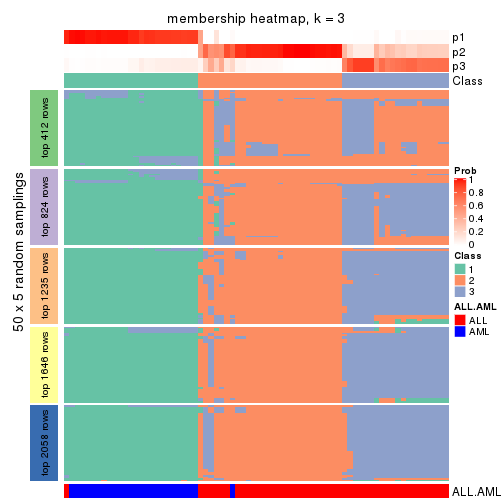
membership_heatmap(res, k = 4)
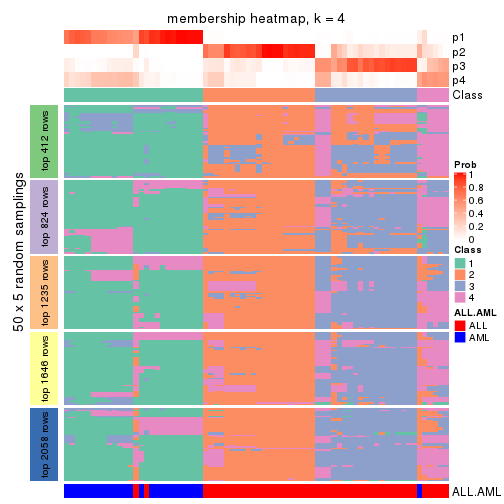
membership_heatmap(res, k = 5)
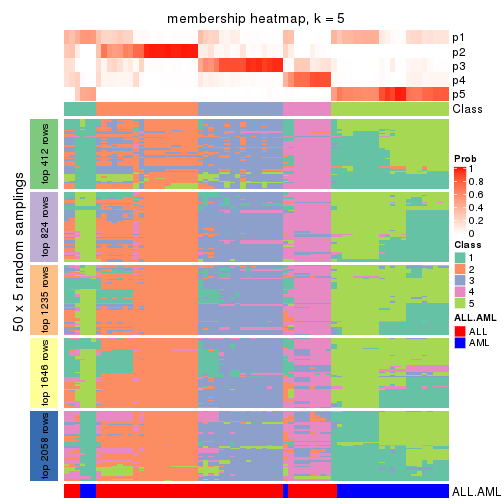
membership_heatmap(res, k = 6)
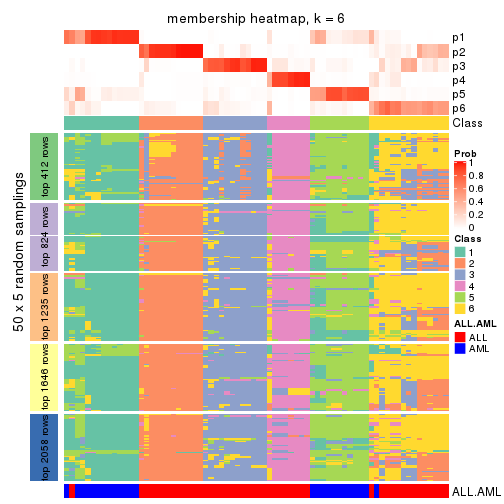
As soon as we have had the classes for columns, we can look for signatures which are significantly different between classes which can be candidate marks for certain classes. Following are the heatmaps for signatures.
Signature heatmaps where rows are scaled:
get_signatures(res, k = 2)
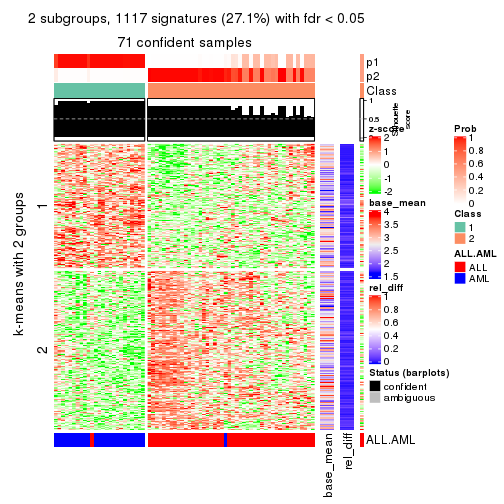
get_signatures(res, k = 3)
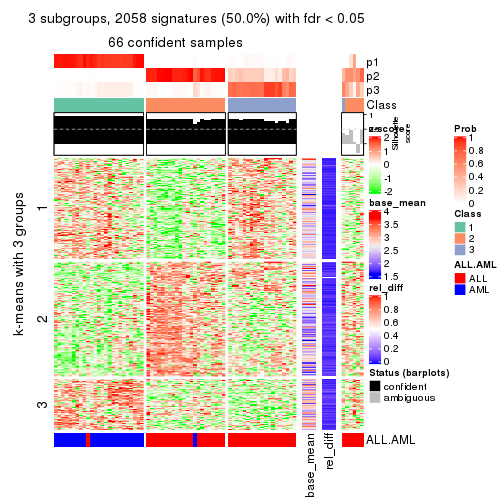
get_signatures(res, k = 4)
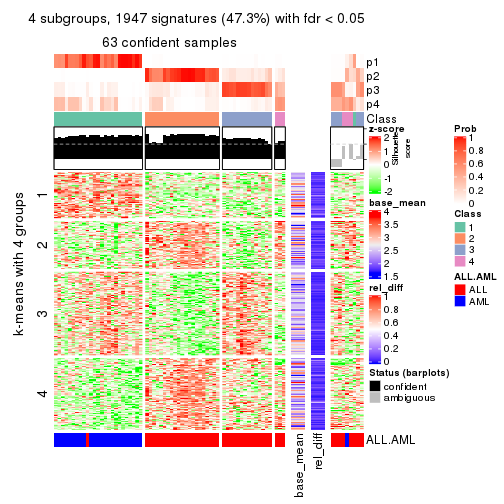
get_signatures(res, k = 5)
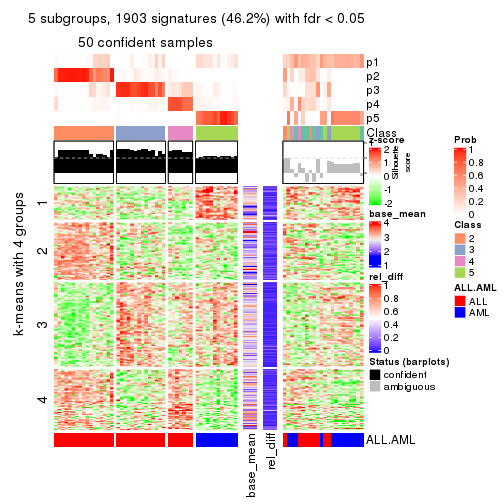
get_signatures(res, k = 6)
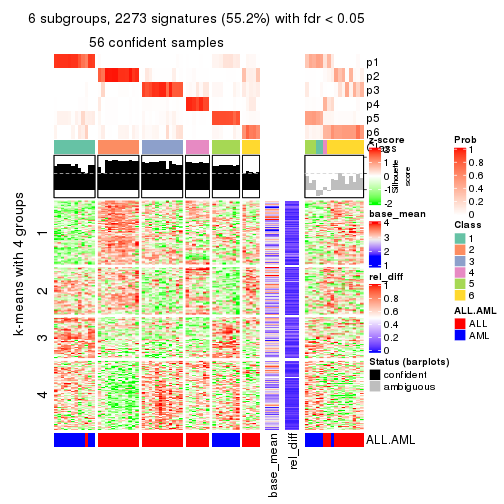
Signature heatmaps where rows are not scaled:
get_signatures(res, k = 2, scale_rows = FALSE)
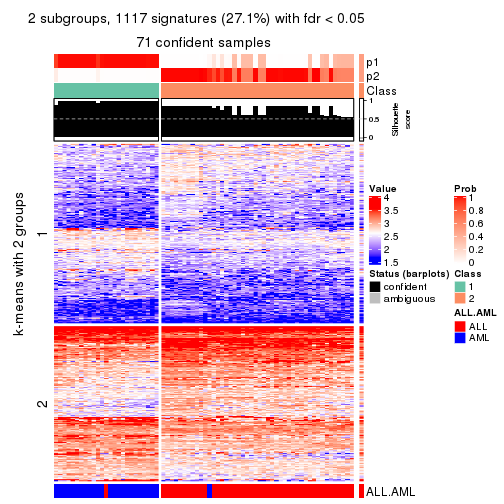
get_signatures(res, k = 3, scale_rows = FALSE)
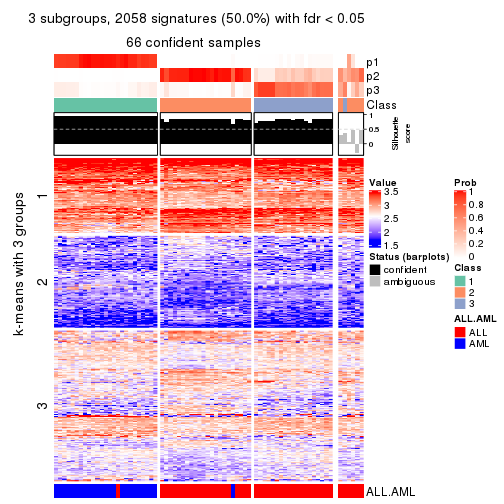
get_signatures(res, k = 4, scale_rows = FALSE)
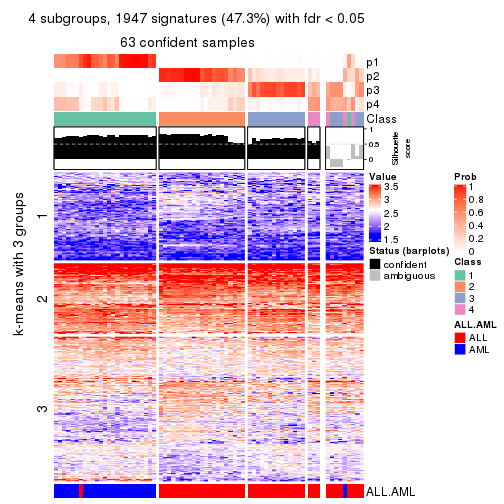
get_signatures(res, k = 5, scale_rows = FALSE)
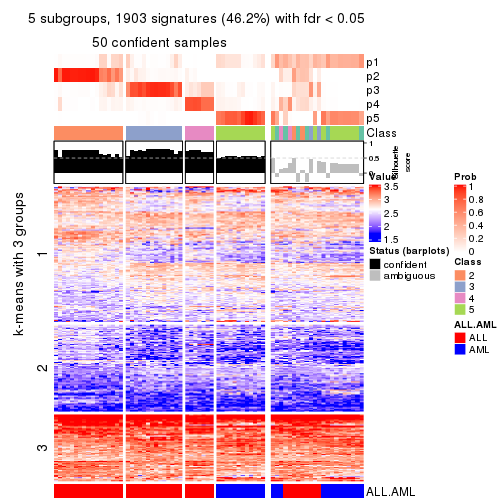
get_signatures(res, k = 6, scale_rows = FALSE)
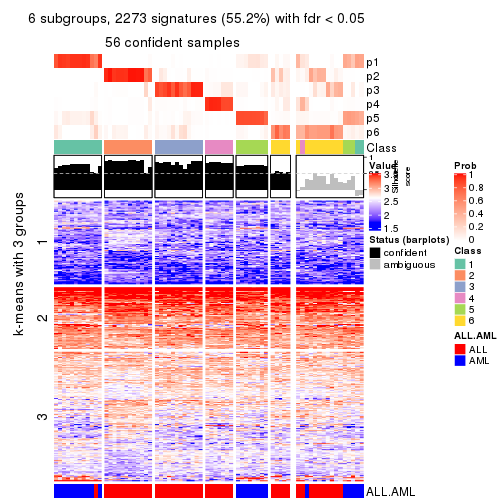
Compare the overlap of signatures from different k:
compare_signatures(res)
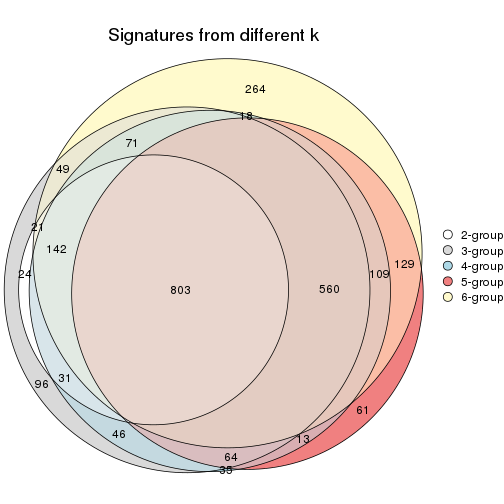
get_signature() returns a data frame invisibly. TO get the list of signatures, the function
call should be assigned to a variable explicitly. In following code, if plot argument is set
to FALSE, no heatmap is plotted while only the differential analysis is performed.
# code only for demonstration
tb = get_signature(res, k = ..., plot = FALSE)
An example of the output of tb is:
#> which_row fdr mean_1 mean_2 scaled_mean_1 scaled_mean_2 km
#> 1 38 0.042760348 8.373488 9.131774 -0.5533452 0.5164555 1
#> 2 40 0.018707592 7.106213 8.469186 -0.6173731 0.5762149 1
#> 3 55 0.019134737 10.221463 11.207825 -0.6159697 0.5749050 1
#> 4 59 0.006059896 5.921854 7.869574 -0.6899429 0.6439467 1
#> 5 60 0.018055526 8.928898 10.211722 -0.6204761 0.5791110 1
#> 6 98 0.009384629 15.714769 14.887706 0.6635654 -0.6193277 2
...
The columns in tb are:
which_row: row indices corresponding to the input matrix.fdr: FDR for the differential test. mean_x: The mean value in group x.scaled_mean_x: The mean value in group x after rows are scaled.km: Row groups if k-means clustering is applied to rows.UMAP plot which shows how samples are separated.
dimension_reduction(res, k = 2, method = "UMAP")
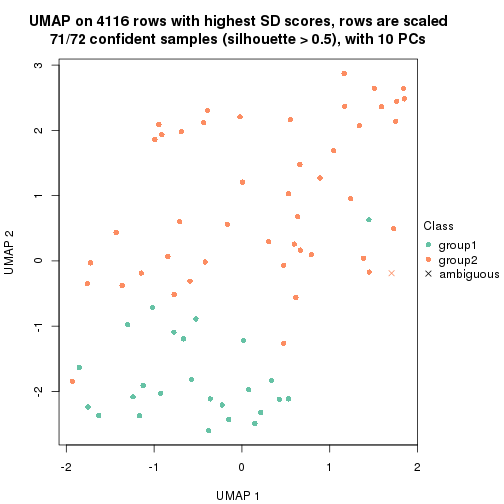
dimension_reduction(res, k = 3, method = "UMAP")
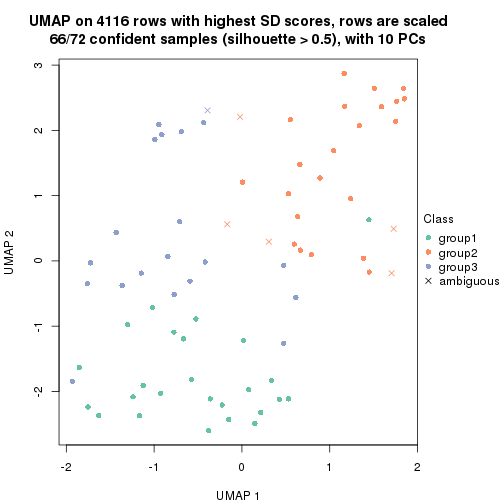
dimension_reduction(res, k = 4, method = "UMAP")
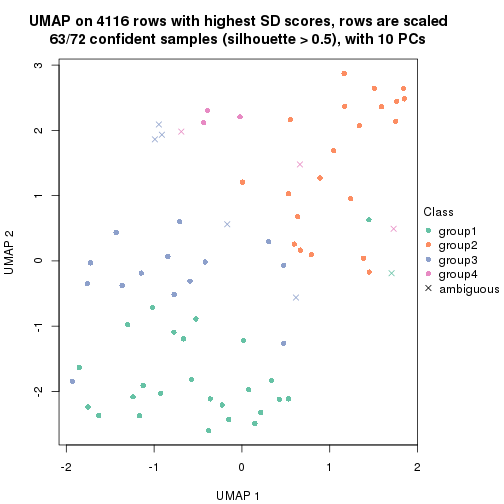
dimension_reduction(res, k = 5, method = "UMAP")
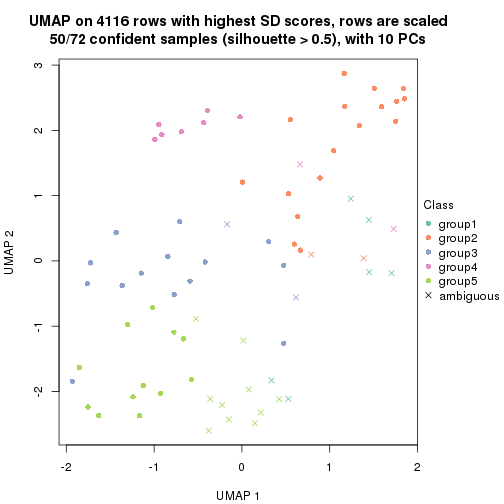
dimension_reduction(res, k = 6, method = "UMAP")
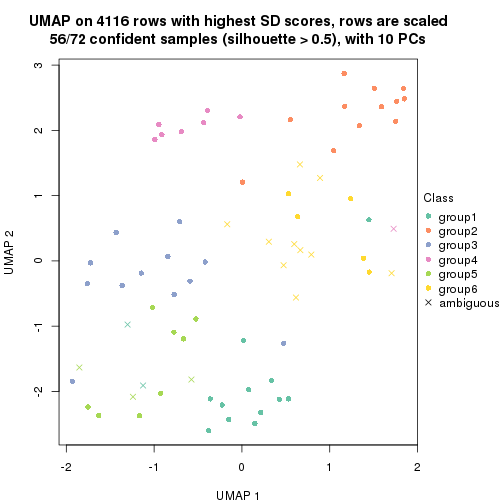
Following heatmap shows how subgroups are split when increasing k:
collect_classes(res)
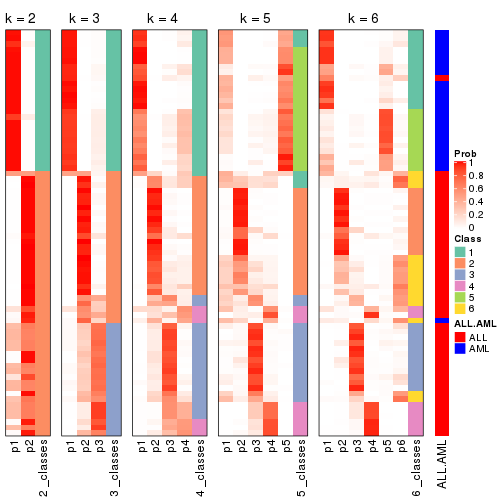
Test correlation between subgroups and known annotations. If the known annotation is numeric, one-way ANOVA test is applied, and if the known annotation is discrete, chi-squared contingency table test is applied.
test_to_known_factors(res)
#> n ALL.AML(p) k
#> SD:kmeans 71 2.08e-14 2
#> SD:kmeans 66 2.72e-13 3
#> SD:kmeans 63 9.95e-13 4
#> SD:kmeans 50 7.99e-11 5
#> SD:kmeans 56 5.63e-10 6
If matrix rows can be associated to genes, consider to use functional_enrichment(res,
...) to perform function enrichment for the signature genes. See this vignette for more detailed explanations.
The object with results only for a single top-value method and a single partition method can be extracted as:
res = res_list["SD", "skmeans"]
# you can also extract it by
# res = res_list["SD:skmeans"]
A summary of res and all the functions that can be applied to it:
res
#> A 'ConsensusPartition' object with k = 2, 3, 4, 5, 6.
#> On a matrix with 4116 rows and 72 columns.
#> Top rows (412, 824, 1235, 1646, 2058) are extracted by 'SD' method.
#> Subgroups are detected by 'skmeans' method.
#> Performed in total 1250 partitions by row resampling.
#> Best k for subgroups seems to be 3.
#>
#> Following methods can be applied to this 'ConsensusPartition' object:
#> [1] "cola_report" "collect_classes" "collect_plots"
#> [4] "collect_stats" "colnames" "compare_signatures"
#> [7] "consensus_heatmap" "dimension_reduction" "functional_enrichment"
#> [10] "get_anno_col" "get_anno" "get_classes"
#> [13] "get_consensus" "get_matrix" "get_membership"
#> [16] "get_param" "get_signatures" "get_stats"
#> [19] "is_best_k" "is_stable_k" "membership_heatmap"
#> [22] "ncol" "nrow" "plot_ecdf"
#> [25] "rownames" "select_partition_number" "show"
#> [28] "suggest_best_k" "test_to_known_factors"
collect_plots() function collects all the plots made from res for all k (number of partitions)
into one single page to provide an easy and fast comparison between different k.
collect_plots(res)
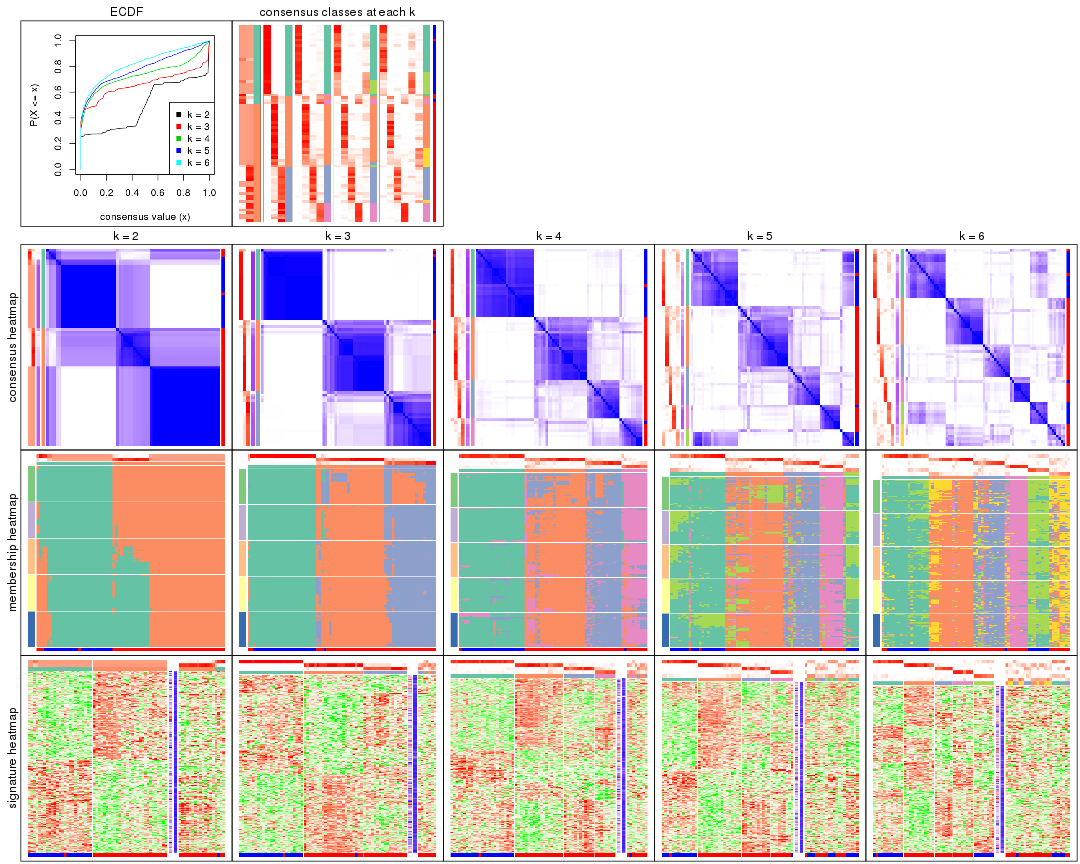
The plots are:
k and the heatmap of
predicted classes for each k.k.k.k.All the plots in panels can be made by individual functions and they are plotted later in this section.
select_partition_number() produces several plots showing different
statistics for choosing “optimized” k. There are following statistics:
k;k, the area increased is defined as \(A_k - A_{k-1}\).The detailed explanations of these statistics can be found in the cola vignette.
Generally speaking, lower PAC score, higher mean silhouette score or higher
concordance corresponds to better partition. Rand index and Jaccard index
measure how similar the current partition is compared to partition with k-1.
If they are too similar, we won't accept k is better than k-1.
select_partition_number(res)
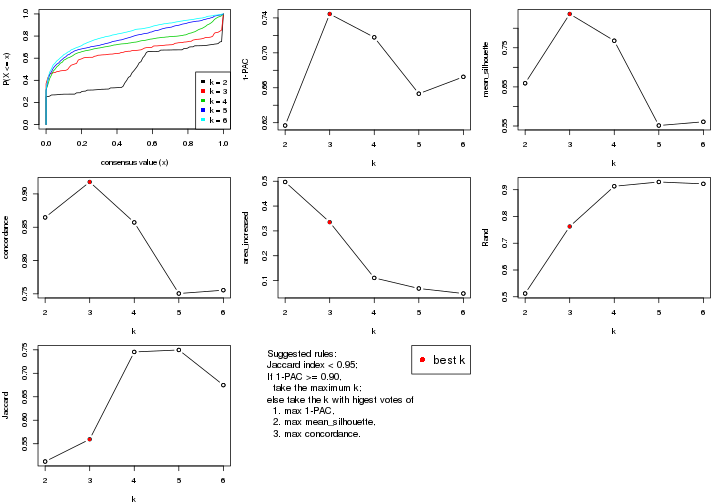
The numeric values for all these statistics can be obtained by get_stats().
get_stats(res)
#> k 1-PAC mean_silhouette concordance area_increased Rand Jaccard
#> 2 2 0.617 0.659 0.865 0.4970 0.512 0.512
#> 3 3 0.745 0.836 0.918 0.3352 0.763 0.560
#> 4 4 0.718 0.768 0.857 0.1107 0.913 0.745
#> 5 5 0.653 0.551 0.750 0.0682 0.929 0.750
#> 6 6 0.673 0.561 0.755 0.0479 0.922 0.675
suggest_best_k() suggests the best \(k\) based on these statistics. The rules are as follows:
suggest_best_k(res)
#> [1] 3
Following shows the table of the partitions (You need to click the show/hide
code output link to see it). The membership matrix (columns with name p*)
is inferred by
clue::cl_consensus()
function with the SE method. Basically the value in the membership matrix
represents the probability to belong to a certain group. The finall class
label for an item is determined with the group with highest probability it
belongs to.
In get_classes() function, the entropy is calculated from the membership
matrix and the silhouette score is calculated from the consensus matrix.
cbind(get_classes(res, k = 2), get_membership(res, k = 2))
#> class entropy silhouette p1 p2
#> sample_39 2 0.1184 0.28974 0.016 0.984
#> sample_40 2 0.2236 0.20871 0.036 0.964
#> sample_42 2 0.9996 0.79587 0.488 0.512
#> sample_47 2 0.9996 0.79587 0.488 0.512
#> sample_48 2 0.9996 0.79587 0.488 0.512
#> sample_49 2 0.3274 0.14651 0.060 0.940
#> sample_41 2 0.9996 0.79587 0.488 0.512
#> sample_43 2 0.9996 0.79587 0.488 0.512
#> sample_44 2 0.9996 0.79587 0.488 0.512
#> sample_45 2 0.9996 0.79587 0.488 0.512
#> sample_46 2 0.9996 0.79587 0.488 0.512
#> sample_70 2 0.9996 0.79587 0.488 0.512
#> sample_71 2 0.9996 0.79587 0.488 0.512
#> sample_72 2 0.9996 0.79587 0.488 0.512
#> sample_68 2 0.9996 0.79587 0.488 0.512
#> sample_69 2 0.9996 0.79587 0.488 0.512
#> sample_67 1 0.0376 0.11499 0.996 0.004
#> sample_55 2 0.1184 0.25566 0.016 0.984
#> sample_56 2 0.0000 0.28969 0.000 1.000
#> sample_59 2 0.9996 0.79587 0.488 0.512
#> sample_52 1 0.9996 0.87667 0.512 0.488
#> sample_53 1 0.9996 0.87667 0.512 0.488
#> sample_51 1 0.9996 0.87667 0.512 0.488
#> sample_50 1 0.9996 0.87667 0.512 0.488
#> sample_54 1 0.8713 0.65021 0.708 0.292
#> sample_57 1 0.9996 0.87667 0.512 0.488
#> sample_58 1 0.9996 0.87667 0.512 0.488
#> sample_60 1 0.9996 0.87667 0.512 0.488
#> sample_61 1 0.9996 0.87667 0.512 0.488
#> sample_65 1 0.9996 0.87667 0.512 0.488
#> sample_66 1 0.3733 -0.07760 0.928 0.072
#> sample_63 1 0.9996 0.87667 0.512 0.488
#> sample_64 1 0.9996 0.87667 0.512 0.488
#> sample_62 1 0.9996 0.87667 0.512 0.488
#> sample_1 2 0.9996 0.79587 0.488 0.512
#> sample_2 1 0.2603 -0.00294 0.956 0.044
#> sample_3 2 0.1633 0.33281 0.024 0.976
#> sample_4 2 0.9996 0.79587 0.488 0.512
#> sample_5 2 0.9996 0.79587 0.488 0.512
#> sample_6 2 0.1633 0.33281 0.024 0.976
#> sample_7 2 0.1414 0.31215 0.020 0.980
#> sample_8 2 0.3584 0.12279 0.068 0.932
#> sample_9 2 0.9996 0.79587 0.488 0.512
#> sample_10 2 0.5629 0.03736 0.132 0.868
#> sample_11 2 0.9996 0.79587 0.488 0.512
#> sample_12 1 0.9996 0.87667 0.512 0.488
#> sample_13 2 0.9996 0.79587 0.488 0.512
#> sample_14 2 0.9996 0.79587 0.488 0.512
#> sample_15 2 0.9996 0.79587 0.488 0.512
#> sample_16 2 0.9996 0.79587 0.488 0.512
#> sample_17 1 0.8555 -0.53149 0.720 0.280
#> sample_18 2 0.9963 0.78087 0.464 0.536
#> sample_19 2 0.9996 0.79587 0.488 0.512
#> sample_20 2 0.9996 0.79587 0.488 0.512
#> sample_21 2 0.9996 0.79587 0.488 0.512
#> sample_22 2 0.3733 0.10999 0.072 0.928
#> sample_23 2 0.1633 0.33281 0.024 0.976
#> sample_24 2 0.9996 0.79587 0.488 0.512
#> sample_25 2 0.7376 0.47066 0.208 0.792
#> sample_26 2 0.9996 0.79587 0.488 0.512
#> sample_27 2 0.3274 0.14651 0.060 0.940
#> sample_34 1 0.9996 0.87667 0.512 0.488
#> sample_35 1 0.9996 0.87667 0.512 0.488
#> sample_36 1 0.9996 0.87667 0.512 0.488
#> sample_37 1 0.9996 0.87667 0.512 0.488
#> sample_38 1 0.9996 0.87667 0.512 0.488
#> sample_28 1 0.9996 0.87667 0.512 0.488
#> sample_29 1 0.9087 0.69508 0.676 0.324
#> sample_30 1 0.9996 0.87667 0.512 0.488
#> sample_31 1 0.9996 0.87667 0.512 0.488
#> sample_32 1 0.9996 0.87667 0.512 0.488
#> sample_33 1 0.9996 0.87667 0.512 0.488
cbind(get_classes(res, k = 3), get_membership(res, k = 3))
#> class entropy silhouette p1 p2 p3
#> sample_39 3 0.4605 0.8219 0.000 0.204 0.796
#> sample_40 3 0.4235 0.8393 0.000 0.176 0.824
#> sample_42 2 0.0000 0.8952 0.000 1.000 0.000
#> sample_47 2 0.0000 0.8952 0.000 1.000 0.000
#> sample_48 2 0.0000 0.8952 0.000 1.000 0.000
#> sample_49 3 0.4178 0.8404 0.000 0.172 0.828
#> sample_41 2 0.1860 0.8779 0.000 0.948 0.052
#> sample_43 2 0.0000 0.8952 0.000 1.000 0.000
#> sample_44 2 0.0424 0.8915 0.000 0.992 0.008
#> sample_45 2 0.0000 0.8952 0.000 1.000 0.000
#> sample_46 2 0.0000 0.8952 0.000 1.000 0.000
#> sample_70 3 0.6244 0.4315 0.000 0.440 0.560
#> sample_71 2 0.1964 0.8626 0.000 0.944 0.056
#> sample_72 2 0.0000 0.8952 0.000 1.000 0.000
#> sample_68 2 0.1860 0.8779 0.000 0.948 0.052
#> sample_69 2 0.0000 0.8952 0.000 1.000 0.000
#> sample_67 1 0.7411 0.1689 0.548 0.416 0.036
#> sample_55 3 0.2448 0.8305 0.000 0.076 0.924
#> sample_56 3 0.4291 0.8376 0.000 0.180 0.820
#> sample_59 2 0.5397 0.4612 0.000 0.720 0.280
#> sample_52 1 0.0000 0.9777 1.000 0.000 0.000
#> sample_53 1 0.0000 0.9777 1.000 0.000 0.000
#> sample_51 1 0.0000 0.9777 1.000 0.000 0.000
#> sample_50 1 0.0000 0.9777 1.000 0.000 0.000
#> sample_54 1 0.1129 0.9580 0.976 0.020 0.004
#> sample_57 1 0.0237 0.9763 0.996 0.000 0.004
#> sample_58 1 0.0237 0.9763 0.996 0.000 0.004
#> sample_60 1 0.0237 0.9763 0.996 0.000 0.004
#> sample_61 1 0.0000 0.9777 1.000 0.000 0.000
#> sample_65 1 0.0000 0.9777 1.000 0.000 0.000
#> sample_66 2 0.7097 0.6524 0.128 0.724 0.148
#> sample_63 1 0.0237 0.9763 0.996 0.000 0.004
#> sample_64 1 0.0237 0.9763 0.996 0.000 0.004
#> sample_62 1 0.0237 0.9763 0.996 0.000 0.004
#> sample_1 3 0.4504 0.8290 0.000 0.196 0.804
#> sample_2 2 0.8489 0.4667 0.268 0.596 0.136
#> sample_3 3 0.0000 0.7996 0.000 0.000 1.000
#> sample_4 3 0.3551 0.8389 0.000 0.132 0.868
#> sample_5 2 0.1860 0.8779 0.000 0.948 0.052
#> sample_6 3 0.0000 0.7996 0.000 0.000 1.000
#> sample_7 3 0.3482 0.8390 0.000 0.128 0.872
#> sample_8 3 0.4291 0.8376 0.000 0.180 0.820
#> sample_9 3 0.4121 0.6843 0.000 0.168 0.832
#> sample_10 3 0.0000 0.7996 0.000 0.000 1.000
#> sample_11 3 0.5497 0.4843 0.000 0.292 0.708
#> sample_12 1 0.0424 0.9717 0.992 0.000 0.008
#> sample_13 2 0.0000 0.8952 0.000 1.000 0.000
#> sample_14 3 0.6305 -0.0993 0.000 0.484 0.516
#> sample_15 2 0.1860 0.8779 0.000 0.948 0.052
#> sample_16 2 0.0424 0.8926 0.000 0.992 0.008
#> sample_17 2 0.5268 0.7177 0.012 0.776 0.212
#> sample_18 3 0.3340 0.8243 0.000 0.120 0.880
#> sample_19 2 0.0000 0.8952 0.000 1.000 0.000
#> sample_20 2 0.0000 0.8952 0.000 1.000 0.000
#> sample_21 2 0.1643 0.8814 0.000 0.956 0.044
#> sample_22 3 0.5008 0.8340 0.016 0.180 0.804
#> sample_23 3 0.0000 0.7996 0.000 0.000 1.000
#> sample_24 2 0.2165 0.8710 0.000 0.936 0.064
#> sample_25 2 0.6969 0.0968 0.024 0.596 0.380
#> sample_26 2 0.3116 0.7843 0.000 0.892 0.108
#> sample_27 3 0.4178 0.8404 0.000 0.172 0.828
#> sample_34 1 0.0000 0.9777 1.000 0.000 0.000
#> sample_35 1 0.0237 0.9763 0.996 0.000 0.004
#> sample_36 1 0.0000 0.9777 1.000 0.000 0.000
#> sample_37 1 0.0000 0.9777 1.000 0.000 0.000
#> sample_38 1 0.0000 0.9777 1.000 0.000 0.000
#> sample_28 1 0.0000 0.9777 1.000 0.000 0.000
#> sample_29 1 0.0000 0.9777 1.000 0.000 0.000
#> sample_30 1 0.0000 0.9777 1.000 0.000 0.000
#> sample_31 1 0.0000 0.9777 1.000 0.000 0.000
#> sample_32 1 0.0000 0.9777 1.000 0.000 0.000
#> sample_33 1 0.0000 0.9777 1.000 0.000 0.000
cbind(get_classes(res, k = 4), get_membership(res, k = 4))
#> class entropy silhouette p1 p2 p3 p4
#> sample_39 3 0.3081 0.780 0.000 0.064 0.888 0.048
#> sample_40 3 0.2039 0.800 0.016 0.036 0.940 0.008
#> sample_42 2 0.6261 0.659 0.008 0.680 0.112 0.200
#> sample_47 2 0.0895 0.823 0.000 0.976 0.004 0.020
#> sample_48 2 0.0000 0.823 0.000 1.000 0.000 0.000
#> sample_49 3 0.0657 0.799 0.000 0.012 0.984 0.004
#> sample_41 2 0.1854 0.811 0.000 0.940 0.048 0.012
#> sample_43 2 0.3398 0.793 0.000 0.872 0.060 0.068
#> sample_44 2 0.4428 0.756 0.000 0.808 0.124 0.068
#> sample_45 2 0.2623 0.805 0.000 0.908 0.028 0.064
#> sample_46 2 0.3471 0.792 0.000 0.868 0.060 0.072
#> sample_70 3 0.6403 0.558 0.000 0.232 0.640 0.128
#> sample_71 2 0.7507 0.385 0.012 0.504 0.140 0.344
#> sample_72 2 0.6777 0.568 0.004 0.624 0.164 0.208
#> sample_68 2 0.1356 0.813 0.000 0.960 0.032 0.008
#> sample_69 2 0.0336 0.824 0.000 0.992 0.008 0.000
#> sample_67 4 0.6976 0.331 0.344 0.112 0.004 0.540
#> sample_55 3 0.4318 0.719 0.000 0.116 0.816 0.068
#> sample_56 3 0.1398 0.801 0.000 0.040 0.956 0.004
#> sample_59 2 0.6326 0.269 0.000 0.556 0.376 0.068
#> sample_52 1 0.1059 0.941 0.972 0.000 0.012 0.016
#> sample_53 1 0.1211 0.942 0.960 0.000 0.000 0.040
#> sample_51 1 0.1118 0.943 0.964 0.000 0.000 0.036
#> sample_50 1 0.1118 0.943 0.964 0.000 0.000 0.036
#> sample_54 1 0.4565 0.831 0.828 0.092 0.044 0.036
#> sample_57 1 0.1975 0.929 0.936 0.000 0.048 0.016
#> sample_58 1 0.2142 0.926 0.928 0.000 0.056 0.016
#> sample_60 1 0.2465 0.925 0.924 0.012 0.044 0.020
#> sample_61 1 0.2256 0.932 0.924 0.000 0.056 0.020
#> sample_65 1 0.0657 0.944 0.984 0.000 0.012 0.004
#> sample_66 4 0.5395 0.378 0.016 0.352 0.004 0.628
#> sample_63 1 0.1182 0.941 0.968 0.000 0.016 0.016
#> sample_64 1 0.2909 0.899 0.888 0.000 0.092 0.020
#> sample_62 1 0.1182 0.941 0.968 0.000 0.016 0.016
#> sample_1 3 0.2282 0.800 0.000 0.052 0.924 0.024
#> sample_2 4 0.3670 0.696 0.044 0.092 0.004 0.860
#> sample_3 4 0.4072 0.687 0.000 0.000 0.252 0.748
#> sample_4 3 0.4989 0.675 0.000 0.164 0.764 0.072
#> sample_5 2 0.1356 0.813 0.000 0.960 0.032 0.008
#> sample_6 4 0.4103 0.684 0.000 0.000 0.256 0.744
#> sample_7 3 0.3991 0.726 0.000 0.120 0.832 0.048
#> sample_8 3 0.1398 0.801 0.000 0.040 0.956 0.004
#> sample_9 4 0.4387 0.743 0.000 0.052 0.144 0.804
#> sample_10 4 0.3219 0.729 0.000 0.000 0.164 0.836
#> sample_11 4 0.3301 0.739 0.000 0.076 0.048 0.876
#> sample_12 1 0.3198 0.894 0.880 0.000 0.040 0.080
#> sample_13 2 0.0188 0.823 0.000 0.996 0.004 0.000
#> sample_14 4 0.4088 0.723 0.000 0.140 0.040 0.820
#> sample_15 2 0.1356 0.813 0.000 0.960 0.032 0.008
#> sample_16 2 0.3402 0.769 0.000 0.832 0.164 0.004
#> sample_17 2 0.5392 0.133 0.004 0.564 0.008 0.424
#> sample_18 3 0.6781 0.438 0.000 0.148 0.596 0.256
#> sample_19 2 0.3674 0.778 0.000 0.848 0.116 0.036
#> sample_20 2 0.0336 0.824 0.000 0.992 0.008 0.000
#> sample_21 2 0.2124 0.812 0.000 0.932 0.040 0.028
#> sample_22 3 0.4649 0.735 0.048 0.036 0.824 0.092
#> sample_23 4 0.4103 0.684 0.000 0.000 0.256 0.744
#> sample_24 2 0.2048 0.804 0.000 0.928 0.064 0.008
#> sample_25 3 0.8385 0.356 0.040 0.252 0.484 0.224
#> sample_26 2 0.6292 0.232 0.000 0.524 0.416 0.060
#> sample_27 3 0.0804 0.796 0.000 0.012 0.980 0.008
#> sample_34 1 0.0927 0.943 0.976 0.000 0.016 0.008
#> sample_35 1 0.2654 0.892 0.888 0.000 0.108 0.004
#> sample_36 1 0.1118 0.943 0.964 0.000 0.000 0.036
#> sample_37 1 0.1211 0.942 0.960 0.000 0.000 0.040
#> sample_38 1 0.2334 0.916 0.908 0.000 0.004 0.088
#> sample_28 1 0.1824 0.933 0.936 0.000 0.004 0.060
#> sample_29 1 0.2011 0.924 0.920 0.000 0.000 0.080
#> sample_30 1 0.1118 0.943 0.964 0.000 0.000 0.036
#> sample_31 1 0.0937 0.944 0.976 0.000 0.012 0.012
#> sample_32 1 0.0921 0.944 0.972 0.000 0.000 0.028
#> sample_33 1 0.1118 0.943 0.964 0.000 0.000 0.036
cbind(get_classes(res, k = 5), get_membership(res, k = 5))
#> class entropy silhouette p1 p2 p3 p4 p5
#> sample_39 3 0.3694 0.70732 0.000 0.020 0.824 0.024 0.132
#> sample_40 3 0.2956 0.73851 0.000 0.012 0.872 0.020 0.096
#> sample_42 2 0.8307 0.42771 0.056 0.428 0.112 0.080 0.324
#> sample_47 2 0.2520 0.75564 0.000 0.888 0.012 0.004 0.096
#> sample_48 2 0.1041 0.75974 0.000 0.964 0.004 0.000 0.032
#> sample_49 3 0.1117 0.74882 0.000 0.000 0.964 0.016 0.020
#> sample_41 2 0.0867 0.74987 0.000 0.976 0.008 0.008 0.008
#> sample_43 2 0.5988 0.62679 0.000 0.604 0.056 0.044 0.296
#> sample_44 2 0.6521 0.58585 0.000 0.592 0.152 0.036 0.220
#> sample_45 2 0.5275 0.67368 0.000 0.692 0.044 0.036 0.228
#> sample_46 2 0.5531 0.66588 0.000 0.676 0.060 0.036 0.228
#> sample_70 3 0.7340 0.32888 0.000 0.184 0.500 0.064 0.252
#> sample_71 2 0.9013 0.22659 0.040 0.328 0.144 0.192 0.296
#> sample_72 2 0.7869 0.40268 0.008 0.468 0.172 0.092 0.260
#> sample_68 2 0.0613 0.75278 0.000 0.984 0.004 0.004 0.008
#> sample_69 2 0.2017 0.75697 0.000 0.912 0.008 0.000 0.080
#> sample_67 1 0.7601 0.08544 0.480 0.084 0.008 0.300 0.128
#> sample_55 3 0.6579 0.59284 0.000 0.120 0.604 0.060 0.216
#> sample_56 3 0.1357 0.75154 0.000 0.000 0.948 0.004 0.048
#> sample_59 2 0.7500 0.10424 0.000 0.376 0.300 0.036 0.288
#> sample_52 1 0.4262 -0.23744 0.560 0.000 0.000 0.000 0.440
#> sample_53 1 0.0290 0.67741 0.992 0.000 0.000 0.000 0.008
#> sample_51 1 0.0000 0.67773 1.000 0.000 0.000 0.000 0.000
#> sample_50 1 0.0404 0.67711 0.988 0.000 0.000 0.000 0.012
#> sample_54 5 0.5517 0.45528 0.340 0.044 0.008 0.008 0.600
#> sample_57 5 0.4517 0.42866 0.436 0.000 0.008 0.000 0.556
#> sample_58 1 0.4826 -0.39762 0.508 0.000 0.020 0.000 0.472
#> sample_60 5 0.5087 0.47023 0.364 0.004 0.028 0.004 0.600
#> sample_61 1 0.4215 0.51921 0.772 0.000 0.052 0.004 0.172
#> sample_65 1 0.3424 0.44690 0.760 0.000 0.000 0.000 0.240
#> sample_66 4 0.6291 0.53611 0.040 0.248 0.000 0.608 0.104
#> sample_63 1 0.4302 -0.36846 0.520 0.000 0.000 0.000 0.480
#> sample_64 5 0.5238 0.34231 0.472 0.000 0.044 0.000 0.484
#> sample_62 5 0.4306 0.30870 0.492 0.000 0.000 0.000 0.508
#> sample_1 3 0.2591 0.74533 0.000 0.020 0.904 0.032 0.044
#> sample_2 4 0.4873 0.75255 0.072 0.072 0.004 0.780 0.072
#> sample_3 4 0.1965 0.85710 0.000 0.000 0.096 0.904 0.000
#> sample_4 3 0.5617 0.59401 0.000 0.256 0.648 0.076 0.020
#> sample_5 2 0.0613 0.75278 0.000 0.984 0.004 0.004 0.008
#> sample_6 4 0.1965 0.85710 0.000 0.000 0.096 0.904 0.000
#> sample_7 3 0.4861 0.67738 0.000 0.136 0.760 0.068 0.036
#> sample_8 3 0.1471 0.74777 0.000 0.004 0.952 0.020 0.024
#> sample_9 4 0.1997 0.87140 0.000 0.036 0.040 0.924 0.000
#> sample_10 4 0.1331 0.86612 0.000 0.000 0.040 0.952 0.008
#> sample_11 4 0.1526 0.86397 0.004 0.040 0.004 0.948 0.004
#> sample_12 1 0.3451 0.53756 0.836 0.000 0.024 0.012 0.128
#> sample_13 2 0.1041 0.75974 0.000 0.964 0.004 0.000 0.032
#> sample_14 4 0.2011 0.84737 0.000 0.088 0.004 0.908 0.000
#> sample_15 2 0.0613 0.75278 0.000 0.984 0.004 0.004 0.008
#> sample_16 2 0.3399 0.68184 0.000 0.812 0.168 0.000 0.020
#> sample_17 2 0.4857 0.31977 0.000 0.636 0.000 0.324 0.040
#> sample_18 3 0.7937 0.41267 0.004 0.136 0.476 0.216 0.168
#> sample_19 2 0.6138 0.61758 0.000 0.624 0.140 0.024 0.212
#> sample_20 2 0.1205 0.75984 0.000 0.956 0.004 0.000 0.040
#> sample_21 2 0.1393 0.75018 0.000 0.956 0.008 0.024 0.012
#> sample_22 3 0.5354 0.65019 0.104 0.004 0.736 0.040 0.116
#> sample_23 4 0.2020 0.85388 0.000 0.000 0.100 0.900 0.000
#> sample_24 2 0.0981 0.74844 0.000 0.972 0.012 0.008 0.008
#> sample_25 5 0.8884 -0.45187 0.112 0.120 0.344 0.076 0.348
#> sample_26 3 0.7305 -0.00955 0.000 0.340 0.428 0.040 0.192
#> sample_27 3 0.1310 0.74802 0.000 0.000 0.956 0.020 0.024
#> sample_34 1 0.3661 0.36231 0.724 0.000 0.000 0.000 0.276
#> sample_35 1 0.5714 0.00867 0.580 0.000 0.108 0.000 0.312
#> sample_36 1 0.2074 0.63156 0.896 0.000 0.000 0.000 0.104
#> sample_37 1 0.0290 0.67757 0.992 0.000 0.000 0.000 0.008
#> sample_38 1 0.2196 0.63240 0.916 0.000 0.004 0.024 0.056
#> sample_28 1 0.1285 0.66203 0.956 0.000 0.004 0.004 0.036
#> sample_29 1 0.2104 0.63695 0.916 0.000 0.000 0.024 0.060
#> sample_30 1 0.1270 0.66368 0.948 0.000 0.000 0.000 0.052
#> sample_31 1 0.3074 0.51634 0.804 0.000 0.000 0.000 0.196
#> sample_32 1 0.0703 0.67821 0.976 0.000 0.000 0.000 0.024
#> sample_33 1 0.0510 0.67523 0.984 0.000 0.000 0.000 0.016
cbind(get_classes(res, k = 6), get_membership(res, k = 6))
#> class entropy silhouette p1 p2 p3 p4 p5 p6
#> sample_39 3 0.4342 0.38794 0.000 0.000 0.656 0.008 0.028 0.308
#> sample_40 3 0.3294 0.66940 0.000 0.012 0.856 0.024 0.060 0.048
#> sample_42 6 0.5062 0.50041 0.028 0.168 0.020 0.020 0.036 0.728
#> sample_47 2 0.3893 0.61847 0.000 0.744 0.020 0.000 0.016 0.220
#> sample_48 2 0.1753 0.72226 0.000 0.912 0.004 0.000 0.000 0.084
#> sample_49 3 0.1465 0.68104 0.000 0.004 0.948 0.004 0.024 0.020
#> sample_41 2 0.0603 0.72083 0.000 0.980 0.000 0.000 0.004 0.016
#> sample_43 6 0.6116 -0.00340 0.000 0.368 0.044 0.004 0.092 0.492
#> sample_44 2 0.6260 0.01203 0.000 0.444 0.092 0.004 0.052 0.408
#> sample_45 2 0.5137 0.18237 0.000 0.500 0.012 0.004 0.044 0.440
#> sample_46 2 0.5648 0.11268 0.000 0.468 0.036 0.004 0.052 0.440
#> sample_70 6 0.6591 0.23820 0.004 0.088 0.348 0.016 0.056 0.488
#> sample_71 6 0.6418 0.45585 0.024 0.096 0.072 0.116 0.036 0.656
#> sample_72 6 0.6135 0.48939 0.004 0.196 0.088 0.052 0.028 0.632
#> sample_68 2 0.0146 0.72321 0.000 0.996 0.000 0.000 0.004 0.000
#> sample_69 2 0.2278 0.70603 0.000 0.868 0.004 0.000 0.000 0.128
#> sample_67 1 0.7557 0.03354 0.388 0.044 0.004 0.232 0.040 0.292
#> sample_55 3 0.7631 0.35704 0.000 0.112 0.440 0.092 0.288 0.068
#> sample_56 3 0.2328 0.66879 0.000 0.000 0.892 0.000 0.056 0.052
#> sample_59 6 0.7716 0.29370 0.000 0.224 0.224 0.008 0.176 0.368
#> sample_52 5 0.3756 0.65369 0.352 0.000 0.000 0.000 0.644 0.004
#> sample_53 1 0.0767 0.72153 0.976 0.000 0.000 0.004 0.012 0.008
#> sample_51 1 0.0937 0.72005 0.960 0.000 0.000 0.000 0.040 0.000
#> sample_50 1 0.1204 0.71543 0.944 0.000 0.000 0.000 0.056 0.000
#> sample_54 5 0.3723 0.71447 0.072 0.032 0.008 0.004 0.832 0.052
#> sample_57 5 0.2520 0.78647 0.152 0.000 0.000 0.000 0.844 0.004
#> sample_58 5 0.4117 0.73061 0.296 0.000 0.032 0.000 0.672 0.000
#> sample_60 5 0.2963 0.74226 0.096 0.000 0.012 0.000 0.856 0.036
#> sample_61 1 0.5556 0.42177 0.620 0.000 0.064 0.000 0.252 0.064
#> sample_65 1 0.3864 0.34669 0.648 0.000 0.004 0.000 0.344 0.004
#> sample_66 4 0.7950 0.15287 0.088 0.208 0.000 0.424 0.076 0.204
#> sample_63 5 0.3534 0.76650 0.276 0.000 0.000 0.000 0.716 0.008
#> sample_64 5 0.5277 0.68237 0.224 0.000 0.132 0.000 0.632 0.012
#> sample_62 5 0.3240 0.78746 0.244 0.000 0.004 0.000 0.752 0.000
#> sample_1 3 0.3764 0.63329 0.000 0.028 0.816 0.032 0.012 0.112
#> sample_2 4 0.6093 0.50359 0.108 0.024 0.004 0.608 0.028 0.228
#> sample_3 4 0.1387 0.83140 0.000 0.000 0.068 0.932 0.000 0.000
#> sample_4 3 0.6258 0.35417 0.000 0.316 0.536 0.088 0.024 0.036
#> sample_5 2 0.0291 0.72278 0.000 0.992 0.000 0.000 0.004 0.004
#> sample_6 4 0.1411 0.83495 0.000 0.000 0.060 0.936 0.000 0.004
#> sample_7 3 0.4628 0.61234 0.000 0.132 0.760 0.052 0.024 0.032
#> sample_8 3 0.2025 0.67428 0.004 0.004 0.924 0.008 0.020 0.040
#> sample_9 4 0.0909 0.84187 0.000 0.020 0.012 0.968 0.000 0.000
#> sample_10 4 0.0725 0.84025 0.000 0.000 0.012 0.976 0.000 0.012
#> sample_11 4 0.0951 0.83695 0.000 0.008 0.004 0.968 0.000 0.020
#> sample_12 1 0.4249 0.64151 0.784 0.000 0.040 0.004 0.072 0.100
#> sample_13 2 0.1806 0.72210 0.000 0.908 0.004 0.000 0.000 0.088
#> sample_14 4 0.1371 0.83164 0.000 0.040 0.004 0.948 0.004 0.004
#> sample_15 2 0.0291 0.72278 0.000 0.992 0.000 0.000 0.004 0.004
#> sample_16 2 0.4452 0.53251 0.000 0.724 0.176 0.000 0.008 0.092
#> sample_17 2 0.5312 0.37164 0.004 0.660 0.008 0.236 0.064 0.028
#> sample_18 3 0.8719 0.08289 0.004 0.140 0.332 0.236 0.148 0.140
#> sample_19 2 0.5533 0.19782 0.000 0.508 0.080 0.000 0.020 0.392
#> sample_20 2 0.1970 0.71926 0.000 0.900 0.008 0.000 0.000 0.092
#> sample_21 2 0.2085 0.71840 0.000 0.912 0.008 0.024 0.000 0.056
#> sample_22 3 0.5992 0.39506 0.128 0.004 0.620 0.024 0.020 0.204
#> sample_23 4 0.1327 0.83311 0.000 0.000 0.064 0.936 0.000 0.000
#> sample_24 2 0.0551 0.72051 0.000 0.984 0.004 0.000 0.004 0.008
#> sample_25 6 0.5811 0.39411 0.088 0.012 0.188 0.016 0.036 0.660
#> sample_26 6 0.6573 0.38624 0.000 0.256 0.296 0.008 0.016 0.424
#> sample_27 3 0.1768 0.68299 0.000 0.008 0.936 0.012 0.032 0.012
#> sample_34 1 0.3887 0.32911 0.632 0.000 0.008 0.000 0.360 0.000
#> sample_35 1 0.6136 -0.00568 0.476 0.000 0.200 0.004 0.312 0.008
#> sample_36 1 0.2941 0.60536 0.780 0.000 0.000 0.000 0.220 0.000
#> sample_37 1 0.0603 0.72158 0.980 0.000 0.000 0.004 0.016 0.000
#> sample_38 1 0.2313 0.68499 0.904 0.000 0.004 0.016 0.016 0.060
#> sample_28 1 0.1514 0.70564 0.944 0.000 0.004 0.004 0.012 0.036
#> sample_29 1 0.3558 0.65145 0.812 0.000 0.000 0.008 0.108 0.072
#> sample_30 1 0.2520 0.67033 0.844 0.000 0.000 0.000 0.152 0.004
#> sample_31 1 0.3809 0.45167 0.684 0.000 0.004 0.000 0.304 0.008
#> sample_32 1 0.3141 0.68835 0.832 0.000 0.004 0.000 0.124 0.040
#> sample_33 1 0.0405 0.72157 0.988 0.000 0.000 0.004 0.008 0.000
Heatmaps for the consensus matrix. It visualizes the probability of two samples to be in a same group.
consensus_heatmap(res, k = 2)
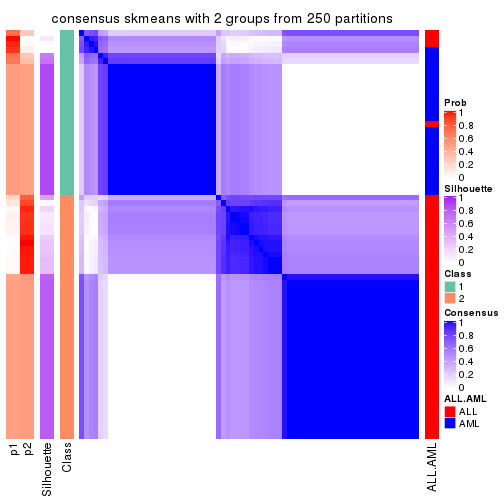
consensus_heatmap(res, k = 3)
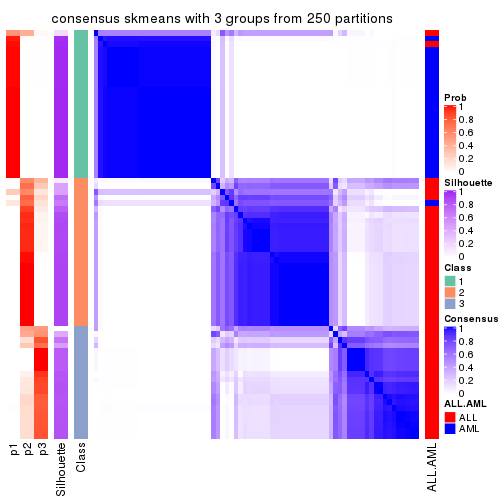
consensus_heatmap(res, k = 4)
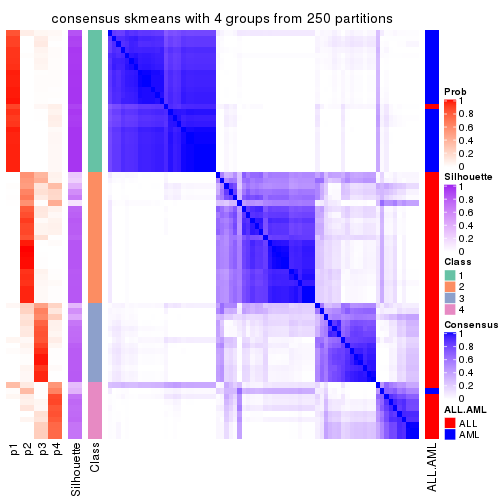
consensus_heatmap(res, k = 5)
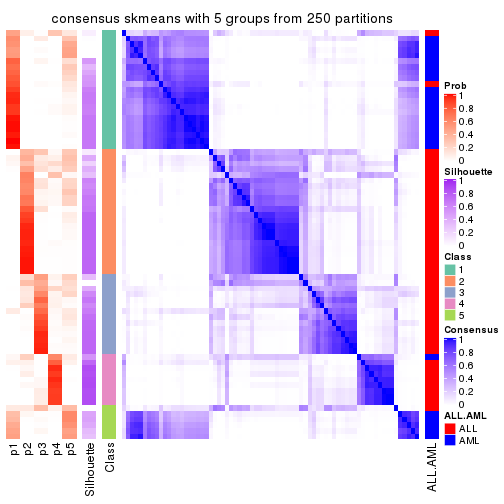
consensus_heatmap(res, k = 6)
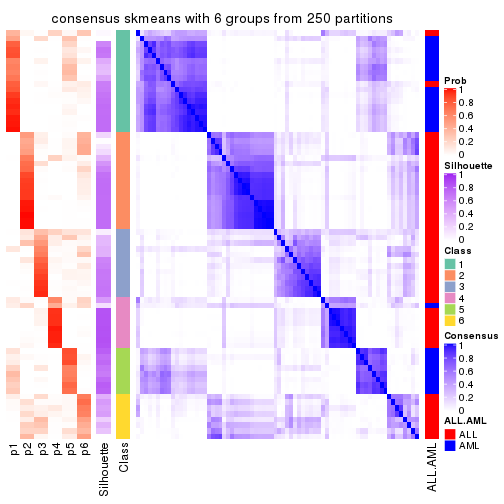
Heatmaps for the membership of samples in all partitions to see how consistent they are:
membership_heatmap(res, k = 2)
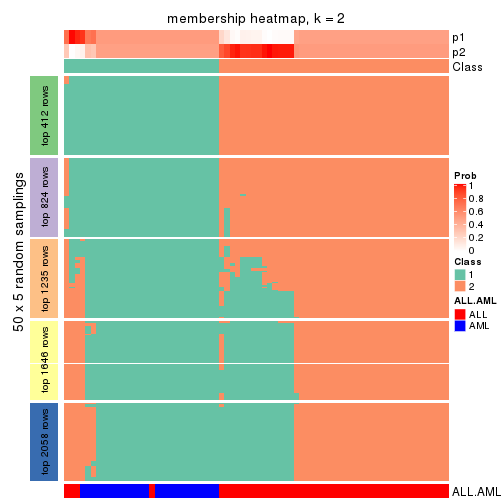
membership_heatmap(res, k = 3)
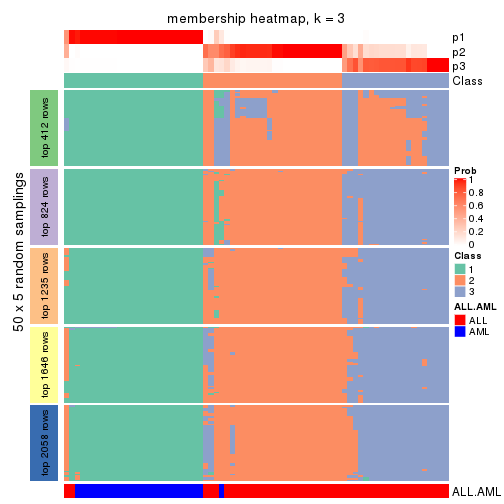
membership_heatmap(res, k = 4)
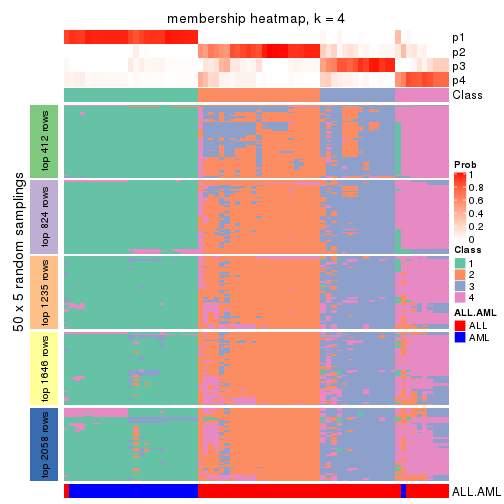
membership_heatmap(res, k = 5)
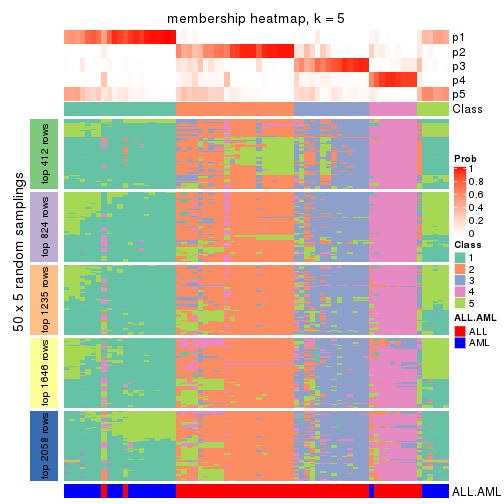
membership_heatmap(res, k = 6)
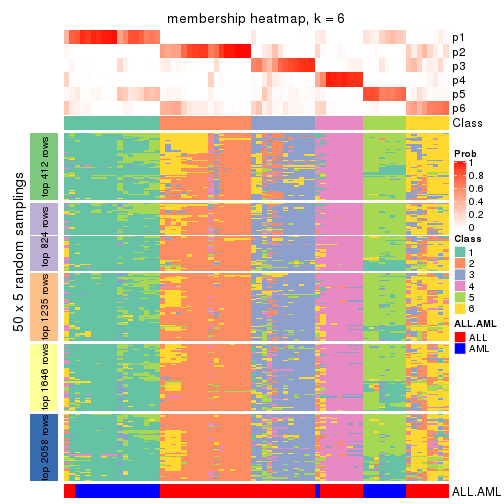
As soon as we have had the classes for columns, we can look for signatures which are significantly different between classes which can be candidate marks for certain classes. Following are the heatmaps for signatures.
Signature heatmaps where rows are scaled:
get_signatures(res, k = 2)
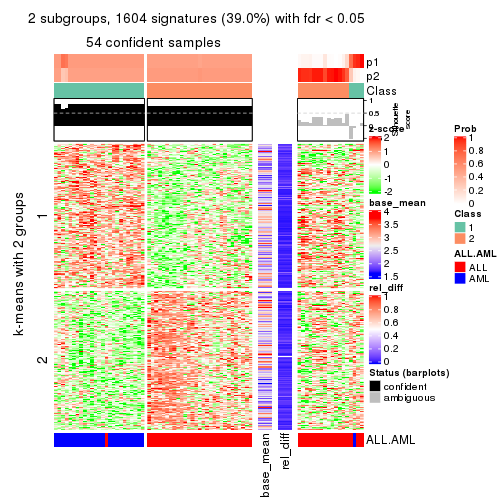
get_signatures(res, k = 3)
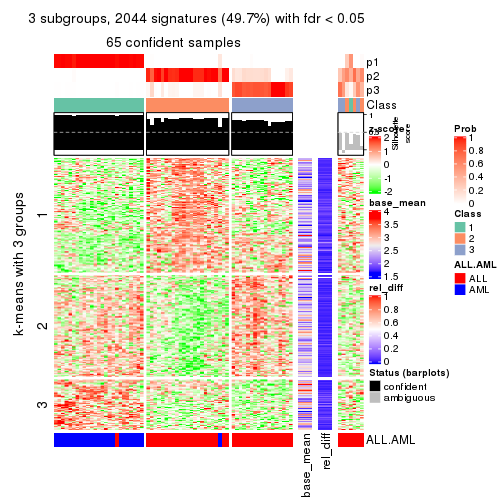
get_signatures(res, k = 4)
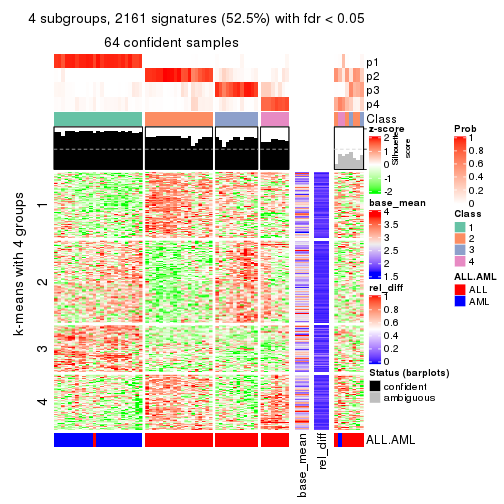
get_signatures(res, k = 5)
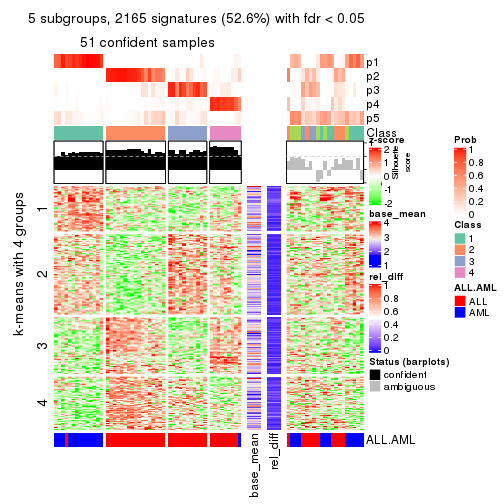
get_signatures(res, k = 6)
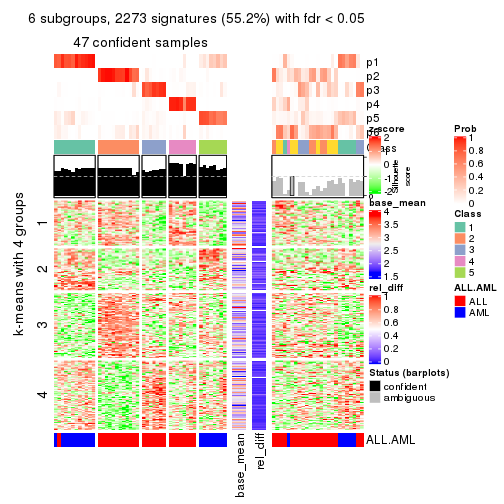
Signature heatmaps where rows are not scaled:
get_signatures(res, k = 2, scale_rows = FALSE)
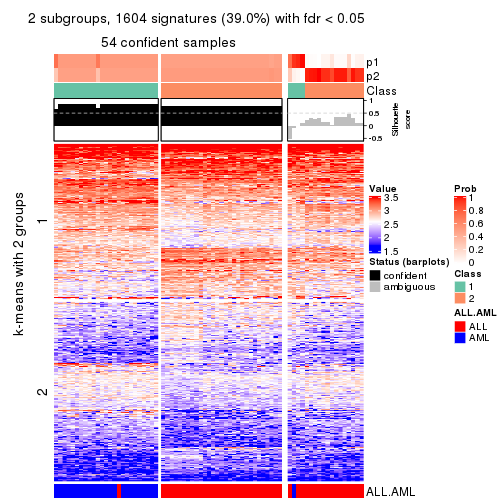
get_signatures(res, k = 3, scale_rows = FALSE)
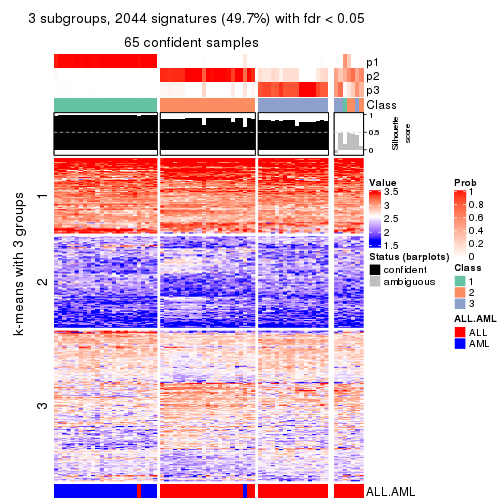
get_signatures(res, k = 4, scale_rows = FALSE)
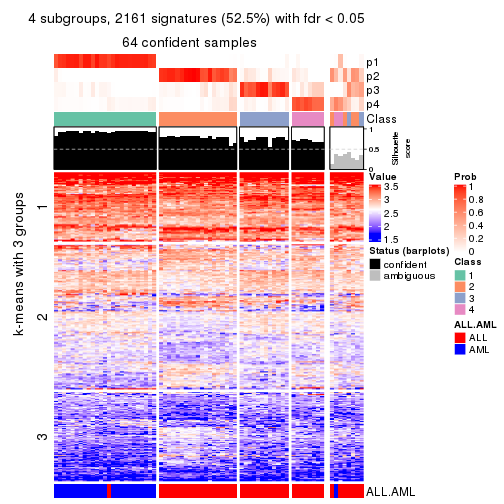
get_signatures(res, k = 5, scale_rows = FALSE)
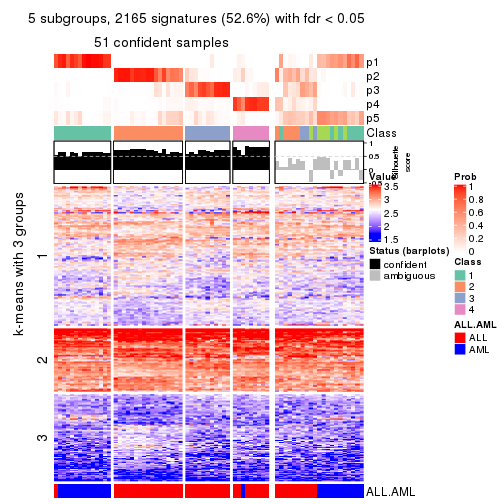
get_signatures(res, k = 6, scale_rows = FALSE)
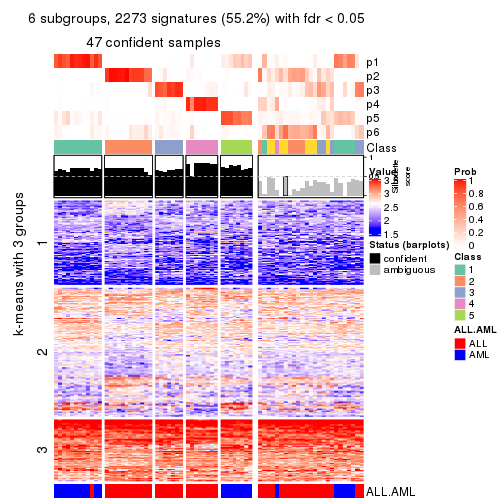
Compare the overlap of signatures from different k:
compare_signatures(res)
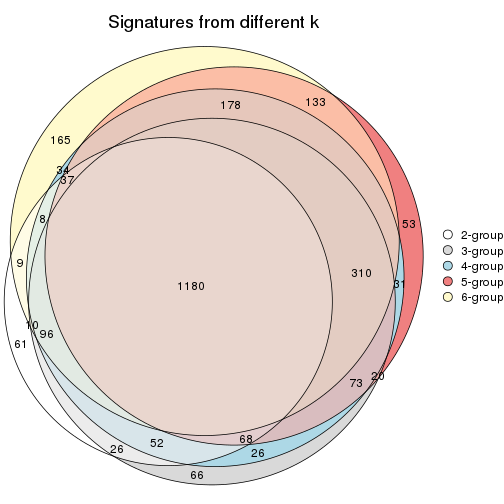
get_signature() returns a data frame invisibly. TO get the list of signatures, the function
call should be assigned to a variable explicitly. In following code, if plot argument is set
to FALSE, no heatmap is plotted while only the differential analysis is performed.
# code only for demonstration
tb = get_signature(res, k = ..., plot = FALSE)
An example of the output of tb is:
#> which_row fdr mean_1 mean_2 scaled_mean_1 scaled_mean_2 km
#> 1 38 0.042760348 8.373488 9.131774 -0.5533452 0.5164555 1
#> 2 40 0.018707592 7.106213 8.469186 -0.6173731 0.5762149 1
#> 3 55 0.019134737 10.221463 11.207825 -0.6159697 0.5749050 1
#> 4 59 0.006059896 5.921854 7.869574 -0.6899429 0.6439467 1
#> 5 60 0.018055526 8.928898 10.211722 -0.6204761 0.5791110 1
#> 6 98 0.009384629 15.714769 14.887706 0.6635654 -0.6193277 2
...
The columns in tb are:
which_row: row indices corresponding to the input matrix.fdr: FDR for the differential test. mean_x: The mean value in group x.scaled_mean_x: The mean value in group x after rows are scaled.km: Row groups if k-means clustering is applied to rows.UMAP plot which shows how samples are separated.
dimension_reduction(res, k = 2, method = "UMAP")
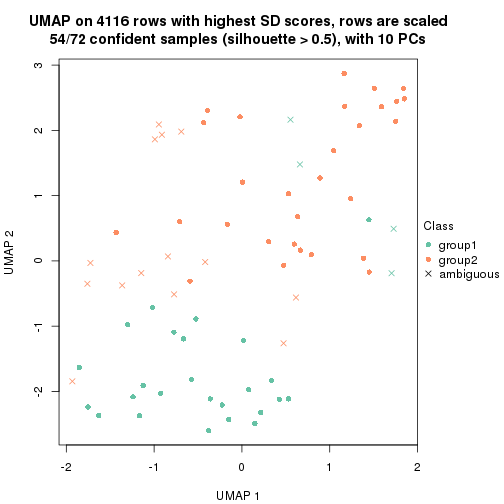
dimension_reduction(res, k = 3, method = "UMAP")
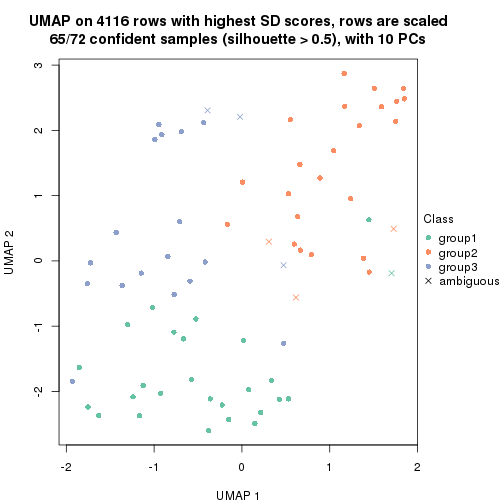
dimension_reduction(res, k = 4, method = "UMAP")
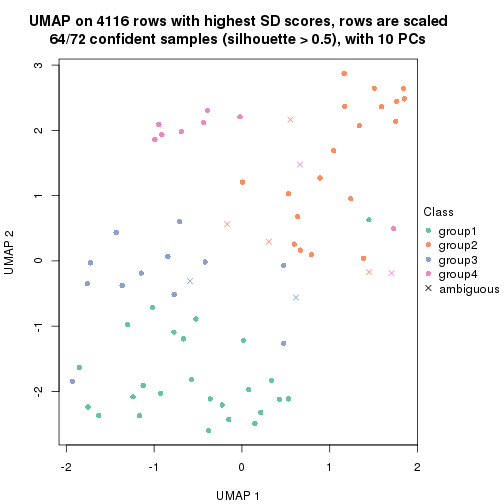
dimension_reduction(res, k = 5, method = "UMAP")
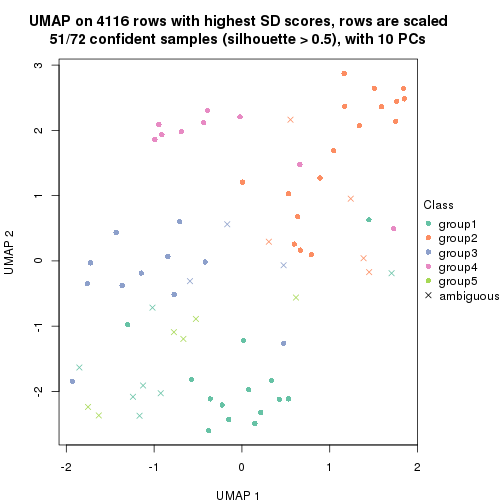
dimension_reduction(res, k = 6, method = "UMAP")
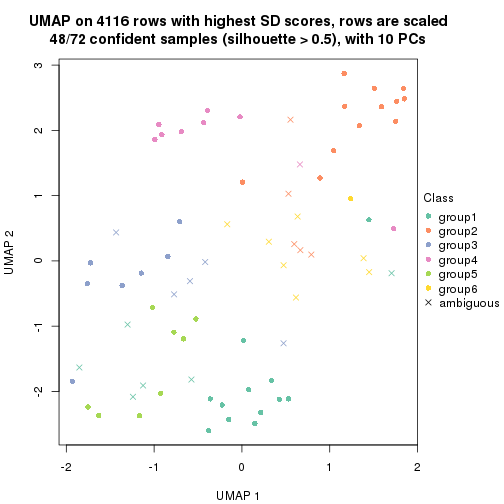
Following heatmap shows how subgroups are split when increasing k:
collect_classes(res)
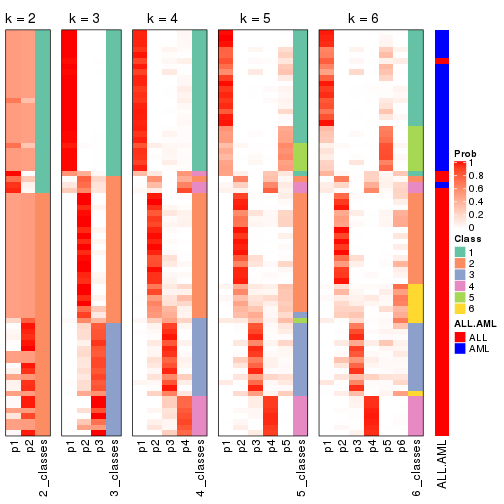
Test correlation between subgroups and known annotations. If the known annotation is numeric, one-way ANOVA test is applied, and if the known annotation is discrete, chi-squared contingency table test is applied.
test_to_known_factors(res)
#> n ALL.AML(p) k
#> SD:skmeans 54 1.01e-11 2
#> SD:skmeans 65 4.40e-13 3
#> SD:skmeans 64 6.16e-13 4
#> SD:skmeans 51 4.27e-09 5
#> SD:skmeans 48 2.14e-08 6
If matrix rows can be associated to genes, consider to use functional_enrichment(res,
...) to perform function enrichment for the signature genes. See this vignette for more detailed explanations.
The object with results only for a single top-value method and a single partition method can be extracted as:
res = res_list["SD", "pam"]
# you can also extract it by
# res = res_list["SD:pam"]
A summary of res and all the functions that can be applied to it:
res
#> A 'ConsensusPartition' object with k = 2, 3, 4, 5, 6.
#> On a matrix with 4116 rows and 72 columns.
#> Top rows (412, 824, 1235, 1646, 2058) are extracted by 'SD' method.
#> Subgroups are detected by 'pam' method.
#> Performed in total 1250 partitions by row resampling.
#> Best k for subgroups seems to be 2.
#>
#> Following methods can be applied to this 'ConsensusPartition' object:
#> [1] "cola_report" "collect_classes" "collect_plots"
#> [4] "collect_stats" "colnames" "compare_signatures"
#> [7] "consensus_heatmap" "dimension_reduction" "functional_enrichment"
#> [10] "get_anno_col" "get_anno" "get_classes"
#> [13] "get_consensus" "get_matrix" "get_membership"
#> [16] "get_param" "get_signatures" "get_stats"
#> [19] "is_best_k" "is_stable_k" "membership_heatmap"
#> [22] "ncol" "nrow" "plot_ecdf"
#> [25] "rownames" "select_partition_number" "show"
#> [28] "suggest_best_k" "test_to_known_factors"
collect_plots() function collects all the plots made from res for all k (number of partitions)
into one single page to provide an easy and fast comparison between different k.
collect_plots(res)
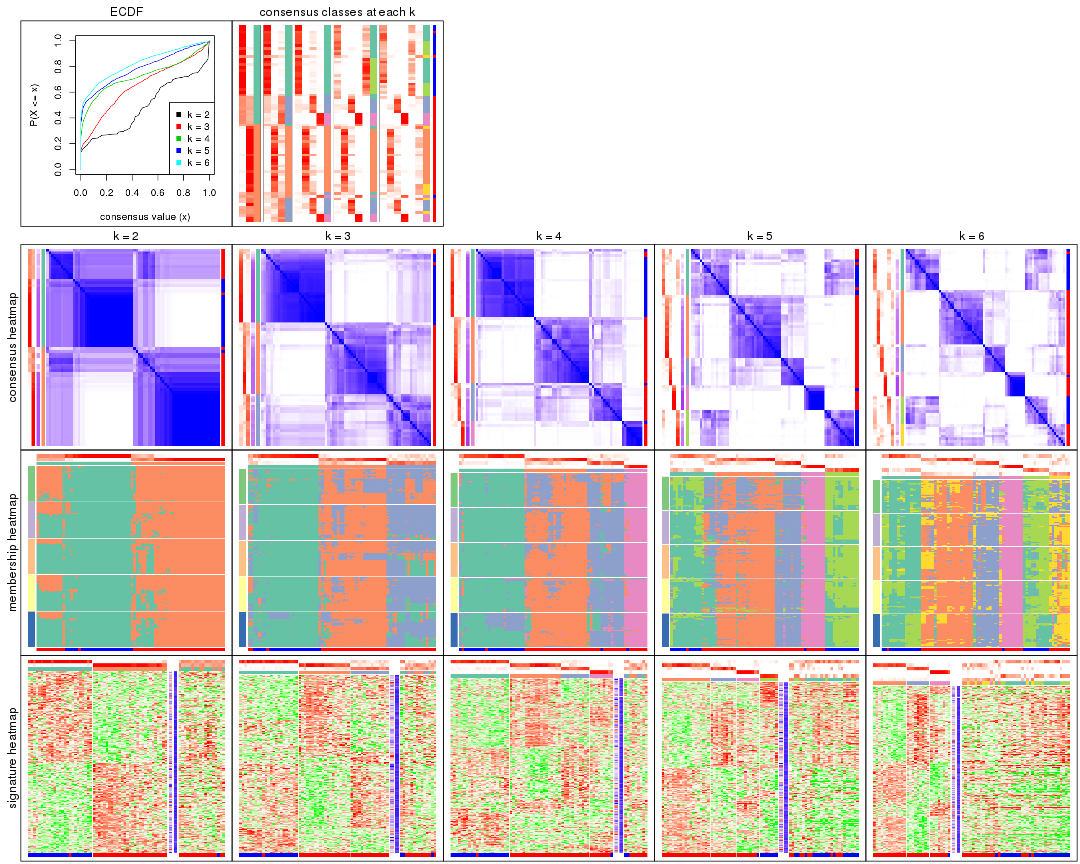
The plots are:
k and the heatmap of
predicted classes for each k.k.k.k.All the plots in panels can be made by individual functions and they are plotted later in this section.
select_partition_number() produces several plots showing different
statistics for choosing “optimized” k. There are following statistics:
k;k, the area increased is defined as \(A_k - A_{k-1}\).The detailed explanations of these statistics can be found in the cola vignette.
Generally speaking, lower PAC score, higher mean silhouette score or higher
concordance corresponds to better partition. Rand index and Jaccard index
measure how similar the current partition is compared to partition with k-1.
If they are too similar, we won't accept k is better than k-1.
select_partition_number(res)
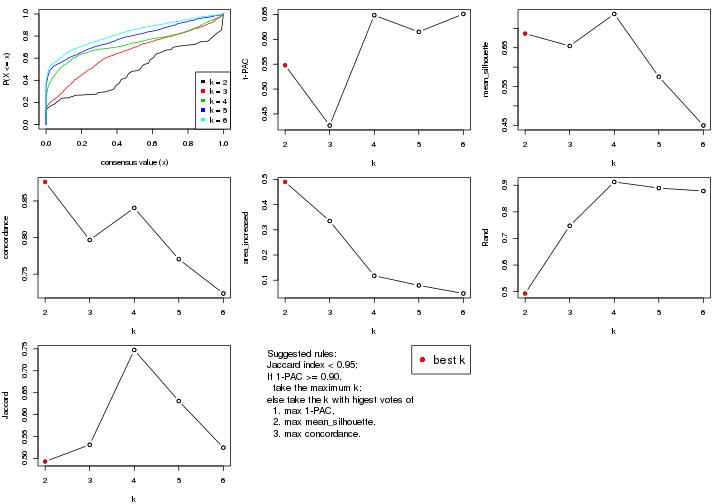
The numeric values for all these statistics can be obtained by get_stats().
get_stats(res)
#> k 1-PAC mean_silhouette concordance area_increased Rand Jaccard
#> 2 2 0.548 0.686 0.876 0.4897 0.493 0.493
#> 3 3 0.427 0.654 0.797 0.3349 0.748 0.531
#> 4 4 0.648 0.737 0.840 0.1178 0.912 0.747
#> 5 5 0.615 0.575 0.770 0.0794 0.889 0.631
#> 6 6 0.651 0.449 0.724 0.0473 0.878 0.524
suggest_best_k() suggests the best \(k\) based on these statistics. The rules are as follows:
suggest_best_k(res)
#> [1] 2
Following shows the table of the partitions (You need to click the show/hide
code output link to see it). The membership matrix (columns with name p*)
is inferred by
clue::cl_consensus()
function with the SE method. Basically the value in the membership matrix
represents the probability to belong to a certain group. The finall class
label for an item is determined with the group with highest probability it
belongs to.
In get_classes() function, the entropy is calculated from the membership
matrix and the silhouette score is calculated from the consensus matrix.
cbind(get_classes(res, k = 2), get_membership(res, k = 2))
#> class entropy silhouette p1 p2
#> sample_39 2 0.8713 0.5351 0.292 0.708
#> sample_40 1 0.9732 0.3900 0.596 0.404
#> sample_42 2 0.3274 0.8284 0.060 0.940
#> sample_47 2 0.0000 0.8616 0.000 1.000
#> sample_48 2 0.0000 0.8616 0.000 1.000
#> sample_49 1 0.9795 0.3574 0.584 0.416
#> sample_41 2 0.0000 0.8616 0.000 1.000
#> sample_43 2 0.0000 0.8616 0.000 1.000
#> sample_44 2 0.0000 0.8616 0.000 1.000
#> sample_45 2 0.0000 0.8616 0.000 1.000
#> sample_46 2 0.0000 0.8616 0.000 1.000
#> sample_70 2 0.9944 0.0442 0.456 0.544
#> sample_71 2 0.3733 0.8221 0.072 0.928
#> sample_72 2 0.1414 0.8525 0.020 0.980
#> sample_68 2 0.0000 0.8616 0.000 1.000
#> sample_69 2 0.0000 0.8616 0.000 1.000
#> sample_67 1 0.9608 0.2700 0.616 0.384
#> sample_55 1 0.9833 0.3459 0.576 0.424
#> sample_56 2 0.8608 0.5360 0.284 0.716
#> sample_59 2 0.3879 0.8111 0.076 0.924
#> sample_52 1 0.0000 0.8212 1.000 0.000
#> sample_53 1 0.0000 0.8212 1.000 0.000
#> sample_51 1 0.0000 0.8212 1.000 0.000
#> sample_50 1 0.0000 0.8212 1.000 0.000
#> sample_54 1 0.5842 0.7295 0.860 0.140
#> sample_57 1 0.0000 0.8212 1.000 0.000
#> sample_58 1 0.0000 0.8212 1.000 0.000
#> sample_60 1 0.2948 0.8004 0.948 0.052
#> sample_61 1 0.0376 0.8201 0.996 0.004
#> sample_65 1 0.0000 0.8212 1.000 0.000
#> sample_66 2 0.9970 0.0956 0.468 0.532
#> sample_63 1 0.0000 0.8212 1.000 0.000
#> sample_64 1 0.6247 0.7235 0.844 0.156
#> sample_62 1 0.2236 0.8061 0.964 0.036
#> sample_1 2 0.0000 0.8616 0.000 1.000
#> sample_2 2 0.9963 0.1369 0.464 0.536
#> sample_3 1 0.9815 0.3498 0.580 0.420
#> sample_4 2 0.9775 0.1889 0.412 0.588
#> sample_5 2 0.0000 0.8616 0.000 1.000
#> sample_6 1 0.9635 0.4212 0.612 0.388
#> sample_7 1 0.9944 0.2579 0.544 0.456
#> sample_8 2 0.9983 -0.0322 0.476 0.524
#> sample_9 2 0.9248 0.4058 0.340 0.660
#> sample_10 1 0.9580 0.4254 0.620 0.380
#> sample_11 2 0.2603 0.8416 0.044 0.956
#> sample_12 1 0.0938 0.8173 0.988 0.012
#> sample_13 2 0.0000 0.8616 0.000 1.000
#> sample_14 2 0.1633 0.8502 0.024 0.976
#> sample_15 2 0.0000 0.8616 0.000 1.000
#> sample_16 2 0.0000 0.8616 0.000 1.000
#> sample_17 2 0.0000 0.8616 0.000 1.000
#> sample_18 2 0.3584 0.8267 0.068 0.932
#> sample_19 2 0.0000 0.8616 0.000 1.000
#> sample_20 2 0.0000 0.8616 0.000 1.000
#> sample_21 2 0.0000 0.8616 0.000 1.000
#> sample_22 1 0.9922 0.2323 0.552 0.448
#> sample_23 1 0.9815 0.3513 0.580 0.420
#> sample_24 2 0.0000 0.8616 0.000 1.000
#> sample_25 2 0.9427 0.3790 0.360 0.640
#> sample_26 2 0.0376 0.8599 0.004 0.996
#> sample_27 1 0.9635 0.4182 0.612 0.388
#> sample_34 1 0.0000 0.8212 1.000 0.000
#> sample_35 1 0.4298 0.7750 0.912 0.088
#> sample_36 1 0.0000 0.8212 1.000 0.000
#> sample_37 1 0.0000 0.8212 1.000 0.000
#> sample_38 1 0.0000 0.8212 1.000 0.000
#> sample_28 1 0.0000 0.8212 1.000 0.000
#> sample_29 1 0.0000 0.8212 1.000 0.000
#> sample_30 1 0.0000 0.8212 1.000 0.000
#> sample_31 1 0.0000 0.8212 1.000 0.000
#> sample_32 1 0.0000 0.8212 1.000 0.000
#> sample_33 1 0.0000 0.8212 1.000 0.000
cbind(get_classes(res, k = 3), get_membership(res, k = 3))
#> class entropy silhouette p1 p2 p3
#> sample_39 3 0.8436 0.48446 0.160 0.224 0.616
#> sample_40 3 0.7233 0.67132 0.264 0.064 0.672
#> sample_42 2 0.5891 0.67687 0.036 0.764 0.200
#> sample_47 2 0.2796 0.75873 0.000 0.908 0.092
#> sample_48 2 0.0000 0.75757 0.000 1.000 0.000
#> sample_49 3 0.7057 0.67645 0.264 0.056 0.680
#> sample_41 2 0.5465 0.44859 0.000 0.712 0.288
#> sample_43 2 0.3686 0.74830 0.000 0.860 0.140
#> sample_44 2 0.6111 0.39243 0.000 0.604 0.396
#> sample_45 2 0.3116 0.75390 0.000 0.892 0.108
#> sample_46 2 0.2625 0.75827 0.000 0.916 0.084
#> sample_70 3 0.7180 0.66995 0.196 0.096 0.708
#> sample_71 2 0.7642 0.56561 0.092 0.660 0.248
#> sample_72 2 0.4235 0.71888 0.000 0.824 0.176
#> sample_68 2 0.0892 0.75526 0.000 0.980 0.020
#> sample_69 2 0.0237 0.75804 0.000 0.996 0.004
#> sample_67 1 0.9350 0.19255 0.488 0.328 0.184
#> sample_55 3 0.8728 0.67197 0.288 0.144 0.568
#> sample_56 3 0.7875 0.57542 0.136 0.200 0.664
#> sample_59 2 0.7063 0.16839 0.020 0.516 0.464
#> sample_52 1 0.0000 0.87326 1.000 0.000 0.000
#> sample_53 1 0.1643 0.86524 0.956 0.000 0.044
#> sample_51 1 0.0000 0.87326 1.000 0.000 0.000
#> sample_50 1 0.0237 0.87387 0.996 0.000 0.004
#> sample_54 1 0.5047 0.70690 0.824 0.140 0.036
#> sample_57 1 0.0424 0.87032 0.992 0.000 0.008
#> sample_58 1 0.0237 0.87261 0.996 0.000 0.004
#> sample_60 1 0.2796 0.79881 0.908 0.000 0.092
#> sample_61 1 0.2711 0.84762 0.912 0.000 0.088
#> sample_65 1 0.0424 0.87294 0.992 0.000 0.008
#> sample_66 2 0.9013 0.22751 0.152 0.524 0.324
#> sample_63 1 0.0000 0.87326 1.000 0.000 0.000
#> sample_64 1 0.7112 0.29347 0.648 0.044 0.308
#> sample_62 1 0.2301 0.82362 0.936 0.004 0.060
#> sample_1 3 0.6026 0.19052 0.000 0.376 0.624
#> sample_2 1 0.9953 0.00369 0.380 0.300 0.320
#> sample_3 3 0.5212 0.63786 0.108 0.064 0.828
#> sample_4 3 0.8752 0.59684 0.144 0.292 0.564
#> sample_5 2 0.1163 0.75356 0.000 0.972 0.028
#> sample_6 3 0.5695 0.63400 0.120 0.076 0.804
#> sample_7 3 0.9153 0.65444 0.308 0.172 0.520
#> sample_8 3 0.7413 0.65510 0.204 0.104 0.692
#> sample_9 3 0.6025 0.51198 0.028 0.232 0.740
#> sample_10 3 0.5852 0.60479 0.180 0.044 0.776
#> sample_11 3 0.7940 0.07116 0.060 0.416 0.524
#> sample_12 1 0.3769 0.79833 0.880 0.016 0.104
#> sample_13 2 0.0000 0.75757 0.000 1.000 0.000
#> sample_14 3 0.5431 0.43648 0.000 0.284 0.716
#> sample_15 2 0.1643 0.75068 0.000 0.956 0.044
#> sample_16 2 0.5098 0.61180 0.000 0.752 0.248
#> sample_17 2 0.2625 0.73844 0.000 0.916 0.084
#> sample_18 2 0.8955 0.26014 0.140 0.516 0.344
#> sample_19 2 0.4399 0.72188 0.000 0.812 0.188
#> sample_20 2 0.0000 0.75757 0.000 1.000 0.000
#> sample_21 2 0.1643 0.75554 0.000 0.956 0.044
#> sample_22 3 0.7758 0.60299 0.280 0.084 0.636
#> sample_23 3 0.5467 0.63638 0.112 0.072 0.816
#> sample_24 2 0.5254 0.50036 0.000 0.736 0.264
#> sample_25 2 0.9582 0.13025 0.228 0.472 0.300
#> sample_26 2 0.4555 0.71087 0.000 0.800 0.200
#> sample_27 3 0.6772 0.64197 0.304 0.032 0.664
#> sample_34 1 0.0000 0.87326 1.000 0.000 0.000
#> sample_35 1 0.5465 0.44178 0.712 0.000 0.288
#> sample_36 1 0.1529 0.86647 0.960 0.000 0.040
#> sample_37 1 0.1529 0.86647 0.960 0.000 0.040
#> sample_38 1 0.2066 0.86096 0.940 0.000 0.060
#> sample_28 1 0.1964 0.86236 0.944 0.000 0.056
#> sample_29 1 0.1765 0.86542 0.956 0.004 0.040
#> sample_30 1 0.0237 0.87386 0.996 0.000 0.004
#> sample_31 1 0.0747 0.87063 0.984 0.000 0.016
#> sample_32 1 0.0892 0.87275 0.980 0.000 0.020
#> sample_33 1 0.1529 0.86647 0.960 0.000 0.040
cbind(get_classes(res, k = 4), get_membership(res, k = 4))
#> class entropy silhouette p1 p2 p3 p4
#> sample_39 3 0.2586 0.6957 0.048 0.040 0.912 0.000
#> sample_40 3 0.2859 0.7491 0.112 0.008 0.880 0.000
#> sample_42 2 0.5310 0.6363 0.028 0.704 0.260 0.008
#> sample_47 2 0.1940 0.7862 0.000 0.924 0.076 0.000
#> sample_48 2 0.0000 0.7831 0.000 1.000 0.000 0.000
#> sample_49 3 0.2593 0.7482 0.104 0.004 0.892 0.000
#> sample_41 2 0.4072 0.5992 0.000 0.748 0.252 0.000
#> sample_43 2 0.3266 0.7575 0.000 0.832 0.168 0.000
#> sample_44 2 0.4907 0.4230 0.000 0.580 0.420 0.000
#> sample_45 2 0.2760 0.7685 0.000 0.872 0.128 0.000
#> sample_46 2 0.2408 0.7738 0.000 0.896 0.104 0.000
#> sample_70 3 0.5010 0.7175 0.072 0.020 0.796 0.112
#> sample_71 2 0.6580 0.4238 0.068 0.564 0.360 0.008
#> sample_72 2 0.4018 0.6992 0.000 0.772 0.224 0.004
#> sample_68 2 0.0707 0.7819 0.000 0.980 0.020 0.000
#> sample_69 2 0.0336 0.7838 0.000 0.992 0.008 0.000
#> sample_67 1 0.7170 0.4673 0.592 0.244 0.152 0.012
#> sample_55 3 0.7280 0.6605 0.180 0.140 0.636 0.044
#> sample_56 3 0.3781 0.7355 0.080 0.052 0.860 0.008
#> sample_59 2 0.4994 0.2607 0.000 0.520 0.480 0.000
#> sample_52 1 0.1388 0.8852 0.960 0.000 0.028 0.012
#> sample_53 1 0.2345 0.8686 0.900 0.000 0.100 0.000
#> sample_51 1 0.0336 0.8933 0.992 0.000 0.008 0.000
#> sample_50 1 0.0469 0.8934 0.988 0.000 0.012 0.000
#> sample_54 1 0.3467 0.8444 0.884 0.056 0.032 0.028
#> sample_57 1 0.1388 0.8852 0.960 0.000 0.028 0.012
#> sample_58 1 0.1488 0.8850 0.956 0.000 0.032 0.012
#> sample_60 1 0.2255 0.8640 0.920 0.000 0.068 0.012
#> sample_61 1 0.2999 0.8555 0.864 0.000 0.132 0.004
#> sample_65 1 0.1109 0.8918 0.968 0.000 0.028 0.004
#> sample_66 4 0.3380 0.8158 0.008 0.136 0.004 0.852
#> sample_63 1 0.1388 0.8852 0.960 0.000 0.028 0.012
#> sample_64 3 0.6738 0.1735 0.452 0.060 0.476 0.012
#> sample_62 1 0.1677 0.8788 0.948 0.000 0.040 0.012
#> sample_1 3 0.4072 0.4629 0.000 0.252 0.748 0.000
#> sample_2 4 0.5614 0.7336 0.080 0.140 0.024 0.756
#> sample_3 4 0.0592 0.9373 0.000 0.000 0.016 0.984
#> sample_4 3 0.6732 0.5818 0.068 0.252 0.644 0.036
#> sample_5 2 0.0817 0.7805 0.000 0.976 0.024 0.000
#> sample_6 4 0.0707 0.9358 0.000 0.000 0.020 0.980
#> sample_7 3 0.7019 0.6434 0.140 0.188 0.644 0.028
#> sample_8 3 0.2214 0.7287 0.044 0.028 0.928 0.000
#> sample_9 4 0.0524 0.9384 0.000 0.004 0.008 0.988
#> sample_10 4 0.0469 0.9339 0.012 0.000 0.000 0.988
#> sample_11 4 0.0524 0.9362 0.008 0.004 0.000 0.988
#> sample_12 1 0.4018 0.7734 0.812 0.016 0.168 0.004
#> sample_13 2 0.0000 0.7831 0.000 1.000 0.000 0.000
#> sample_14 4 0.0657 0.9382 0.000 0.004 0.012 0.984
#> sample_15 2 0.1302 0.7784 0.000 0.956 0.044 0.000
#> sample_16 2 0.3528 0.7070 0.000 0.808 0.192 0.000
#> sample_17 2 0.3198 0.7579 0.000 0.880 0.080 0.040
#> sample_18 2 0.8457 0.1803 0.052 0.452 0.336 0.160
#> sample_19 2 0.4040 0.7018 0.000 0.752 0.248 0.000
#> sample_20 2 0.0000 0.7831 0.000 1.000 0.000 0.000
#> sample_21 2 0.1389 0.7813 0.000 0.952 0.048 0.000
#> sample_22 3 0.1890 0.7106 0.056 0.008 0.936 0.000
#> sample_23 4 0.0707 0.9358 0.000 0.000 0.020 0.980
#> sample_24 2 0.4072 0.6035 0.000 0.748 0.252 0.000
#> sample_25 3 0.7030 -0.0105 0.080 0.380 0.524 0.016
#> sample_26 2 0.4304 0.6635 0.000 0.716 0.284 0.000
#> sample_27 3 0.3790 0.7481 0.132 0.004 0.840 0.024
#> sample_34 1 0.0336 0.8920 0.992 0.000 0.008 0.000
#> sample_35 1 0.5827 0.0713 0.568 0.000 0.396 0.036
#> sample_36 1 0.2805 0.8808 0.888 0.000 0.100 0.012
#> sample_37 1 0.2345 0.8686 0.900 0.000 0.100 0.000
#> sample_38 1 0.2987 0.8611 0.880 0.000 0.104 0.016
#> sample_28 1 0.2714 0.8652 0.884 0.000 0.112 0.004
#> sample_29 1 0.2345 0.8686 0.900 0.000 0.100 0.000
#> sample_30 1 0.1151 0.8894 0.968 0.000 0.024 0.008
#> sample_31 1 0.0592 0.8919 0.984 0.000 0.016 0.000
#> sample_32 1 0.0817 0.8923 0.976 0.000 0.024 0.000
#> sample_33 1 0.2345 0.8686 0.900 0.000 0.100 0.000
cbind(get_classes(res, k = 5), get_membership(res, k = 5))
#> class entropy silhouette p1 p2 p3 p4 p5
#> sample_39 1 0.4830 -0.0153 0.492 0.020 0.488 0.000 0.000
#> sample_40 3 0.1682 0.8377 0.044 0.012 0.940 0.000 0.004
#> sample_42 2 0.6054 0.4551 0.280 0.560 0.160 0.000 0.000
#> sample_47 2 0.2331 0.7832 0.020 0.900 0.080 0.000 0.000
#> sample_48 2 0.0162 0.7858 0.000 0.996 0.004 0.000 0.000
#> sample_49 3 0.0000 0.8381 0.000 0.000 1.000 0.000 0.000
#> sample_41 2 0.4000 0.6294 0.024 0.748 0.228 0.000 0.000
#> sample_43 2 0.4028 0.7310 0.048 0.776 0.176 0.000 0.000
#> sample_44 2 0.4898 0.4869 0.032 0.592 0.376 0.000 0.000
#> sample_45 2 0.3267 0.7640 0.044 0.844 0.112 0.000 0.000
#> sample_46 2 0.2824 0.7698 0.032 0.872 0.096 0.000 0.000
#> sample_70 3 0.4515 0.7254 0.080 0.012 0.788 0.112 0.008
#> sample_71 1 0.6442 0.1574 0.492 0.300 0.208 0.000 0.000
#> sample_72 2 0.4850 0.6586 0.076 0.700 0.224 0.000 0.000
#> sample_68 2 0.1281 0.7825 0.032 0.956 0.012 0.000 0.000
#> sample_69 2 0.0963 0.7861 0.036 0.964 0.000 0.000 0.000
#> sample_67 1 0.7045 0.1823 0.456 0.180 0.020 0.004 0.340
#> sample_55 3 0.4899 0.7236 0.144 0.112 0.736 0.000 0.008
#> sample_56 3 0.0324 0.8371 0.004 0.004 0.992 0.000 0.000
#> sample_59 2 0.5071 0.3895 0.036 0.540 0.424 0.000 0.000
#> sample_52 5 0.1043 0.6946 0.040 0.000 0.000 0.000 0.960
#> sample_53 5 0.3661 0.4133 0.276 0.000 0.000 0.000 0.724
#> sample_51 1 0.3508 0.4049 0.748 0.000 0.000 0.000 0.252
#> sample_50 1 0.4302 -0.0328 0.520 0.000 0.000 0.000 0.480
#> sample_54 5 0.1918 0.6637 0.048 0.004 0.012 0.004 0.932
#> sample_57 5 0.3730 0.4905 0.288 0.000 0.000 0.000 0.712
#> sample_58 5 0.2843 0.6351 0.144 0.000 0.008 0.000 0.848
#> sample_60 5 0.4666 0.4655 0.284 0.000 0.040 0.000 0.676
#> sample_61 1 0.2970 0.4512 0.828 0.000 0.004 0.000 0.168
#> sample_65 5 0.4291 0.1700 0.464 0.000 0.000 0.000 0.536
#> sample_66 4 0.3428 0.8255 0.052 0.092 0.008 0.848 0.000
#> sample_63 5 0.0609 0.6924 0.020 0.000 0.000 0.000 0.980
#> sample_64 1 0.6964 -0.0801 0.388 0.008 0.252 0.000 0.352
#> sample_62 5 0.0703 0.6904 0.024 0.000 0.000 0.000 0.976
#> sample_1 3 0.2707 0.7294 0.008 0.132 0.860 0.000 0.000
#> sample_2 4 0.5909 0.6188 0.188 0.112 0.000 0.664 0.036
#> sample_3 4 0.0000 0.9401 0.000 0.000 0.000 1.000 0.000
#> sample_4 3 0.4356 0.7057 0.044 0.204 0.748 0.004 0.000
#> sample_5 2 0.1211 0.7826 0.024 0.960 0.016 0.000 0.000
#> sample_6 4 0.0000 0.9401 0.000 0.000 0.000 1.000 0.000
#> sample_7 3 0.4599 0.7453 0.088 0.156 0.752 0.000 0.004
#> sample_8 3 0.1493 0.8334 0.028 0.024 0.948 0.000 0.000
#> sample_9 4 0.0000 0.9401 0.000 0.000 0.000 1.000 0.000
#> sample_10 4 0.0000 0.9401 0.000 0.000 0.000 1.000 0.000
#> sample_11 4 0.0000 0.9401 0.000 0.000 0.000 1.000 0.000
#> sample_12 1 0.3550 0.4543 0.796 0.000 0.020 0.000 0.184
#> sample_13 2 0.0162 0.7858 0.000 0.996 0.004 0.000 0.000
#> sample_14 4 0.0324 0.9362 0.004 0.000 0.004 0.992 0.000
#> sample_15 2 0.1568 0.7792 0.020 0.944 0.036 0.000 0.000
#> sample_16 2 0.3355 0.7214 0.012 0.804 0.184 0.000 0.000
#> sample_17 2 0.3009 0.7637 0.016 0.876 0.080 0.028 0.000
#> sample_18 2 0.8299 0.0265 0.260 0.364 0.280 0.084 0.012
#> sample_19 2 0.4054 0.6992 0.020 0.732 0.248 0.000 0.000
#> sample_20 2 0.0451 0.7855 0.008 0.988 0.004 0.000 0.000
#> sample_21 2 0.1331 0.7835 0.008 0.952 0.040 0.000 0.000
#> sample_22 1 0.4449 0.0250 0.512 0.000 0.484 0.000 0.004
#> sample_23 4 0.0000 0.9401 0.000 0.000 0.000 1.000 0.000
#> sample_24 2 0.4054 0.6377 0.028 0.748 0.224 0.000 0.000
#> sample_25 1 0.6001 0.2965 0.580 0.176 0.244 0.000 0.000
#> sample_26 2 0.5087 0.6180 0.064 0.644 0.292 0.000 0.000
#> sample_27 3 0.1924 0.8285 0.064 0.000 0.924 0.008 0.004
#> sample_34 1 0.3684 0.3501 0.720 0.000 0.000 0.000 0.280
#> sample_35 1 0.3579 0.4326 0.836 0.000 0.080 0.004 0.080
#> sample_36 5 0.1270 0.6821 0.052 0.000 0.000 0.000 0.948
#> sample_37 5 0.3816 0.3640 0.304 0.000 0.000 0.000 0.696
#> sample_38 1 0.4420 0.1681 0.548 0.000 0.000 0.004 0.448
#> sample_28 1 0.4235 0.2116 0.576 0.000 0.000 0.000 0.424
#> sample_29 1 0.4101 0.2739 0.628 0.000 0.000 0.000 0.372
#> sample_30 5 0.1410 0.6798 0.060 0.000 0.000 0.000 0.940
#> sample_31 1 0.5046 -0.1589 0.500 0.000 0.032 0.000 0.468
#> sample_32 1 0.3109 0.4405 0.800 0.000 0.000 0.000 0.200
#> sample_33 5 0.4262 -0.0202 0.440 0.000 0.000 0.000 0.560
cbind(get_classes(res, k = 6), get_membership(res, k = 6))
#> class entropy silhouette p1 p2 p3 p4 p5 p6
#> sample_39 6 0.4865 0.351041 0.096 0.004 0.248 0.000 0.000 0.652
#> sample_40 3 0.1923 0.713010 0.000 0.004 0.916 0.000 0.016 0.064
#> sample_42 6 0.6128 0.267513 0.084 0.336 0.056 0.000 0.004 0.520
#> sample_47 2 0.3388 0.665928 0.000 0.804 0.036 0.000 0.004 0.156
#> sample_48 2 0.1531 0.706545 0.000 0.928 0.000 0.000 0.004 0.068
#> sample_49 3 0.1858 0.696202 0.000 0.004 0.904 0.000 0.000 0.092
#> sample_41 2 0.2553 0.635913 0.000 0.848 0.144 0.000 0.000 0.008
#> sample_43 2 0.5329 0.424026 0.000 0.556 0.108 0.000 0.004 0.332
#> sample_44 2 0.5954 0.305600 0.000 0.468 0.204 0.000 0.004 0.324
#> sample_45 2 0.4759 0.449432 0.000 0.556 0.044 0.000 0.004 0.396
#> sample_46 2 0.4667 0.470687 0.000 0.576 0.040 0.000 0.004 0.380
#> sample_70 6 0.5689 -0.000568 0.000 0.008 0.400 0.072 0.020 0.500
#> sample_71 6 0.5030 0.510195 0.064 0.072 0.120 0.000 0.012 0.732
#> sample_72 6 0.5639 0.416735 0.004 0.284 0.168 0.000 0.000 0.544
#> sample_68 2 0.1866 0.685847 0.000 0.908 0.008 0.000 0.000 0.084
#> sample_69 2 0.2320 0.679710 0.000 0.864 0.004 0.000 0.000 0.132
#> sample_67 6 0.5952 0.308847 0.308 0.096 0.004 0.000 0.040 0.552
#> sample_55 3 0.4308 0.634435 0.000 0.112 0.768 0.000 0.088 0.032
#> sample_56 3 0.2212 0.683551 0.000 0.008 0.880 0.000 0.000 0.112
#> sample_59 2 0.6029 0.236087 0.000 0.412 0.256 0.000 0.000 0.332
#> sample_52 1 0.4067 0.384247 0.548 0.000 0.000 0.000 0.444 0.008
#> sample_53 1 0.2454 0.435749 0.840 0.000 0.000 0.000 0.160 0.000
#> sample_51 1 0.3993 -0.426792 0.520 0.000 0.000 0.000 0.476 0.004
#> sample_50 1 0.4032 -0.163125 0.572 0.000 0.000 0.000 0.420 0.008
#> sample_54 1 0.4650 0.347181 0.504 0.004 0.016 0.004 0.468 0.004
#> sample_57 5 0.2006 0.286147 0.104 0.000 0.000 0.000 0.892 0.004
#> sample_58 5 0.4006 -0.260496 0.392 0.000 0.004 0.000 0.600 0.004
#> sample_60 5 0.3494 0.234103 0.160 0.004 0.032 0.000 0.800 0.004
#> sample_61 5 0.4975 0.372027 0.444 0.000 0.008 0.000 0.500 0.048
#> sample_65 5 0.3998 0.274680 0.340 0.000 0.000 0.000 0.644 0.016
#> sample_66 4 0.4043 0.741528 0.008 0.104 0.016 0.808 0.016 0.048
#> sample_63 1 0.3937 0.400667 0.572 0.000 0.000 0.000 0.424 0.004
#> sample_64 5 0.3808 0.351934 0.028 0.004 0.208 0.000 0.756 0.004
#> sample_62 1 0.3982 0.375254 0.536 0.000 0.000 0.000 0.460 0.004
#> sample_1 3 0.3717 0.560856 0.000 0.148 0.780 0.000 0.000 0.072
#> sample_2 4 0.6536 0.112660 0.060 0.064 0.000 0.448 0.028 0.400
#> sample_3 4 0.0000 0.904715 0.000 0.000 0.000 1.000 0.000 0.000
#> sample_4 3 0.3342 0.606339 0.000 0.228 0.760 0.000 0.000 0.012
#> sample_5 2 0.1866 0.685724 0.000 0.908 0.008 0.000 0.000 0.084
#> sample_6 4 0.0000 0.904715 0.000 0.000 0.000 1.000 0.000 0.000
#> sample_7 3 0.3698 0.644514 0.000 0.164 0.788 0.000 0.028 0.020
#> sample_8 3 0.1563 0.704781 0.000 0.012 0.932 0.000 0.000 0.056
#> sample_9 4 0.0000 0.904715 0.000 0.000 0.000 1.000 0.000 0.000
#> sample_10 4 0.0000 0.904715 0.000 0.000 0.000 1.000 0.000 0.000
#> sample_11 4 0.0146 0.903380 0.000 0.000 0.000 0.996 0.000 0.004
#> sample_12 1 0.5611 -0.414471 0.460 0.000 0.008 0.000 0.420 0.112
#> sample_13 2 0.1531 0.705888 0.000 0.928 0.000 0.000 0.004 0.068
#> sample_14 4 0.0508 0.897601 0.000 0.000 0.000 0.984 0.004 0.012
#> sample_15 2 0.1088 0.699496 0.000 0.960 0.016 0.000 0.000 0.024
#> sample_16 2 0.3125 0.658222 0.000 0.836 0.080 0.000 0.000 0.084
#> sample_17 2 0.2103 0.696254 0.000 0.912 0.020 0.012 0.000 0.056
#> sample_18 2 0.8344 -0.199513 0.192 0.400 0.140 0.056 0.012 0.200
#> sample_19 2 0.5057 0.462107 0.000 0.652 0.164 0.000 0.004 0.180
#> sample_20 2 0.2362 0.687176 0.000 0.860 0.000 0.000 0.004 0.136
#> sample_21 2 0.1364 0.707432 0.000 0.944 0.004 0.000 0.004 0.048
#> sample_22 3 0.6480 -0.263129 0.304 0.000 0.356 0.000 0.016 0.324
#> sample_23 4 0.0000 0.904715 0.000 0.000 0.000 1.000 0.000 0.000
#> sample_24 2 0.2750 0.637376 0.000 0.844 0.136 0.000 0.000 0.020
#> sample_25 6 0.6993 0.345284 0.360 0.064 0.132 0.000 0.020 0.424
#> sample_26 6 0.5925 0.127623 0.000 0.372 0.212 0.000 0.000 0.416
#> sample_27 3 0.1346 0.712594 0.000 0.000 0.952 0.008 0.016 0.024
#> sample_34 5 0.3993 0.430286 0.400 0.000 0.000 0.000 0.592 0.008
#> sample_35 5 0.4714 0.427990 0.368 0.000 0.020 0.004 0.592 0.016
#> sample_36 1 0.3819 0.423058 0.624 0.000 0.000 0.000 0.372 0.004
#> sample_37 1 0.2135 0.430711 0.872 0.000 0.000 0.000 0.128 0.000
#> sample_38 1 0.2506 0.289668 0.880 0.000 0.000 0.000 0.052 0.068
#> sample_28 1 0.2506 0.280455 0.880 0.000 0.000 0.000 0.068 0.052
#> sample_29 1 0.3253 0.069635 0.788 0.000 0.000 0.000 0.192 0.020
#> sample_30 1 0.3769 0.426986 0.640 0.000 0.000 0.000 0.356 0.004
#> sample_31 5 0.4449 0.412575 0.228 0.000 0.044 0.000 0.708 0.020
#> sample_32 5 0.4783 0.389284 0.428 0.000 0.000 0.000 0.520 0.052
#> sample_33 1 0.1151 0.383731 0.956 0.000 0.000 0.000 0.032 0.012
Heatmaps for the consensus matrix. It visualizes the probability of two samples to be in a same group.
consensus_heatmap(res, k = 2)
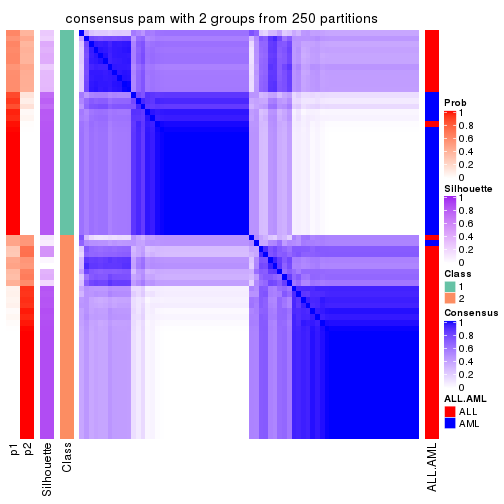
consensus_heatmap(res, k = 3)
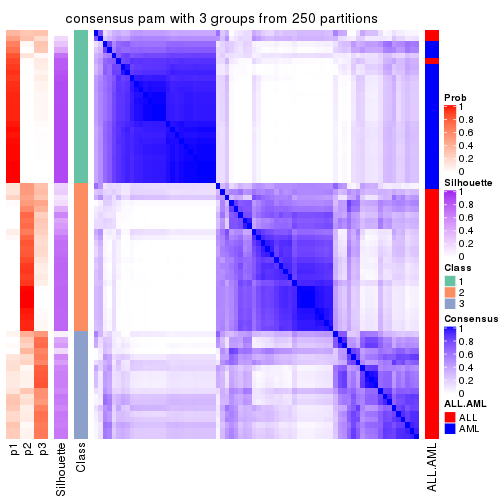
consensus_heatmap(res, k = 4)
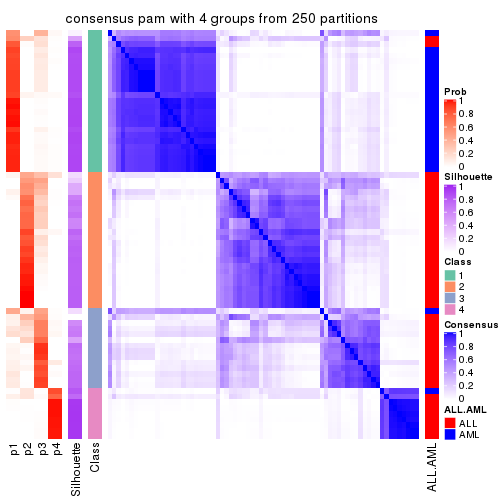
consensus_heatmap(res, k = 5)
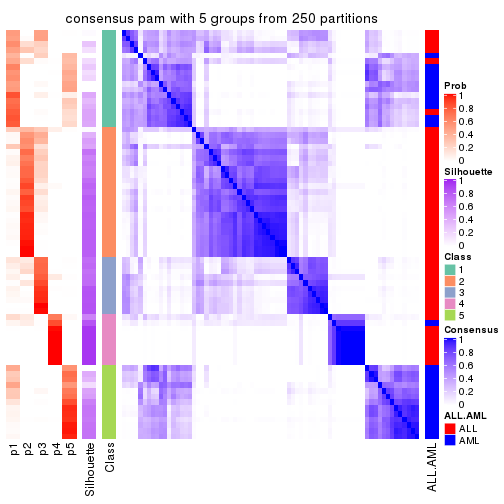
consensus_heatmap(res, k = 6)
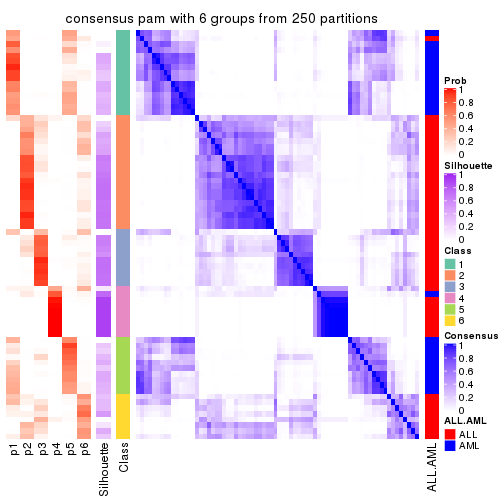
Heatmaps for the membership of samples in all partitions to see how consistent they are:
membership_heatmap(res, k = 2)
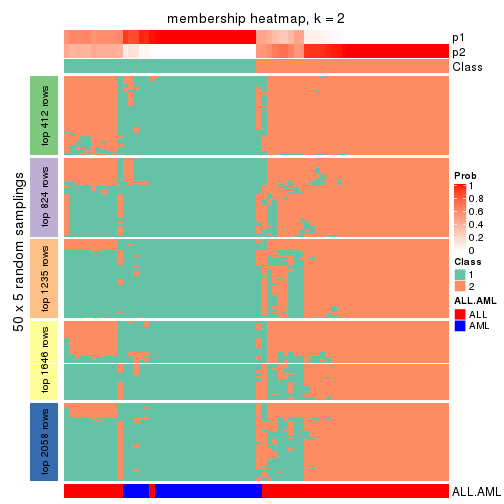
membership_heatmap(res, k = 3)
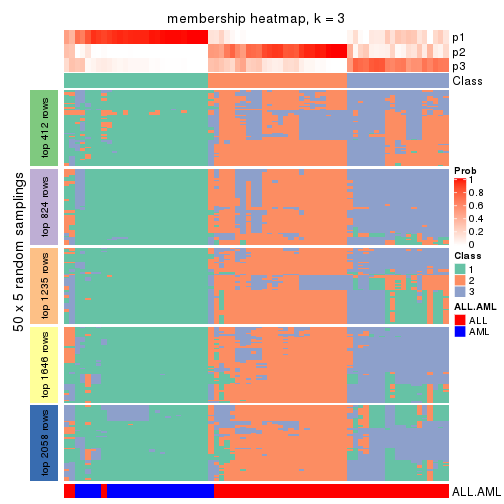
membership_heatmap(res, k = 4)
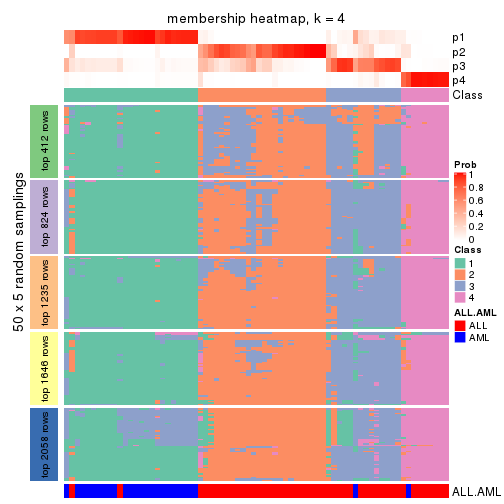
membership_heatmap(res, k = 5)
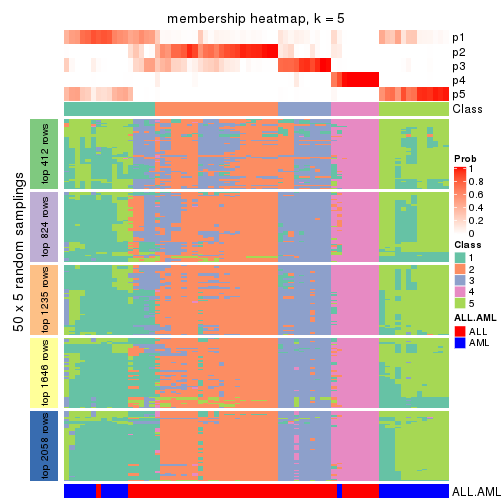
membership_heatmap(res, k = 6)
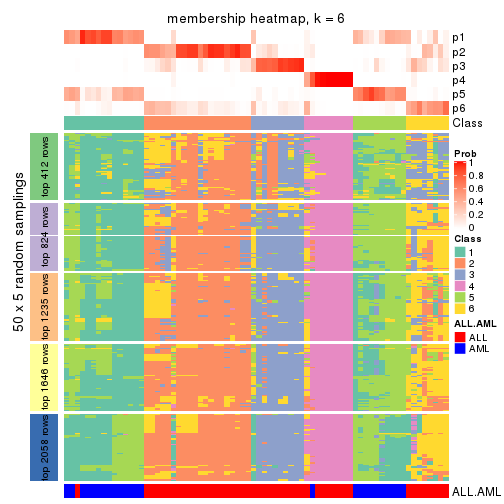
As soon as we have had the classes for columns, we can look for signatures which are significantly different between classes which can be candidate marks for certain classes. Following are the heatmaps for signatures.
Signature heatmaps where rows are scaled:
get_signatures(res, k = 2)
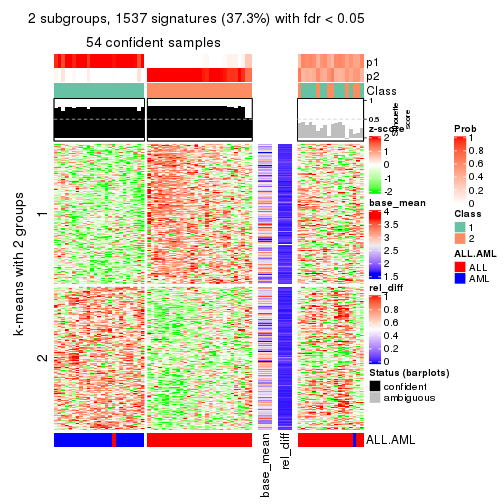
get_signatures(res, k = 3)
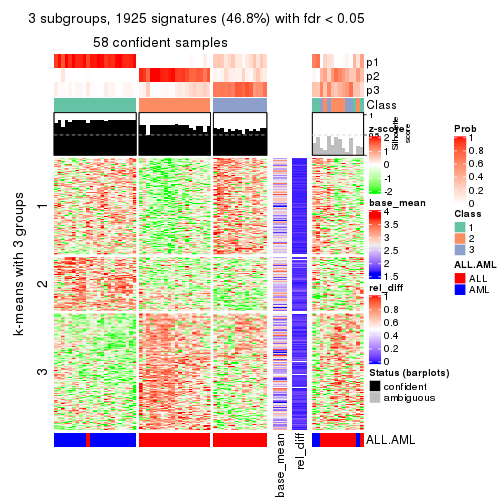
get_signatures(res, k = 4)
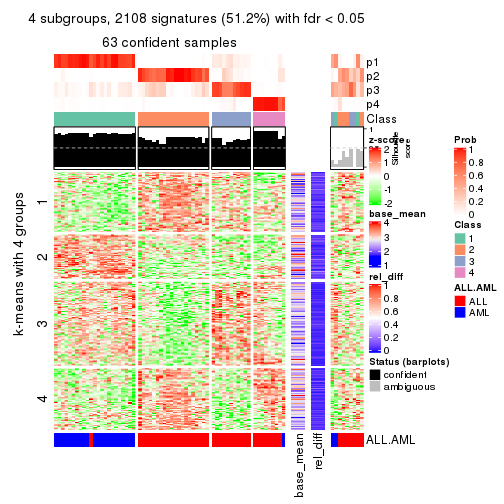
get_signatures(res, k = 5)
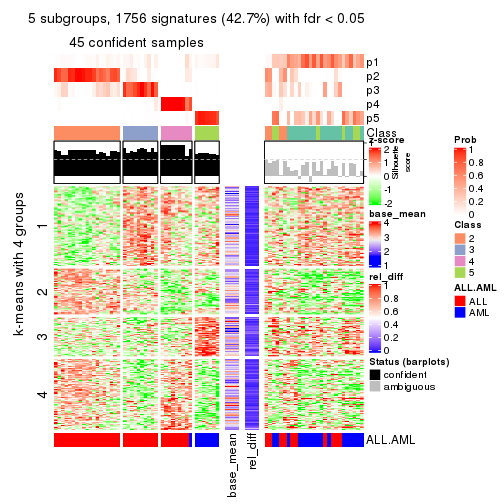
get_signatures(res, k = 6)
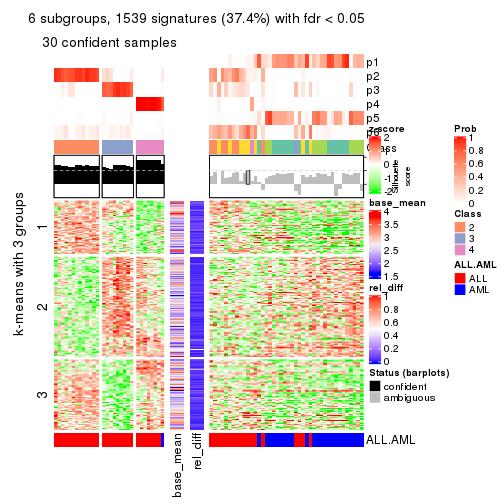
Signature heatmaps where rows are not scaled:
get_signatures(res, k = 2, scale_rows = FALSE)
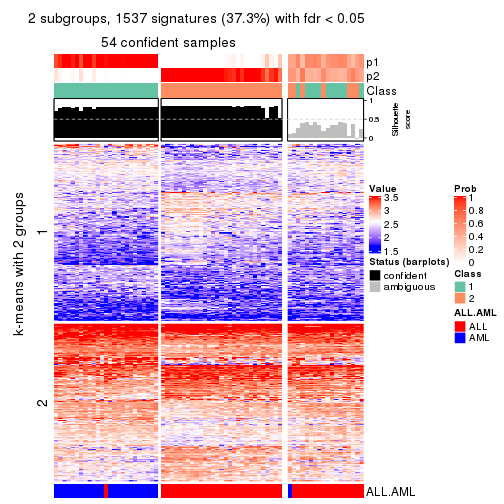
get_signatures(res, k = 3, scale_rows = FALSE)
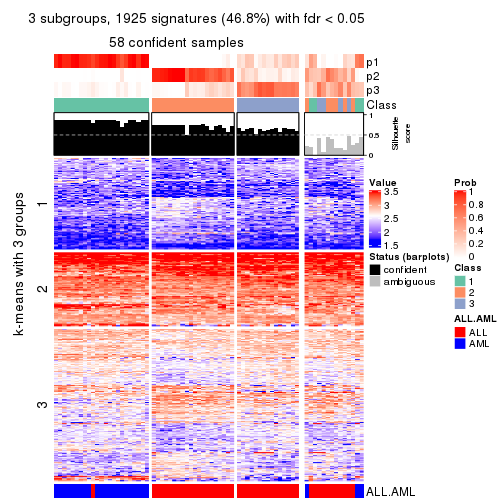
get_signatures(res, k = 4, scale_rows = FALSE)
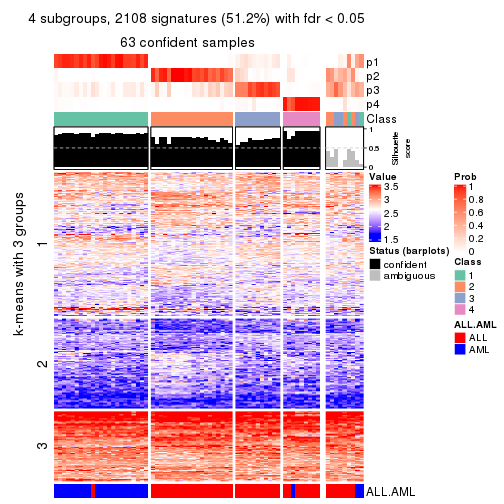
get_signatures(res, k = 5, scale_rows = FALSE)
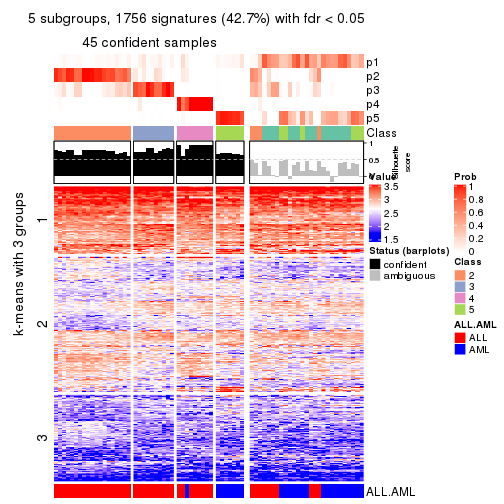
get_signatures(res, k = 6, scale_rows = FALSE)
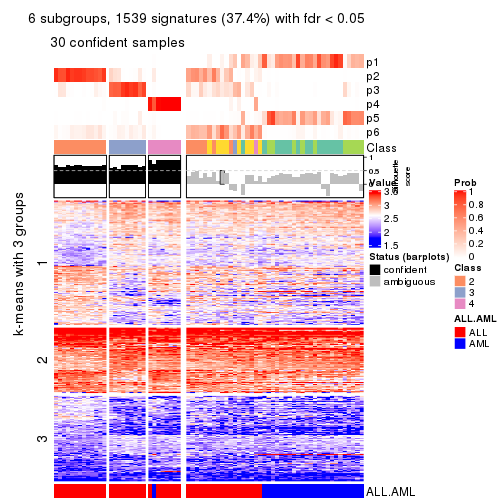
Compare the overlap of signatures from different k:
compare_signatures(res)
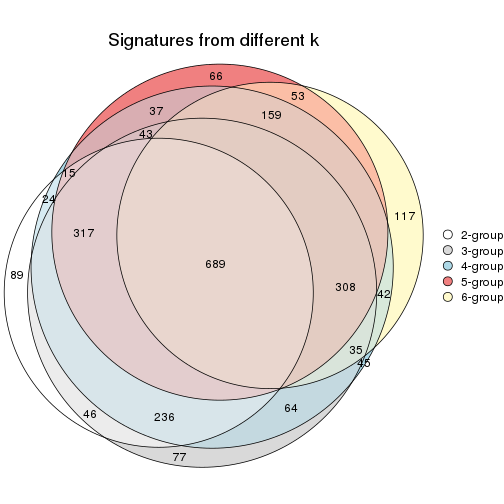
get_signature() returns a data frame invisibly. TO get the list of signatures, the function
call should be assigned to a variable explicitly. In following code, if plot argument is set
to FALSE, no heatmap is plotted while only the differential analysis is performed.
# code only for demonstration
tb = get_signature(res, k = ..., plot = FALSE)
An example of the output of tb is:
#> which_row fdr mean_1 mean_2 scaled_mean_1 scaled_mean_2 km
#> 1 38 0.042760348 8.373488 9.131774 -0.5533452 0.5164555 1
#> 2 40 0.018707592 7.106213 8.469186 -0.6173731 0.5762149 1
#> 3 55 0.019134737 10.221463 11.207825 -0.6159697 0.5749050 1
#> 4 59 0.006059896 5.921854 7.869574 -0.6899429 0.6439467 1
#> 5 60 0.018055526 8.928898 10.211722 -0.6204761 0.5791110 1
#> 6 98 0.009384629 15.714769 14.887706 0.6635654 -0.6193277 2
...
The columns in tb are:
which_row: row indices corresponding to the input matrix.fdr: FDR for the differential test. mean_x: The mean value in group x.scaled_mean_x: The mean value in group x after rows are scaled.km: Row groups if k-means clustering is applied to rows.UMAP plot which shows how samples are separated.
dimension_reduction(res, k = 2, method = "UMAP")
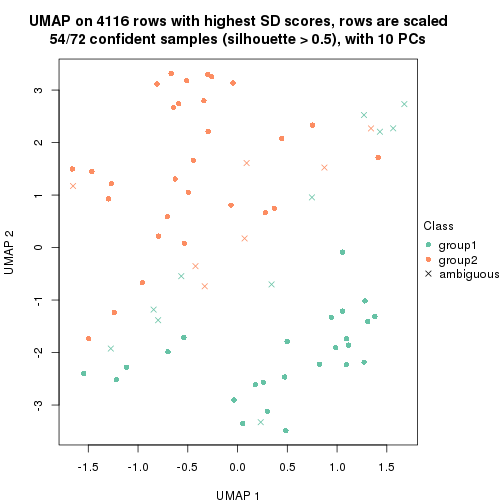
dimension_reduction(res, k = 3, method = "UMAP")
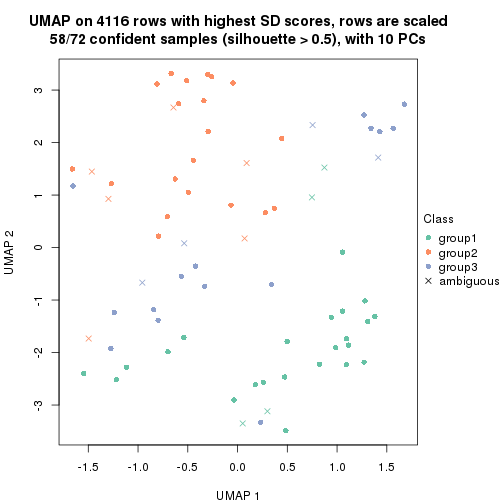
dimension_reduction(res, k = 4, method = "UMAP")
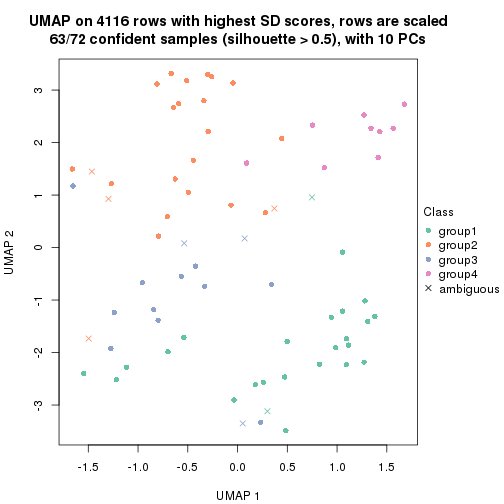
dimension_reduction(res, k = 5, method = "UMAP")
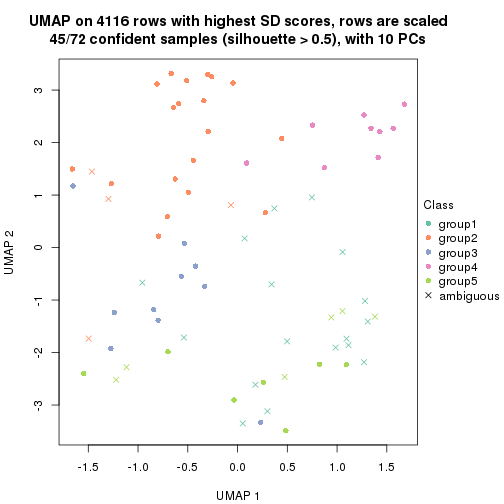
dimension_reduction(res, k = 6, method = "UMAP")
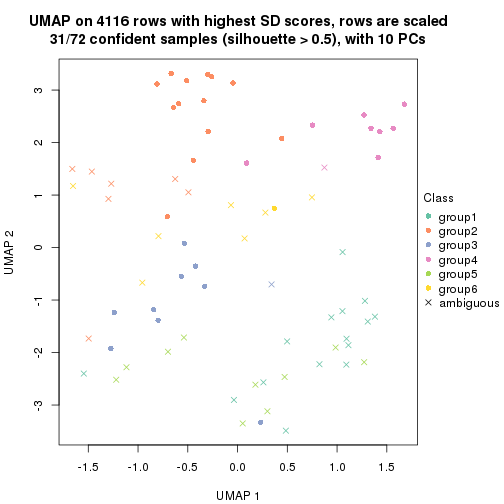
Following heatmap shows how subgroups are split when increasing k:
collect_classes(res)
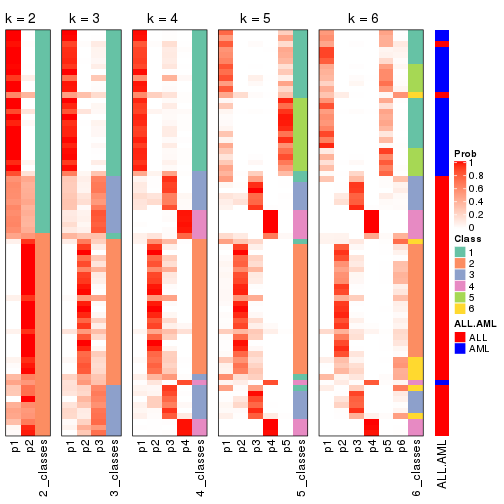
Test correlation between subgroups and known annotations. If the known annotation is numeric, one-way ANOVA test is applied, and if the known annotation is discrete, chi-squared contingency table test is applied.
test_to_known_factors(res)
#> n ALL.AML(p) k
#> SD:pam 54 1.01e-11 2
#> SD:pam 58 1.94e-12 3
#> SD:pam 63 6.74e-12 4
#> SD:pam 45 1.81e-08 5
#> SD:pam 31 3.96e-01 6
If matrix rows can be associated to genes, consider to use functional_enrichment(res,
...) to perform function enrichment for the signature genes. See this vignette for more detailed explanations.
The object with results only for a single top-value method and a single partition method can be extracted as:
res = res_list["SD", "mclust"]
# you can also extract it by
# res = res_list["SD:mclust"]
A summary of res and all the functions that can be applied to it:
res
#> A 'ConsensusPartition' object with k = 2, 3, 4, 5, 6.
#> On a matrix with 4116 rows and 72 columns.
#> Top rows (412, 824, 1235, 1646, 2058) are extracted by 'SD' method.
#> Subgroups are detected by 'mclust' method.
#> Performed in total 1250 partitions by row resampling.
#> Best k for subgroups seems to be 5.
#>
#> Following methods can be applied to this 'ConsensusPartition' object:
#> [1] "cola_report" "collect_classes" "collect_plots"
#> [4] "collect_stats" "colnames" "compare_signatures"
#> [7] "consensus_heatmap" "dimension_reduction" "functional_enrichment"
#> [10] "get_anno_col" "get_anno" "get_classes"
#> [13] "get_consensus" "get_matrix" "get_membership"
#> [16] "get_param" "get_signatures" "get_stats"
#> [19] "is_best_k" "is_stable_k" "membership_heatmap"
#> [22] "ncol" "nrow" "plot_ecdf"
#> [25] "rownames" "select_partition_number" "show"
#> [28] "suggest_best_k" "test_to_known_factors"
collect_plots() function collects all the plots made from res for all k (number of partitions)
into one single page to provide an easy and fast comparison between different k.
collect_plots(res)
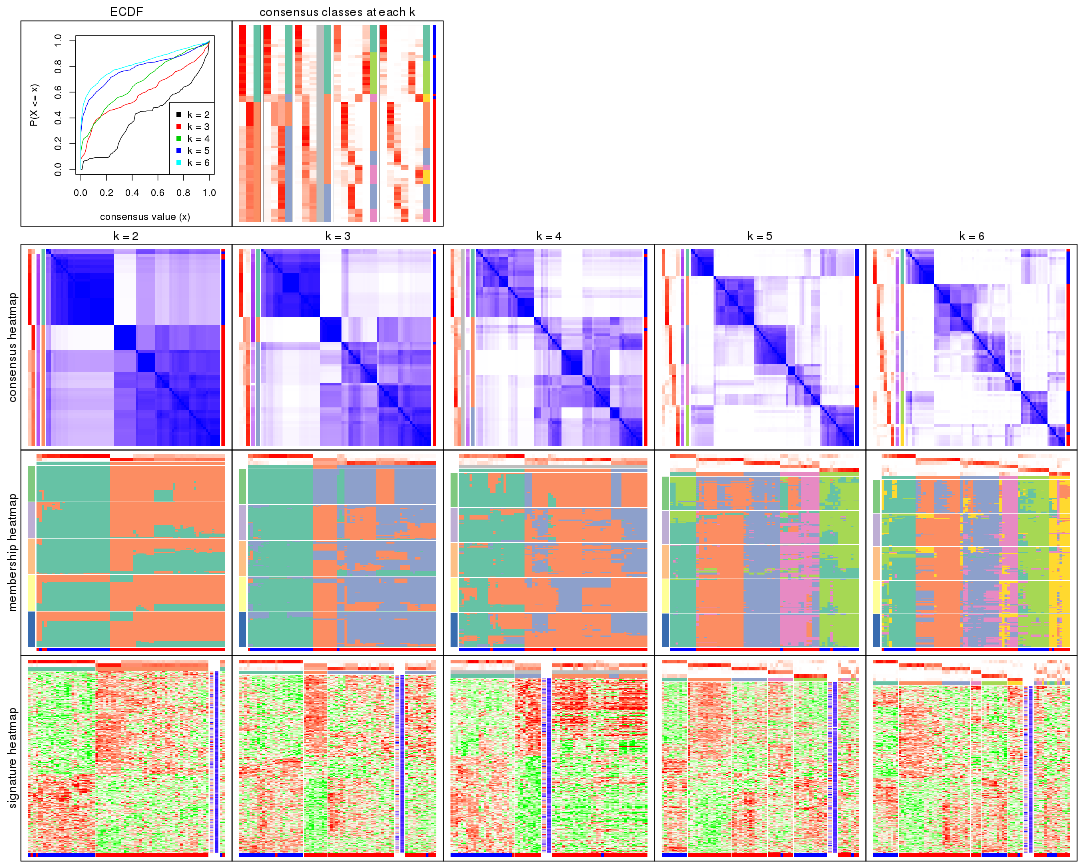
The plots are:
k and the heatmap of
predicted classes for each k.k.k.k.All the plots in panels can be made by individual functions and they are plotted later in this section.
select_partition_number() produces several plots showing different
statistics for choosing “optimized” k. There are following statistics:
k;k, the area increased is defined as \(A_k - A_{k-1}\).The detailed explanations of these statistics can be found in the cola vignette.
Generally speaking, lower PAC score, higher mean silhouette score or higher
concordance corresponds to better partition. Rand index and Jaccard index
measure how similar the current partition is compared to partition with k-1.
If they are too similar, we won't accept k is better than k-1.
select_partition_number(res)
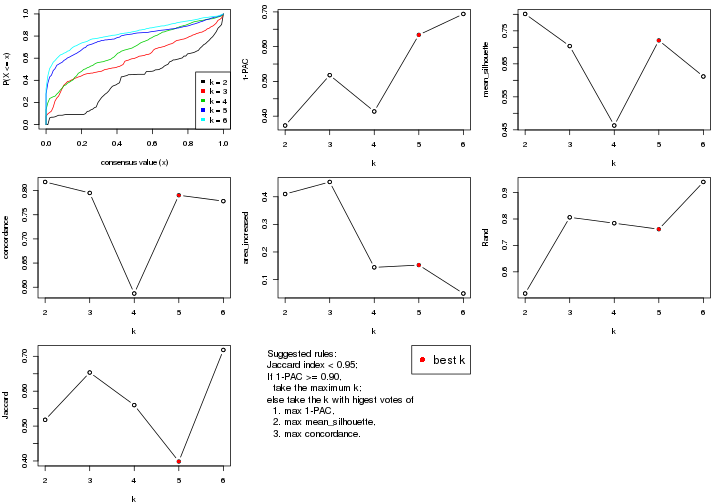
The numeric values for all these statistics can be obtained by get_stats().
get_stats(res)
#> k 1-PAC mean_silhouette concordance area_increased Rand Jaccard
#> 2 2 0.373 0.801 0.818 0.4100 0.518 0.518
#> 3 3 0.518 0.704 0.795 0.4537 0.806 0.654
#> 4 4 0.414 0.463 0.587 0.1442 0.784 0.560
#> 5 5 0.634 0.721 0.790 0.1525 0.761 0.398
#> 6 6 0.694 0.612 0.778 0.0494 0.940 0.718
suggest_best_k() suggests the best \(k\) based on these statistics. The rules are as follows:
suggest_best_k(res)
#> [1] 5
Following shows the table of the partitions (You need to click the show/hide
code output link to see it). The membership matrix (columns with name p*)
is inferred by
clue::cl_consensus()
function with the SE method. Basically the value in the membership matrix
represents the probability to belong to a certain group. The finall class
label for an item is determined with the group with highest probability it
belongs to.
In get_classes() function, the entropy is calculated from the membership
matrix and the silhouette score is calculated from the consensus matrix.
cbind(get_classes(res, k = 2), get_membership(res, k = 2))
#> class entropy silhouette p1 p2
#> sample_39 2 0.8813 8.30e-01 0.300 0.700
#> sample_40 2 0.8661 8.32e-01 0.288 0.712
#> sample_42 2 0.9393 8.03e-01 0.356 0.644
#> sample_47 2 0.7602 8.09e-01 0.220 0.780
#> sample_48 2 0.1184 6.70e-01 0.016 0.984
#> sample_49 2 0.8661 8.32e-01 0.288 0.712
#> sample_41 2 0.1184 6.70e-01 0.016 0.984
#> sample_43 2 0.8443 8.30e-01 0.272 0.728
#> sample_44 2 0.8144 8.24e-01 0.252 0.748
#> sample_45 2 0.7602 8.09e-01 0.220 0.780
#> sample_46 2 0.7745 8.14e-01 0.228 0.772
#> sample_70 2 0.8909 8.30e-01 0.308 0.692
#> sample_71 2 0.9393 8.02e-01 0.356 0.644
#> sample_72 2 0.9286 8.11e-01 0.344 0.656
#> sample_68 2 0.1184 6.70e-01 0.016 0.984
#> sample_69 2 0.1184 6.70e-01 0.016 0.984
#> sample_67 1 0.4298 8.40e-01 0.912 0.088
#> sample_55 2 0.9248 8.09e-01 0.340 0.660
#> sample_56 2 0.8661 8.32e-01 0.288 0.712
#> sample_59 2 0.8955 8.29e-01 0.312 0.688
#> sample_52 1 0.0376 9.35e-01 0.996 0.004
#> sample_53 1 0.0000 9.35e-01 1.000 0.000
#> sample_51 1 0.0000 9.35e-01 1.000 0.000
#> sample_50 1 0.0000 9.35e-01 1.000 0.000
#> sample_54 1 0.2948 8.97e-01 0.948 0.052
#> sample_57 1 0.0376 9.35e-01 0.996 0.004
#> sample_58 1 0.0672 9.34e-01 0.992 0.008
#> sample_60 1 0.2778 9.02e-01 0.952 0.048
#> sample_61 1 0.0672 9.34e-01 0.992 0.008
#> sample_65 1 0.0376 9.35e-01 0.996 0.004
#> sample_66 1 0.9661 -1.94e-01 0.608 0.392
#> sample_63 1 0.0376 9.35e-01 0.996 0.004
#> sample_64 1 0.2043 9.17e-01 0.968 0.032
#> sample_62 1 0.0376 9.35e-01 0.996 0.004
#> sample_1 2 0.8813 8.31e-01 0.300 0.700
#> sample_2 1 0.9393 9.53e-05 0.644 0.356
#> sample_3 2 0.9815 7.07e-01 0.420 0.580
#> sample_4 2 0.8763 8.32e-01 0.296 0.704
#> sample_5 2 0.1184 6.70e-01 0.016 0.984
#> sample_6 2 0.9815 7.07e-01 0.420 0.580
#> sample_7 2 0.8713 8.32e-01 0.292 0.708
#> sample_8 2 0.9000 8.22e-01 0.316 0.684
#> sample_9 2 0.9815 7.07e-01 0.420 0.580
#> sample_10 2 0.9815 7.07e-01 0.420 0.580
#> sample_11 2 0.9815 7.07e-01 0.420 0.580
#> sample_12 1 0.3879 8.60e-01 0.924 0.076
#> sample_13 2 0.1184 6.70e-01 0.016 0.984
#> sample_14 2 0.9815 7.07e-01 0.420 0.580
#> sample_15 2 0.1184 6.70e-01 0.016 0.984
#> sample_16 2 0.8386 8.29e-01 0.268 0.732
#> sample_17 2 0.9732 7.45e-01 0.404 0.596
#> sample_18 2 0.9129 8.22e-01 0.328 0.672
#> sample_19 2 0.8016 8.21e-01 0.244 0.756
#> sample_20 2 0.1184 6.70e-01 0.016 0.984
#> sample_21 2 0.7745 8.04e-01 0.228 0.772
#> sample_22 2 0.9460 7.94e-01 0.364 0.636
#> sample_23 2 0.9815 7.07e-01 0.420 0.580
#> sample_24 2 0.1184 6.70e-01 0.016 0.984
#> sample_25 2 0.9393 8.03e-01 0.356 0.644
#> sample_26 2 0.8608 8.32e-01 0.284 0.716
#> sample_27 2 0.8661 8.32e-01 0.288 0.712
#> sample_34 1 0.0000 9.35e-01 1.000 0.000
#> sample_35 1 0.2423 9.10e-01 0.960 0.040
#> sample_36 1 0.0000 9.35e-01 1.000 0.000
#> sample_37 1 0.0000 9.35e-01 1.000 0.000
#> sample_38 1 0.0376 9.34e-01 0.996 0.004
#> sample_28 1 0.0000 9.35e-01 1.000 0.000
#> sample_29 1 0.2423 9.08e-01 0.960 0.040
#> sample_30 1 0.0000 9.35e-01 1.000 0.000
#> sample_31 1 0.0000 9.35e-01 1.000 0.000
#> sample_32 1 0.0376 9.35e-01 0.996 0.004
#> sample_33 1 0.0000 9.35e-01 1.000 0.000
cbind(get_classes(res, k = 3), get_membership(res, k = 3))
#> class entropy silhouette p1 p2 p3
#> sample_39 3 0.2926 0.636 0.040 0.036 0.924
#> sample_40 3 0.1647 0.629 0.036 0.004 0.960
#> sample_42 3 0.6699 0.597 0.044 0.256 0.700
#> sample_47 3 0.4047 0.460 0.004 0.148 0.848
#> sample_48 2 0.6244 0.993 0.000 0.560 0.440
#> sample_49 3 0.1647 0.629 0.036 0.004 0.960
#> sample_41 2 0.6252 0.989 0.000 0.556 0.444
#> sample_43 3 0.3500 0.506 0.004 0.116 0.880
#> sample_44 3 0.4235 0.383 0.000 0.176 0.824
#> sample_45 3 0.3816 0.453 0.000 0.148 0.852
#> sample_46 3 0.3941 0.436 0.000 0.156 0.844
#> sample_70 3 0.1267 0.620 0.024 0.004 0.972
#> sample_71 3 0.6735 0.596 0.044 0.260 0.696
#> sample_72 3 0.6805 0.592 0.044 0.268 0.688
#> sample_68 2 0.6244 0.993 0.000 0.560 0.440
#> sample_69 2 0.6252 0.989 0.000 0.556 0.444
#> sample_67 3 0.9873 0.301 0.328 0.268 0.404
#> sample_55 3 0.1529 0.631 0.040 0.000 0.960
#> sample_56 3 0.2063 0.629 0.044 0.008 0.948
#> sample_59 3 0.2031 0.599 0.016 0.032 0.952
#> sample_52 1 0.1529 0.936 0.960 0.000 0.040
#> sample_53 1 0.0237 0.921 0.996 0.004 0.000
#> sample_51 1 0.0237 0.921 0.996 0.004 0.000
#> sample_50 1 0.0237 0.921 0.996 0.004 0.000
#> sample_54 1 0.4235 0.818 0.824 0.000 0.176
#> sample_57 1 0.2165 0.928 0.936 0.000 0.064
#> sample_58 1 0.1753 0.934 0.952 0.000 0.048
#> sample_60 1 0.3941 0.845 0.844 0.000 0.156
#> sample_61 1 0.2496 0.925 0.928 0.004 0.068
#> sample_65 1 0.1529 0.936 0.960 0.000 0.040
#> sample_66 3 0.9489 0.454 0.228 0.280 0.492
#> sample_63 1 0.1643 0.935 0.956 0.000 0.044
#> sample_64 1 0.2959 0.903 0.900 0.000 0.100
#> sample_62 1 0.1753 0.934 0.952 0.000 0.048
#> sample_1 3 0.3091 0.554 0.016 0.072 0.912
#> sample_2 3 0.9793 0.398 0.280 0.284 0.436
#> sample_3 3 0.7610 0.502 0.048 0.388 0.564
#> sample_4 3 0.2584 0.557 0.008 0.064 0.928
#> sample_5 2 0.6244 0.993 0.000 0.560 0.440
#> sample_6 3 0.7597 0.503 0.048 0.384 0.568
#> sample_7 3 0.1411 0.629 0.036 0.000 0.964
#> sample_8 3 0.3947 0.636 0.040 0.076 0.884
#> sample_9 3 0.7648 0.509 0.048 0.400 0.552
#> sample_10 3 0.7685 0.507 0.052 0.384 0.564
#> sample_11 3 0.7758 0.482 0.048 0.468 0.484
#> sample_12 1 0.7129 0.701 0.716 0.104 0.180
#> sample_13 2 0.6244 0.993 0.000 0.560 0.440
#> sample_14 3 0.7597 0.517 0.048 0.384 0.568
#> sample_15 2 0.6244 0.993 0.000 0.560 0.440
#> sample_16 3 0.4235 0.383 0.000 0.176 0.824
#> sample_17 3 0.3967 0.610 0.044 0.072 0.884
#> sample_18 3 0.1411 0.629 0.036 0.000 0.964
#> sample_19 3 0.3941 0.436 0.000 0.156 0.844
#> sample_20 2 0.6244 0.993 0.000 0.560 0.440
#> sample_21 3 0.7570 -0.538 0.044 0.404 0.552
#> sample_22 3 0.6203 0.609 0.056 0.184 0.760
#> sample_23 3 0.7610 0.502 0.048 0.388 0.564
#> sample_24 2 0.6274 0.966 0.000 0.544 0.456
#> sample_25 3 0.6159 0.612 0.048 0.196 0.756
#> sample_26 3 0.3340 0.489 0.000 0.120 0.880
#> sample_27 3 0.1832 0.630 0.036 0.008 0.956
#> sample_34 1 0.1411 0.935 0.964 0.000 0.036
#> sample_35 1 0.4280 0.873 0.856 0.020 0.124
#> sample_36 1 0.0237 0.921 0.996 0.004 0.000
#> sample_37 1 0.0237 0.921 0.996 0.004 0.000
#> sample_38 1 0.2682 0.924 0.920 0.004 0.076
#> sample_28 1 0.1647 0.934 0.960 0.004 0.036
#> sample_29 1 0.7485 0.689 0.680 0.224 0.096
#> sample_30 1 0.0237 0.921 0.996 0.004 0.000
#> sample_31 1 0.1529 0.936 0.960 0.000 0.040
#> sample_32 1 0.1765 0.936 0.956 0.004 0.040
#> sample_33 1 0.0237 0.921 0.996 0.004 0.000
cbind(get_classes(res, k = 4), get_membership(res, k = 4))
#> class entropy silhouette p1 p2 p3 p4
#> sample_39 3 0.5702 0.65942 0.008 0.404 0.572 NA
#> sample_40 3 0.5231 0.70139 0.012 0.384 0.604 NA
#> sample_42 2 0.5770 0.30628 0.032 0.752 0.084 NA
#> sample_47 2 0.0895 0.43567 0.000 0.976 0.020 NA
#> sample_48 2 0.4661 0.45757 0.000 0.652 0.000 NA
#> sample_49 3 0.5174 0.70389 0.012 0.368 0.620 NA
#> sample_41 2 0.5898 0.44425 0.000 0.604 0.048 NA
#> sample_43 2 0.1489 0.41626 0.000 0.952 0.044 NA
#> sample_44 2 0.1109 0.43126 0.000 0.968 0.028 NA
#> sample_45 2 0.0657 0.44043 0.000 0.984 0.012 NA
#> sample_46 2 0.0376 0.44388 0.000 0.992 0.004 NA
#> sample_70 2 0.5590 -0.61110 0.008 0.504 0.480 NA
#> sample_71 2 0.5978 0.29108 0.028 0.732 0.088 NA
#> sample_72 2 0.5932 0.29198 0.028 0.736 0.088 NA
#> sample_68 2 0.4661 0.45757 0.000 0.652 0.000 NA
#> sample_69 2 0.4661 0.45757 0.000 0.652 0.000 NA
#> sample_67 2 0.8811 0.00896 0.328 0.384 0.048 NA
#> sample_55 3 0.5878 0.70122 0.012 0.360 0.604 NA
#> sample_56 3 0.5204 0.70399 0.012 0.376 0.612 NA
#> sample_59 2 0.5172 -0.47194 0.008 0.588 0.404 NA
#> sample_52 1 0.6958 0.75500 0.584 0.000 0.184 NA
#> sample_53 1 0.0336 0.77997 0.992 0.000 0.000 NA
#> sample_51 1 0.0336 0.77997 0.992 0.000 0.000 NA
#> sample_50 1 0.0000 0.78224 1.000 0.000 0.000 NA
#> sample_54 1 0.8654 0.70145 0.516 0.128 0.120 NA
#> sample_57 1 0.7313 0.75737 0.580 0.012 0.176 NA
#> sample_58 1 0.7359 0.77700 0.620 0.068 0.080 NA
#> sample_60 1 0.8342 0.73120 0.520 0.056 0.188 NA
#> sample_61 1 0.7153 0.72952 0.652 0.132 0.048 NA
#> sample_65 1 0.5995 0.80041 0.732 0.060 0.044 NA
#> sample_66 2 0.8426 0.17734 0.128 0.532 0.096 NA
#> sample_63 1 0.6991 0.75342 0.580 0.000 0.188 NA
#> sample_64 1 0.7903 0.75964 0.552 0.084 0.080 NA
#> sample_62 1 0.6991 0.75342 0.580 0.000 0.188 NA
#> sample_1 2 0.5277 -0.55378 0.008 0.532 0.460 NA
#> sample_2 2 0.8645 0.12925 0.188 0.492 0.072 NA
#> sample_3 3 0.7733 0.47346 0.008 0.236 0.504 NA
#> sample_4 2 0.5438 -0.53558 0.008 0.536 0.452 NA
#> sample_5 2 0.5203 0.45487 0.000 0.636 0.016 NA
#> sample_6 3 0.7733 0.47346 0.008 0.236 0.504 NA
#> sample_7 3 0.5391 0.70300 0.012 0.380 0.604 NA
#> sample_8 3 0.5725 0.70284 0.012 0.372 0.600 NA
#> sample_9 2 0.8084 -0.19417 0.008 0.404 0.328 NA
#> sample_10 3 0.7796 0.46808 0.008 0.248 0.492 NA
#> sample_11 2 0.7952 -0.05542 0.008 0.456 0.272 NA
#> sample_12 1 0.8237 0.55718 0.572 0.176 0.100 NA
#> sample_13 2 0.4661 0.45757 0.000 0.652 0.000 NA
#> sample_14 2 0.7796 0.00883 0.008 0.492 0.248 NA
#> sample_15 2 0.5403 0.45290 0.000 0.628 0.024 NA
#> sample_16 2 0.2522 0.40927 0.000 0.908 0.076 NA
#> sample_17 2 0.6538 0.24940 0.016 0.672 0.188 NA
#> sample_18 3 0.5290 0.60232 0.008 0.476 0.516 NA
#> sample_19 2 0.0376 0.44325 0.000 0.992 0.004 NA
#> sample_20 2 0.4661 0.45757 0.000 0.652 0.000 NA
#> sample_21 2 0.6366 0.43376 0.024 0.688 0.088 NA
#> sample_22 3 0.7301 0.61142 0.024 0.396 0.496 NA
#> sample_23 3 0.7733 0.47346 0.008 0.236 0.504 NA
#> sample_24 2 0.6039 0.44139 0.000 0.596 0.056 NA
#> sample_25 2 0.7850 -0.48078 0.040 0.484 0.368 NA
#> sample_26 2 0.4164 -0.09981 0.000 0.736 0.264 NA
#> sample_27 3 0.5174 0.70389 0.012 0.368 0.620 NA
#> sample_34 1 0.5596 0.80304 0.756 0.048 0.040 NA
#> sample_35 1 0.8640 0.61089 0.532 0.140 0.132 NA
#> sample_36 1 0.0000 0.78224 1.000 0.000 0.000 NA
#> sample_37 1 0.0336 0.77997 0.992 0.000 0.000 NA
#> sample_38 1 0.6177 0.69982 0.704 0.108 0.016 NA
#> sample_28 1 0.4341 0.73992 0.824 0.052 0.008 NA
#> sample_29 1 0.4901 0.70560 0.792 0.144 0.020 NA
#> sample_30 1 0.0000 0.78224 1.000 0.000 0.000 NA
#> sample_31 1 0.6985 0.78186 0.644 0.080 0.048 NA
#> sample_32 1 0.4549 0.77494 0.816 0.100 0.008 NA
#> sample_33 1 0.0000 0.78224 1.000 0.000 0.000 NA
cbind(get_classes(res, k = 5), get_membership(res, k = 5))
#> class entropy silhouette p1 p2 p3 p4 p5
#> sample_39 3 0.3809 0.763 0.020 0.160 0.804 0.016 0.000
#> sample_40 3 0.1124 0.879 0.004 0.036 0.960 0.000 0.000
#> sample_42 4 0.6693 0.577 0.108 0.212 0.060 0.612 0.008
#> sample_47 2 0.2829 0.855 0.052 0.892 0.032 0.024 0.000
#> sample_48 2 0.0162 0.870 0.004 0.996 0.000 0.000 0.000
#> sample_49 3 0.1525 0.877 0.012 0.036 0.948 0.004 0.000
#> sample_41 2 0.2629 0.820 0.004 0.860 0.136 0.000 0.000
#> sample_43 2 0.3880 0.813 0.052 0.828 0.096 0.024 0.000
#> sample_44 2 0.3423 0.855 0.044 0.856 0.080 0.020 0.000
#> sample_45 2 0.2829 0.852 0.052 0.892 0.032 0.024 0.000
#> sample_46 2 0.2657 0.855 0.052 0.900 0.024 0.024 0.000
#> sample_70 3 0.3496 0.825 0.040 0.124 0.832 0.004 0.000
#> sample_71 4 0.6816 0.588 0.112 0.192 0.076 0.612 0.008
#> sample_72 4 0.6615 0.570 0.092 0.220 0.072 0.612 0.004
#> sample_68 2 0.0671 0.869 0.004 0.980 0.016 0.000 0.000
#> sample_69 2 0.0451 0.868 0.004 0.988 0.008 0.000 0.000
#> sample_67 4 0.5559 0.499 0.324 0.000 0.024 0.608 0.044
#> sample_55 3 0.2053 0.872 0.016 0.040 0.928 0.016 0.000
#> sample_56 3 0.1444 0.878 0.012 0.040 0.948 0.000 0.000
#> sample_59 3 0.4347 0.729 0.040 0.212 0.744 0.004 0.000
#> sample_52 5 0.0880 0.776 0.032 0.000 0.000 0.000 0.968
#> sample_53 1 0.3689 0.909 0.740 0.000 0.000 0.004 0.256
#> sample_51 1 0.3561 0.912 0.740 0.000 0.000 0.000 0.260
#> sample_50 1 0.3636 0.916 0.728 0.000 0.000 0.000 0.272
#> sample_54 5 0.1815 0.746 0.020 0.000 0.024 0.016 0.940
#> sample_57 5 0.0000 0.772 0.000 0.000 0.000 0.000 1.000
#> sample_58 5 0.1043 0.778 0.040 0.000 0.000 0.000 0.960
#> sample_60 5 0.1372 0.754 0.004 0.000 0.024 0.016 0.956
#> sample_61 5 0.4360 0.626 0.284 0.000 0.024 0.000 0.692
#> sample_65 5 0.3424 0.634 0.240 0.000 0.000 0.000 0.760
#> sample_66 4 0.6409 0.571 0.272 0.044 0.036 0.612 0.036
#> sample_63 5 0.0880 0.779 0.032 0.000 0.000 0.000 0.968
#> sample_64 5 0.1952 0.752 0.084 0.000 0.004 0.000 0.912
#> sample_62 5 0.0404 0.776 0.012 0.000 0.000 0.000 0.988
#> sample_1 3 0.2568 0.867 0.016 0.092 0.888 0.004 0.000
#> sample_2 4 0.5570 0.535 0.304 0.004 0.032 0.628 0.032
#> sample_3 4 0.4390 0.193 0.000 0.000 0.428 0.568 0.004
#> sample_4 3 0.2605 0.869 0.016 0.060 0.900 0.024 0.000
#> sample_5 2 0.1502 0.863 0.004 0.940 0.056 0.000 0.000
#> sample_6 4 0.4390 0.193 0.000 0.000 0.428 0.568 0.004
#> sample_7 3 0.1549 0.875 0.000 0.040 0.944 0.016 0.000
#> sample_8 3 0.2693 0.846 0.016 0.060 0.896 0.028 0.000
#> sample_9 4 0.4624 0.559 0.004 0.148 0.096 0.752 0.000
#> sample_10 4 0.3437 0.561 0.012 0.000 0.176 0.808 0.004
#> sample_11 4 0.1082 0.618 0.008 0.000 0.028 0.964 0.000
#> sample_12 5 0.7510 0.158 0.348 0.000 0.056 0.188 0.408
#> sample_13 2 0.0162 0.870 0.004 0.996 0.000 0.000 0.000
#> sample_14 4 0.5652 0.504 0.052 0.224 0.052 0.672 0.000
#> sample_15 2 0.1831 0.856 0.004 0.920 0.076 0.000 0.000
#> sample_16 2 0.4156 0.806 0.028 0.784 0.168 0.020 0.000
#> sample_17 2 0.8077 0.276 0.124 0.464 0.200 0.204 0.008
#> sample_18 3 0.2409 0.873 0.028 0.044 0.912 0.016 0.000
#> sample_19 2 0.2745 0.853 0.052 0.896 0.028 0.024 0.000
#> sample_20 2 0.0324 0.870 0.004 0.992 0.004 0.000 0.000
#> sample_21 2 0.3566 0.797 0.004 0.812 0.160 0.024 0.000
#> sample_22 4 0.5858 0.355 0.008 0.048 0.412 0.520 0.012
#> sample_23 4 0.4390 0.193 0.000 0.000 0.428 0.568 0.004
#> sample_24 2 0.2763 0.813 0.004 0.848 0.148 0.000 0.000
#> sample_25 4 0.7247 0.558 0.068 0.196 0.156 0.568 0.012
#> sample_26 3 0.5437 0.531 0.052 0.328 0.608 0.012 0.000
#> sample_27 3 0.1525 0.877 0.012 0.036 0.948 0.004 0.000
#> sample_34 5 0.3561 0.621 0.260 0.000 0.000 0.000 0.740
#> sample_35 5 0.5442 0.605 0.240 0.000 0.116 0.000 0.644
#> sample_36 1 0.3636 0.916 0.728 0.000 0.000 0.000 0.272
#> sample_37 1 0.3636 0.914 0.728 0.000 0.000 0.000 0.272
#> sample_38 1 0.3573 0.755 0.832 0.000 0.012 0.032 0.124
#> sample_28 1 0.3129 0.804 0.832 0.000 0.008 0.004 0.156
#> sample_29 1 0.4554 0.817 0.736 0.000 0.016 0.032 0.216
#> sample_30 1 0.3636 0.916 0.728 0.000 0.000 0.000 0.272
#> sample_31 5 0.2648 0.734 0.152 0.000 0.000 0.000 0.848
#> sample_32 5 0.4436 0.324 0.396 0.000 0.008 0.000 0.596
#> sample_33 1 0.3636 0.916 0.728 0.000 0.000 0.000 0.272
cbind(get_classes(res, k = 6), get_membership(res, k = 6))
#> class entropy silhouette p1 p2 p3 p4 p5 p6
#> sample_39 3 0.6868 0.4117 0.000 0.132 0.480 0.304 0.016 0.068
#> sample_40 3 0.2948 0.6622 0.000 0.000 0.804 0.188 0.008 0.000
#> sample_42 6 0.2020 0.7149 0.000 0.096 0.008 0.000 0.000 0.896
#> sample_47 2 0.4869 0.6952 0.004 0.692 0.224 0.012 0.008 0.060
#> sample_48 2 0.0713 0.7637 0.000 0.972 0.028 0.000 0.000 0.000
#> sample_49 3 0.3767 0.6152 0.000 0.000 0.720 0.260 0.016 0.004
#> sample_41 2 0.2838 0.7080 0.000 0.808 0.188 0.000 0.000 0.004
#> sample_43 2 0.4844 0.6829 0.000 0.688 0.228 0.016 0.008 0.060
#> sample_44 2 0.5205 0.6170 0.000 0.572 0.356 0.012 0.008 0.052
#> sample_45 2 0.4627 0.6890 0.000 0.712 0.208 0.012 0.008 0.060
#> sample_46 2 0.4627 0.6890 0.000 0.712 0.208 0.012 0.008 0.060
#> sample_70 3 0.4699 0.5748 0.004 0.136 0.744 0.048 0.000 0.068
#> sample_71 6 0.1644 0.7200 0.000 0.076 0.004 0.000 0.000 0.920
#> sample_72 6 0.2266 0.7043 0.000 0.108 0.012 0.000 0.000 0.880
#> sample_68 2 0.1471 0.7615 0.000 0.932 0.064 0.000 0.000 0.004
#> sample_69 2 0.0000 0.7554 0.000 1.000 0.000 0.000 0.000 0.000
#> sample_67 6 0.3101 0.6298 0.104 0.000 0.004 0.008 0.036 0.848
#> sample_55 3 0.2400 0.6813 0.000 0.000 0.872 0.116 0.008 0.004
#> sample_56 3 0.3546 0.6586 0.000 0.012 0.776 0.196 0.016 0.000
#> sample_59 3 0.2837 0.6339 0.000 0.056 0.876 0.008 0.008 0.052
#> sample_52 5 0.2320 0.7808 0.132 0.000 0.004 0.000 0.864 0.000
#> sample_53 1 0.0551 0.7968 0.984 0.000 0.004 0.000 0.008 0.004
#> sample_51 1 0.0405 0.7982 0.988 0.000 0.004 0.000 0.008 0.000
#> sample_50 1 0.0260 0.8008 0.992 0.000 0.000 0.000 0.008 0.000
#> sample_54 5 0.2457 0.7378 0.032 0.000 0.036 0.012 0.904 0.016
#> sample_57 5 0.1411 0.7834 0.060 0.000 0.004 0.000 0.936 0.000
#> sample_58 5 0.3587 0.7539 0.188 0.000 0.000 0.040 0.772 0.000
#> sample_60 5 0.1598 0.7684 0.040 0.000 0.008 0.004 0.940 0.008
#> sample_61 5 0.6213 0.2574 0.420 0.000 0.004 0.104 0.432 0.040
#> sample_65 1 0.5209 -0.2712 0.492 0.000 0.000 0.092 0.416 0.000
#> sample_66 6 0.2694 0.6900 0.032 0.016 0.004 0.016 0.036 0.896
#> sample_63 5 0.2491 0.7705 0.164 0.000 0.000 0.000 0.836 0.000
#> sample_64 5 0.2747 0.7854 0.076 0.000 0.008 0.036 0.876 0.004
#> sample_62 5 0.1444 0.7856 0.072 0.000 0.000 0.000 0.928 0.000
#> sample_1 3 0.2252 0.6777 0.000 0.028 0.908 0.044 0.000 0.020
#> sample_2 6 0.2074 0.6883 0.028 0.000 0.004 0.012 0.036 0.920
#> sample_3 4 0.2563 0.7062 0.000 0.000 0.072 0.876 0.000 0.052
#> sample_4 3 0.1490 0.6579 0.000 0.004 0.948 0.024 0.008 0.016
#> sample_5 2 0.2482 0.7364 0.000 0.848 0.148 0.000 0.000 0.004
#> sample_6 4 0.2563 0.7062 0.000 0.000 0.072 0.876 0.000 0.052
#> sample_7 3 0.3078 0.6635 0.000 0.000 0.796 0.192 0.012 0.000
#> sample_8 3 0.6551 0.3161 0.000 0.060 0.460 0.376 0.016 0.088
#> sample_9 4 0.5463 0.4676 0.000 0.016 0.136 0.612 0.000 0.236
#> sample_10 4 0.3614 0.6322 0.000 0.000 0.028 0.752 0.000 0.220
#> sample_11 4 0.3857 0.1791 0.000 0.000 0.000 0.532 0.000 0.468
#> sample_12 1 0.7087 0.1283 0.420 0.000 0.000 0.092 0.220 0.268
#> sample_13 2 0.0363 0.7609 0.000 0.988 0.012 0.000 0.000 0.000
#> sample_14 6 0.7096 -0.0108 0.000 0.112 0.164 0.316 0.000 0.408
#> sample_15 2 0.2482 0.7360 0.000 0.848 0.148 0.000 0.000 0.004
#> sample_16 2 0.5006 0.5298 0.000 0.504 0.448 0.012 0.008 0.028
#> sample_17 3 0.6823 -0.2594 0.000 0.296 0.444 0.036 0.012 0.212
#> sample_18 3 0.1552 0.6706 0.000 0.000 0.940 0.036 0.004 0.020
#> sample_19 2 0.4627 0.6890 0.000 0.712 0.208 0.012 0.008 0.060
#> sample_20 2 0.0146 0.7575 0.000 0.996 0.004 0.000 0.000 0.000
#> sample_21 2 0.4046 0.6981 0.000 0.752 0.176 0.004 0.000 0.068
#> sample_22 4 0.6964 0.2642 0.016 0.060 0.156 0.452 0.000 0.316
#> sample_23 4 0.2563 0.7062 0.000 0.000 0.072 0.876 0.000 0.052
#> sample_24 2 0.3043 0.6983 0.000 0.792 0.200 0.000 0.000 0.008
#> sample_25 6 0.5690 0.4637 0.008 0.088 0.092 0.128 0.004 0.680
#> sample_26 3 0.5318 0.2768 0.000 0.308 0.604 0.020 0.008 0.060
#> sample_27 3 0.3767 0.6152 0.000 0.000 0.720 0.260 0.016 0.004
#> sample_34 5 0.5310 0.4099 0.392 0.000 0.004 0.092 0.512 0.000
#> sample_35 5 0.6689 0.5152 0.248 0.000 0.020 0.208 0.496 0.028
#> sample_36 1 0.0260 0.8008 0.992 0.000 0.000 0.000 0.008 0.000
#> sample_37 1 0.0260 0.8008 0.992 0.000 0.000 0.000 0.008 0.000
#> sample_38 1 0.3234 0.7289 0.836 0.000 0.004 0.028 0.012 0.120
#> sample_28 1 0.2312 0.7502 0.876 0.000 0.000 0.000 0.012 0.112
#> sample_29 1 0.4102 0.5811 0.720 0.000 0.000 0.004 0.044 0.232
#> sample_30 1 0.0260 0.8008 0.992 0.000 0.000 0.000 0.008 0.000
#> sample_31 5 0.4731 0.6690 0.232 0.000 0.004 0.092 0.672 0.000
#> sample_32 1 0.4856 0.4199 0.680 0.000 0.000 0.060 0.232 0.028
#> sample_33 1 0.0363 0.7993 0.988 0.000 0.000 0.000 0.012 0.000
Heatmaps for the consensus matrix. It visualizes the probability of two samples to be in a same group.
consensus_heatmap(res, k = 2)
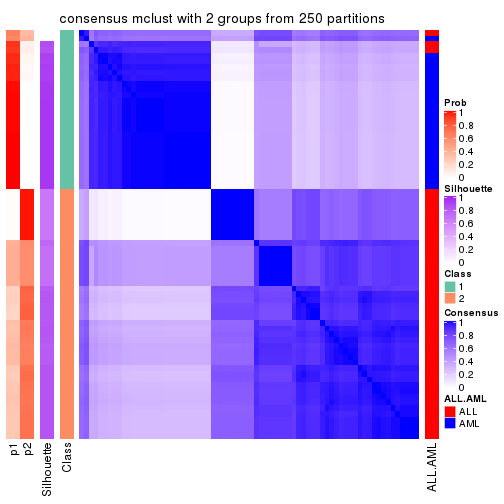
consensus_heatmap(res, k = 3)
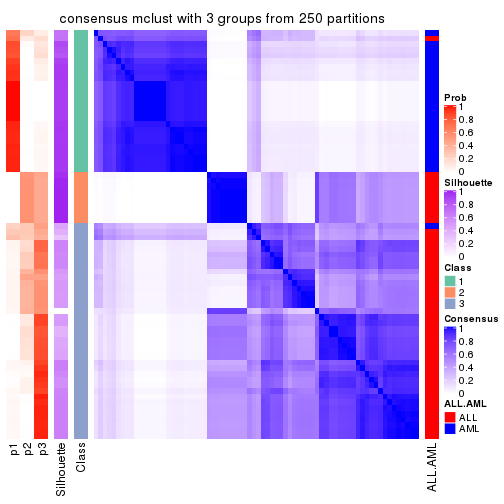
consensus_heatmap(res, k = 4)
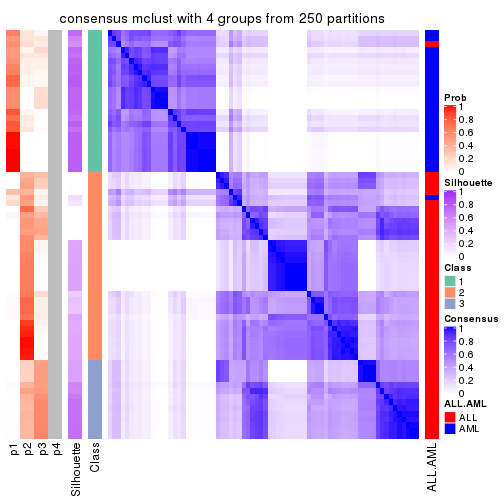
consensus_heatmap(res, k = 5)
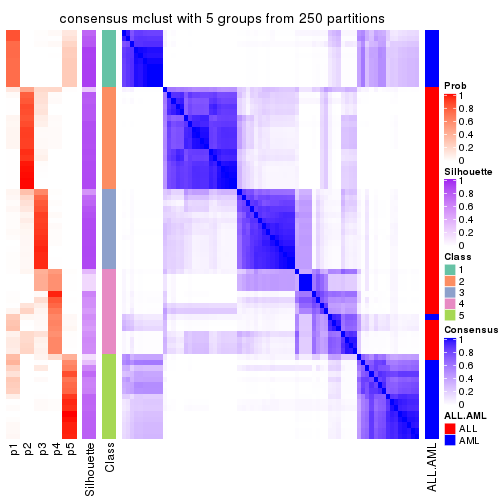
consensus_heatmap(res, k = 6)
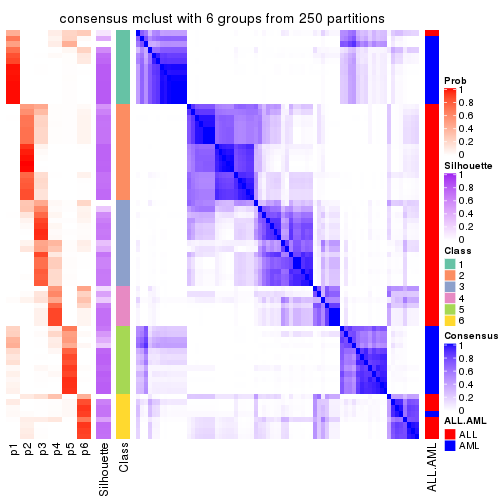
Heatmaps for the membership of samples in all partitions to see how consistent they are:
membership_heatmap(res, k = 2)
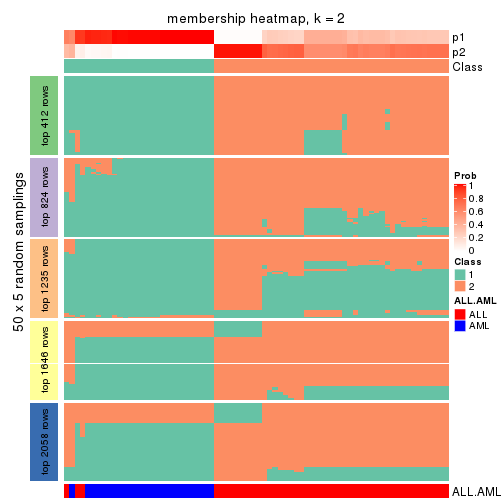
membership_heatmap(res, k = 3)
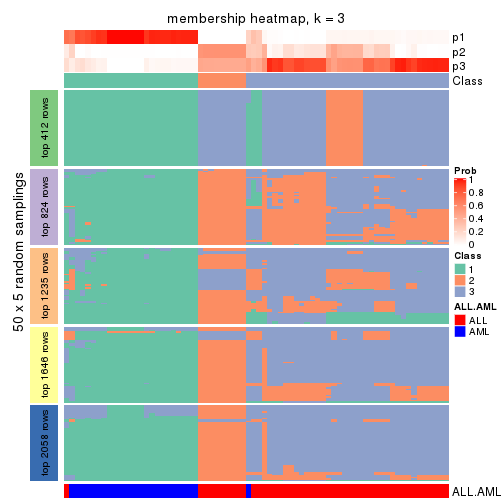
membership_heatmap(res, k = 4)
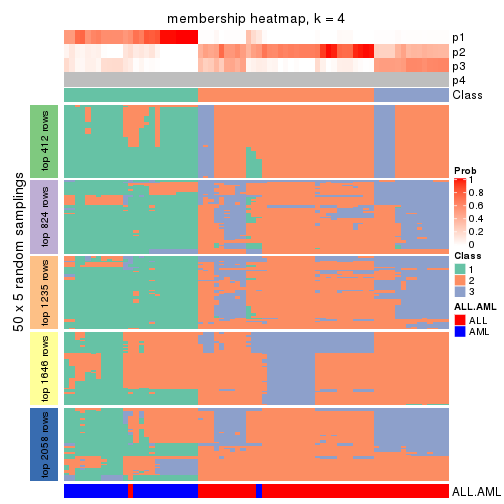
membership_heatmap(res, k = 5)
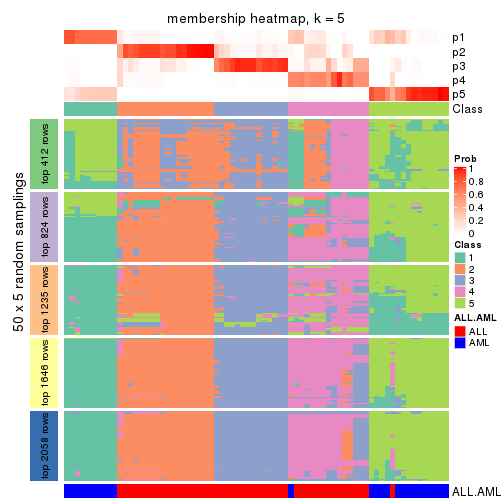
membership_heatmap(res, k = 6)
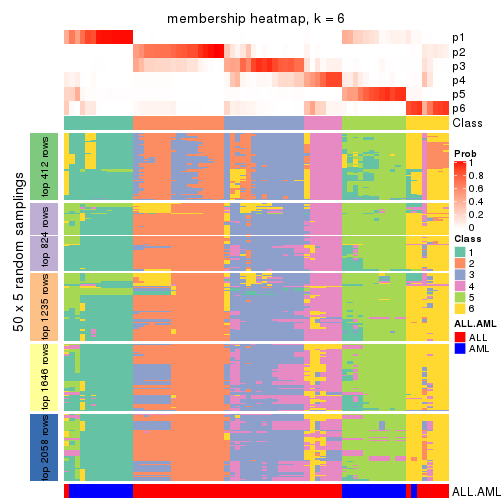
As soon as we have had the classes for columns, we can look for signatures which are significantly different between classes which can be candidate marks for certain classes. Following are the heatmaps for signatures.
Signature heatmaps where rows are scaled:
get_signatures(res, k = 2)
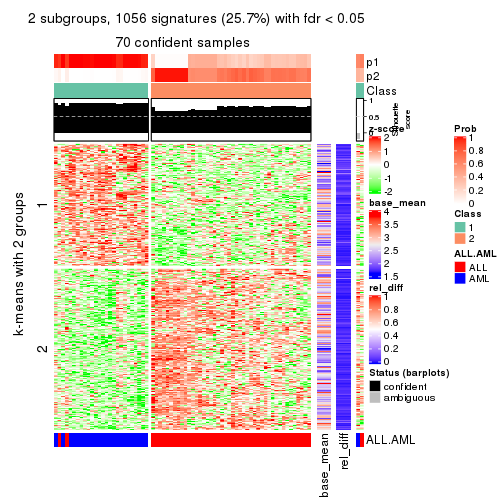
get_signatures(res, k = 3)
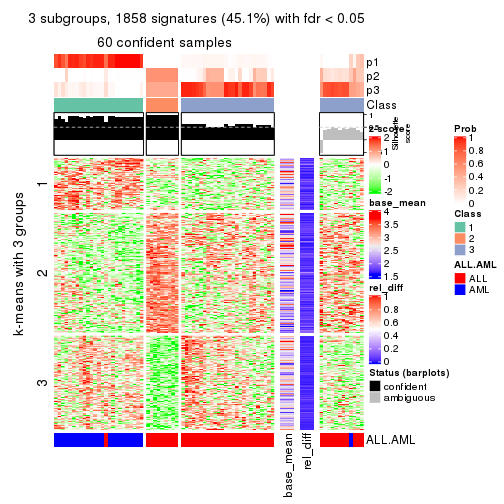
get_signatures(res, k = 4)
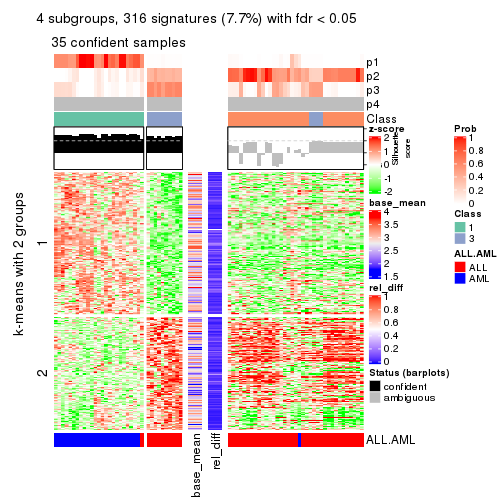
get_signatures(res, k = 5)
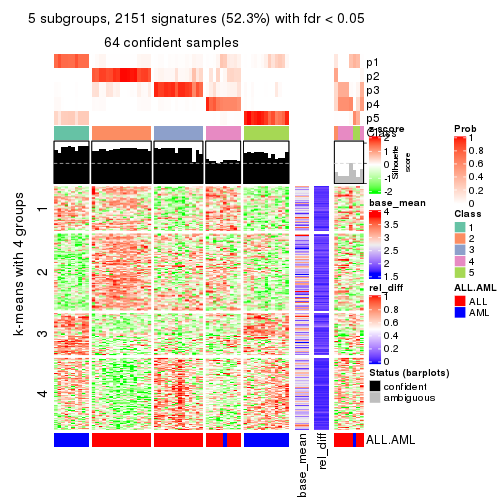
get_signatures(res, k = 6)
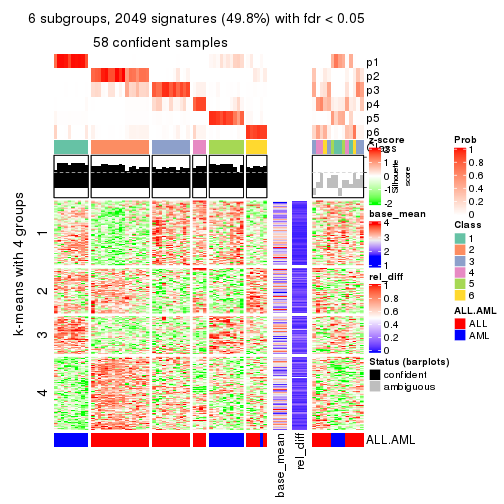
Signature heatmaps where rows are not scaled:
get_signatures(res, k = 2, scale_rows = FALSE)
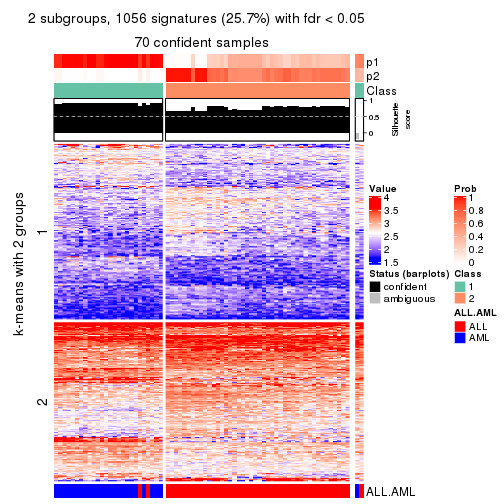
get_signatures(res, k = 3, scale_rows = FALSE)
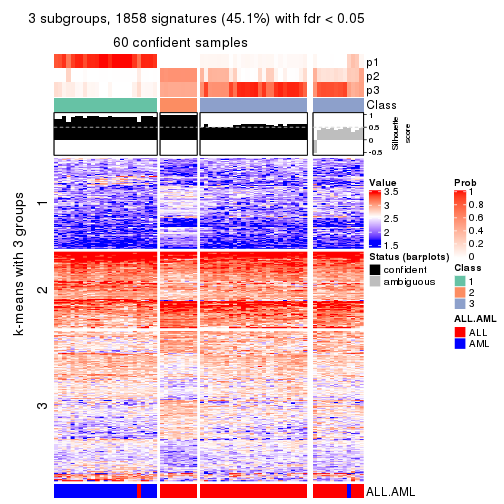
get_signatures(res, k = 4, scale_rows = FALSE)
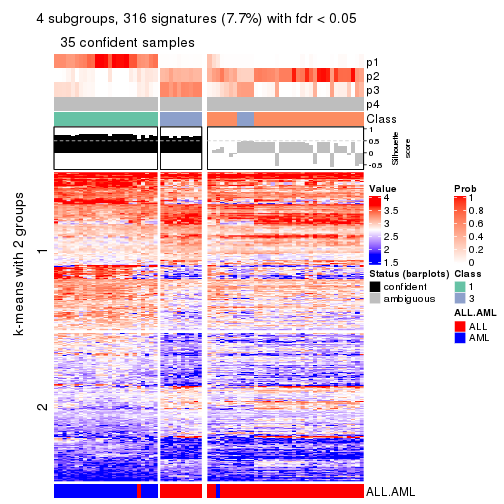
get_signatures(res, k = 5, scale_rows = FALSE)
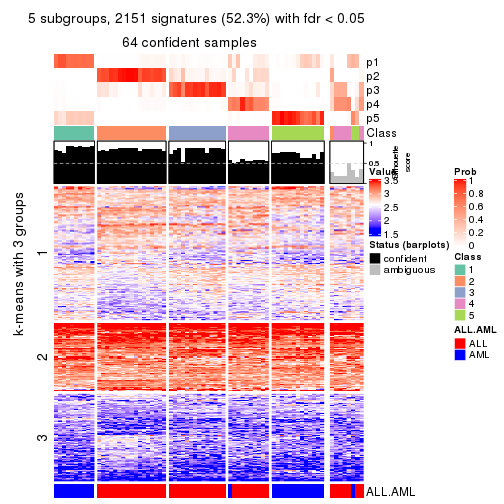
get_signatures(res, k = 6, scale_rows = FALSE)
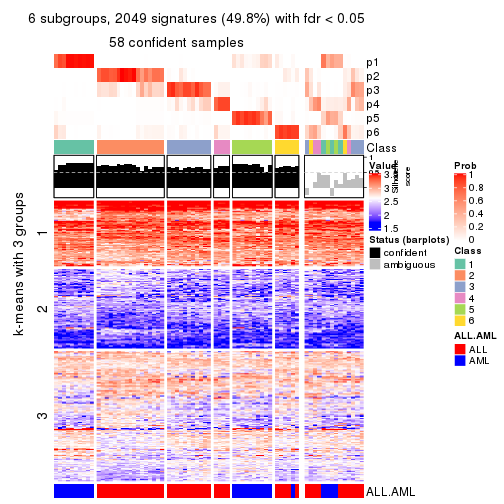
Compare the overlap of signatures from different k:
compare_signatures(res)
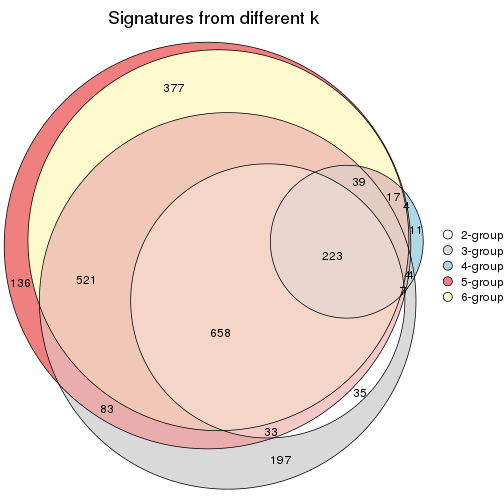
get_signature() returns a data frame invisibly. TO get the list of signatures, the function
call should be assigned to a variable explicitly. In following code, if plot argument is set
to FALSE, no heatmap is plotted while only the differential analysis is performed.
# code only for demonstration
tb = get_signature(res, k = ..., plot = FALSE)
An example of the output of tb is:
#> which_row fdr mean_1 mean_2 scaled_mean_1 scaled_mean_2 km
#> 1 38 0.042760348 8.373488 9.131774 -0.5533452 0.5164555 1
#> 2 40 0.018707592 7.106213 8.469186 -0.6173731 0.5762149 1
#> 3 55 0.019134737 10.221463 11.207825 -0.6159697 0.5749050 1
#> 4 59 0.006059896 5.921854 7.869574 -0.6899429 0.6439467 1
#> 5 60 0.018055526 8.928898 10.211722 -0.6204761 0.5791110 1
#> 6 98 0.009384629 15.714769 14.887706 0.6635654 -0.6193277 2
...
The columns in tb are:
which_row: row indices corresponding to the input matrix.fdr: FDR for the differential test. mean_x: The mean value in group x.scaled_mean_x: The mean value in group x after rows are scaled.km: Row groups if k-means clustering is applied to rows.UMAP plot which shows how samples are separated.
dimension_reduction(res, k = 2, method = "UMAP")
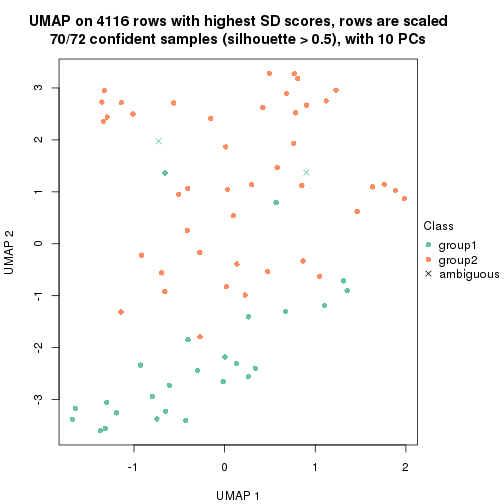
dimension_reduction(res, k = 3, method = "UMAP")
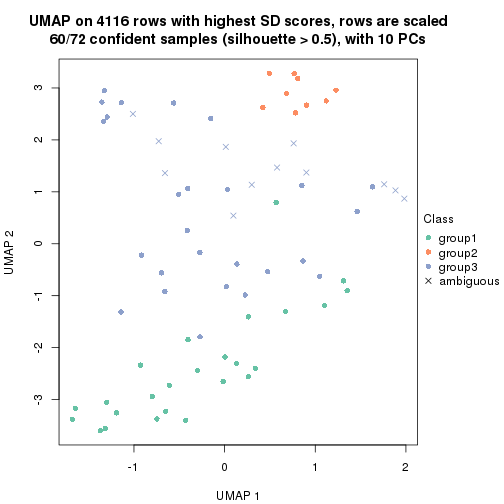
dimension_reduction(res, k = 4, method = "UMAP")
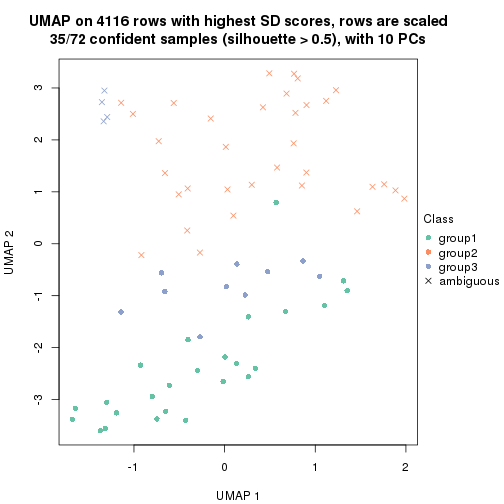
dimension_reduction(res, k = 5, method = "UMAP")
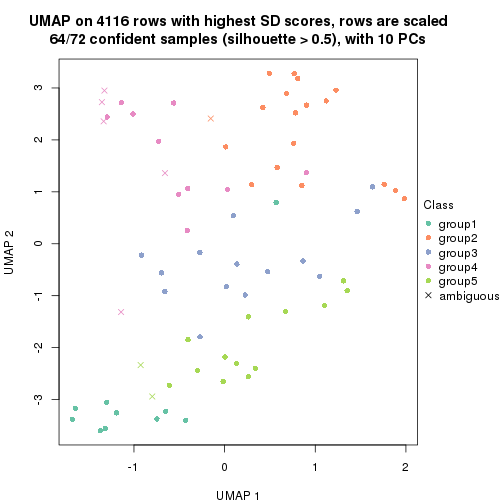
dimension_reduction(res, k = 6, method = "UMAP")
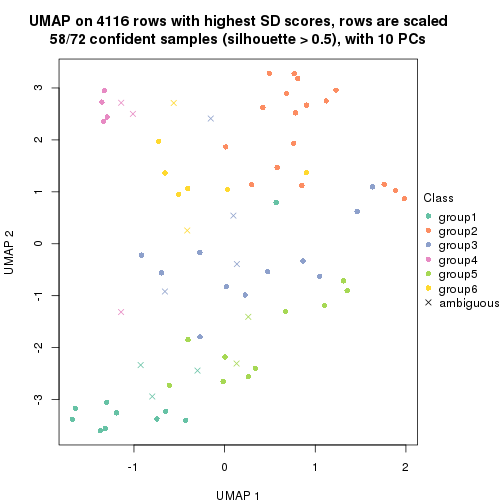
Following heatmap shows how subgroups are split when increasing k:
collect_classes(res)
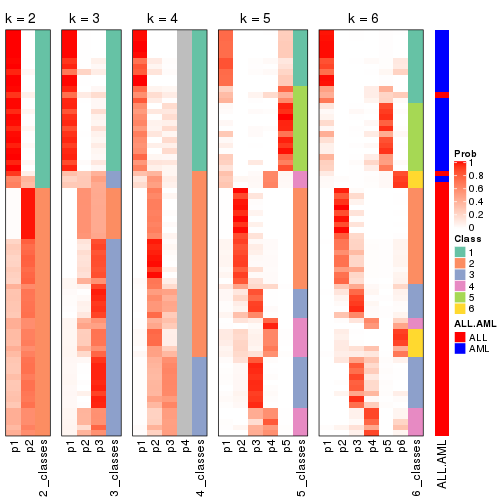
Test correlation between subgroups and known annotations. If the known annotation is numeric, one-way ANOVA test is applied, and if the known annotation is discrete, chi-squared contingency table test is applied.
test_to_known_factors(res)
#> n ALL.AML(p) k
#> SD:mclust 70 2.94e-14 2
#> SD:mclust 60 6.91e-13 3
#> SD:mclust 35 2.99e-07 4
#> SD:mclust 64 2.68e-12 5
#> SD:mclust 58 1.74e-10 6
If matrix rows can be associated to genes, consider to use functional_enrichment(res,
...) to perform function enrichment for the signature genes. See this vignette for more detailed explanations.
The object with results only for a single top-value method and a single partition method can be extracted as:
res = res_list["SD", "NMF"]
# you can also extract it by
# res = res_list["SD:NMF"]
A summary of res and all the functions that can be applied to it:
res
#> A 'ConsensusPartition' object with k = 2, 3, 4, 5, 6.
#> On a matrix with 4116 rows and 72 columns.
#> Top rows (412, 824, 1235, 1646, 2058) are extracted by 'SD' method.
#> Subgroups are detected by 'NMF' method.
#> Performed in total 1250 partitions by row resampling.
#> Best k for subgroups seems to be 2.
#>
#> Following methods can be applied to this 'ConsensusPartition' object:
#> [1] "cola_report" "collect_classes" "collect_plots"
#> [4] "collect_stats" "colnames" "compare_signatures"
#> [7] "consensus_heatmap" "dimension_reduction" "functional_enrichment"
#> [10] "get_anno_col" "get_anno" "get_classes"
#> [13] "get_consensus" "get_matrix" "get_membership"
#> [16] "get_param" "get_signatures" "get_stats"
#> [19] "is_best_k" "is_stable_k" "membership_heatmap"
#> [22] "ncol" "nrow" "plot_ecdf"
#> [25] "rownames" "select_partition_number" "show"
#> [28] "suggest_best_k" "test_to_known_factors"
collect_plots() function collects all the plots made from res for all k (number of partitions)
into one single page to provide an easy and fast comparison between different k.
collect_plots(res)
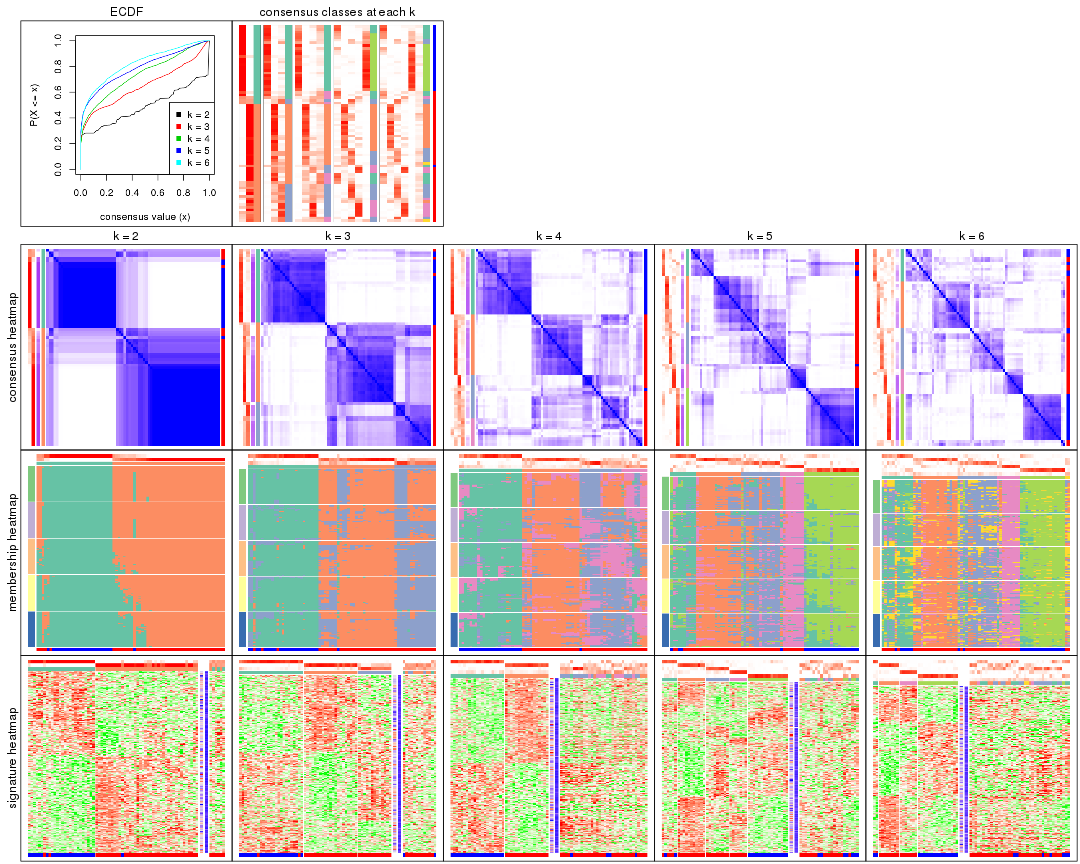
The plots are:
k and the heatmap of
predicted classes for each k.k.k.k.All the plots in panels can be made by individual functions and they are plotted later in this section.
select_partition_number() produces several plots showing different
statistics for choosing “optimized” k. There are following statistics:
k;k, the area increased is defined as \(A_k - A_{k-1}\).The detailed explanations of these statistics can be found in the cola vignette.
Generally speaking, lower PAC score, higher mean silhouette score or higher
concordance corresponds to better partition. Rand index and Jaccard index
measure how similar the current partition is compared to partition with k-1.
If they are too similar, we won't accept k is better than k-1.
select_partition_number(res)
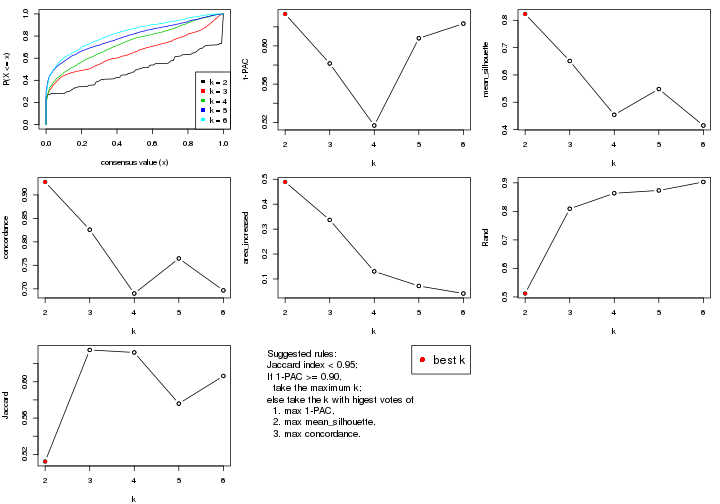
The numeric values for all these statistics can be obtained by get_stats().
get_stats(res)
#> k 1-PAC mean_silhouette concordance area_increased Rand Jaccard
#> 2 2 0.633 0.823 0.927 0.4892 0.512 0.512
#> 3 3 0.582 0.651 0.826 0.3369 0.809 0.635
#> 4 4 0.517 0.454 0.690 0.1303 0.863 0.632
#> 5 5 0.608 0.548 0.765 0.0718 0.873 0.576
#> 6 6 0.623 0.415 0.697 0.0416 0.903 0.606
suggest_best_k() suggests the best \(k\) based on these statistics. The rules are as follows:
suggest_best_k(res)
#> [1] 2
Following shows the table of the partitions (You need to click the show/hide
code output link to see it). The membership matrix (columns with name p*)
is inferred by
clue::cl_consensus()
function with the SE method. Basically the value in the membership matrix
represents the probability to belong to a certain group. The finall class
label for an item is determined with the group with highest probability it
belongs to.
In get_classes() function, the entropy is calculated from the membership
matrix and the silhouette score is calculated from the consensus matrix.
cbind(get_classes(res, k = 2), get_membership(res, k = 2))
#> class entropy silhouette p1 p2
#> sample_39 2 0.7950 0.7094 0.240 0.760
#> sample_40 2 0.8499 0.6610 0.276 0.724
#> sample_42 2 0.0000 0.9065 0.000 1.000
#> sample_47 2 0.0000 0.9065 0.000 1.000
#> sample_48 2 0.0000 0.9065 0.000 1.000
#> sample_49 2 0.9833 0.3568 0.424 0.576
#> sample_41 2 0.0000 0.9065 0.000 1.000
#> sample_43 2 0.0000 0.9065 0.000 1.000
#> sample_44 2 0.0000 0.9065 0.000 1.000
#> sample_45 2 0.0000 0.9065 0.000 1.000
#> sample_46 2 0.0000 0.9065 0.000 1.000
#> sample_70 2 0.0000 0.9065 0.000 1.000
#> sample_71 2 0.0000 0.9065 0.000 1.000
#> sample_72 2 0.0000 0.9065 0.000 1.000
#> sample_68 2 0.0000 0.9065 0.000 1.000
#> sample_69 2 0.0000 0.9065 0.000 1.000
#> sample_67 1 0.5737 0.7989 0.864 0.136
#> sample_55 2 0.6623 0.7837 0.172 0.828
#> sample_56 2 0.4939 0.8391 0.108 0.892
#> sample_59 2 0.0000 0.9065 0.000 1.000
#> sample_52 1 0.0000 0.9319 1.000 0.000
#> sample_53 1 0.0000 0.9319 1.000 0.000
#> sample_51 1 0.0000 0.9319 1.000 0.000
#> sample_50 1 0.0000 0.9319 1.000 0.000
#> sample_54 1 0.6148 0.7786 0.848 0.152
#> sample_57 1 0.0000 0.9319 1.000 0.000
#> sample_58 1 0.0000 0.9319 1.000 0.000
#> sample_60 1 0.0376 0.9288 0.996 0.004
#> sample_61 1 0.0000 0.9319 1.000 0.000
#> sample_65 1 0.0000 0.9319 1.000 0.000
#> sample_66 2 0.8763 0.5365 0.296 0.704
#> sample_63 1 0.0000 0.9319 1.000 0.000
#> sample_64 1 0.0000 0.9319 1.000 0.000
#> sample_62 1 0.0000 0.9319 1.000 0.000
#> sample_1 2 0.0000 0.9065 0.000 1.000
#> sample_2 1 0.9833 0.2446 0.576 0.424
#> sample_3 2 0.5946 0.8097 0.144 0.856
#> sample_4 2 0.0000 0.9065 0.000 1.000
#> sample_5 2 0.0000 0.9065 0.000 1.000
#> sample_6 2 0.8861 0.6154 0.304 0.696
#> sample_7 2 0.5178 0.8332 0.116 0.884
#> sample_8 2 1.0000 0.1290 0.496 0.504
#> sample_9 2 0.0000 0.9065 0.000 1.000
#> sample_10 2 0.9635 0.4449 0.388 0.612
#> sample_11 2 0.0000 0.9065 0.000 1.000
#> sample_12 1 0.0376 0.9287 0.996 0.004
#> sample_13 2 0.0000 0.9065 0.000 1.000
#> sample_14 2 0.0000 0.9065 0.000 1.000
#> sample_15 2 0.0000 0.9065 0.000 1.000
#> sample_16 2 0.0000 0.9065 0.000 1.000
#> sample_17 2 0.1843 0.8879 0.028 0.972
#> sample_18 2 0.0672 0.9026 0.008 0.992
#> sample_19 2 0.0000 0.9065 0.000 1.000
#> sample_20 2 0.0000 0.9065 0.000 1.000
#> sample_21 2 0.0000 0.9065 0.000 1.000
#> sample_22 1 0.9963 -0.0252 0.536 0.464
#> sample_23 2 0.8499 0.6609 0.276 0.724
#> sample_24 2 0.0000 0.9065 0.000 1.000
#> sample_25 2 0.8555 0.6536 0.280 0.720
#> sample_26 2 0.0000 0.9065 0.000 1.000
#> sample_27 1 0.9988 -0.0885 0.520 0.480
#> sample_34 1 0.0000 0.9319 1.000 0.000
#> sample_35 1 0.0000 0.9319 1.000 0.000
#> sample_36 1 0.0000 0.9319 1.000 0.000
#> sample_37 1 0.0000 0.9319 1.000 0.000
#> sample_38 1 0.0000 0.9319 1.000 0.000
#> sample_28 1 0.0000 0.9319 1.000 0.000
#> sample_29 1 0.0000 0.9319 1.000 0.000
#> sample_30 1 0.0000 0.9319 1.000 0.000
#> sample_31 1 0.0000 0.9319 1.000 0.000
#> sample_32 1 0.0000 0.9319 1.000 0.000
#> sample_33 1 0.0000 0.9319 1.000 0.000
cbind(get_classes(res, k = 3), get_membership(res, k = 3))
#> class entropy silhouette p1 p2 p3
#> sample_39 3 0.5785 0.7137 0.000 0.332 0.668
#> sample_40 3 0.5902 0.7279 0.004 0.316 0.680
#> sample_42 2 0.2663 0.7107 0.024 0.932 0.044
#> sample_47 2 0.0592 0.7391 0.000 0.988 0.012
#> sample_48 2 0.0592 0.7397 0.000 0.988 0.012
#> sample_49 3 0.5953 0.7401 0.012 0.280 0.708
#> sample_41 2 0.2066 0.7341 0.000 0.940 0.060
#> sample_43 2 0.1031 0.7365 0.000 0.976 0.024
#> sample_44 2 0.4555 0.5460 0.000 0.800 0.200
#> sample_45 2 0.1529 0.7314 0.000 0.960 0.040
#> sample_46 2 0.2356 0.7065 0.000 0.928 0.072
#> sample_70 2 0.6307 -0.4148 0.000 0.512 0.488
#> sample_71 2 0.5053 0.6175 0.024 0.812 0.164
#> sample_72 2 0.1289 0.7362 0.000 0.968 0.032
#> sample_68 2 0.0747 0.7412 0.000 0.984 0.016
#> sample_69 2 0.0892 0.7375 0.000 0.980 0.020
#> sample_67 1 0.6286 0.7432 0.772 0.092 0.136
#> sample_55 3 0.5706 0.7230 0.000 0.320 0.680
#> sample_56 3 0.5810 0.7151 0.000 0.336 0.664
#> sample_59 2 0.6204 -0.1770 0.000 0.576 0.424
#> sample_52 1 0.0747 0.8937 0.984 0.000 0.016
#> sample_53 1 0.1031 0.8899 0.976 0.000 0.024
#> sample_51 1 0.0424 0.8940 0.992 0.000 0.008
#> sample_50 1 0.0424 0.8919 0.992 0.000 0.008
#> sample_54 1 0.3947 0.8523 0.884 0.076 0.040
#> sample_57 1 0.3340 0.8632 0.880 0.000 0.120
#> sample_58 1 0.4974 0.7518 0.764 0.000 0.236
#> sample_60 1 0.2446 0.8903 0.936 0.012 0.052
#> sample_61 1 0.3879 0.8381 0.848 0.000 0.152
#> sample_65 1 0.2165 0.8878 0.936 0.000 0.064
#> sample_66 2 0.9901 0.1339 0.296 0.404 0.300
#> sample_63 1 0.1031 0.8941 0.976 0.000 0.024
#> sample_64 1 0.5948 0.5604 0.640 0.000 0.360
#> sample_62 1 0.1031 0.8941 0.976 0.000 0.024
#> sample_1 3 0.6307 0.4056 0.000 0.488 0.512
#> sample_2 1 0.9425 0.3377 0.488 0.200 0.312
#> sample_3 3 0.2448 0.6382 0.000 0.076 0.924
#> sample_4 3 0.6280 0.4126 0.000 0.460 0.540
#> sample_5 2 0.0892 0.7397 0.000 0.980 0.020
#> sample_6 3 0.2599 0.6311 0.016 0.052 0.932
#> sample_7 3 0.5678 0.7223 0.000 0.316 0.684
#> sample_8 3 0.6027 0.7403 0.016 0.272 0.712
#> sample_9 3 0.6192 0.0059 0.000 0.420 0.580
#> sample_10 3 0.2947 0.6308 0.020 0.060 0.920
#> sample_11 2 0.6298 0.3987 0.004 0.608 0.388
#> sample_12 1 0.3454 0.8744 0.888 0.008 0.104
#> sample_13 2 0.0424 0.7405 0.000 0.992 0.008
#> sample_14 2 0.5948 0.4284 0.000 0.640 0.360
#> sample_15 2 0.1163 0.7392 0.000 0.972 0.028
#> sample_16 2 0.4654 0.5364 0.000 0.792 0.208
#> sample_17 2 0.5480 0.5208 0.004 0.732 0.264
#> sample_18 2 0.6307 -0.3756 0.000 0.512 0.488
#> sample_19 2 0.2711 0.6928 0.000 0.912 0.088
#> sample_20 2 0.0592 0.7410 0.000 0.988 0.012
#> sample_21 2 0.2711 0.7163 0.000 0.912 0.088
#> sample_22 3 0.6735 0.7172 0.044 0.260 0.696
#> sample_23 3 0.2165 0.6372 0.000 0.064 0.936
#> sample_24 2 0.2261 0.7282 0.000 0.932 0.068
#> sample_25 2 0.7378 -0.1412 0.036 0.560 0.404
#> sample_26 2 0.5291 0.3761 0.000 0.732 0.268
#> sample_27 3 0.5992 0.7407 0.016 0.268 0.716
#> sample_34 1 0.2448 0.8838 0.924 0.000 0.076
#> sample_35 1 0.6295 0.3039 0.528 0.000 0.472
#> sample_36 1 0.0747 0.8910 0.984 0.000 0.016
#> sample_37 1 0.0892 0.8898 0.980 0.000 0.020
#> sample_38 1 0.2537 0.8758 0.920 0.000 0.080
#> sample_28 1 0.1765 0.8917 0.956 0.004 0.040
#> sample_29 1 0.2810 0.8688 0.928 0.036 0.036
#> sample_30 1 0.0892 0.8898 0.980 0.000 0.020
#> sample_31 1 0.2878 0.8766 0.904 0.000 0.096
#> sample_32 1 0.1643 0.8944 0.956 0.000 0.044
#> sample_33 1 0.1529 0.8948 0.960 0.000 0.040
cbind(get_classes(res, k = 4), get_membership(res, k = 4))
#> class entropy silhouette p1 p2 p3 p4
#> sample_39 4 0.7480 -0.31525 0.000 0.180 0.376 0.444
#> sample_40 3 0.7826 0.35310 0.004 0.220 0.432 0.344
#> sample_42 4 0.5725 0.26530 0.016 0.372 0.012 0.600
#> sample_47 2 0.2412 0.71787 0.000 0.908 0.008 0.084
#> sample_48 2 0.0921 0.71930 0.000 0.972 0.000 0.028
#> sample_49 3 0.7608 0.35783 0.000 0.216 0.456 0.328
#> sample_41 2 0.2996 0.68380 0.000 0.892 0.044 0.064
#> sample_43 2 0.3196 0.70982 0.000 0.856 0.008 0.136
#> sample_44 2 0.5395 0.62126 0.000 0.736 0.092 0.172
#> sample_45 2 0.3577 0.70107 0.000 0.832 0.012 0.156
#> sample_46 2 0.4423 0.68205 0.000 0.788 0.036 0.176
#> sample_70 2 0.7907 -0.15987 0.000 0.364 0.308 0.328
#> sample_71 4 0.6799 0.34926 0.028 0.304 0.064 0.604
#> sample_72 4 0.5816 0.22261 0.000 0.392 0.036 0.572
#> sample_68 2 0.2255 0.69030 0.000 0.920 0.012 0.068
#> sample_69 2 0.2704 0.68204 0.000 0.876 0.000 0.124
#> sample_67 4 0.8350 0.00642 0.364 0.048 0.148 0.440
#> sample_55 4 0.9726 -0.29997 0.144 0.256 0.276 0.324
#> sample_56 3 0.7820 0.31036 0.000 0.256 0.384 0.360
#> sample_59 2 0.6919 0.37411 0.004 0.600 0.152 0.244
#> sample_52 1 0.1209 0.78103 0.964 0.000 0.004 0.032
#> sample_53 1 0.4295 0.65254 0.752 0.000 0.008 0.240
#> sample_51 1 0.2271 0.76622 0.916 0.000 0.008 0.076
#> sample_50 1 0.0921 0.78211 0.972 0.000 0.000 0.028
#> sample_54 1 0.4927 0.67806 0.800 0.100 0.016 0.084
#> sample_57 1 0.3441 0.73973 0.856 0.000 0.024 0.120
#> sample_58 1 0.4139 0.70026 0.816 0.000 0.040 0.144
#> sample_60 1 0.4443 0.71213 0.820 0.048 0.012 0.120
#> sample_61 1 0.5170 0.67389 0.724 0.000 0.048 0.228
#> sample_65 1 0.1109 0.78652 0.968 0.000 0.004 0.028
#> sample_66 3 0.9431 -0.17029 0.096 0.296 0.328 0.280
#> sample_63 1 0.1398 0.78107 0.956 0.000 0.004 0.040
#> sample_64 1 0.5070 0.64275 0.748 0.000 0.060 0.192
#> sample_62 1 0.1661 0.77717 0.944 0.000 0.004 0.052
#> sample_1 3 0.7869 0.19311 0.000 0.340 0.380 0.280
#> sample_2 4 0.8623 0.14418 0.120 0.084 0.384 0.412
#> sample_3 3 0.0712 0.38496 0.008 0.004 0.984 0.004
#> sample_4 3 0.7345 0.22837 0.000 0.348 0.484 0.168
#> sample_5 2 0.2949 0.67453 0.000 0.888 0.024 0.088
#> sample_6 3 0.0524 0.38534 0.008 0.004 0.988 0.000
#> sample_7 3 0.7247 0.39028 0.000 0.216 0.544 0.240
#> sample_8 3 0.6783 0.25821 0.004 0.084 0.508 0.404
#> sample_9 3 0.5226 0.27581 0.000 0.180 0.744 0.076
#> sample_10 3 0.2542 0.32598 0.012 0.000 0.904 0.084
#> sample_11 3 0.6391 0.04183 0.000 0.092 0.604 0.304
#> sample_12 4 0.6277 -0.26475 0.468 0.000 0.056 0.476
#> sample_13 2 0.1389 0.71880 0.000 0.952 0.000 0.048
#> sample_14 3 0.6602 0.13740 0.000 0.356 0.552 0.092
#> sample_15 2 0.2773 0.68404 0.000 0.900 0.028 0.072
#> sample_16 2 0.4542 0.67432 0.000 0.804 0.088 0.108
#> sample_17 2 0.6744 0.29526 0.012 0.612 0.280 0.096
#> sample_18 2 0.7818 -0.15122 0.000 0.404 0.332 0.264
#> sample_19 2 0.4832 0.67046 0.000 0.768 0.056 0.176
#> sample_20 2 0.2676 0.69976 0.000 0.896 0.012 0.092
#> sample_21 2 0.4840 0.59153 0.000 0.784 0.116 0.100
#> sample_22 4 0.6521 -0.04327 0.008 0.056 0.412 0.524
#> sample_23 3 0.1114 0.37852 0.008 0.004 0.972 0.016
#> sample_24 2 0.3400 0.66637 0.000 0.872 0.064 0.064
#> sample_25 4 0.6583 0.23943 0.016 0.164 0.148 0.672
#> sample_26 2 0.6790 0.43614 0.000 0.576 0.128 0.296
#> sample_27 3 0.7443 0.36646 0.000 0.196 0.492 0.312
#> sample_34 1 0.0937 0.78587 0.976 0.000 0.012 0.012
#> sample_35 1 0.7516 0.17176 0.472 0.000 0.328 0.200
#> sample_36 1 0.0469 0.78372 0.988 0.000 0.000 0.012
#> sample_37 1 0.4049 0.67995 0.780 0.000 0.008 0.212
#> sample_38 1 0.7343 0.08370 0.428 0.000 0.156 0.416
#> sample_28 1 0.5931 0.23479 0.504 0.000 0.036 0.460
#> sample_29 1 0.3610 0.70082 0.800 0.000 0.000 0.200
#> sample_30 1 0.1004 0.78363 0.972 0.000 0.004 0.024
#> sample_31 1 0.1545 0.78164 0.952 0.000 0.008 0.040
#> sample_32 1 0.3852 0.70680 0.808 0.000 0.012 0.180
#> sample_33 1 0.4804 0.60727 0.708 0.000 0.016 0.276
cbind(get_classes(res, k = 5), get_membership(res, k = 5))
#> class entropy silhouette p1 p2 p3 p4 p5
#> sample_39 3 0.2707 0.6041 0.132 0.008 0.860 0.000 0.000
#> sample_40 3 0.4232 0.6231 0.008 0.012 0.796 0.144 0.040
#> sample_42 1 0.4049 0.5465 0.780 0.056 0.164 0.000 0.000
#> sample_47 2 0.4096 0.6315 0.040 0.760 0.200 0.000 0.000
#> sample_48 2 0.2561 0.6904 0.020 0.884 0.096 0.000 0.000
#> sample_49 3 0.2464 0.6618 0.000 0.000 0.888 0.096 0.016
#> sample_41 2 0.1877 0.6759 0.008 0.932 0.004 0.052 0.004
#> sample_43 2 0.5342 0.4834 0.076 0.612 0.312 0.000 0.000
#> sample_44 2 0.5364 0.2117 0.036 0.496 0.460 0.008 0.000
#> sample_45 2 0.5535 0.4195 0.080 0.568 0.352 0.000 0.000
#> sample_46 2 0.5778 0.1757 0.088 0.464 0.448 0.000 0.000
#> sample_70 3 0.3798 0.5929 0.068 0.100 0.824 0.008 0.000
#> sample_71 1 0.3576 0.5970 0.840 0.048 0.100 0.012 0.000
#> sample_72 1 0.5309 0.4127 0.668 0.080 0.244 0.008 0.000
#> sample_68 2 0.0451 0.6823 0.000 0.988 0.000 0.008 0.004
#> sample_69 2 0.4455 0.6602 0.132 0.768 0.096 0.004 0.000
#> sample_67 1 0.4194 0.5710 0.788 0.004 0.000 0.128 0.080
#> sample_55 3 0.8245 0.2481 0.008 0.196 0.364 0.104 0.328
#> sample_56 3 0.1975 0.6680 0.004 0.016 0.936 0.024 0.020
#> sample_59 3 0.5623 0.3577 0.016 0.308 0.624 0.012 0.040
#> sample_52 5 0.0727 0.7874 0.012 0.004 0.000 0.004 0.980
#> sample_53 5 0.4510 0.3498 0.432 0.000 0.000 0.008 0.560
#> sample_51 5 0.2852 0.7346 0.172 0.000 0.000 0.000 0.828
#> sample_50 5 0.2471 0.7581 0.136 0.000 0.000 0.000 0.864
#> sample_54 5 0.2437 0.7537 0.016 0.052 0.016 0.004 0.912
#> sample_57 5 0.1856 0.7699 0.008 0.012 0.032 0.008 0.940
#> sample_58 5 0.2338 0.7465 0.004 0.000 0.112 0.000 0.884
#> sample_60 5 0.2325 0.7599 0.016 0.036 0.024 0.004 0.920
#> sample_61 5 0.6490 0.1701 0.164 0.004 0.376 0.000 0.456
#> sample_65 5 0.1764 0.7842 0.064 0.000 0.008 0.000 0.928
#> sample_66 4 0.7098 0.1673 0.324 0.248 0.000 0.412 0.016
#> sample_63 5 0.0486 0.7866 0.004 0.004 0.004 0.000 0.988
#> sample_64 5 0.2679 0.7474 0.008 0.008 0.072 0.016 0.896
#> sample_62 5 0.1016 0.7808 0.008 0.012 0.004 0.004 0.972
#> sample_1 3 0.3568 0.6614 0.012 0.064 0.844 0.080 0.000
#> sample_2 1 0.5140 0.0781 0.544 0.016 0.000 0.424 0.016
#> sample_3 4 0.1430 0.7895 0.004 0.000 0.052 0.944 0.000
#> sample_4 4 0.6916 0.2291 0.004 0.308 0.200 0.476 0.012
#> sample_5 2 0.1704 0.6640 0.004 0.928 0.000 0.068 0.000
#> sample_6 4 0.1282 0.7929 0.004 0.000 0.044 0.952 0.000
#> sample_7 3 0.7406 0.0206 0.008 0.180 0.392 0.388 0.032
#> sample_8 3 0.3291 0.6418 0.040 0.000 0.840 0.120 0.000
#> sample_9 4 0.1569 0.7881 0.008 0.044 0.004 0.944 0.000
#> sample_10 4 0.1493 0.7912 0.028 0.000 0.024 0.948 0.000
#> sample_11 4 0.2149 0.7681 0.048 0.036 0.000 0.916 0.000
#> sample_12 1 0.4924 0.6132 0.740 0.000 0.112 0.012 0.136
#> sample_13 2 0.3035 0.6865 0.032 0.856 0.112 0.000 0.000
#> sample_14 4 0.2873 0.7399 0.016 0.128 0.000 0.856 0.000
#> sample_15 2 0.1928 0.6637 0.004 0.920 0.004 0.072 0.000
#> sample_16 2 0.4538 0.4508 0.016 0.620 0.364 0.000 0.000
#> sample_17 2 0.4182 0.1907 0.000 0.644 0.000 0.352 0.004
#> sample_18 3 0.5471 0.6117 0.004 0.136 0.720 0.108 0.032
#> sample_19 3 0.6012 -0.1161 0.116 0.400 0.484 0.000 0.000
#> sample_20 2 0.3823 0.6837 0.060 0.820 0.112 0.008 0.000
#> sample_21 2 0.4512 0.5150 0.040 0.744 0.012 0.204 0.000
#> sample_22 3 0.5518 0.2435 0.348 0.000 0.580 0.068 0.004
#> sample_23 4 0.1557 0.7884 0.008 0.000 0.052 0.940 0.000
#> sample_24 2 0.2629 0.5942 0.000 0.860 0.000 0.136 0.004
#> sample_25 1 0.5170 0.0808 0.524 0.032 0.440 0.004 0.000
#> sample_26 3 0.5277 0.3880 0.108 0.228 0.664 0.000 0.000
#> sample_27 3 0.3742 0.5868 0.004 0.000 0.788 0.188 0.020
#> sample_34 5 0.1121 0.7870 0.044 0.000 0.000 0.000 0.956
#> sample_35 5 0.6164 0.2733 0.000 0.000 0.328 0.152 0.520
#> sample_36 5 0.1965 0.7743 0.096 0.000 0.000 0.000 0.904
#> sample_37 5 0.4434 0.2831 0.460 0.000 0.000 0.004 0.536
#> sample_38 1 0.4298 0.6083 0.788 0.000 0.008 0.096 0.108
#> sample_28 1 0.3127 0.6172 0.848 0.000 0.004 0.020 0.128
#> sample_29 5 0.4114 0.4820 0.376 0.000 0.000 0.000 0.624
#> sample_30 5 0.2329 0.7637 0.124 0.000 0.000 0.000 0.876
#> sample_31 5 0.0898 0.7888 0.020 0.000 0.000 0.008 0.972
#> sample_32 5 0.4009 0.5784 0.312 0.000 0.004 0.000 0.684
#> sample_33 1 0.4758 -0.0345 0.560 0.000 0.008 0.008 0.424
cbind(get_classes(res, k = 6), get_membership(res, k = 6))
#> class entropy silhouette p1 p2 p3 p4 p5 p6
#> sample_39 3 0.3654 0.38232 0.072 0.008 0.812 0.004 0.000 0.104
#> sample_40 3 0.5403 0.32951 0.008 0.020 0.688 0.096 0.016 0.172
#> sample_42 1 0.4633 0.44453 0.736 0.040 0.072 0.000 0.000 0.152
#> sample_47 2 0.4791 0.37276 0.028 0.720 0.120 0.000 0.000 0.132
#> sample_48 2 0.2407 0.53435 0.004 0.892 0.056 0.000 0.000 0.048
#> sample_49 3 0.2846 0.41261 0.000 0.000 0.856 0.060 0.000 0.084
#> sample_41 2 0.2364 0.53901 0.000 0.892 0.004 0.032 0.000 0.072
#> sample_43 2 0.6999 -0.40954 0.060 0.392 0.156 0.008 0.004 0.380
#> sample_44 2 0.6667 -0.44320 0.008 0.400 0.316 0.012 0.004 0.260
#> sample_45 2 0.6372 -0.09837 0.028 0.496 0.284 0.004 0.000 0.188
#> sample_46 3 0.6424 -0.24224 0.040 0.392 0.412 0.000 0.000 0.156
#> sample_70 3 0.5837 0.05092 0.036 0.068 0.580 0.016 0.000 0.300
#> sample_71 1 0.6888 0.32722 0.528 0.016 0.168 0.064 0.004 0.220
#> sample_72 1 0.6979 0.04074 0.380 0.048 0.348 0.008 0.000 0.216
#> sample_68 2 0.1088 0.55607 0.000 0.960 0.000 0.016 0.000 0.024
#> sample_69 2 0.5679 0.38812 0.068 0.648 0.152 0.000 0.000 0.132
#> sample_67 1 0.6971 0.31532 0.540 0.036 0.004 0.204 0.052 0.164
#> sample_55 6 0.7781 0.38320 0.000 0.212 0.260 0.040 0.092 0.396
#> sample_56 3 0.3713 0.29001 0.008 0.008 0.752 0.008 0.000 0.224
#> sample_59 6 0.6724 0.38903 0.004 0.308 0.296 0.012 0.008 0.372
#> sample_52 5 0.0692 0.82909 0.004 0.000 0.000 0.000 0.976 0.020
#> sample_53 5 0.4627 0.16778 0.456 0.000 0.000 0.008 0.512 0.024
#> sample_51 5 0.3853 0.56028 0.304 0.000 0.000 0.000 0.680 0.016
#> sample_50 5 0.2737 0.76087 0.160 0.000 0.004 0.000 0.832 0.004
#> sample_54 5 0.3098 0.75912 0.000 0.040 0.004 0.000 0.836 0.120
#> sample_57 5 0.1801 0.82005 0.004 0.000 0.016 0.000 0.924 0.056
#> sample_58 5 0.2658 0.78385 0.000 0.000 0.100 0.000 0.864 0.036
#> sample_60 5 0.3491 0.72897 0.004 0.028 0.004 0.000 0.796 0.168
#> sample_61 3 0.6645 -0.00222 0.116 0.000 0.412 0.000 0.388 0.084
#> sample_65 5 0.1452 0.83088 0.020 0.000 0.020 0.000 0.948 0.012
#> sample_66 1 0.7816 0.07534 0.332 0.172 0.000 0.172 0.016 0.308
#> sample_63 5 0.1608 0.82559 0.004 0.004 0.016 0.000 0.940 0.036
#> sample_64 5 0.4623 0.71481 0.012 0.020 0.088 0.020 0.776 0.084
#> sample_62 5 0.2229 0.81275 0.004 0.012 0.008 0.004 0.908 0.064
#> sample_1 3 0.4318 0.39367 0.004 0.064 0.784 0.080 0.000 0.068
#> sample_2 4 0.6160 0.08042 0.388 0.040 0.000 0.468 0.004 0.100
#> sample_3 4 0.2507 0.73517 0.004 0.000 0.072 0.884 0.000 0.040
#> sample_4 2 0.7354 -0.13670 0.004 0.372 0.140 0.332 0.000 0.152
#> sample_5 2 0.2106 0.55571 0.000 0.904 0.000 0.064 0.000 0.032
#> sample_6 4 0.2954 0.72663 0.004 0.000 0.048 0.852 0.000 0.096
#> sample_7 4 0.7755 -0.10331 0.012 0.184 0.304 0.336 0.000 0.164
#> sample_8 3 0.5049 0.38920 0.048 0.004 0.716 0.100 0.000 0.132
#> sample_9 4 0.1464 0.74263 0.000 0.036 0.004 0.944 0.000 0.016
#> sample_10 4 0.1932 0.74762 0.016 0.000 0.020 0.924 0.000 0.040
#> sample_11 4 0.1851 0.73552 0.012 0.036 0.000 0.928 0.000 0.024
#> sample_12 1 0.5976 0.46530 0.640 0.000 0.140 0.008 0.084 0.128
#> sample_13 2 0.3324 0.52218 0.004 0.824 0.112 0.000 0.000 0.060
#> sample_14 4 0.2937 0.68831 0.004 0.100 0.000 0.852 0.000 0.044
#> sample_15 2 0.2314 0.55886 0.000 0.900 0.008 0.056 0.000 0.036
#> sample_16 2 0.5751 0.14034 0.008 0.508 0.384 0.020 0.000 0.080
#> sample_17 2 0.5170 0.31247 0.000 0.592 0.000 0.312 0.008 0.088
#> sample_18 3 0.6542 0.17144 0.000 0.044 0.564 0.172 0.024 0.196
#> sample_19 3 0.6340 -0.09861 0.064 0.348 0.480 0.000 0.000 0.108
#> sample_20 2 0.3438 0.54579 0.024 0.844 0.064 0.008 0.000 0.060
#> sample_21 2 0.4164 0.48260 0.016 0.756 0.000 0.168 0.000 0.060
#> sample_22 3 0.5647 0.35580 0.212 0.000 0.640 0.056 0.004 0.088
#> sample_23 4 0.3049 0.72411 0.004 0.000 0.048 0.844 0.000 0.104
#> sample_24 2 0.3465 0.52807 0.004 0.820 0.004 0.112 0.000 0.060
#> sample_25 1 0.5878 -0.04652 0.440 0.020 0.424 0.000 0.000 0.116
#> sample_26 3 0.5206 0.30467 0.060 0.108 0.696 0.000 0.000 0.136
#> sample_27 3 0.4429 0.32885 0.000 0.000 0.716 0.140 0.000 0.144
#> sample_34 5 0.1642 0.83157 0.032 0.000 0.004 0.000 0.936 0.028
#> sample_35 3 0.8359 -0.04180 0.076 0.000 0.288 0.108 0.256 0.272
#> sample_36 5 0.1333 0.82400 0.048 0.000 0.000 0.000 0.944 0.008
#> sample_37 1 0.4941 0.21844 0.572 0.000 0.000 0.004 0.360 0.064
#> sample_38 1 0.4261 0.52646 0.784 0.000 0.004 0.056 0.052 0.104
#> sample_28 1 0.2169 0.55537 0.900 0.000 0.000 0.012 0.080 0.008
#> sample_29 1 0.5415 0.32030 0.564 0.000 0.000 0.004 0.304 0.128
#> sample_30 5 0.2165 0.79696 0.108 0.000 0.000 0.000 0.884 0.008
#> sample_31 5 0.1710 0.83010 0.028 0.000 0.004 0.004 0.936 0.028
#> sample_32 5 0.4522 0.66382 0.196 0.000 0.028 0.004 0.728 0.044
#> sample_33 1 0.3940 0.25566 0.640 0.000 0.000 0.000 0.348 0.012
Heatmaps for the consensus matrix. It visualizes the probability of two samples to be in a same group.
consensus_heatmap(res, k = 2)
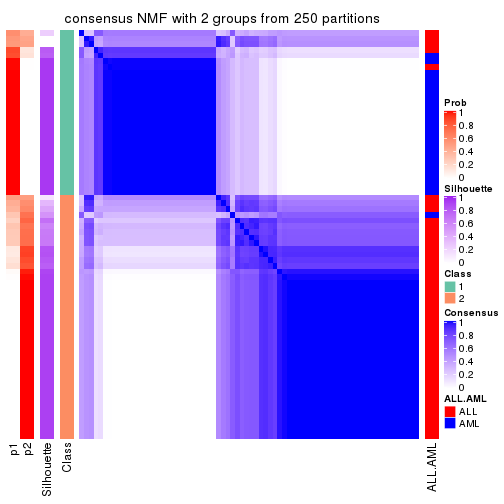
consensus_heatmap(res, k = 3)
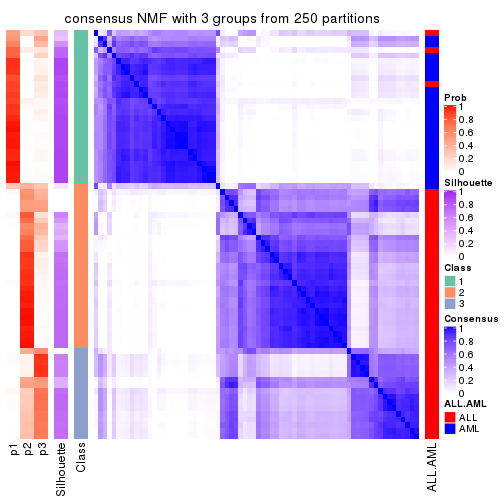
consensus_heatmap(res, k = 4)
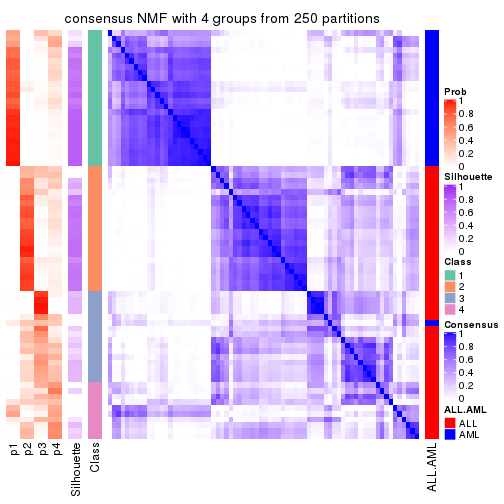
consensus_heatmap(res, k = 5)
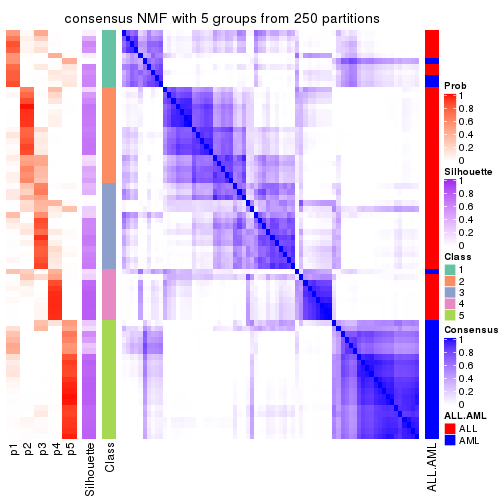
consensus_heatmap(res, k = 6)
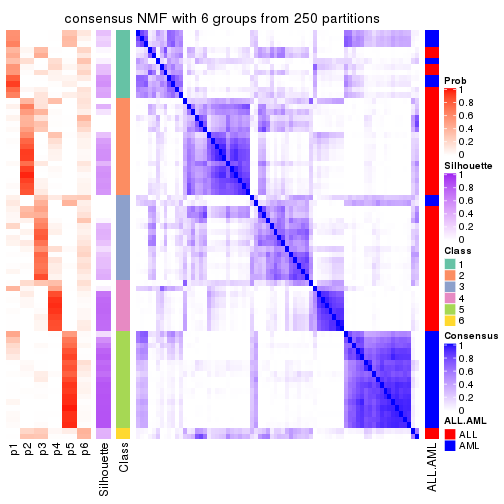
Heatmaps for the membership of samples in all partitions to see how consistent they are:
membership_heatmap(res, k = 2)
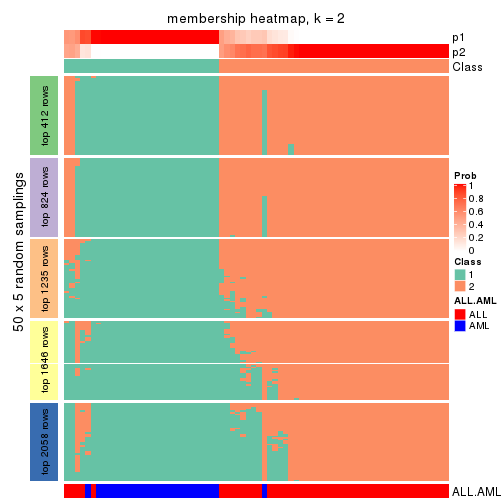
membership_heatmap(res, k = 3)
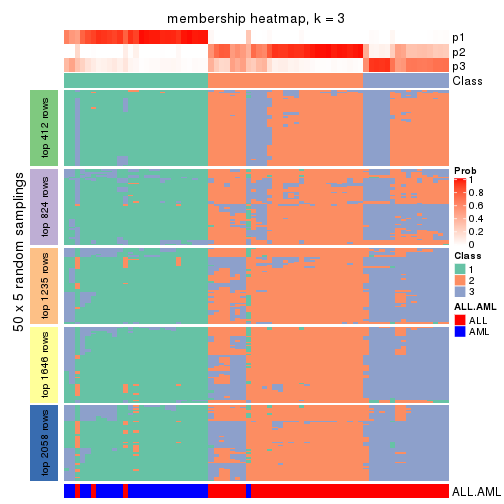
membership_heatmap(res, k = 4)
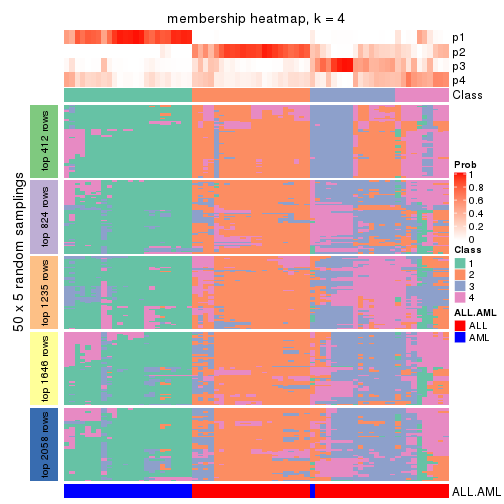
membership_heatmap(res, k = 5)
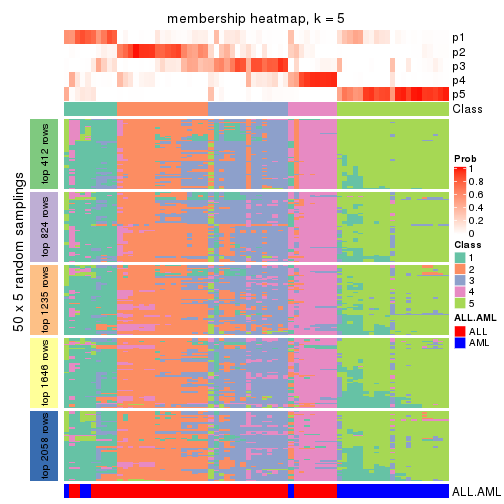
membership_heatmap(res, k = 6)
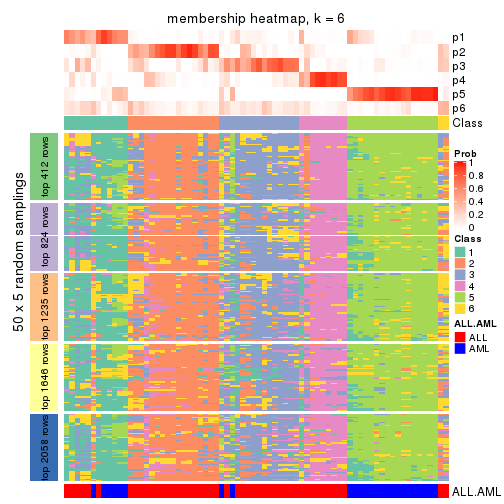
As soon as we have had the classes for columns, we can look for signatures which are significantly different between classes which can be candidate marks for certain classes. Following are the heatmaps for signatures.
Signature heatmaps where rows are scaled:
get_signatures(res, k = 2)
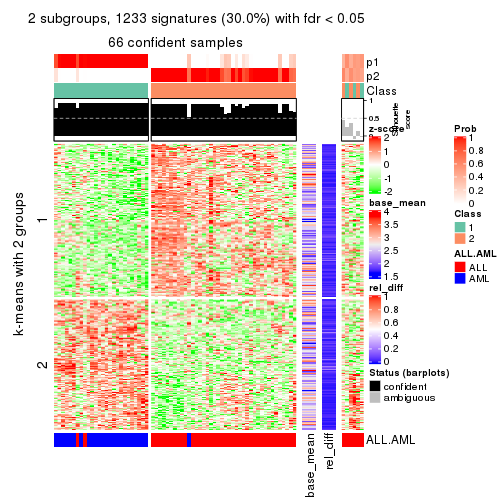
get_signatures(res, k = 3)
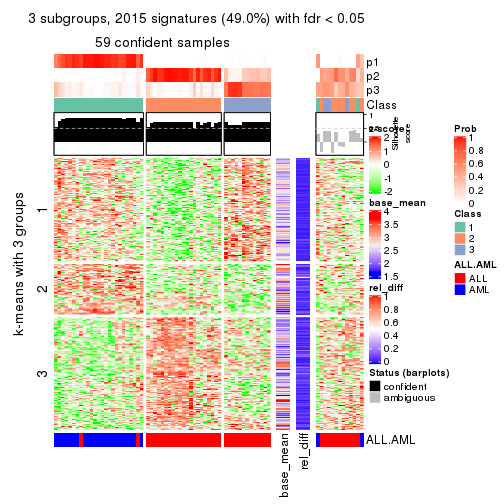
get_signatures(res, k = 4)
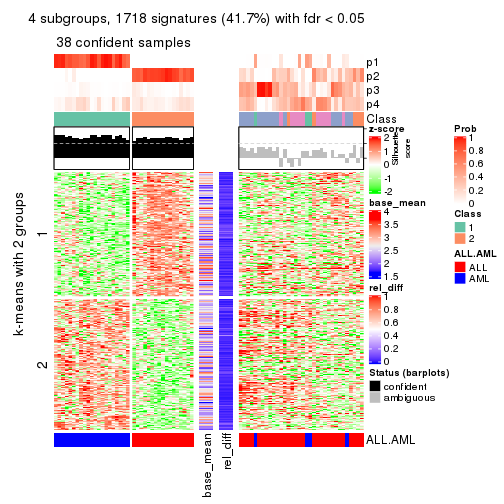
get_signatures(res, k = 5)
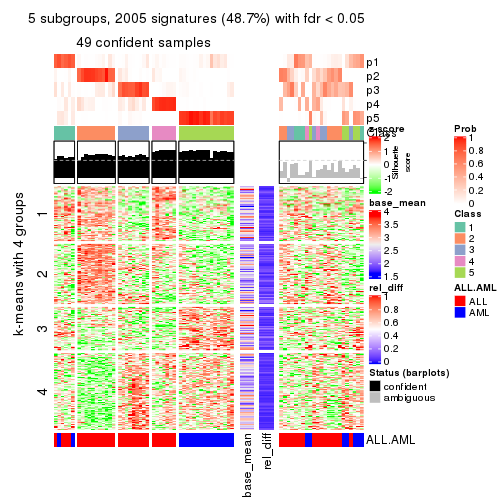
get_signatures(res, k = 6)
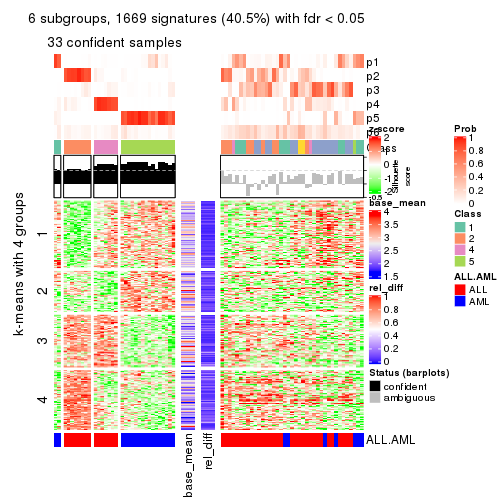
Signature heatmaps where rows are not scaled:
get_signatures(res, k = 2, scale_rows = FALSE)
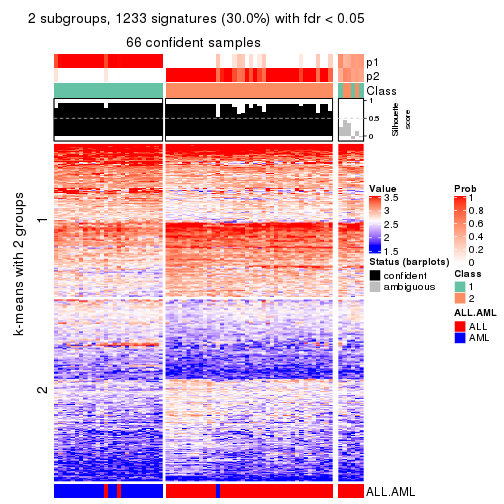
get_signatures(res, k = 3, scale_rows = FALSE)
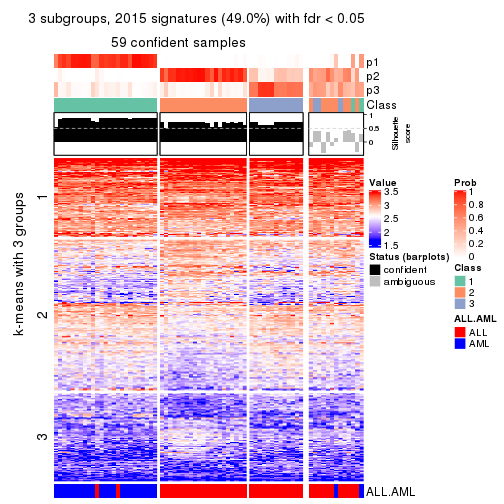
get_signatures(res, k = 4, scale_rows = FALSE)
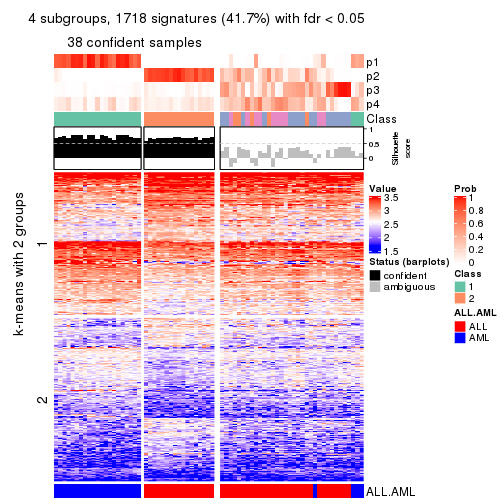
get_signatures(res, k = 5, scale_rows = FALSE)
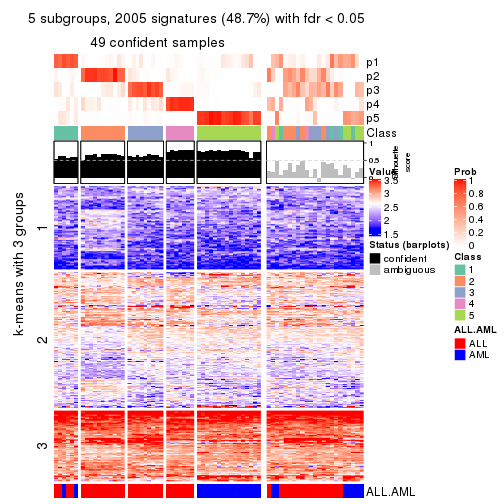
get_signatures(res, k = 6, scale_rows = FALSE)
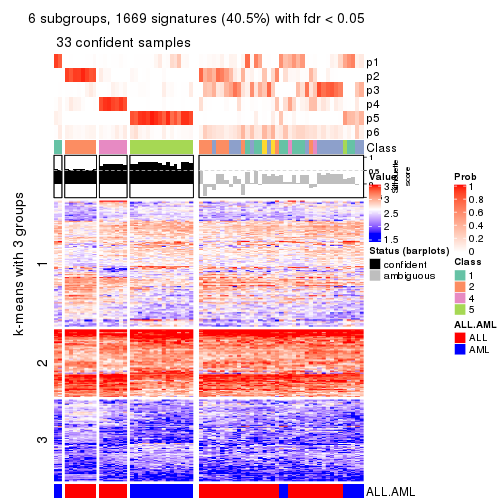
Compare the overlap of signatures from different k:
compare_signatures(res)
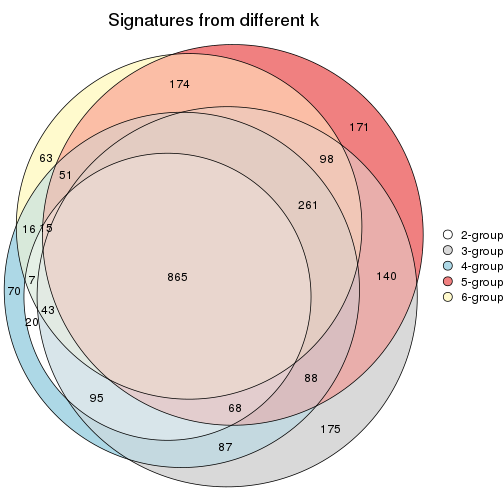
get_signature() returns a data frame invisibly. TO get the list of signatures, the function
call should be assigned to a variable explicitly. In following code, if plot argument is set
to FALSE, no heatmap is plotted while only the differential analysis is performed.
# code only for demonstration
tb = get_signature(res, k = ..., plot = FALSE)
An example of the output of tb is:
#> which_row fdr mean_1 mean_2 scaled_mean_1 scaled_mean_2 km
#> 1 38 0.042760348 8.373488 9.131774 -0.5533452 0.5164555 1
#> 2 40 0.018707592 7.106213 8.469186 -0.6173731 0.5762149 1
#> 3 55 0.019134737 10.221463 11.207825 -0.6159697 0.5749050 1
#> 4 59 0.006059896 5.921854 7.869574 -0.6899429 0.6439467 1
#> 5 60 0.018055526 8.928898 10.211722 -0.6204761 0.5791110 1
#> 6 98 0.009384629 15.714769 14.887706 0.6635654 -0.6193277 2
...
The columns in tb are:
which_row: row indices corresponding to the input matrix.fdr: FDR for the differential test. mean_x: The mean value in group x.scaled_mean_x: The mean value in group x after rows are scaled.km: Row groups if k-means clustering is applied to rows.UMAP plot which shows how samples are separated.
dimension_reduction(res, k = 2, method = "UMAP")
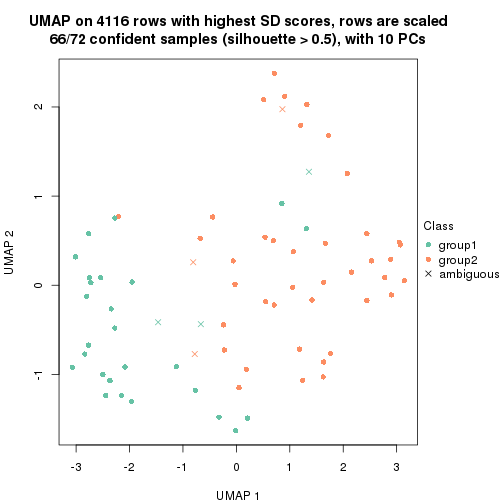
dimension_reduction(res, k = 3, method = "UMAP")
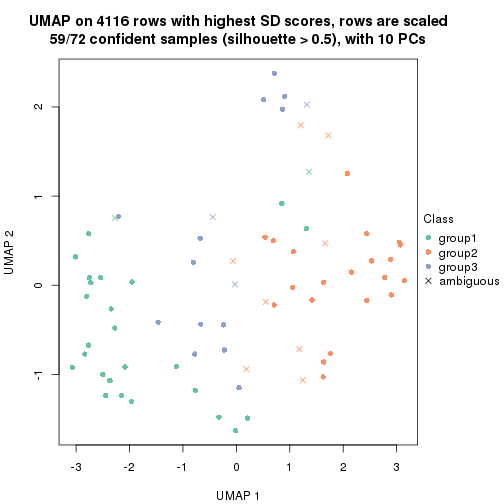
dimension_reduction(res, k = 4, method = "UMAP")
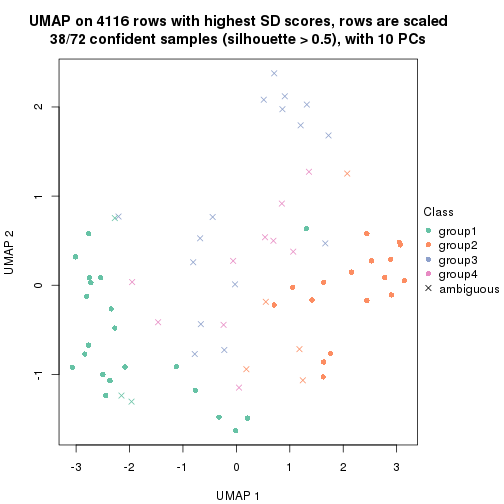
dimension_reduction(res, k = 5, method = "UMAP")
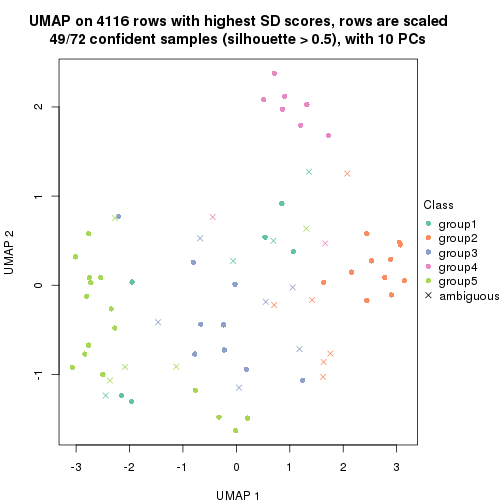
dimension_reduction(res, k = 6, method = "UMAP")
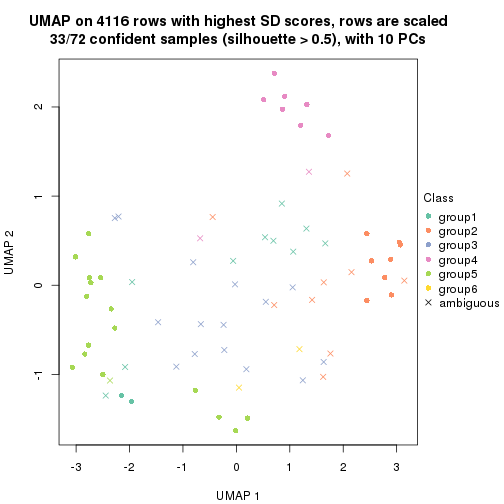
Following heatmap shows how subgroups are split when increasing k:
collect_classes(res)
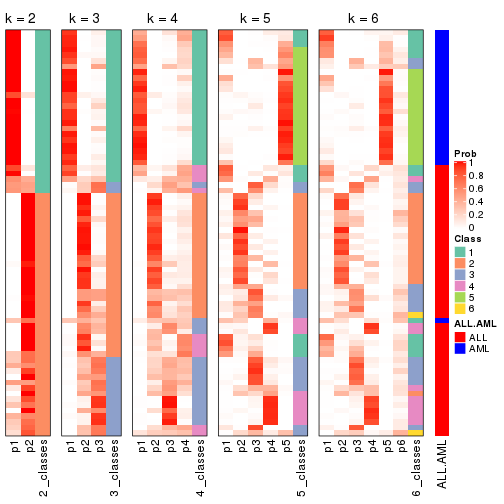
Test correlation between subgroups and known annotations. If the known annotation is numeric, one-way ANOVA test is applied, and if the known annotation is discrete, chi-squared contingency table test is applied.
test_to_known_factors(res)
#> n ALL.AML(p) k
#> SD:NMF 66 1.35e-12 2
#> SD:NMF 59 7.38e-12 3
#> SD:NMF 38 5.34e-09 4
#> SD:NMF 49 9.13e-09 5
#> SD:NMF 33 3.22e-07 6
If matrix rows can be associated to genes, consider to use functional_enrichment(res,
...) to perform function enrichment for the signature genes. See this vignette for more detailed explanations.
The object with results only for a single top-value method and a single partition method can be extracted as:
res = res_list["CV", "hclust"]
# you can also extract it by
# res = res_list["CV:hclust"]
A summary of res and all the functions that can be applied to it:
res
#> A 'ConsensusPartition' object with k = 2, 3, 4, 5, 6.
#> On a matrix with 4116 rows and 72 columns.
#> Top rows (412, 824, 1235, 1646, 2058) are extracted by 'CV' method.
#> Subgroups are detected by 'hclust' method.
#> Performed in total 1250 partitions by row resampling.
#> Best k for subgroups seems to be 2.
#>
#> Following methods can be applied to this 'ConsensusPartition' object:
#> [1] "cola_report" "collect_classes" "collect_plots"
#> [4] "collect_stats" "colnames" "compare_signatures"
#> [7] "consensus_heatmap" "dimension_reduction" "functional_enrichment"
#> [10] "get_anno_col" "get_anno" "get_classes"
#> [13] "get_consensus" "get_matrix" "get_membership"
#> [16] "get_param" "get_signatures" "get_stats"
#> [19] "is_best_k" "is_stable_k" "membership_heatmap"
#> [22] "ncol" "nrow" "plot_ecdf"
#> [25] "rownames" "select_partition_number" "show"
#> [28] "suggest_best_k" "test_to_known_factors"
collect_plots() function collects all the plots made from res for all k (number of partitions)
into one single page to provide an easy and fast comparison between different k.
collect_plots(res)
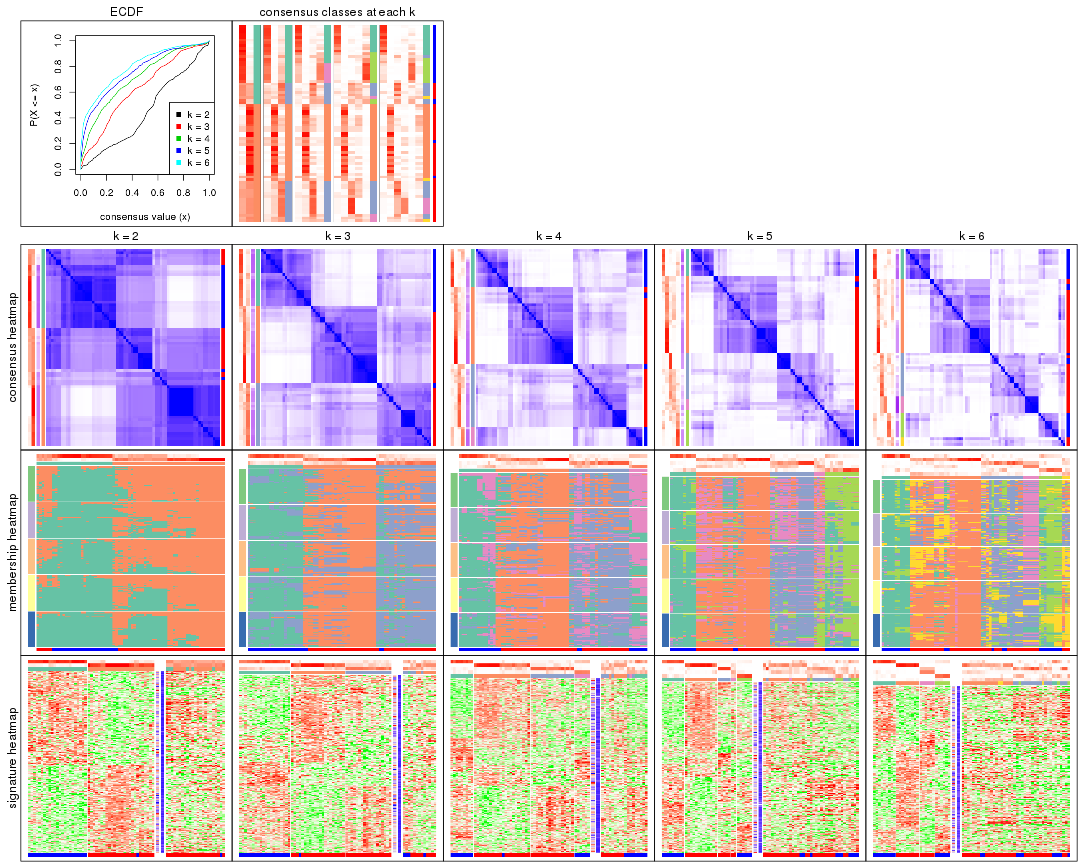
The plots are:
k and the heatmap of
predicted classes for each k.k.k.k.All the plots in panels can be made by individual functions and they are plotted later in this section.
select_partition_number() produces several plots showing different
statistics for choosing “optimized” k. There are following statistics:
k;k, the area increased is defined as \(A_k - A_{k-1}\).The detailed explanations of these statistics can be found in the cola vignette.
Generally speaking, lower PAC score, higher mean silhouette score or higher
concordance corresponds to better partition. Rand index and Jaccard index
measure how similar the current partition is compared to partition with k-1.
If they are too similar, we won't accept k is better than k-1.
select_partition_number(res)
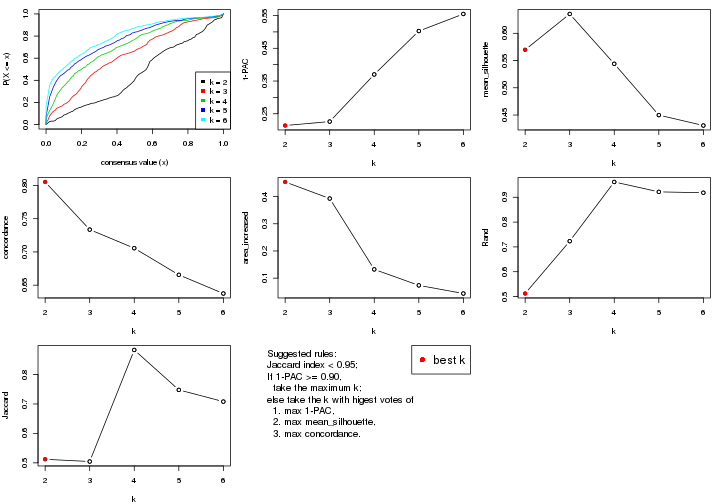
The numeric values for all these statistics can be obtained by get_stats().
get_stats(res)
#> k 1-PAC mean_silhouette concordance area_increased Rand Jaccard
#> 2 2 0.214 0.570 0.805 0.4538 0.512 0.512
#> 3 3 0.226 0.635 0.734 0.3928 0.723 0.505
#> 4 4 0.370 0.544 0.706 0.1323 0.962 0.883
#> 5 5 0.503 0.450 0.665 0.0734 0.922 0.748
#> 6 6 0.555 0.431 0.637 0.0435 0.918 0.708
suggest_best_k() suggests the best \(k\) based on these statistics. The rules are as follows:
suggest_best_k(res)
#> [1] 2
Following shows the table of the partitions (You need to click the show/hide
code output link to see it). The membership matrix (columns with name p*)
is inferred by
clue::cl_consensus()
function with the SE method. Basically the value in the membership matrix
represents the probability to belong to a certain group. The finall class
label for an item is determined with the group with highest probability it
belongs to.
In get_classes() function, the entropy is calculated from the membership
matrix and the silhouette score is calculated from the consensus matrix.
cbind(get_classes(res, k = 2), get_membership(res, k = 2))
#> class entropy silhouette p1 p2
#> sample_39 1 1.0000 -0.189 0.504 0.496
#> sample_40 1 0.9661 0.219 0.608 0.392
#> sample_42 2 0.6247 0.685 0.156 0.844
#> sample_47 2 0.3584 0.702 0.068 0.932
#> sample_48 2 0.0000 0.693 0.000 1.000
#> sample_49 1 0.9754 0.142 0.592 0.408
#> sample_41 2 0.0000 0.693 0.000 1.000
#> sample_43 2 0.4939 0.699 0.108 0.892
#> sample_44 2 0.4690 0.704 0.100 0.900
#> sample_45 2 0.4431 0.705 0.092 0.908
#> sample_46 2 0.6247 0.688 0.156 0.844
#> sample_70 2 0.6247 0.688 0.156 0.844
#> sample_71 2 0.8499 0.597 0.276 0.724
#> sample_72 2 0.8499 0.597 0.276 0.724
#> sample_68 2 0.0000 0.693 0.000 1.000
#> sample_69 2 0.0000 0.693 0.000 1.000
#> sample_67 2 0.9170 0.474 0.332 0.668
#> sample_55 1 0.9998 -0.167 0.508 0.492
#> sample_56 2 1.0000 0.165 0.496 0.504
#> sample_59 2 0.9850 0.360 0.428 0.572
#> sample_52 1 0.3274 0.799 0.940 0.060
#> sample_53 1 0.0672 0.787 0.992 0.008
#> sample_51 1 0.0376 0.784 0.996 0.004
#> sample_50 1 0.0376 0.784 0.996 0.004
#> sample_54 1 0.4431 0.789 0.908 0.092
#> sample_57 1 0.4022 0.794 0.920 0.080
#> sample_58 1 0.1843 0.796 0.972 0.028
#> sample_60 1 0.4298 0.790 0.912 0.088
#> sample_61 1 0.5737 0.740 0.864 0.136
#> sample_65 1 0.3114 0.800 0.944 0.056
#> sample_66 2 0.8016 0.538 0.244 0.756
#> sample_63 1 0.3431 0.799 0.936 0.064
#> sample_64 1 0.8144 0.577 0.748 0.252
#> sample_62 1 0.3431 0.799 0.936 0.064
#> sample_1 2 0.9866 0.355 0.432 0.568
#> sample_2 2 0.9000 0.508 0.316 0.684
#> sample_3 2 0.9850 0.356 0.428 0.572
#> sample_4 2 0.9815 0.370 0.420 0.580
#> sample_5 2 0.0000 0.693 0.000 1.000
#> sample_6 2 0.9850 0.356 0.428 0.572
#> sample_7 2 0.9815 0.370 0.420 0.580
#> sample_8 2 0.9998 0.181 0.492 0.508
#> sample_9 2 0.9833 0.363 0.424 0.576
#> sample_10 2 0.9850 0.356 0.428 0.572
#> sample_11 2 0.9833 0.363 0.424 0.576
#> sample_12 1 0.9815 0.102 0.580 0.420
#> sample_13 2 0.0000 0.693 0.000 1.000
#> sample_14 2 0.4939 0.699 0.108 0.892
#> sample_15 2 0.0000 0.693 0.000 1.000
#> sample_16 2 0.4562 0.705 0.096 0.904
#> sample_17 2 0.4022 0.699 0.080 0.920
#> sample_18 2 0.9661 0.447 0.392 0.608
#> sample_19 2 0.4562 0.705 0.096 0.904
#> sample_20 2 0.0000 0.693 0.000 1.000
#> sample_21 2 0.0000 0.693 0.000 1.000
#> sample_22 2 0.9998 0.187 0.492 0.508
#> sample_23 2 0.9850 0.356 0.428 0.572
#> sample_24 2 0.0000 0.693 0.000 1.000
#> sample_25 2 0.9993 0.232 0.484 0.516
#> sample_26 2 0.5178 0.703 0.116 0.884
#> sample_27 1 0.9754 0.142 0.592 0.408
#> sample_34 1 0.5408 0.757 0.876 0.124
#> sample_35 1 0.7528 0.638 0.784 0.216
#> sample_36 1 0.0938 0.787 0.988 0.012
#> sample_37 1 0.0938 0.786 0.988 0.012
#> sample_38 1 0.4690 0.758 0.900 0.100
#> sample_28 1 0.2603 0.788 0.956 0.044
#> sample_29 2 0.9896 0.205 0.440 0.560
#> sample_30 1 0.0938 0.787 0.988 0.012
#> sample_31 1 0.2948 0.799 0.948 0.052
#> sample_32 1 0.3114 0.798 0.944 0.056
#> sample_33 1 0.0376 0.784 0.996 0.004
cbind(get_classes(res, k = 3), get_membership(res, k = 3))
#> class entropy silhouette p1 p2 p3
#> sample_39 3 0.6488 0.71409 0.064 0.192 0.744
#> sample_40 3 0.6775 0.61583 0.164 0.096 0.740
#> sample_42 2 0.6922 0.62911 0.080 0.720 0.200
#> sample_47 2 0.4063 0.72388 0.020 0.868 0.112
#> sample_48 2 0.0424 0.73895 0.000 0.992 0.008
#> sample_49 3 0.7926 0.59909 0.216 0.128 0.656
#> sample_41 2 0.0747 0.73669 0.000 0.984 0.016
#> sample_43 2 0.5891 0.66073 0.036 0.764 0.200
#> sample_44 2 0.5902 0.52942 0.004 0.680 0.316
#> sample_45 2 0.5325 0.60820 0.004 0.748 0.248
#> sample_46 2 0.6473 0.47192 0.016 0.652 0.332
#> sample_70 2 0.6648 0.41345 0.016 0.620 0.364
#> sample_71 2 0.8779 0.44960 0.172 0.580 0.248
#> sample_72 2 0.8779 0.44960 0.172 0.580 0.248
#> sample_68 2 0.0592 0.73861 0.000 0.988 0.012
#> sample_69 2 0.0424 0.73895 0.000 0.992 0.008
#> sample_67 2 0.8652 0.42977 0.284 0.576 0.140
#> sample_55 3 0.9208 0.57281 0.204 0.264 0.532
#> sample_56 3 0.7485 0.70253 0.132 0.172 0.696
#> sample_59 3 0.9105 0.45652 0.152 0.348 0.500
#> sample_52 1 0.5956 0.72954 0.720 0.016 0.264
#> sample_53 1 0.3412 0.76444 0.876 0.000 0.124
#> sample_51 1 0.2711 0.77344 0.912 0.000 0.088
#> sample_50 1 0.2625 0.77479 0.916 0.000 0.084
#> sample_54 1 0.6867 0.66080 0.636 0.028 0.336
#> sample_57 1 0.6497 0.67872 0.648 0.016 0.336
#> sample_58 1 0.4473 0.75423 0.828 0.008 0.164
#> sample_60 1 0.6750 0.66500 0.640 0.024 0.336
#> sample_61 1 0.6641 0.44512 0.544 0.008 0.448
#> sample_65 1 0.5020 0.77258 0.796 0.012 0.192
#> sample_66 2 0.7287 0.56680 0.212 0.696 0.092
#> sample_63 1 0.6053 0.72924 0.720 0.020 0.260
#> sample_64 3 0.7150 0.13636 0.348 0.036 0.616
#> sample_62 1 0.6090 0.72756 0.716 0.020 0.264
#> sample_1 3 0.7446 0.67918 0.076 0.260 0.664
#> sample_2 2 0.8733 0.45117 0.260 0.580 0.160
#> sample_3 3 0.6981 0.69053 0.068 0.228 0.704
#> sample_4 3 0.7997 0.64647 0.084 0.316 0.600
#> sample_5 2 0.0747 0.73669 0.000 0.984 0.016
#> sample_6 3 0.6981 0.69053 0.068 0.228 0.704
#> sample_7 3 0.7997 0.64647 0.084 0.316 0.600
#> sample_8 3 0.6599 0.71941 0.084 0.168 0.748
#> sample_9 3 0.7101 0.68306 0.068 0.240 0.692
#> sample_10 3 0.6981 0.69053 0.068 0.228 0.704
#> sample_11 3 0.7022 0.68664 0.068 0.232 0.700
#> sample_12 3 0.9514 0.49176 0.328 0.204 0.468
#> sample_13 2 0.0424 0.73895 0.000 0.992 0.008
#> sample_14 2 0.6059 0.64441 0.048 0.764 0.188
#> sample_15 2 0.0747 0.73669 0.000 0.984 0.016
#> sample_16 2 0.5325 0.61489 0.004 0.748 0.248
#> sample_17 2 0.4931 0.69693 0.032 0.828 0.140
#> sample_18 3 0.8836 0.41835 0.120 0.388 0.492
#> sample_19 2 0.5244 0.61987 0.004 0.756 0.240
#> sample_20 2 0.0424 0.73895 0.000 0.992 0.008
#> sample_21 2 0.1289 0.73431 0.000 0.968 0.032
#> sample_22 3 0.7653 0.72395 0.140 0.176 0.684
#> sample_23 3 0.6981 0.69053 0.068 0.228 0.704
#> sample_24 2 0.1031 0.73714 0.000 0.976 0.024
#> sample_25 3 0.8994 0.60485 0.184 0.260 0.556
#> sample_26 2 0.5443 0.59906 0.004 0.736 0.260
#> sample_27 3 0.7926 0.59909 0.216 0.128 0.656
#> sample_34 1 0.6849 0.57151 0.600 0.020 0.380
#> sample_35 3 0.7083 -0.00526 0.380 0.028 0.592
#> sample_36 1 0.2945 0.78279 0.908 0.004 0.088
#> sample_37 1 0.3340 0.76241 0.880 0.000 0.120
#> sample_38 1 0.5939 0.64194 0.748 0.028 0.224
#> sample_28 1 0.4802 0.73231 0.824 0.020 0.156
#> sample_29 2 0.8569 0.28731 0.392 0.508 0.100
#> sample_30 1 0.2945 0.78279 0.908 0.004 0.088
#> sample_31 1 0.5008 0.78039 0.804 0.016 0.180
#> sample_32 1 0.4677 0.78455 0.840 0.028 0.132
#> sample_33 1 0.3412 0.76410 0.876 0.000 0.124
cbind(get_classes(res, k = 4), get_membership(res, k = 4))
#> class entropy silhouette p1 p2 p3 p4
#> sample_39 3 0.4318 0.6702 0.016 0.088 0.836 0.060
#> sample_40 3 0.6774 0.5016 0.040 0.048 0.608 0.304
#> sample_42 2 0.7195 0.6433 0.060 0.656 0.160 0.124
#> sample_47 2 0.4743 0.7123 0.024 0.812 0.112 0.052
#> sample_48 2 0.0376 0.7294 0.000 0.992 0.004 0.004
#> sample_49 3 0.6791 0.5558 0.132 0.036 0.676 0.156
#> sample_41 2 0.0657 0.7274 0.000 0.984 0.012 0.004
#> sample_43 2 0.6186 0.6565 0.016 0.700 0.184 0.100
#> sample_44 2 0.6407 0.5199 0.000 0.584 0.332 0.084
#> sample_45 2 0.5851 0.6107 0.000 0.680 0.236 0.084
#> sample_46 2 0.6423 0.5035 0.000 0.580 0.336 0.084
#> sample_70 2 0.6708 0.4286 0.000 0.528 0.376 0.096
#> sample_71 2 0.8526 0.4566 0.156 0.512 0.252 0.080
#> sample_72 2 0.8526 0.4566 0.156 0.512 0.252 0.080
#> sample_68 2 0.0469 0.7291 0.000 0.988 0.012 0.000
#> sample_69 2 0.0376 0.7294 0.000 0.992 0.004 0.004
#> sample_67 2 0.8505 0.4510 0.256 0.520 0.116 0.108
#> sample_55 3 0.8945 0.3608 0.080 0.176 0.408 0.336
#> sample_56 3 0.6727 0.5688 0.036 0.060 0.632 0.272
#> sample_59 3 0.8830 0.2509 0.044 0.272 0.364 0.320
#> sample_52 4 0.5735 0.7445 0.348 0.012 0.020 0.620
#> sample_53 1 0.1970 0.6402 0.932 0.000 0.060 0.008
#> sample_51 1 0.1929 0.6375 0.940 0.000 0.024 0.036
#> sample_50 1 0.2363 0.6342 0.920 0.000 0.024 0.056
#> sample_54 4 0.6272 0.7599 0.276 0.024 0.048 0.652
#> sample_57 4 0.5834 0.7681 0.288 0.008 0.044 0.660
#> sample_58 1 0.6064 -0.2415 0.512 0.000 0.044 0.444
#> sample_60 4 0.6198 0.7639 0.280 0.020 0.048 0.652
#> sample_61 1 0.7913 -0.1015 0.360 0.000 0.324 0.316
#> sample_65 1 0.6394 -0.1779 0.552 0.004 0.060 0.384
#> sample_66 2 0.7243 0.5871 0.176 0.640 0.044 0.140
#> sample_63 4 0.5683 0.7567 0.336 0.012 0.020 0.632
#> sample_64 3 0.7292 0.0376 0.116 0.008 0.456 0.420
#> sample_62 4 0.5664 0.7586 0.332 0.012 0.020 0.636
#> sample_1 3 0.5810 0.6330 0.036 0.156 0.744 0.064
#> sample_2 2 0.8517 0.4672 0.236 0.528 0.132 0.104
#> sample_3 3 0.5363 0.6515 0.052 0.112 0.784 0.052
#> sample_4 3 0.6754 0.5966 0.044 0.224 0.660 0.072
#> sample_5 2 0.0657 0.7274 0.000 0.984 0.012 0.004
#> sample_6 3 0.5283 0.6508 0.052 0.112 0.788 0.048
#> sample_7 3 0.6754 0.5966 0.044 0.224 0.660 0.072
#> sample_8 3 0.4092 0.6674 0.036 0.048 0.856 0.060
#> sample_9 3 0.5447 0.6462 0.052 0.124 0.776 0.048
#> sample_10 3 0.5283 0.6508 0.052 0.112 0.788 0.048
#> sample_11 3 0.5394 0.6478 0.052 0.120 0.780 0.048
#> sample_12 3 0.8578 0.4225 0.280 0.160 0.488 0.072
#> sample_13 2 0.0376 0.7294 0.000 0.992 0.004 0.004
#> sample_14 2 0.6040 0.5985 0.028 0.712 0.196 0.064
#> sample_15 2 0.0657 0.7274 0.000 0.984 0.012 0.004
#> sample_16 2 0.5624 0.5979 0.000 0.668 0.280 0.052
#> sample_17 2 0.4758 0.6761 0.016 0.808 0.112 0.064
#> sample_18 3 0.8572 0.2684 0.068 0.340 0.448 0.144
#> sample_19 2 0.5416 0.6161 0.000 0.692 0.260 0.048
#> sample_20 2 0.0376 0.7294 0.000 0.992 0.004 0.004
#> sample_21 2 0.3070 0.6963 0.016 0.896 0.020 0.068
#> sample_22 3 0.4581 0.6650 0.108 0.052 0.820 0.020
#> sample_23 3 0.5283 0.6508 0.052 0.112 0.788 0.048
#> sample_24 2 0.1209 0.7256 0.000 0.964 0.032 0.004
#> sample_25 3 0.7843 0.5019 0.144 0.200 0.592 0.064
#> sample_26 2 0.5599 0.5997 0.000 0.672 0.276 0.052
#> sample_27 3 0.6791 0.5558 0.132 0.036 0.676 0.156
#> sample_34 4 0.7891 0.2944 0.352 0.004 0.232 0.412
#> sample_35 3 0.7415 -0.0568 0.144 0.004 0.436 0.416
#> sample_36 1 0.3878 0.5704 0.824 0.004 0.016 0.156
#> sample_37 1 0.1798 0.6378 0.944 0.000 0.040 0.016
#> sample_38 1 0.5012 0.5054 0.772 0.000 0.116 0.112
#> sample_28 1 0.3342 0.6035 0.868 0.000 0.100 0.032
#> sample_29 2 0.7657 0.3354 0.372 0.480 0.020 0.128
#> sample_30 1 0.3878 0.5704 0.824 0.004 0.016 0.156
#> sample_31 1 0.5887 0.1361 0.616 0.004 0.040 0.340
#> sample_32 1 0.5677 0.4058 0.708 0.016 0.044 0.232
#> sample_33 1 0.1824 0.6397 0.936 0.000 0.060 0.004
cbind(get_classes(res, k = 5), get_membership(res, k = 5))
#> class entropy silhouette p1 p2 p3 p4 p5
#> sample_39 3 0.5343 0.3530 0.000 0.044 0.580 0.368 0.008
#> sample_40 3 0.7526 0.0865 0.008 0.032 0.436 0.244 0.280
#> sample_42 2 0.6620 0.4901 0.092 0.588 0.056 0.260 0.004
#> sample_47 2 0.4628 0.6077 0.020 0.768 0.040 0.164 0.008
#> sample_48 2 0.0794 0.6499 0.000 0.972 0.000 0.028 0.000
#> sample_49 3 0.7261 0.2333 0.060 0.016 0.456 0.384 0.084
#> sample_41 2 0.0807 0.6456 0.000 0.976 0.012 0.012 0.000
#> sample_43 2 0.5731 0.5042 0.024 0.632 0.048 0.288 0.008
#> sample_44 2 0.6399 0.3137 0.004 0.524 0.104 0.352 0.016
#> sample_45 2 0.5782 0.4331 0.004 0.596 0.060 0.324 0.016
#> sample_46 2 0.6254 0.2834 0.004 0.512 0.084 0.384 0.016
#> sample_70 2 0.6626 0.1833 0.004 0.460 0.120 0.400 0.016
#> sample_71 2 0.8073 0.3342 0.152 0.460 0.192 0.192 0.004
#> sample_72 2 0.8073 0.3342 0.152 0.460 0.192 0.192 0.004
#> sample_68 2 0.0404 0.6476 0.000 0.988 0.000 0.012 0.000
#> sample_69 2 0.0794 0.6499 0.000 0.972 0.000 0.028 0.000
#> sample_67 2 0.7943 0.3530 0.272 0.488 0.120 0.092 0.028
#> sample_55 4 0.8634 0.5397 0.020 0.152 0.168 0.376 0.284
#> sample_56 4 0.7173 0.2257 0.008 0.032 0.292 0.500 0.168
#> sample_59 4 0.8159 0.5460 0.016 0.212 0.092 0.448 0.232
#> sample_52 5 0.2352 0.5667 0.092 0.004 0.000 0.008 0.896
#> sample_53 1 0.3012 0.8022 0.860 0.000 0.036 0.000 0.104
#> sample_51 1 0.2732 0.7925 0.840 0.000 0.000 0.000 0.160
#> sample_50 1 0.2929 0.7857 0.820 0.000 0.000 0.000 0.180
#> sample_54 5 0.3782 0.5491 0.048 0.016 0.004 0.096 0.836
#> sample_57 5 0.3439 0.5679 0.060 0.000 0.004 0.092 0.844
#> sample_58 5 0.6039 0.3446 0.264 0.000 0.008 0.136 0.592
#> sample_60 5 0.3680 0.5520 0.048 0.012 0.004 0.096 0.840
#> sample_61 5 0.8591 0.2107 0.252 0.000 0.248 0.220 0.280
#> sample_65 5 0.5696 0.2337 0.356 0.004 0.008 0.060 0.572
#> sample_66 2 0.6779 0.4836 0.228 0.608 0.052 0.092 0.020
#> sample_63 5 0.2228 0.5736 0.076 0.004 0.000 0.012 0.908
#> sample_64 5 0.7306 0.0806 0.036 0.004 0.344 0.176 0.440
#> sample_62 5 0.2054 0.5736 0.072 0.004 0.000 0.008 0.916
#> sample_1 3 0.6683 0.2191 0.000 0.116 0.536 0.308 0.040
#> sample_2 2 0.7951 0.3620 0.252 0.488 0.144 0.096 0.020
#> sample_3 3 0.2125 0.5041 0.052 0.024 0.920 0.004 0.000
#> sample_4 3 0.7459 0.1102 0.008 0.188 0.500 0.252 0.052
#> sample_5 2 0.0566 0.6460 0.000 0.984 0.004 0.012 0.000
#> sample_6 3 0.1965 0.5043 0.052 0.024 0.924 0.000 0.000
#> sample_7 3 0.7459 0.1102 0.008 0.188 0.500 0.252 0.052
#> sample_8 3 0.5264 0.3978 0.004 0.024 0.628 0.324 0.020
#> sample_9 3 0.2300 0.4969 0.052 0.040 0.908 0.000 0.000
#> sample_10 3 0.1965 0.5043 0.052 0.024 0.924 0.000 0.000
#> sample_11 3 0.2299 0.5005 0.052 0.032 0.912 0.004 0.000
#> sample_12 3 0.9034 0.0267 0.228 0.088 0.348 0.268 0.068
#> sample_13 2 0.0794 0.6499 0.000 0.972 0.000 0.028 0.000
#> sample_14 2 0.5606 0.4669 0.032 0.660 0.264 0.028 0.016
#> sample_15 2 0.0566 0.6460 0.000 0.984 0.004 0.012 0.000
#> sample_16 2 0.5832 0.4522 0.000 0.624 0.128 0.240 0.008
#> sample_17 2 0.4575 0.5740 0.016 0.784 0.144 0.028 0.028
#> sample_18 4 0.8440 0.2936 0.004 0.292 0.288 0.292 0.124
#> sample_19 2 0.5634 0.4734 0.000 0.648 0.116 0.228 0.008
#> sample_20 2 0.0794 0.6499 0.000 0.972 0.000 0.028 0.000
#> sample_21 2 0.3629 0.5455 0.012 0.816 0.012 0.156 0.004
#> sample_22 3 0.6324 0.3905 0.100 0.024 0.600 0.268 0.008
#> sample_23 3 0.1965 0.5043 0.052 0.024 0.924 0.000 0.000
#> sample_24 2 0.1403 0.6434 0.000 0.952 0.024 0.024 0.000
#> sample_25 3 0.8088 0.0453 0.124 0.124 0.412 0.328 0.012
#> sample_26 2 0.5792 0.4486 0.000 0.628 0.124 0.240 0.008
#> sample_27 3 0.7261 0.2333 0.060 0.016 0.456 0.384 0.084
#> sample_34 5 0.7191 0.4600 0.180 0.000 0.172 0.092 0.556
#> sample_35 5 0.7417 0.1385 0.064 0.000 0.340 0.156 0.440
#> sample_36 1 0.4199 0.6820 0.692 0.004 0.000 0.008 0.296
#> sample_37 1 0.2293 0.7995 0.900 0.000 0.016 0.000 0.084
#> sample_38 1 0.3023 0.6276 0.860 0.000 0.112 0.024 0.004
#> sample_28 1 0.3397 0.7532 0.848 0.000 0.080 0.004 0.068
#> sample_29 2 0.6628 0.2979 0.428 0.464 0.028 0.060 0.020
#> sample_30 1 0.4199 0.6820 0.692 0.004 0.000 0.008 0.296
#> sample_31 5 0.5467 -0.1404 0.456 0.004 0.012 0.028 0.500
#> sample_32 1 0.5973 0.3564 0.548 0.016 0.020 0.036 0.380
#> sample_33 1 0.3012 0.8011 0.860 0.000 0.036 0.000 0.104
cbind(get_classes(res, k = 6), get_membership(res, k = 6))
#> class entropy silhouette p1 p2 p3 p4 p5 p6
#> sample_39 3 0.3681 0.392947 0.000 0.016 0.808 0.064 0.000 0.112
#> sample_40 3 0.5461 0.391224 0.008 0.024 0.648 0.032 0.256 0.032
#> sample_42 2 0.6777 0.147541 0.036 0.444 0.048 0.060 0.012 0.400
#> sample_47 2 0.4661 0.444723 0.012 0.704 0.020 0.036 0.000 0.228
#> sample_48 2 0.1141 0.557186 0.000 0.948 0.000 0.000 0.000 0.052
#> sample_49 3 0.4301 0.424605 0.016 0.000 0.784 0.032 0.052 0.116
#> sample_41 2 0.0725 0.556001 0.000 0.976 0.000 0.012 0.000 0.012
#> sample_43 2 0.5755 0.136789 0.004 0.488 0.048 0.032 0.008 0.420
#> sample_44 2 0.6323 -0.178149 0.000 0.432 0.188 0.016 0.004 0.360
#> sample_45 2 0.5695 -0.011604 0.000 0.476 0.088 0.016 0.004 0.416
#> sample_46 2 0.6383 -0.235931 0.000 0.412 0.168 0.024 0.004 0.392
#> sample_70 6 0.6634 -0.000463 0.000 0.368 0.216 0.028 0.004 0.384
#> sample_71 2 0.8220 0.232134 0.076 0.408 0.072 0.184 0.016 0.244
#> sample_72 2 0.8220 0.232134 0.076 0.408 0.072 0.184 0.016 0.244
#> sample_68 2 0.0363 0.557500 0.000 0.988 0.000 0.000 0.000 0.012
#> sample_69 2 0.1141 0.557186 0.000 0.948 0.000 0.000 0.000 0.052
#> sample_67 2 0.8083 0.282157 0.152 0.420 0.008 0.224 0.044 0.152
#> sample_55 6 0.8393 0.295948 0.008 0.132 0.236 0.048 0.248 0.328
#> sample_56 3 0.6205 0.000183 0.000 0.012 0.552 0.028 0.144 0.264
#> sample_59 6 0.7814 0.466812 0.000 0.156 0.180 0.036 0.196 0.432
#> sample_52 5 0.3484 0.670767 0.188 0.000 0.000 0.012 0.784 0.016
#> sample_53 1 0.1226 0.763084 0.952 0.000 0.004 0.040 0.004 0.000
#> sample_51 1 0.1007 0.758887 0.956 0.000 0.000 0.000 0.044 0.000
#> sample_50 1 0.1327 0.754078 0.936 0.000 0.000 0.000 0.064 0.000
#> sample_54 5 0.5114 0.655646 0.120 0.016 0.008 0.016 0.720 0.120
#> sample_57 5 0.4802 0.669882 0.132 0.000 0.008 0.016 0.724 0.120
#> sample_58 5 0.7124 0.377837 0.268 0.000 0.072 0.028 0.484 0.148
#> sample_60 5 0.5026 0.659019 0.120 0.012 0.008 0.016 0.724 0.120
#> sample_61 3 0.7834 -0.008368 0.220 0.000 0.400 0.032 0.224 0.124
#> sample_65 5 0.5941 0.185333 0.440 0.000 0.052 0.012 0.452 0.044
#> sample_66 2 0.7348 0.346626 0.084 0.504 0.000 0.160 0.048 0.204
#> sample_63 5 0.3436 0.678202 0.172 0.000 0.000 0.012 0.796 0.020
#> sample_64 3 0.5902 0.106653 0.032 0.004 0.488 0.032 0.416 0.028
#> sample_62 5 0.3317 0.678638 0.168 0.000 0.000 0.012 0.804 0.016
#> sample_1 3 0.5469 0.358889 0.004 0.076 0.704 0.056 0.020 0.140
#> sample_2 2 0.8033 0.290222 0.128 0.424 0.012 0.244 0.040 0.152
#> sample_3 4 0.4180 0.984251 0.024 0.000 0.348 0.628 0.000 0.000
#> sample_4 3 0.6554 0.276579 0.004 0.168 0.608 0.064 0.036 0.120
#> sample_5 2 0.0508 0.556498 0.000 0.984 0.000 0.004 0.000 0.012
#> sample_6 4 0.4167 0.987923 0.024 0.000 0.344 0.632 0.000 0.000
#> sample_7 3 0.6554 0.276579 0.004 0.168 0.608 0.064 0.036 0.120
#> sample_8 3 0.2832 0.364913 0.008 0.008 0.880 0.064 0.004 0.036
#> sample_9 4 0.4556 0.968373 0.024 0.016 0.336 0.624 0.000 0.000
#> sample_10 4 0.4167 0.987923 0.024 0.000 0.344 0.632 0.000 0.000
#> sample_11 4 0.4379 0.977161 0.024 0.008 0.336 0.632 0.000 0.000
#> sample_12 3 0.8760 0.215232 0.224 0.056 0.364 0.148 0.036 0.172
#> sample_13 2 0.1141 0.557186 0.000 0.948 0.000 0.000 0.000 0.052
#> sample_14 2 0.5325 0.381635 0.004 0.612 0.020 0.308 0.012 0.044
#> sample_15 2 0.0508 0.556498 0.000 0.984 0.000 0.004 0.000 0.012
#> sample_16 2 0.5977 0.248740 0.000 0.580 0.160 0.040 0.000 0.220
#> sample_17 2 0.4362 0.480282 0.004 0.752 0.008 0.180 0.020 0.036
#> sample_18 3 0.8381 -0.197604 0.008 0.260 0.356 0.076 0.096 0.204
#> sample_19 2 0.5792 0.281720 0.000 0.604 0.136 0.040 0.000 0.220
#> sample_20 2 0.1141 0.557186 0.000 0.948 0.000 0.000 0.000 0.052
#> sample_21 2 0.4874 0.319071 0.000 0.684 0.000 0.168 0.008 0.140
#> sample_22 3 0.5219 0.264804 0.104 0.008 0.700 0.148 0.000 0.040
#> sample_23 4 0.4167 0.987923 0.024 0.000 0.344 0.632 0.000 0.000
#> sample_24 2 0.1364 0.553959 0.000 0.952 0.020 0.016 0.000 0.012
#> sample_25 3 0.8125 0.182240 0.088 0.096 0.428 0.172 0.004 0.212
#> sample_26 2 0.5977 0.253460 0.000 0.584 0.152 0.044 0.000 0.220
#> sample_27 3 0.4301 0.424605 0.016 0.000 0.784 0.032 0.052 0.116
#> sample_34 5 0.6795 0.387207 0.252 0.000 0.248 0.016 0.456 0.028
#> sample_35 3 0.6202 0.044266 0.060 0.000 0.452 0.036 0.424 0.028
#> sample_36 1 0.3099 0.668367 0.808 0.000 0.000 0.008 0.176 0.008
#> sample_37 1 0.1194 0.761676 0.956 0.000 0.004 0.032 0.008 0.000
#> sample_38 1 0.4885 0.579967 0.724 0.000 0.008 0.164 0.044 0.060
#> sample_28 1 0.2878 0.722717 0.876 0.000 0.020 0.068 0.028 0.008
#> sample_29 2 0.7935 0.207758 0.288 0.388 0.000 0.128 0.052 0.144
#> sample_30 1 0.3099 0.668367 0.808 0.000 0.000 0.008 0.176 0.008
#> sample_31 1 0.5239 0.147862 0.564 0.000 0.036 0.008 0.368 0.024
#> sample_32 1 0.5526 0.419350 0.644 0.008 0.032 0.024 0.256 0.036
#> sample_33 1 0.1124 0.761991 0.956 0.000 0.008 0.036 0.000 0.000
Heatmaps for the consensus matrix. It visualizes the probability of two samples to be in a same group.
consensus_heatmap(res, k = 2)
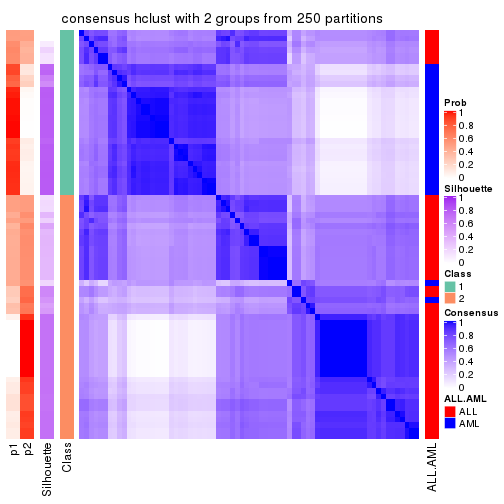
consensus_heatmap(res, k = 3)
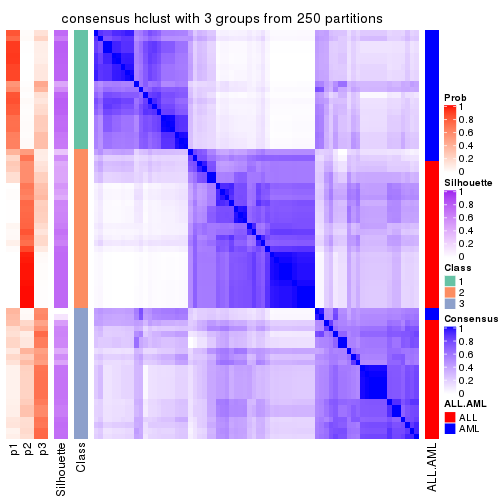
consensus_heatmap(res, k = 4)
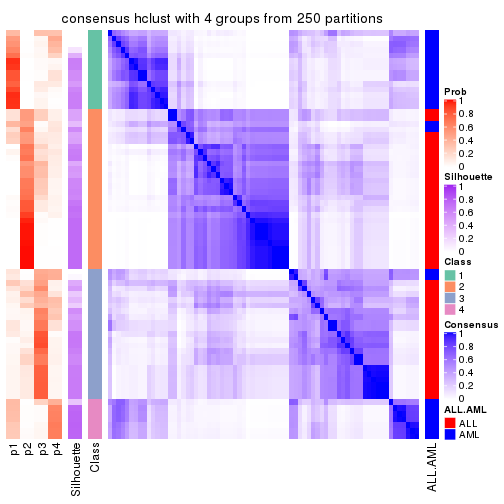
consensus_heatmap(res, k = 5)
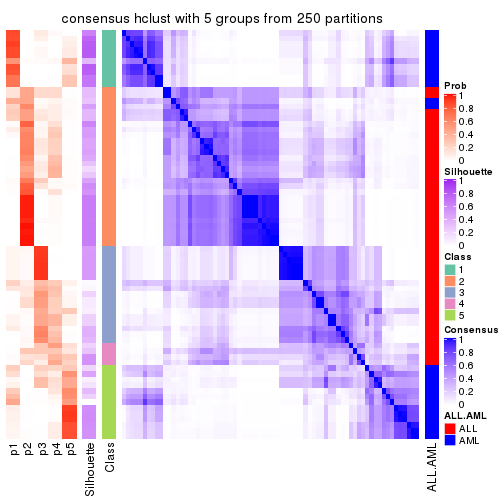
consensus_heatmap(res, k = 6)
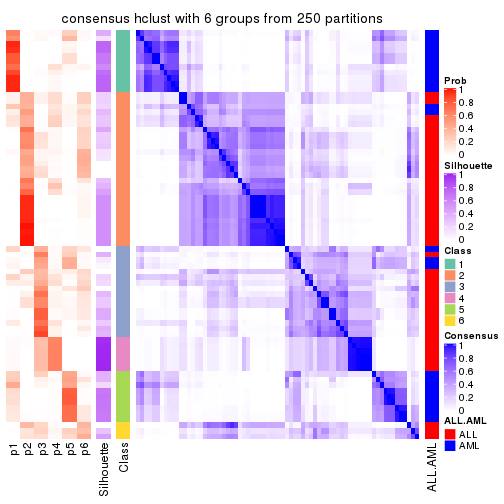
Heatmaps for the membership of samples in all partitions to see how consistent they are:
membership_heatmap(res, k = 2)
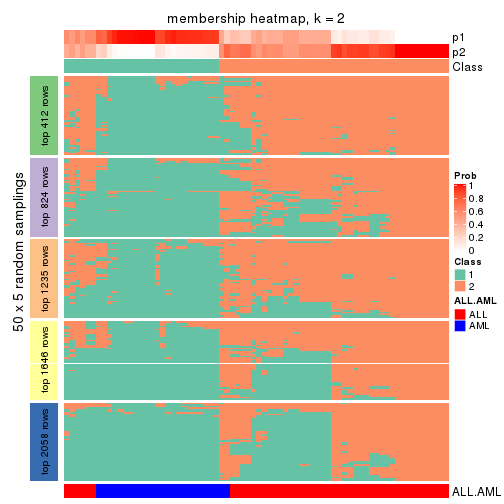
membership_heatmap(res, k = 3)
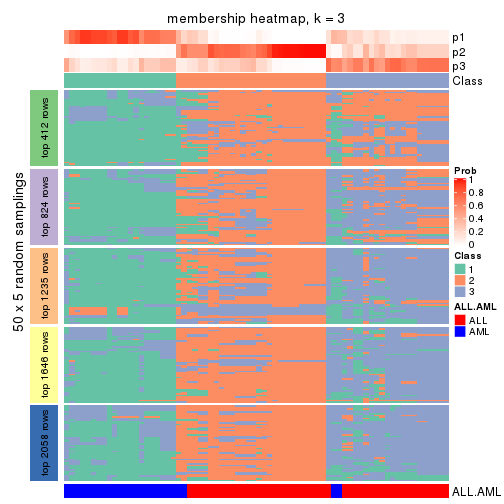
membership_heatmap(res, k = 4)
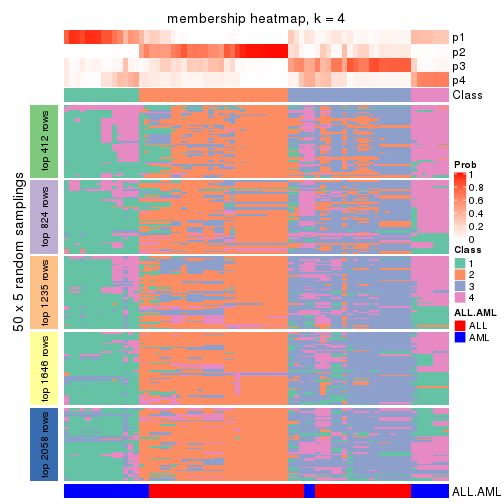
membership_heatmap(res, k = 5)
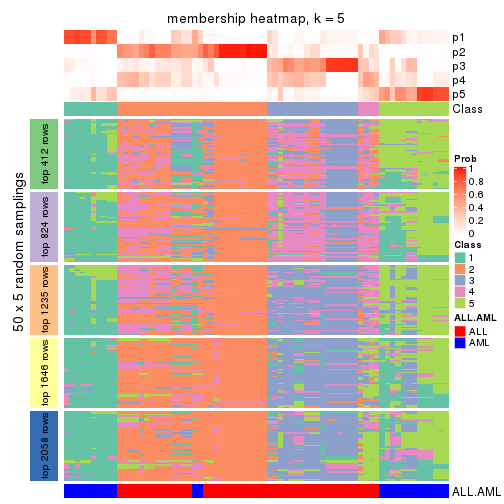
membership_heatmap(res, k = 6)
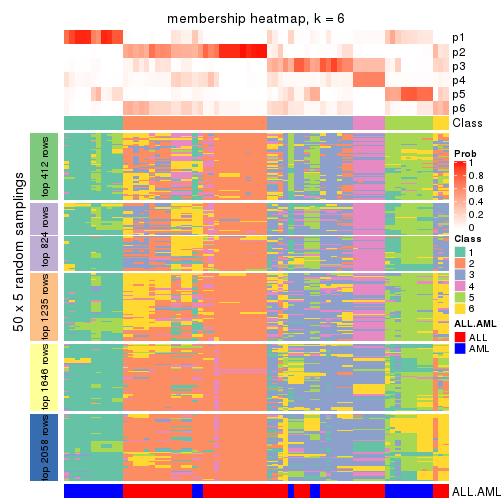
As soon as we have had the classes for columns, we can look for signatures which are significantly different between classes which can be candidate marks for certain classes. Following are the heatmaps for signatures.
Signature heatmaps where rows are scaled:
get_signatures(res, k = 2)
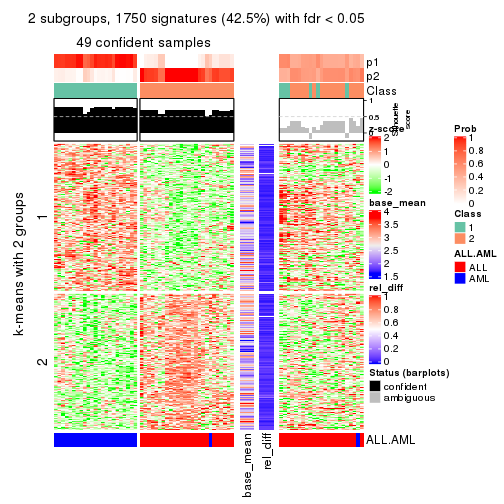
get_signatures(res, k = 3)
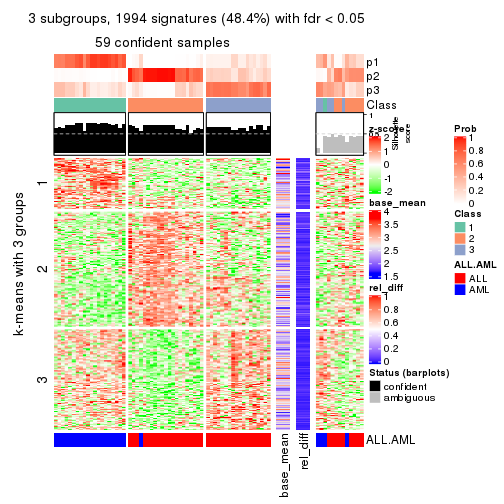
get_signatures(res, k = 4)
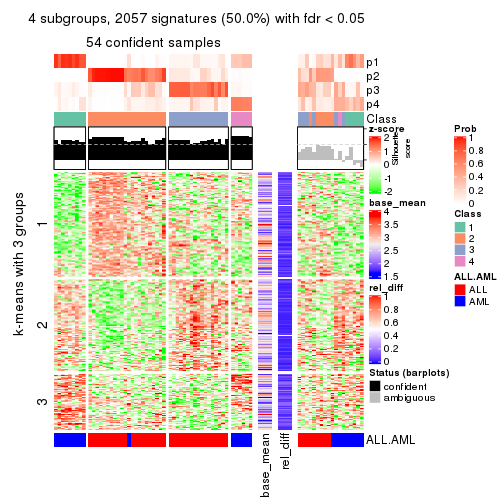
get_signatures(res, k = 5)
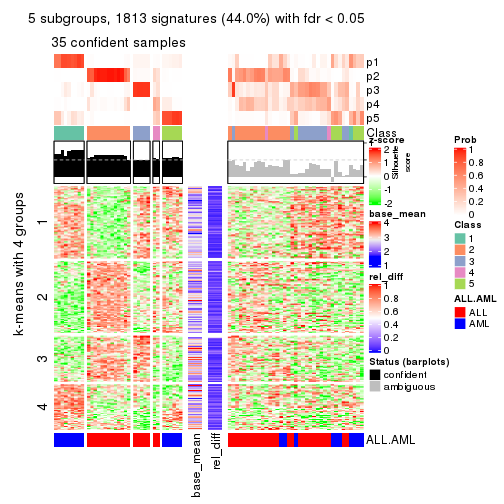
get_signatures(res, k = 6)
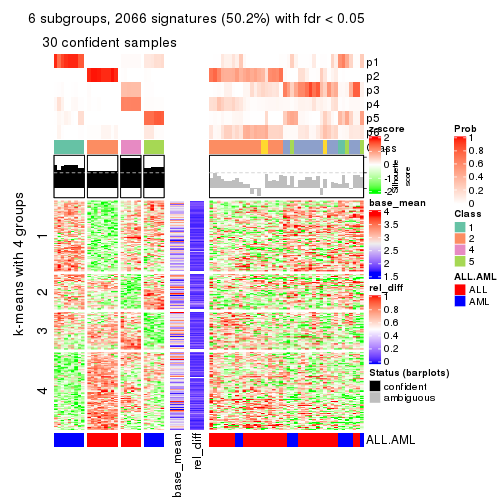
Signature heatmaps where rows are not scaled:
get_signatures(res, k = 2, scale_rows = FALSE)
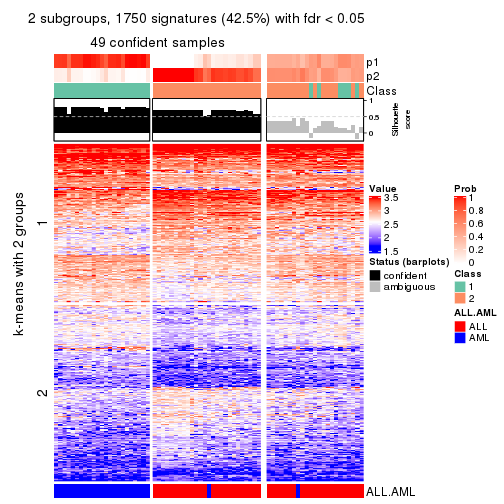
get_signatures(res, k = 3, scale_rows = FALSE)
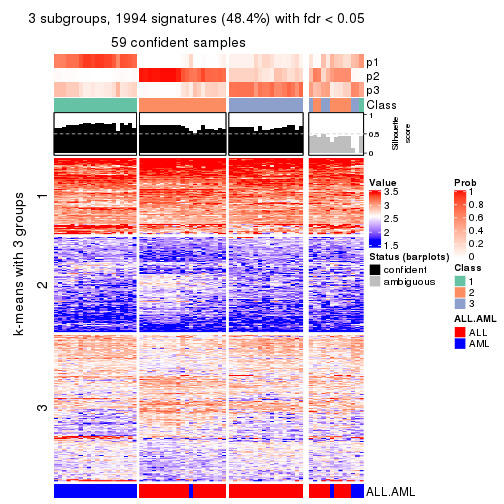
get_signatures(res, k = 4, scale_rows = FALSE)
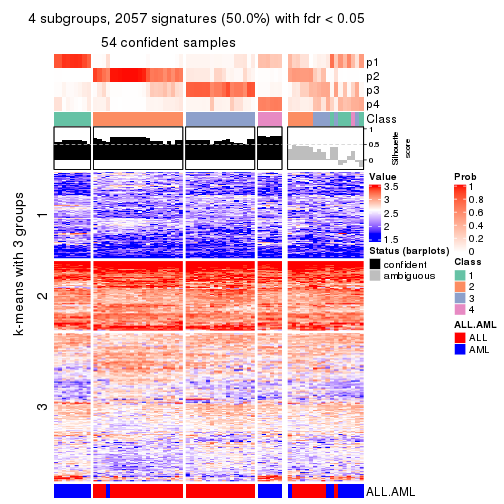
get_signatures(res, k = 5, scale_rows = FALSE)
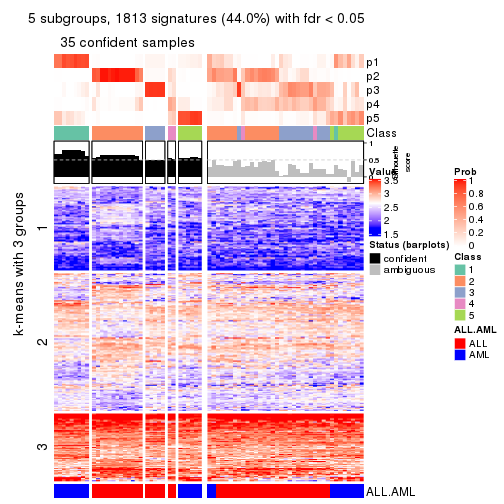
get_signatures(res, k = 6, scale_rows = FALSE)
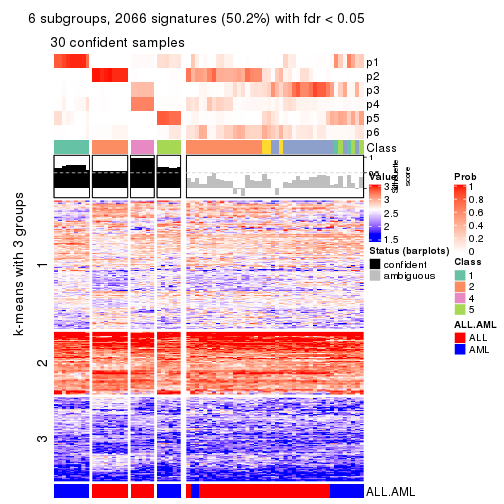
Compare the overlap of signatures from different k:
compare_signatures(res)
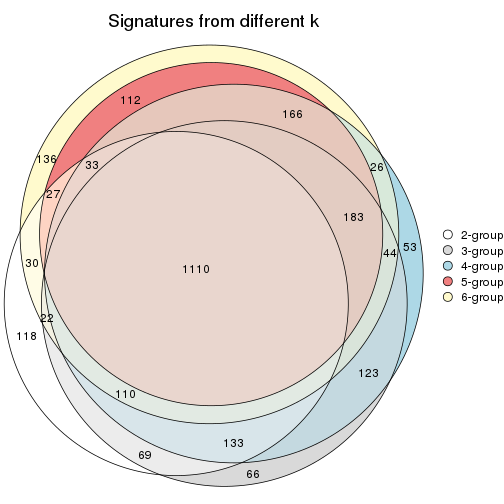
get_signature() returns a data frame invisibly. TO get the list of signatures, the function
call should be assigned to a variable explicitly. In following code, if plot argument is set
to FALSE, no heatmap is plotted while only the differential analysis is performed.
# code only for demonstration
tb = get_signature(res, k = ..., plot = FALSE)
An example of the output of tb is:
#> which_row fdr mean_1 mean_2 scaled_mean_1 scaled_mean_2 km
#> 1 38 0.042760348 8.373488 9.131774 -0.5533452 0.5164555 1
#> 2 40 0.018707592 7.106213 8.469186 -0.6173731 0.5762149 1
#> 3 55 0.019134737 10.221463 11.207825 -0.6159697 0.5749050 1
#> 4 59 0.006059896 5.921854 7.869574 -0.6899429 0.6439467 1
#> 5 60 0.018055526 8.928898 10.211722 -0.6204761 0.5791110 1
#> 6 98 0.009384629 15.714769 14.887706 0.6635654 -0.6193277 2
...
The columns in tb are:
which_row: row indices corresponding to the input matrix.fdr: FDR for the differential test. mean_x: The mean value in group x.scaled_mean_x: The mean value in group x after rows are scaled.km: Row groups if k-means clustering is applied to rows.UMAP plot which shows how samples are separated.
dimension_reduction(res, k = 2, method = "UMAP")
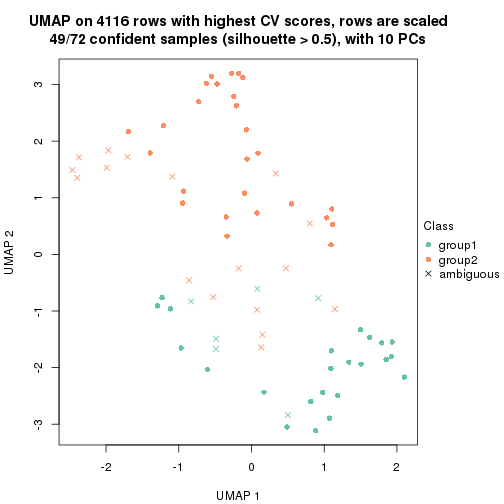
dimension_reduction(res, k = 3, method = "UMAP")
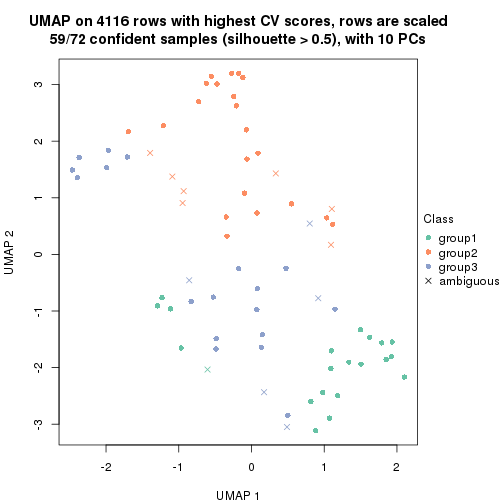
dimension_reduction(res, k = 4, method = "UMAP")
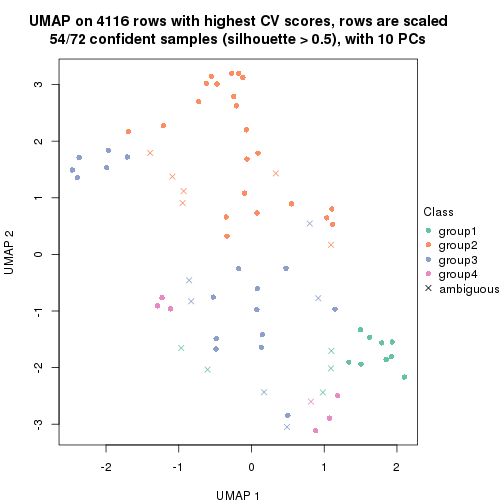
dimension_reduction(res, k = 5, method = "UMAP")
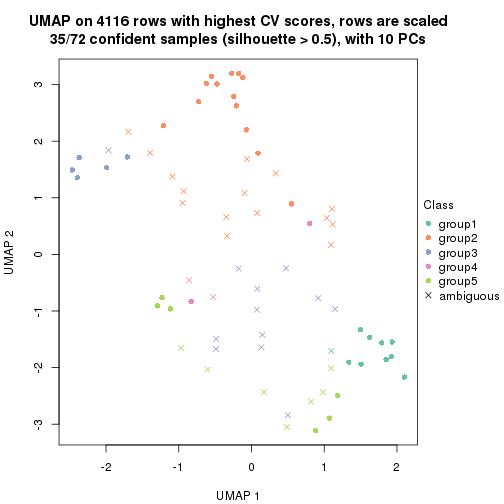
dimension_reduction(res, k = 6, method = "UMAP")
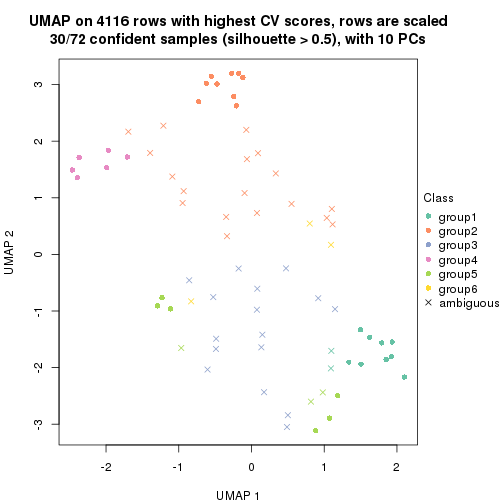
Following heatmap shows how subgroups are split when increasing k:
collect_classes(res)
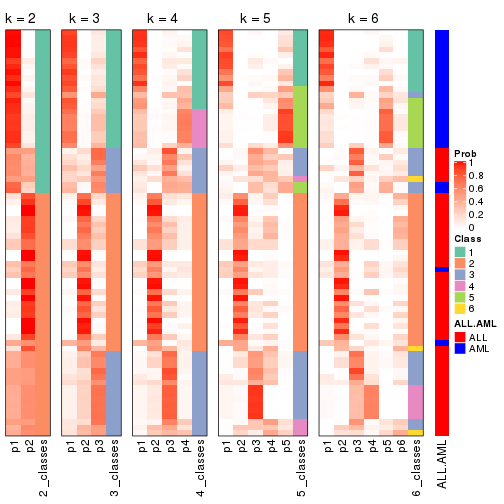
Test correlation between subgroups and known annotations. If the known annotation is numeric, one-way ANOVA test is applied, and if the known annotation is discrete, chi-squared contingency table test is applied.
test_to_known_factors(res)
#> n ALL.AML(p) k
#> CV:hclust 49 1.25e-10 2
#> CV:hclust 59 1.23e-12 3
#> CV:hclust 54 1.06e-10 4
#> CV:hclust 35 4.65e-07 5
#> CV:hclust 30 1.38e-06 6
If matrix rows can be associated to genes, consider to use functional_enrichment(res,
...) to perform function enrichment for the signature genes. See this vignette for more detailed explanations.
The object with results only for a single top-value method and a single partition method can be extracted as:
res = res_list["CV", "kmeans"]
# you can also extract it by
# res = res_list["CV:kmeans"]
A summary of res and all the functions that can be applied to it:
res
#> A 'ConsensusPartition' object with k = 2, 3, 4, 5, 6.
#> On a matrix with 4116 rows and 72 columns.
#> Top rows (412, 824, 1235, 1646, 2058) are extracted by 'CV' method.
#> Subgroups are detected by 'kmeans' method.
#> Performed in total 1250 partitions by row resampling.
#> Best k for subgroups seems to be 3.
#>
#> Following methods can be applied to this 'ConsensusPartition' object:
#> [1] "cola_report" "collect_classes" "collect_plots"
#> [4] "collect_stats" "colnames" "compare_signatures"
#> [7] "consensus_heatmap" "dimension_reduction" "functional_enrichment"
#> [10] "get_anno_col" "get_anno" "get_classes"
#> [13] "get_consensus" "get_matrix" "get_membership"
#> [16] "get_param" "get_signatures" "get_stats"
#> [19] "is_best_k" "is_stable_k" "membership_heatmap"
#> [22] "ncol" "nrow" "plot_ecdf"
#> [25] "rownames" "select_partition_number" "show"
#> [28] "suggest_best_k" "test_to_known_factors"
collect_plots() function collects all the plots made from res for all k (number of partitions)
into one single page to provide an easy and fast comparison between different k.
collect_plots(res)
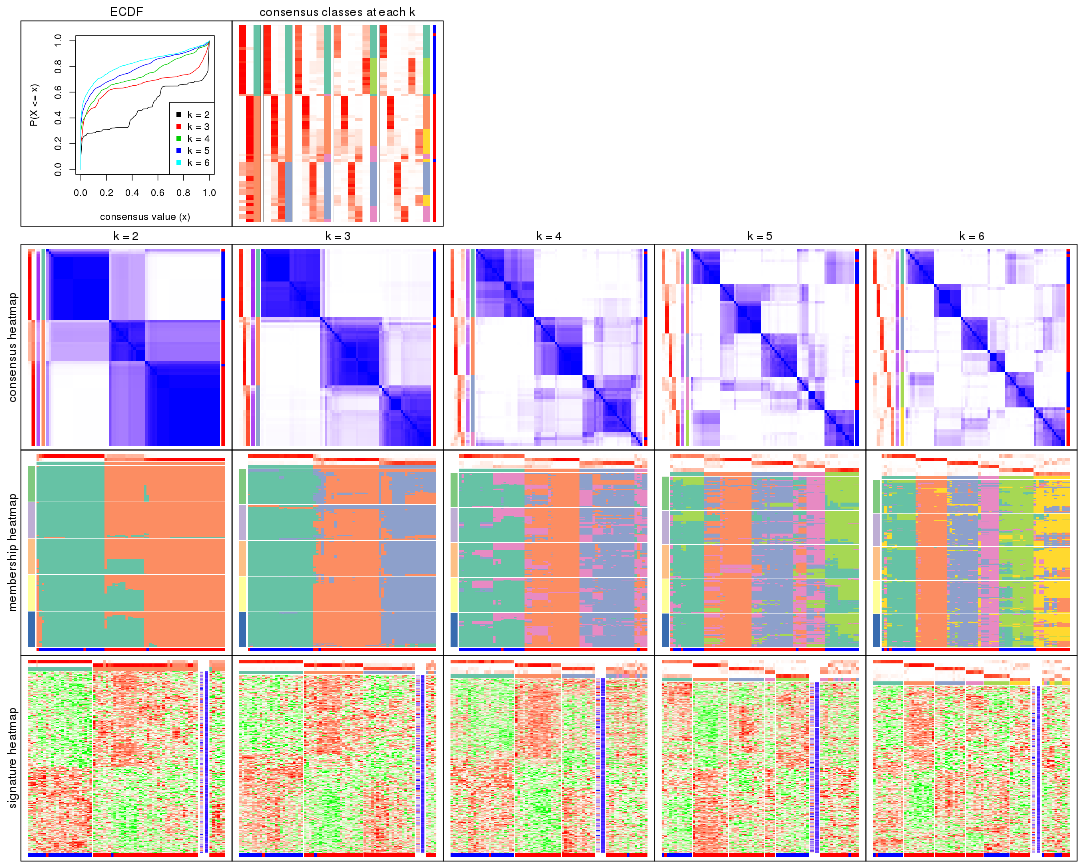
The plots are:
k and the heatmap of
predicted classes for each k.k.k.k.All the plots in panels can be made by individual functions and they are plotted later in this section.
select_partition_number() produces several plots showing different
statistics for choosing “optimized” k. There are following statistics:
k;k, the area increased is defined as \(A_k - A_{k-1}\).The detailed explanations of these statistics can be found in the cola vignette.
Generally speaking, lower PAC score, higher mean silhouette score or higher
concordance corresponds to better partition. Rand index and Jaccard index
measure how similar the current partition is compared to partition with k-1.
If they are too similar, we won't accept k is better than k-1.
select_partition_number(res)
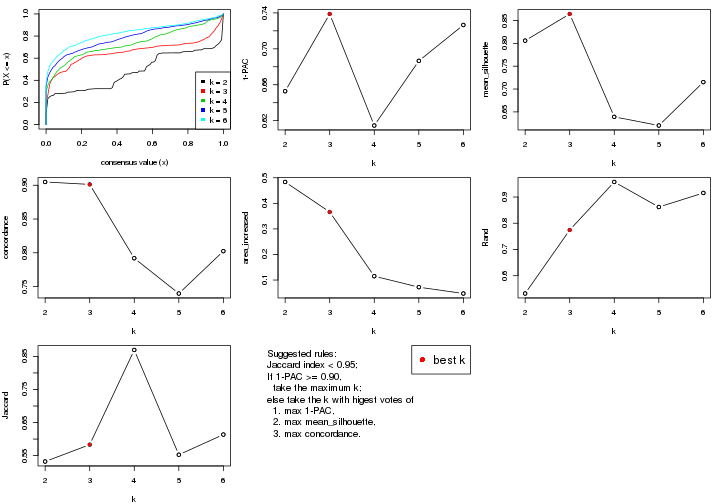
The numeric values for all these statistics can be obtained by get_stats().
get_stats(res)
#> k 1-PAC mean_silhouette concordance area_increased Rand Jaccard
#> 2 2 0.653 0.806 0.905 0.4836 0.532 0.532
#> 3 3 0.739 0.864 0.901 0.3661 0.774 0.583
#> 4 4 0.615 0.639 0.792 0.1150 0.957 0.869
#> 5 5 0.687 0.620 0.740 0.0721 0.862 0.553
#> 6 6 0.727 0.715 0.802 0.0472 0.915 0.614
suggest_best_k() suggests the best \(k\) based on these statistics. The rules are as follows:
suggest_best_k(res)
#> [1] 3
Following shows the table of the partitions (You need to click the show/hide
code output link to see it). The membership matrix (columns with name p*)
is inferred by
clue::cl_consensus()
function with the SE method. Basically the value in the membership matrix
represents the probability to belong to a certain group. The finall class
label for an item is determined with the group with highest probability it
belongs to.
In get_classes() function, the entropy is calculated from the membership
matrix and the silhouette score is calculated from the consensus matrix.
cbind(get_classes(res, k = 2), get_membership(res, k = 2))
#> class entropy silhouette p1 p2
#> sample_39 2 0.9754 0.5141 0.408 0.592
#> sample_40 2 0.9850 0.4780 0.428 0.572
#> sample_42 2 0.0000 0.8470 0.000 1.000
#> sample_47 2 0.0000 0.8470 0.000 1.000
#> sample_48 2 0.0000 0.8470 0.000 1.000
#> sample_49 2 0.9896 0.4537 0.440 0.560
#> sample_41 2 0.0000 0.8470 0.000 1.000
#> sample_43 2 0.0000 0.8470 0.000 1.000
#> sample_44 2 0.0376 0.8459 0.004 0.996
#> sample_45 2 0.0000 0.8470 0.000 1.000
#> sample_46 2 0.0000 0.8470 0.000 1.000
#> sample_70 2 0.1184 0.8426 0.016 0.984
#> sample_71 2 0.0000 0.8470 0.000 1.000
#> sample_72 2 0.0000 0.8470 0.000 1.000
#> sample_68 2 0.0000 0.8470 0.000 1.000
#> sample_69 2 0.0000 0.8470 0.000 1.000
#> sample_67 1 0.9988 0.0928 0.520 0.480
#> sample_55 2 0.9635 0.5459 0.388 0.612
#> sample_56 2 0.9775 0.5071 0.412 0.588
#> sample_59 2 0.0376 0.8459 0.004 0.996
#> sample_52 1 0.0376 0.9659 0.996 0.004
#> sample_53 1 0.0376 0.9659 0.996 0.004
#> sample_51 1 0.0376 0.9659 0.996 0.004
#> sample_50 1 0.0376 0.9659 0.996 0.004
#> sample_54 1 0.2603 0.9261 0.956 0.044
#> sample_57 1 0.0000 0.9643 1.000 0.000
#> sample_58 1 0.0000 0.9643 1.000 0.000
#> sample_60 1 0.0376 0.9659 0.996 0.004
#> sample_61 1 0.0000 0.9643 1.000 0.000
#> sample_65 1 0.0000 0.9643 1.000 0.000
#> sample_66 2 0.2603 0.8181 0.044 0.956
#> sample_63 1 0.0376 0.9659 0.996 0.004
#> sample_64 1 0.0000 0.9643 1.000 0.000
#> sample_62 1 0.0376 0.9659 0.996 0.004
#> sample_1 2 0.1843 0.8376 0.028 0.972
#> sample_2 2 0.5059 0.7626 0.112 0.888
#> sample_3 2 0.9580 0.5576 0.380 0.620
#> sample_4 2 0.1414 0.8411 0.020 0.980
#> sample_5 2 0.0000 0.8470 0.000 1.000
#> sample_6 2 0.9580 0.5576 0.380 0.620
#> sample_7 2 0.9580 0.5575 0.380 0.620
#> sample_8 2 0.9881 0.4623 0.436 0.564
#> sample_9 2 0.0376 0.8459 0.004 0.996
#> sample_10 2 0.9580 0.5576 0.380 0.620
#> sample_11 2 0.0000 0.8470 0.000 1.000
#> sample_12 1 0.0376 0.9659 0.996 0.004
#> sample_13 2 0.0000 0.8470 0.000 1.000
#> sample_14 2 0.0000 0.8470 0.000 1.000
#> sample_15 2 0.0000 0.8470 0.000 1.000
#> sample_16 2 0.0376 0.8459 0.004 0.996
#> sample_17 2 0.0000 0.8470 0.000 1.000
#> sample_18 2 0.7883 0.6990 0.236 0.764
#> sample_19 2 0.0000 0.8470 0.000 1.000
#> sample_20 2 0.0000 0.8470 0.000 1.000
#> sample_21 2 0.0000 0.8470 0.000 1.000
#> sample_22 2 0.9881 0.4624 0.436 0.564
#> sample_23 2 0.9580 0.5576 0.380 0.620
#> sample_24 2 0.0000 0.8470 0.000 1.000
#> sample_25 2 0.9460 0.5722 0.364 0.636
#> sample_26 2 0.0376 0.8459 0.004 0.996
#> sample_27 2 0.9896 0.4537 0.440 0.560
#> sample_34 1 0.0000 0.9643 1.000 0.000
#> sample_35 1 0.0000 0.9643 1.000 0.000
#> sample_36 1 0.0376 0.9659 0.996 0.004
#> sample_37 1 0.0376 0.9659 0.996 0.004
#> sample_38 1 0.0376 0.9659 0.996 0.004
#> sample_28 1 0.0376 0.9659 0.996 0.004
#> sample_29 1 0.6531 0.7554 0.832 0.168
#> sample_30 1 0.0376 0.9659 0.996 0.004
#> sample_31 1 0.0000 0.9643 1.000 0.000
#> sample_32 1 0.0376 0.9659 0.996 0.004
#> sample_33 1 0.0376 0.9659 0.996 0.004
cbind(get_classes(res, k = 3), get_membership(res, k = 3))
#> class entropy silhouette p1 p2 p3
#> sample_39 3 0.4741 0.884 0.020 0.152 0.828
#> sample_40 3 0.4349 0.891 0.020 0.128 0.852
#> sample_42 2 0.2096 0.874 0.004 0.944 0.052
#> sample_47 2 0.0424 0.895 0.000 0.992 0.008
#> sample_48 2 0.0000 0.896 0.000 1.000 0.000
#> sample_49 3 0.4349 0.891 0.020 0.128 0.852
#> sample_41 2 0.0592 0.894 0.000 0.988 0.012
#> sample_43 2 0.0592 0.894 0.000 0.988 0.012
#> sample_44 2 0.2537 0.841 0.000 0.920 0.080
#> sample_45 2 0.0592 0.894 0.000 0.988 0.012
#> sample_46 2 0.0592 0.894 0.000 0.988 0.012
#> sample_70 3 0.4555 0.853 0.000 0.200 0.800
#> sample_71 2 0.3573 0.828 0.004 0.876 0.120
#> sample_72 2 0.3112 0.837 0.004 0.900 0.096
#> sample_68 2 0.0592 0.894 0.000 0.988 0.012
#> sample_69 2 0.0000 0.896 0.000 1.000 0.000
#> sample_67 2 0.8671 0.187 0.416 0.480 0.104
#> sample_55 3 0.4280 0.889 0.020 0.124 0.856
#> sample_56 3 0.4418 0.890 0.020 0.132 0.848
#> sample_59 3 0.5905 0.661 0.000 0.352 0.648
#> sample_52 1 0.0747 0.975 0.984 0.000 0.016
#> sample_53 1 0.1289 0.975 0.968 0.000 0.032
#> sample_51 1 0.1289 0.975 0.968 0.000 0.032
#> sample_50 1 0.1289 0.975 0.968 0.000 0.032
#> sample_54 1 0.1525 0.969 0.964 0.004 0.032
#> sample_57 1 0.1289 0.970 0.968 0.000 0.032
#> sample_58 1 0.1163 0.972 0.972 0.000 0.028
#> sample_60 1 0.1289 0.970 0.968 0.000 0.032
#> sample_61 1 0.0892 0.973 0.980 0.000 0.020
#> sample_65 1 0.0592 0.975 0.988 0.000 0.012
#> sample_66 2 0.6511 0.723 0.072 0.748 0.180
#> sample_63 1 0.0747 0.975 0.984 0.000 0.016
#> sample_64 1 0.1753 0.960 0.952 0.000 0.048
#> sample_62 1 0.0747 0.975 0.984 0.000 0.016
#> sample_1 3 0.4293 0.881 0.004 0.164 0.832
#> sample_2 2 0.8568 0.557 0.200 0.608 0.192
#> sample_3 3 0.2550 0.852 0.012 0.056 0.932
#> sample_4 3 0.4291 0.868 0.000 0.180 0.820
#> sample_5 2 0.0592 0.894 0.000 0.988 0.012
#> sample_6 3 0.2550 0.852 0.012 0.056 0.932
#> sample_7 3 0.4349 0.889 0.020 0.128 0.852
#> sample_8 3 0.4418 0.890 0.020 0.132 0.848
#> sample_9 3 0.3192 0.831 0.000 0.112 0.888
#> sample_10 3 0.2550 0.852 0.012 0.056 0.932
#> sample_11 3 0.6460 0.126 0.004 0.440 0.556
#> sample_12 1 0.1878 0.967 0.952 0.004 0.044
#> sample_13 2 0.0000 0.896 0.000 1.000 0.000
#> sample_14 2 0.6204 0.323 0.000 0.576 0.424
#> sample_15 2 0.0592 0.894 0.000 0.988 0.012
#> sample_16 2 0.1031 0.888 0.000 0.976 0.024
#> sample_17 2 0.3619 0.811 0.000 0.864 0.136
#> sample_18 3 0.4099 0.887 0.008 0.140 0.852
#> sample_19 2 0.0592 0.894 0.000 0.988 0.012
#> sample_20 2 0.0000 0.896 0.000 1.000 0.000
#> sample_21 2 0.0892 0.893 0.000 0.980 0.020
#> sample_22 3 0.4618 0.890 0.024 0.136 0.840
#> sample_23 3 0.2550 0.852 0.012 0.056 0.932
#> sample_24 2 0.1031 0.891 0.000 0.976 0.024
#> sample_25 3 0.5763 0.802 0.016 0.244 0.740
#> sample_26 3 0.6307 0.318 0.000 0.488 0.512
#> sample_27 3 0.4349 0.891 0.020 0.128 0.852
#> sample_34 1 0.0592 0.975 0.988 0.000 0.012
#> sample_35 1 0.1753 0.958 0.952 0.000 0.048
#> sample_36 1 0.1289 0.975 0.968 0.000 0.032
#> sample_37 1 0.1289 0.975 0.968 0.000 0.032
#> sample_38 1 0.1289 0.975 0.968 0.000 0.032
#> sample_28 1 0.1289 0.975 0.968 0.000 0.032
#> sample_29 1 0.1950 0.966 0.952 0.008 0.040
#> sample_30 1 0.1289 0.975 0.968 0.000 0.032
#> sample_31 1 0.0592 0.975 0.988 0.000 0.012
#> sample_32 1 0.1163 0.976 0.972 0.000 0.028
#> sample_33 1 0.1289 0.975 0.968 0.000 0.032
cbind(get_classes(res, k = 4), get_membership(res, k = 4))
#> class entropy silhouette p1 p2 p3 p4
#> sample_39 3 0.3862 0.6979 0.004 0.060 0.852 0.084
#> sample_40 3 0.2275 0.7284 0.004 0.048 0.928 0.020
#> sample_42 2 0.6859 0.4052 0.000 0.512 0.108 0.380
#> sample_47 2 0.4916 0.6973 0.000 0.760 0.056 0.184
#> sample_48 2 0.0188 0.7704 0.000 0.996 0.004 0.000
#> sample_49 3 0.2189 0.7273 0.004 0.044 0.932 0.020
#> sample_41 2 0.0336 0.7695 0.000 0.992 0.008 0.000
#> sample_43 2 0.5727 0.6630 0.000 0.704 0.096 0.200
#> sample_44 2 0.6433 0.5985 0.000 0.648 0.164 0.188
#> sample_45 2 0.5371 0.6837 0.000 0.732 0.080 0.188
#> sample_46 2 0.5371 0.6834 0.000 0.732 0.080 0.188
#> sample_70 3 0.5750 0.5693 0.000 0.088 0.696 0.216
#> sample_71 2 0.7153 0.1473 0.000 0.444 0.132 0.424
#> sample_72 2 0.7210 0.2852 0.000 0.492 0.148 0.360
#> sample_68 2 0.0336 0.7695 0.000 0.992 0.008 0.000
#> sample_69 2 0.0000 0.7699 0.000 1.000 0.000 0.000
#> sample_67 4 0.7188 0.3021 0.260 0.156 0.008 0.576
#> sample_55 3 0.2585 0.7225 0.004 0.048 0.916 0.032
#> sample_56 3 0.2486 0.7269 0.004 0.048 0.920 0.028
#> sample_59 3 0.6602 0.4641 0.000 0.164 0.628 0.208
#> sample_52 1 0.2125 0.7785 0.920 0.000 0.004 0.076
#> sample_53 1 0.3873 0.7780 0.772 0.000 0.000 0.228
#> sample_51 1 0.3764 0.7833 0.784 0.000 0.000 0.216
#> sample_50 1 0.3726 0.7848 0.788 0.000 0.000 0.212
#> sample_54 1 0.4483 0.7277 0.808 0.000 0.088 0.104
#> sample_57 1 0.4362 0.7330 0.816 0.000 0.088 0.096
#> sample_58 1 0.4297 0.7363 0.820 0.000 0.084 0.096
#> sample_60 1 0.4424 0.7306 0.812 0.000 0.088 0.100
#> sample_61 1 0.4083 0.7680 0.832 0.000 0.100 0.068
#> sample_65 1 0.0524 0.7961 0.988 0.000 0.004 0.008
#> sample_66 4 0.6740 0.1799 0.028 0.336 0.052 0.584
#> sample_63 1 0.2775 0.7722 0.896 0.000 0.020 0.084
#> sample_64 1 0.4483 0.7260 0.808 0.000 0.104 0.088
#> sample_62 1 0.2775 0.7722 0.896 0.000 0.020 0.084
#> sample_1 3 0.2892 0.7246 0.000 0.068 0.896 0.036
#> sample_2 4 0.5775 0.5531 0.056 0.144 0.048 0.752
#> sample_3 3 0.4917 0.3512 0.000 0.008 0.656 0.336
#> sample_4 3 0.2924 0.7125 0.000 0.100 0.884 0.016
#> sample_5 2 0.0336 0.7695 0.000 0.992 0.008 0.000
#> sample_6 3 0.4936 0.3457 0.000 0.008 0.652 0.340
#> sample_7 3 0.2021 0.7288 0.000 0.056 0.932 0.012
#> sample_8 3 0.1888 0.7313 0.000 0.044 0.940 0.016
#> sample_9 3 0.5738 0.0635 0.000 0.028 0.540 0.432
#> sample_10 3 0.5244 0.1210 0.000 0.008 0.556 0.436
#> sample_11 4 0.6889 0.2147 0.000 0.108 0.396 0.496
#> sample_12 1 0.5496 0.7253 0.704 0.000 0.064 0.232
#> sample_13 2 0.0188 0.7704 0.000 0.996 0.004 0.000
#> sample_14 4 0.7617 0.3447 0.000 0.216 0.332 0.452
#> sample_15 2 0.0336 0.7695 0.000 0.992 0.008 0.000
#> sample_16 2 0.2542 0.7303 0.000 0.904 0.084 0.012
#> sample_17 2 0.4636 0.5673 0.000 0.792 0.068 0.140
#> sample_18 3 0.3274 0.7259 0.004 0.056 0.884 0.056
#> sample_19 2 0.5448 0.6790 0.000 0.724 0.080 0.196
#> sample_20 2 0.0188 0.7704 0.000 0.996 0.004 0.000
#> sample_21 2 0.0336 0.7695 0.000 0.992 0.008 0.000
#> sample_22 3 0.3629 0.7130 0.008 0.048 0.868 0.076
#> sample_23 3 0.4936 0.3457 0.000 0.008 0.652 0.340
#> sample_24 2 0.0592 0.7638 0.000 0.984 0.016 0.000
#> sample_25 3 0.6852 0.3729 0.000 0.124 0.556 0.320
#> sample_26 3 0.7110 0.3599 0.000 0.236 0.564 0.200
#> sample_27 3 0.2189 0.7273 0.004 0.044 0.932 0.020
#> sample_34 1 0.0376 0.7946 0.992 0.000 0.004 0.004
#> sample_35 1 0.3606 0.7352 0.844 0.000 0.132 0.024
#> sample_36 1 0.3688 0.7874 0.792 0.000 0.000 0.208
#> sample_37 1 0.3907 0.7759 0.768 0.000 0.000 0.232
#> sample_38 1 0.4522 0.6999 0.680 0.000 0.000 0.320
#> sample_28 1 0.4304 0.7371 0.716 0.000 0.000 0.284
#> sample_29 1 0.4730 0.6386 0.636 0.000 0.000 0.364
#> sample_30 1 0.3726 0.7865 0.788 0.000 0.000 0.212
#> sample_31 1 0.0376 0.7957 0.992 0.000 0.004 0.004
#> sample_32 1 0.3688 0.7862 0.792 0.000 0.000 0.208
#> sample_33 1 0.3837 0.7798 0.776 0.000 0.000 0.224
cbind(get_classes(res, k = 5), get_membership(res, k = 5))
#> class entropy silhouette p1 p2 p3 p4 p5
#> sample_39 3 0.3209 0.7389 0.076 0.004 0.860 0.060 0.000
#> sample_40 3 0.1372 0.7812 0.000 0.004 0.956 0.024 0.016
#> sample_42 4 0.8118 -0.0569 0.316 0.268 0.096 0.320 0.000
#> sample_47 2 0.7058 0.5161 0.236 0.552 0.076 0.136 0.000
#> sample_48 2 0.0451 0.7611 0.008 0.988 0.000 0.004 0.000
#> sample_49 3 0.0968 0.7812 0.000 0.004 0.972 0.012 0.012
#> sample_41 2 0.0290 0.7584 0.000 0.992 0.000 0.008 0.000
#> sample_43 2 0.7623 0.4382 0.272 0.476 0.108 0.144 0.000
#> sample_44 2 0.8027 0.3612 0.220 0.432 0.220 0.128 0.000
#> sample_45 2 0.7086 0.5262 0.220 0.560 0.092 0.128 0.000
#> sample_46 2 0.7163 0.5198 0.212 0.556 0.100 0.132 0.000
#> sample_70 3 0.5869 0.5489 0.216 0.008 0.628 0.148 0.000
#> sample_71 4 0.7943 0.1098 0.224 0.268 0.096 0.412 0.000
#> sample_72 4 0.8150 0.0456 0.216 0.288 0.120 0.376 0.000
#> sample_68 2 0.0290 0.7584 0.000 0.992 0.000 0.008 0.000
#> sample_69 2 0.0613 0.7596 0.008 0.984 0.004 0.004 0.000
#> sample_67 1 0.6532 -0.0737 0.492 0.064 0.004 0.396 0.044
#> sample_55 3 0.3822 0.7498 0.032 0.024 0.852 0.060 0.032
#> sample_56 3 0.1220 0.7883 0.004 0.004 0.964 0.020 0.008
#> sample_59 3 0.7082 0.4977 0.224 0.032 0.564 0.160 0.020
#> sample_52 5 0.0880 0.7775 0.032 0.000 0.000 0.000 0.968
#> sample_53 1 0.4030 0.8121 0.648 0.000 0.000 0.000 0.352
#> sample_51 1 0.4030 0.8121 0.648 0.000 0.000 0.000 0.352
#> sample_50 1 0.4030 0.8121 0.648 0.000 0.000 0.000 0.352
#> sample_54 5 0.2772 0.7412 0.044 0.000 0.028 0.032 0.896
#> sample_57 5 0.1399 0.7784 0.000 0.000 0.028 0.020 0.952
#> sample_58 5 0.1195 0.7803 0.000 0.000 0.028 0.012 0.960
#> sample_60 5 0.2772 0.7412 0.044 0.000 0.028 0.032 0.896
#> sample_61 5 0.5305 0.5282 0.248 0.000 0.052 0.024 0.676
#> sample_65 5 0.3826 0.5470 0.236 0.000 0.004 0.008 0.752
#> sample_66 4 0.6396 0.3114 0.256 0.172 0.012 0.560 0.000
#> sample_63 5 0.0703 0.7807 0.024 0.000 0.000 0.000 0.976
#> sample_64 5 0.2956 0.7492 0.020 0.000 0.096 0.012 0.872
#> sample_62 5 0.0703 0.7807 0.024 0.000 0.000 0.000 0.976
#> sample_1 3 0.0912 0.7860 0.000 0.012 0.972 0.016 0.000
#> sample_2 4 0.5200 0.4249 0.296 0.060 0.004 0.640 0.000
#> sample_3 4 0.4256 0.2750 0.000 0.000 0.436 0.564 0.000
#> sample_4 3 0.2747 0.7442 0.004 0.060 0.888 0.048 0.000
#> sample_5 2 0.0290 0.7584 0.000 0.992 0.000 0.008 0.000
#> sample_6 4 0.4256 0.2750 0.000 0.000 0.436 0.564 0.000
#> sample_7 3 0.1978 0.7712 0.004 0.024 0.928 0.044 0.000
#> sample_8 3 0.0324 0.7884 0.000 0.004 0.992 0.004 0.000
#> sample_9 4 0.3851 0.5185 0.004 0.016 0.212 0.768 0.000
#> sample_10 4 0.3366 0.5048 0.000 0.000 0.232 0.768 0.000
#> sample_11 4 0.3651 0.5369 0.004 0.028 0.160 0.808 0.000
#> sample_12 1 0.5912 0.6656 0.584 0.000 0.068 0.024 0.324
#> sample_13 2 0.0451 0.7611 0.008 0.988 0.000 0.004 0.000
#> sample_14 4 0.4127 0.5363 0.004 0.100 0.100 0.796 0.000
#> sample_15 2 0.0290 0.7584 0.000 0.992 0.000 0.008 0.000
#> sample_16 2 0.3222 0.7014 0.028 0.864 0.088 0.020 0.000
#> sample_17 2 0.4039 0.4807 0.008 0.720 0.004 0.268 0.000
#> sample_18 3 0.4607 0.7164 0.060 0.024 0.796 0.104 0.016
#> sample_19 2 0.7576 0.4716 0.220 0.508 0.128 0.144 0.000
#> sample_20 2 0.0451 0.7611 0.008 0.988 0.000 0.004 0.000
#> sample_21 2 0.0798 0.7575 0.008 0.976 0.000 0.016 0.000
#> sample_22 3 0.1750 0.7732 0.028 0.000 0.936 0.036 0.000
#> sample_23 4 0.4256 0.2750 0.000 0.000 0.436 0.564 0.000
#> sample_24 2 0.0451 0.7565 0.000 0.988 0.004 0.008 0.000
#> sample_25 3 0.6875 0.3827 0.288 0.032 0.516 0.164 0.000
#> sample_26 3 0.6627 0.5105 0.188 0.056 0.604 0.152 0.000
#> sample_27 3 0.0968 0.7812 0.000 0.004 0.972 0.012 0.012
#> sample_34 5 0.3751 0.5919 0.212 0.000 0.004 0.012 0.772
#> sample_35 5 0.5380 0.6363 0.132 0.000 0.160 0.012 0.696
#> sample_36 1 0.4101 0.7998 0.628 0.000 0.000 0.000 0.372
#> sample_37 1 0.4015 0.8129 0.652 0.000 0.000 0.000 0.348
#> sample_38 1 0.3849 0.7400 0.752 0.000 0.000 0.016 0.232
#> sample_28 1 0.3885 0.7720 0.724 0.000 0.000 0.008 0.268
#> sample_29 1 0.4558 0.6924 0.724 0.000 0.000 0.060 0.216
#> sample_30 1 0.4088 0.8040 0.632 0.000 0.000 0.000 0.368
#> sample_31 5 0.3883 0.5293 0.244 0.000 0.004 0.008 0.744
#> sample_32 1 0.4613 0.7227 0.580 0.000 0.004 0.008 0.408
#> sample_33 1 0.4015 0.8129 0.652 0.000 0.000 0.000 0.348
cbind(get_classes(res, k = 6), get_membership(res, k = 6))
#> class entropy silhouette p1 p2 p3 p4 p5 p6
#> sample_39 3 0.2892 0.7603 0.000 0.004 0.840 0.000 0.020 0.136
#> sample_40 3 0.2198 0.8682 0.000 0.000 0.912 0.032 0.032 0.024
#> sample_42 6 0.4432 0.6129 0.036 0.068 0.040 0.048 0.008 0.800
#> sample_47 6 0.4680 0.6132 0.000 0.292 0.052 0.004 0.004 0.648
#> sample_48 2 0.0713 0.9332 0.000 0.972 0.000 0.000 0.000 0.028
#> sample_49 3 0.1476 0.8913 0.000 0.004 0.948 0.012 0.028 0.008
#> sample_41 2 0.0291 0.9371 0.000 0.992 0.004 0.004 0.000 0.000
#> sample_43 6 0.4516 0.6834 0.000 0.184 0.084 0.000 0.012 0.720
#> sample_44 6 0.5457 0.6627 0.000 0.212 0.176 0.000 0.008 0.604
#> sample_45 6 0.5093 0.6233 0.000 0.292 0.088 0.000 0.008 0.612
#> sample_46 6 0.5076 0.6275 0.000 0.288 0.088 0.000 0.008 0.616
#> sample_70 6 0.4512 0.4386 0.000 0.008 0.380 0.008 0.012 0.592
#> sample_71 6 0.6837 0.4611 0.048 0.088 0.044 0.176 0.036 0.608
#> sample_72 6 0.6961 0.4832 0.048 0.100 0.052 0.160 0.036 0.604
#> sample_68 2 0.0291 0.9371 0.000 0.992 0.004 0.004 0.000 0.000
#> sample_69 2 0.0865 0.9292 0.000 0.964 0.000 0.000 0.000 0.036
#> sample_67 1 0.6975 0.0659 0.400 0.020 0.000 0.236 0.028 0.316
#> sample_55 3 0.3855 0.8206 0.000 0.024 0.824 0.028 0.076 0.048
#> sample_56 3 0.1223 0.8934 0.000 0.004 0.960 0.008 0.016 0.012
#> sample_59 6 0.5026 0.4806 0.000 0.012 0.324 0.012 0.040 0.612
#> sample_52 5 0.2924 0.7425 0.136 0.000 0.000 0.012 0.840 0.012
#> sample_53 1 0.1606 0.8214 0.932 0.000 0.000 0.008 0.056 0.004
#> sample_51 1 0.1204 0.8206 0.944 0.000 0.000 0.000 0.056 0.000
#> sample_50 1 0.1204 0.8194 0.944 0.000 0.000 0.000 0.056 0.000
#> sample_54 5 0.2768 0.7228 0.044 0.000 0.008 0.008 0.880 0.060
#> sample_57 5 0.2594 0.7365 0.068 0.000 0.004 0.004 0.884 0.040
#> sample_58 5 0.3318 0.7457 0.076 0.000 0.012 0.024 0.852 0.036
#> sample_60 5 0.2656 0.7235 0.044 0.000 0.008 0.004 0.884 0.060
#> sample_61 5 0.6624 0.4038 0.376 0.000 0.052 0.036 0.464 0.072
#> sample_65 5 0.5554 0.4700 0.404 0.000 0.008 0.032 0.512 0.044
#> sample_66 6 0.6614 0.2286 0.092 0.060 0.000 0.292 0.028 0.528
#> sample_63 5 0.2784 0.7449 0.132 0.000 0.000 0.008 0.848 0.012
#> sample_64 5 0.4755 0.7214 0.076 0.000 0.072 0.032 0.768 0.052
#> sample_62 5 0.2742 0.7452 0.128 0.000 0.000 0.008 0.852 0.012
#> sample_1 3 0.1425 0.8898 0.000 0.008 0.952 0.020 0.008 0.012
#> sample_2 4 0.6657 0.2441 0.172 0.020 0.000 0.484 0.028 0.296
#> sample_3 4 0.3101 0.7437 0.000 0.000 0.244 0.756 0.000 0.000
#> sample_4 3 0.2334 0.8734 0.000 0.044 0.904 0.040 0.004 0.008
#> sample_5 2 0.0291 0.9371 0.000 0.992 0.004 0.004 0.000 0.000
#> sample_6 4 0.3101 0.7437 0.000 0.000 0.244 0.756 0.000 0.000
#> sample_7 3 0.1932 0.8830 0.000 0.024 0.928 0.032 0.008 0.008
#> sample_8 3 0.0810 0.8910 0.000 0.004 0.976 0.008 0.004 0.008
#> sample_9 4 0.1700 0.8172 0.000 0.000 0.080 0.916 0.000 0.004
#> sample_10 4 0.1644 0.8165 0.000 0.000 0.076 0.920 0.000 0.004
#> sample_11 4 0.1889 0.8029 0.000 0.004 0.056 0.920 0.000 0.020
#> sample_12 1 0.5211 0.6150 0.716 0.000 0.028 0.028 0.124 0.104
#> sample_13 2 0.0713 0.9332 0.000 0.972 0.000 0.000 0.000 0.028
#> sample_14 4 0.2063 0.8080 0.000 0.020 0.060 0.912 0.000 0.008
#> sample_15 2 0.0291 0.9371 0.000 0.992 0.004 0.004 0.000 0.000
#> sample_16 2 0.3612 0.6932 0.000 0.796 0.104 0.000 0.000 0.100
#> sample_17 2 0.3304 0.7505 0.000 0.804 0.008 0.168 0.000 0.020
#> sample_18 3 0.5720 0.5447 0.000 0.008 0.652 0.140 0.048 0.152
#> sample_19 6 0.5127 0.6570 0.000 0.260 0.116 0.004 0.000 0.620
#> sample_20 2 0.0713 0.9332 0.000 0.972 0.000 0.000 0.000 0.028
#> sample_21 2 0.1049 0.9307 0.000 0.960 0.000 0.000 0.008 0.032
#> sample_22 3 0.2196 0.8626 0.000 0.000 0.908 0.016 0.020 0.056
#> sample_23 4 0.3101 0.7437 0.000 0.000 0.244 0.756 0.000 0.000
#> sample_24 2 0.0291 0.9371 0.000 0.992 0.004 0.004 0.000 0.000
#> sample_25 6 0.4863 0.5341 0.012 0.008 0.308 0.012 0.020 0.640
#> sample_26 6 0.5107 0.3178 0.000 0.024 0.448 0.012 0.016 0.500
#> sample_27 3 0.1457 0.8905 0.000 0.004 0.948 0.016 0.028 0.004
#> sample_34 5 0.5734 0.5030 0.380 0.000 0.008 0.036 0.520 0.056
#> sample_35 5 0.6952 0.5760 0.216 0.000 0.148 0.040 0.536 0.060
#> sample_36 1 0.2076 0.8095 0.912 0.000 0.000 0.012 0.060 0.016
#> sample_37 1 0.1578 0.8219 0.936 0.000 0.000 0.012 0.048 0.004
#> sample_38 1 0.1801 0.7750 0.932 0.000 0.004 0.012 0.012 0.040
#> sample_28 1 0.1596 0.7935 0.944 0.000 0.004 0.012 0.020 0.020
#> sample_29 1 0.3903 0.6349 0.780 0.000 0.000 0.044 0.020 0.156
#> sample_30 1 0.2076 0.8095 0.912 0.000 0.000 0.012 0.060 0.016
#> sample_31 5 0.5459 0.4010 0.440 0.000 0.008 0.024 0.484 0.044
#> sample_32 1 0.4057 0.6477 0.780 0.000 0.004 0.020 0.144 0.052
#> sample_33 1 0.1429 0.8218 0.940 0.000 0.000 0.004 0.052 0.004
Heatmaps for the consensus matrix. It visualizes the probability of two samples to be in a same group.
consensus_heatmap(res, k = 2)
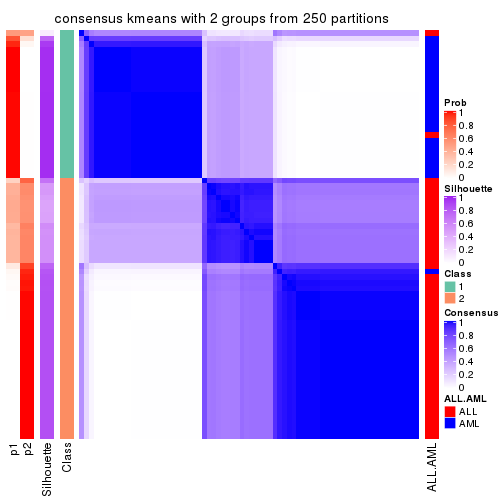
consensus_heatmap(res, k = 3)
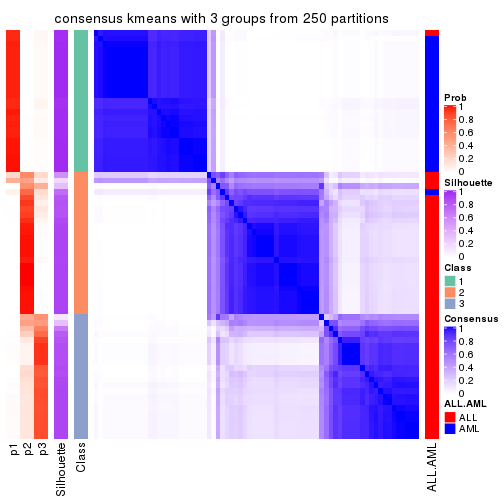
consensus_heatmap(res, k = 4)
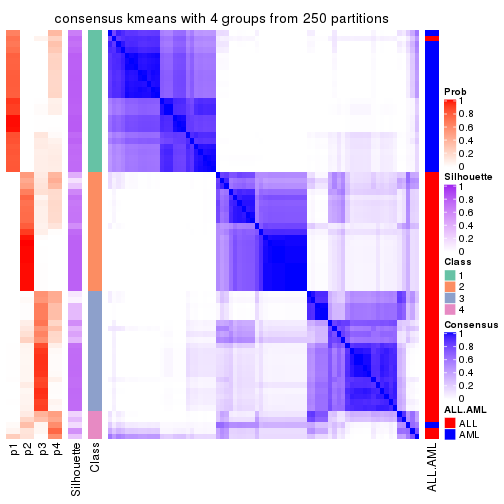
consensus_heatmap(res, k = 5)
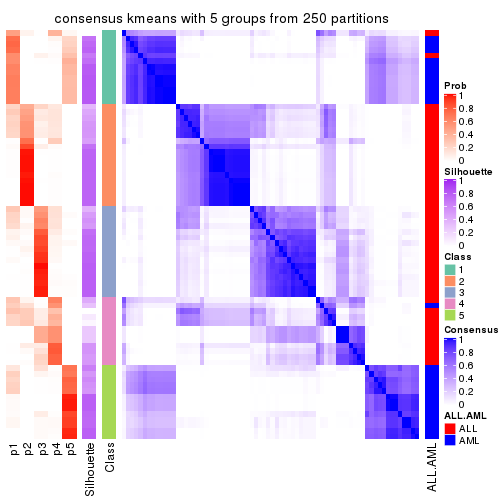
consensus_heatmap(res, k = 6)
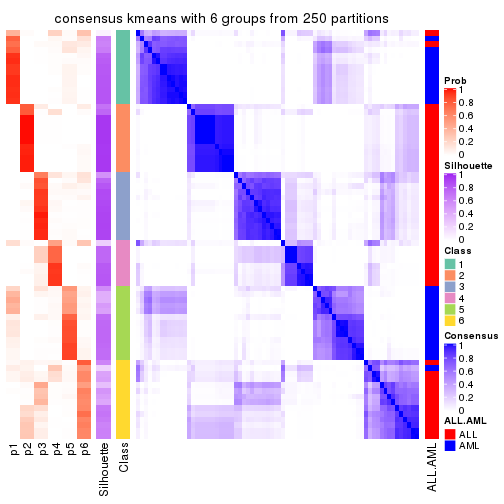
Heatmaps for the membership of samples in all partitions to see how consistent they are:
membership_heatmap(res, k = 2)
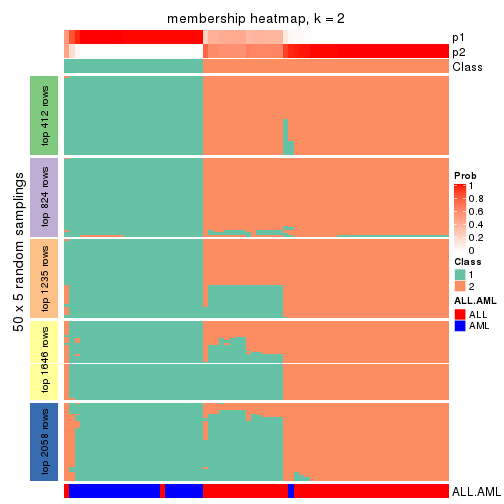
membership_heatmap(res, k = 3)
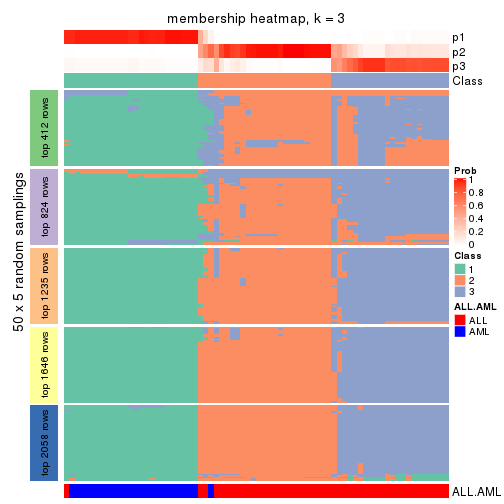
membership_heatmap(res, k = 4)
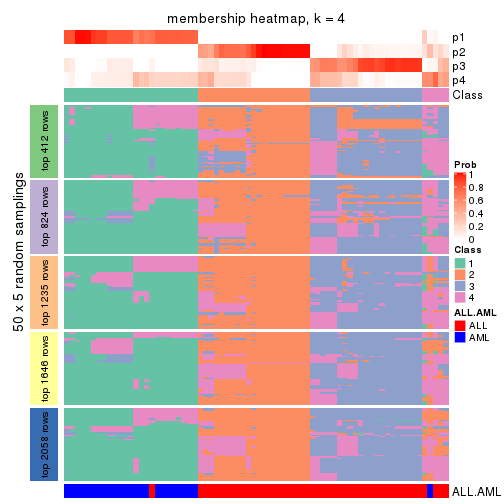
membership_heatmap(res, k = 5)
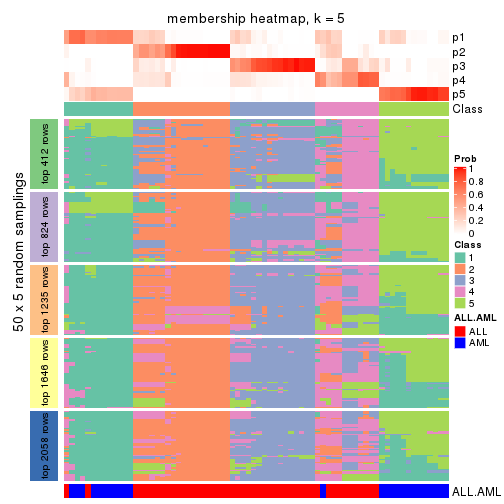
membership_heatmap(res, k = 6)
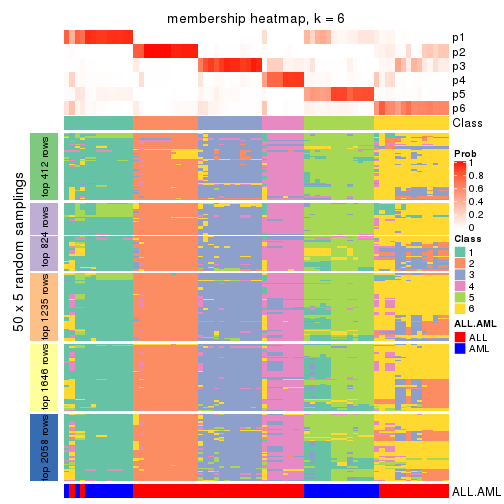
As soon as we have had the classes for columns, we can look for signatures which are significantly different between classes which can be candidate marks for certain classes. Following are the heatmaps for signatures.
Signature heatmaps where rows are scaled:
get_signatures(res, k = 2)
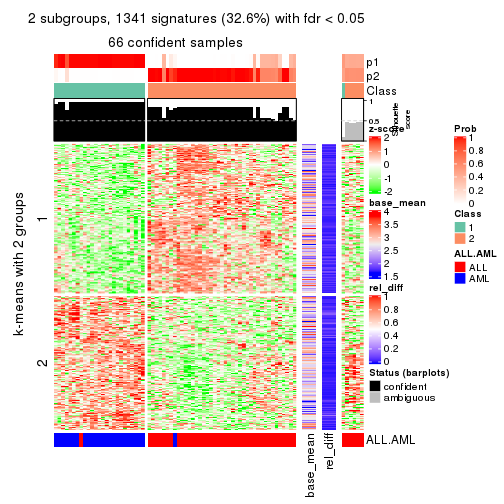
get_signatures(res, k = 3)
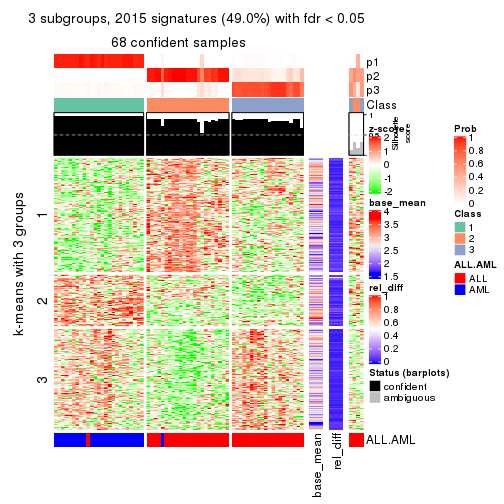
get_signatures(res, k = 4)
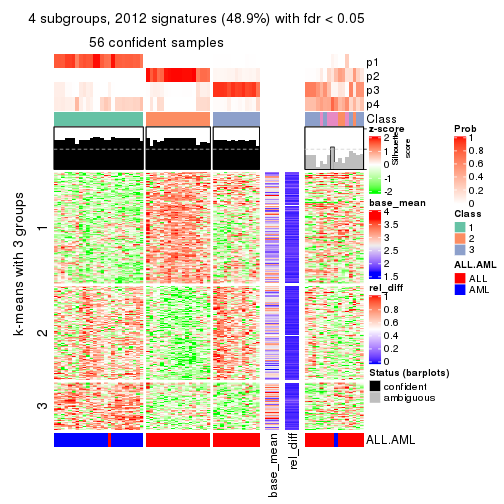
get_signatures(res, k = 5)
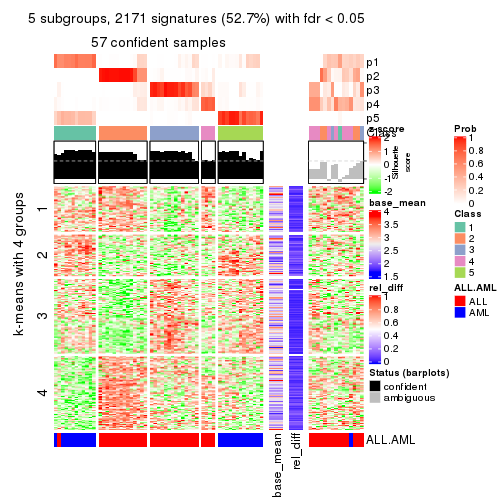
get_signatures(res, k = 6)
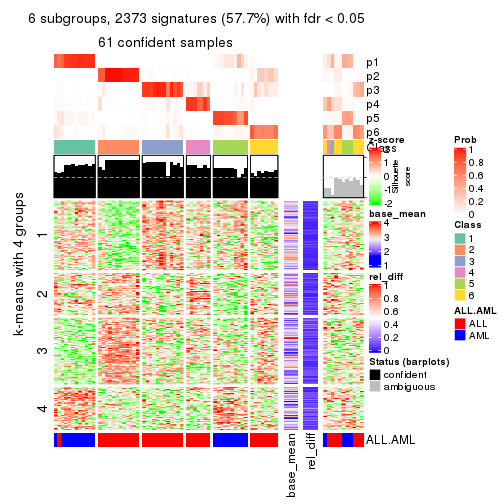
Signature heatmaps where rows are not scaled:
get_signatures(res, k = 2, scale_rows = FALSE)
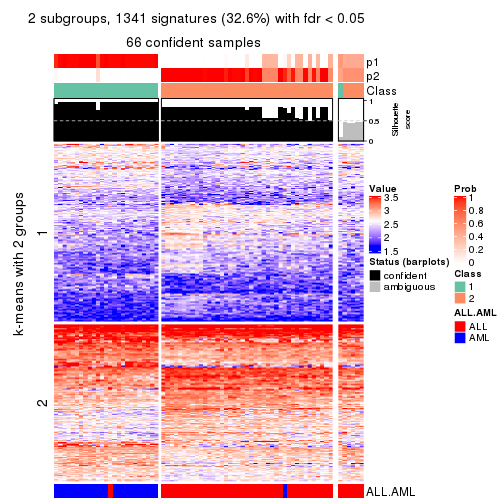
get_signatures(res, k = 3, scale_rows = FALSE)
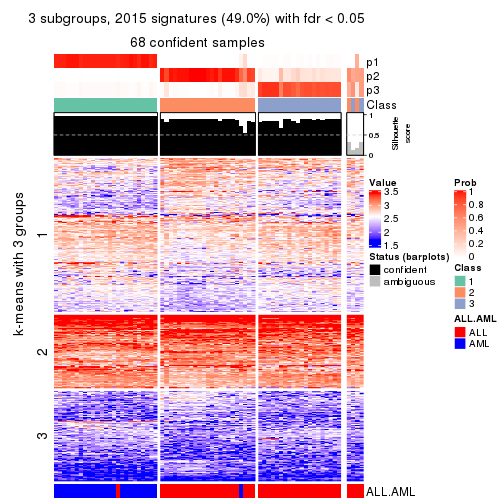
get_signatures(res, k = 4, scale_rows = FALSE)
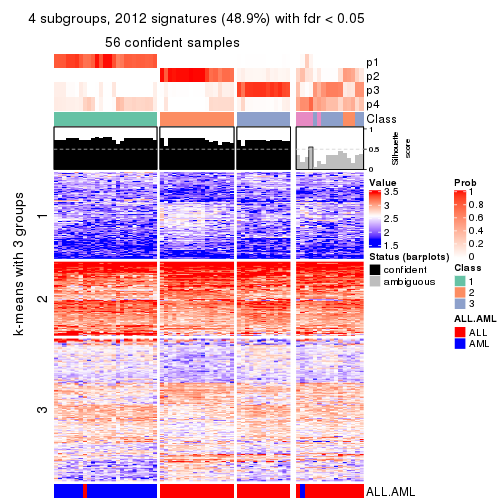
get_signatures(res, k = 5, scale_rows = FALSE)
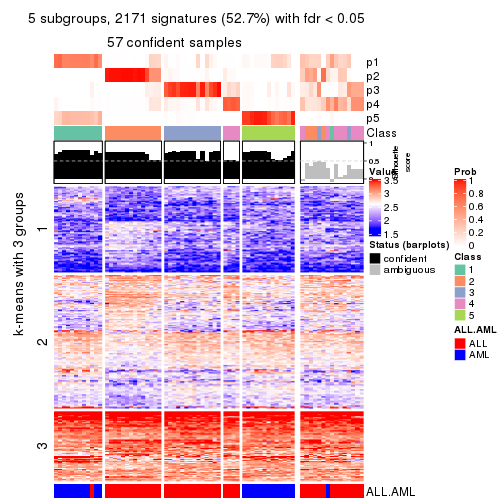
get_signatures(res, k = 6, scale_rows = FALSE)
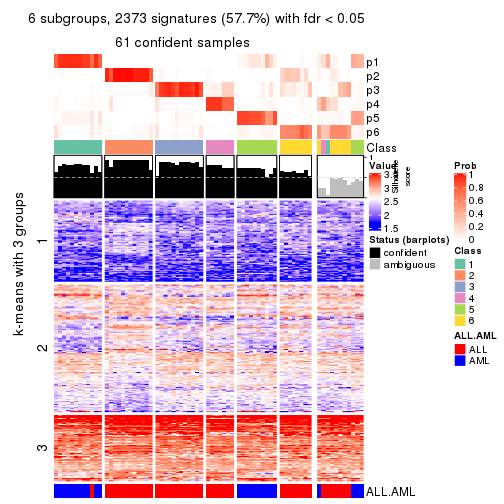
Compare the overlap of signatures from different k:
compare_signatures(res)
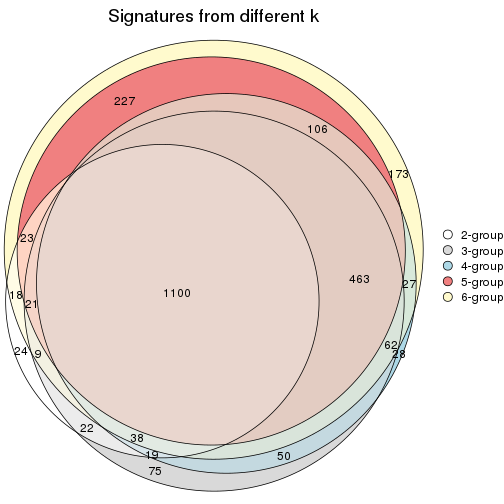
get_signature() returns a data frame invisibly. TO get the list of signatures, the function
call should be assigned to a variable explicitly. In following code, if plot argument is set
to FALSE, no heatmap is plotted while only the differential analysis is performed.
# code only for demonstration
tb = get_signature(res, k = ..., plot = FALSE)
An example of the output of tb is:
#> which_row fdr mean_1 mean_2 scaled_mean_1 scaled_mean_2 km
#> 1 38 0.042760348 8.373488 9.131774 -0.5533452 0.5164555 1
#> 2 40 0.018707592 7.106213 8.469186 -0.6173731 0.5762149 1
#> 3 55 0.019134737 10.221463 11.207825 -0.6159697 0.5749050 1
#> 4 59 0.006059896 5.921854 7.869574 -0.6899429 0.6439467 1
#> 5 60 0.018055526 8.928898 10.211722 -0.6204761 0.5791110 1
#> 6 98 0.009384629 15.714769 14.887706 0.6635654 -0.6193277 2
...
The columns in tb are:
which_row: row indices corresponding to the input matrix.fdr: FDR for the differential test. mean_x: The mean value in group x.scaled_mean_x: The mean value in group x after rows are scaled.km: Row groups if k-means clustering is applied to rows.UMAP plot which shows how samples are separated.
dimension_reduction(res, k = 2, method = "UMAP")
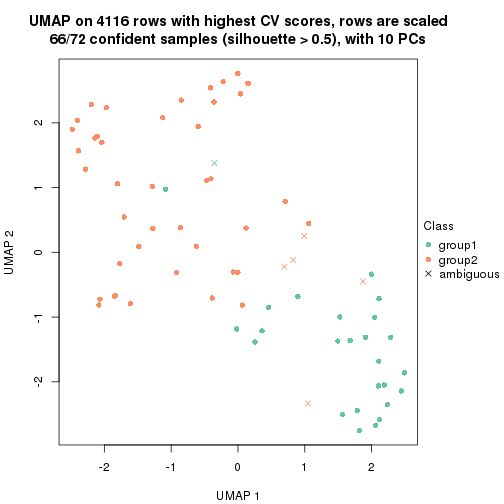
dimension_reduction(res, k = 3, method = "UMAP")
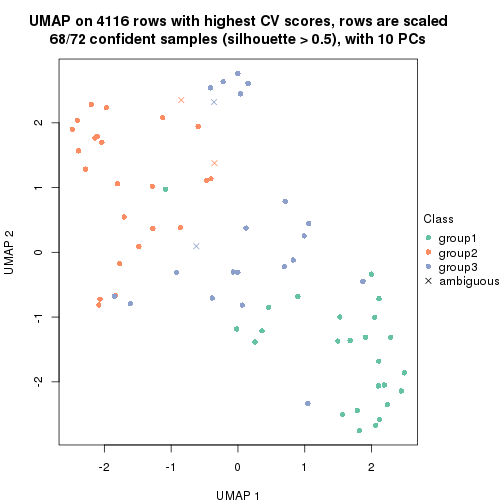
dimension_reduction(res, k = 4, method = "UMAP")
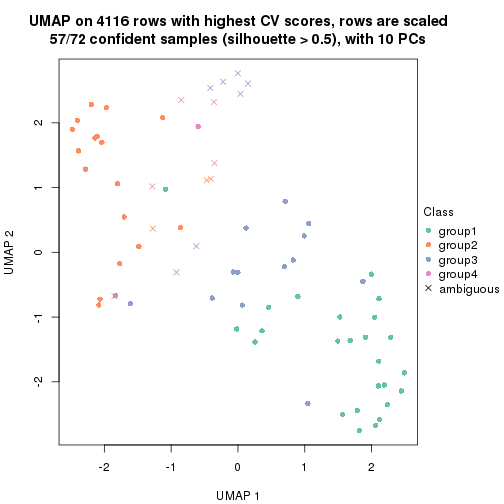
dimension_reduction(res, k = 5, method = "UMAP")
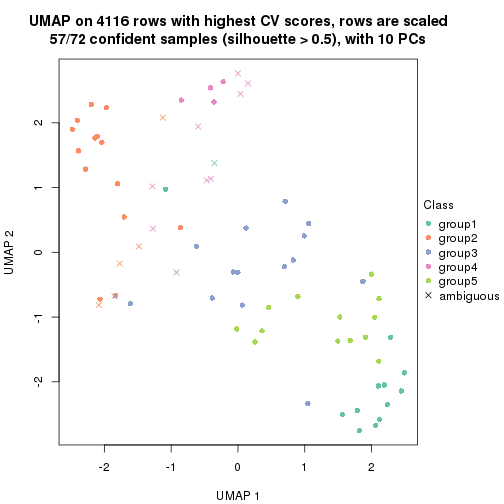
dimension_reduction(res, k = 6, method = "UMAP")
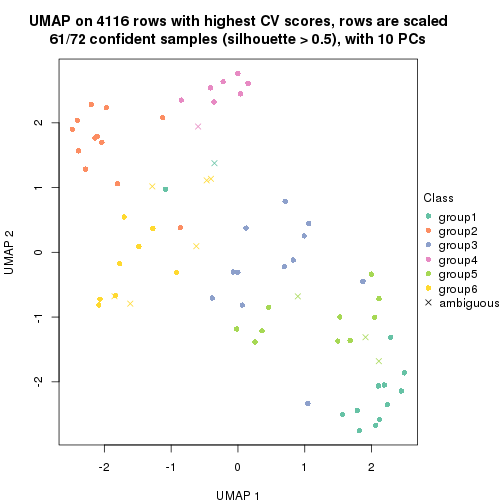
Following heatmap shows how subgroups are split when increasing k:
collect_classes(res)
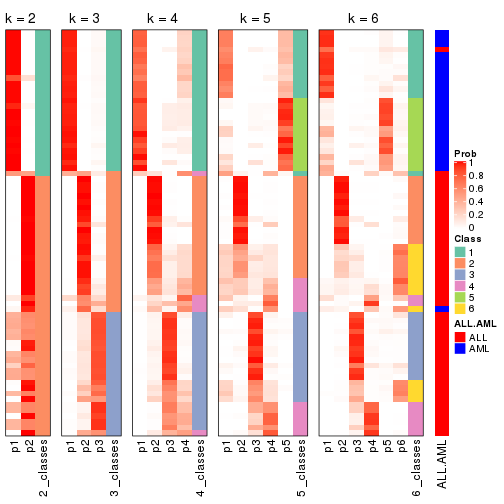
Test correlation between subgroups and known annotations. If the known annotation is numeric, one-way ANOVA test is applied, and if the known annotation is discrete, chi-squared contingency table test is applied.
test_to_known_factors(res)
#> n ALL.AML(p) k
#> CV:kmeans 66 2.15e-13 2
#> CV:kmeans 68 1.06e-13 3
#> CV:kmeans 57 1.78e-11 4
#> CV:kmeans 57 7.59e-11 5
#> CV:kmeans 61 5.20e-11 6
If matrix rows can be associated to genes, consider to use functional_enrichment(res,
...) to perform function enrichment for the signature genes. See this vignette for more detailed explanations.
The object with results only for a single top-value method and a single partition method can be extracted as:
res = res_list["CV", "skmeans"]
# you can also extract it by
# res = res_list["CV:skmeans"]
A summary of res and all the functions that can be applied to it:
res
#> A 'ConsensusPartition' object with k = 2, 3, 4, 5, 6.
#> On a matrix with 4116 rows and 72 columns.
#> Top rows (412, 824, 1235, 1646, 2058) are extracted by 'CV' method.
#> Subgroups are detected by 'skmeans' method.
#> Performed in total 1250 partitions by row resampling.
#> Best k for subgroups seems to be 3.
#>
#> Following methods can be applied to this 'ConsensusPartition' object:
#> [1] "cola_report" "collect_classes" "collect_plots"
#> [4] "collect_stats" "colnames" "compare_signatures"
#> [7] "consensus_heatmap" "dimension_reduction" "functional_enrichment"
#> [10] "get_anno_col" "get_anno" "get_classes"
#> [13] "get_consensus" "get_matrix" "get_membership"
#> [16] "get_param" "get_signatures" "get_stats"
#> [19] "is_best_k" "is_stable_k" "membership_heatmap"
#> [22] "ncol" "nrow" "plot_ecdf"
#> [25] "rownames" "select_partition_number" "show"
#> [28] "suggest_best_k" "test_to_known_factors"
collect_plots() function collects all the plots made from res for all k (number of partitions)
into one single page to provide an easy and fast comparison between different k.
collect_plots(res)
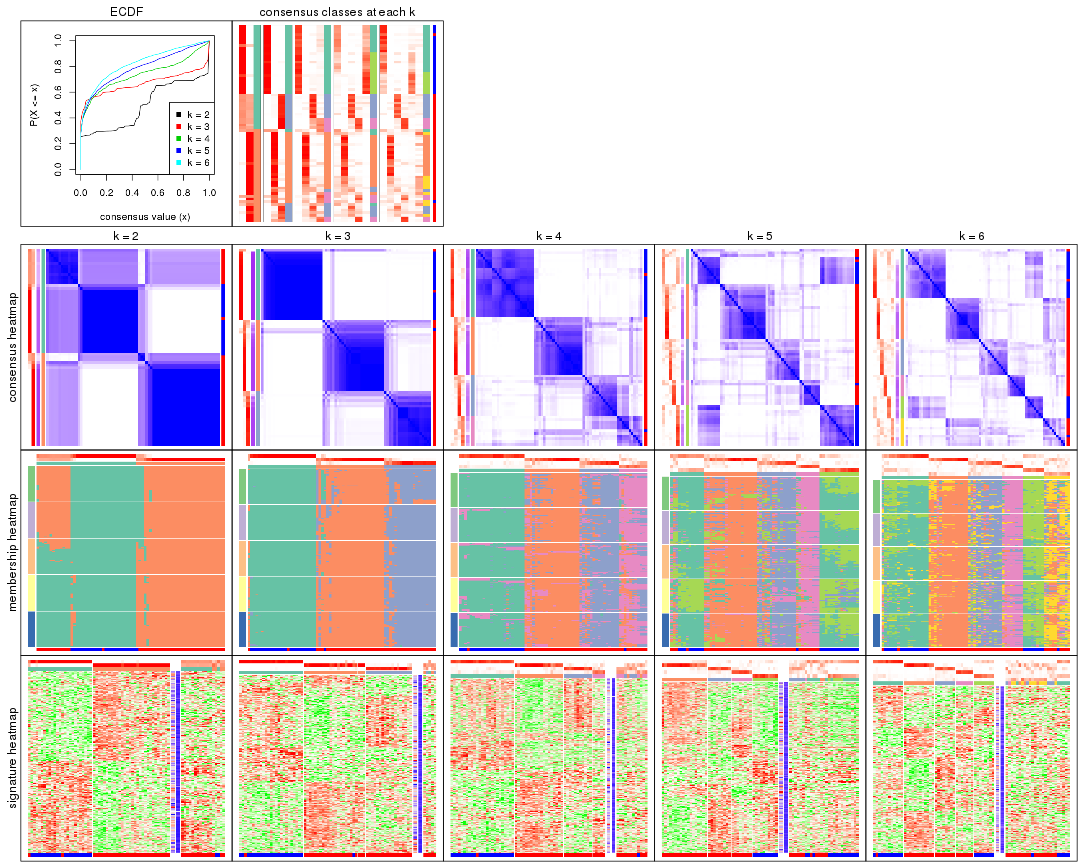
The plots are:
k and the heatmap of
predicted classes for each k.k.k.k.All the plots in panels can be made by individual functions and they are plotted later in this section.
select_partition_number() produces several plots showing different
statistics for choosing “optimized” k. There are following statistics:
k;k, the area increased is defined as \(A_k - A_{k-1}\).The detailed explanations of these statistics can be found in the cola vignette.
Generally speaking, lower PAC score, higher mean silhouette score or higher
concordance corresponds to better partition. Rand index and Jaccard index
measure how similar the current partition is compared to partition with k-1.
If they are too similar, we won't accept k is better than k-1.
select_partition_number(res)
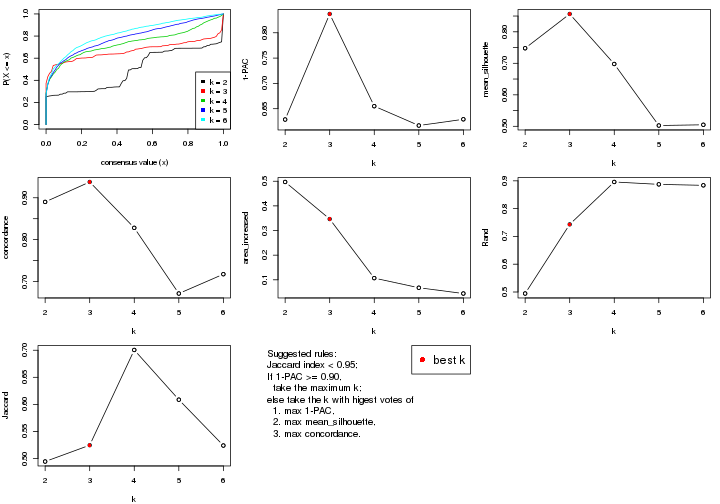
The numeric values for all these statistics can be obtained by get_stats().
get_stats(res)
#> k 1-PAC mean_silhouette concordance area_increased Rand Jaccard
#> 2 2 0.629 0.748 0.890 0.4970 0.495 0.495
#> 3 3 0.837 0.857 0.938 0.3466 0.743 0.525
#> 4 4 0.655 0.698 0.828 0.1068 0.896 0.700
#> 5 5 0.617 0.503 0.671 0.0677 0.887 0.609
#> 6 6 0.629 0.505 0.717 0.0443 0.884 0.524
suggest_best_k() suggests the best \(k\) based on these statistics. The rules are as follows:
suggest_best_k(res)
#> [1] 3
Following shows the table of the partitions (You need to click the show/hide
code output link to see it). The membership matrix (columns with name p*)
is inferred by
clue::cl_consensus()
function with the SE method. Basically the value in the membership matrix
represents the probability to belong to a certain group. The finall class
label for an item is determined with the group with highest probability it
belongs to.
In get_classes() function, the entropy is calculated from the membership
matrix and the silhouette score is calculated from the consensus matrix.
cbind(get_classes(res, k = 2), get_membership(res, k = 2))
#> class entropy silhouette p1 p2
#> sample_39 1 0.994 0.403 0.544 0.456
#> sample_40 1 0.993 0.410 0.548 0.452
#> sample_42 2 0.000 0.929 0.000 1.000
#> sample_47 2 0.000 0.929 0.000 1.000
#> sample_48 2 0.000 0.929 0.000 1.000
#> sample_49 1 0.985 0.449 0.572 0.428
#> sample_41 2 0.000 0.929 0.000 1.000
#> sample_43 2 0.000 0.929 0.000 1.000
#> sample_44 2 0.000 0.929 0.000 1.000
#> sample_45 2 0.000 0.929 0.000 1.000
#> sample_46 2 0.000 0.929 0.000 1.000
#> sample_70 2 0.000 0.929 0.000 1.000
#> sample_71 2 0.000 0.929 0.000 1.000
#> sample_72 2 0.000 0.929 0.000 1.000
#> sample_68 2 0.000 0.929 0.000 1.000
#> sample_69 2 0.000 0.929 0.000 1.000
#> sample_67 2 0.995 0.155 0.460 0.540
#> sample_55 1 0.995 0.393 0.540 0.460
#> sample_56 1 0.995 0.395 0.540 0.460
#> sample_59 2 0.000 0.929 0.000 1.000
#> sample_52 1 0.000 0.803 1.000 0.000
#> sample_53 1 0.000 0.803 1.000 0.000
#> sample_51 1 0.000 0.803 1.000 0.000
#> sample_50 1 0.000 0.803 1.000 0.000
#> sample_54 1 0.506 0.712 0.888 0.112
#> sample_57 1 0.000 0.803 1.000 0.000
#> sample_58 1 0.000 0.803 1.000 0.000
#> sample_60 1 0.000 0.803 1.000 0.000
#> sample_61 1 0.000 0.803 1.000 0.000
#> sample_65 1 0.000 0.803 1.000 0.000
#> sample_66 2 0.981 0.246 0.420 0.580
#> sample_63 1 0.000 0.803 1.000 0.000
#> sample_64 1 0.000 0.803 1.000 0.000
#> sample_62 1 0.000 0.803 1.000 0.000
#> sample_1 2 0.000 0.929 0.000 1.000
#> sample_2 2 0.993 0.174 0.452 0.548
#> sample_3 1 0.996 0.386 0.536 0.464
#> sample_4 2 0.000 0.929 0.000 1.000
#> sample_5 2 0.000 0.929 0.000 1.000
#> sample_6 1 0.996 0.386 0.536 0.464
#> sample_7 1 0.998 0.357 0.524 0.476
#> sample_8 1 0.987 0.442 0.568 0.432
#> sample_9 2 0.000 0.929 0.000 1.000
#> sample_10 1 0.925 0.552 0.660 0.340
#> sample_11 2 0.000 0.929 0.000 1.000
#> sample_12 1 0.000 0.803 1.000 0.000
#> sample_13 2 0.000 0.929 0.000 1.000
#> sample_14 2 0.000 0.929 0.000 1.000
#> sample_15 2 0.000 0.929 0.000 1.000
#> sample_16 2 0.000 0.929 0.000 1.000
#> sample_17 2 0.402 0.840 0.080 0.920
#> sample_18 2 0.443 0.817 0.092 0.908
#> sample_19 2 0.000 0.929 0.000 1.000
#> sample_20 2 0.000 0.929 0.000 1.000
#> sample_21 2 0.000 0.929 0.000 1.000
#> sample_22 1 0.981 0.460 0.580 0.420
#> sample_23 1 0.994 0.403 0.544 0.456
#> sample_24 2 0.000 0.929 0.000 1.000
#> sample_25 2 0.855 0.457 0.280 0.720
#> sample_26 2 0.000 0.929 0.000 1.000
#> sample_27 1 0.983 0.454 0.576 0.424
#> sample_34 1 0.000 0.803 1.000 0.000
#> sample_35 1 0.000 0.803 1.000 0.000
#> sample_36 1 0.000 0.803 1.000 0.000
#> sample_37 1 0.000 0.803 1.000 0.000
#> sample_38 1 0.000 0.803 1.000 0.000
#> sample_28 1 0.000 0.803 1.000 0.000
#> sample_29 1 0.861 0.476 0.716 0.284
#> sample_30 1 0.000 0.803 1.000 0.000
#> sample_31 1 0.000 0.803 1.000 0.000
#> sample_32 1 0.000 0.803 1.000 0.000
#> sample_33 1 0.000 0.803 1.000 0.000
cbind(get_classes(res, k = 3), get_membership(res, k = 3))
#> class entropy silhouette p1 p2 p3
#> sample_39 3 0.3038 0.8602 0.000 0.104 0.896
#> sample_40 3 0.1411 0.9012 0.000 0.036 0.964
#> sample_42 2 0.0000 0.9100 0.000 1.000 0.000
#> sample_47 2 0.0000 0.9100 0.000 1.000 0.000
#> sample_48 2 0.0000 0.9100 0.000 1.000 0.000
#> sample_49 3 0.1163 0.9008 0.000 0.028 0.972
#> sample_41 2 0.0237 0.9094 0.000 0.996 0.004
#> sample_43 2 0.0000 0.9100 0.000 1.000 0.000
#> sample_44 2 0.3412 0.8065 0.000 0.876 0.124
#> sample_45 2 0.0000 0.9100 0.000 1.000 0.000
#> sample_46 2 0.0000 0.9100 0.000 1.000 0.000
#> sample_70 3 0.5327 0.6679 0.000 0.272 0.728
#> sample_71 2 0.1289 0.8925 0.000 0.968 0.032
#> sample_72 2 0.0237 0.9087 0.000 0.996 0.004
#> sample_68 2 0.0237 0.9094 0.000 0.996 0.004
#> sample_69 2 0.0000 0.9100 0.000 1.000 0.000
#> sample_67 1 0.7184 -0.0186 0.504 0.472 0.024
#> sample_55 3 0.1031 0.8999 0.000 0.024 0.976
#> sample_56 3 0.1529 0.9001 0.000 0.040 0.960
#> sample_59 2 0.6267 0.0253 0.000 0.548 0.452
#> sample_52 1 0.0000 0.9753 1.000 0.000 0.000
#> sample_53 1 0.0000 0.9753 1.000 0.000 0.000
#> sample_51 1 0.0000 0.9753 1.000 0.000 0.000
#> sample_50 1 0.0000 0.9753 1.000 0.000 0.000
#> sample_54 1 0.0829 0.9632 0.984 0.012 0.004
#> sample_57 1 0.0000 0.9753 1.000 0.000 0.000
#> sample_58 1 0.0000 0.9753 1.000 0.000 0.000
#> sample_60 1 0.0000 0.9753 1.000 0.000 0.000
#> sample_61 1 0.0237 0.9725 0.996 0.000 0.004
#> sample_65 1 0.0000 0.9753 1.000 0.000 0.000
#> sample_66 2 0.5581 0.7289 0.168 0.792 0.040
#> sample_63 1 0.0000 0.9753 1.000 0.000 0.000
#> sample_64 1 0.0592 0.9666 0.988 0.000 0.012
#> sample_62 1 0.0000 0.9753 1.000 0.000 0.000
#> sample_1 3 0.1860 0.8954 0.000 0.052 0.948
#> sample_2 2 0.6556 0.5876 0.276 0.692 0.032
#> sample_3 3 0.0000 0.8905 0.000 0.000 1.000
#> sample_4 3 0.1411 0.9009 0.000 0.036 0.964
#> sample_5 2 0.0237 0.9094 0.000 0.996 0.004
#> sample_6 3 0.0000 0.8905 0.000 0.000 1.000
#> sample_7 3 0.1289 0.9010 0.000 0.032 0.968
#> sample_8 3 0.1411 0.9006 0.000 0.036 0.964
#> sample_9 3 0.4002 0.7630 0.000 0.160 0.840
#> sample_10 3 0.0000 0.8905 0.000 0.000 1.000
#> sample_11 3 0.6252 0.1259 0.000 0.444 0.556
#> sample_12 1 0.0000 0.9753 1.000 0.000 0.000
#> sample_13 2 0.0000 0.9100 0.000 1.000 0.000
#> sample_14 2 0.5905 0.4764 0.000 0.648 0.352
#> sample_15 2 0.0237 0.9094 0.000 0.996 0.004
#> sample_16 2 0.2165 0.8764 0.000 0.936 0.064
#> sample_17 2 0.3500 0.8349 0.004 0.880 0.116
#> sample_18 3 0.3816 0.8149 0.000 0.148 0.852
#> sample_19 2 0.0000 0.9100 0.000 1.000 0.000
#> sample_20 2 0.0000 0.9100 0.000 1.000 0.000
#> sample_21 2 0.0424 0.9082 0.000 0.992 0.008
#> sample_22 3 0.1999 0.8981 0.012 0.036 0.952
#> sample_23 3 0.0000 0.8905 0.000 0.000 1.000
#> sample_24 2 0.1643 0.8882 0.000 0.956 0.044
#> sample_25 3 0.6641 0.2694 0.008 0.448 0.544
#> sample_26 2 0.4931 0.6393 0.000 0.768 0.232
#> sample_27 3 0.1163 0.9008 0.000 0.028 0.972
#> sample_34 1 0.0000 0.9753 1.000 0.000 0.000
#> sample_35 1 0.1529 0.9392 0.960 0.000 0.040
#> sample_36 1 0.0000 0.9753 1.000 0.000 0.000
#> sample_37 1 0.0000 0.9753 1.000 0.000 0.000
#> sample_38 1 0.0000 0.9753 1.000 0.000 0.000
#> sample_28 1 0.0000 0.9753 1.000 0.000 0.000
#> sample_29 1 0.0237 0.9722 0.996 0.004 0.000
#> sample_30 1 0.0000 0.9753 1.000 0.000 0.000
#> sample_31 1 0.0000 0.9753 1.000 0.000 0.000
#> sample_32 1 0.0000 0.9753 1.000 0.000 0.000
#> sample_33 1 0.0000 0.9753 1.000 0.000 0.000
cbind(get_classes(res, k = 4), get_membership(res, k = 4))
#> class entropy silhouette p1 p2 p3 p4
#> sample_39 3 0.2125 0.7016 0.000 0.004 0.920 0.076
#> sample_40 3 0.2463 0.7032 0.032 0.008 0.924 0.036
#> sample_42 2 0.6980 0.5073 0.004 0.568 0.128 0.300
#> sample_47 2 0.1833 0.8354 0.000 0.944 0.024 0.032
#> sample_48 2 0.0000 0.8432 0.000 1.000 0.000 0.000
#> sample_49 3 0.0804 0.7073 0.008 0.000 0.980 0.012
#> sample_41 2 0.0376 0.8429 0.000 0.992 0.004 0.004
#> sample_43 2 0.4426 0.7742 0.000 0.812 0.092 0.096
#> sample_44 2 0.5809 0.6458 0.000 0.692 0.216 0.092
#> sample_45 2 0.3198 0.8086 0.000 0.880 0.040 0.080
#> sample_46 2 0.3732 0.7973 0.000 0.852 0.056 0.092
#> sample_70 3 0.6418 0.4802 0.000 0.216 0.644 0.140
#> sample_71 4 0.6386 0.0881 0.000 0.376 0.072 0.552
#> sample_72 2 0.6827 0.4006 0.000 0.568 0.128 0.304
#> sample_68 2 0.0188 0.8428 0.000 0.996 0.000 0.004
#> sample_69 2 0.0188 0.8430 0.000 0.996 0.000 0.004
#> sample_67 4 0.6359 0.4179 0.220 0.132 0.000 0.648
#> sample_55 3 0.4795 0.6170 0.012 0.076 0.804 0.108
#> sample_56 3 0.1114 0.7116 0.008 0.004 0.972 0.016
#> sample_59 2 0.6963 0.0290 0.004 0.464 0.436 0.096
#> sample_52 1 0.1042 0.9075 0.972 0.000 0.008 0.020
#> sample_53 1 0.2216 0.9029 0.908 0.000 0.000 0.092
#> sample_51 1 0.2011 0.9063 0.920 0.000 0.000 0.080
#> sample_50 1 0.1940 0.9071 0.924 0.000 0.000 0.076
#> sample_54 1 0.4419 0.8387 0.840 0.056 0.040 0.064
#> sample_57 1 0.2408 0.8913 0.920 0.000 0.044 0.036
#> sample_58 1 0.2408 0.8914 0.920 0.000 0.044 0.036
#> sample_60 1 0.2944 0.8842 0.900 0.004 0.052 0.044
#> sample_61 1 0.2773 0.8947 0.900 0.000 0.072 0.028
#> sample_65 1 0.0927 0.9115 0.976 0.000 0.008 0.016
#> sample_66 4 0.5482 0.2887 0.024 0.368 0.000 0.608
#> sample_63 1 0.1584 0.9023 0.952 0.000 0.012 0.036
#> sample_64 1 0.3435 0.8556 0.864 0.000 0.100 0.036
#> sample_62 1 0.1584 0.9023 0.952 0.000 0.012 0.036
#> sample_1 3 0.2871 0.6950 0.000 0.072 0.896 0.032
#> sample_2 4 0.4336 0.5498 0.048 0.132 0.004 0.816
#> sample_3 4 0.4961 0.3607 0.000 0.000 0.448 0.552
#> sample_4 3 0.5180 0.5734 0.000 0.196 0.740 0.064
#> sample_5 2 0.0336 0.8422 0.000 0.992 0.000 0.008
#> sample_6 4 0.4925 0.3949 0.000 0.000 0.428 0.572
#> sample_7 3 0.3966 0.6458 0.000 0.088 0.840 0.072
#> sample_8 3 0.0895 0.7081 0.000 0.004 0.976 0.020
#> sample_9 4 0.5873 0.5558 0.000 0.076 0.256 0.668
#> sample_10 4 0.4608 0.5171 0.004 0.000 0.304 0.692
#> sample_11 4 0.4931 0.5856 0.000 0.092 0.132 0.776
#> sample_12 1 0.4015 0.8631 0.832 0.000 0.052 0.116
#> sample_13 2 0.0000 0.8432 0.000 1.000 0.000 0.000
#> sample_14 4 0.6022 0.5421 0.000 0.260 0.084 0.656
#> sample_15 2 0.0336 0.8422 0.000 0.992 0.000 0.008
#> sample_16 2 0.2741 0.7993 0.000 0.892 0.096 0.012
#> sample_17 2 0.4343 0.5311 0.000 0.732 0.004 0.264
#> sample_18 3 0.8049 0.0429 0.016 0.196 0.432 0.356
#> sample_19 2 0.4274 0.7797 0.000 0.820 0.108 0.072
#> sample_20 2 0.0188 0.8432 0.000 0.996 0.000 0.004
#> sample_21 2 0.0817 0.8368 0.000 0.976 0.000 0.024
#> sample_22 3 0.4425 0.6219 0.036 0.004 0.800 0.160
#> sample_23 4 0.4941 0.3828 0.000 0.000 0.436 0.564
#> sample_24 2 0.0672 0.8410 0.000 0.984 0.008 0.008
#> sample_25 3 0.8007 0.2592 0.024 0.168 0.472 0.336
#> sample_26 3 0.7154 -0.0693 0.000 0.428 0.440 0.132
#> sample_27 3 0.1042 0.7041 0.008 0.000 0.972 0.020
#> sample_34 1 0.0779 0.9092 0.980 0.000 0.004 0.016
#> sample_35 1 0.4335 0.7984 0.796 0.000 0.168 0.036
#> sample_36 1 0.1211 0.9115 0.960 0.000 0.000 0.040
#> sample_37 1 0.2216 0.9026 0.908 0.000 0.000 0.092
#> sample_38 1 0.3982 0.8039 0.776 0.000 0.004 0.220
#> sample_28 1 0.3105 0.8762 0.856 0.000 0.004 0.140
#> sample_29 1 0.3528 0.8363 0.808 0.000 0.000 0.192
#> sample_30 1 0.1637 0.9098 0.940 0.000 0.000 0.060
#> sample_31 1 0.0592 0.9117 0.984 0.000 0.000 0.016
#> sample_32 1 0.2011 0.9067 0.920 0.000 0.000 0.080
#> sample_33 1 0.2216 0.9026 0.908 0.000 0.000 0.092
cbind(get_classes(res, k = 5), get_membership(res, k = 5))
#> class entropy silhouette p1 p2 p3 p4 p5
#> sample_39 3 0.2511 0.6520 0.088 0.000 0.892 0.016 0.004
#> sample_40 3 0.4360 0.6511 0.016 0.008 0.804 0.080 0.092
#> sample_42 1 0.7767 -0.4863 0.392 0.372 0.144 0.088 0.004
#> sample_47 2 0.3730 0.7539 0.108 0.832 0.040 0.020 0.000
#> sample_48 2 0.0000 0.7976 0.000 1.000 0.000 0.000 0.000
#> sample_49 3 0.2053 0.6706 0.000 0.004 0.924 0.048 0.024
#> sample_41 2 0.1285 0.7926 0.036 0.956 0.004 0.004 0.000
#> sample_43 2 0.6765 0.5590 0.244 0.584 0.120 0.044 0.008
#> sample_44 2 0.6768 0.5281 0.152 0.588 0.200 0.060 0.000
#> sample_45 2 0.5292 0.6828 0.160 0.724 0.076 0.040 0.000
#> sample_46 2 0.5682 0.6607 0.172 0.692 0.092 0.044 0.000
#> sample_70 3 0.7796 0.4094 0.176 0.180 0.512 0.124 0.008
#> sample_71 2 0.8307 -0.0377 0.292 0.300 0.124 0.284 0.000
#> sample_72 2 0.7886 0.3247 0.216 0.468 0.164 0.152 0.000
#> sample_68 2 0.0703 0.7953 0.024 0.976 0.000 0.000 0.000
#> sample_69 2 0.0579 0.7973 0.008 0.984 0.008 0.000 0.000
#> sample_67 1 0.6826 -0.0670 0.524 0.064 0.004 0.332 0.076
#> sample_55 3 0.7644 0.4791 0.048 0.048 0.552 0.164 0.188
#> sample_56 3 0.2472 0.6763 0.012 0.000 0.908 0.036 0.044
#> sample_59 3 0.8787 0.0558 0.168 0.332 0.352 0.056 0.092
#> sample_52 5 0.2424 0.6172 0.132 0.000 0.000 0.000 0.868
#> sample_53 1 0.4268 0.3396 0.556 0.000 0.000 0.000 0.444
#> sample_51 1 0.4294 0.2995 0.532 0.000 0.000 0.000 0.468
#> sample_50 1 0.4302 0.2732 0.520 0.000 0.000 0.000 0.480
#> sample_54 5 0.3672 0.5611 0.040 0.064 0.028 0.012 0.856
#> sample_57 5 0.1538 0.6393 0.008 0.000 0.036 0.008 0.948
#> sample_58 5 0.2122 0.6567 0.032 0.000 0.036 0.008 0.924
#> sample_60 5 0.3159 0.5997 0.044 0.008 0.052 0.016 0.880
#> sample_61 5 0.5781 0.4154 0.260 0.000 0.112 0.008 0.620
#> sample_65 5 0.3730 0.4367 0.288 0.000 0.000 0.000 0.712
#> sample_66 4 0.7286 0.1895 0.312 0.272 0.004 0.396 0.016
#> sample_63 5 0.1571 0.6561 0.060 0.000 0.004 0.000 0.936
#> sample_64 5 0.3589 0.5944 0.040 0.000 0.132 0.004 0.824
#> sample_62 5 0.1041 0.6577 0.032 0.000 0.004 0.000 0.964
#> sample_1 3 0.3756 0.6531 0.012 0.044 0.824 0.120 0.000
#> sample_2 4 0.5271 0.5451 0.296 0.076 0.000 0.628 0.000
#> sample_3 4 0.2852 0.7122 0.000 0.000 0.172 0.828 0.000
#> sample_4 3 0.6756 0.4450 0.028 0.208 0.548 0.216 0.000
#> sample_5 2 0.0794 0.7943 0.028 0.972 0.000 0.000 0.000
#> sample_6 4 0.2852 0.7113 0.000 0.000 0.172 0.828 0.000
#> sample_7 3 0.5173 0.5861 0.020 0.064 0.728 0.180 0.008
#> sample_8 3 0.2244 0.6733 0.024 0.000 0.920 0.040 0.016
#> sample_9 4 0.2661 0.7543 0.000 0.056 0.056 0.888 0.000
#> sample_10 4 0.1894 0.7510 0.008 0.000 0.072 0.920 0.000
#> sample_11 4 0.2591 0.7428 0.032 0.044 0.020 0.904 0.000
#> sample_12 1 0.5674 0.3148 0.584 0.000 0.052 0.020 0.344
#> sample_13 2 0.0579 0.7983 0.008 0.984 0.008 0.000 0.000
#> sample_14 4 0.2597 0.7204 0.004 0.120 0.004 0.872 0.000
#> sample_15 2 0.0880 0.7933 0.032 0.968 0.000 0.000 0.000
#> sample_16 2 0.3582 0.7287 0.028 0.840 0.108 0.024 0.000
#> sample_17 2 0.5052 0.5854 0.040 0.728 0.012 0.200 0.020
#> sample_18 3 0.8869 0.1856 0.060 0.152 0.384 0.292 0.112
#> sample_19 2 0.5504 0.6697 0.136 0.704 0.132 0.028 0.000
#> sample_20 2 0.0324 0.7976 0.004 0.992 0.004 0.000 0.000
#> sample_21 2 0.1579 0.7887 0.024 0.944 0.000 0.032 0.000
#> sample_22 3 0.5213 0.5403 0.200 0.004 0.716 0.048 0.032
#> sample_23 4 0.2852 0.7126 0.000 0.000 0.172 0.828 0.000
#> sample_24 2 0.1329 0.7898 0.032 0.956 0.008 0.004 0.000
#> sample_25 1 0.7433 -0.4064 0.436 0.092 0.372 0.096 0.004
#> sample_26 3 0.6958 0.1751 0.120 0.340 0.496 0.040 0.004
#> sample_27 3 0.2171 0.6661 0.000 0.000 0.912 0.064 0.024
#> sample_34 5 0.3305 0.5418 0.224 0.000 0.000 0.000 0.776
#> sample_35 5 0.5671 0.5081 0.180 0.000 0.144 0.012 0.664
#> sample_36 5 0.4192 0.0362 0.404 0.000 0.000 0.000 0.596
#> sample_37 1 0.4256 0.3521 0.564 0.000 0.000 0.000 0.436
#> sample_38 1 0.4645 0.3812 0.672 0.000 0.012 0.016 0.300
#> sample_28 1 0.4318 0.3857 0.644 0.000 0.004 0.004 0.348
#> sample_29 1 0.5128 0.3305 0.640 0.016 0.000 0.032 0.312
#> sample_30 5 0.4302 -0.2570 0.480 0.000 0.000 0.000 0.520
#> sample_31 5 0.3707 0.4329 0.284 0.000 0.000 0.000 0.716
#> sample_32 1 0.4300 0.2668 0.524 0.000 0.000 0.000 0.476
#> sample_33 1 0.4256 0.3437 0.564 0.000 0.000 0.000 0.436
cbind(get_classes(res, k = 6), get_membership(res, k = 6))
#> class entropy silhouette p1 p2 p3 p4 p5 p6
#> sample_39 3 0.4173 0.51666 0.000 0.000 0.732 0.032 0.020 0.216
#> sample_40 3 0.4879 0.60706 0.000 0.008 0.740 0.060 0.120 0.072
#> sample_42 6 0.5716 0.44865 0.040 0.132 0.032 0.052 0.036 0.708
#> sample_47 2 0.4201 0.56912 0.000 0.708 0.004 0.008 0.028 0.252
#> sample_48 2 0.1644 0.77334 0.000 0.920 0.000 0.004 0.000 0.076
#> sample_49 3 0.2633 0.64006 0.000 0.000 0.888 0.044 0.040 0.028
#> sample_41 2 0.1760 0.75768 0.000 0.936 0.012 0.004 0.020 0.028
#> sample_43 6 0.5741 0.27976 0.004 0.332 0.044 0.012 0.040 0.568
#> sample_44 6 0.6383 0.21534 0.000 0.384 0.136 0.016 0.020 0.444
#> sample_45 2 0.5427 -0.05615 0.000 0.484 0.052 0.012 0.012 0.440
#> sample_46 6 0.5375 -0.00158 0.000 0.460 0.056 0.004 0.016 0.464
#> sample_70 6 0.6726 0.10779 0.000 0.092 0.344 0.044 0.040 0.480
#> sample_71 6 0.7844 0.33640 0.020 0.164 0.076 0.148 0.084 0.508
#> sample_72 6 0.7770 0.33657 0.008 0.256 0.112 0.088 0.072 0.464
#> sample_68 2 0.0405 0.77767 0.000 0.988 0.000 0.000 0.008 0.004
#> sample_69 2 0.2121 0.75926 0.000 0.892 0.000 0.000 0.012 0.096
#> sample_67 1 0.8477 -0.08798 0.336 0.092 0.004 0.208 0.104 0.256
#> sample_55 3 0.7589 0.40827 0.000 0.092 0.452 0.104 0.280 0.072
#> sample_56 3 0.3070 0.63198 0.000 0.000 0.856 0.016 0.072 0.056
#> sample_59 6 0.7353 0.19003 0.000 0.132 0.268 0.016 0.136 0.448
#> sample_52 5 0.3923 0.54150 0.416 0.000 0.000 0.000 0.580 0.004
#> sample_53 1 0.1059 0.66261 0.964 0.000 0.004 0.000 0.016 0.016
#> sample_51 1 0.0865 0.65990 0.964 0.000 0.000 0.000 0.036 0.000
#> sample_50 1 0.0865 0.65851 0.964 0.000 0.000 0.000 0.036 0.000
#> sample_54 5 0.4227 0.70639 0.128 0.024 0.004 0.016 0.788 0.040
#> sample_57 5 0.3231 0.75798 0.180 0.000 0.008 0.000 0.800 0.012
#> sample_58 5 0.4838 0.68971 0.308 0.000 0.048 0.000 0.628 0.016
#> sample_60 5 0.3764 0.73419 0.144 0.004 0.012 0.004 0.800 0.036
#> sample_61 1 0.6367 0.01061 0.480 0.000 0.144 0.012 0.340 0.024
#> sample_65 1 0.4358 0.19135 0.620 0.000 0.008 0.000 0.352 0.020
#> sample_66 6 0.8546 0.10350 0.140 0.212 0.004 0.276 0.072 0.296
#> sample_63 5 0.3563 0.70165 0.336 0.000 0.000 0.000 0.664 0.000
#> sample_64 5 0.5978 0.60355 0.248 0.000 0.140 0.004 0.576 0.032
#> sample_62 5 0.3555 0.74124 0.280 0.000 0.000 0.000 0.712 0.008
#> sample_1 3 0.5427 0.56563 0.000 0.080 0.712 0.092 0.024 0.092
#> sample_2 4 0.7185 0.38296 0.108 0.084 0.004 0.544 0.056 0.204
#> sample_3 4 0.2278 0.79225 0.000 0.000 0.128 0.868 0.000 0.004
#> sample_4 3 0.6963 0.33469 0.000 0.268 0.496 0.156 0.036 0.044
#> sample_5 2 0.0260 0.77766 0.000 0.992 0.000 0.000 0.008 0.000
#> sample_6 4 0.2146 0.80159 0.000 0.000 0.116 0.880 0.000 0.004
#> sample_7 3 0.5768 0.57519 0.000 0.080 0.680 0.144 0.056 0.040
#> sample_8 3 0.3087 0.62550 0.012 0.004 0.872 0.028 0.024 0.060
#> sample_9 4 0.1788 0.82096 0.000 0.040 0.028 0.928 0.000 0.004
#> sample_10 4 0.2119 0.81595 0.000 0.000 0.044 0.912 0.008 0.036
#> sample_11 4 0.2635 0.79713 0.000 0.036 0.008 0.892 0.016 0.048
#> sample_12 1 0.4995 0.56718 0.748 0.000 0.048 0.032 0.084 0.088
#> sample_13 2 0.1444 0.77477 0.000 0.928 0.000 0.000 0.000 0.072
#> sample_14 4 0.3530 0.72733 0.000 0.144 0.012 0.812 0.012 0.020
#> sample_15 2 0.0260 0.77766 0.000 0.992 0.000 0.000 0.008 0.000
#> sample_16 2 0.4911 0.54031 0.000 0.732 0.136 0.016 0.028 0.088
#> sample_17 2 0.5042 0.44700 0.000 0.704 0.008 0.184 0.060 0.044
#> sample_18 3 0.9146 0.14355 0.016 0.124 0.264 0.216 0.188 0.192
#> sample_19 2 0.5653 0.09153 0.000 0.508 0.068 0.012 0.016 0.396
#> sample_20 2 0.1387 0.77562 0.000 0.932 0.000 0.000 0.000 0.068
#> sample_21 2 0.2058 0.77052 0.000 0.908 0.000 0.008 0.012 0.072
#> sample_22 3 0.6615 0.43209 0.116 0.000 0.608 0.084 0.048 0.144
#> sample_23 4 0.2003 0.80066 0.000 0.000 0.116 0.884 0.000 0.000
#> sample_24 2 0.0508 0.77520 0.000 0.984 0.004 0.000 0.012 0.000
#> sample_25 6 0.7069 0.14078 0.048 0.024 0.264 0.084 0.044 0.536
#> sample_26 3 0.7260 -0.12612 0.000 0.196 0.384 0.020 0.060 0.340
#> sample_27 3 0.3467 0.63853 0.000 0.000 0.832 0.068 0.076 0.024
#> sample_34 1 0.4555 -0.03032 0.576 0.000 0.012 0.000 0.392 0.020
#> sample_35 1 0.7126 -0.27301 0.388 0.000 0.200 0.032 0.348 0.032
#> sample_36 1 0.2762 0.54871 0.804 0.000 0.000 0.000 0.196 0.000
#> sample_37 1 0.0622 0.66220 0.980 0.000 0.000 0.000 0.012 0.008
#> sample_38 1 0.3476 0.59234 0.844 0.000 0.016 0.020 0.048 0.072
#> sample_28 1 0.1599 0.64926 0.940 0.000 0.008 0.000 0.024 0.028
#> sample_29 1 0.4363 0.53584 0.756 0.000 0.004 0.012 0.116 0.112
#> sample_30 1 0.2300 0.60239 0.856 0.000 0.000 0.000 0.144 0.000
#> sample_31 1 0.4154 0.23913 0.652 0.000 0.004 0.000 0.324 0.020
#> sample_32 1 0.2806 0.62370 0.844 0.000 0.000 0.004 0.136 0.016
#> sample_33 1 0.0717 0.66304 0.976 0.000 0.000 0.000 0.016 0.008
Heatmaps for the consensus matrix. It visualizes the probability of two samples to be in a same group.
consensus_heatmap(res, k = 2)
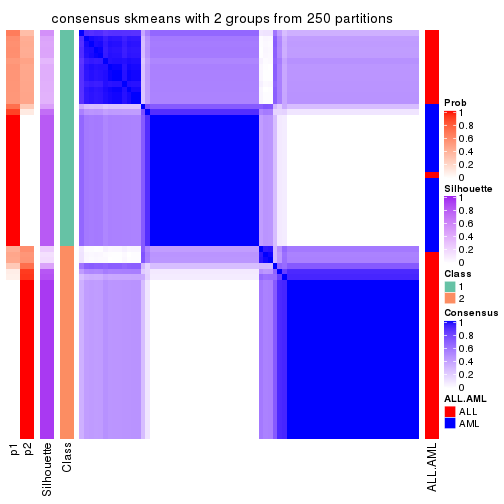
consensus_heatmap(res, k = 3)
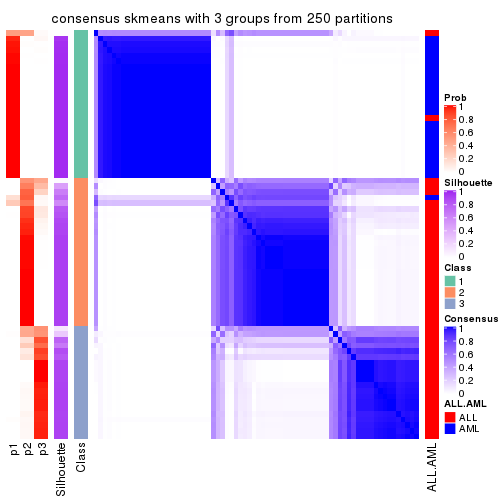
consensus_heatmap(res, k = 4)
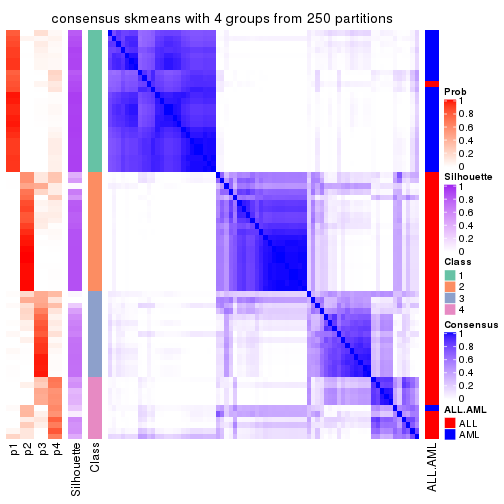
consensus_heatmap(res, k = 5)
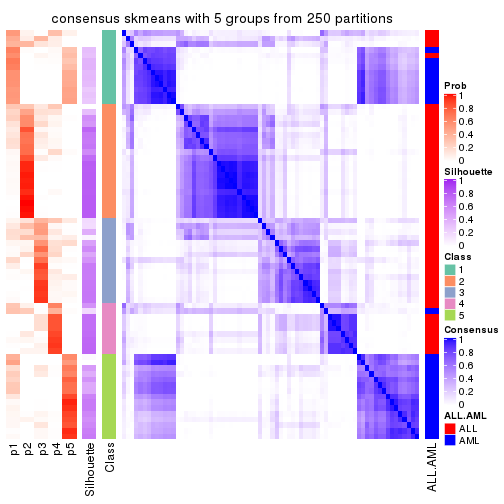
consensus_heatmap(res, k = 6)
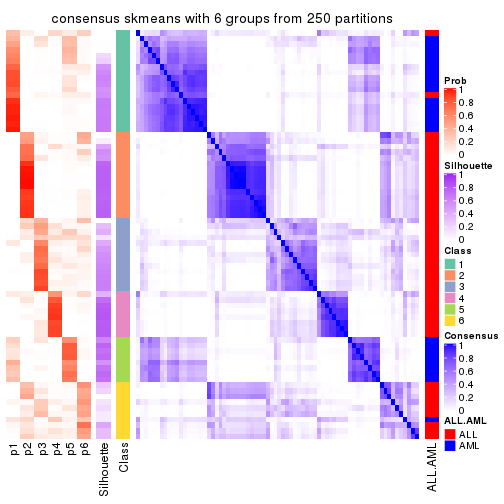
Heatmaps for the membership of samples in all partitions to see how consistent they are:
membership_heatmap(res, k = 2)
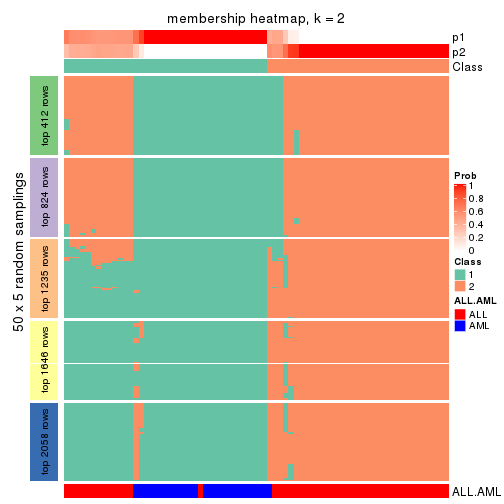
membership_heatmap(res, k = 3)
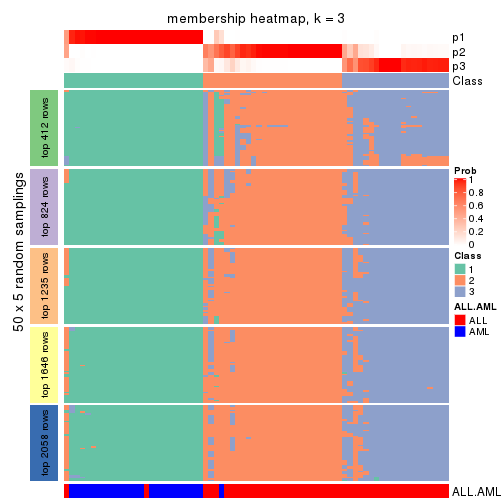
membership_heatmap(res, k = 4)
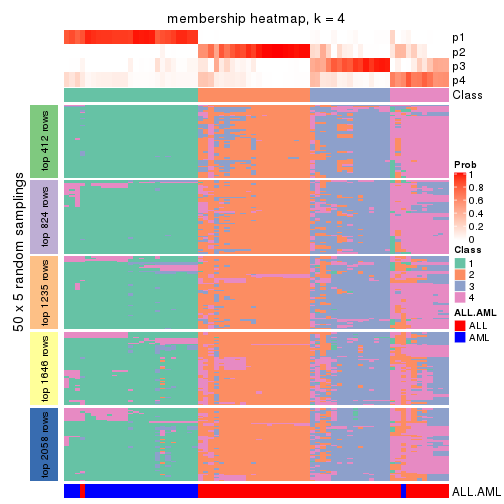
membership_heatmap(res, k = 5)
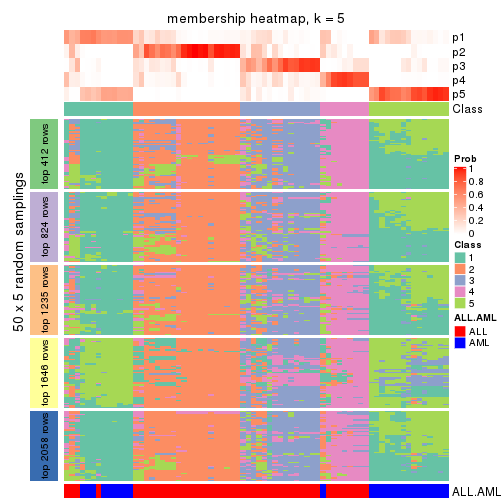
membership_heatmap(res, k = 6)
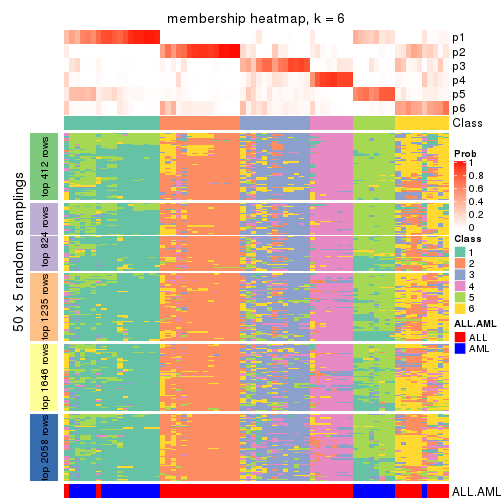
As soon as we have had the classes for columns, we can look for signatures which are significantly different between classes which can be candidate marks for certain classes. Following are the heatmaps for signatures.
Signature heatmaps where rows are scaled:
get_signatures(res, k = 2)
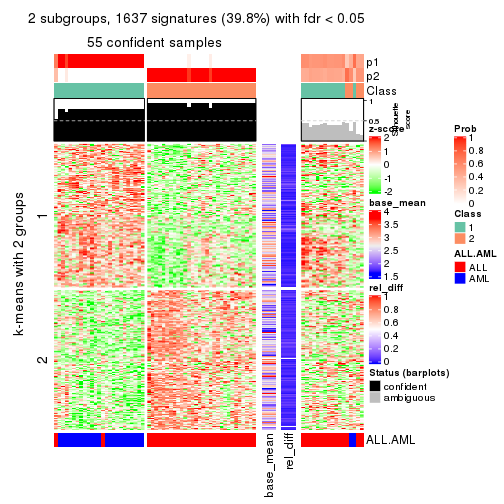
get_signatures(res, k = 3)
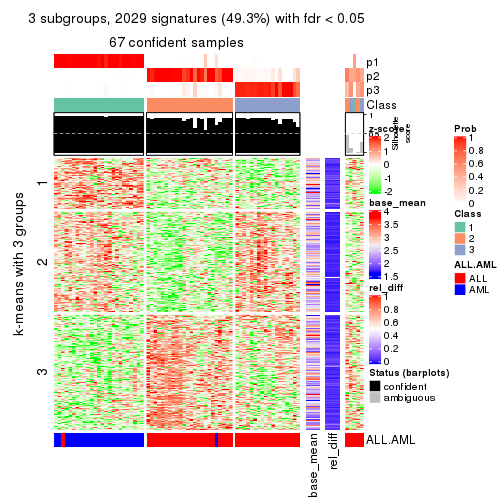
get_signatures(res, k = 4)
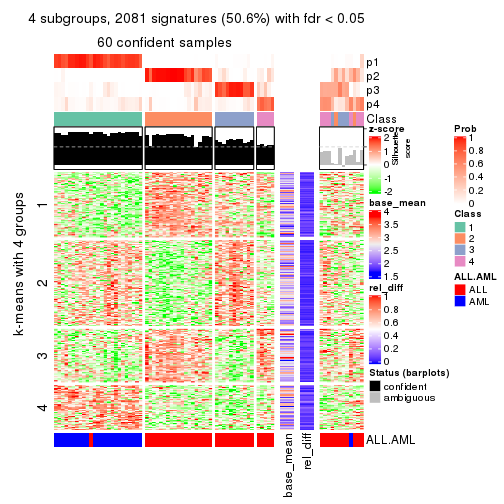
get_signatures(res, k = 5)
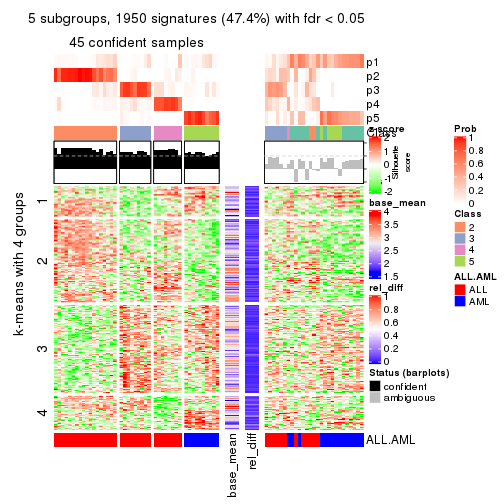
get_signatures(res, k = 6)
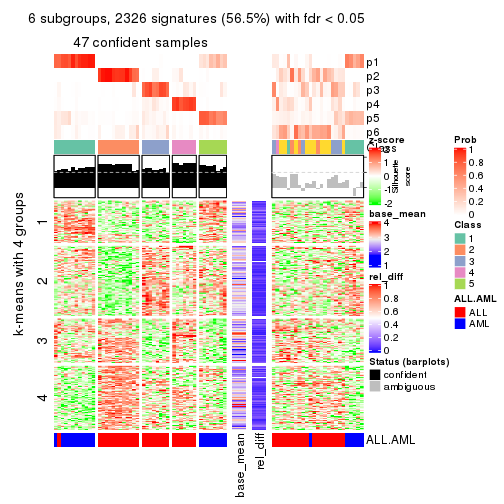
Signature heatmaps where rows are not scaled:
get_signatures(res, k = 2, scale_rows = FALSE)
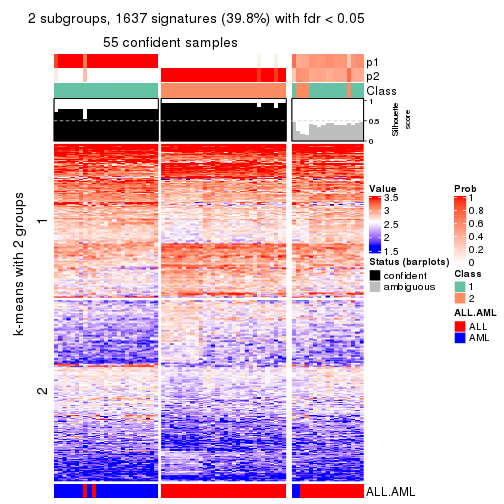
get_signatures(res, k = 3, scale_rows = FALSE)
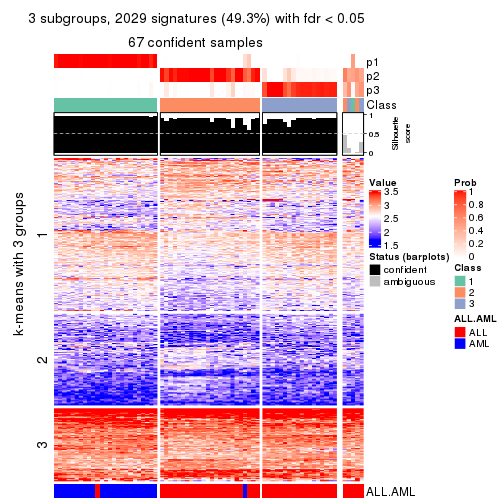
get_signatures(res, k = 4, scale_rows = FALSE)
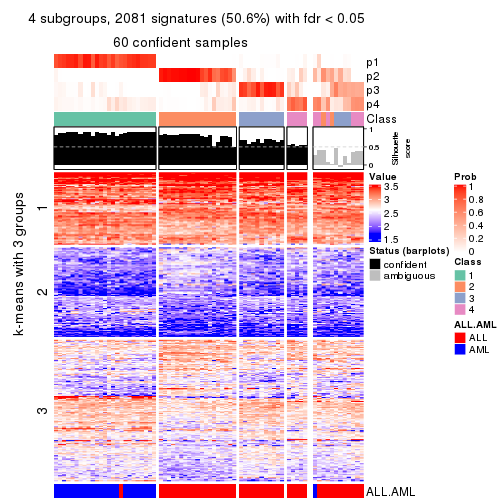
get_signatures(res, k = 5, scale_rows = FALSE)
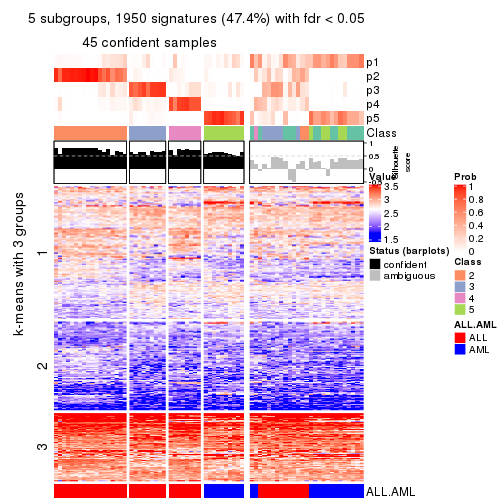
get_signatures(res, k = 6, scale_rows = FALSE)
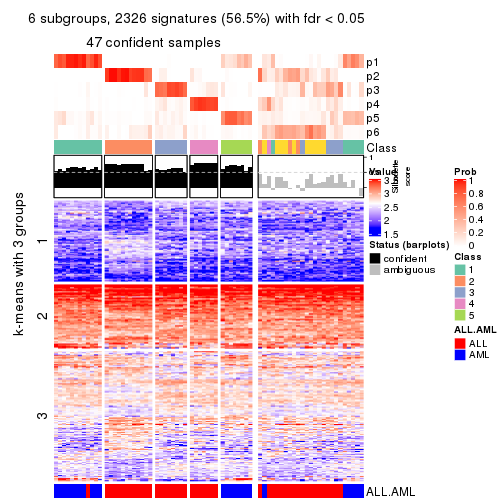
Compare the overlap of signatures from different k:
compare_signatures(res)
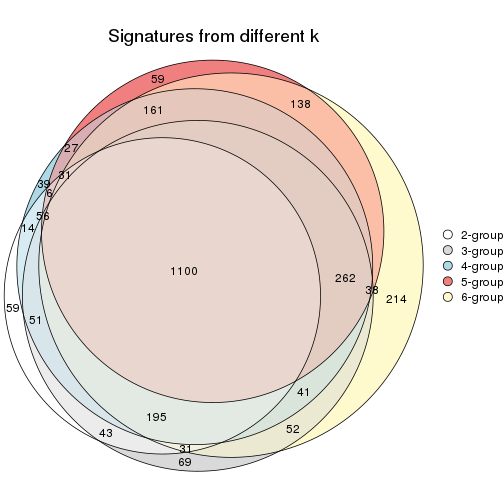
get_signature() returns a data frame invisibly. TO get the list of signatures, the function
call should be assigned to a variable explicitly. In following code, if plot argument is set
to FALSE, no heatmap is plotted while only the differential analysis is performed.
# code only for demonstration
tb = get_signature(res, k = ..., plot = FALSE)
An example of the output of tb is:
#> which_row fdr mean_1 mean_2 scaled_mean_1 scaled_mean_2 km
#> 1 38 0.042760348 8.373488 9.131774 -0.5533452 0.5164555 1
#> 2 40 0.018707592 7.106213 8.469186 -0.6173731 0.5762149 1
#> 3 55 0.019134737 10.221463 11.207825 -0.6159697 0.5749050 1
#> 4 59 0.006059896 5.921854 7.869574 -0.6899429 0.6439467 1
#> 5 60 0.018055526 8.928898 10.211722 -0.6204761 0.5791110 1
#> 6 98 0.009384629 15.714769 14.887706 0.6635654 -0.6193277 2
...
The columns in tb are:
which_row: row indices corresponding to the input matrix.fdr: FDR for the differential test. mean_x: The mean value in group x.scaled_mean_x: The mean value in group x after rows are scaled.km: Row groups if k-means clustering is applied to rows.UMAP plot which shows how samples are separated.
dimension_reduction(res, k = 2, method = "UMAP")
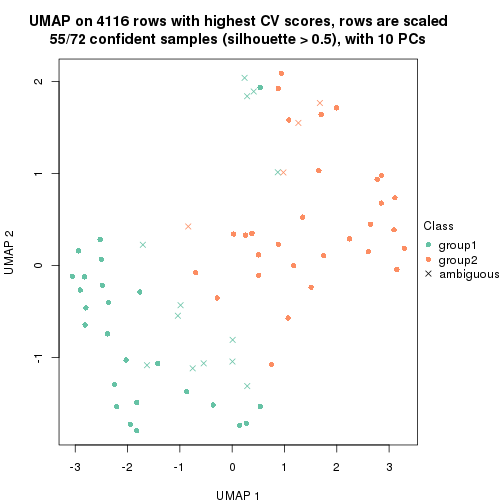
dimension_reduction(res, k = 3, method = "UMAP")
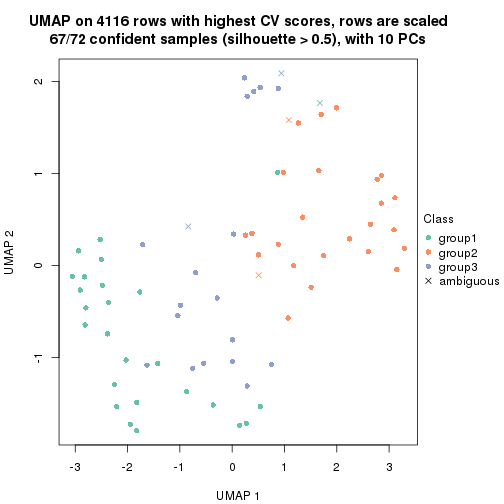
dimension_reduction(res, k = 4, method = "UMAP")
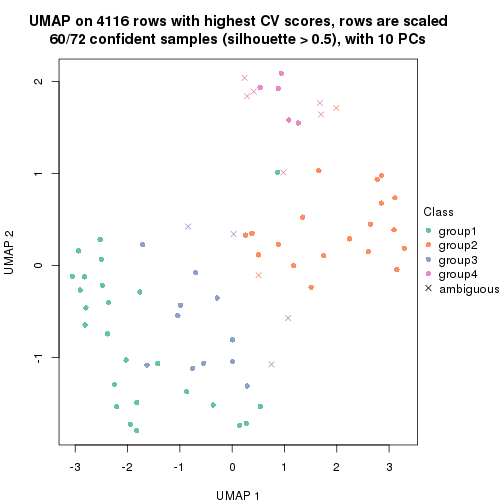
dimension_reduction(res, k = 5, method = "UMAP")
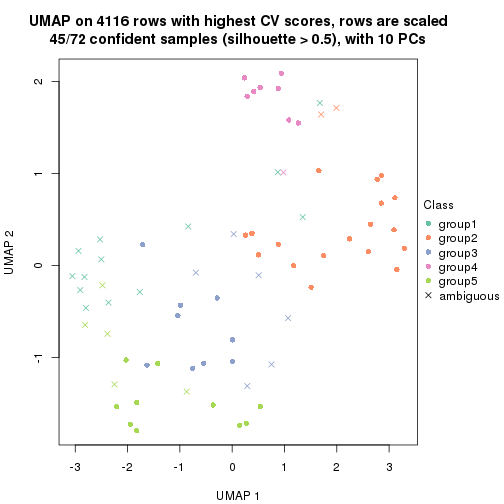
dimension_reduction(res, k = 6, method = "UMAP")
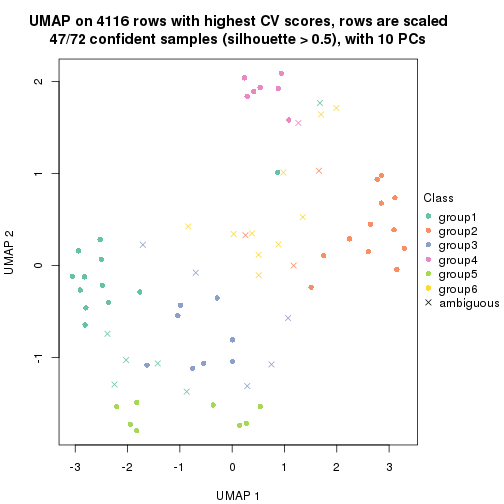
Following heatmap shows how subgroups are split when increasing k:
collect_classes(res)
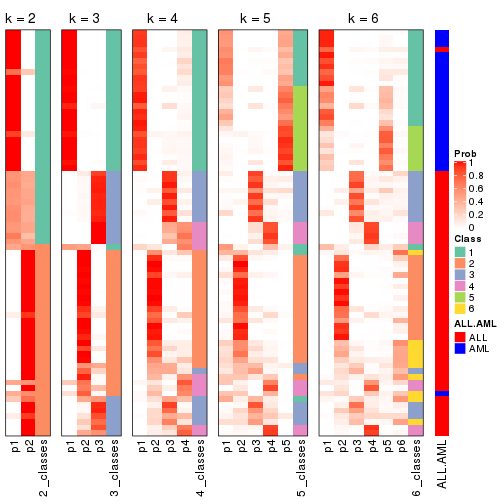
Test correlation between subgroups and known annotations. If the known annotation is numeric, one-way ANOVA test is applied, and if the known annotation is discrete, chi-squared contingency table test is applied.
test_to_known_factors(res)
#> n ALL.AML(p) k
#> CV:skmeans 55 3.77e-11 2
#> CV:skmeans 67 1.71e-13 3
#> CV:skmeans 60 4.20e-12 4
#> CV:skmeans 45 9.25e-10 5
#> CV:skmeans 47 9.43e-09 6
If matrix rows can be associated to genes, consider to use functional_enrichment(res,
...) to perform function enrichment for the signature genes. See this vignette for more detailed explanations.
The object with results only for a single top-value method and a single partition method can be extracted as:
res = res_list["CV", "pam"]
# you can also extract it by
# res = res_list["CV:pam"]
A summary of res and all the functions that can be applied to it:
res
#> A 'ConsensusPartition' object with k = 2, 3, 4, 5, 6.
#> On a matrix with 4116 rows and 72 columns.
#> Top rows (412, 824, 1235, 1646, 2058) are extracted by 'CV' method.
#> Subgroups are detected by 'pam' method.
#> Performed in total 1250 partitions by row resampling.
#> Best k for subgroups seems to be 2.
#>
#> Following methods can be applied to this 'ConsensusPartition' object:
#> [1] "cola_report" "collect_classes" "collect_plots"
#> [4] "collect_stats" "colnames" "compare_signatures"
#> [7] "consensus_heatmap" "dimension_reduction" "functional_enrichment"
#> [10] "get_anno_col" "get_anno" "get_classes"
#> [13] "get_consensus" "get_matrix" "get_membership"
#> [16] "get_param" "get_signatures" "get_stats"
#> [19] "is_best_k" "is_stable_k" "membership_heatmap"
#> [22] "ncol" "nrow" "plot_ecdf"
#> [25] "rownames" "select_partition_number" "show"
#> [28] "suggest_best_k" "test_to_known_factors"
collect_plots() function collects all the plots made from res for all k (number of partitions)
into one single page to provide an easy and fast comparison between different k.
collect_plots(res)
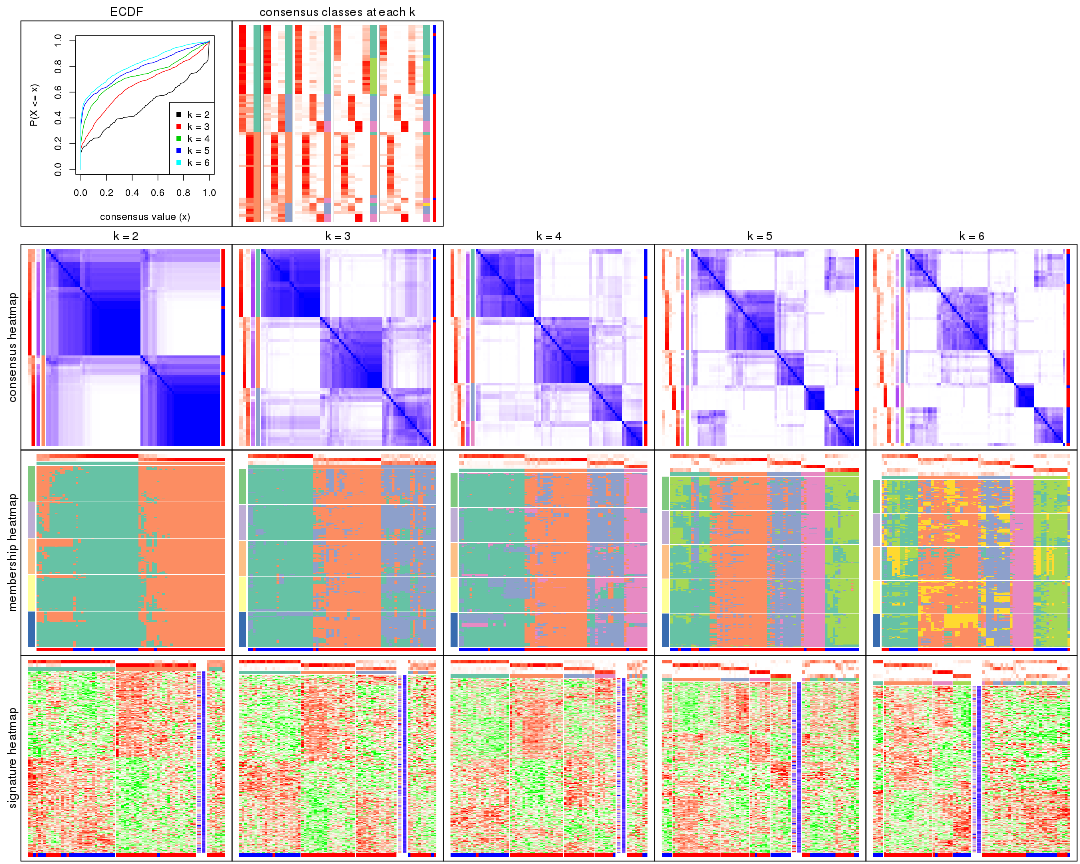
The plots are:
k and the heatmap of
predicted classes for each k.k.k.k.All the plots in panels can be made by individual functions and they are plotted later in this section.
select_partition_number() produces several plots showing different
statistics for choosing “optimized” k. There are following statistics:
k;k, the area increased is defined as \(A_k - A_{k-1}\).The detailed explanations of these statistics can be found in the cola vignette.
Generally speaking, lower PAC score, higher mean silhouette score or higher
concordance corresponds to better partition. Rand index and Jaccard index
measure how similar the current partition is compared to partition with k-1.
If they are too similar, we won't accept k is better than k-1.
select_partition_number(res)
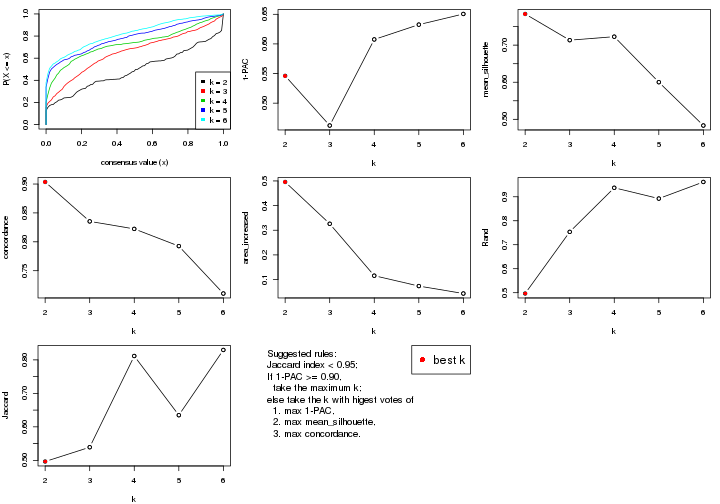
The numeric values for all these statistics can be obtained by get_stats().
get_stats(res)
#> k 1-PAC mean_silhouette concordance area_increased Rand Jaccard
#> 2 2 0.546 0.784 0.904 0.4958 0.496 0.496
#> 3 3 0.462 0.713 0.835 0.3262 0.754 0.539
#> 4 4 0.608 0.723 0.822 0.1157 0.937 0.812
#> 5 5 0.633 0.600 0.793 0.0736 0.892 0.635
#> 6 6 0.651 0.483 0.711 0.0433 0.962 0.830
suggest_best_k() suggests the best \(k\) based on these statistics. The rules are as follows:
suggest_best_k(res)
#> [1] 2
Following shows the table of the partitions (You need to click the show/hide
code output link to see it). The membership matrix (columns with name p*)
is inferred by
clue::cl_consensus()
function with the SE method. Basically the value in the membership matrix
represents the probability to belong to a certain group. The finall class
label for an item is determined with the group with highest probability it
belongs to.
In get_classes() function, the entropy is calculated from the membership
matrix and the silhouette score is calculated from the consensus matrix.
cbind(get_classes(res, k = 2), get_membership(res, k = 2))
#> class entropy silhouette p1 p2
#> sample_39 2 0.9909 0.103 0.444 0.556
#> sample_40 1 0.7745 0.739 0.772 0.228
#> sample_42 2 0.2603 0.886 0.044 0.956
#> sample_47 2 0.0000 0.909 0.000 1.000
#> sample_48 2 0.0000 0.909 0.000 1.000
#> sample_49 1 0.6438 0.799 0.836 0.164
#> sample_41 2 0.0000 0.909 0.000 1.000
#> sample_43 2 0.0000 0.909 0.000 1.000
#> sample_44 2 0.0000 0.909 0.000 1.000
#> sample_45 2 0.0000 0.909 0.000 1.000
#> sample_46 2 0.0000 0.909 0.000 1.000
#> sample_70 1 0.9963 0.242 0.536 0.464
#> sample_71 2 0.3584 0.868 0.068 0.932
#> sample_72 2 0.0672 0.904 0.008 0.992
#> sample_68 2 0.0000 0.909 0.000 1.000
#> sample_69 2 0.0000 0.909 0.000 1.000
#> sample_67 2 0.9170 0.545 0.332 0.668
#> sample_55 1 0.6973 0.781 0.812 0.188
#> sample_56 1 1.0000 0.134 0.500 0.500
#> sample_59 2 0.8386 0.571 0.268 0.732
#> sample_52 1 0.0000 0.872 1.000 0.000
#> sample_53 1 0.0000 0.872 1.000 0.000
#> sample_51 1 0.0000 0.872 1.000 0.000
#> sample_50 1 0.0000 0.872 1.000 0.000
#> sample_54 1 0.6148 0.779 0.848 0.152
#> sample_57 1 0.0000 0.872 1.000 0.000
#> sample_58 1 0.0000 0.872 1.000 0.000
#> sample_60 1 0.2603 0.861 0.956 0.044
#> sample_61 1 0.0000 0.872 1.000 0.000
#> sample_65 1 0.0000 0.872 1.000 0.000
#> sample_66 2 0.8386 0.653 0.268 0.732
#> sample_63 1 0.0000 0.872 1.000 0.000
#> sample_64 1 0.3274 0.855 0.940 0.060
#> sample_62 1 0.1843 0.865 0.972 0.028
#> sample_1 2 0.0938 0.903 0.012 0.988
#> sample_2 2 0.8081 0.684 0.248 0.752
#> sample_3 1 0.6712 0.791 0.824 0.176
#> sample_4 1 0.9988 0.223 0.520 0.480
#> sample_5 2 0.0000 0.909 0.000 1.000
#> sample_6 1 0.6048 0.809 0.852 0.148
#> sample_7 1 0.7139 0.774 0.804 0.196
#> sample_8 1 0.9977 0.199 0.528 0.472
#> sample_9 2 0.9833 0.124 0.424 0.576
#> sample_10 1 0.6438 0.798 0.836 0.164
#> sample_11 2 0.3431 0.872 0.064 0.936
#> sample_12 1 0.0376 0.871 0.996 0.004
#> sample_13 2 0.0000 0.909 0.000 1.000
#> sample_14 2 0.1184 0.901 0.016 0.984
#> sample_15 2 0.0000 0.909 0.000 1.000
#> sample_16 2 0.0000 0.909 0.000 1.000
#> sample_17 2 0.0000 0.909 0.000 1.000
#> sample_18 2 0.4298 0.851 0.088 0.912
#> sample_19 2 0.0000 0.909 0.000 1.000
#> sample_20 2 0.0000 0.909 0.000 1.000
#> sample_21 2 0.0000 0.909 0.000 1.000
#> sample_22 1 0.9881 0.262 0.564 0.436
#> sample_23 1 0.7745 0.735 0.772 0.228
#> sample_24 2 0.0000 0.909 0.000 1.000
#> sample_25 2 0.8499 0.616 0.276 0.724
#> sample_26 2 0.0000 0.909 0.000 1.000
#> sample_27 1 0.6148 0.807 0.848 0.152
#> sample_34 1 0.0000 0.872 1.000 0.000
#> sample_35 1 0.0376 0.871 0.996 0.004
#> sample_36 1 0.0000 0.872 1.000 0.000
#> sample_37 1 0.0000 0.872 1.000 0.000
#> sample_38 1 0.0376 0.871 0.996 0.004
#> sample_28 1 0.0000 0.872 1.000 0.000
#> sample_29 1 0.4431 0.823 0.908 0.092
#> sample_30 1 0.0000 0.872 1.000 0.000
#> sample_31 1 0.0000 0.872 1.000 0.000
#> sample_32 1 0.0000 0.872 1.000 0.000
#> sample_33 1 0.0000 0.872 1.000 0.000
cbind(get_classes(res, k = 3), get_membership(res, k = 3))
#> class entropy silhouette p1 p2 p3
#> sample_39 3 0.8638 0.622 0.216 0.184 0.600
#> sample_40 3 0.6750 0.614 0.336 0.024 0.640
#> sample_42 2 0.3375 0.788 0.008 0.892 0.100
#> sample_47 2 0.1860 0.814 0.000 0.948 0.052
#> sample_48 2 0.0000 0.815 0.000 1.000 0.000
#> sample_49 3 0.5956 0.622 0.324 0.004 0.672
#> sample_41 2 0.5058 0.614 0.000 0.756 0.244
#> sample_43 2 0.3551 0.778 0.000 0.868 0.132
#> sample_44 2 0.6225 0.238 0.000 0.568 0.432
#> sample_45 2 0.0892 0.817 0.000 0.980 0.020
#> sample_46 2 0.1163 0.815 0.000 0.972 0.028
#> sample_70 3 0.6599 0.712 0.168 0.084 0.748
#> sample_71 2 0.5816 0.699 0.056 0.788 0.156
#> sample_72 2 0.2448 0.806 0.000 0.924 0.076
#> sample_68 2 0.0000 0.815 0.000 1.000 0.000
#> sample_69 2 0.0000 0.815 0.000 1.000 0.000
#> sample_67 2 0.8069 0.450 0.244 0.636 0.120
#> sample_55 3 0.6630 0.644 0.300 0.028 0.672
#> sample_56 3 0.8061 0.679 0.192 0.156 0.652
#> sample_59 3 0.8395 0.428 0.096 0.356 0.548
#> sample_52 1 0.0000 0.919 1.000 0.000 0.000
#> sample_53 1 0.1643 0.906 0.956 0.000 0.044
#> sample_51 1 0.0000 0.919 1.000 0.000 0.000
#> sample_50 1 0.0000 0.919 1.000 0.000 0.000
#> sample_54 1 0.4413 0.767 0.852 0.124 0.024
#> sample_57 1 0.0237 0.917 0.996 0.000 0.004
#> sample_58 1 0.0000 0.919 1.000 0.000 0.000
#> sample_60 1 0.2774 0.858 0.920 0.008 0.072
#> sample_61 1 0.2625 0.891 0.916 0.000 0.084
#> sample_65 1 0.1031 0.910 0.976 0.000 0.024
#> sample_66 2 0.7806 0.412 0.064 0.584 0.352
#> sample_63 1 0.0000 0.919 1.000 0.000 0.000
#> sample_64 1 0.5529 0.442 0.704 0.000 0.296
#> sample_62 1 0.1753 0.883 0.952 0.000 0.048
#> sample_1 3 0.6565 0.271 0.008 0.416 0.576
#> sample_2 2 0.8902 0.333 0.144 0.536 0.320
#> sample_3 3 0.2537 0.680 0.080 0.000 0.920
#> sample_4 3 0.6880 0.670 0.108 0.156 0.736
#> sample_5 2 0.0000 0.815 0.000 1.000 0.000
#> sample_6 3 0.3116 0.689 0.108 0.000 0.892
#> sample_7 3 0.7037 0.622 0.328 0.036 0.636
#> sample_8 3 0.8862 0.646 0.232 0.192 0.576
#> sample_9 3 0.4945 0.638 0.056 0.104 0.840
#> sample_10 3 0.3752 0.658 0.144 0.000 0.856
#> sample_11 3 0.7566 -0.150 0.040 0.448 0.512
#> sample_12 1 0.3784 0.818 0.864 0.004 0.132
#> sample_13 2 0.0000 0.815 0.000 1.000 0.000
#> sample_14 3 0.5291 0.414 0.000 0.268 0.732
#> sample_15 2 0.2959 0.777 0.000 0.900 0.100
#> sample_16 2 0.4654 0.676 0.000 0.792 0.208
#> sample_17 2 0.3412 0.786 0.000 0.876 0.124
#> sample_18 3 0.9223 0.308 0.172 0.324 0.504
#> sample_19 2 0.2165 0.809 0.000 0.936 0.064
#> sample_20 2 0.0000 0.815 0.000 1.000 0.000
#> sample_21 2 0.1031 0.815 0.000 0.976 0.024
#> sample_22 3 0.7565 0.646 0.256 0.084 0.660
#> sample_23 3 0.2959 0.687 0.100 0.000 0.900
#> sample_24 2 0.4974 0.621 0.000 0.764 0.236
#> sample_25 2 0.8854 0.351 0.188 0.576 0.236
#> sample_26 2 0.3816 0.753 0.000 0.852 0.148
#> sample_27 3 0.5948 0.575 0.360 0.000 0.640
#> sample_34 1 0.0000 0.919 1.000 0.000 0.000
#> sample_35 1 0.4654 0.641 0.792 0.000 0.208
#> sample_36 1 0.1529 0.908 0.960 0.000 0.040
#> sample_37 1 0.1643 0.906 0.956 0.000 0.044
#> sample_38 1 0.2860 0.881 0.912 0.004 0.084
#> sample_28 1 0.2448 0.885 0.924 0.000 0.076
#> sample_29 1 0.3742 0.858 0.892 0.036 0.072
#> sample_30 1 0.0000 0.919 1.000 0.000 0.000
#> sample_31 1 0.0237 0.917 0.996 0.000 0.004
#> sample_32 1 0.0592 0.917 0.988 0.000 0.012
#> sample_33 1 0.1643 0.906 0.956 0.000 0.044
cbind(get_classes(res, k = 4), get_membership(res, k = 4))
#> class entropy silhouette p1 p2 p3 p4
#> sample_39 3 0.5250 0.6191 0.096 0.072 0.792 0.040
#> sample_40 3 0.3351 0.7386 0.148 0.000 0.844 0.008
#> sample_42 2 0.4370 0.7599 0.024 0.828 0.116 0.032
#> sample_47 2 0.2048 0.8206 0.000 0.928 0.064 0.008
#> sample_48 2 0.0000 0.8270 0.000 1.000 0.000 0.000
#> sample_49 3 0.3300 0.7392 0.144 0.000 0.848 0.008
#> sample_41 2 0.3975 0.6495 0.000 0.760 0.240 0.000
#> sample_43 2 0.3266 0.7641 0.000 0.832 0.168 0.000
#> sample_44 2 0.6483 0.2602 0.000 0.532 0.392 0.076
#> sample_45 2 0.1302 0.8252 0.000 0.956 0.044 0.000
#> sample_46 2 0.0817 0.8264 0.000 0.976 0.024 0.000
#> sample_70 3 0.6376 0.6207 0.084 0.024 0.684 0.208
#> sample_71 2 0.6323 0.6230 0.052 0.700 0.196 0.052
#> sample_72 2 0.2198 0.8153 0.000 0.920 0.072 0.008
#> sample_68 2 0.0000 0.8270 0.000 1.000 0.000 0.000
#> sample_69 2 0.0000 0.8270 0.000 1.000 0.000 0.000
#> sample_67 2 0.8144 0.3643 0.236 0.548 0.156 0.060
#> sample_55 3 0.6192 0.7055 0.132 0.028 0.720 0.120
#> sample_56 3 0.4807 0.7492 0.124 0.064 0.800 0.012
#> sample_59 3 0.4635 0.5604 0.012 0.268 0.720 0.000
#> sample_52 1 0.2578 0.8273 0.912 0.000 0.036 0.052
#> sample_53 1 0.3694 0.8153 0.844 0.000 0.124 0.032
#> sample_51 1 0.1624 0.8430 0.952 0.000 0.020 0.028
#> sample_50 1 0.1833 0.8443 0.944 0.000 0.024 0.032
#> sample_54 1 0.4578 0.7931 0.832 0.056 0.044 0.068
#> sample_57 1 0.2670 0.8257 0.908 0.000 0.040 0.052
#> sample_58 1 0.2494 0.8273 0.916 0.000 0.036 0.048
#> sample_60 1 0.3734 0.7911 0.856 0.004 0.096 0.044
#> sample_61 1 0.4735 0.7950 0.784 0.000 0.148 0.068
#> sample_65 1 0.1677 0.8434 0.948 0.000 0.012 0.040
#> sample_66 4 0.4632 0.6381 0.012 0.244 0.004 0.740
#> sample_63 1 0.2578 0.8273 0.912 0.000 0.036 0.052
#> sample_64 1 0.6488 0.0312 0.500 0.004 0.436 0.060
#> sample_62 1 0.2928 0.8212 0.896 0.000 0.052 0.052
#> sample_1 3 0.5057 0.4591 0.000 0.340 0.648 0.012
#> sample_2 4 0.6810 0.4348 0.056 0.316 0.032 0.596
#> sample_3 4 0.2589 0.8232 0.000 0.000 0.116 0.884
#> sample_4 3 0.5781 0.6893 0.044 0.072 0.756 0.128
#> sample_5 2 0.0000 0.8270 0.000 1.000 0.000 0.000
#> sample_6 4 0.2976 0.8150 0.008 0.000 0.120 0.872
#> sample_7 3 0.5723 0.7309 0.128 0.048 0.760 0.064
#> sample_8 3 0.5701 0.6926 0.124 0.132 0.736 0.008
#> sample_9 4 0.2450 0.8370 0.000 0.016 0.072 0.912
#> sample_10 4 0.1635 0.8021 0.044 0.000 0.008 0.948
#> sample_11 4 0.2269 0.8165 0.032 0.028 0.008 0.932
#> sample_12 1 0.4254 0.8015 0.828 0.004 0.104 0.064
#> sample_13 2 0.0000 0.8270 0.000 1.000 0.000 0.000
#> sample_14 4 0.2670 0.8361 0.000 0.024 0.072 0.904
#> sample_15 2 0.2647 0.7738 0.000 0.880 0.120 0.000
#> sample_16 2 0.3801 0.6914 0.000 0.780 0.220 0.000
#> sample_17 2 0.3962 0.7395 0.000 0.820 0.028 0.152
#> sample_18 3 0.9562 0.1143 0.132 0.216 0.360 0.292
#> sample_19 2 0.1940 0.8186 0.000 0.924 0.076 0.000
#> sample_20 2 0.0000 0.8270 0.000 1.000 0.000 0.000
#> sample_21 2 0.0592 0.8271 0.000 0.984 0.016 0.000
#> sample_22 3 0.3607 0.6451 0.096 0.008 0.864 0.032
#> sample_23 4 0.2918 0.8190 0.008 0.000 0.116 0.876
#> sample_24 2 0.4331 0.5709 0.000 0.712 0.288 0.000
#> sample_25 2 0.8453 0.2841 0.128 0.488 0.308 0.076
#> sample_26 2 0.3074 0.7752 0.000 0.848 0.152 0.000
#> sample_27 3 0.3962 0.7375 0.152 0.000 0.820 0.028
#> sample_34 1 0.1837 0.8445 0.944 0.000 0.028 0.028
#> sample_35 1 0.5364 0.3935 0.652 0.000 0.320 0.028
#> sample_36 1 0.4274 0.8193 0.808 0.000 0.148 0.044
#> sample_37 1 0.3749 0.8143 0.840 0.000 0.128 0.032
#> sample_38 1 0.4867 0.7881 0.784 0.004 0.144 0.068
#> sample_28 1 0.3999 0.8057 0.824 0.000 0.140 0.036
#> sample_29 1 0.5215 0.7828 0.780 0.028 0.140 0.052
#> sample_30 1 0.2408 0.8379 0.920 0.000 0.036 0.044
#> sample_31 1 0.0927 0.8452 0.976 0.000 0.016 0.008
#> sample_32 1 0.2256 0.8418 0.924 0.000 0.020 0.056
#> sample_33 1 0.3999 0.8068 0.824 0.000 0.140 0.036
cbind(get_classes(res, k = 5), get_membership(res, k = 5))
#> class entropy silhouette p1 p2 p3 p4 p5
#> sample_39 1 0.5529 0.03570 0.512 0.068 0.420 0.000 0.000
#> sample_40 3 0.1106 0.76195 0.012 0.000 0.964 0.000 0.024
#> sample_42 2 0.4418 0.68520 0.180 0.756 0.060 0.004 0.000
#> sample_47 2 0.2136 0.80179 0.008 0.904 0.088 0.000 0.000
#> sample_48 2 0.0290 0.81510 0.008 0.992 0.000 0.000 0.000
#> sample_49 3 0.1331 0.76290 0.040 0.000 0.952 0.000 0.008
#> sample_41 2 0.4173 0.51182 0.012 0.688 0.300 0.000 0.000
#> sample_43 2 0.4192 0.66649 0.032 0.736 0.232 0.000 0.000
#> sample_44 3 0.5481 0.00644 0.032 0.456 0.496 0.016 0.000
#> sample_45 2 0.2036 0.80891 0.024 0.920 0.056 0.000 0.000
#> sample_46 2 0.1195 0.81478 0.028 0.960 0.012 0.000 0.000
#> sample_70 3 0.4911 0.68447 0.064 0.016 0.768 0.132 0.020
#> sample_71 2 0.5618 0.47053 0.320 0.604 0.060 0.016 0.000
#> sample_72 2 0.2473 0.79586 0.032 0.896 0.072 0.000 0.000
#> sample_68 2 0.0404 0.81484 0.012 0.988 0.000 0.000 0.000
#> sample_69 2 0.0000 0.81540 0.000 1.000 0.000 0.000 0.000
#> sample_67 2 0.7184 0.11228 0.344 0.472 0.016 0.024 0.144
#> sample_55 3 0.4210 0.72325 0.040 0.024 0.832 0.044 0.060
#> sample_56 3 0.1911 0.76601 0.036 0.028 0.932 0.004 0.000
#> sample_59 3 0.4404 0.54306 0.032 0.264 0.704 0.000 0.000
#> sample_52 5 0.0794 0.70356 0.028 0.000 0.000 0.000 0.972
#> sample_53 5 0.4307 -0.20279 0.496 0.000 0.000 0.000 0.504
#> sample_51 1 0.3395 0.49886 0.764 0.000 0.000 0.000 0.236
#> sample_50 1 0.3966 0.43097 0.664 0.000 0.000 0.000 0.336
#> sample_54 5 0.1356 0.68760 0.004 0.028 0.000 0.012 0.956
#> sample_57 5 0.2516 0.65047 0.140 0.000 0.000 0.000 0.860
#> sample_58 5 0.1851 0.70177 0.088 0.000 0.000 0.000 0.912
#> sample_60 5 0.2573 0.67228 0.104 0.000 0.016 0.000 0.880
#> sample_61 1 0.3910 0.48954 0.720 0.000 0.000 0.008 0.272
#> sample_65 5 0.3837 0.45809 0.308 0.000 0.000 0.000 0.692
#> sample_66 4 0.3495 0.73942 0.032 0.152 0.000 0.816 0.000
#> sample_63 5 0.0703 0.70220 0.024 0.000 0.000 0.000 0.976
#> sample_64 5 0.5880 0.39036 0.172 0.000 0.228 0.000 0.600
#> sample_62 5 0.0510 0.70534 0.016 0.000 0.000 0.000 0.984
#> sample_1 3 0.3929 0.66886 0.028 0.208 0.764 0.000 0.000
#> sample_2 4 0.6073 0.42290 0.124 0.296 0.000 0.572 0.008
#> sample_3 4 0.0290 0.90406 0.000 0.000 0.008 0.992 0.000
#> sample_4 3 0.2276 0.76216 0.008 0.076 0.908 0.004 0.004
#> sample_5 2 0.0404 0.81484 0.012 0.988 0.000 0.000 0.000
#> sample_6 4 0.0510 0.90002 0.000 0.000 0.016 0.984 0.000
#> sample_7 3 0.2502 0.76359 0.020 0.040 0.912 0.004 0.024
#> sample_8 3 0.3620 0.72433 0.032 0.128 0.828 0.000 0.012
#> sample_9 4 0.0000 0.90606 0.000 0.000 0.000 1.000 0.000
#> sample_10 4 0.0000 0.90606 0.000 0.000 0.000 1.000 0.000
#> sample_11 4 0.0000 0.90606 0.000 0.000 0.000 1.000 0.000
#> sample_12 1 0.4240 0.46375 0.684 0.000 0.008 0.004 0.304
#> sample_13 2 0.0000 0.81540 0.000 1.000 0.000 0.000 0.000
#> sample_14 4 0.0162 0.90477 0.004 0.000 0.000 0.996 0.000
#> sample_15 2 0.2522 0.76222 0.012 0.880 0.108 0.000 0.000
#> sample_16 2 0.4339 0.54248 0.020 0.684 0.296 0.000 0.000
#> sample_17 2 0.4067 0.72173 0.016 0.804 0.048 0.132 0.000
#> sample_18 3 0.8938 0.10351 0.264 0.232 0.284 0.204 0.016
#> sample_19 2 0.2522 0.79276 0.012 0.880 0.108 0.000 0.000
#> sample_20 2 0.0000 0.81540 0.000 1.000 0.000 0.000 0.000
#> sample_21 2 0.1205 0.81201 0.004 0.956 0.040 0.000 0.000
#> sample_22 1 0.4594 0.05033 0.508 0.004 0.484 0.000 0.004
#> sample_23 4 0.0510 0.90002 0.000 0.000 0.016 0.984 0.000
#> sample_24 2 0.4270 0.47904 0.012 0.668 0.320 0.000 0.000
#> sample_25 1 0.6239 0.30000 0.580 0.256 0.152 0.012 0.000
#> sample_26 2 0.3885 0.72783 0.040 0.784 0.176 0.000 0.000
#> sample_27 3 0.2536 0.74416 0.044 0.000 0.900 0.004 0.052
#> sample_34 1 0.4300 0.10196 0.524 0.000 0.000 0.000 0.476
#> sample_35 1 0.4919 0.40817 0.652 0.000 0.040 0.004 0.304
#> sample_36 5 0.3586 0.47889 0.264 0.000 0.000 0.000 0.736
#> sample_37 1 0.4201 0.29705 0.592 0.000 0.000 0.000 0.408
#> sample_38 1 0.3612 0.53247 0.764 0.000 0.000 0.008 0.228
#> sample_28 1 0.3424 0.53256 0.760 0.000 0.000 0.000 0.240
#> sample_29 1 0.3715 0.53625 0.736 0.004 0.000 0.000 0.260
#> sample_30 5 0.3210 0.54926 0.212 0.000 0.000 0.000 0.788
#> sample_31 5 0.4582 0.18273 0.416 0.000 0.012 0.000 0.572
#> sample_32 1 0.3857 0.44663 0.688 0.000 0.000 0.000 0.312
#> sample_33 1 0.3636 0.50272 0.728 0.000 0.000 0.000 0.272
cbind(get_classes(res, k = 6), get_membership(res, k = 6))
#> class entropy silhouette p1 p2 p3 p4 p5 p6
#> sample_39 6 0.6274 0.0000 0.220 0.020 0.288 0.000 0.000 0.472
#> sample_40 3 0.1636 0.4686 0.004 0.000 0.936 0.000 0.036 0.024
#> sample_42 2 0.5101 0.6008 0.104 0.652 0.008 0.004 0.000 0.232
#> sample_47 2 0.2901 0.7067 0.000 0.840 0.032 0.000 0.000 0.128
#> sample_48 2 0.0458 0.7277 0.000 0.984 0.000 0.000 0.000 0.016
#> sample_49 3 0.3309 0.2886 0.000 0.000 0.720 0.000 0.000 0.280
#> sample_41 2 0.4377 0.5477 0.000 0.688 0.244 0.000 0.000 0.068
#> sample_43 2 0.5102 0.5632 0.000 0.620 0.140 0.000 0.000 0.240
#> sample_44 2 0.6076 0.0297 0.000 0.384 0.344 0.000 0.000 0.272
#> sample_45 2 0.3665 0.6712 0.000 0.728 0.020 0.000 0.000 0.252
#> sample_46 2 0.3558 0.6868 0.000 0.736 0.016 0.000 0.000 0.248
#> sample_70 3 0.5597 0.0953 0.008 0.008 0.564 0.068 0.012 0.340
#> sample_71 2 0.6620 0.2076 0.224 0.412 0.016 0.012 0.000 0.336
#> sample_72 2 0.4045 0.6397 0.004 0.700 0.028 0.000 0.000 0.268
#> sample_68 2 0.2278 0.7247 0.000 0.868 0.004 0.000 0.000 0.128
#> sample_69 2 0.1765 0.7228 0.000 0.904 0.000 0.000 0.000 0.096
#> sample_67 2 0.7104 0.0905 0.296 0.376 0.000 0.012 0.044 0.272
#> sample_55 3 0.3546 0.4544 0.000 0.044 0.840 0.024 0.076 0.016
#> sample_56 3 0.4292 0.2061 0.000 0.032 0.628 0.000 0.000 0.340
#> sample_59 3 0.5948 0.0991 0.000 0.284 0.456 0.000 0.000 0.260
#> sample_52 5 0.2562 0.6459 0.172 0.000 0.000 0.000 0.828 0.000
#> sample_53 1 0.4224 0.2035 0.632 0.000 0.000 0.000 0.340 0.028
#> sample_51 1 0.4918 0.4635 0.644 0.000 0.000 0.000 0.232 0.124
#> sample_50 1 0.3645 0.4877 0.740 0.000 0.000 0.000 0.236 0.024
#> sample_54 5 0.3073 0.6399 0.140 0.020 0.000 0.004 0.832 0.004
#> sample_57 5 0.3163 0.5550 0.040 0.000 0.000 0.000 0.820 0.140
#> sample_58 5 0.3062 0.6412 0.160 0.000 0.000 0.000 0.816 0.024
#> sample_60 5 0.2462 0.6322 0.064 0.000 0.012 0.000 0.892 0.032
#> sample_61 1 0.5644 0.4447 0.576 0.000 0.020 0.000 0.280 0.124
#> sample_65 5 0.4455 0.4530 0.240 0.000 0.000 0.000 0.684 0.076
#> sample_66 4 0.3300 0.6991 0.024 0.148 0.000 0.816 0.000 0.012
#> sample_63 5 0.2491 0.6452 0.164 0.000 0.000 0.000 0.836 0.000
#> sample_64 5 0.5634 0.3857 0.048 0.000 0.172 0.000 0.640 0.140
#> sample_62 5 0.2178 0.6549 0.132 0.000 0.000 0.000 0.868 0.000
#> sample_1 3 0.4545 0.3308 0.000 0.176 0.700 0.000 0.000 0.124
#> sample_2 4 0.7109 0.1227 0.096 0.240 0.000 0.424 0.000 0.240
#> sample_3 4 0.0291 0.8803 0.000 0.000 0.004 0.992 0.000 0.004
#> sample_4 3 0.2325 0.4930 0.000 0.060 0.892 0.000 0.000 0.048
#> sample_5 2 0.2178 0.7249 0.000 0.868 0.000 0.000 0.000 0.132
#> sample_6 4 0.0363 0.8785 0.000 0.000 0.012 0.988 0.000 0.000
#> sample_7 3 0.2295 0.4975 0.000 0.036 0.908 0.004 0.012 0.040
#> sample_8 3 0.3795 0.4014 0.004 0.112 0.788 0.000 0.000 0.096
#> sample_9 4 0.0000 0.8828 0.000 0.000 0.000 1.000 0.000 0.000
#> sample_10 4 0.0000 0.8828 0.000 0.000 0.000 1.000 0.000 0.000
#> sample_11 4 0.0000 0.8828 0.000 0.000 0.000 1.000 0.000 0.000
#> sample_12 1 0.4555 0.4500 0.628 0.000 0.008 0.000 0.328 0.036
#> sample_13 2 0.0260 0.7291 0.000 0.992 0.000 0.000 0.000 0.008
#> sample_14 4 0.0146 0.8812 0.004 0.000 0.000 0.996 0.000 0.000
#> sample_15 2 0.2966 0.7004 0.000 0.848 0.076 0.000 0.000 0.076
#> sample_16 2 0.5095 0.5290 0.000 0.632 0.188 0.000 0.000 0.180
#> sample_17 2 0.4656 0.6579 0.008 0.752 0.040 0.128 0.000 0.072
#> sample_18 3 0.8918 -0.2594 0.236 0.212 0.244 0.192 0.004 0.112
#> sample_19 2 0.3602 0.6852 0.000 0.784 0.056 0.000 0.000 0.160
#> sample_20 2 0.1444 0.7266 0.000 0.928 0.000 0.000 0.000 0.072
#> sample_21 2 0.2066 0.7164 0.000 0.904 0.024 0.000 0.000 0.072
#> sample_22 1 0.5568 -0.4051 0.468 0.000 0.408 0.000 0.004 0.120
#> sample_23 4 0.0363 0.8785 0.000 0.000 0.012 0.988 0.000 0.000
#> sample_24 2 0.4652 0.4798 0.000 0.640 0.288 0.000 0.000 0.072
#> sample_25 1 0.6518 -0.0800 0.528 0.144 0.056 0.008 0.000 0.264
#> sample_26 2 0.5350 0.5575 0.000 0.564 0.140 0.000 0.000 0.296
#> sample_27 3 0.3841 0.2945 0.000 0.000 0.716 0.000 0.028 0.256
#> sample_34 5 0.5519 -0.0603 0.344 0.000 0.000 0.000 0.512 0.144
#> sample_35 1 0.6257 0.2056 0.420 0.000 0.020 0.004 0.400 0.156
#> sample_36 5 0.3756 0.4031 0.400 0.000 0.000 0.000 0.600 0.000
#> sample_37 1 0.3050 0.3937 0.764 0.000 0.000 0.000 0.236 0.000
#> sample_38 1 0.1196 0.5706 0.952 0.000 0.000 0.000 0.040 0.008
#> sample_28 1 0.1858 0.5819 0.912 0.000 0.000 0.000 0.076 0.012
#> sample_29 1 0.2400 0.5817 0.872 0.008 0.000 0.000 0.116 0.004
#> sample_30 5 0.3706 0.4234 0.380 0.000 0.000 0.000 0.620 0.000
#> sample_31 5 0.5488 0.1816 0.264 0.000 0.008 0.000 0.584 0.144
#> sample_32 1 0.5294 0.3562 0.532 0.000 0.000 0.000 0.356 0.112
#> sample_33 1 0.1387 0.5612 0.932 0.000 0.000 0.000 0.068 0.000
Heatmaps for the consensus matrix. It visualizes the probability of two samples to be in a same group.
consensus_heatmap(res, k = 2)
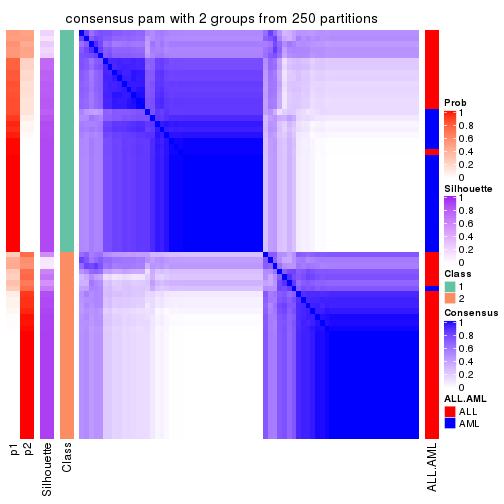
consensus_heatmap(res, k = 3)
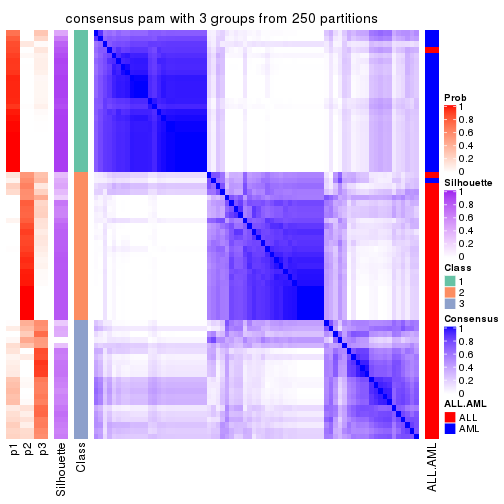
consensus_heatmap(res, k = 4)
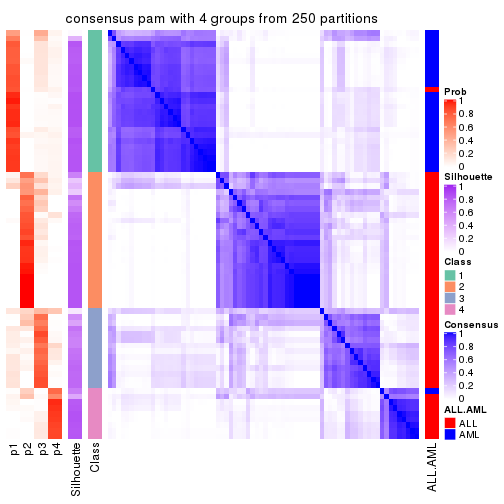
consensus_heatmap(res, k = 5)
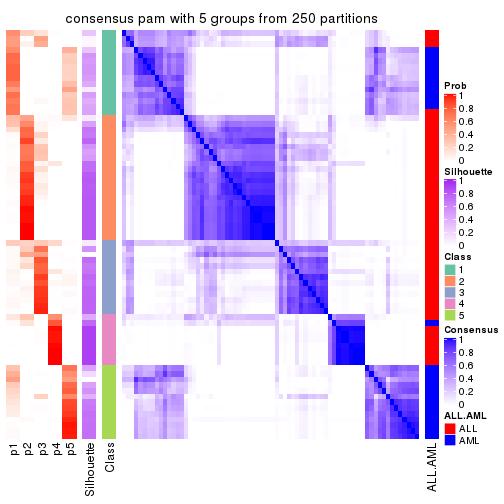
consensus_heatmap(res, k = 6)
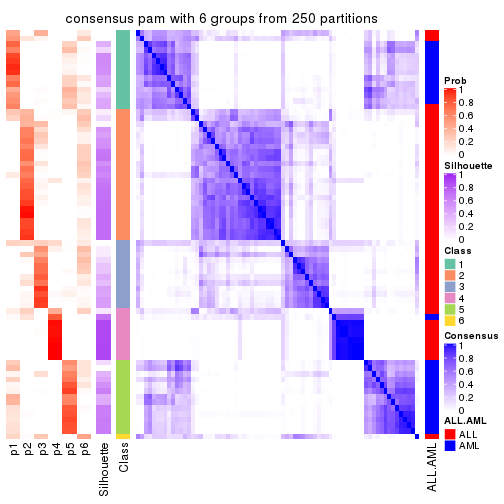
Heatmaps for the membership of samples in all partitions to see how consistent they are:
membership_heatmap(res, k = 2)
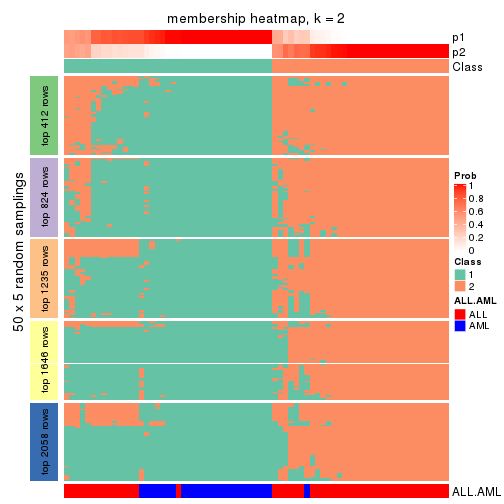
membership_heatmap(res, k = 3)
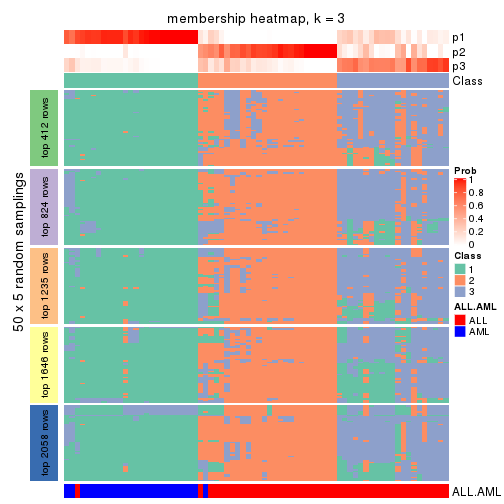
membership_heatmap(res, k = 4)
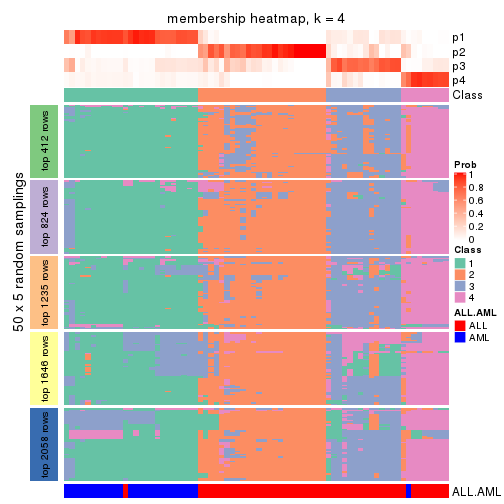
membership_heatmap(res, k = 5)
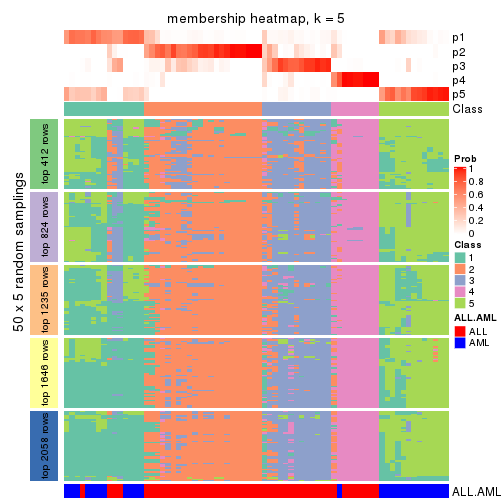
membership_heatmap(res, k = 6)
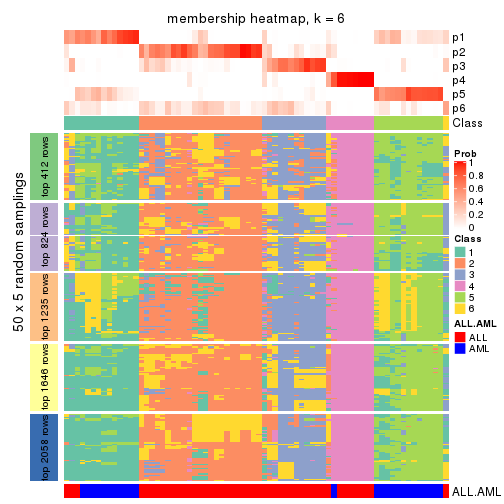
As soon as we have had the classes for columns, we can look for signatures which are significantly different between classes which can be candidate marks for certain classes. Following are the heatmaps for signatures.
Signature heatmaps where rows are scaled:
get_signatures(res, k = 2)
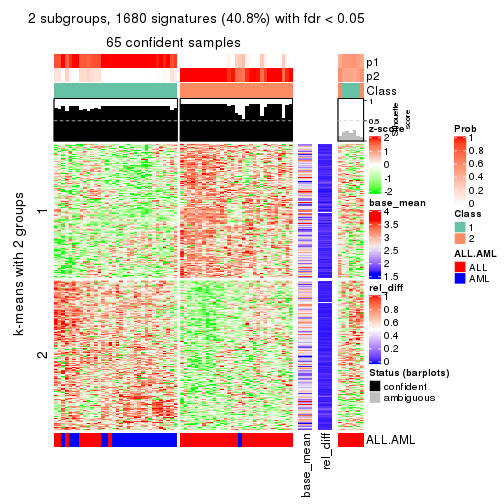
get_signatures(res, k = 3)
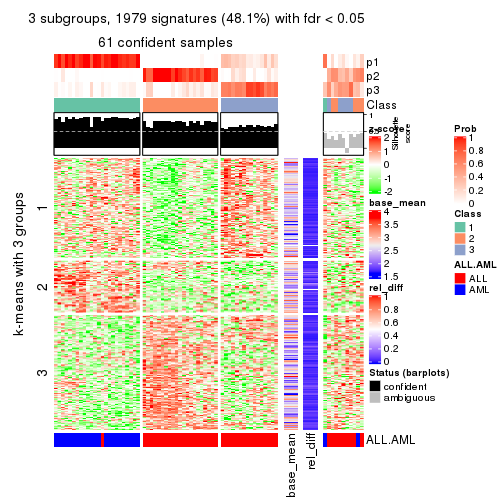
get_signatures(res, k = 4)
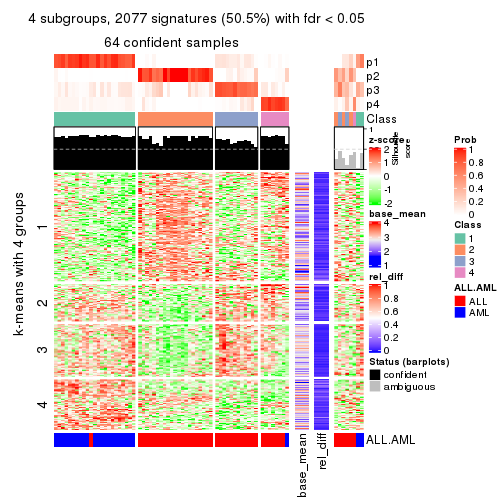
get_signatures(res, k = 5)
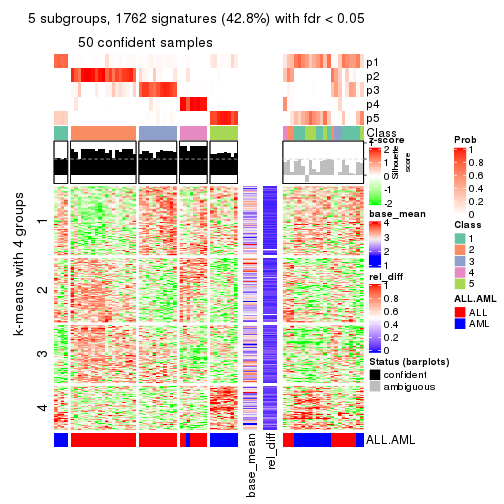
get_signatures(res, k = 6)
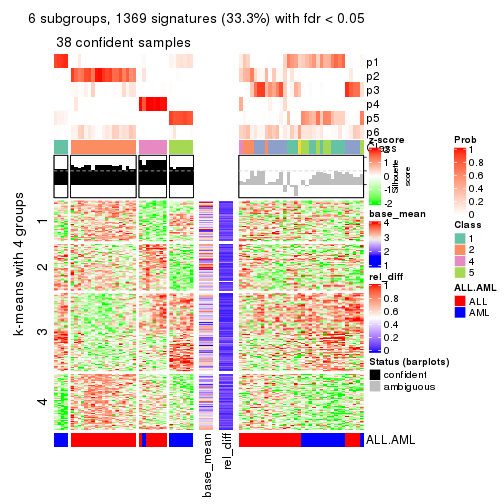
Signature heatmaps where rows are not scaled:
get_signatures(res, k = 2, scale_rows = FALSE)
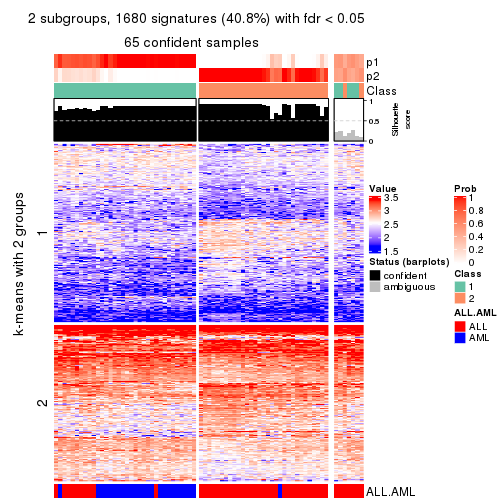
get_signatures(res, k = 3, scale_rows = FALSE)
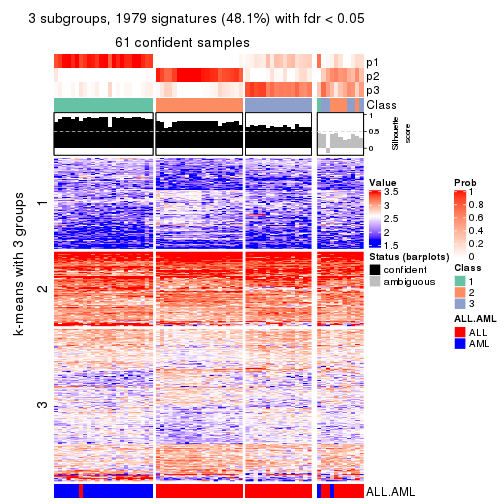
get_signatures(res, k = 4, scale_rows = FALSE)
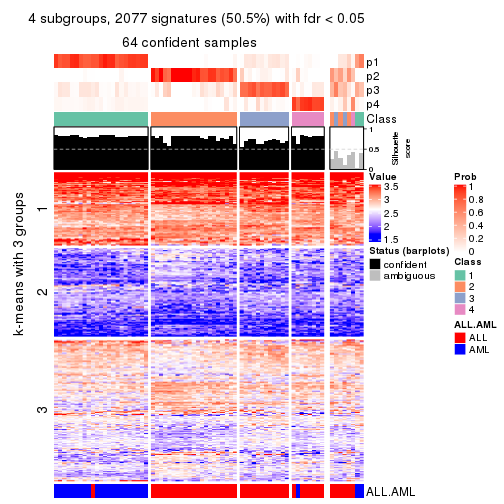
get_signatures(res, k = 5, scale_rows = FALSE)
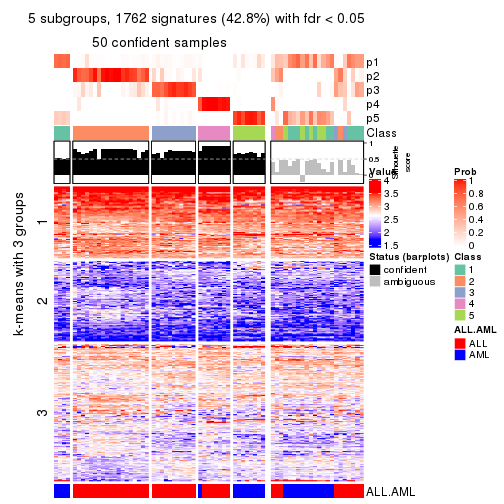
get_signatures(res, k = 6, scale_rows = FALSE)
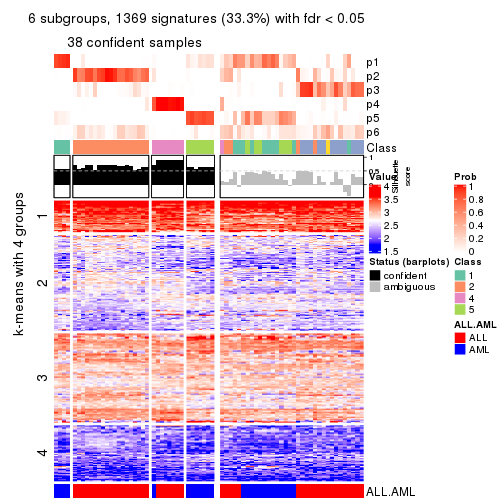
Compare the overlap of signatures from different k:
compare_signatures(res)
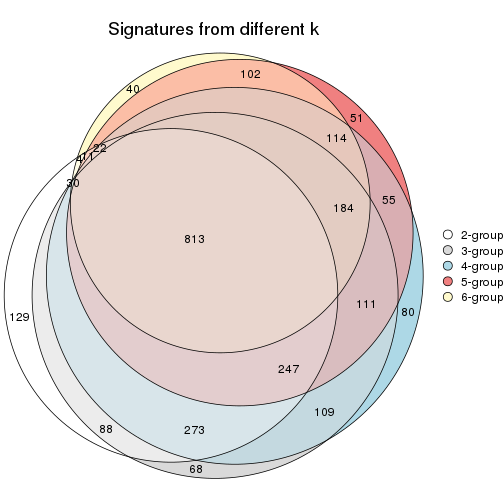
get_signature() returns a data frame invisibly. TO get the list of signatures, the function
call should be assigned to a variable explicitly. In following code, if plot argument is set
to FALSE, no heatmap is plotted while only the differential analysis is performed.
# code only for demonstration
tb = get_signature(res, k = ..., plot = FALSE)
An example of the output of tb is:
#> which_row fdr mean_1 mean_2 scaled_mean_1 scaled_mean_2 km
#> 1 38 0.042760348 8.373488 9.131774 -0.5533452 0.5164555 1
#> 2 40 0.018707592 7.106213 8.469186 -0.6173731 0.5762149 1
#> 3 55 0.019134737 10.221463 11.207825 -0.6159697 0.5749050 1
#> 4 59 0.006059896 5.921854 7.869574 -0.6899429 0.6439467 1
#> 5 60 0.018055526 8.928898 10.211722 -0.6204761 0.5791110 1
#> 6 98 0.009384629 15.714769 14.887706 0.6635654 -0.6193277 2
...
The columns in tb are:
which_row: row indices corresponding to the input matrix.fdr: FDR for the differential test. mean_x: The mean value in group x.scaled_mean_x: The mean value in group x after rows are scaled.km: Row groups if k-means clustering is applied to rows.UMAP plot which shows how samples are separated.
dimension_reduction(res, k = 2, method = "UMAP")
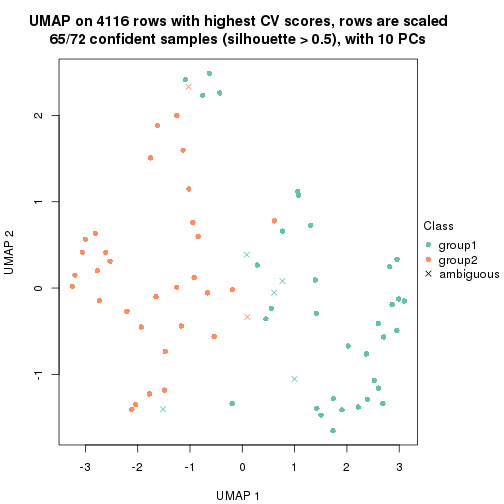
dimension_reduction(res, k = 3, method = "UMAP")
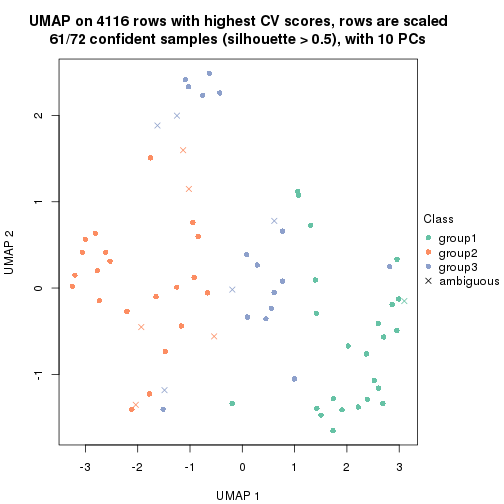
dimension_reduction(res, k = 4, method = "UMAP")
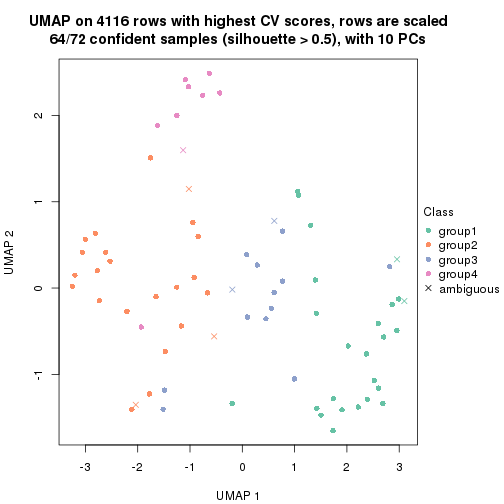
dimension_reduction(res, k = 5, method = "UMAP")
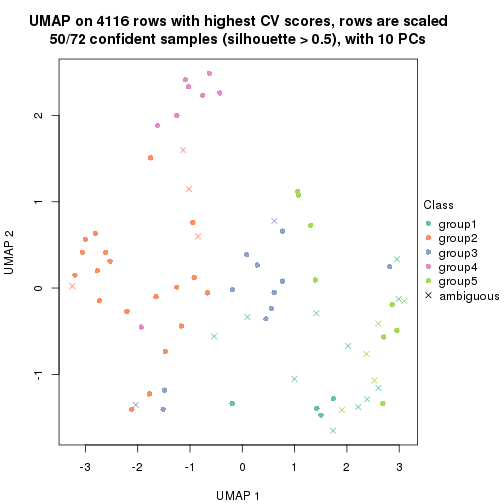
dimension_reduction(res, k = 6, method = "UMAP")
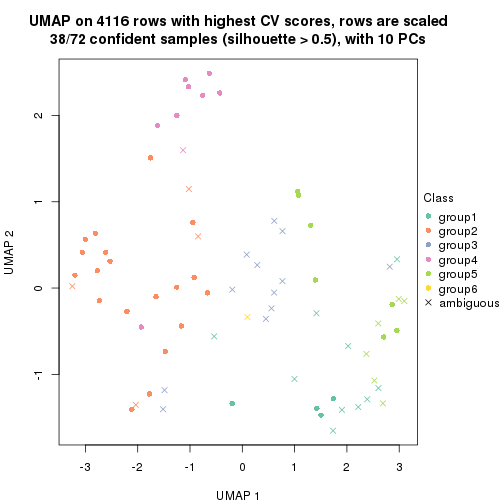
Following heatmap shows how subgroups are split when increasing k:
collect_classes(res)
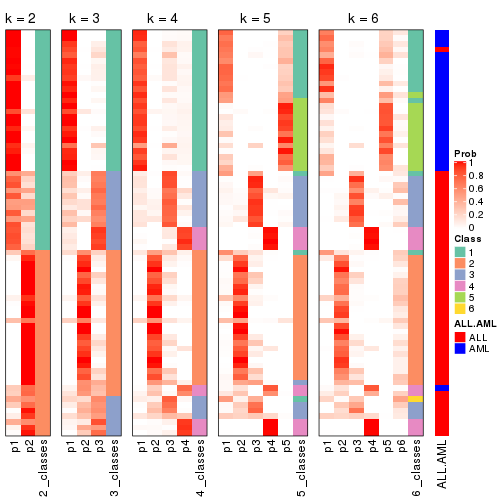
Test correlation between subgroups and known annotations. If the known annotation is numeric, one-way ANOVA test is applied, and if the known annotation is discrete, chi-squared contingency table test is applied.
test_to_known_factors(res)
#> n ALL.AML(p) k
#> CV:pam 65 1.04e-07 2
#> CV:pam 61 4.37e-13 3
#> CV:pam 64 4.11e-12 4
#> CV:pam 50 3.20e-09 5
#> CV:pam 38 2.03e-07 6
If matrix rows can be associated to genes, consider to use functional_enrichment(res,
...) to perform function enrichment for the signature genes. See this vignette for more detailed explanations.
The object with results only for a single top-value method and a single partition method can be extracted as:
res = res_list["CV", "mclust"]
# you can also extract it by
# res = res_list["CV:mclust"]
A summary of res and all the functions that can be applied to it:
res
#> A 'ConsensusPartition' object with k = 2, 3, 4, 5, 6.
#> On a matrix with 4116 rows and 72 columns.
#> Top rows (412, 824, 1235, 1646, 2058) are extracted by 'CV' method.
#> Subgroups are detected by 'mclust' method.
#> Performed in total 1250 partitions by row resampling.
#> Best k for subgroups seems to be 2.
#>
#> Following methods can be applied to this 'ConsensusPartition' object:
#> [1] "cola_report" "collect_classes" "collect_plots"
#> [4] "collect_stats" "colnames" "compare_signatures"
#> [7] "consensus_heatmap" "dimension_reduction" "functional_enrichment"
#> [10] "get_anno_col" "get_anno" "get_classes"
#> [13] "get_consensus" "get_matrix" "get_membership"
#> [16] "get_param" "get_signatures" "get_stats"
#> [19] "is_best_k" "is_stable_k" "membership_heatmap"
#> [22] "ncol" "nrow" "plot_ecdf"
#> [25] "rownames" "select_partition_number" "show"
#> [28] "suggest_best_k" "test_to_known_factors"
collect_plots() function collects all the plots made from res for all k (number of partitions)
into one single page to provide an easy and fast comparison between different k.
collect_plots(res)
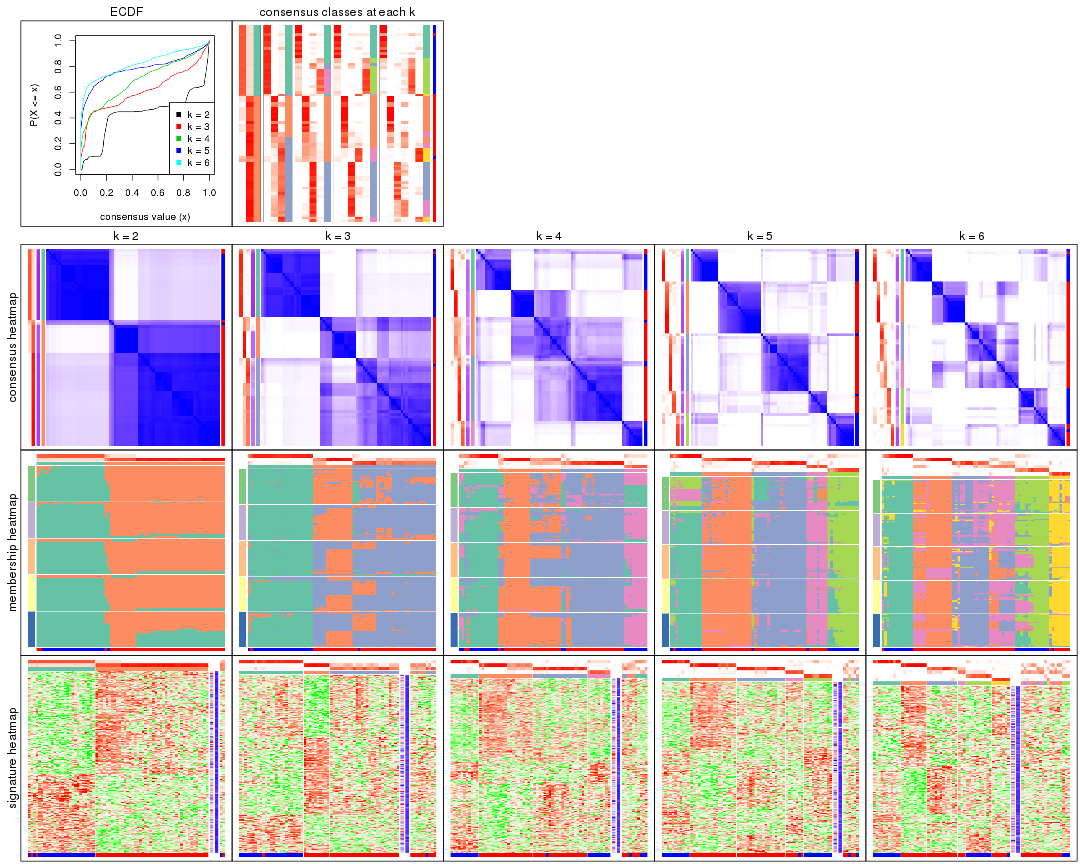
The plots are:
k and the heatmap of
predicted classes for each k.k.k.k.All the plots in panels can be made by individual functions and they are plotted later in this section.
select_partition_number() produces several plots showing different
statistics for choosing “optimized” k. There are following statistics:
k;k, the area increased is defined as \(A_k - A_{k-1}\).The detailed explanations of these statistics can be found in the cola vignette.
Generally speaking, lower PAC score, higher mean silhouette score or higher
concordance corresponds to better partition. Rand index and Jaccard index
measure how similar the current partition is compared to partition with k-1.
If they are too similar, we won't accept k is better than k-1.
select_partition_number(res)
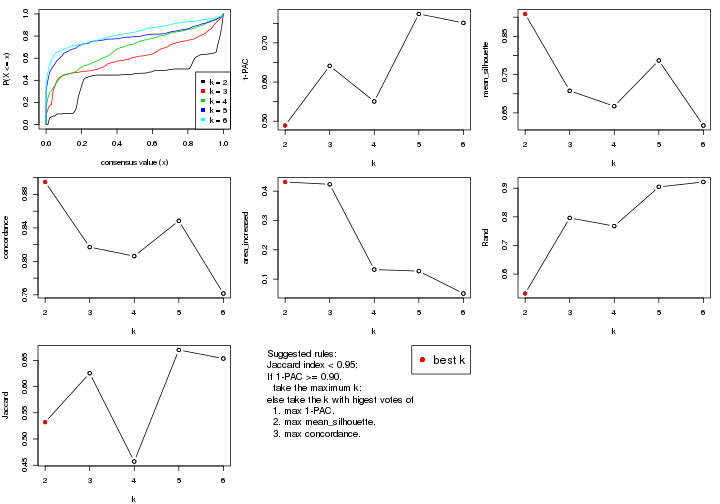
The numeric values for all these statistics can be obtained by get_stats().
get_stats(res)
#> k 1-PAC mean_silhouette concordance area_increased Rand Jaccard
#> 2 2 0.489 0.908 0.895 0.4313 0.532 0.532
#> 3 3 0.641 0.708 0.817 0.4234 0.796 0.625
#> 4 4 0.550 0.668 0.806 0.1326 0.768 0.457
#> 5 5 0.774 0.787 0.849 0.1273 0.905 0.670
#> 6 6 0.751 0.617 0.762 0.0509 0.922 0.653
suggest_best_k() suggests the best \(k\) based on these statistics. The rules are as follows:
suggest_best_k(res)
#> [1] 2
Following shows the table of the partitions (You need to click the show/hide
code output link to see it). The membership matrix (columns with name p*)
is inferred by
clue::cl_consensus()
function with the SE method. Basically the value in the membership matrix
represents the probability to belong to a certain group. The finall class
label for an item is determined with the group with highest probability it
belongs to.
In get_classes() function, the entropy is calculated from the membership
matrix and the silhouette score is calculated from the consensus matrix.
cbind(get_classes(res, k = 2), get_membership(res, k = 2))
#> class entropy silhouette p1 p2
#> sample_39 2 0.0938 0.9237 0.012 0.988
#> sample_40 2 0.0938 0.9237 0.012 0.988
#> sample_42 2 0.1633 0.9172 0.024 0.976
#> sample_47 2 0.1414 0.9207 0.020 0.980
#> sample_48 2 0.6438 0.8294 0.164 0.836
#> sample_49 2 0.1184 0.9225 0.016 0.984
#> sample_41 2 0.6438 0.8294 0.164 0.836
#> sample_43 2 0.0376 0.9242 0.004 0.996
#> sample_44 2 0.0938 0.9233 0.012 0.988
#> sample_45 2 0.1843 0.9169 0.028 0.972
#> sample_46 2 0.1633 0.9189 0.024 0.976
#> sample_70 2 0.0376 0.9242 0.004 0.996
#> sample_71 2 0.2043 0.9117 0.032 0.968
#> sample_72 2 0.1633 0.9172 0.024 0.976
#> sample_68 2 0.6438 0.8294 0.164 0.836
#> sample_69 2 0.6438 0.8294 0.164 0.836
#> sample_67 1 0.8207 0.8977 0.744 0.256
#> sample_55 2 0.1633 0.9178 0.024 0.976
#> sample_56 2 0.1184 0.9225 0.016 0.984
#> sample_59 2 0.0672 0.9238 0.008 0.992
#> sample_52 1 0.6712 0.9874 0.824 0.176
#> sample_53 1 0.6623 0.9851 0.828 0.172
#> sample_51 1 0.6623 0.9851 0.828 0.172
#> sample_50 1 0.6623 0.9851 0.828 0.172
#> sample_54 1 0.6801 0.9858 0.820 0.180
#> sample_57 1 0.6712 0.9874 0.824 0.176
#> sample_58 1 0.6712 0.9874 0.824 0.176
#> sample_60 1 0.7139 0.9735 0.804 0.196
#> sample_61 1 0.6801 0.9858 0.820 0.180
#> sample_65 1 0.6712 0.9874 0.824 0.176
#> sample_66 2 0.8955 0.3909 0.312 0.688
#> sample_63 1 0.6712 0.9874 0.824 0.176
#> sample_64 1 0.7453 0.9577 0.788 0.212
#> sample_62 1 0.6712 0.9874 0.824 0.176
#> sample_1 2 0.0672 0.9238 0.008 0.992
#> sample_2 2 0.9850 -0.0705 0.428 0.572
#> sample_3 2 0.1633 0.9213 0.024 0.976
#> sample_4 2 0.0672 0.9238 0.008 0.992
#> sample_5 2 0.6438 0.8294 0.164 0.836
#> sample_6 2 0.1633 0.9213 0.024 0.976
#> sample_7 2 0.0672 0.9238 0.008 0.992
#> sample_8 2 0.0938 0.9237 0.012 0.988
#> sample_9 2 0.0938 0.9225 0.012 0.988
#> sample_10 2 0.1843 0.9130 0.028 0.972
#> sample_11 2 0.2043 0.9117 0.032 0.968
#> sample_12 1 0.7376 0.9621 0.792 0.208
#> sample_13 2 0.6438 0.8294 0.164 0.836
#> sample_14 2 0.1184 0.9239 0.016 0.984
#> sample_15 2 0.6438 0.8294 0.164 0.836
#> sample_16 2 0.0376 0.9242 0.004 0.996
#> sample_17 2 0.1414 0.9202 0.020 0.980
#> sample_18 2 0.0672 0.9238 0.008 0.992
#> sample_19 2 0.0938 0.9235 0.012 0.988
#> sample_20 2 0.6438 0.8294 0.164 0.836
#> sample_21 2 0.5519 0.8538 0.128 0.872
#> sample_22 2 0.1633 0.9159 0.024 0.976
#> sample_23 2 0.1633 0.9213 0.024 0.976
#> sample_24 2 0.6438 0.8294 0.164 0.836
#> sample_25 2 0.1843 0.9147 0.028 0.972
#> sample_26 2 0.0672 0.9238 0.008 0.992
#> sample_27 2 0.1184 0.9225 0.016 0.984
#> sample_34 1 0.6712 0.9874 0.824 0.176
#> sample_35 1 0.7453 0.9577 0.788 0.212
#> sample_36 1 0.6623 0.9851 0.828 0.172
#> sample_37 1 0.6623 0.9851 0.828 0.172
#> sample_38 1 0.6801 0.9857 0.820 0.180
#> sample_28 1 0.6712 0.9874 0.824 0.176
#> sample_29 1 0.6973 0.9801 0.812 0.188
#> sample_30 1 0.6623 0.9851 0.828 0.172
#> sample_31 1 0.6712 0.9874 0.824 0.176
#> sample_32 1 0.6712 0.9874 0.824 0.176
#> sample_33 1 0.6712 0.9874 0.824 0.176
cbind(get_classes(res, k = 3), get_membership(res, k = 3))
#> class entropy silhouette p1 p2 p3
#> sample_39 3 0.5988 0.7194 0.008 0.304 0.688
#> sample_40 3 0.5982 0.7073 0.004 0.328 0.668
#> sample_42 3 0.3375 0.5534 0.008 0.100 0.892
#> sample_47 3 0.6286 0.5162 0.000 0.464 0.536
#> sample_48 2 0.0592 0.7534 0.000 0.988 0.012
#> sample_49 3 0.5982 0.7071 0.004 0.328 0.668
#> sample_41 2 0.0424 0.7525 0.000 0.992 0.008
#> sample_43 3 0.6299 0.4728 0.000 0.476 0.524
#> sample_44 2 0.6140 -0.0611 0.000 0.596 0.404
#> sample_45 2 0.6204 -0.1760 0.000 0.576 0.424
#> sample_46 2 0.5988 0.1018 0.000 0.632 0.368
#> sample_70 3 0.5859 0.6987 0.000 0.344 0.656
#> sample_71 3 0.2486 0.5533 0.008 0.060 0.932
#> sample_72 3 0.3682 0.5495 0.008 0.116 0.876
#> sample_68 2 0.0237 0.7499 0.000 0.996 0.004
#> sample_69 2 0.0592 0.7534 0.000 0.988 0.012
#> sample_67 3 0.5848 0.2916 0.268 0.012 0.720
#> sample_55 3 0.6126 0.7034 0.004 0.352 0.644
#> sample_56 3 0.6008 0.7046 0.004 0.332 0.664
#> sample_59 3 0.6045 0.6623 0.000 0.380 0.620
#> sample_52 1 0.1289 0.9597 0.968 0.000 0.032
#> sample_53 1 0.1529 0.9493 0.960 0.000 0.040
#> sample_51 1 0.1289 0.9474 0.968 0.000 0.032
#> sample_50 1 0.1289 0.9474 0.968 0.000 0.032
#> sample_54 1 0.1964 0.9499 0.944 0.000 0.056
#> sample_57 1 0.1289 0.9597 0.968 0.000 0.032
#> sample_58 1 0.1411 0.9602 0.964 0.000 0.036
#> sample_60 1 0.1989 0.9532 0.948 0.004 0.048
#> sample_61 1 0.2066 0.9544 0.940 0.000 0.060
#> sample_65 1 0.1411 0.9602 0.964 0.000 0.036
#> sample_66 3 0.4945 0.4865 0.104 0.056 0.840
#> sample_63 1 0.1289 0.9597 0.968 0.000 0.032
#> sample_64 1 0.2584 0.9441 0.928 0.008 0.064
#> sample_62 1 0.1289 0.9597 0.968 0.000 0.032
#> sample_1 3 0.6225 0.5679 0.000 0.432 0.568
#> sample_2 3 0.4663 0.4321 0.156 0.016 0.828
#> sample_3 3 0.5656 0.7127 0.008 0.264 0.728
#> sample_4 3 0.6267 0.5551 0.000 0.452 0.548
#> sample_5 2 0.0237 0.7499 0.000 0.996 0.004
#> sample_6 3 0.5763 0.7151 0.008 0.276 0.716
#> sample_7 3 0.6081 0.7055 0.004 0.344 0.652
#> sample_8 3 0.5928 0.7204 0.008 0.296 0.696
#> sample_9 3 0.5722 0.7154 0.004 0.292 0.704
#> sample_10 3 0.5406 0.6938 0.012 0.224 0.764
#> sample_11 3 0.2063 0.5599 0.008 0.044 0.948
#> sample_12 1 0.4062 0.8813 0.836 0.000 0.164
#> sample_13 2 0.0592 0.7534 0.000 0.988 0.012
#> sample_14 3 0.5873 0.7062 0.004 0.312 0.684
#> sample_15 2 0.0000 0.7511 0.000 1.000 0.000
#> sample_16 2 0.5968 0.1230 0.000 0.636 0.364
#> sample_17 3 0.6126 0.6886 0.004 0.352 0.644
#> sample_18 3 0.6126 0.7034 0.004 0.352 0.644
#> sample_19 2 0.6045 0.0463 0.000 0.620 0.380
#> sample_20 2 0.0592 0.7534 0.000 0.988 0.012
#> sample_21 2 0.1647 0.7288 0.004 0.960 0.036
#> sample_22 3 0.3293 0.6109 0.012 0.088 0.900
#> sample_23 3 0.5618 0.7118 0.008 0.260 0.732
#> sample_24 2 0.0592 0.7509 0.000 0.988 0.012
#> sample_25 3 0.3918 0.5982 0.012 0.120 0.868
#> sample_26 3 0.6299 0.4782 0.000 0.476 0.524
#> sample_27 3 0.5982 0.7071 0.004 0.328 0.668
#> sample_34 1 0.1411 0.9602 0.964 0.000 0.036
#> sample_35 1 0.2400 0.9502 0.932 0.004 0.064
#> sample_36 1 0.1289 0.9474 0.968 0.000 0.032
#> sample_37 1 0.1289 0.9474 0.968 0.000 0.032
#> sample_38 1 0.2625 0.9516 0.916 0.000 0.084
#> sample_28 1 0.2261 0.9567 0.932 0.000 0.068
#> sample_29 1 0.5835 0.7025 0.660 0.000 0.340
#> sample_30 1 0.1411 0.9466 0.964 0.000 0.036
#> sample_31 1 0.1411 0.9602 0.964 0.000 0.036
#> sample_32 1 0.1964 0.9587 0.944 0.000 0.056
#> sample_33 1 0.1529 0.9540 0.960 0.000 0.040
cbind(get_classes(res, k = 4), get_membership(res, k = 4))
#> class entropy silhouette p1 p2 p3 p4
#> sample_39 3 0.0657 0.8586 0.004 0.000 0.984 0.012
#> sample_40 3 0.0859 0.8579 0.004 0.008 0.980 0.008
#> sample_42 2 0.7476 0.5513 0.040 0.508 0.376 0.076
#> sample_47 2 0.5040 0.6352 0.000 0.628 0.364 0.008
#> sample_48 2 0.0336 0.6843 0.000 0.992 0.008 0.000
#> sample_49 3 0.0967 0.8584 0.004 0.004 0.976 0.016
#> sample_41 2 0.0592 0.6876 0.000 0.984 0.016 0.000
#> sample_43 2 0.5298 0.6252 0.000 0.612 0.372 0.016
#> sample_44 2 0.5476 0.5778 0.000 0.584 0.396 0.020
#> sample_45 2 0.4936 0.6631 0.000 0.672 0.316 0.012
#> sample_46 2 0.4857 0.6731 0.000 0.700 0.284 0.016
#> sample_70 3 0.0672 0.8565 0.000 0.008 0.984 0.008
#> sample_71 2 0.7582 0.5378 0.028 0.496 0.372 0.104
#> sample_72 2 0.7219 0.5401 0.028 0.508 0.392 0.072
#> sample_68 2 0.0336 0.6843 0.000 0.992 0.008 0.000
#> sample_69 2 0.0592 0.6874 0.000 0.984 0.016 0.000
#> sample_67 1 0.8097 0.3982 0.584 0.124 0.188 0.104
#> sample_55 3 0.1362 0.8584 0.004 0.012 0.964 0.020
#> sample_56 3 0.1082 0.8579 0.004 0.004 0.972 0.020
#> sample_59 3 0.2665 0.8038 0.004 0.088 0.900 0.008
#> sample_52 4 0.3528 0.8665 0.192 0.000 0.000 0.808
#> sample_53 1 0.0188 0.7646 0.996 0.000 0.000 0.004
#> sample_51 1 0.0000 0.7646 1.000 0.000 0.000 0.000
#> sample_50 1 0.0188 0.7639 0.996 0.000 0.000 0.004
#> sample_54 4 0.4289 0.8603 0.172 0.000 0.032 0.796
#> sample_57 4 0.3400 0.8700 0.180 0.000 0.000 0.820
#> sample_58 4 0.5328 0.7964 0.248 0.000 0.048 0.704
#> sample_60 4 0.3836 0.8671 0.168 0.000 0.016 0.816
#> sample_61 3 0.7164 0.1813 0.320 0.000 0.524 0.156
#> sample_65 1 0.6319 -0.2803 0.504 0.000 0.060 0.436
#> sample_66 2 0.8979 0.4922 0.144 0.436 0.312 0.108
#> sample_63 4 0.3400 0.8700 0.180 0.000 0.000 0.820
#> sample_64 4 0.6497 0.5992 0.160 0.000 0.200 0.640
#> sample_62 4 0.3400 0.8700 0.180 0.000 0.000 0.820
#> sample_1 3 0.1890 0.8294 0.000 0.056 0.936 0.008
#> sample_2 2 0.9416 0.3874 0.224 0.364 0.304 0.108
#> sample_3 3 0.2530 0.8308 0.004 0.000 0.896 0.100
#> sample_4 3 0.2489 0.8223 0.000 0.068 0.912 0.020
#> sample_5 2 0.0336 0.6843 0.000 0.992 0.008 0.000
#> sample_6 3 0.2401 0.8340 0.004 0.000 0.904 0.092
#> sample_7 3 0.0927 0.8574 0.000 0.008 0.976 0.016
#> sample_8 3 0.0524 0.8583 0.004 0.000 0.988 0.008
#> sample_9 3 0.5904 0.4154 0.004 0.228 0.688 0.080
#> sample_10 3 0.2329 0.8378 0.012 0.000 0.916 0.072
#> sample_11 3 0.7482 -0.3222 0.016 0.396 0.472 0.116
#> sample_12 1 0.6188 0.2470 0.548 0.000 0.396 0.056
#> sample_13 2 0.0336 0.6843 0.000 0.992 0.008 0.000
#> sample_14 2 0.6826 0.4027 0.004 0.456 0.456 0.084
#> sample_15 2 0.0336 0.6843 0.000 0.992 0.008 0.000
#> sample_16 2 0.5217 0.6056 0.000 0.608 0.380 0.012
#> sample_17 2 0.6114 0.5249 0.000 0.524 0.428 0.048
#> sample_18 3 0.1174 0.8563 0.000 0.012 0.968 0.020
#> sample_19 2 0.4908 0.6703 0.000 0.692 0.292 0.016
#> sample_20 2 0.0336 0.6843 0.000 0.992 0.008 0.000
#> sample_21 2 0.2412 0.7022 0.008 0.908 0.084 0.000
#> sample_22 3 0.1247 0.8540 0.012 0.004 0.968 0.016
#> sample_23 3 0.2530 0.8308 0.004 0.000 0.896 0.100
#> sample_24 2 0.1302 0.6921 0.000 0.956 0.044 0.000
#> sample_25 3 0.3933 0.7847 0.020 0.064 0.860 0.056
#> sample_26 3 0.3324 0.7487 0.000 0.136 0.852 0.012
#> sample_27 3 0.0967 0.8584 0.004 0.004 0.976 0.016
#> sample_34 1 0.5984 -0.0247 0.580 0.000 0.048 0.372
#> sample_35 3 0.6019 0.5229 0.176 0.000 0.688 0.136
#> sample_36 1 0.0336 0.7621 0.992 0.000 0.000 0.008
#> sample_37 1 0.0000 0.7646 1.000 0.000 0.000 0.000
#> sample_38 1 0.3667 0.7110 0.856 0.000 0.088 0.056
#> sample_28 1 0.1833 0.7564 0.944 0.000 0.032 0.024
#> sample_29 1 0.3279 0.7140 0.880 0.008 0.088 0.024
#> sample_30 1 0.0188 0.7639 0.996 0.000 0.000 0.004
#> sample_31 4 0.6158 0.5527 0.384 0.000 0.056 0.560
#> sample_32 1 0.2797 0.7237 0.900 0.000 0.068 0.032
#> sample_33 1 0.0188 0.7659 0.996 0.000 0.004 0.000
cbind(get_classes(res, k = 5), get_membership(res, k = 5))
#> class entropy silhouette p1 p2 p3 p4 p5
#> sample_39 3 0.1356 0.864 0.000 0.004 0.956 0.028 0.012
#> sample_40 3 0.0324 0.864 0.000 0.000 0.992 0.004 0.004
#> sample_42 4 0.3238 0.843 0.012 0.092 0.028 0.864 0.004
#> sample_47 2 0.3244 0.851 0.000 0.860 0.048 0.084 0.008
#> sample_48 2 0.0000 0.884 0.000 1.000 0.000 0.000 0.000
#> sample_49 3 0.0671 0.864 0.000 0.000 0.980 0.004 0.016
#> sample_41 2 0.0404 0.884 0.000 0.988 0.012 0.000 0.000
#> sample_43 2 0.3536 0.839 0.000 0.840 0.052 0.100 0.008
#> sample_44 2 0.4818 0.663 0.000 0.688 0.260 0.048 0.004
#> sample_45 2 0.2929 0.861 0.000 0.880 0.044 0.068 0.008
#> sample_46 2 0.2478 0.868 0.000 0.904 0.028 0.060 0.008
#> sample_70 3 0.1443 0.860 0.000 0.004 0.948 0.044 0.004
#> sample_71 4 0.2689 0.848 0.012 0.084 0.016 0.888 0.000
#> sample_72 4 0.3101 0.843 0.012 0.100 0.024 0.864 0.000
#> sample_68 2 0.0162 0.884 0.000 0.996 0.000 0.000 0.004
#> sample_69 2 0.0162 0.884 0.000 0.996 0.000 0.000 0.004
#> sample_67 4 0.3170 0.770 0.160 0.000 0.008 0.828 0.004
#> sample_55 3 0.0902 0.865 0.004 0.004 0.976 0.008 0.008
#> sample_56 3 0.0290 0.864 0.000 0.000 0.992 0.000 0.008
#> sample_59 3 0.1990 0.845 0.000 0.028 0.928 0.040 0.004
#> sample_52 5 0.2020 0.847 0.100 0.000 0.000 0.000 0.900
#> sample_53 1 0.0162 0.907 0.996 0.000 0.000 0.000 0.004
#> sample_51 1 0.0162 0.907 0.996 0.000 0.000 0.000 0.004
#> sample_50 1 0.0162 0.907 0.996 0.000 0.000 0.000 0.004
#> sample_54 5 0.2011 0.848 0.088 0.000 0.004 0.000 0.908
#> sample_57 5 0.1851 0.848 0.088 0.000 0.000 0.000 0.912
#> sample_58 5 0.2723 0.837 0.124 0.000 0.000 0.012 0.864
#> sample_60 5 0.1851 0.848 0.088 0.000 0.000 0.000 0.912
#> sample_61 5 0.7035 0.289 0.340 0.000 0.248 0.012 0.400
#> sample_65 5 0.4620 0.552 0.392 0.000 0.000 0.016 0.592
#> sample_66 4 0.4400 0.812 0.100 0.084 0.016 0.796 0.004
#> sample_63 5 0.1908 0.848 0.092 0.000 0.000 0.000 0.908
#> sample_64 5 0.2940 0.811 0.072 0.000 0.048 0.004 0.876
#> sample_62 5 0.1851 0.848 0.088 0.000 0.000 0.000 0.912
#> sample_1 3 0.0833 0.863 0.000 0.004 0.976 0.016 0.004
#> sample_2 4 0.3093 0.810 0.120 0.004 0.016 0.856 0.004
#> sample_3 3 0.3719 0.795 0.000 0.000 0.816 0.116 0.068
#> sample_4 3 0.1243 0.861 0.000 0.004 0.960 0.028 0.008
#> sample_5 2 0.0162 0.884 0.000 0.996 0.000 0.000 0.004
#> sample_6 3 0.3719 0.795 0.000 0.000 0.816 0.116 0.068
#> sample_7 3 0.0579 0.865 0.000 0.000 0.984 0.008 0.008
#> sample_8 3 0.1549 0.857 0.000 0.000 0.944 0.040 0.016
#> sample_9 3 0.6879 0.466 0.000 0.128 0.556 0.256 0.060
#> sample_10 3 0.5052 0.674 0.012 0.000 0.696 0.232 0.060
#> sample_11 4 0.2786 0.802 0.012 0.004 0.044 0.896 0.044
#> sample_12 1 0.7270 0.369 0.556 0.000 0.176 0.144 0.124
#> sample_13 2 0.0162 0.884 0.000 0.996 0.000 0.000 0.004
#> sample_14 2 0.6555 0.408 0.000 0.532 0.120 0.320 0.028
#> sample_15 2 0.0162 0.884 0.000 0.996 0.000 0.000 0.004
#> sample_16 2 0.4096 0.753 0.000 0.760 0.200 0.040 0.000
#> sample_17 2 0.5070 0.759 0.000 0.732 0.156 0.092 0.020
#> sample_18 3 0.1455 0.858 0.000 0.008 0.952 0.032 0.008
#> sample_19 2 0.2647 0.863 0.000 0.892 0.024 0.076 0.008
#> sample_20 2 0.0162 0.884 0.000 0.996 0.000 0.000 0.004
#> sample_21 2 0.0693 0.885 0.000 0.980 0.012 0.008 0.000
#> sample_22 3 0.4669 0.614 0.012 0.000 0.692 0.272 0.024
#> sample_23 3 0.3719 0.795 0.000 0.000 0.816 0.116 0.068
#> sample_24 2 0.1544 0.861 0.000 0.932 0.068 0.000 0.000
#> sample_25 4 0.5957 0.467 0.012 0.076 0.308 0.596 0.008
#> sample_26 3 0.3087 0.808 0.000 0.064 0.868 0.064 0.004
#> sample_27 3 0.0865 0.863 0.000 0.000 0.972 0.004 0.024
#> sample_34 5 0.4806 0.519 0.408 0.000 0.004 0.016 0.572
#> sample_35 3 0.6618 -0.169 0.136 0.000 0.428 0.016 0.420
#> sample_36 1 0.0162 0.907 0.996 0.000 0.000 0.000 0.004
#> sample_37 1 0.0162 0.907 0.996 0.000 0.000 0.000 0.004
#> sample_38 1 0.1864 0.857 0.924 0.000 0.004 0.068 0.004
#> sample_28 1 0.0833 0.894 0.976 0.000 0.004 0.016 0.004
#> sample_29 1 0.3243 0.724 0.812 0.000 0.004 0.180 0.004
#> sample_30 1 0.0162 0.907 0.996 0.000 0.000 0.000 0.004
#> sample_31 5 0.4116 0.745 0.248 0.000 0.004 0.016 0.732
#> sample_32 1 0.2389 0.773 0.880 0.000 0.004 0.000 0.116
#> sample_33 1 0.0162 0.907 0.996 0.000 0.000 0.000 0.004
cbind(get_classes(res, k = 6), get_membership(res, k = 6))
#> class entropy silhouette p1 p2 p3 p4 p5 p6
#> sample_39 3 0.2859 0.7012 0.000 0.000 0.828 0.156 0.000 0.016
#> sample_40 3 0.3710 0.6117 0.000 0.000 0.696 0.292 0.000 0.012
#> sample_42 6 0.2302 0.8732 0.008 0.032 0.008 0.044 0.000 0.908
#> sample_47 2 0.4644 0.2771 0.000 0.524 0.004 0.440 0.000 0.032
#> sample_48 2 0.0000 0.7726 0.000 1.000 0.000 0.000 0.000 0.000
#> sample_49 3 0.3171 0.6865 0.000 0.000 0.784 0.204 0.000 0.012
#> sample_41 2 0.0146 0.7707 0.000 0.996 0.000 0.004 0.000 0.000
#> sample_43 2 0.4805 0.2592 0.000 0.516 0.008 0.440 0.000 0.036
#> sample_44 4 0.4595 0.4303 0.000 0.280 0.040 0.664 0.000 0.016
#> sample_45 2 0.4555 0.3255 0.000 0.548 0.004 0.420 0.000 0.028
#> sample_46 2 0.4355 0.3365 0.000 0.556 0.000 0.420 0.000 0.024
#> sample_70 4 0.4026 0.4013 0.000 0.000 0.376 0.612 0.000 0.012
#> sample_71 6 0.1036 0.8809 0.008 0.004 0.000 0.024 0.000 0.964
#> sample_72 6 0.2263 0.8745 0.008 0.036 0.004 0.044 0.000 0.908
#> sample_68 2 0.0000 0.7726 0.000 1.000 0.000 0.000 0.000 0.000
#> sample_69 2 0.0146 0.7714 0.000 0.996 0.000 0.000 0.000 0.004
#> sample_67 6 0.1785 0.8665 0.048 0.000 0.000 0.008 0.016 0.928
#> sample_55 3 0.3950 0.3370 0.004 0.000 0.564 0.432 0.000 0.000
#> sample_56 3 0.3541 0.6469 0.000 0.000 0.728 0.260 0.000 0.012
#> sample_59 4 0.3684 0.5325 0.000 0.004 0.300 0.692 0.000 0.004
#> sample_52 5 0.3672 0.7131 0.056 0.000 0.000 0.168 0.776 0.000
#> sample_53 1 0.0146 0.8634 0.996 0.000 0.000 0.000 0.004 0.000
#> sample_51 1 0.0000 0.8642 1.000 0.000 0.000 0.000 0.000 0.000
#> sample_50 1 0.0291 0.8637 0.992 0.000 0.004 0.000 0.004 0.000
#> sample_54 5 0.3096 0.7220 0.008 0.000 0.004 0.172 0.812 0.004
#> sample_57 5 0.3003 0.7273 0.016 0.000 0.000 0.172 0.812 0.000
#> sample_58 5 0.3249 0.6753 0.128 0.000 0.000 0.044 0.824 0.004
#> sample_60 5 0.3096 0.7220 0.008 0.000 0.004 0.172 0.812 0.004
#> sample_61 5 0.6397 0.4324 0.280 0.000 0.092 0.088 0.536 0.004
#> sample_65 5 0.5512 0.4643 0.300 0.000 0.004 0.104 0.580 0.012
#> sample_66 6 0.2441 0.8660 0.024 0.044 0.000 0.012 0.016 0.904
#> sample_63 5 0.3210 0.7273 0.028 0.000 0.000 0.168 0.804 0.000
#> sample_64 5 0.1871 0.7101 0.016 0.000 0.024 0.032 0.928 0.000
#> sample_62 5 0.2955 0.7230 0.008 0.000 0.000 0.172 0.816 0.004
#> sample_1 4 0.3807 0.4177 0.000 0.000 0.368 0.628 0.000 0.004
#> sample_2 6 0.1679 0.8741 0.036 0.000 0.000 0.012 0.016 0.936
#> sample_3 3 0.1065 0.6785 0.000 0.000 0.964 0.008 0.008 0.020
#> sample_4 4 0.3409 0.5280 0.000 0.000 0.300 0.700 0.000 0.000
#> sample_5 2 0.0000 0.7726 0.000 1.000 0.000 0.000 0.000 0.000
#> sample_6 3 0.1350 0.6811 0.000 0.000 0.952 0.020 0.008 0.020
#> sample_7 3 0.3899 0.5037 0.000 0.000 0.628 0.364 0.000 0.008
#> sample_8 3 0.2445 0.7049 0.000 0.000 0.872 0.108 0.000 0.020
#> sample_9 3 0.6503 -0.2212 0.000 0.044 0.456 0.364 0.008 0.128
#> sample_10 3 0.3168 0.6123 0.008 0.000 0.840 0.024 0.008 0.120
#> sample_11 6 0.3503 0.8139 0.008 0.000 0.124 0.040 0.008 0.820
#> sample_12 1 0.7755 -0.0451 0.388 0.000 0.064 0.080 0.324 0.144
#> sample_13 2 0.0000 0.7726 0.000 1.000 0.000 0.000 0.000 0.000
#> sample_14 4 0.6881 0.2604 0.000 0.228 0.076 0.484 0.004 0.208
#> sample_15 2 0.0000 0.7726 0.000 1.000 0.000 0.000 0.000 0.000
#> sample_16 4 0.3969 0.3022 0.000 0.344 0.008 0.644 0.000 0.004
#> sample_17 4 0.5545 0.2060 0.000 0.336 0.020 0.560 0.004 0.080
#> sample_18 4 0.3684 0.3891 0.000 0.000 0.372 0.628 0.000 0.000
#> sample_19 2 0.4488 0.3278 0.000 0.548 0.000 0.420 0.000 0.032
#> sample_20 2 0.0000 0.7726 0.000 1.000 0.000 0.000 0.000 0.000
#> sample_21 2 0.1007 0.7550 0.000 0.956 0.000 0.044 0.000 0.000
#> sample_22 3 0.4693 0.5601 0.008 0.000 0.688 0.088 0.000 0.216
#> sample_23 3 0.1065 0.6785 0.000 0.000 0.964 0.008 0.008 0.020
#> sample_24 2 0.2092 0.6683 0.000 0.876 0.000 0.124 0.000 0.000
#> sample_25 6 0.5101 0.4291 0.008 0.028 0.320 0.032 0.000 0.612
#> sample_26 4 0.4812 0.5468 0.000 0.044 0.280 0.652 0.000 0.024
#> sample_27 3 0.3078 0.6924 0.000 0.000 0.796 0.192 0.000 0.012
#> sample_34 5 0.5269 0.5224 0.264 0.000 0.004 0.104 0.620 0.008
#> sample_35 5 0.6865 0.4465 0.136 0.000 0.248 0.100 0.508 0.008
#> sample_36 1 0.0291 0.8637 0.992 0.000 0.004 0.000 0.004 0.000
#> sample_37 1 0.0000 0.8642 1.000 0.000 0.000 0.000 0.000 0.000
#> sample_38 1 0.1745 0.8271 0.920 0.000 0.000 0.000 0.012 0.068
#> sample_28 1 0.1225 0.8462 0.952 0.000 0.000 0.000 0.012 0.036
#> sample_29 1 0.3652 0.5564 0.720 0.000 0.000 0.000 0.016 0.264
#> sample_30 1 0.0291 0.8637 0.992 0.000 0.004 0.000 0.004 0.000
#> sample_31 5 0.4843 0.6055 0.192 0.000 0.004 0.104 0.692 0.008
#> sample_32 1 0.4901 0.5135 0.688 0.000 0.004 0.072 0.216 0.020
#> sample_33 1 0.0000 0.8642 1.000 0.000 0.000 0.000 0.000 0.000
Heatmaps for the consensus matrix. It visualizes the probability of two samples to be in a same group.
consensus_heatmap(res, k = 2)
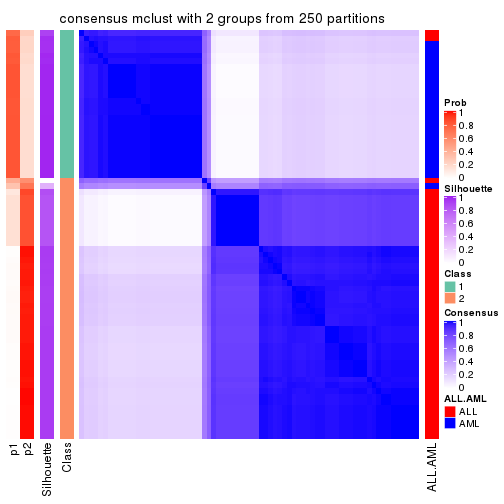
consensus_heatmap(res, k = 3)
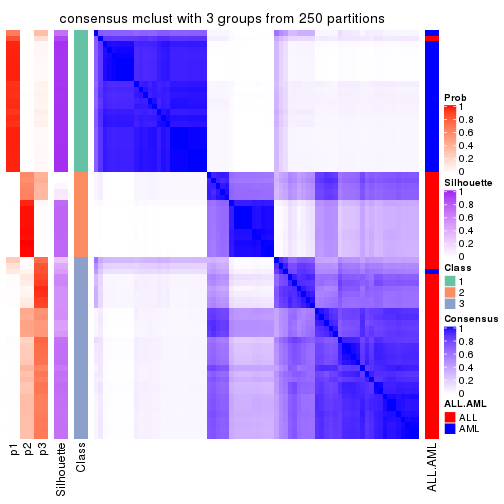
consensus_heatmap(res, k = 4)

consensus_heatmap(res, k = 5)
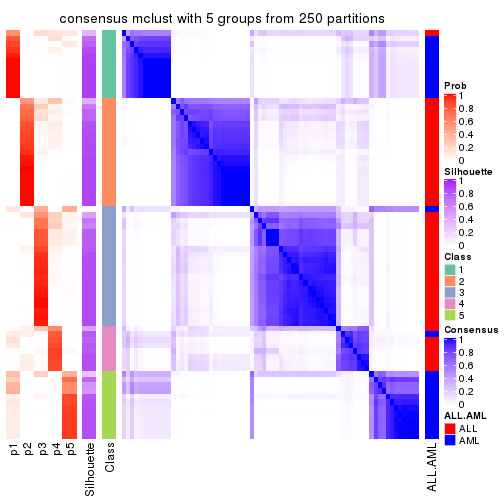
consensus_heatmap(res, k = 6)
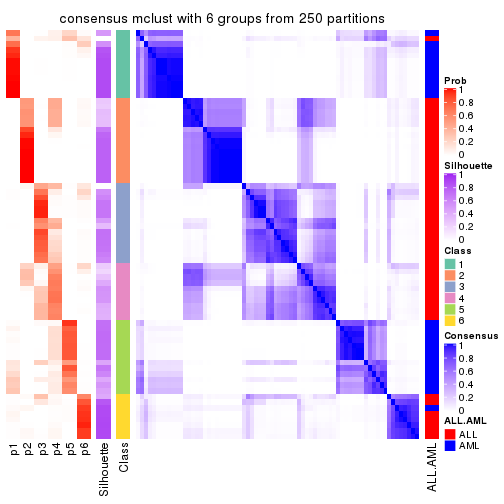
Heatmaps for the membership of samples in all partitions to see how consistent they are:
membership_heatmap(res, k = 2)
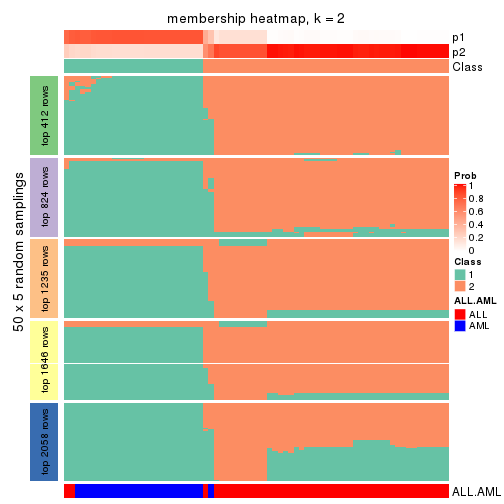
membership_heatmap(res, k = 3)
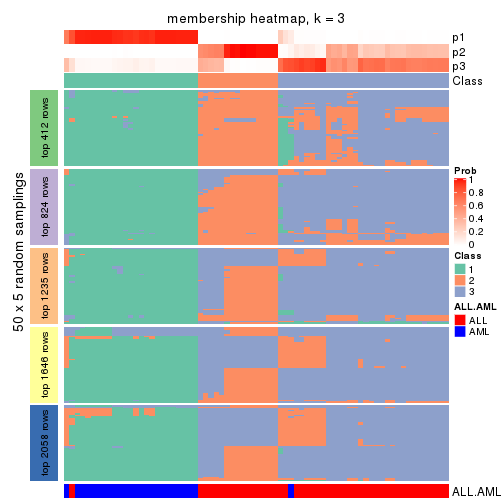
membership_heatmap(res, k = 4)
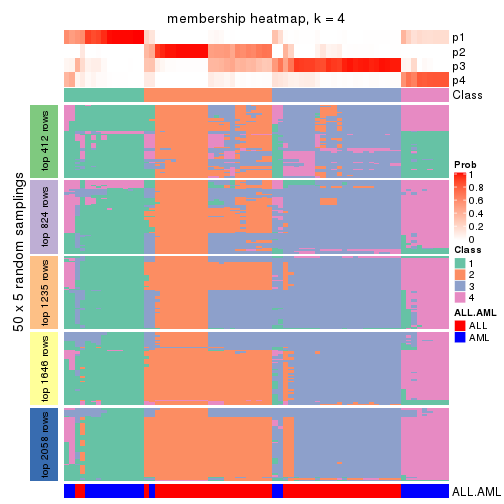
membership_heatmap(res, k = 5)
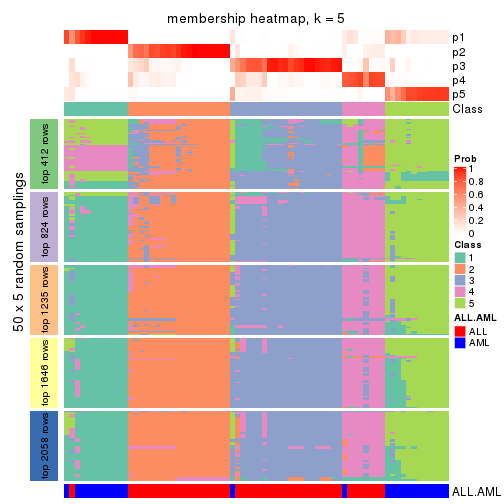
membership_heatmap(res, k = 6)
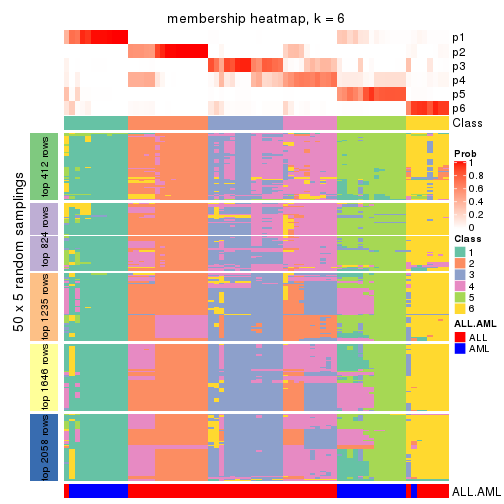
As soon as we have had the classes for columns, we can look for signatures which are significantly different between classes which can be candidate marks for certain classes. Following are the heatmaps for signatures.
Signature heatmaps where rows are scaled:
get_signatures(res, k = 2)
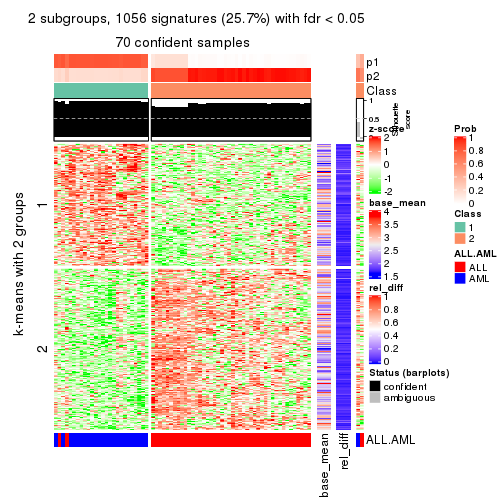
get_signatures(res, k = 3)
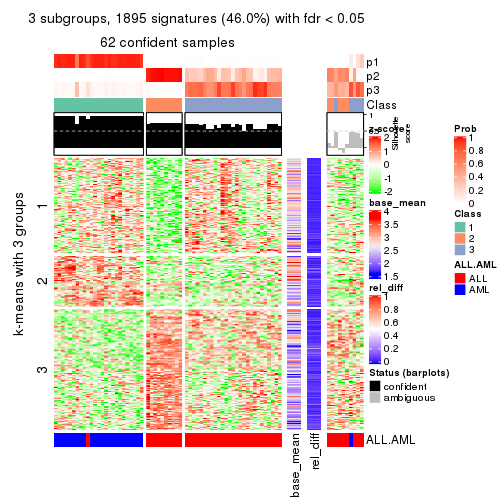
get_signatures(res, k = 4)
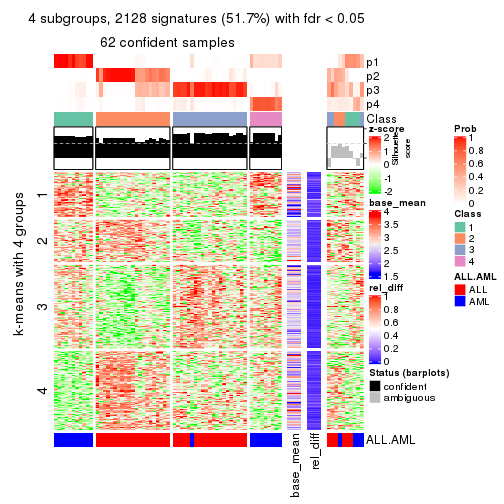
get_signatures(res, k = 5)
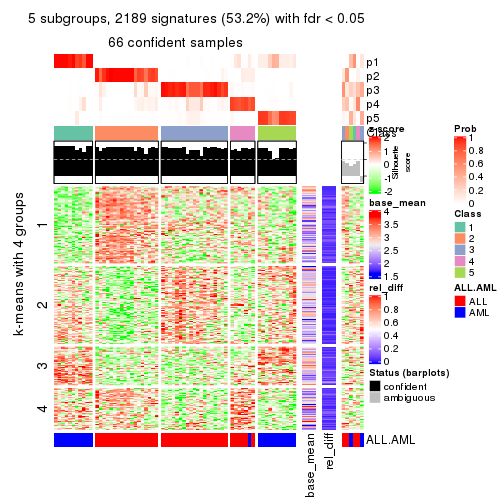
get_signatures(res, k = 6)
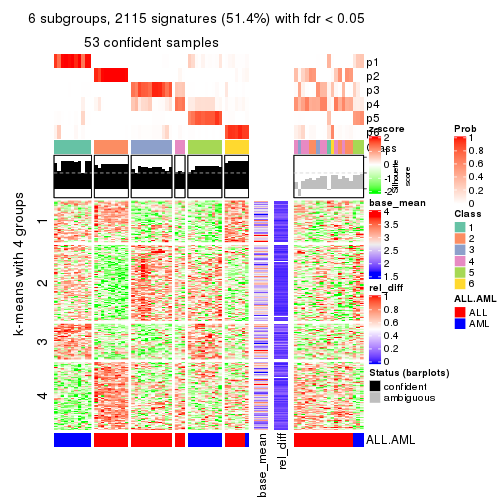
Signature heatmaps where rows are not scaled:
get_signatures(res, k = 2, scale_rows = FALSE)
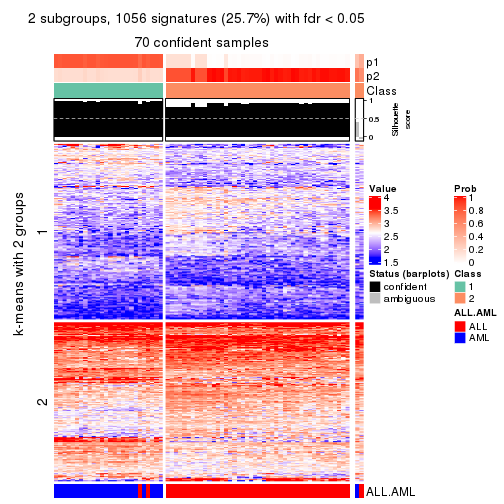
get_signatures(res, k = 3, scale_rows = FALSE)
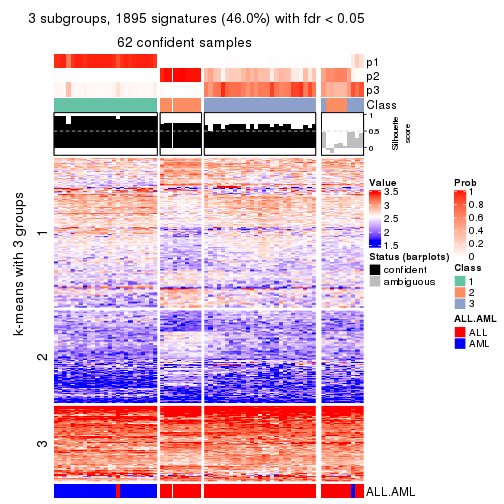
get_signatures(res, k = 4, scale_rows = FALSE)
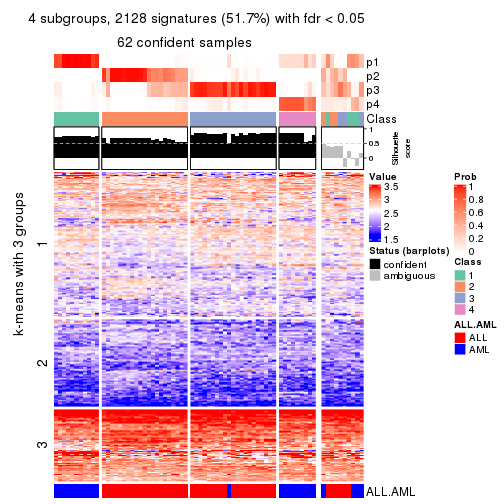
get_signatures(res, k = 5, scale_rows = FALSE)
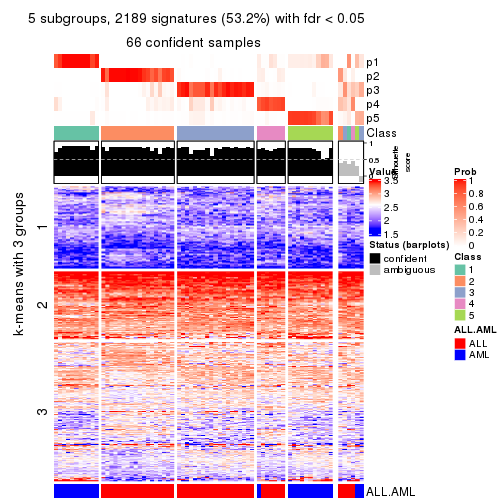
get_signatures(res, k = 6, scale_rows = FALSE)
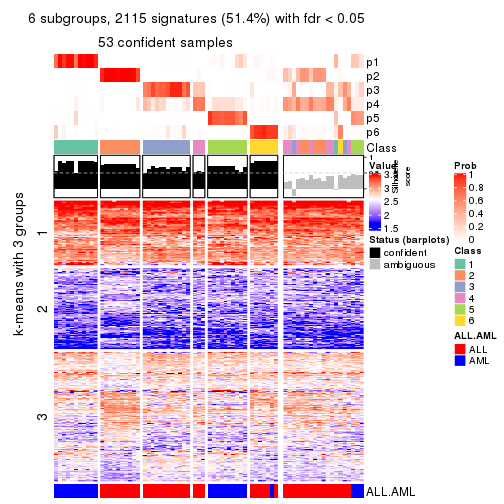
Compare the overlap of signatures from different k:
compare_signatures(res)
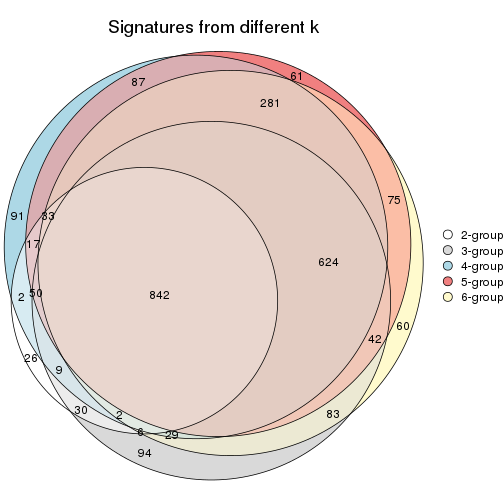
get_signature() returns a data frame invisibly. TO get the list of signatures, the function
call should be assigned to a variable explicitly. In following code, if plot argument is set
to FALSE, no heatmap is plotted while only the differential analysis is performed.
# code only for demonstration
tb = get_signature(res, k = ..., plot = FALSE)
An example of the output of tb is:
#> which_row fdr mean_1 mean_2 scaled_mean_1 scaled_mean_2 km
#> 1 38 0.042760348 8.373488 9.131774 -0.5533452 0.5164555 1
#> 2 40 0.018707592 7.106213 8.469186 -0.6173731 0.5762149 1
#> 3 55 0.019134737 10.221463 11.207825 -0.6159697 0.5749050 1
#> 4 59 0.006059896 5.921854 7.869574 -0.6899429 0.6439467 1
#> 5 60 0.018055526 8.928898 10.211722 -0.6204761 0.5791110 1
#> 6 98 0.009384629 15.714769 14.887706 0.6635654 -0.6193277 2
...
The columns in tb are:
which_row: row indices corresponding to the input matrix.fdr: FDR for the differential test. mean_x: The mean value in group x.scaled_mean_x: The mean value in group x after rows are scaled.km: Row groups if k-means clustering is applied to rows.UMAP plot which shows how samples are separated.
dimension_reduction(res, k = 2, method = "UMAP")
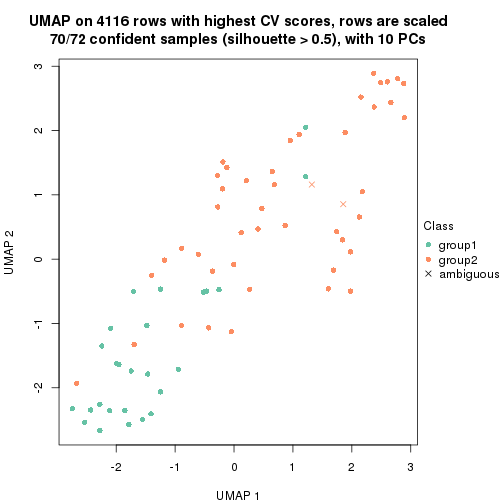
dimension_reduction(res, k = 3, method = "UMAP")
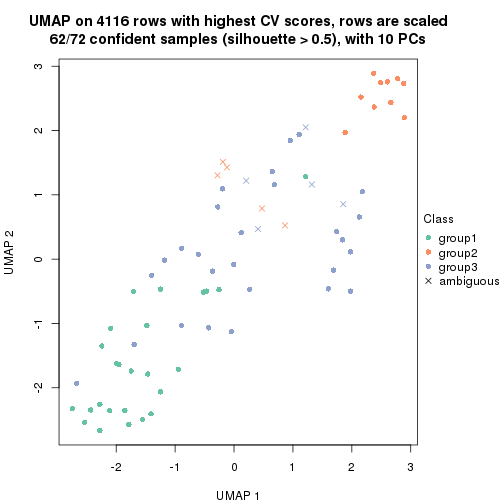
dimension_reduction(res, k = 4, method = "UMAP")
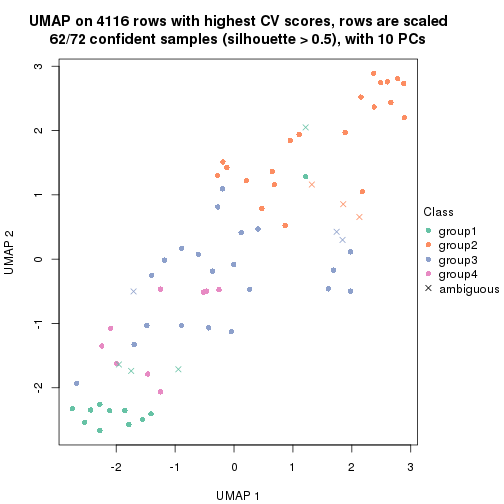
dimension_reduction(res, k = 5, method = "UMAP")
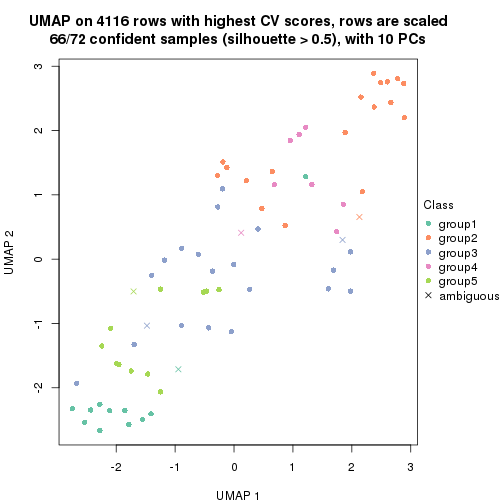
dimension_reduction(res, k = 6, method = "UMAP")
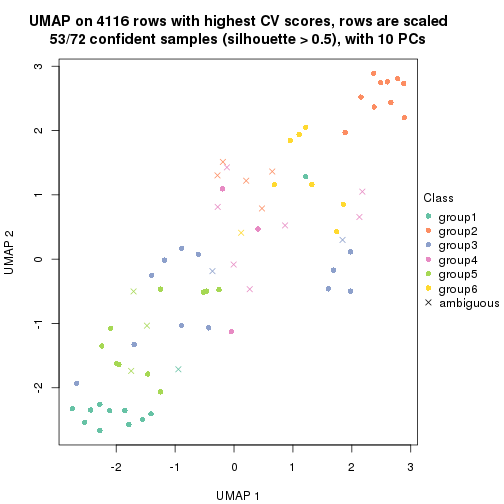
Following heatmap shows how subgroups are split when increasing k:
collect_classes(res)
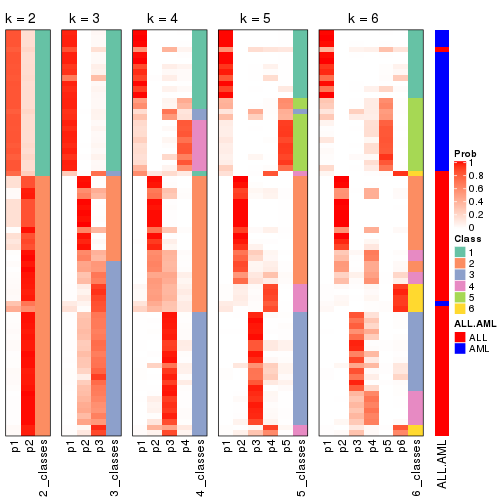
Test correlation between subgroups and known annotations. If the known annotation is numeric, one-way ANOVA test is applied, and if the known annotation is discrete, chi-squared contingency table test is applied.
test_to_known_factors(res)
#> n ALL.AML(p) k
#> CV:mclust 70 2.94e-14 2
#> CV:mclust 62 2.60e-13 3
#> CV:mclust 62 1.78e-12 4
#> CV:mclust 66 9.88e-13 5
#> CV:mclust 53 1.78e-09 6
If matrix rows can be associated to genes, consider to use functional_enrichment(res,
...) to perform function enrichment for the signature genes. See this vignette for more detailed explanations.
The object with results only for a single top-value method and a single partition method can be extracted as:
res = res_list["CV", "NMF"]
# you can also extract it by
# res = res_list["CV:NMF"]
A summary of res and all the functions that can be applied to it:
res
#> A 'ConsensusPartition' object with k = 2, 3, 4, 5, 6.
#> On a matrix with 4116 rows and 72 columns.
#> Top rows (412, 824, 1235, 1646, 2058) are extracted by 'CV' method.
#> Subgroups are detected by 'NMF' method.
#> Performed in total 1250 partitions by row resampling.
#> Best k for subgroups seems to be 2.
#>
#> Following methods can be applied to this 'ConsensusPartition' object:
#> [1] "cola_report" "collect_classes" "collect_plots"
#> [4] "collect_stats" "colnames" "compare_signatures"
#> [7] "consensus_heatmap" "dimension_reduction" "functional_enrichment"
#> [10] "get_anno_col" "get_anno" "get_classes"
#> [13] "get_consensus" "get_matrix" "get_membership"
#> [16] "get_param" "get_signatures" "get_stats"
#> [19] "is_best_k" "is_stable_k" "membership_heatmap"
#> [22] "ncol" "nrow" "plot_ecdf"
#> [25] "rownames" "select_partition_number" "show"
#> [28] "suggest_best_k" "test_to_known_factors"
collect_plots() function collects all the plots made from res for all k (number of partitions)
into one single page to provide an easy and fast comparison between different k.
collect_plots(res)
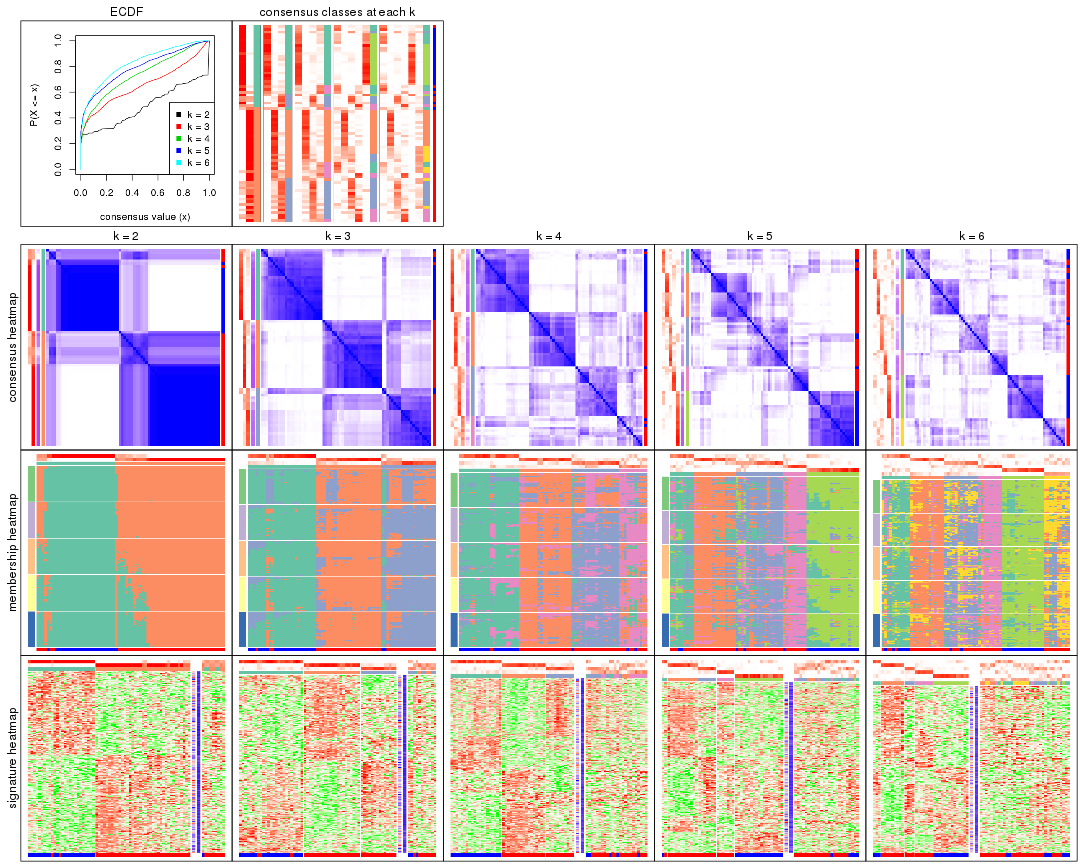
The plots are:
k and the heatmap of
predicted classes for each k.k.k.k.All the plots in panels can be made by individual functions and they are plotted later in this section.
select_partition_number() produces several plots showing different
statistics for choosing “optimized” k. There are following statistics:
k;k, the area increased is defined as \(A_k - A_{k-1}\).The detailed explanations of these statistics can be found in the cola vignette.
Generally speaking, lower PAC score, higher mean silhouette score or higher
concordance corresponds to better partition. Rand index and Jaccard index
measure how similar the current partition is compared to partition with k-1.
If they are too similar, we won't accept k is better than k-1.
select_partition_number(res)
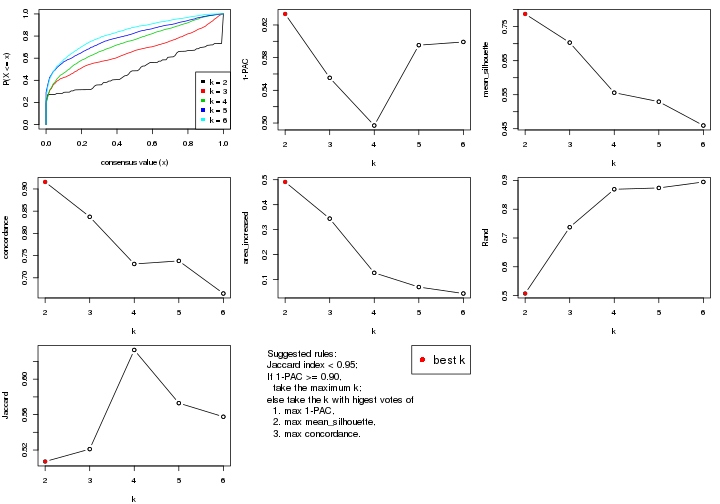
The numeric values for all these statistics can be obtained by get_stats().
get_stats(res)
#> k 1-PAC mean_silhouette concordance area_increased Rand Jaccard
#> 2 2 0.633 0.787 0.916 0.4909 0.507 0.507
#> 3 3 0.555 0.703 0.837 0.3442 0.737 0.521
#> 4 4 0.497 0.556 0.731 0.1269 0.869 0.633
#> 5 5 0.595 0.529 0.738 0.0700 0.874 0.573
#> 6 6 0.599 0.459 0.665 0.0441 0.895 0.558
suggest_best_k() suggests the best \(k\) based on these statistics. The rules are as follows:
suggest_best_k(res)
#> [1] 2
Following shows the table of the partitions (You need to click the show/hide
code output link to see it). The membership matrix (columns with name p*)
is inferred by
clue::cl_consensus()
function with the SE method. Basically the value in the membership matrix
represents the probability to belong to a certain group. The finall class
label for an item is determined with the group with highest probability it
belongs to.
In get_classes() function, the entropy is calculated from the membership
matrix and the silhouette score is calculated from the consensus matrix.
cbind(get_classes(res, k = 2), get_membership(res, k = 2))
#> class entropy silhouette p1 p2
#> sample_39 2 0.9522 0.47506 0.372 0.628
#> sample_40 2 0.9044 0.57502 0.320 0.680
#> sample_42 2 0.0376 0.88613 0.004 0.996
#> sample_47 2 0.0000 0.88809 0.000 1.000
#> sample_48 2 0.0000 0.88809 0.000 1.000
#> sample_49 2 0.9977 0.21342 0.472 0.528
#> sample_41 2 0.0000 0.88809 0.000 1.000
#> sample_43 2 0.0000 0.88809 0.000 1.000
#> sample_44 2 0.0000 0.88809 0.000 1.000
#> sample_45 2 0.0000 0.88809 0.000 1.000
#> sample_46 2 0.0000 0.88809 0.000 1.000
#> sample_70 2 0.0376 0.88616 0.004 0.996
#> sample_71 2 0.0000 0.88809 0.000 1.000
#> sample_72 2 0.0000 0.88809 0.000 1.000
#> sample_68 2 0.0000 0.88809 0.000 1.000
#> sample_69 2 0.0000 0.88809 0.000 1.000
#> sample_67 1 0.5629 0.78714 0.868 0.132
#> sample_55 2 0.8207 0.67159 0.256 0.744
#> sample_56 2 0.8327 0.65857 0.264 0.736
#> sample_59 2 0.0000 0.88809 0.000 1.000
#> sample_52 1 0.0000 0.91740 1.000 0.000
#> sample_53 1 0.0000 0.91740 1.000 0.000
#> sample_51 1 0.0000 0.91740 1.000 0.000
#> sample_50 1 0.0000 0.91740 1.000 0.000
#> sample_54 1 0.4690 0.82332 0.900 0.100
#> sample_57 1 0.0000 0.91740 1.000 0.000
#> sample_58 1 0.0000 0.91740 1.000 0.000
#> sample_60 1 0.0376 0.91468 0.996 0.004
#> sample_61 1 0.0000 0.91740 1.000 0.000
#> sample_65 1 0.0000 0.91740 1.000 0.000
#> sample_66 2 0.9000 0.47555 0.316 0.684
#> sample_63 1 0.0000 0.91740 1.000 0.000
#> sample_64 1 0.0000 0.91740 1.000 0.000
#> sample_62 1 0.0000 0.91740 1.000 0.000
#> sample_1 2 0.0000 0.88809 0.000 1.000
#> sample_2 1 0.9866 0.21416 0.568 0.432
#> sample_3 2 0.8386 0.65292 0.268 0.732
#> sample_4 2 0.0000 0.88809 0.000 1.000
#> sample_5 2 0.0000 0.88809 0.000 1.000
#> sample_6 2 0.9323 0.52371 0.348 0.652
#> sample_7 2 0.6343 0.76990 0.160 0.840
#> sample_8 1 0.9970 -0.03983 0.532 0.468
#> sample_9 2 0.0000 0.88809 0.000 1.000
#> sample_10 1 0.9954 0.00334 0.540 0.460
#> sample_11 2 0.0000 0.88809 0.000 1.000
#> sample_12 1 0.0376 0.91457 0.996 0.004
#> sample_13 2 0.0000 0.88809 0.000 1.000
#> sample_14 2 0.0000 0.88809 0.000 1.000
#> sample_15 2 0.0000 0.88809 0.000 1.000
#> sample_16 2 0.0000 0.88809 0.000 1.000
#> sample_17 2 0.0376 0.88563 0.004 0.996
#> sample_18 2 0.3114 0.85344 0.056 0.944
#> sample_19 2 0.0000 0.88809 0.000 1.000
#> sample_20 2 0.0000 0.88809 0.000 1.000
#> sample_21 2 0.0000 0.88809 0.000 1.000
#> sample_22 2 0.9983 0.19967 0.476 0.524
#> sample_23 2 0.9909 0.29755 0.444 0.556
#> sample_24 2 0.0000 0.88809 0.000 1.000
#> sample_25 2 0.8499 0.64237 0.276 0.724
#> sample_26 2 0.0000 0.88809 0.000 1.000
#> sample_27 1 0.9833 0.13031 0.576 0.424
#> sample_34 1 0.0000 0.91740 1.000 0.000
#> sample_35 1 0.0000 0.91740 1.000 0.000
#> sample_36 1 0.0000 0.91740 1.000 0.000
#> sample_37 1 0.0000 0.91740 1.000 0.000
#> sample_38 1 0.0000 0.91740 1.000 0.000
#> sample_28 1 0.0000 0.91740 1.000 0.000
#> sample_29 1 0.0376 0.91468 0.996 0.004
#> sample_30 1 0.0000 0.91740 1.000 0.000
#> sample_31 1 0.0000 0.91740 1.000 0.000
#> sample_32 1 0.0000 0.91740 1.000 0.000
#> sample_33 1 0.0000 0.91740 1.000 0.000
cbind(get_classes(res, k = 3), get_membership(res, k = 3))
#> class entropy silhouette p1 p2 p3
#> sample_39 3 0.4702 0.7376 0.000 0.212 0.788
#> sample_40 3 0.4346 0.7445 0.000 0.184 0.816
#> sample_42 2 0.3039 0.7974 0.036 0.920 0.044
#> sample_47 2 0.1031 0.8487 0.000 0.976 0.024
#> sample_48 2 0.0892 0.8482 0.000 0.980 0.020
#> sample_49 3 0.4602 0.7462 0.016 0.152 0.832
#> sample_41 2 0.2261 0.8374 0.000 0.932 0.068
#> sample_43 2 0.1411 0.8466 0.000 0.964 0.036
#> sample_44 2 0.5497 0.4880 0.000 0.708 0.292
#> sample_45 2 0.1643 0.8430 0.000 0.956 0.044
#> sample_46 2 0.2261 0.8324 0.000 0.932 0.068
#> sample_70 3 0.6126 0.5207 0.000 0.400 0.600
#> sample_71 2 0.4921 0.7151 0.020 0.816 0.164
#> sample_72 2 0.1753 0.8376 0.000 0.952 0.048
#> sample_68 2 0.0424 0.8428 0.000 0.992 0.008
#> sample_69 2 0.1031 0.8321 0.000 0.976 0.024
#> sample_67 1 0.7079 0.6882 0.720 0.104 0.176
#> sample_55 3 0.5156 0.7337 0.008 0.216 0.776
#> sample_56 3 0.4452 0.7419 0.000 0.192 0.808
#> sample_59 3 0.6308 0.2822 0.000 0.492 0.508
#> sample_52 1 0.0237 0.8737 0.996 0.000 0.004
#> sample_53 1 0.1163 0.8713 0.972 0.000 0.028
#> sample_51 1 0.0424 0.8740 0.992 0.000 0.008
#> sample_50 1 0.0000 0.8734 1.000 0.000 0.000
#> sample_54 1 0.2414 0.8647 0.940 0.040 0.020
#> sample_57 1 0.4555 0.7822 0.800 0.000 0.200
#> sample_58 1 0.5098 0.7243 0.752 0.000 0.248
#> sample_60 1 0.1999 0.8739 0.952 0.012 0.036
#> sample_61 1 0.5650 0.6249 0.688 0.000 0.312
#> sample_65 1 0.3340 0.8412 0.880 0.000 0.120
#> sample_66 1 0.9574 0.0771 0.412 0.392 0.196
#> sample_63 1 0.1289 0.8748 0.968 0.000 0.032
#> sample_64 3 0.6260 -0.0622 0.448 0.000 0.552
#> sample_62 1 0.0747 0.8752 0.984 0.000 0.016
#> sample_1 3 0.6154 0.4921 0.000 0.408 0.592
#> sample_2 1 0.8527 0.5467 0.612 0.192 0.196
#> sample_3 3 0.2200 0.7121 0.004 0.056 0.940
#> sample_4 3 0.6225 0.4267 0.000 0.432 0.568
#> sample_5 2 0.0592 0.8427 0.000 0.988 0.012
#> sample_6 3 0.2031 0.7044 0.016 0.032 0.952
#> sample_7 3 0.4974 0.7142 0.000 0.236 0.764
#> sample_8 3 0.4782 0.7463 0.016 0.164 0.820
#> sample_9 3 0.6267 -0.0560 0.000 0.452 0.548
#> sample_10 3 0.2383 0.7032 0.016 0.044 0.940
#> sample_11 2 0.5760 0.6228 0.000 0.672 0.328
#> sample_12 1 0.4931 0.7950 0.784 0.004 0.212
#> sample_13 2 0.0892 0.8482 0.000 0.980 0.020
#> sample_14 2 0.5285 0.7159 0.004 0.752 0.244
#> sample_15 2 0.1163 0.8492 0.000 0.972 0.028
#> sample_16 2 0.5254 0.5568 0.000 0.736 0.264
#> sample_17 2 0.3983 0.7589 0.004 0.852 0.144
#> sample_18 3 0.6140 0.4956 0.000 0.404 0.596
#> sample_19 2 0.2448 0.8262 0.000 0.924 0.076
#> sample_20 2 0.0424 0.8456 0.000 0.992 0.008
#> sample_21 2 0.3038 0.8303 0.000 0.896 0.104
#> sample_22 3 0.4840 0.7421 0.016 0.168 0.816
#> sample_23 3 0.1860 0.7128 0.000 0.052 0.948
#> sample_24 2 0.2711 0.8361 0.000 0.912 0.088
#> sample_25 2 0.7186 -0.2342 0.024 0.500 0.476
#> sample_26 2 0.5859 0.3188 0.000 0.656 0.344
#> sample_27 3 0.3987 0.7391 0.020 0.108 0.872
#> sample_34 1 0.3752 0.8309 0.856 0.000 0.144
#> sample_35 3 0.6008 0.2097 0.372 0.000 0.628
#> sample_36 1 0.0000 0.8734 1.000 0.000 0.000
#> sample_37 1 0.1289 0.8701 0.968 0.000 0.032
#> sample_38 1 0.2959 0.8653 0.900 0.000 0.100
#> sample_28 1 0.1878 0.8726 0.952 0.004 0.044
#> sample_29 1 0.3155 0.8463 0.916 0.044 0.040
#> sample_30 1 0.1129 0.8700 0.976 0.004 0.020
#> sample_31 1 0.3879 0.8227 0.848 0.000 0.152
#> sample_32 1 0.2448 0.8678 0.924 0.000 0.076
#> sample_33 1 0.2356 0.8716 0.928 0.000 0.072
cbind(get_classes(res, k = 4), get_membership(res, k = 4))
#> class entropy silhouette p1 p2 p3 p4
#> sample_39 3 0.4939 0.62444 0.004 0.156 0.776 0.064
#> sample_40 3 0.3877 0.66778 0.032 0.084 0.860 0.024
#> sample_42 4 0.6965 0.15304 0.004 0.440 0.096 0.460
#> sample_47 2 0.2542 0.73114 0.000 0.904 0.084 0.012
#> sample_48 2 0.2021 0.74205 0.000 0.936 0.040 0.024
#> sample_49 3 0.2234 0.67364 0.004 0.064 0.924 0.008
#> sample_41 2 0.3697 0.70163 0.000 0.852 0.048 0.100
#> sample_43 2 0.2737 0.72678 0.000 0.888 0.104 0.008
#> sample_44 2 0.4957 0.53791 0.000 0.684 0.300 0.016
#> sample_45 2 0.2988 0.72090 0.000 0.876 0.112 0.012
#> sample_46 2 0.3876 0.69978 0.000 0.836 0.124 0.040
#> sample_70 3 0.5168 0.57007 0.000 0.248 0.712 0.040
#> sample_71 4 0.5868 0.43225 0.008 0.308 0.040 0.644
#> sample_72 4 0.6797 0.18576 0.000 0.436 0.096 0.468
#> sample_68 2 0.3245 0.70458 0.000 0.872 0.028 0.100
#> sample_69 2 0.2610 0.70199 0.000 0.900 0.012 0.088
#> sample_67 4 0.5848 0.21722 0.320 0.036 0.008 0.636
#> sample_55 3 0.7266 0.51684 0.132 0.180 0.640 0.048
#> sample_56 3 0.3774 0.65501 0.008 0.128 0.844 0.020
#> sample_59 2 0.6999 -0.00477 0.032 0.464 0.456 0.048
#> sample_52 1 0.0804 0.79323 0.980 0.000 0.012 0.008
#> sample_53 1 0.3907 0.69479 0.768 0.000 0.000 0.232
#> sample_51 1 0.2149 0.78317 0.912 0.000 0.000 0.088
#> sample_50 1 0.1792 0.78782 0.932 0.000 0.000 0.068
#> sample_54 1 0.5745 0.67218 0.768 0.080 0.076 0.076
#> sample_57 1 0.4287 0.72439 0.808 0.004 0.156 0.032
#> sample_58 1 0.3790 0.72933 0.820 0.000 0.164 0.016
#> sample_60 1 0.5137 0.71371 0.796 0.040 0.108 0.056
#> sample_61 1 0.6797 0.54739 0.608 0.012 0.280 0.100
#> sample_65 1 0.1975 0.79454 0.936 0.000 0.048 0.016
#> sample_66 4 0.7301 0.41389 0.120 0.272 0.024 0.584
#> sample_63 1 0.1510 0.79206 0.956 0.000 0.028 0.016
#> sample_64 1 0.5929 0.48691 0.620 0.004 0.332 0.044
#> sample_62 1 0.2032 0.78799 0.936 0.000 0.036 0.028
#> sample_1 3 0.4868 0.62047 0.000 0.212 0.748 0.040
#> sample_2 4 0.5406 0.47166 0.148 0.068 0.020 0.764
#> sample_3 3 0.5198 0.46706 0.004 0.008 0.628 0.360
#> sample_4 3 0.7116 0.47737 0.004 0.264 0.572 0.160
#> sample_5 2 0.3581 0.69417 0.000 0.852 0.032 0.116
#> sample_6 3 0.5334 0.46131 0.012 0.004 0.620 0.364
#> sample_7 3 0.5837 0.63840 0.024 0.120 0.744 0.112
#> sample_8 3 0.4482 0.65808 0.004 0.088 0.816 0.092
#> sample_9 4 0.7167 -0.19630 0.000 0.136 0.396 0.468
#> sample_10 3 0.5666 0.31702 0.004 0.016 0.520 0.460
#> sample_11 4 0.5747 0.25826 0.000 0.100 0.196 0.704
#> sample_12 1 0.7600 0.34103 0.504 0.016 0.140 0.340
#> sample_13 2 0.1297 0.73759 0.000 0.964 0.016 0.020
#> sample_14 4 0.7044 -0.02528 0.000 0.428 0.120 0.452
#> sample_15 2 0.3497 0.69725 0.000 0.860 0.036 0.104
#> sample_16 2 0.4245 0.66582 0.000 0.784 0.196 0.020
#> sample_17 2 0.5900 0.48057 0.004 0.680 0.072 0.244
#> sample_18 3 0.5685 0.57252 0.004 0.252 0.688 0.056
#> sample_19 2 0.4578 0.66233 0.000 0.788 0.160 0.052
#> sample_20 2 0.2466 0.72674 0.000 0.916 0.028 0.056
#> sample_21 2 0.4957 0.59190 0.000 0.748 0.048 0.204
#> sample_22 3 0.6840 0.37393 0.004 0.104 0.560 0.332
#> sample_23 3 0.5230 0.46181 0.004 0.008 0.620 0.368
#> sample_24 2 0.4224 0.66791 0.000 0.812 0.044 0.144
#> sample_25 4 0.8174 0.11584 0.016 0.228 0.332 0.424
#> sample_26 2 0.6192 0.08998 0.000 0.512 0.436 0.052
#> sample_27 3 0.3069 0.66173 0.008 0.036 0.896 0.060
#> sample_34 1 0.1854 0.79528 0.940 0.000 0.048 0.012
#> sample_35 3 0.6407 0.32340 0.332 0.000 0.584 0.084
#> sample_36 1 0.1557 0.78921 0.944 0.000 0.000 0.056
#> sample_37 1 0.3528 0.72825 0.808 0.000 0.000 0.192
#> sample_38 4 0.5352 -0.03376 0.388 0.000 0.016 0.596
#> sample_28 1 0.5472 0.32929 0.544 0.000 0.016 0.440
#> sample_29 1 0.3945 0.70628 0.780 0.004 0.000 0.216
#> sample_30 1 0.1940 0.78570 0.924 0.000 0.000 0.076
#> sample_31 1 0.2635 0.77951 0.904 0.000 0.076 0.020
#> sample_32 1 0.3377 0.76432 0.848 0.000 0.012 0.140
#> sample_33 1 0.4420 0.68686 0.748 0.000 0.012 0.240
cbind(get_classes(res, k = 5), get_membership(res, k = 5))
#> class entropy silhouette p1 p2 p3 p4 p5
#> sample_39 3 0.3770 0.48883 0.188 0.008 0.788 0.016 0.000
#> sample_40 3 0.4052 0.52288 0.008 0.008 0.796 0.160 0.028
#> sample_42 1 0.4373 0.46993 0.760 0.080 0.160 0.000 0.000
#> sample_47 2 0.5611 0.54277 0.152 0.636 0.212 0.000 0.000
#> sample_48 2 0.2520 0.70415 0.056 0.896 0.048 0.000 0.000
#> sample_49 3 0.2439 0.56256 0.000 0.000 0.876 0.120 0.004
#> sample_41 2 0.1805 0.68548 0.004 0.936 0.004 0.048 0.008
#> sample_43 2 0.6220 0.39087 0.168 0.524 0.308 0.000 0.000
#> sample_44 3 0.5842 -0.11177 0.072 0.428 0.492 0.008 0.000
#> sample_45 2 0.6517 0.33569 0.184 0.488 0.324 0.004 0.000
#> sample_46 2 0.6751 0.22359 0.220 0.424 0.352 0.004 0.000
#> sample_70 3 0.4569 0.50670 0.132 0.080 0.772 0.016 0.000
#> sample_71 1 0.3394 0.57553 0.864 0.040 0.044 0.052 0.000
#> sample_72 1 0.4940 0.42221 0.716 0.092 0.188 0.004 0.000
#> sample_68 2 0.0955 0.69953 0.004 0.968 0.000 0.028 0.000
#> sample_69 2 0.4457 0.65511 0.208 0.740 0.048 0.004 0.000
#> sample_67 1 0.5578 0.45691 0.648 0.008 0.000 0.240 0.104
#> sample_55 3 0.7525 0.30843 0.008 0.136 0.472 0.068 0.316
#> sample_56 3 0.0932 0.58706 0.000 0.004 0.972 0.020 0.004
#> sample_59 3 0.5073 0.42686 0.020 0.244 0.696 0.004 0.036
#> sample_52 5 0.0162 0.80611 0.004 0.000 0.000 0.000 0.996
#> sample_53 5 0.4804 0.55823 0.328 0.000 0.000 0.036 0.636
#> sample_51 5 0.2970 0.75758 0.168 0.000 0.000 0.004 0.828
#> sample_50 5 0.2230 0.78733 0.116 0.000 0.000 0.000 0.884
#> sample_54 5 0.3415 0.74175 0.012 0.064 0.060 0.004 0.860
#> sample_57 5 0.2789 0.75576 0.008 0.020 0.092 0.000 0.880
#> sample_58 5 0.2997 0.73677 0.012 0.000 0.148 0.000 0.840
#> sample_60 5 0.3412 0.74195 0.012 0.056 0.068 0.004 0.860
#> sample_61 3 0.6295 0.19059 0.144 0.000 0.540 0.008 0.308
#> sample_65 5 0.1281 0.80729 0.032 0.000 0.012 0.000 0.956
#> sample_66 4 0.7642 -0.00489 0.300 0.224 0.000 0.416 0.060
#> sample_63 5 0.0566 0.80486 0.004 0.000 0.012 0.000 0.984
#> sample_64 5 0.4448 0.60453 0.008 0.012 0.224 0.016 0.740
#> sample_62 5 0.1186 0.79697 0.008 0.008 0.020 0.000 0.964
#> sample_1 3 0.4127 0.55959 0.028 0.024 0.792 0.156 0.000
#> sample_2 1 0.5412 0.12098 0.512 0.024 0.000 0.444 0.020
#> sample_3 4 0.2377 0.72335 0.000 0.000 0.128 0.872 0.000
#> sample_4 4 0.7111 0.19702 0.004 0.280 0.264 0.440 0.012
#> sample_5 2 0.1956 0.68200 0.008 0.916 0.000 0.076 0.000
#> sample_6 4 0.2230 0.72974 0.000 0.000 0.116 0.884 0.000
#> sample_7 3 0.6642 -0.04865 0.008 0.084 0.452 0.428 0.028
#> sample_8 3 0.4138 0.55656 0.072 0.000 0.780 0.148 0.000
#> sample_9 4 0.1569 0.72471 0.004 0.044 0.008 0.944 0.000
#> sample_10 4 0.1774 0.73293 0.016 0.000 0.052 0.932 0.000
#> sample_11 4 0.2209 0.69626 0.056 0.032 0.000 0.912 0.000
#> sample_12 1 0.6051 0.46820 0.640 0.000 0.104 0.036 0.220
#> sample_13 2 0.3384 0.69813 0.088 0.848 0.060 0.004 0.000
#> sample_14 4 0.3048 0.64278 0.004 0.176 0.000 0.820 0.000
#> sample_15 2 0.2017 0.67937 0.008 0.912 0.000 0.080 0.000
#> sample_16 2 0.4691 0.52400 0.028 0.684 0.280 0.008 0.000
#> sample_17 2 0.4464 0.39178 0.012 0.692 0.000 0.284 0.012
#> sample_18 3 0.5966 0.44570 0.000 0.216 0.636 0.128 0.020
#> sample_19 3 0.6853 -0.17778 0.248 0.360 0.388 0.004 0.000
#> sample_20 2 0.3649 0.68876 0.152 0.808 0.040 0.000 0.000
#> sample_21 2 0.4042 0.55663 0.032 0.756 0.000 0.212 0.000
#> sample_22 3 0.6561 0.12983 0.332 0.000 0.452 0.216 0.000
#> sample_23 4 0.2377 0.72080 0.000 0.000 0.128 0.872 0.000
#> sample_24 2 0.2833 0.62472 0.004 0.852 0.000 0.140 0.004
#> sample_25 1 0.5281 0.10185 0.564 0.044 0.388 0.004 0.000
#> sample_26 3 0.5890 0.34717 0.232 0.152 0.612 0.004 0.000
#> sample_27 3 0.2848 0.54366 0.000 0.000 0.840 0.156 0.004
#> sample_34 5 0.0693 0.80721 0.012 0.000 0.008 0.000 0.980
#> sample_35 3 0.6671 0.21779 0.008 0.000 0.492 0.208 0.292
#> sample_36 5 0.1671 0.79846 0.076 0.000 0.000 0.000 0.924
#> sample_37 5 0.4497 0.54757 0.352 0.000 0.000 0.016 0.632
#> sample_38 1 0.4930 0.49810 0.696 0.000 0.000 0.220 0.084
#> sample_28 1 0.4407 0.52716 0.760 0.000 0.004 0.064 0.172
#> sample_29 5 0.4435 0.56819 0.336 0.000 0.000 0.016 0.648
#> sample_30 5 0.2280 0.78526 0.120 0.000 0.000 0.000 0.880
#> sample_31 5 0.0404 0.80537 0.000 0.000 0.012 0.000 0.988
#> sample_32 5 0.3916 0.68117 0.256 0.000 0.000 0.012 0.732
#> sample_33 5 0.4743 0.28661 0.472 0.000 0.000 0.016 0.512
cbind(get_classes(res, k = 6), get_membership(res, k = 6))
#> class entropy silhouette p1 p2 p3 p4 p5 p6
#> sample_39 3 0.451 0.1159 0.016 0.004 0.520 0.004 0.000 0.456
#> sample_40 3 0.498 0.5393 0.016 0.000 0.732 0.140 0.056 0.056
#> sample_42 1 0.542 -0.0462 0.468 0.036 0.044 0.000 0.000 0.452
#> sample_47 2 0.508 0.0149 0.012 0.528 0.052 0.000 0.000 0.408
#> sample_48 2 0.255 0.6105 0.000 0.848 0.008 0.000 0.000 0.144
#> sample_49 3 0.414 0.5297 0.000 0.000 0.772 0.076 0.020 0.132
#> sample_41 2 0.259 0.6427 0.004 0.892 0.008 0.032 0.004 0.060
#> sample_43 6 0.684 0.2931 0.080 0.336 0.068 0.028 0.004 0.484
#> sample_44 6 0.691 0.3397 0.016 0.352 0.172 0.044 0.000 0.416
#> sample_45 6 0.534 0.2283 0.012 0.436 0.060 0.004 0.000 0.488
#> sample_46 6 0.528 0.3622 0.008 0.348 0.088 0.000 0.000 0.556
#> sample_70 6 0.639 0.0556 0.044 0.044 0.364 0.052 0.000 0.496
#> sample_71 1 0.697 0.0654 0.432 0.016 0.072 0.108 0.004 0.368
#> sample_72 6 0.654 0.1590 0.236 0.040 0.200 0.008 0.000 0.516
#> sample_68 2 0.127 0.6655 0.000 0.952 0.000 0.008 0.004 0.036
#> sample_69 2 0.469 0.4807 0.028 0.656 0.008 0.016 0.000 0.292
#> sample_67 1 0.583 0.3675 0.648 0.032 0.004 0.212 0.036 0.068
#> sample_55 3 0.834 0.2338 0.008 0.136 0.396 0.068 0.168 0.224
#> sample_56 3 0.452 0.4132 0.004 0.004 0.696 0.016 0.028 0.252
#> sample_59 6 0.752 0.2780 0.020 0.208 0.264 0.040 0.028 0.440
#> sample_52 5 0.122 0.7750 0.048 0.000 0.000 0.000 0.948 0.004
#> sample_53 1 0.519 0.1341 0.536 0.000 0.016 0.032 0.404 0.012
#> sample_51 5 0.413 0.3530 0.400 0.000 0.008 0.000 0.588 0.004
#> sample_50 5 0.389 0.5179 0.324 0.000 0.008 0.000 0.664 0.004
#> sample_54 5 0.242 0.7454 0.004 0.032 0.032 0.000 0.904 0.028
#> sample_57 5 0.169 0.7564 0.000 0.000 0.064 0.000 0.924 0.012
#> sample_58 5 0.326 0.6773 0.008 0.000 0.184 0.000 0.796 0.012
#> sample_60 5 0.271 0.7386 0.004 0.032 0.032 0.000 0.888 0.044
#> sample_61 3 0.732 0.2821 0.096 0.000 0.452 0.016 0.196 0.240
#> sample_65 5 0.217 0.7754 0.064 0.000 0.028 0.004 0.904 0.000
#> sample_66 1 0.836 0.1615 0.376 0.136 0.020 0.256 0.040 0.172
#> sample_63 5 0.134 0.7752 0.008 0.000 0.032 0.004 0.952 0.004
#> sample_64 5 0.470 0.5308 0.012 0.016 0.272 0.016 0.676 0.008
#> sample_62 5 0.201 0.7659 0.008 0.004 0.056 0.008 0.920 0.004
#> sample_1 3 0.601 0.4399 0.004 0.040 0.584 0.136 0.000 0.236
#> sample_2 4 0.621 0.1315 0.400 0.060 0.004 0.472 0.008 0.056
#> sample_3 4 0.319 0.6756 0.016 0.016 0.144 0.824 0.000 0.000
#> sample_4 4 0.774 0.0338 0.016 0.308 0.260 0.336 0.016 0.064
#> sample_5 2 0.209 0.6710 0.004 0.900 0.000 0.088 0.004 0.004
#> sample_6 4 0.324 0.6619 0.004 0.012 0.128 0.832 0.000 0.024
#> sample_7 3 0.757 0.1301 0.020 0.124 0.436 0.320 0.032 0.068
#> sample_8 3 0.461 0.5081 0.024 0.000 0.732 0.096 0.000 0.148
#> sample_9 4 0.215 0.7014 0.008 0.060 0.024 0.908 0.000 0.000
#> sample_10 4 0.254 0.6985 0.020 0.004 0.076 0.888 0.000 0.012
#> sample_11 4 0.355 0.6767 0.080 0.052 0.020 0.836 0.000 0.012
#> sample_12 1 0.609 0.4948 0.644 0.000 0.076 0.032 0.080 0.168
#> sample_13 2 0.362 0.5870 0.008 0.772 0.016 0.004 0.000 0.200
#> sample_14 4 0.384 0.6149 0.032 0.176 0.004 0.776 0.000 0.012
#> sample_15 2 0.153 0.6777 0.000 0.928 0.004 0.068 0.000 0.000
#> sample_16 2 0.663 0.1427 0.004 0.504 0.224 0.040 0.004 0.224
#> sample_17 2 0.601 0.2088 0.012 0.528 0.012 0.360 0.064 0.024
#> sample_18 3 0.765 0.3931 0.004 0.100 0.500 0.160 0.064 0.172
#> sample_19 6 0.606 0.4156 0.032 0.264 0.160 0.000 0.000 0.544
#> sample_20 2 0.364 0.6138 0.016 0.784 0.000 0.024 0.000 0.176
#> sample_21 2 0.440 0.5961 0.020 0.732 0.008 0.204 0.000 0.036
#> sample_22 3 0.680 0.2777 0.172 0.000 0.488 0.092 0.000 0.248
#> sample_23 4 0.339 0.6404 0.016 0.000 0.148 0.812 0.000 0.024
#> sample_24 2 0.354 0.6408 0.004 0.824 0.032 0.120 0.004 0.016
#> sample_25 6 0.606 0.2056 0.284 0.012 0.208 0.000 0.000 0.496
#> sample_26 6 0.525 0.0861 0.016 0.064 0.376 0.000 0.000 0.544
#> sample_27 3 0.415 0.5487 0.000 0.000 0.760 0.152 0.012 0.076
#> sample_34 5 0.289 0.7706 0.072 0.000 0.064 0.004 0.860 0.000
#> sample_35 3 0.711 0.3914 0.040 0.000 0.540 0.160 0.168 0.092
#> sample_36 5 0.256 0.7235 0.156 0.000 0.004 0.000 0.840 0.000
#> sample_37 1 0.411 0.4590 0.688 0.000 0.004 0.004 0.284 0.020
#> sample_38 1 0.372 0.5879 0.836 0.000 0.024 0.056 0.036 0.048
#> sample_28 1 0.270 0.6058 0.876 0.000 0.004 0.016 0.088 0.016
#> sample_29 1 0.494 0.4515 0.636 0.000 0.008 0.008 0.292 0.056
#> sample_30 5 0.333 0.6438 0.236 0.000 0.004 0.000 0.756 0.004
#> sample_31 5 0.237 0.7657 0.092 0.000 0.008 0.008 0.888 0.004
#> sample_32 5 0.515 0.3656 0.368 0.000 0.020 0.020 0.572 0.020
#> sample_33 1 0.402 0.5005 0.724 0.000 0.016 0.000 0.240 0.020
Heatmaps for the consensus matrix. It visualizes the probability of two samples to be in a same group.
consensus_heatmap(res, k = 2)
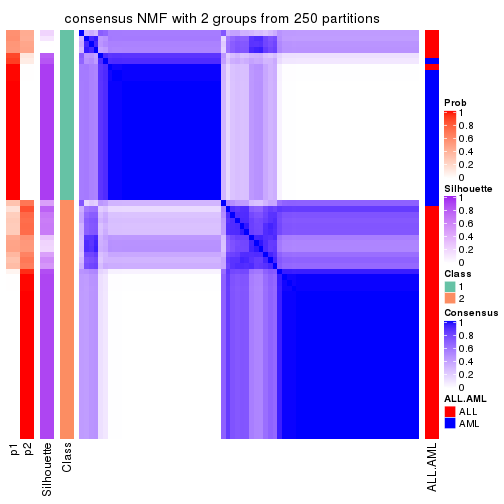
consensus_heatmap(res, k = 3)
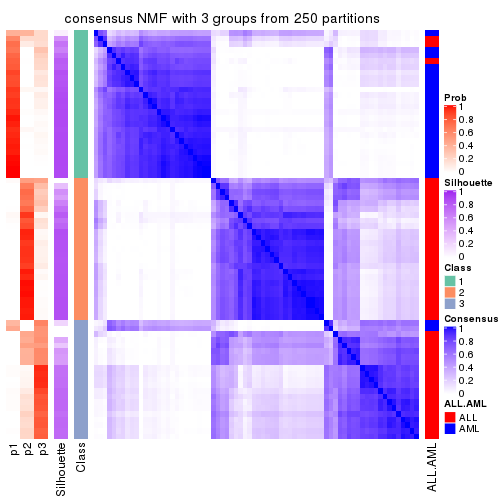
consensus_heatmap(res, k = 4)
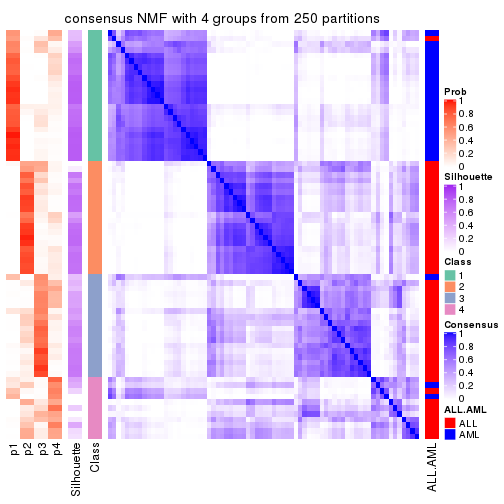
consensus_heatmap(res, k = 5)
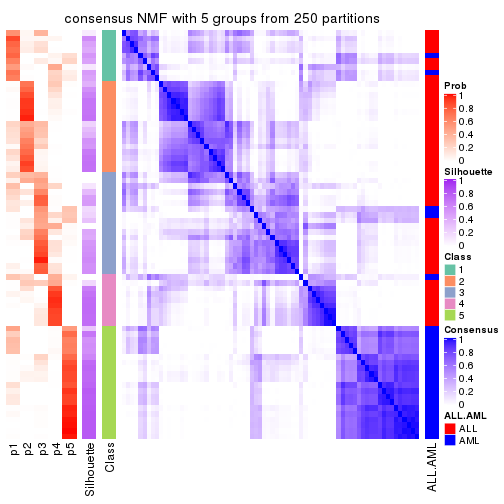
consensus_heatmap(res, k = 6)
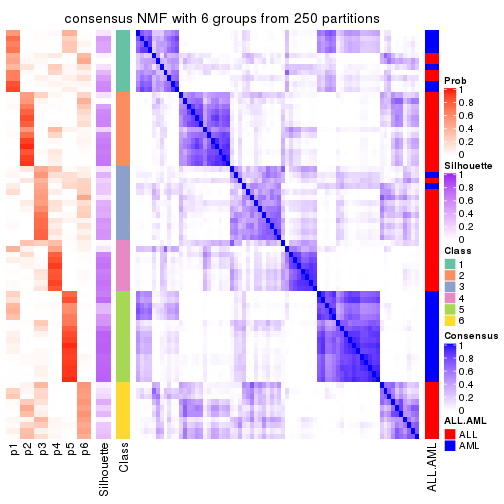
Heatmaps for the membership of samples in all partitions to see how consistent they are:
membership_heatmap(res, k = 2)
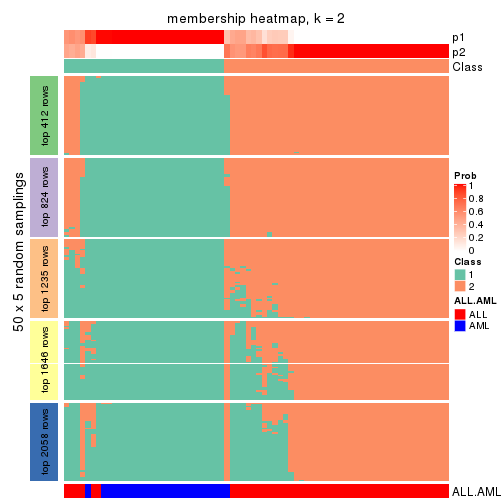
membership_heatmap(res, k = 3)
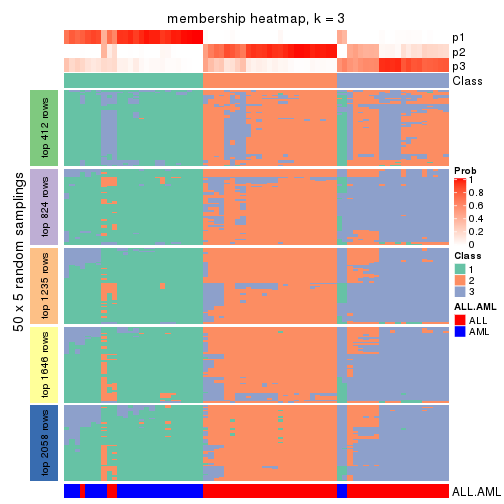
membership_heatmap(res, k = 4)
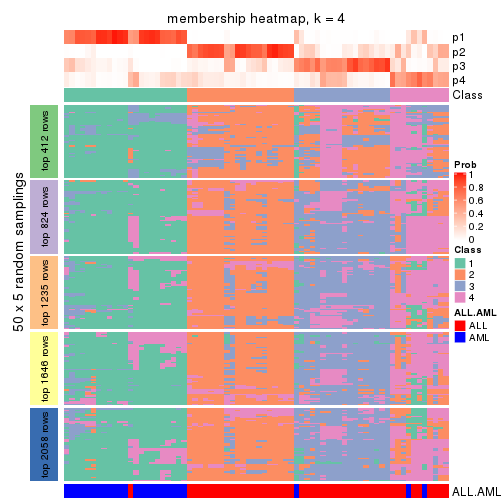
membership_heatmap(res, k = 5)
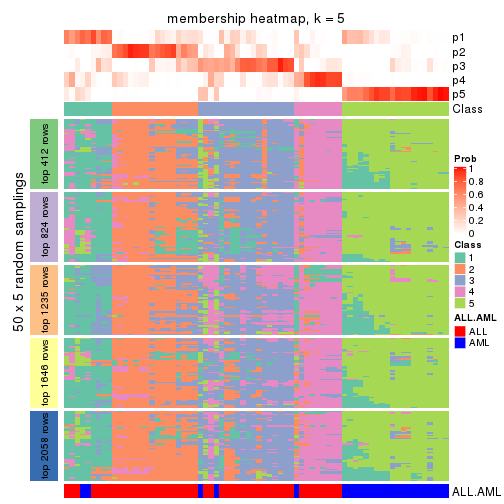
membership_heatmap(res, k = 6)
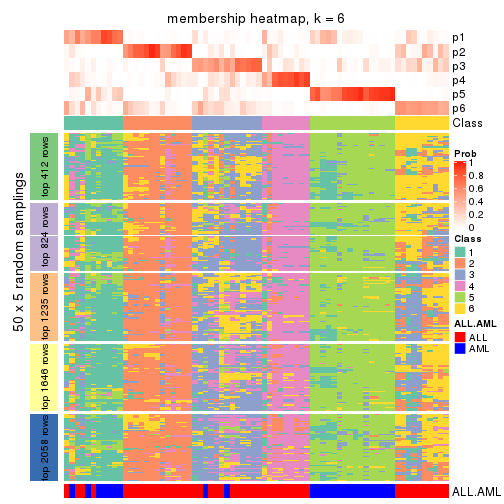
As soon as we have had the classes for columns, we can look for signatures which are significantly different between classes which can be candidate marks for certain classes. Following are the heatmaps for signatures.
Signature heatmaps where rows are scaled:
get_signatures(res, k = 2)
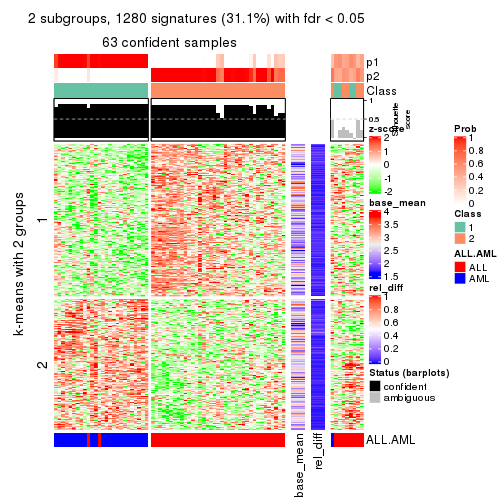
get_signatures(res, k = 3)
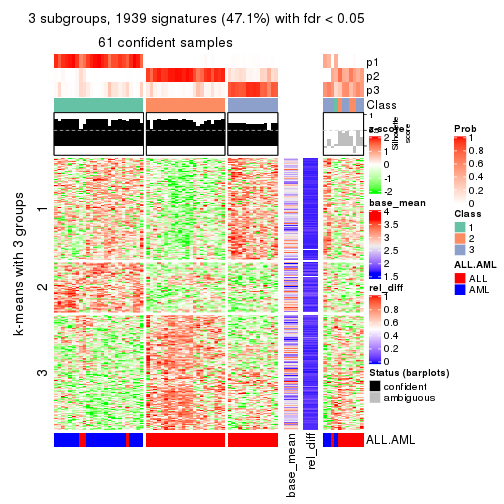
get_signatures(res, k = 4)
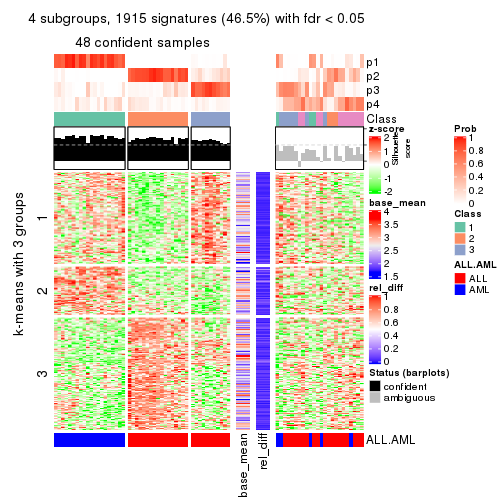
get_signatures(res, k = 5)
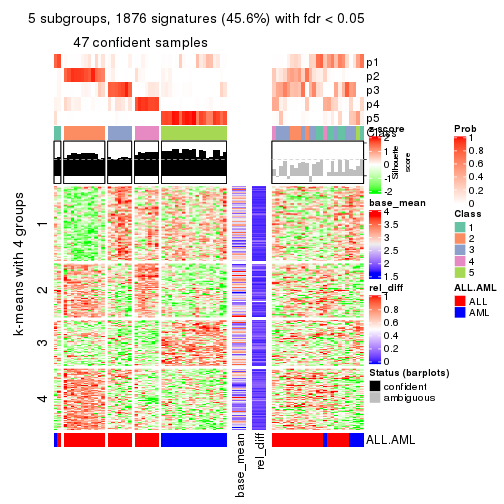
get_signatures(res, k = 6)
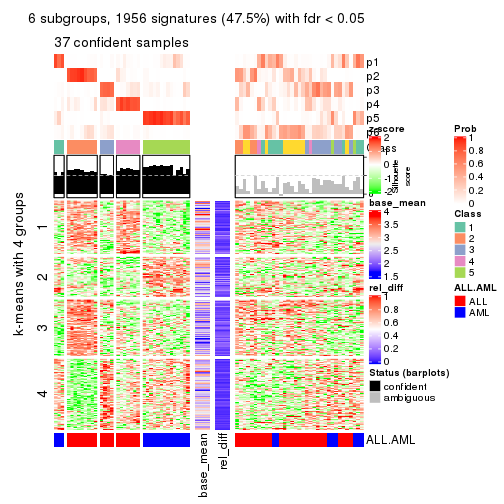
Signature heatmaps where rows are not scaled:
get_signatures(res, k = 2, scale_rows = FALSE)
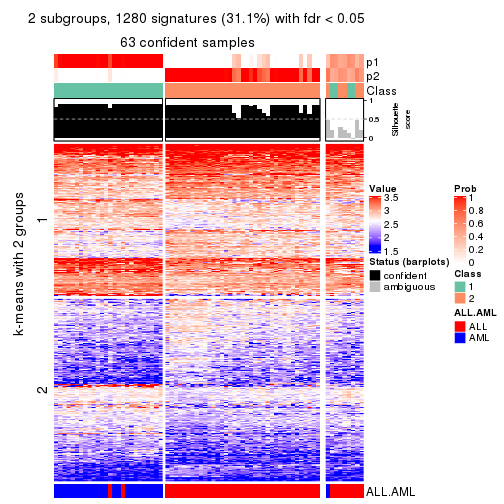
get_signatures(res, k = 3, scale_rows = FALSE)
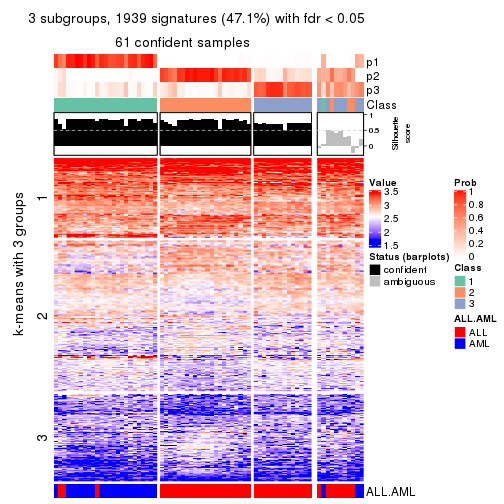
get_signatures(res, k = 4, scale_rows = FALSE)
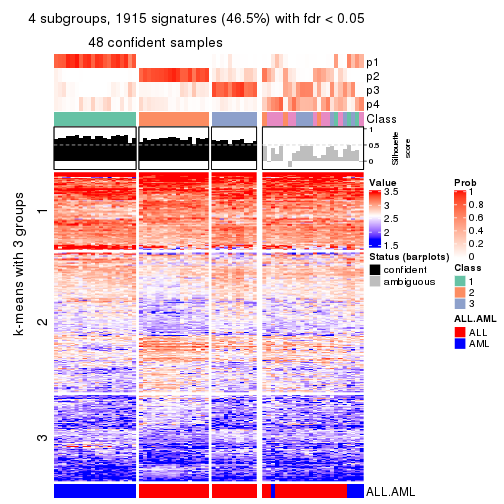
get_signatures(res, k = 5, scale_rows = FALSE)
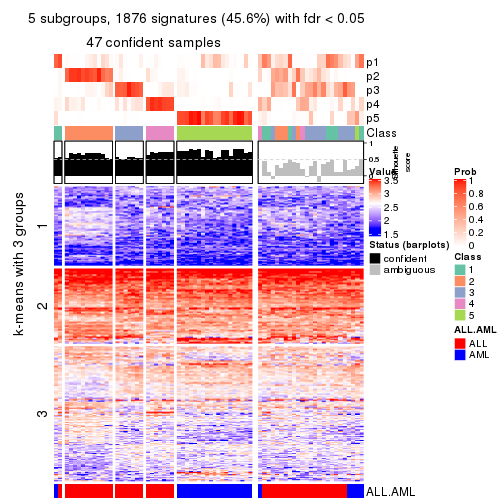
get_signatures(res, k = 6, scale_rows = FALSE)
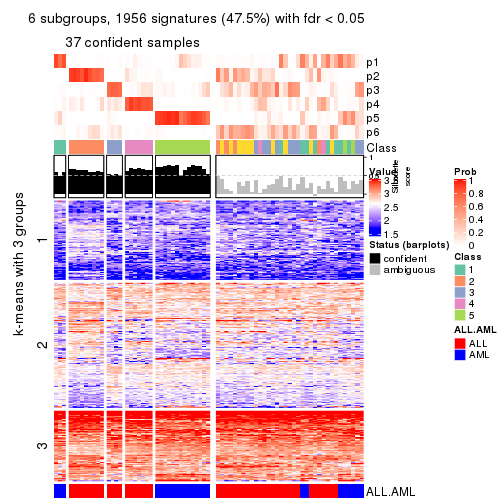
Compare the overlap of signatures from different k:
compare_signatures(res)
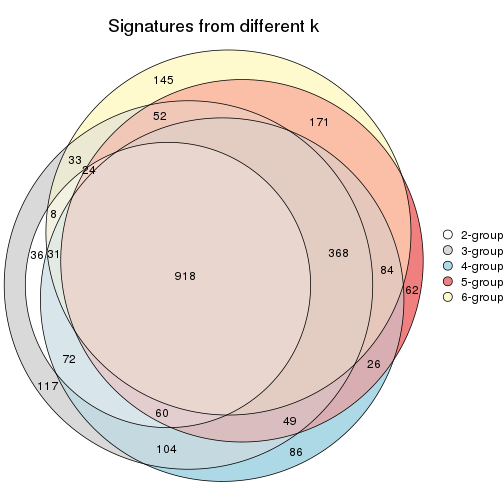
get_signature() returns a data frame invisibly. TO get the list of signatures, the function
call should be assigned to a variable explicitly. In following code, if plot argument is set
to FALSE, no heatmap is plotted while only the differential analysis is performed.
# code only for demonstration
tb = get_signature(res, k = ..., plot = FALSE)
An example of the output of tb is:
#> which_row fdr mean_1 mean_2 scaled_mean_1 scaled_mean_2 km
#> 1 38 0.042760348 8.373488 9.131774 -0.5533452 0.5164555 1
#> 2 40 0.018707592 7.106213 8.469186 -0.6173731 0.5762149 1
#> 3 55 0.019134737 10.221463 11.207825 -0.6159697 0.5749050 1
#> 4 59 0.006059896 5.921854 7.869574 -0.6899429 0.6439467 1
#> 5 60 0.018055526 8.928898 10.211722 -0.6204761 0.5791110 1
#> 6 98 0.009384629 15.714769 14.887706 0.6635654 -0.6193277 2
...
The columns in tb are:
which_row: row indices corresponding to the input matrix.fdr: FDR for the differential test. mean_x: The mean value in group x.scaled_mean_x: The mean value in group x after rows are scaled.km: Row groups if k-means clustering is applied to rows.UMAP plot which shows how samples are separated.
dimension_reduction(res, k = 2, method = "UMAP")
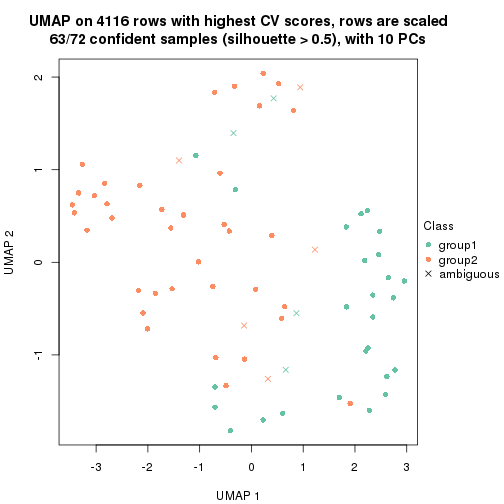
dimension_reduction(res, k = 3, method = "UMAP")
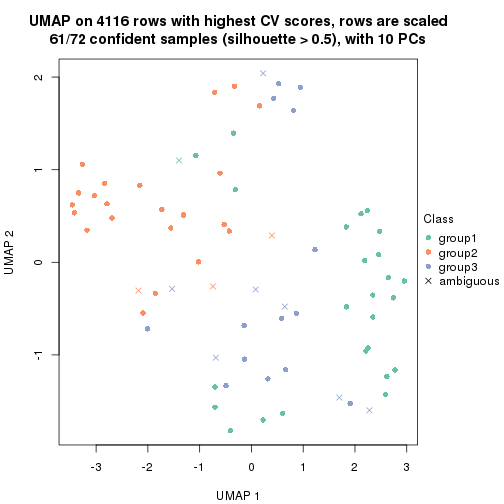
dimension_reduction(res, k = 4, method = "UMAP")
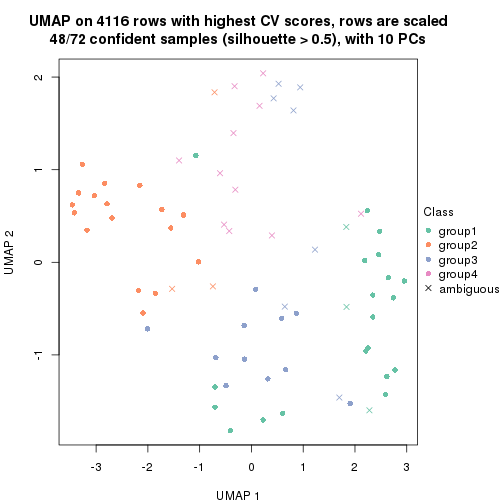
dimension_reduction(res, k = 5, method = "UMAP")
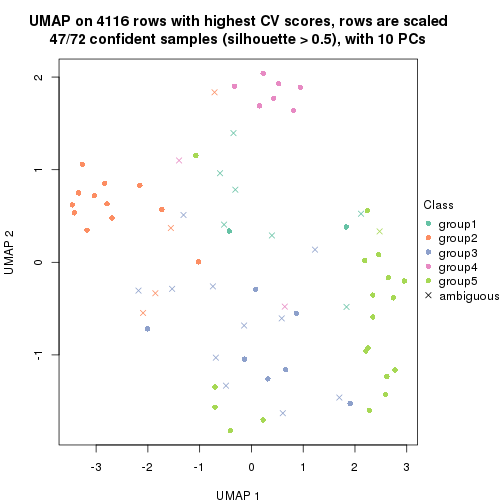
dimension_reduction(res, k = 6, method = "UMAP")
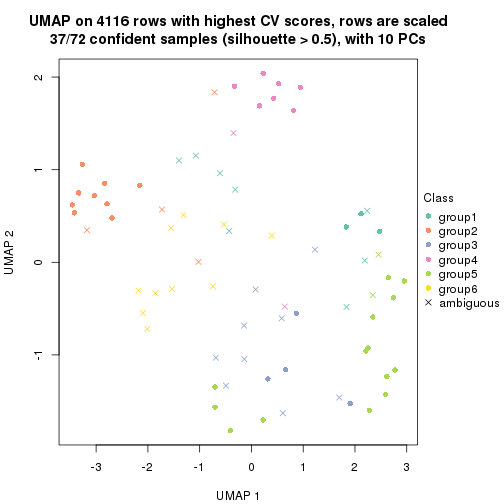
Following heatmap shows how subgroups are split when increasing k:
collect_classes(res)
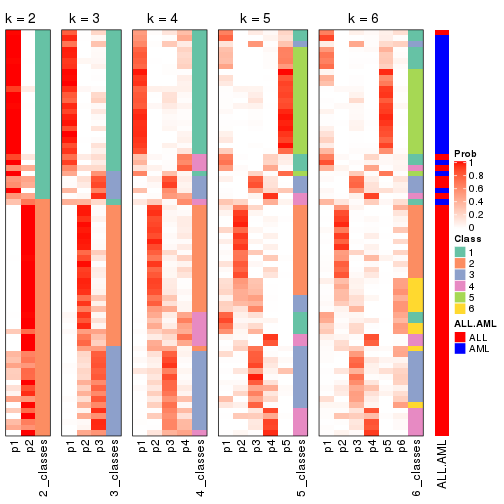
Test correlation between subgroups and known annotations. If the known annotation is numeric, one-way ANOVA test is applied, and if the known annotation is discrete, chi-squared contingency table test is applied.
test_to_known_factors(res)
#> n ALL.AML(p) k
#> CV:NMF 63 7.82e-13 2
#> CV:NMF 61 1.74e-11 3
#> CV:NMF 48 3.78e-11 4
#> CV:NMF 47 4.06e-09 5
#> CV:NMF 37 1.80e-07 6
If matrix rows can be associated to genes, consider to use functional_enrichment(res,
...) to perform function enrichment for the signature genes. See this vignette for more detailed explanations.
The object with results only for a single top-value method and a single partition method can be extracted as:
res = res_list["MAD", "hclust"]
# you can also extract it by
# res = res_list["MAD:hclust"]
A summary of res and all the functions that can be applied to it:
res
#> A 'ConsensusPartition' object with k = 2, 3, 4, 5, 6.
#> On a matrix with 4116 rows and 72 columns.
#> Top rows (412, 824, 1235, 1646, 2058) are extracted by 'MAD' method.
#> Subgroups are detected by 'hclust' method.
#> Performed in total 1250 partitions by row resampling.
#> Best k for subgroups seems to be 2.
#>
#> Following methods can be applied to this 'ConsensusPartition' object:
#> [1] "cola_report" "collect_classes" "collect_plots"
#> [4] "collect_stats" "colnames" "compare_signatures"
#> [7] "consensus_heatmap" "dimension_reduction" "functional_enrichment"
#> [10] "get_anno_col" "get_anno" "get_classes"
#> [13] "get_consensus" "get_matrix" "get_membership"
#> [16] "get_param" "get_signatures" "get_stats"
#> [19] "is_best_k" "is_stable_k" "membership_heatmap"
#> [22] "ncol" "nrow" "plot_ecdf"
#> [25] "rownames" "select_partition_number" "show"
#> [28] "suggest_best_k" "test_to_known_factors"
collect_plots() function collects all the plots made from res for all k (number of partitions)
into one single page to provide an easy and fast comparison between different k.
collect_plots(res)
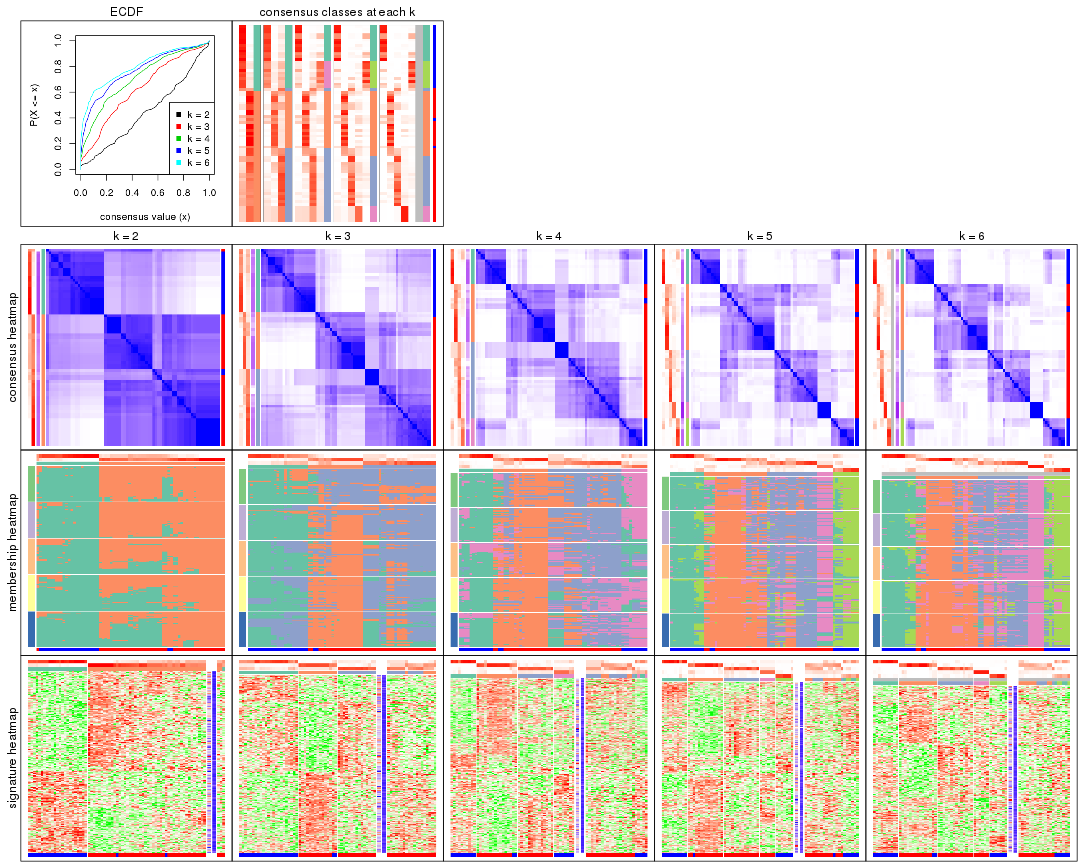
The plots are:
k and the heatmap of
predicted classes for each k.k.k.k.All the plots in panels can be made by individual functions and they are plotted later in this section.
select_partition_number() produces several plots showing different
statistics for choosing “optimized” k. There are following statistics:
k;k, the area increased is defined as \(A_k - A_{k-1}\).The detailed explanations of these statistics can be found in the cola vignette.
Generally speaking, lower PAC score, higher mean silhouette score or higher
concordance corresponds to better partition. Rand index and Jaccard index
measure how similar the current partition is compared to partition with k-1.
If they are too similar, we won't accept k is better than k-1.
select_partition_number(res)
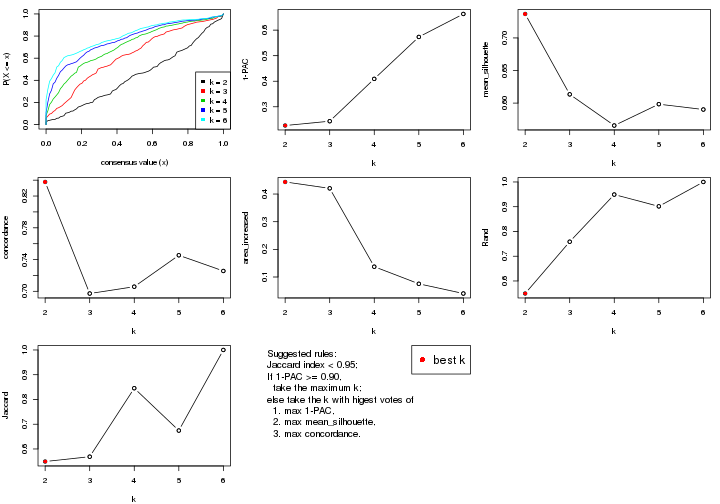
The numeric values for all these statistics can be obtained by get_stats().
get_stats(res)
#> k 1-PAC mean_silhouette concordance area_increased Rand Jaccard
#> 2 2 0.227 0.737 0.838 0.4437 0.549 0.549
#> 3 3 0.243 0.613 0.697 0.4206 0.759 0.569
#> 4 4 0.409 0.566 0.706 0.1373 0.949 0.845
#> 5 5 0.573 0.598 0.745 0.0754 0.901 0.674
#> 6 6 0.663 0.590 0.726 0.0402 1.000 1.000
suggest_best_k() suggests the best \(k\) based on these statistics. The rules are as follows:
suggest_best_k(res)
#> [1] 2
Following shows the table of the partitions (You need to click the show/hide
code output link to see it). The membership matrix (columns with name p*)
is inferred by
clue::cl_consensus()
function with the SE method. Basically the value in the membership matrix
represents the probability to belong to a certain group. The finall class
label for an item is determined with the group with highest probability it
belongs to.
In get_classes() function, the entropy is calculated from the membership
matrix and the silhouette score is calculated from the consensus matrix.
cbind(get_classes(res, k = 2), get_membership(res, k = 2))
#> class entropy silhouette p1 p2
#> sample_39 2 0.9754 0.591 0.408 0.592
#> sample_40 1 0.9933 -0.217 0.548 0.452
#> sample_42 2 0.3733 0.765 0.072 0.928
#> sample_47 2 0.3733 0.770 0.072 0.928
#> sample_48 2 0.0000 0.746 0.000 1.000
#> sample_49 2 0.9754 0.589 0.408 0.592
#> sample_41 2 0.0000 0.746 0.000 1.000
#> sample_43 2 0.3114 0.765 0.056 0.944
#> sample_44 2 0.5842 0.775 0.140 0.860
#> sample_45 2 0.6438 0.773 0.164 0.836
#> sample_46 2 0.6801 0.770 0.180 0.820
#> sample_70 2 0.7453 0.762 0.212 0.788
#> sample_71 2 0.6531 0.750 0.168 0.832
#> sample_72 2 0.6531 0.750 0.168 0.832
#> sample_68 2 0.0000 0.746 0.000 1.000
#> sample_69 2 0.0000 0.746 0.000 1.000
#> sample_67 2 0.9491 0.409 0.368 0.632
#> sample_55 2 0.9427 0.659 0.360 0.640
#> sample_56 2 0.9686 0.608 0.396 0.604
#> sample_59 2 0.8608 0.729 0.284 0.716
#> sample_52 1 0.4939 0.859 0.892 0.108
#> sample_53 1 0.0938 0.892 0.988 0.012
#> sample_51 1 0.0000 0.889 1.000 0.000
#> sample_50 1 0.0000 0.889 1.000 0.000
#> sample_54 1 0.6148 0.818 0.848 0.152
#> sample_57 1 0.5842 0.826 0.860 0.140
#> sample_58 1 0.0672 0.892 0.992 0.008
#> sample_60 1 0.6148 0.818 0.848 0.152
#> sample_61 1 0.0672 0.892 0.992 0.008
#> sample_65 1 0.0672 0.892 0.992 0.008
#> sample_66 2 0.7219 0.642 0.200 0.800
#> sample_63 1 0.4939 0.859 0.892 0.108
#> sample_64 1 0.6801 0.751 0.820 0.180
#> sample_62 1 0.4939 0.859 0.892 0.108
#> sample_1 2 0.9460 0.647 0.364 0.636
#> sample_2 2 0.9427 0.441 0.360 0.640
#> sample_3 2 0.8327 0.734 0.264 0.736
#> sample_4 2 0.9522 0.639 0.372 0.628
#> sample_5 2 0.0000 0.746 0.000 1.000
#> sample_6 2 0.8327 0.734 0.264 0.736
#> sample_7 2 0.9522 0.639 0.372 0.628
#> sample_8 2 0.9710 0.602 0.400 0.600
#> sample_9 2 0.8327 0.734 0.264 0.736
#> sample_10 2 0.8327 0.734 0.264 0.736
#> sample_11 2 0.8327 0.734 0.264 0.736
#> sample_12 2 0.9866 0.551 0.432 0.568
#> sample_13 2 0.0000 0.746 0.000 1.000
#> sample_14 2 0.3879 0.752 0.076 0.924
#> sample_15 2 0.0000 0.746 0.000 1.000
#> sample_16 2 0.4939 0.776 0.108 0.892
#> sample_17 2 0.3879 0.742 0.076 0.924
#> sample_18 2 0.9248 0.681 0.340 0.660
#> sample_19 2 0.4939 0.776 0.108 0.892
#> sample_20 2 0.0000 0.746 0.000 1.000
#> sample_21 2 0.0000 0.746 0.000 1.000
#> sample_22 2 0.9710 0.604 0.400 0.600
#> sample_23 2 0.8327 0.734 0.264 0.736
#> sample_24 2 0.0000 0.746 0.000 1.000
#> sample_25 2 0.9795 0.582 0.416 0.584
#> sample_26 2 0.5408 0.776 0.124 0.876
#> sample_27 2 0.9754 0.589 0.408 0.592
#> sample_34 1 0.4690 0.865 0.900 0.100
#> sample_35 1 0.4939 0.858 0.892 0.108
#> sample_36 1 0.0000 0.889 1.000 0.000
#> sample_37 1 0.0000 0.889 1.000 0.000
#> sample_38 1 0.3274 0.884 0.940 0.060
#> sample_28 1 0.1843 0.891 0.972 0.028
#> sample_29 2 0.8555 0.513 0.280 0.720
#> sample_30 1 0.0000 0.889 1.000 0.000
#> sample_31 1 0.2043 0.893 0.968 0.032
#> sample_32 1 0.2948 0.886 0.948 0.052
#> sample_33 1 0.0000 0.889 1.000 0.000
cbind(get_classes(res, k = 3), get_membership(res, k = 3))
#> class entropy silhouette p1 p2 p3
#> sample_39 3 0.406 0.6746 0.112 0.020 0.868
#> sample_40 3 0.696 0.3973 0.184 0.092 0.724
#> sample_42 2 0.700 0.3864 0.020 0.552 0.428
#> sample_47 2 0.630 0.5278 0.008 0.640 0.352
#> sample_48 2 0.382 0.7575 0.000 0.852 0.148
#> sample_49 3 0.397 0.6677 0.132 0.008 0.860
#> sample_41 2 0.369 0.7590 0.000 0.860 0.140
#> sample_43 2 0.663 0.3822 0.008 0.552 0.440
#> sample_44 3 0.596 0.3808 0.004 0.324 0.672
#> sample_45 3 0.599 0.4059 0.008 0.304 0.688
#> sample_46 3 0.576 0.4650 0.008 0.276 0.716
#> sample_70 3 0.607 0.5309 0.028 0.236 0.736
#> sample_71 2 0.855 0.3146 0.096 0.492 0.412
#> sample_72 2 0.855 0.3146 0.096 0.492 0.412
#> sample_68 2 0.369 0.7590 0.000 0.860 0.140
#> sample_69 2 0.382 0.7575 0.000 0.852 0.148
#> sample_67 2 0.852 0.4364 0.328 0.560 0.112
#> sample_55 3 0.365 0.6960 0.068 0.036 0.896
#> sample_56 3 0.369 0.6832 0.108 0.012 0.880
#> sample_59 3 0.422 0.6631 0.032 0.100 0.868
#> sample_52 1 0.825 0.6776 0.588 0.100 0.312
#> sample_53 1 0.295 0.7450 0.908 0.004 0.088
#> sample_51 1 0.259 0.7521 0.924 0.004 0.072
#> sample_50 1 0.236 0.7512 0.928 0.000 0.072
#> sample_54 1 0.863 0.6296 0.532 0.112 0.356
#> sample_57 1 0.847 0.6372 0.540 0.100 0.360
#> sample_58 1 0.630 0.7458 0.756 0.060 0.184
#> sample_60 1 0.863 0.6296 0.532 0.112 0.356
#> sample_61 1 0.457 0.7626 0.828 0.012 0.160
#> sample_65 1 0.451 0.7633 0.832 0.012 0.156
#> sample_66 2 0.778 0.6043 0.156 0.676 0.168
#> sample_63 1 0.825 0.6776 0.588 0.100 0.312
#> sample_64 1 0.859 0.5511 0.496 0.100 0.404
#> sample_62 1 0.825 0.6776 0.588 0.100 0.312
#> sample_1 3 0.469 0.6978 0.096 0.052 0.852
#> sample_2 2 0.859 0.4476 0.300 0.572 0.128
#> sample_3 3 0.815 0.4994 0.156 0.200 0.644
#> sample_4 3 0.459 0.6966 0.096 0.048 0.856
#> sample_5 2 0.369 0.7590 0.000 0.860 0.140
#> sample_6 3 0.815 0.4994 0.156 0.200 0.644
#> sample_7 3 0.459 0.6966 0.096 0.048 0.856
#> sample_8 3 0.334 0.6746 0.120 0.000 0.880
#> sample_9 3 0.815 0.4994 0.156 0.200 0.644
#> sample_10 3 0.815 0.4994 0.156 0.200 0.644
#> sample_11 3 0.815 0.4994 0.156 0.200 0.644
#> sample_12 3 0.630 0.6268 0.192 0.056 0.752
#> sample_13 2 0.382 0.7575 0.000 0.852 0.148
#> sample_14 2 0.541 0.7092 0.032 0.796 0.172
#> sample_15 2 0.369 0.7590 0.000 0.860 0.140
#> sample_16 3 0.647 0.0146 0.004 0.444 0.552
#> sample_17 2 0.500 0.7257 0.028 0.820 0.152
#> sample_18 3 0.492 0.6846 0.072 0.084 0.844
#> sample_19 3 0.646 0.0271 0.004 0.440 0.556
#> sample_20 2 0.382 0.7575 0.000 0.852 0.148
#> sample_21 2 0.394 0.7524 0.000 0.844 0.156
#> sample_22 3 0.368 0.6808 0.116 0.008 0.876
#> sample_23 3 0.815 0.4994 0.156 0.200 0.644
#> sample_24 2 0.369 0.7590 0.000 0.860 0.140
#> sample_25 3 0.623 0.6446 0.172 0.064 0.764
#> sample_26 3 0.628 0.1695 0.004 0.384 0.612
#> sample_27 3 0.397 0.6677 0.132 0.008 0.860
#> sample_34 1 0.662 0.7054 0.660 0.024 0.316
#> sample_35 1 0.771 0.6808 0.604 0.064 0.332
#> sample_36 1 0.236 0.7512 0.928 0.000 0.072
#> sample_37 1 0.216 0.7461 0.936 0.000 0.064
#> sample_38 1 0.368 0.7220 0.876 0.008 0.116
#> sample_28 1 0.338 0.7370 0.896 0.012 0.092
#> sample_29 2 0.803 0.5350 0.240 0.640 0.120
#> sample_30 1 0.236 0.7512 0.928 0.000 0.072
#> sample_31 1 0.541 0.7613 0.780 0.020 0.200
#> sample_32 1 0.515 0.7601 0.800 0.020 0.180
#> sample_33 1 0.226 0.7488 0.932 0.000 0.068
cbind(get_classes(res, k = 4), get_membership(res, k = 4))
#> class entropy silhouette p1 p2 p3 p4
#> sample_39 3 0.4053 0.5939 0.020 0.028 0.844 0.108
#> sample_40 3 0.5527 0.2879 0.016 0.016 0.664 0.304
#> sample_42 2 0.6286 0.3348 0.016 0.576 0.372 0.036
#> sample_47 2 0.4748 0.5353 0.000 0.716 0.268 0.016
#> sample_48 2 0.1474 0.7505 0.000 0.948 0.052 0.000
#> sample_49 3 0.4335 0.5883 0.028 0.020 0.824 0.128
#> sample_41 2 0.1209 0.7509 0.000 0.964 0.032 0.004
#> sample_43 2 0.5832 0.3368 0.004 0.596 0.368 0.032
#> sample_44 3 0.5954 0.3562 0.000 0.344 0.604 0.052
#> sample_45 3 0.5786 0.3901 0.000 0.308 0.640 0.052
#> sample_46 3 0.5943 0.4382 0.004 0.280 0.656 0.060
#> sample_70 3 0.5767 0.4907 0.004 0.244 0.688 0.064
#> sample_71 2 0.7744 0.2646 0.080 0.488 0.380 0.052
#> sample_72 2 0.7744 0.2646 0.080 0.488 0.380 0.052
#> sample_68 2 0.1305 0.7516 0.000 0.960 0.036 0.004
#> sample_69 2 0.1474 0.7505 0.000 0.948 0.052 0.000
#> sample_67 2 0.7887 0.4870 0.288 0.544 0.052 0.116
#> sample_55 3 0.4749 0.6031 0.020 0.044 0.804 0.132
#> sample_56 3 0.3985 0.5994 0.008 0.024 0.832 0.136
#> sample_59 3 0.4901 0.6095 0.000 0.108 0.780 0.112
#> sample_52 4 0.5701 0.7675 0.132 0.008 0.124 0.736
#> sample_53 1 0.1042 0.8013 0.972 0.000 0.008 0.020
#> sample_51 1 0.0779 0.8096 0.980 0.000 0.004 0.016
#> sample_50 1 0.0376 0.8101 0.992 0.000 0.004 0.004
#> sample_54 4 0.5926 0.7519 0.112 0.016 0.144 0.728
#> sample_57 4 0.5896 0.7565 0.128 0.008 0.144 0.720
#> sample_58 4 0.6060 0.2702 0.440 0.000 0.044 0.516
#> sample_60 4 0.5926 0.7519 0.112 0.016 0.144 0.728
#> sample_61 1 0.5955 0.2657 0.616 0.000 0.056 0.328
#> sample_65 1 0.5884 0.2735 0.620 0.000 0.052 0.328
#> sample_66 2 0.7521 0.6199 0.100 0.640 0.108 0.152
#> sample_63 4 0.5701 0.7675 0.132 0.008 0.124 0.736
#> sample_64 4 0.7585 0.6014 0.172 0.012 0.288 0.528
#> sample_62 4 0.5701 0.7675 0.132 0.008 0.124 0.736
#> sample_1 3 0.4472 0.6203 0.016 0.072 0.828 0.084
#> sample_2 2 0.8090 0.5089 0.260 0.544 0.060 0.136
#> sample_3 3 0.9002 0.4176 0.176 0.188 0.492 0.144
#> sample_4 3 0.4931 0.5972 0.016 0.096 0.800 0.088
#> sample_5 2 0.1305 0.7516 0.000 0.960 0.036 0.004
#> sample_6 3 0.9002 0.4176 0.176 0.188 0.492 0.144
#> sample_7 3 0.4931 0.5972 0.016 0.096 0.800 0.088
#> sample_8 3 0.3965 0.5915 0.016 0.020 0.840 0.124
#> sample_9 3 0.9002 0.4176 0.176 0.188 0.492 0.144
#> sample_10 3 0.9002 0.4176 0.176 0.188 0.492 0.144
#> sample_11 3 0.9002 0.4176 0.176 0.188 0.492 0.144
#> sample_12 3 0.6638 0.5600 0.116 0.060 0.704 0.120
#> sample_13 2 0.1474 0.7505 0.000 0.948 0.052 0.000
#> sample_14 2 0.4683 0.7004 0.012 0.812 0.080 0.096
#> sample_15 2 0.1305 0.7516 0.000 0.960 0.036 0.004
#> sample_16 3 0.5409 0.0228 0.000 0.492 0.496 0.012
#> sample_17 2 0.4292 0.7194 0.008 0.832 0.072 0.088
#> sample_18 3 0.5635 0.6192 0.032 0.096 0.764 0.108
#> sample_19 3 0.5406 0.0519 0.000 0.480 0.508 0.012
#> sample_20 2 0.1474 0.7505 0.000 0.948 0.052 0.000
#> sample_21 2 0.3256 0.7164 0.004 0.884 0.044 0.068
#> sample_22 3 0.4322 0.6016 0.032 0.020 0.828 0.120
#> sample_23 3 0.9002 0.4176 0.176 0.188 0.492 0.144
#> sample_24 2 0.1209 0.7509 0.000 0.964 0.032 0.004
#> sample_25 3 0.6502 0.5741 0.096 0.068 0.716 0.120
#> sample_26 3 0.5320 0.1998 0.000 0.416 0.572 0.012
#> sample_27 3 0.4335 0.5883 0.028 0.020 0.824 0.128
#> sample_34 4 0.7701 0.3729 0.388 0.000 0.220 0.392
#> sample_35 4 0.7598 0.5467 0.284 0.000 0.240 0.476
#> sample_36 1 0.0895 0.8094 0.976 0.000 0.004 0.020
#> sample_37 1 0.0376 0.8091 0.992 0.000 0.004 0.004
#> sample_38 1 0.2335 0.7535 0.920 0.000 0.020 0.060
#> sample_28 1 0.1486 0.7914 0.960 0.008 0.024 0.008
#> sample_29 2 0.7850 0.5781 0.188 0.596 0.068 0.148
#> sample_30 1 0.0895 0.8094 0.976 0.000 0.004 0.020
#> sample_31 1 0.6497 0.2065 0.596 0.000 0.100 0.304
#> sample_32 1 0.6084 0.5100 0.692 0.016 0.072 0.220
#> sample_33 1 0.0188 0.8098 0.996 0.000 0.004 0.000
cbind(get_classes(res, k = 5), get_membership(res, k = 5))
#> class entropy silhouette p1 p2 p3 p4 p5
#> sample_39 3 0.2268 0.6675 0.012 0.028 0.924 0.028 0.008
#> sample_40 3 0.4988 0.3900 0.000 0.000 0.656 0.060 0.284
#> sample_42 2 0.6673 0.4184 0.012 0.576 0.248 0.144 0.020
#> sample_47 2 0.5090 0.5575 0.000 0.732 0.160 0.084 0.024
#> sample_48 2 0.0510 0.6893 0.000 0.984 0.016 0.000 0.000
#> sample_49 3 0.2330 0.6645 0.020 0.004 0.920 0.036 0.020
#> sample_41 2 0.1682 0.6831 0.000 0.940 0.012 0.044 0.004
#> sample_43 2 0.6200 0.4236 0.000 0.600 0.248 0.132 0.020
#> sample_44 3 0.7327 0.2178 0.000 0.344 0.428 0.184 0.044
#> sample_45 3 0.7322 0.2851 0.000 0.308 0.452 0.196 0.044
#> sample_46 3 0.7574 0.3478 0.004 0.280 0.460 0.200 0.056
#> sample_70 3 0.7470 0.4239 0.004 0.244 0.496 0.196 0.060
#> sample_71 2 0.7893 0.3067 0.080 0.456 0.300 0.148 0.016
#> sample_72 2 0.7893 0.3067 0.080 0.456 0.300 0.148 0.016
#> sample_68 2 0.1710 0.6847 0.000 0.940 0.016 0.040 0.004
#> sample_69 2 0.0510 0.6893 0.000 0.984 0.016 0.000 0.000
#> sample_67 2 0.7573 0.3794 0.284 0.464 0.004 0.188 0.060
#> sample_55 3 0.5810 0.6181 0.004 0.024 0.680 0.156 0.136
#> sample_56 3 0.3757 0.6682 0.004 0.004 0.828 0.104 0.060
#> sample_59 3 0.6811 0.5666 0.000 0.100 0.600 0.188 0.112
#> sample_52 5 0.1742 0.7509 0.032 0.008 0.008 0.008 0.944
#> sample_53 1 0.0771 0.8017 0.976 0.000 0.000 0.020 0.004
#> sample_51 1 0.0609 0.8092 0.980 0.000 0.000 0.000 0.020
#> sample_50 1 0.0290 0.8092 0.992 0.000 0.000 0.000 0.008
#> sample_54 5 0.3273 0.7353 0.032 0.012 0.008 0.080 0.868
#> sample_57 5 0.3075 0.7385 0.040 0.004 0.008 0.072 0.876
#> sample_58 5 0.4491 0.3145 0.364 0.000 0.008 0.004 0.624
#> sample_60 5 0.3273 0.7353 0.032 0.012 0.008 0.080 0.868
#> sample_61 1 0.5146 0.2777 0.564 0.000 0.028 0.008 0.400
#> sample_65 1 0.5070 0.2828 0.568 0.000 0.024 0.008 0.400
#> sample_66 2 0.7323 0.5219 0.084 0.572 0.028 0.228 0.088
#> sample_63 5 0.1742 0.7509 0.032 0.008 0.008 0.008 0.944
#> sample_64 5 0.6858 0.5398 0.116 0.000 0.264 0.064 0.556
#> sample_62 5 0.1742 0.7509 0.032 0.008 0.008 0.008 0.944
#> sample_1 3 0.4308 0.6727 0.004 0.068 0.816 0.052 0.060
#> sample_2 2 0.7816 0.3800 0.252 0.456 0.008 0.216 0.068
#> sample_3 4 0.5123 1.0000 0.072 0.036 0.156 0.736 0.000
#> sample_4 3 0.4502 0.6508 0.004 0.068 0.804 0.068 0.056
#> sample_5 2 0.1710 0.6847 0.000 0.940 0.016 0.040 0.004
#> sample_6 4 0.5123 1.0000 0.072 0.036 0.156 0.736 0.000
#> sample_7 3 0.4502 0.6508 0.004 0.068 0.804 0.068 0.056
#> sample_8 3 0.1699 0.6613 0.004 0.008 0.944 0.036 0.008
#> sample_9 4 0.5123 1.0000 0.072 0.036 0.156 0.736 0.000
#> sample_10 4 0.5123 1.0000 0.072 0.036 0.156 0.736 0.000
#> sample_11 4 0.5123 1.0000 0.072 0.036 0.156 0.736 0.000
#> sample_12 3 0.5836 0.5646 0.104 0.028 0.716 0.120 0.032
#> sample_13 2 0.0510 0.6893 0.000 0.984 0.016 0.000 0.000
#> sample_14 2 0.4997 0.5639 0.000 0.672 0.012 0.276 0.040
#> sample_15 2 0.1710 0.6847 0.000 0.940 0.016 0.040 0.004
#> sample_16 2 0.6770 0.1490 0.000 0.496 0.336 0.140 0.028
#> sample_17 2 0.4929 0.6103 0.004 0.716 0.012 0.220 0.048
#> sample_18 3 0.6711 0.5642 0.008 0.064 0.616 0.200 0.112
#> sample_19 2 0.6750 0.1138 0.000 0.484 0.356 0.132 0.028
#> sample_20 2 0.0510 0.6893 0.000 0.984 0.016 0.000 0.000
#> sample_21 2 0.3010 0.6291 0.000 0.860 0.016 0.116 0.008
#> sample_22 3 0.2806 0.6518 0.020 0.012 0.896 0.060 0.012
#> sample_23 4 0.5123 1.0000 0.072 0.036 0.156 0.736 0.000
#> sample_24 2 0.1757 0.6826 0.000 0.936 0.012 0.048 0.004
#> sample_25 3 0.5819 0.5752 0.088 0.040 0.724 0.116 0.032
#> sample_26 2 0.6781 -0.0647 0.000 0.424 0.420 0.128 0.028
#> sample_27 3 0.2330 0.6645 0.020 0.004 0.920 0.036 0.020
#> sample_34 5 0.6735 0.3000 0.340 0.000 0.180 0.012 0.468
#> sample_35 5 0.6792 0.4765 0.232 0.000 0.212 0.024 0.532
#> sample_36 1 0.0963 0.8053 0.964 0.000 0.000 0.000 0.036
#> sample_37 1 0.0324 0.8085 0.992 0.000 0.000 0.004 0.004
#> sample_38 1 0.2077 0.7531 0.908 0.000 0.000 0.084 0.008
#> sample_28 1 0.1211 0.7929 0.960 0.000 0.016 0.024 0.000
#> sample_29 2 0.7555 0.4711 0.168 0.528 0.008 0.208 0.088
#> sample_30 1 0.0963 0.8053 0.964 0.000 0.000 0.000 0.036
#> sample_31 1 0.5498 0.2469 0.556 0.000 0.060 0.004 0.380
#> sample_32 1 0.5721 0.5408 0.668 0.004 0.040 0.056 0.232
#> sample_33 1 0.0000 0.8080 1.000 0.000 0.000 0.000 0.000
cbind(get_classes(res, k = 6), get_membership(res, k = 6))
#> class entropy silhouette p1 p2 p3 p4 p5 p6
#> sample_39 3 0.2722 0.66706 0.000 0.004 0.872 0.032 0.004 NA
#> sample_40 3 0.5598 0.34150 0.000 0.004 0.612 0.016 0.224 NA
#> sample_42 2 0.6674 0.41733 0.008 0.492 0.200 0.044 0.000 NA
#> sample_47 2 0.5527 0.54675 0.000 0.664 0.128 0.024 0.016 NA
#> sample_48 2 0.1643 0.67448 0.000 0.924 0.008 0.000 0.000 NA
#> sample_49 3 0.2400 0.66190 0.004 0.000 0.900 0.048 0.008 NA
#> sample_41 2 0.0291 0.67285 0.000 0.992 0.000 0.004 0.000 NA
#> sample_43 2 0.6341 0.42926 0.000 0.516 0.200 0.040 0.000 NA
#> sample_44 3 0.7265 0.15240 0.000 0.312 0.348 0.044 0.020 NA
#> sample_45 3 0.7089 0.20354 0.000 0.256 0.368 0.032 0.020 NA
#> sample_46 3 0.7351 0.26660 0.000 0.228 0.376 0.044 0.032 NA
#> sample_70 3 0.7328 0.34206 0.000 0.192 0.404 0.048 0.036 NA
#> sample_71 2 0.7857 0.32489 0.076 0.424 0.260 0.084 0.000 NA
#> sample_72 2 0.7857 0.32489 0.076 0.424 0.260 0.084 0.000 NA
#> sample_68 2 0.0146 0.67305 0.000 0.996 0.000 0.000 0.000 NA
#> sample_69 2 0.1643 0.67448 0.000 0.924 0.008 0.000 0.000 NA
#> sample_67 2 0.7686 0.39436 0.288 0.440 0.004 0.092 0.056 NA
#> sample_55 3 0.6102 0.61802 0.000 0.020 0.620 0.056 0.104 NA
#> sample_56 3 0.4100 0.66519 0.000 0.000 0.772 0.036 0.040 NA
#> sample_59 3 0.7061 0.54302 0.000 0.100 0.516 0.052 0.072 NA
#> sample_52 5 0.0862 0.74097 0.016 0.004 0.000 0.000 0.972 NA
#> sample_53 1 0.0881 0.79702 0.972 0.000 0.000 0.008 0.008 NA
#> sample_51 1 0.0632 0.80246 0.976 0.000 0.000 0.000 0.024 NA
#> sample_50 1 0.0363 0.80284 0.988 0.000 0.000 0.000 0.012 NA
#> sample_54 5 0.2959 0.72502 0.012 0.012 0.000 0.020 0.864 NA
#> sample_57 5 0.2824 0.72755 0.020 0.004 0.000 0.020 0.872 NA
#> sample_58 5 0.5140 0.36719 0.296 0.000 0.004 0.004 0.608 NA
#> sample_60 5 0.2959 0.72502 0.012 0.012 0.000 0.020 0.864 NA
#> sample_61 1 0.5862 0.19516 0.500 0.000 0.024 0.008 0.384 NA
#> sample_65 1 0.5716 0.20484 0.508 0.000 0.020 0.008 0.388 NA
#> sample_66 2 0.7462 0.54984 0.080 0.532 0.016 0.080 0.080 NA
#> sample_63 5 0.0862 0.74097 0.016 0.004 0.000 0.000 0.972 NA
#> sample_64 5 0.7120 0.51027 0.084 0.004 0.236 0.012 0.492 NA
#> sample_62 5 0.0862 0.74097 0.016 0.004 0.000 0.000 0.972 NA
#> sample_1 3 0.4719 0.67440 0.000 0.056 0.772 0.036 0.060 NA
#> sample_2 2 0.7939 0.41672 0.256 0.432 0.004 0.116 0.064 NA
#> sample_3 4 0.0777 1.00000 0.004 0.000 0.024 0.972 0.000 NA
#> sample_4 3 0.4207 0.64630 0.000 0.096 0.796 0.036 0.056 NA
#> sample_5 2 0.0146 0.67305 0.000 0.996 0.000 0.000 0.000 NA
#> sample_6 4 0.0777 1.00000 0.004 0.000 0.024 0.972 0.000 NA
#> sample_7 3 0.4207 0.64630 0.000 0.096 0.796 0.036 0.056 NA
#> sample_8 3 0.2290 0.65364 0.000 0.004 0.904 0.044 0.004 NA
#> sample_9 4 0.0777 1.00000 0.004 0.000 0.024 0.972 0.000 NA
#> sample_10 4 0.0777 1.00000 0.004 0.000 0.024 0.972 0.000 NA
#> sample_11 4 0.0777 1.00000 0.004 0.000 0.024 0.972 0.000 NA
#> sample_12 3 0.6323 0.59471 0.096 0.016 0.648 0.076 0.024 NA
#> sample_13 2 0.1643 0.67448 0.000 0.924 0.008 0.000 0.000 NA
#> sample_14 2 0.5044 0.55826 0.000 0.688 0.008 0.212 0.032 NA
#> sample_15 2 0.0146 0.67305 0.000 0.996 0.000 0.000 0.000 NA
#> sample_16 2 0.6903 0.17165 0.000 0.468 0.268 0.052 0.012 NA
#> sample_17 2 0.4707 0.62242 0.000 0.748 0.008 0.132 0.044 NA
#> sample_18 3 0.7176 0.57853 0.000 0.056 0.540 0.156 0.080 NA
#> sample_19 2 0.6842 0.14441 0.000 0.452 0.288 0.040 0.012 NA
#> sample_20 2 0.1643 0.67448 0.000 0.924 0.008 0.000 0.000 NA
#> sample_21 2 0.3767 0.51183 0.000 0.708 0.004 0.012 0.000 NA
#> sample_22 3 0.3430 0.64721 0.012 0.004 0.840 0.080 0.004 NA
#> sample_23 4 0.0777 1.00000 0.004 0.000 0.024 0.972 0.000 NA
#> sample_24 2 0.0436 0.67263 0.000 0.988 0.004 0.004 0.000 NA
#> sample_25 3 0.6209 0.60241 0.080 0.020 0.660 0.072 0.024 NA
#> sample_26 2 0.6971 0.00302 0.000 0.388 0.340 0.040 0.012 NA
#> sample_27 3 0.2400 0.66190 0.004 0.000 0.900 0.048 0.008 NA
#> sample_34 5 0.6775 0.30264 0.308 0.000 0.164 0.000 0.452 NA
#> sample_35 5 0.7056 0.45516 0.200 0.000 0.196 0.008 0.492 NA
#> sample_36 1 0.1010 0.79907 0.960 0.000 0.000 0.000 0.036 NA
#> sample_37 1 0.0146 0.80213 0.996 0.000 0.000 0.000 0.004 NA
#> sample_38 1 0.2251 0.75294 0.904 0.000 0.000 0.036 0.008 NA
#> sample_28 1 0.1317 0.78854 0.956 0.000 0.008 0.016 0.004 NA
#> sample_29 2 0.7468 0.52002 0.164 0.504 0.000 0.068 0.080 NA
#> sample_30 1 0.1010 0.79907 0.960 0.000 0.000 0.000 0.036 NA
#> sample_31 1 0.5560 0.22451 0.528 0.000 0.044 0.000 0.376 NA
#> sample_32 1 0.5495 0.52165 0.652 0.000 0.036 0.020 0.232 NA
#> sample_33 1 0.0146 0.80196 0.996 0.000 0.000 0.000 0.004 NA
Heatmaps for the consensus matrix. It visualizes the probability of two samples to be in a same group.
consensus_heatmap(res, k = 2)
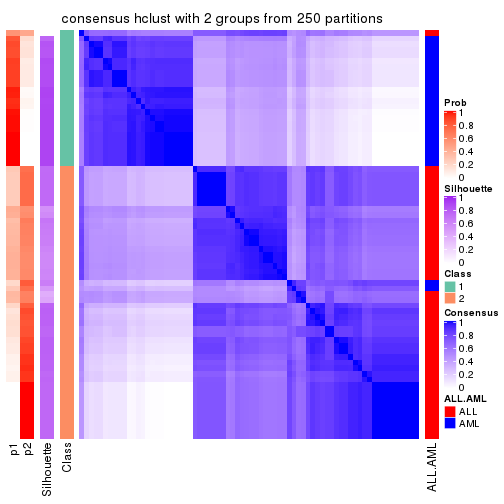
consensus_heatmap(res, k = 3)
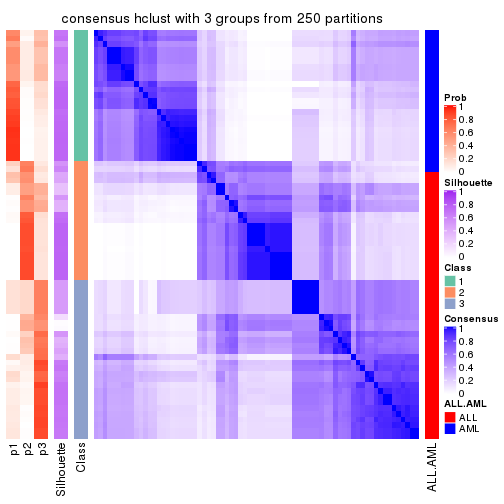
consensus_heatmap(res, k = 4)
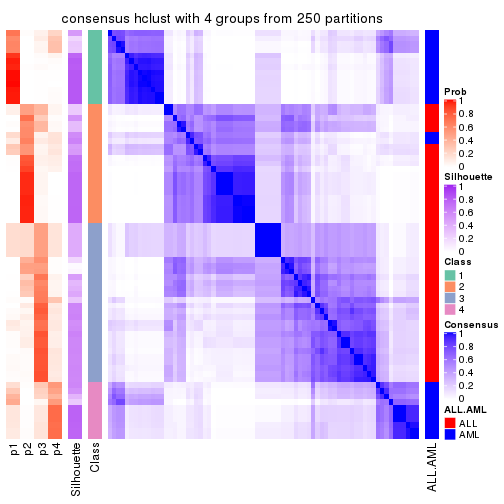
consensus_heatmap(res, k = 5)
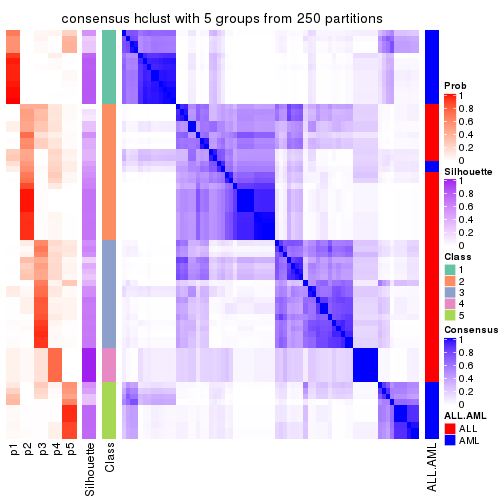
consensus_heatmap(res, k = 6)
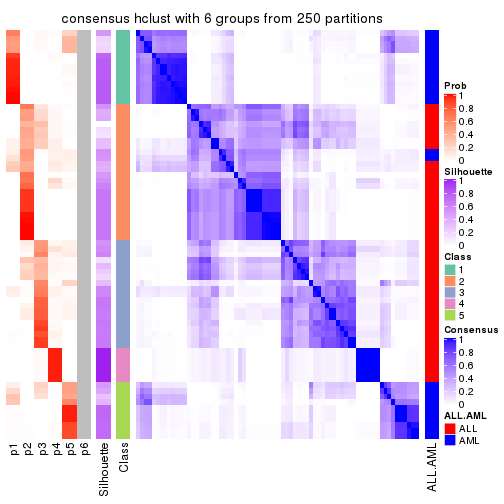
Heatmaps for the membership of samples in all partitions to see how consistent they are:
membership_heatmap(res, k = 2)
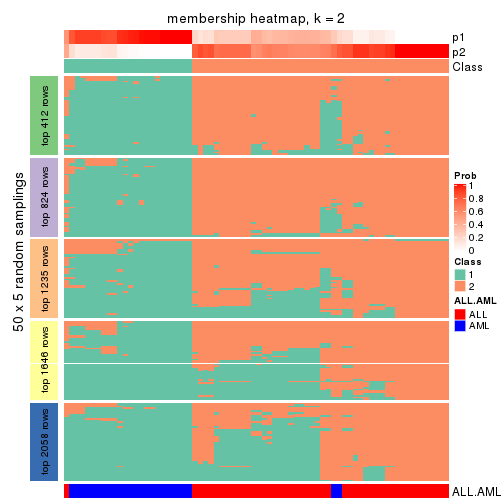
membership_heatmap(res, k = 3)
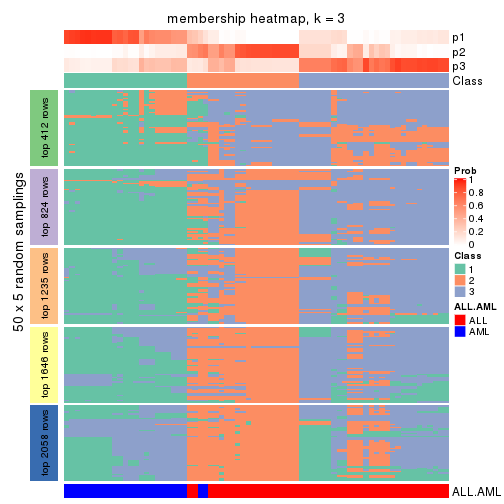
membership_heatmap(res, k = 4)
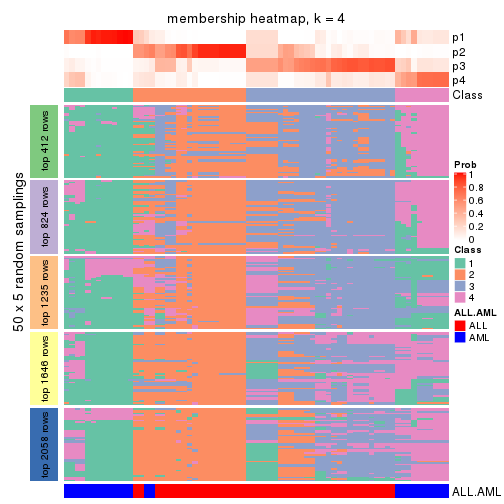
membership_heatmap(res, k = 5)
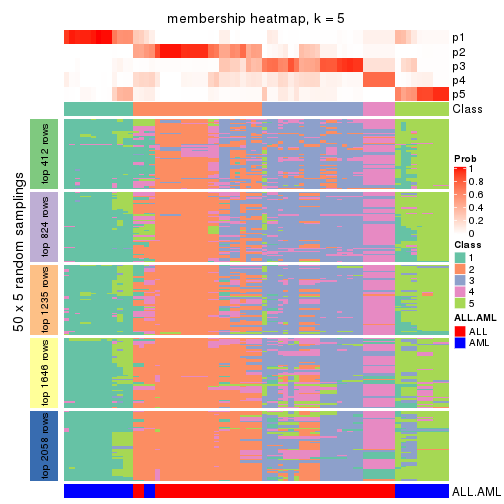
membership_heatmap(res, k = 6)
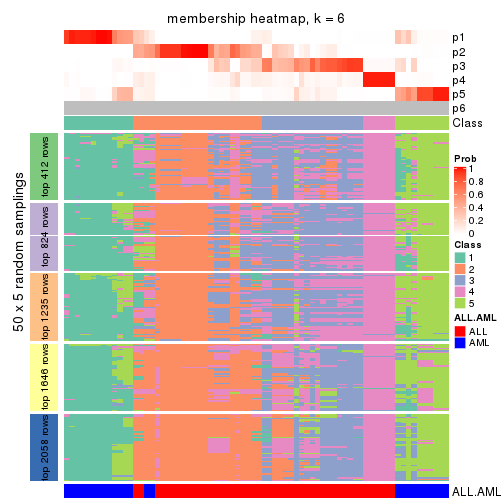
As soon as we have had the classes for columns, we can look for signatures which are significantly different between classes which can be candidate marks for certain classes. Following are the heatmaps for signatures.
Signature heatmaps where rows are scaled:
get_signatures(res, k = 2)
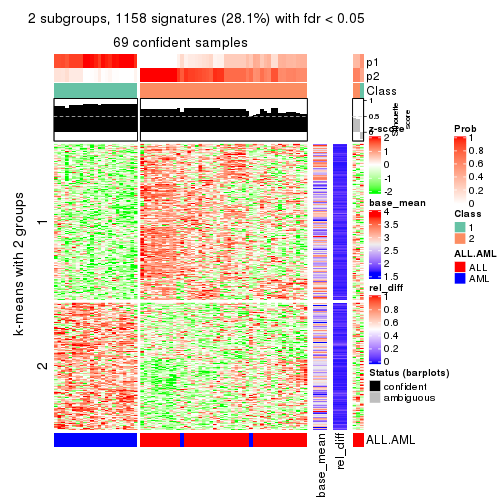
get_signatures(res, k = 3)
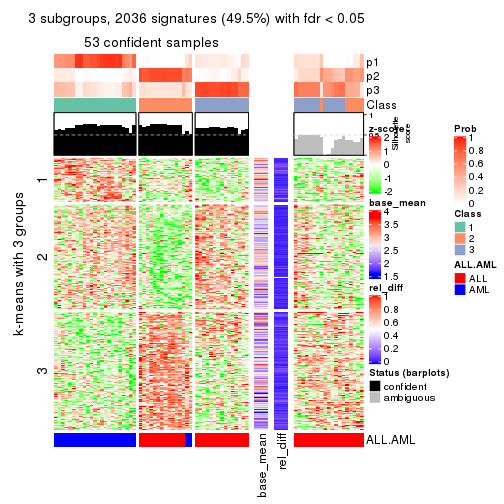
get_signatures(res, k = 4)
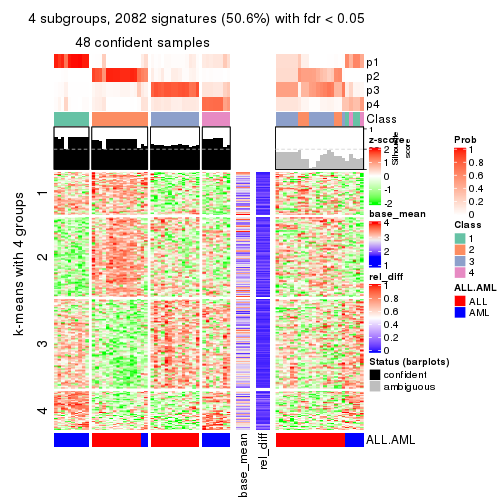
get_signatures(res, k = 5)
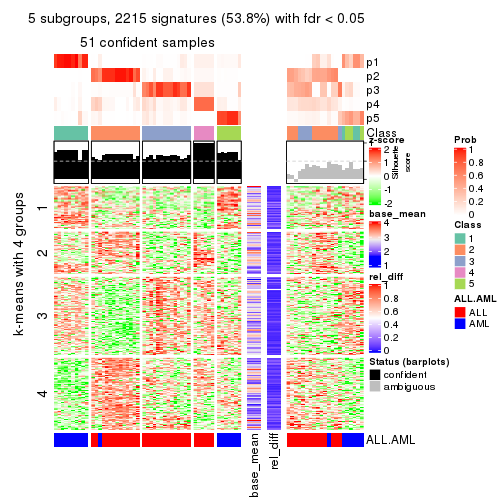
get_signatures(res, k = 6)
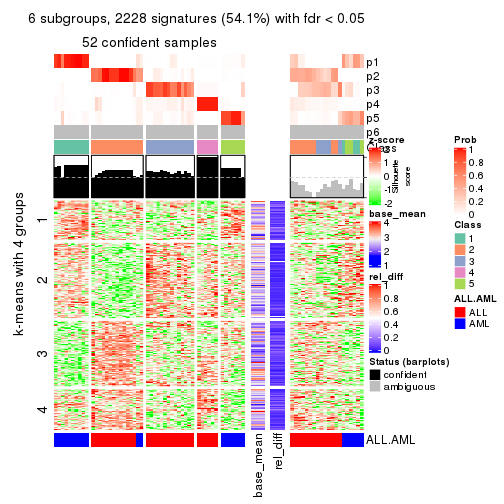
Signature heatmaps where rows are not scaled:
get_signatures(res, k = 2, scale_rows = FALSE)
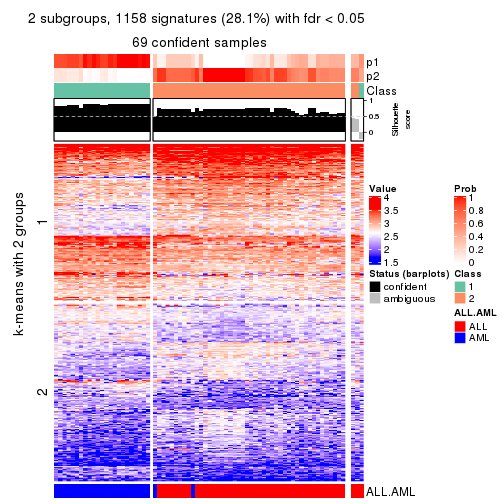
get_signatures(res, k = 3, scale_rows = FALSE)
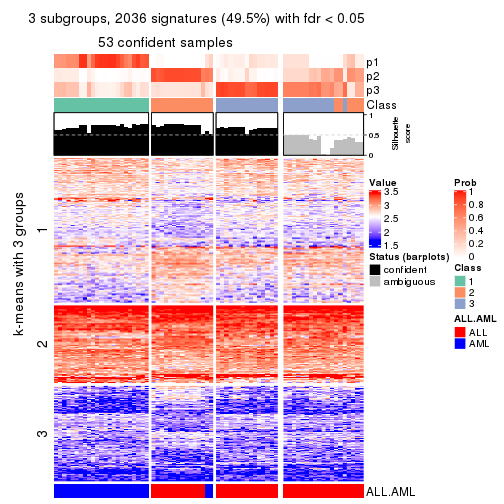
get_signatures(res, k = 4, scale_rows = FALSE)
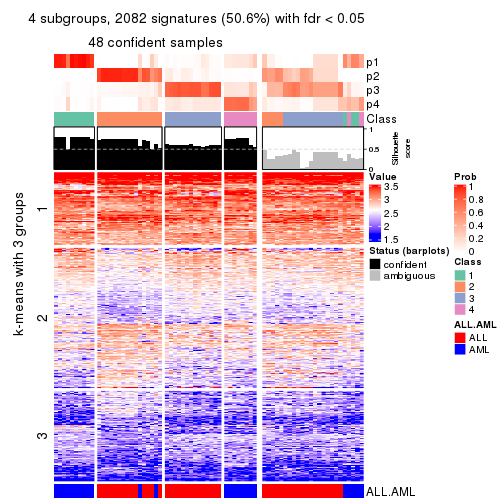
get_signatures(res, k = 5, scale_rows = FALSE)
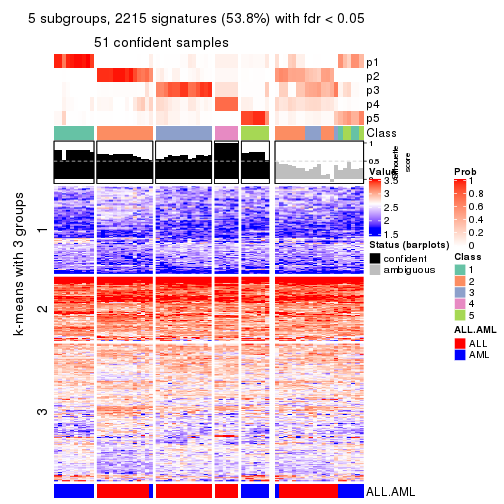
get_signatures(res, k = 6, scale_rows = FALSE)
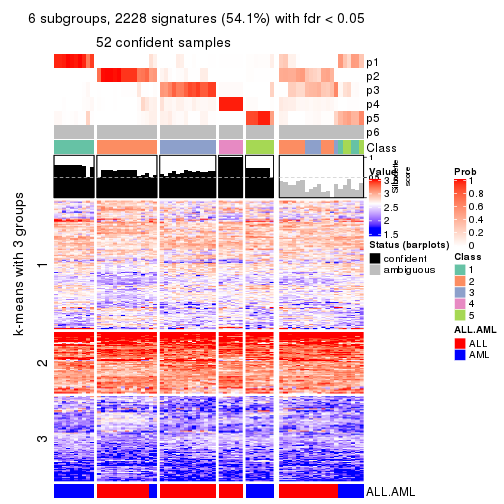
Compare the overlap of signatures from different k:
compare_signatures(res)
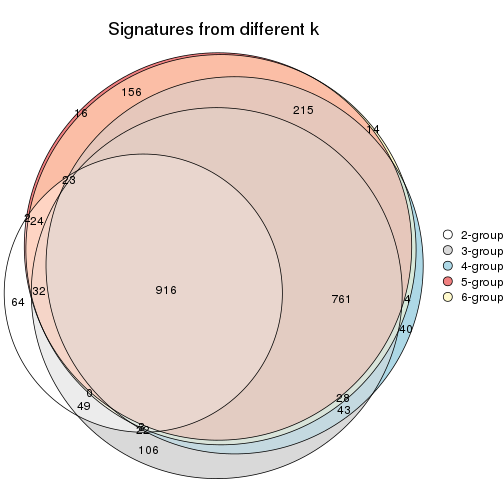
get_signature() returns a data frame invisibly. TO get the list of signatures, the function
call should be assigned to a variable explicitly. In following code, if plot argument is set
to FALSE, no heatmap is plotted while only the differential analysis is performed.
# code only for demonstration
tb = get_signature(res, k = ..., plot = FALSE)
An example of the output of tb is:
#> which_row fdr mean_1 mean_2 scaled_mean_1 scaled_mean_2 km
#> 1 38 0.042760348 8.373488 9.131774 -0.5533452 0.5164555 1
#> 2 40 0.018707592 7.106213 8.469186 -0.6173731 0.5762149 1
#> 3 55 0.019134737 10.221463 11.207825 -0.6159697 0.5749050 1
#> 4 59 0.006059896 5.921854 7.869574 -0.6899429 0.6439467 1
#> 5 60 0.018055526 8.928898 10.211722 -0.6204761 0.5791110 1
#> 6 98 0.009384629 15.714769 14.887706 0.6635654 -0.6193277 2
...
The columns in tb are:
which_row: row indices corresponding to the input matrix.fdr: FDR for the differential test. mean_x: The mean value in group x.scaled_mean_x: The mean value in group x after rows are scaled.km: Row groups if k-means clustering is applied to rows.UMAP plot which shows how samples are separated.
dimension_reduction(res, k = 2, method = "UMAP")
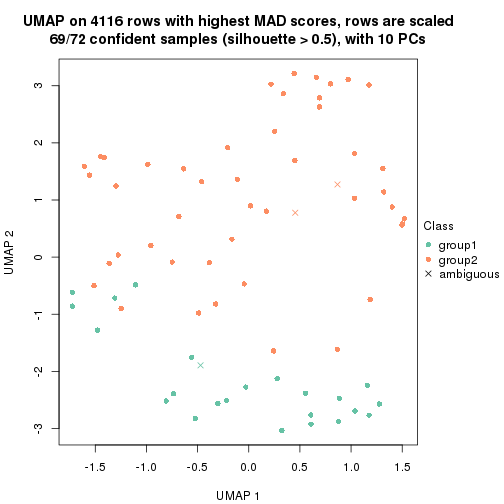
dimension_reduction(res, k = 3, method = "UMAP")
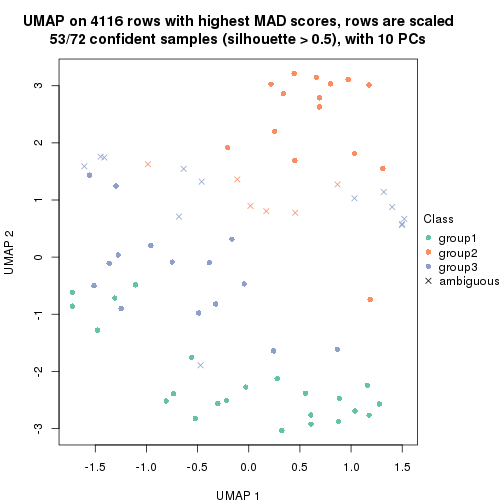
dimension_reduction(res, k = 4, method = "UMAP")
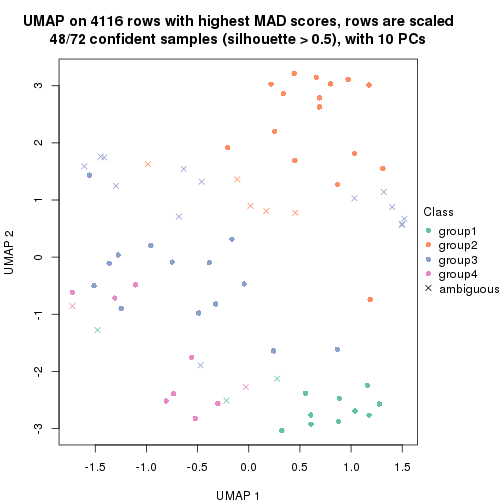
dimension_reduction(res, k = 5, method = "UMAP")
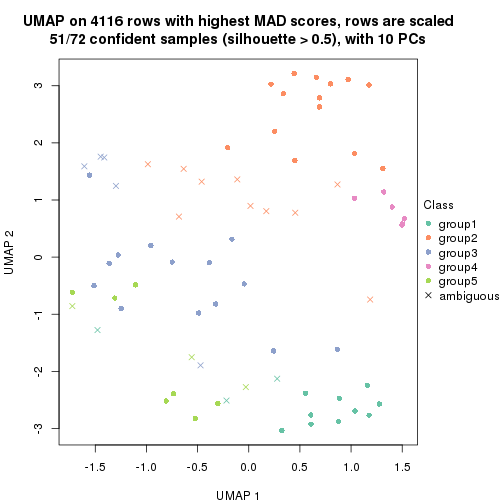
dimension_reduction(res, k = 6, method = "UMAP")
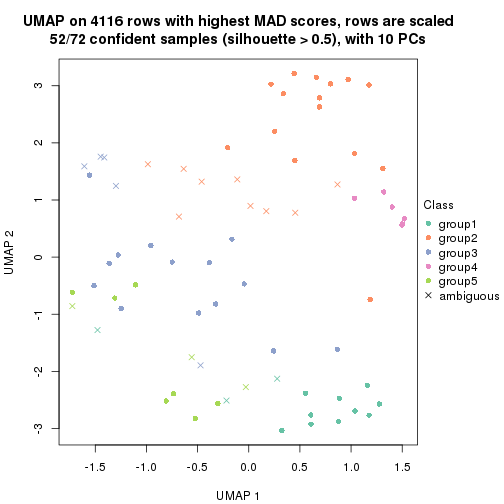
Following heatmap shows how subgroups are split when increasing k:
collect_classes(res)
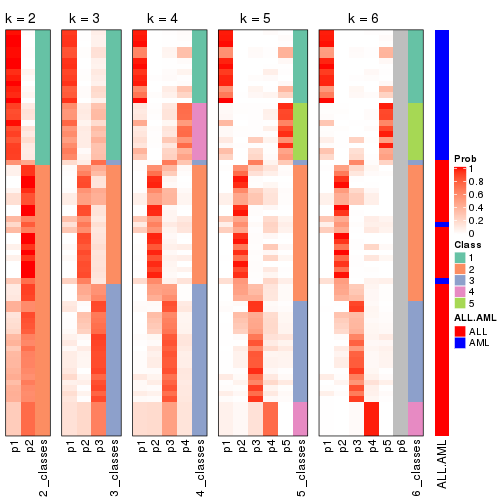
Test correlation between subgroups and known annotations. If the known annotation is numeric, one-way ANOVA test is applied, and if the known annotation is discrete, chi-squared contingency table test is applied.
test_to_known_factors(res)
#> n ALL.AML(p) k
#> MAD:hclust 69 5.21e-14 2
#> MAD:hclust 53 1.00e-10 3
#> MAD:hclust 48 7.21e-09 4
#> MAD:hclust 51 1.57e-09 5
#> MAD:hclust 52 4.99e-09 6
If matrix rows can be associated to genes, consider to use functional_enrichment(res,
...) to perform function enrichment for the signature genes. See this vignette for more detailed explanations.
The object with results only for a single top-value method and a single partition method can be extracted as:
res = res_list["MAD", "kmeans"]
# you can also extract it by
# res = res_list["MAD:kmeans"]
A summary of res and all the functions that can be applied to it:
res
#> A 'ConsensusPartition' object with k = 2, 3, 4, 5, 6.
#> On a matrix with 4116 rows and 72 columns.
#> Top rows (412, 824, 1235, 1646, 2058) are extracted by 'MAD' method.
#> Subgroups are detected by 'kmeans' method.
#> Performed in total 1250 partitions by row resampling.
#> Best k for subgroups seems to be 2.
#>
#> Following methods can be applied to this 'ConsensusPartition' object:
#> [1] "cola_report" "collect_classes" "collect_plots"
#> [4] "collect_stats" "colnames" "compare_signatures"
#> [7] "consensus_heatmap" "dimension_reduction" "functional_enrichment"
#> [10] "get_anno_col" "get_anno" "get_classes"
#> [13] "get_consensus" "get_matrix" "get_membership"
#> [16] "get_param" "get_signatures" "get_stats"
#> [19] "is_best_k" "is_stable_k" "membership_heatmap"
#> [22] "ncol" "nrow" "plot_ecdf"
#> [25] "rownames" "select_partition_number" "show"
#> [28] "suggest_best_k" "test_to_known_factors"
collect_plots() function collects all the plots made from res for all k (number of partitions)
into one single page to provide an easy and fast comparison between different k.
collect_plots(res)
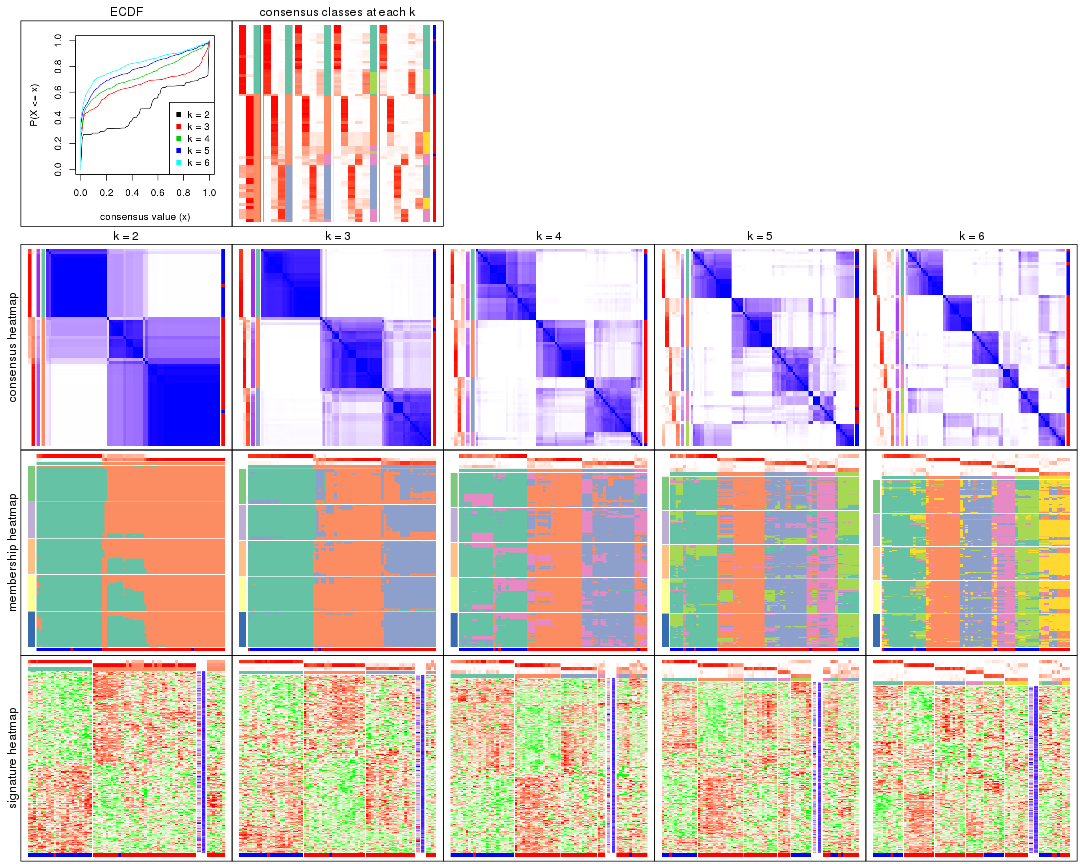
The plots are:
k and the heatmap of
predicted classes for each k.k.k.k.All the plots in panels can be made by individual functions and they are plotted later in this section.
select_partition_number() produces several plots showing different
statistics for choosing “optimized” k. There are following statistics:
k;k, the area increased is defined as \(A_k - A_{k-1}\).The detailed explanations of these statistics can be found in the cola vignette.
Generally speaking, lower PAC score, higher mean silhouette score or higher
concordance corresponds to better partition. Rand index and Jaccard index
measure how similar the current partition is compared to partition with k-1.
If they are too similar, we won't accept k is better than k-1.
select_partition_number(res)
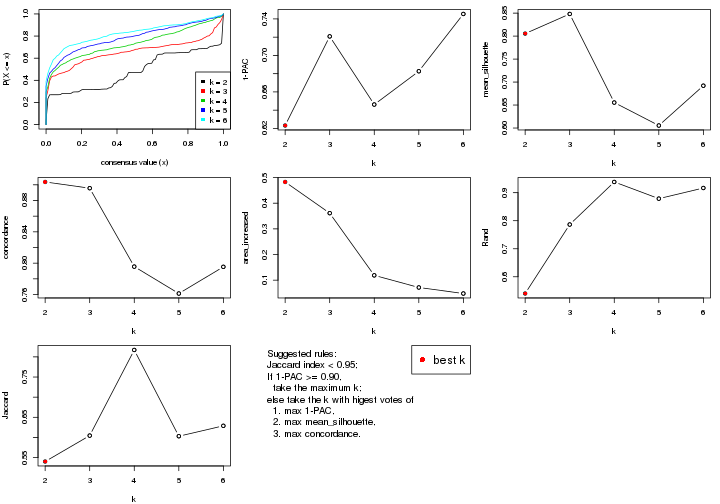
The numeric values for all these statistics can be obtained by get_stats().
get_stats(res)
#> k 1-PAC mean_silhouette concordance area_increased Rand Jaccard
#> 2 2 0.623 0.805 0.904 0.4828 0.540 0.540
#> 3 3 0.721 0.848 0.896 0.3612 0.786 0.605
#> 4 4 0.646 0.655 0.796 0.1188 0.938 0.817
#> 5 5 0.683 0.605 0.761 0.0716 0.879 0.603
#> 6 6 0.745 0.692 0.795 0.0480 0.917 0.629
suggest_best_k() suggests the best \(k\) based on these statistics. The rules are as follows:
suggest_best_k(res)
#> [1] 2
Following shows the table of the partitions (You need to click the show/hide
code output link to see it). The membership matrix (columns with name p*)
is inferred by
clue::cl_consensus()
function with the SE method. Basically the value in the membership matrix
represents the probability to belong to a certain group. The finall class
label for an item is determined with the group with highest probability it
belongs to.
In get_classes() function, the entropy is calculated from the membership
matrix and the silhouette score is calculated from the consensus matrix.
cbind(get_classes(res, k = 2), get_membership(res, k = 2))
#> class entropy silhouette p1 p2
#> sample_39 2 0.9866 0.452 0.432 0.568
#> sample_40 2 0.9922 0.421 0.448 0.552
#> sample_42 2 0.0000 0.840 0.000 1.000
#> sample_47 2 0.0000 0.840 0.000 1.000
#> sample_48 2 0.0000 0.840 0.000 1.000
#> sample_49 2 0.9933 0.412 0.452 0.548
#> sample_41 2 0.0000 0.840 0.000 1.000
#> sample_43 2 0.0000 0.840 0.000 1.000
#> sample_44 2 0.0000 0.840 0.000 1.000
#> sample_45 2 0.0000 0.840 0.000 1.000
#> sample_46 2 0.0000 0.840 0.000 1.000
#> sample_70 2 0.1184 0.834 0.016 0.984
#> sample_71 2 0.0000 0.840 0.000 1.000
#> sample_72 2 0.0000 0.840 0.000 1.000
#> sample_68 2 0.0000 0.840 0.000 1.000
#> sample_69 2 0.0000 0.840 0.000 1.000
#> sample_67 2 0.9896 0.176 0.440 0.560
#> sample_55 2 0.9686 0.515 0.396 0.604
#> sample_56 2 0.9732 0.502 0.404 0.596
#> sample_59 2 0.0376 0.839 0.004 0.996
#> sample_52 1 0.0376 0.988 0.996 0.004
#> sample_53 1 0.0376 0.988 0.996 0.004
#> sample_51 1 0.0376 0.988 0.996 0.004
#> sample_50 1 0.0376 0.988 0.996 0.004
#> sample_54 1 0.6048 0.806 0.852 0.148
#> sample_57 1 0.0376 0.988 0.996 0.004
#> sample_58 1 0.0376 0.988 0.996 0.004
#> sample_60 1 0.0938 0.980 0.988 0.012
#> sample_61 1 0.0376 0.988 0.996 0.004
#> sample_65 1 0.0376 0.988 0.996 0.004
#> sample_66 2 0.0000 0.840 0.000 1.000
#> sample_63 1 0.0376 0.988 0.996 0.004
#> sample_64 1 0.0376 0.988 0.996 0.004
#> sample_62 1 0.0376 0.988 0.996 0.004
#> sample_1 2 0.0672 0.838 0.008 0.992
#> sample_2 2 0.6887 0.676 0.184 0.816
#> sample_3 2 0.9552 0.549 0.376 0.624
#> sample_4 2 0.0672 0.838 0.008 0.992
#> sample_5 2 0.0000 0.840 0.000 1.000
#> sample_6 2 0.9580 0.544 0.380 0.620
#> sample_7 2 0.9686 0.515 0.396 0.604
#> sample_8 2 0.9933 0.412 0.452 0.548
#> sample_9 2 0.0376 0.838 0.004 0.996
#> sample_10 2 0.9580 0.544 0.380 0.620
#> sample_11 2 0.0376 0.838 0.004 0.996
#> sample_12 1 0.0376 0.988 0.996 0.004
#> sample_13 2 0.0000 0.840 0.000 1.000
#> sample_14 2 0.0376 0.838 0.004 0.996
#> sample_15 2 0.0000 0.840 0.000 1.000
#> sample_16 2 0.0000 0.840 0.000 1.000
#> sample_17 2 0.0000 0.840 0.000 1.000
#> sample_18 2 0.6973 0.727 0.188 0.812
#> sample_19 2 0.0000 0.840 0.000 1.000
#> sample_20 2 0.0000 0.840 0.000 1.000
#> sample_21 2 0.0000 0.840 0.000 1.000
#> sample_22 2 0.9944 0.403 0.456 0.544
#> sample_23 2 0.9580 0.544 0.380 0.620
#> sample_24 2 0.0000 0.840 0.000 1.000
#> sample_25 2 0.9248 0.588 0.340 0.660
#> sample_26 2 0.0000 0.840 0.000 1.000
#> sample_27 2 0.9933 0.412 0.452 0.548
#> sample_34 1 0.0376 0.988 0.996 0.004
#> sample_35 1 0.0376 0.988 0.996 0.004
#> sample_36 1 0.0376 0.988 0.996 0.004
#> sample_37 1 0.0376 0.988 0.996 0.004
#> sample_38 1 0.0376 0.988 0.996 0.004
#> sample_28 1 0.0376 0.988 0.996 0.004
#> sample_29 1 0.4298 0.887 0.912 0.088
#> sample_30 1 0.0376 0.988 0.996 0.004
#> sample_31 1 0.0376 0.988 0.996 0.004
#> sample_32 1 0.0376 0.988 0.996 0.004
#> sample_33 1 0.0376 0.988 0.996 0.004
cbind(get_classes(res, k = 3), get_membership(res, k = 3))
#> class entropy silhouette p1 p2 p3
#> sample_39 3 0.5503 0.852 0.020 0.208 0.772
#> sample_40 3 0.4679 0.879 0.020 0.148 0.832
#> sample_42 2 0.3272 0.816 0.004 0.892 0.104
#> sample_47 2 0.0237 0.872 0.000 0.996 0.004
#> sample_48 2 0.0237 0.872 0.000 0.996 0.004
#> sample_49 3 0.4418 0.877 0.020 0.132 0.848
#> sample_41 2 0.0424 0.871 0.000 0.992 0.008
#> sample_43 2 0.1964 0.853 0.000 0.944 0.056
#> sample_44 2 0.1964 0.853 0.000 0.944 0.056
#> sample_45 2 0.1289 0.866 0.000 0.968 0.032
#> sample_46 2 0.1964 0.853 0.000 0.944 0.056
#> sample_70 3 0.4796 0.847 0.000 0.220 0.780
#> sample_71 2 0.4233 0.752 0.004 0.836 0.160
#> sample_72 2 0.4233 0.752 0.004 0.836 0.160
#> sample_68 2 0.0237 0.872 0.000 0.996 0.004
#> sample_69 2 0.0237 0.872 0.000 0.996 0.004
#> sample_67 2 0.7072 0.132 0.476 0.504 0.020
#> sample_55 3 0.4068 0.874 0.016 0.120 0.864
#> sample_56 3 0.4602 0.879 0.016 0.152 0.832
#> sample_59 3 0.5882 0.701 0.000 0.348 0.652
#> sample_52 1 0.1964 0.969 0.944 0.000 0.056
#> sample_53 1 0.0000 0.978 1.000 0.000 0.000
#> sample_51 1 0.0000 0.978 1.000 0.000 0.000
#> sample_50 1 0.0000 0.978 1.000 0.000 0.000
#> sample_54 1 0.2845 0.957 0.920 0.012 0.068
#> sample_57 1 0.2066 0.968 0.940 0.000 0.060
#> sample_58 1 0.2066 0.968 0.940 0.000 0.060
#> sample_60 1 0.2261 0.964 0.932 0.000 0.068
#> sample_61 1 0.0592 0.978 0.988 0.000 0.012
#> sample_65 1 0.0424 0.978 0.992 0.000 0.008
#> sample_66 2 0.4842 0.709 0.000 0.776 0.224
#> sample_63 1 0.1964 0.969 0.944 0.000 0.056
#> sample_64 1 0.2066 0.968 0.940 0.000 0.060
#> sample_62 1 0.1964 0.969 0.944 0.000 0.056
#> sample_1 3 0.5254 0.807 0.000 0.264 0.736
#> sample_2 2 0.7975 0.599 0.160 0.660 0.180
#> sample_3 3 0.2384 0.827 0.008 0.056 0.936
#> sample_4 3 0.4399 0.866 0.000 0.188 0.812
#> sample_5 2 0.0424 0.871 0.000 0.992 0.008
#> sample_6 3 0.2384 0.827 0.008 0.056 0.936
#> sample_7 3 0.4741 0.879 0.020 0.152 0.828
#> sample_8 3 0.4802 0.878 0.020 0.156 0.824
#> sample_9 3 0.6180 0.184 0.000 0.416 0.584
#> sample_10 3 0.2384 0.827 0.008 0.056 0.936
#> sample_11 2 0.6295 0.204 0.000 0.528 0.472
#> sample_12 1 0.2356 0.916 0.928 0.000 0.072
#> sample_13 2 0.0237 0.872 0.000 0.996 0.004
#> sample_14 2 0.5621 0.601 0.000 0.692 0.308
#> sample_15 2 0.0424 0.871 0.000 0.992 0.008
#> sample_16 2 0.1411 0.866 0.000 0.964 0.036
#> sample_17 2 0.2711 0.822 0.000 0.912 0.088
#> sample_18 3 0.3686 0.875 0.000 0.140 0.860
#> sample_19 2 0.1411 0.864 0.000 0.964 0.036
#> sample_20 2 0.0237 0.872 0.000 0.996 0.004
#> sample_21 2 0.0747 0.869 0.000 0.984 0.016
#> sample_22 3 0.4999 0.877 0.028 0.152 0.820
#> sample_23 3 0.2384 0.827 0.008 0.056 0.936
#> sample_24 2 0.0424 0.871 0.000 0.992 0.008
#> sample_25 3 0.6096 0.783 0.016 0.280 0.704
#> sample_26 3 0.6291 0.412 0.000 0.468 0.532
#> sample_27 3 0.4349 0.876 0.020 0.128 0.852
#> sample_34 1 0.0892 0.977 0.980 0.000 0.020
#> sample_35 1 0.1411 0.975 0.964 0.000 0.036
#> sample_36 1 0.0000 0.978 1.000 0.000 0.000
#> sample_37 1 0.0000 0.978 1.000 0.000 0.000
#> sample_38 1 0.0000 0.978 1.000 0.000 0.000
#> sample_28 1 0.0000 0.978 1.000 0.000 0.000
#> sample_29 1 0.0237 0.976 0.996 0.000 0.004
#> sample_30 1 0.0000 0.978 1.000 0.000 0.000
#> sample_31 1 0.1289 0.975 0.968 0.000 0.032
#> sample_32 1 0.0000 0.978 1.000 0.000 0.000
#> sample_33 1 0.0000 0.978 1.000 0.000 0.000
cbind(get_classes(res, k = 4), get_membership(res, k = 4))
#> class entropy silhouette p1 p2 p3 p4
#> sample_39 3 0.3634 0.7118 0.000 0.048 0.856 0.096
#> sample_40 3 0.1733 0.7422 0.000 0.028 0.948 0.024
#> sample_42 2 0.7708 0.2996 0.012 0.512 0.188 0.288
#> sample_47 2 0.2197 0.7574 0.000 0.916 0.004 0.080
#> sample_48 2 0.0000 0.7804 0.000 1.000 0.000 0.000
#> sample_49 3 0.1624 0.7407 0.000 0.020 0.952 0.028
#> sample_41 2 0.0524 0.7773 0.000 0.988 0.004 0.008
#> sample_43 2 0.5332 0.6580 0.000 0.748 0.124 0.128
#> sample_44 2 0.5531 0.6432 0.000 0.732 0.140 0.128
#> sample_45 2 0.4992 0.6835 0.000 0.772 0.096 0.132
#> sample_46 2 0.5160 0.6735 0.000 0.760 0.104 0.136
#> sample_70 3 0.4685 0.6448 0.000 0.060 0.784 0.156
#> sample_71 2 0.8098 0.1639 0.016 0.460 0.236 0.288
#> sample_72 2 0.7997 0.1730 0.012 0.464 0.236 0.288
#> sample_68 2 0.0524 0.7773 0.000 0.988 0.004 0.008
#> sample_69 2 0.0188 0.7797 0.000 0.996 0.004 0.000
#> sample_67 1 0.7776 -0.0255 0.496 0.252 0.008 0.244
#> sample_55 3 0.2124 0.7268 0.000 0.008 0.924 0.068
#> sample_56 3 0.2032 0.7412 0.000 0.028 0.936 0.036
#> sample_59 3 0.6352 0.5046 0.000 0.188 0.656 0.156
#> sample_52 1 0.4800 0.7678 0.656 0.000 0.004 0.340
#> sample_53 1 0.0336 0.8052 0.992 0.000 0.000 0.008
#> sample_51 1 0.0000 0.8076 1.000 0.000 0.000 0.000
#> sample_50 1 0.0000 0.8076 1.000 0.000 0.000 0.000
#> sample_54 1 0.5989 0.7066 0.556 0.000 0.044 0.400
#> sample_57 1 0.5793 0.7404 0.600 0.000 0.040 0.360
#> sample_58 1 0.5527 0.7508 0.616 0.000 0.028 0.356
#> sample_60 1 0.5989 0.7066 0.556 0.000 0.044 0.400
#> sample_61 1 0.4290 0.8076 0.800 0.000 0.036 0.164
#> sample_65 1 0.3257 0.8122 0.844 0.000 0.004 0.152
#> sample_66 4 0.6748 0.3239 0.000 0.432 0.092 0.476
#> sample_63 1 0.4936 0.7664 0.652 0.000 0.008 0.340
#> sample_64 1 0.5762 0.7455 0.608 0.000 0.040 0.352
#> sample_62 1 0.4955 0.7652 0.648 0.000 0.008 0.344
#> sample_1 3 0.2924 0.7152 0.000 0.100 0.884 0.016
#> sample_2 4 0.8069 0.5248 0.156 0.272 0.044 0.528
#> sample_3 3 0.4855 0.2915 0.000 0.004 0.644 0.352
#> sample_4 3 0.3464 0.6920 0.000 0.108 0.860 0.032
#> sample_5 2 0.0524 0.7773 0.000 0.988 0.004 0.008
#> sample_6 3 0.4855 0.2915 0.000 0.004 0.644 0.352
#> sample_7 3 0.2722 0.7168 0.000 0.064 0.904 0.032
#> sample_8 3 0.1629 0.7412 0.000 0.024 0.952 0.024
#> sample_9 4 0.7151 0.3347 0.000 0.132 0.420 0.448
#> sample_10 3 0.5155 -0.0285 0.000 0.004 0.528 0.468
#> sample_11 4 0.7596 0.5538 0.004 0.192 0.316 0.488
#> sample_12 1 0.4297 0.7018 0.820 0.000 0.096 0.084
#> sample_13 2 0.0000 0.7804 0.000 1.000 0.000 0.000
#> sample_14 4 0.7495 0.6037 0.000 0.368 0.184 0.448
#> sample_15 2 0.0524 0.7773 0.000 0.988 0.004 0.008
#> sample_16 2 0.1733 0.7722 0.000 0.948 0.028 0.024
#> sample_17 2 0.3547 0.6252 0.000 0.840 0.016 0.144
#> sample_18 3 0.2376 0.7349 0.000 0.016 0.916 0.068
#> sample_19 2 0.4827 0.6909 0.000 0.784 0.092 0.124
#> sample_20 2 0.0000 0.7804 0.000 1.000 0.000 0.000
#> sample_21 2 0.0657 0.7756 0.000 0.984 0.004 0.012
#> sample_22 3 0.3421 0.7040 0.016 0.020 0.876 0.088
#> sample_23 3 0.4855 0.2915 0.000 0.004 0.644 0.352
#> sample_24 2 0.0524 0.7773 0.000 0.988 0.004 0.008
#> sample_25 3 0.6664 0.4887 0.016 0.120 0.656 0.208
#> sample_26 3 0.6855 0.3011 0.000 0.276 0.580 0.144
#> sample_27 3 0.1624 0.7407 0.000 0.020 0.952 0.028
#> sample_34 1 0.3726 0.8067 0.788 0.000 0.000 0.212
#> sample_35 1 0.5386 0.7859 0.708 0.000 0.056 0.236
#> sample_36 1 0.0000 0.8076 1.000 0.000 0.000 0.000
#> sample_37 1 0.0336 0.8052 0.992 0.000 0.000 0.008
#> sample_38 1 0.1661 0.7815 0.944 0.000 0.004 0.052
#> sample_28 1 0.1743 0.7790 0.940 0.000 0.004 0.056
#> sample_29 1 0.1867 0.7698 0.928 0.000 0.000 0.072
#> sample_30 1 0.0000 0.8076 1.000 0.000 0.000 0.000
#> sample_31 1 0.3831 0.8069 0.792 0.000 0.004 0.204
#> sample_32 1 0.1302 0.8116 0.956 0.000 0.000 0.044
#> sample_33 1 0.0336 0.8052 0.992 0.000 0.000 0.008
cbind(get_classes(res, k = 5), get_membership(res, k = 5))
#> class entropy silhouette p1 p2 p3 p4 p5
#> sample_39 3 0.3866 0.7092 0.000 0.008 0.820 0.076 0.096
#> sample_40 3 0.1605 0.7528 0.000 0.004 0.944 0.012 0.040
#> sample_42 5 0.8502 -0.4126 0.000 0.216 0.192 0.288 0.304
#> sample_47 2 0.4107 0.7273 0.000 0.808 0.032 0.036 0.124
#> sample_48 2 0.0486 0.8050 0.000 0.988 0.004 0.004 0.004
#> sample_49 3 0.1461 0.7545 0.000 0.004 0.952 0.016 0.028
#> sample_41 2 0.0671 0.8008 0.000 0.980 0.004 0.016 0.000
#> sample_43 2 0.7192 0.5308 0.000 0.552 0.128 0.104 0.216
#> sample_44 2 0.7242 0.5249 0.000 0.552 0.148 0.104 0.196
#> sample_45 2 0.6991 0.5591 0.000 0.580 0.120 0.104 0.196
#> sample_46 2 0.7030 0.5545 0.000 0.576 0.124 0.104 0.196
#> sample_70 3 0.5805 0.5752 0.000 0.016 0.652 0.132 0.200
#> sample_71 4 0.8438 0.1047 0.000 0.184 0.224 0.348 0.244
#> sample_72 4 0.8454 0.1017 0.000 0.188 0.224 0.344 0.244
#> sample_68 2 0.0671 0.8008 0.000 0.980 0.004 0.016 0.000
#> sample_69 2 0.0613 0.8043 0.000 0.984 0.008 0.004 0.004
#> sample_67 1 0.7586 0.0751 0.444 0.064 0.008 0.340 0.144
#> sample_55 3 0.3122 0.7124 0.000 0.004 0.852 0.024 0.120
#> sample_56 3 0.1618 0.7582 0.000 0.008 0.944 0.008 0.040
#> sample_59 3 0.7213 0.4917 0.000 0.112 0.540 0.108 0.240
#> sample_52 5 0.4595 0.6162 0.400 0.000 0.004 0.008 0.588
#> sample_53 1 0.0000 0.7636 1.000 0.000 0.000 0.000 0.000
#> sample_51 1 0.0000 0.7636 1.000 0.000 0.000 0.000 0.000
#> sample_50 1 0.0000 0.7636 1.000 0.000 0.000 0.000 0.000
#> sample_54 5 0.5270 0.6302 0.224 0.000 0.060 0.024 0.692
#> sample_57 5 0.4984 0.6669 0.308 0.000 0.036 0.008 0.648
#> sample_58 5 0.4817 0.6546 0.368 0.000 0.016 0.008 0.608
#> sample_60 5 0.5212 0.6332 0.228 0.000 0.060 0.020 0.692
#> sample_61 1 0.4505 0.5495 0.736 0.000 0.016 0.028 0.220
#> sample_65 1 0.3687 0.5803 0.792 0.000 0.000 0.028 0.180
#> sample_66 4 0.6161 0.4701 0.004 0.168 0.016 0.628 0.184
#> sample_63 5 0.4689 0.6319 0.392 0.000 0.008 0.008 0.592
#> sample_64 5 0.5425 0.6554 0.328 0.000 0.040 0.020 0.612
#> sample_62 5 0.4679 0.6377 0.388 0.000 0.008 0.008 0.596
#> sample_1 3 0.2188 0.7574 0.000 0.024 0.924 0.024 0.028
#> sample_2 4 0.6239 0.5077 0.144 0.052 0.008 0.668 0.128
#> sample_3 4 0.4392 0.4266 0.000 0.008 0.380 0.612 0.000
#> sample_4 3 0.3357 0.6708 0.000 0.136 0.836 0.012 0.016
#> sample_5 2 0.0671 0.8008 0.000 0.980 0.004 0.016 0.000
#> sample_6 4 0.4392 0.4266 0.000 0.008 0.380 0.612 0.000
#> sample_7 3 0.3079 0.6984 0.000 0.092 0.868 0.012 0.028
#> sample_8 3 0.1471 0.7581 0.000 0.004 0.952 0.020 0.024
#> sample_9 4 0.3460 0.6211 0.000 0.044 0.128 0.828 0.000
#> sample_10 4 0.3211 0.6035 0.000 0.008 0.164 0.824 0.004
#> sample_11 4 0.3202 0.6254 0.000 0.056 0.080 0.860 0.004
#> sample_12 1 0.4858 0.6276 0.772 0.000 0.064 0.064 0.100
#> sample_13 2 0.0486 0.8050 0.000 0.988 0.004 0.004 0.004
#> sample_14 4 0.4011 0.6111 0.000 0.124 0.056 0.808 0.012
#> sample_15 2 0.0671 0.8008 0.000 0.980 0.004 0.016 0.000
#> sample_16 2 0.1815 0.7933 0.000 0.940 0.016 0.024 0.020
#> sample_17 2 0.4245 0.5725 0.000 0.744 0.008 0.224 0.024
#> sample_18 3 0.3359 0.7377 0.000 0.004 0.848 0.052 0.096
#> sample_19 2 0.6951 0.5627 0.000 0.584 0.116 0.104 0.196
#> sample_20 2 0.0854 0.8046 0.000 0.976 0.008 0.012 0.004
#> sample_21 2 0.1267 0.7940 0.000 0.960 0.004 0.024 0.012
#> sample_22 3 0.3520 0.7139 0.000 0.004 0.840 0.076 0.080
#> sample_23 4 0.4392 0.4266 0.000 0.008 0.380 0.612 0.000
#> sample_24 2 0.0671 0.8008 0.000 0.980 0.004 0.016 0.000
#> sample_25 3 0.7321 0.3720 0.000 0.060 0.496 0.184 0.260
#> sample_26 3 0.7009 0.4831 0.000 0.092 0.576 0.136 0.196
#> sample_27 3 0.1461 0.7545 0.000 0.004 0.952 0.016 0.028
#> sample_34 1 0.4445 0.3169 0.676 0.000 0.000 0.024 0.300
#> sample_35 1 0.6131 -0.2947 0.488 0.000 0.068 0.024 0.420
#> sample_36 1 0.0324 0.7624 0.992 0.000 0.000 0.004 0.004
#> sample_37 1 0.0000 0.7636 1.000 0.000 0.000 0.000 0.000
#> sample_38 1 0.2189 0.7140 0.904 0.000 0.000 0.012 0.084
#> sample_28 1 0.2110 0.7227 0.912 0.000 0.000 0.016 0.072
#> sample_29 1 0.2694 0.6955 0.884 0.000 0.000 0.040 0.076
#> sample_30 1 0.0324 0.7624 0.992 0.000 0.000 0.004 0.004
#> sample_31 1 0.4382 0.3500 0.688 0.000 0.000 0.024 0.288
#> sample_32 1 0.2104 0.7304 0.916 0.000 0.000 0.024 0.060
#> sample_33 1 0.0000 0.7636 1.000 0.000 0.000 0.000 0.000
cbind(get_classes(res, k = 6), get_membership(res, k = 6))
#> class entropy silhouette p1 p2 p3 p4 p5 p6
#> sample_39 3 0.3831 0.554 0.000 0.000 0.712 0.008 0.012 0.268
#> sample_40 3 0.2796 0.849 0.000 0.008 0.884 0.024 0.052 0.032
#> sample_42 6 0.4896 0.608 0.032 0.096 0.040 0.068 0.004 0.760
#> sample_47 2 0.4732 0.187 0.000 0.620 0.016 0.000 0.036 0.328
#> sample_48 2 0.0820 0.905 0.000 0.972 0.000 0.000 0.012 0.016
#> sample_49 3 0.1230 0.876 0.000 0.008 0.956 0.008 0.028 0.000
#> sample_41 2 0.0767 0.908 0.000 0.976 0.000 0.012 0.004 0.008
#> sample_43 6 0.5399 0.600 0.000 0.316 0.044 0.000 0.052 0.588
#> sample_44 6 0.5875 0.608 0.000 0.296 0.100 0.000 0.044 0.560
#> sample_45 6 0.5121 0.602 0.000 0.320 0.040 0.000 0.036 0.604
#> sample_46 6 0.5166 0.606 0.000 0.316 0.044 0.000 0.036 0.604
#> sample_70 6 0.4502 0.459 0.000 0.000 0.364 0.004 0.032 0.600
#> sample_71 6 0.5952 0.547 0.040 0.080 0.068 0.120 0.008 0.684
#> sample_72 6 0.5832 0.561 0.032 0.080 0.072 0.116 0.008 0.692
#> sample_68 2 0.0508 0.910 0.000 0.984 0.000 0.012 0.000 0.004
#> sample_69 2 0.0972 0.903 0.000 0.964 0.000 0.000 0.008 0.028
#> sample_67 1 0.7365 0.124 0.412 0.044 0.012 0.180 0.024 0.328
#> sample_55 3 0.3475 0.818 0.000 0.008 0.828 0.008 0.104 0.052
#> sample_56 3 0.1553 0.876 0.000 0.008 0.944 0.004 0.032 0.012
#> sample_59 6 0.5574 0.477 0.000 0.032 0.296 0.004 0.076 0.592
#> sample_52 5 0.3142 0.826 0.156 0.000 0.004 0.004 0.820 0.016
#> sample_53 1 0.1010 0.761 0.960 0.000 0.000 0.000 0.036 0.004
#> sample_51 1 0.0937 0.761 0.960 0.000 0.000 0.000 0.040 0.000
#> sample_50 1 0.1082 0.761 0.956 0.000 0.000 0.000 0.040 0.004
#> sample_54 5 0.2990 0.799 0.052 0.000 0.020 0.008 0.872 0.048
#> sample_57 5 0.3334 0.819 0.084 0.000 0.020 0.004 0.844 0.048
#> sample_58 5 0.3623 0.824 0.124 0.000 0.008 0.016 0.816 0.036
#> sample_60 5 0.2941 0.802 0.056 0.000 0.020 0.004 0.872 0.048
#> sample_61 1 0.5962 0.432 0.580 0.000 0.020 0.036 0.288 0.076
#> sample_65 1 0.5434 0.480 0.628 0.000 0.004 0.036 0.260 0.072
#> sample_66 4 0.6744 0.103 0.036 0.080 0.004 0.448 0.044 0.388
#> sample_63 5 0.3142 0.826 0.156 0.000 0.004 0.004 0.820 0.016
#> sample_64 5 0.4668 0.782 0.092 0.000 0.024 0.040 0.768 0.076
#> sample_62 5 0.2975 0.830 0.148 0.000 0.004 0.004 0.832 0.012
#> sample_1 3 0.1734 0.859 0.000 0.008 0.932 0.008 0.004 0.048
#> sample_2 4 0.6796 0.340 0.136 0.036 0.008 0.496 0.020 0.304
#> sample_3 4 0.3023 0.693 0.000 0.000 0.232 0.768 0.000 0.000
#> sample_4 3 0.2983 0.833 0.000 0.088 0.864 0.016 0.024 0.008
#> sample_5 2 0.0508 0.910 0.000 0.984 0.000 0.012 0.000 0.004
#> sample_6 4 0.3023 0.693 0.000 0.000 0.232 0.768 0.000 0.000
#> sample_7 3 0.2622 0.855 0.000 0.056 0.892 0.020 0.024 0.008
#> sample_8 3 0.1346 0.873 0.000 0.000 0.952 0.008 0.024 0.016
#> sample_9 4 0.1895 0.770 0.000 0.016 0.072 0.912 0.000 0.000
#> sample_10 4 0.1663 0.767 0.000 0.000 0.088 0.912 0.000 0.000
#> sample_11 4 0.2001 0.760 0.000 0.020 0.044 0.920 0.000 0.016
#> sample_12 1 0.5416 0.586 0.660 0.000 0.036 0.044 0.028 0.232
#> sample_13 2 0.0820 0.905 0.000 0.972 0.000 0.000 0.012 0.016
#> sample_14 4 0.2458 0.735 0.000 0.068 0.024 0.892 0.016 0.000
#> sample_15 2 0.0508 0.910 0.000 0.984 0.000 0.012 0.000 0.004
#> sample_16 2 0.2216 0.841 0.000 0.908 0.024 0.000 0.016 0.052
#> sample_17 2 0.3307 0.745 0.000 0.812 0.004 0.156 0.024 0.004
#> sample_18 3 0.4145 0.737 0.000 0.008 0.776 0.012 0.068 0.136
#> sample_19 6 0.5235 0.516 0.000 0.384 0.036 0.000 0.036 0.544
#> sample_20 2 0.0806 0.905 0.000 0.972 0.000 0.000 0.008 0.020
#> sample_21 2 0.1059 0.897 0.000 0.964 0.000 0.016 0.004 0.016
#> sample_22 3 0.3590 0.777 0.020 0.000 0.824 0.024 0.016 0.116
#> sample_23 4 0.3023 0.693 0.000 0.000 0.232 0.768 0.000 0.000
#> sample_24 2 0.0767 0.908 0.000 0.976 0.000 0.012 0.004 0.008
#> sample_25 6 0.4897 0.559 0.032 0.012 0.200 0.028 0.012 0.716
#> sample_26 6 0.4777 0.473 0.000 0.016 0.364 0.004 0.024 0.592
#> sample_27 3 0.1230 0.876 0.000 0.008 0.956 0.008 0.028 0.000
#> sample_34 1 0.5984 0.239 0.512 0.000 0.004 0.044 0.360 0.080
#> sample_35 5 0.7145 0.218 0.320 0.000 0.084 0.044 0.464 0.088
#> sample_36 1 0.1434 0.759 0.940 0.000 0.000 0.000 0.048 0.012
#> sample_37 1 0.1082 0.762 0.956 0.000 0.000 0.000 0.040 0.004
#> sample_38 1 0.1429 0.730 0.940 0.000 0.000 0.004 0.004 0.052
#> sample_28 1 0.1931 0.732 0.916 0.000 0.004 0.008 0.004 0.068
#> sample_29 1 0.2969 0.691 0.860 0.000 0.000 0.020 0.032 0.088
#> sample_30 1 0.1434 0.759 0.940 0.000 0.000 0.000 0.048 0.012
#> sample_31 1 0.5601 0.298 0.552 0.000 0.004 0.032 0.348 0.064
#> sample_32 1 0.4499 0.673 0.760 0.000 0.004 0.032 0.108 0.096
#> sample_33 1 0.1082 0.762 0.956 0.000 0.000 0.000 0.040 0.004
Heatmaps for the consensus matrix. It visualizes the probability of two samples to be in a same group.
consensus_heatmap(res, k = 2)
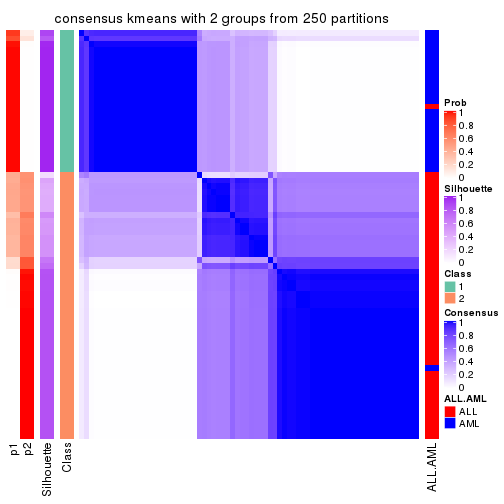
consensus_heatmap(res, k = 3)
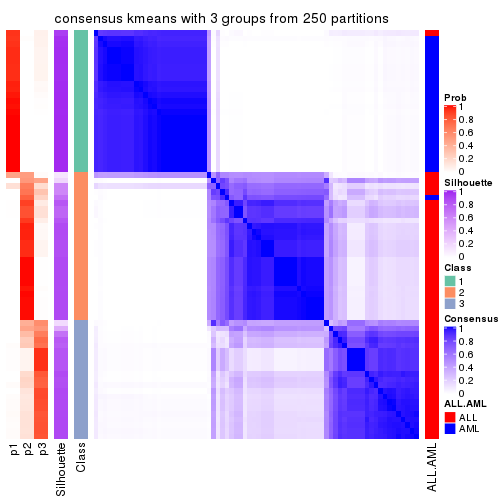
consensus_heatmap(res, k = 4)

consensus_heatmap(res, k = 5)
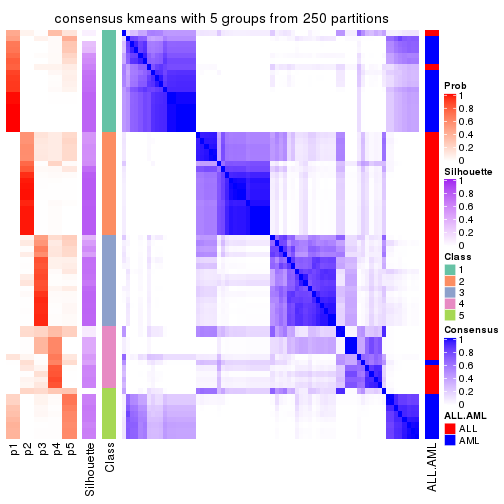
consensus_heatmap(res, k = 6)
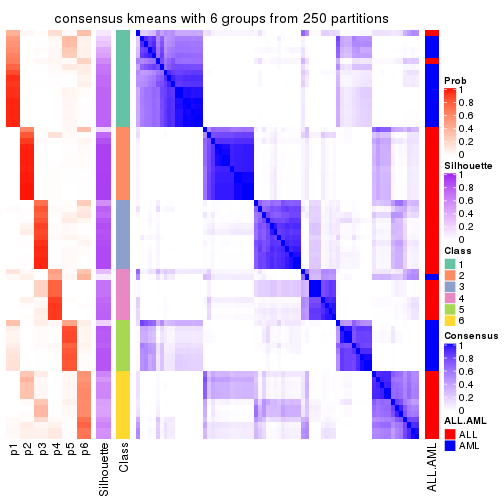
Heatmaps for the membership of samples in all partitions to see how consistent they are:
membership_heatmap(res, k = 2)
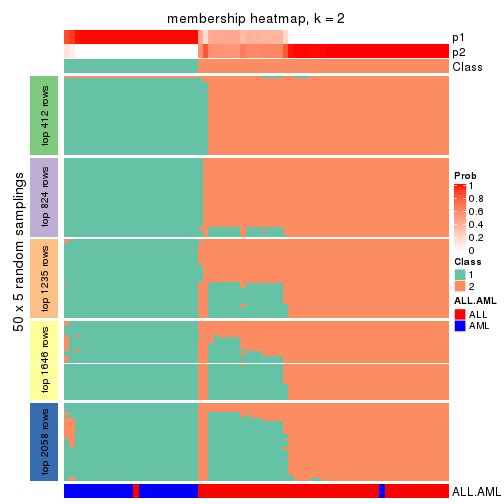
membership_heatmap(res, k = 3)
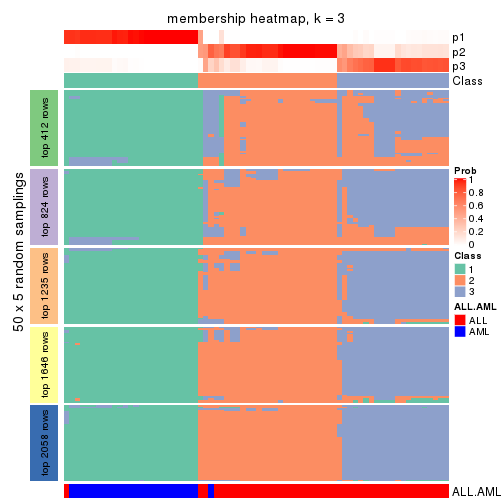
membership_heatmap(res, k = 4)
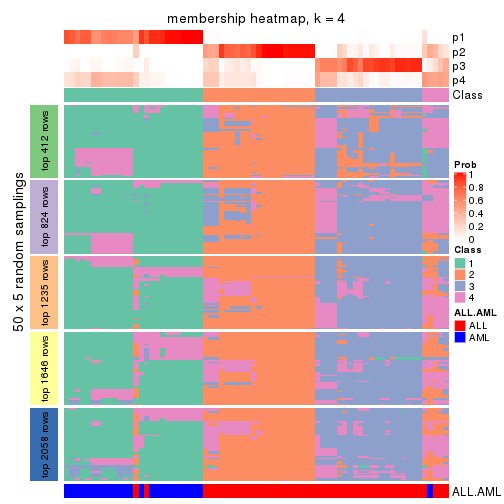
membership_heatmap(res, k = 5)
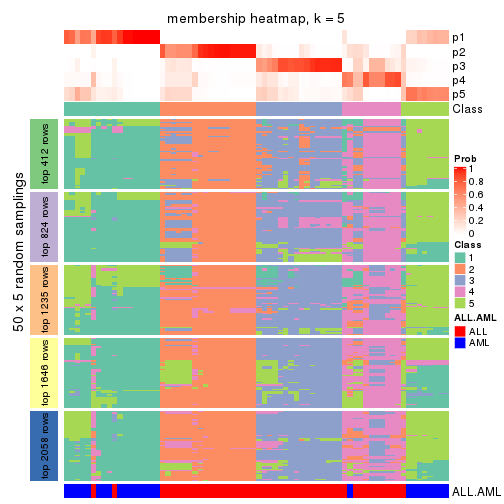
membership_heatmap(res, k = 6)
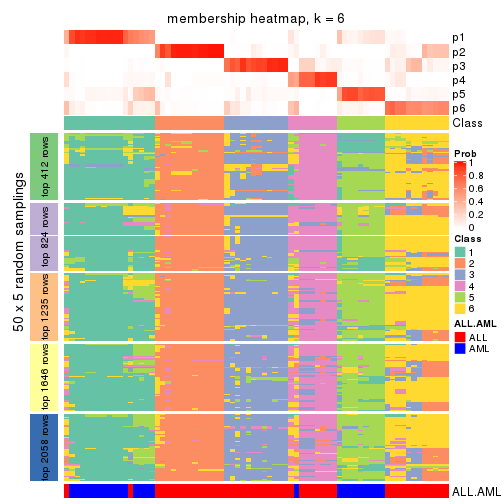
As soon as we have had the classes for columns, we can look for signatures which are significantly different between classes which can be candidate marks for certain classes. Following are the heatmaps for signatures.
Signature heatmaps where rows are scaled:
get_signatures(res, k = 2)
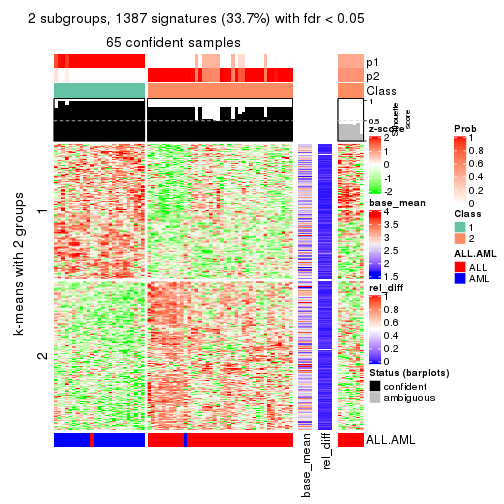
get_signatures(res, k = 3)
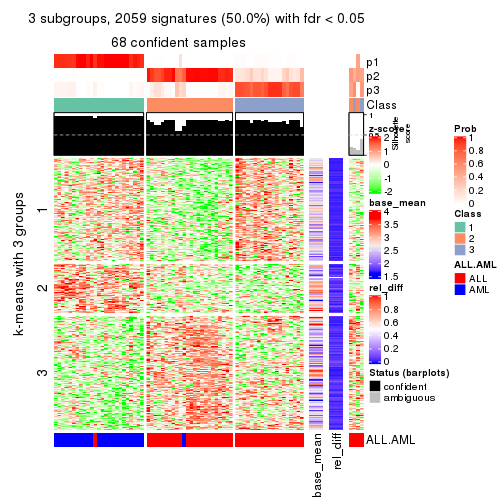
get_signatures(res, k = 4)
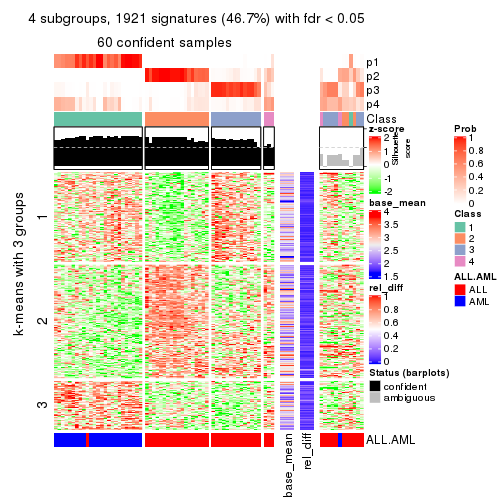
get_signatures(res, k = 5)
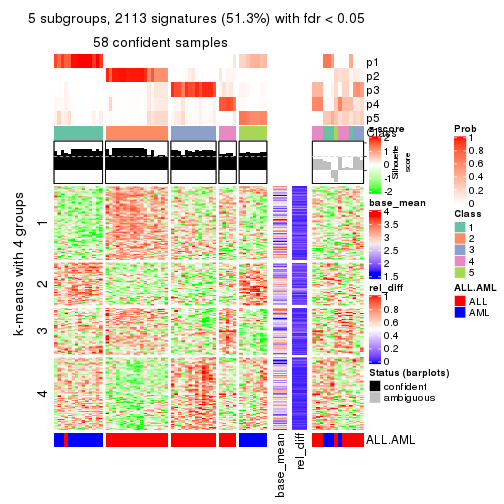
get_signatures(res, k = 6)
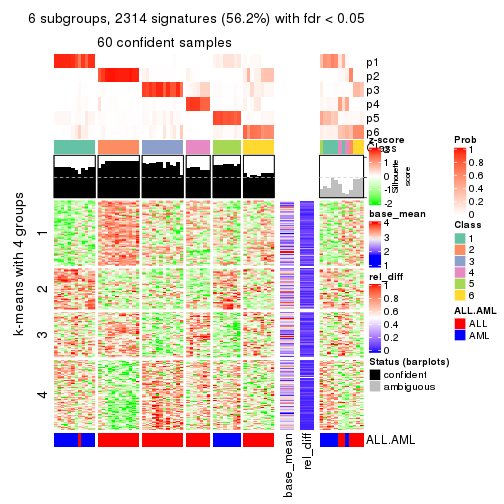
Signature heatmaps where rows are not scaled:
get_signatures(res, k = 2, scale_rows = FALSE)
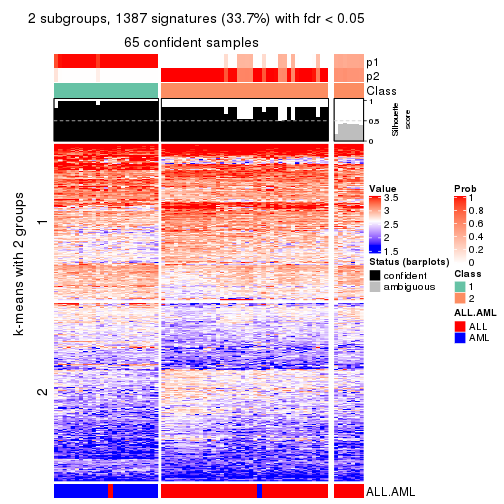
get_signatures(res, k = 3, scale_rows = FALSE)
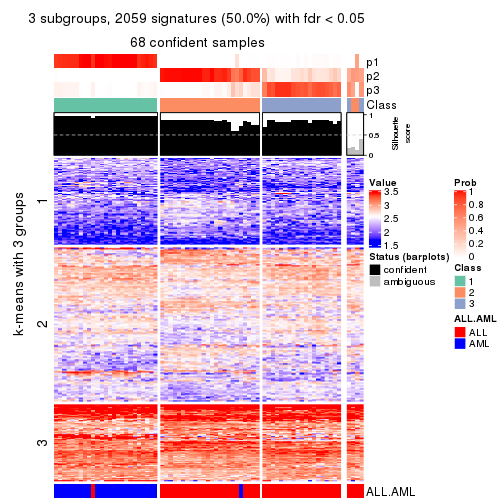
get_signatures(res, k = 4, scale_rows = FALSE)
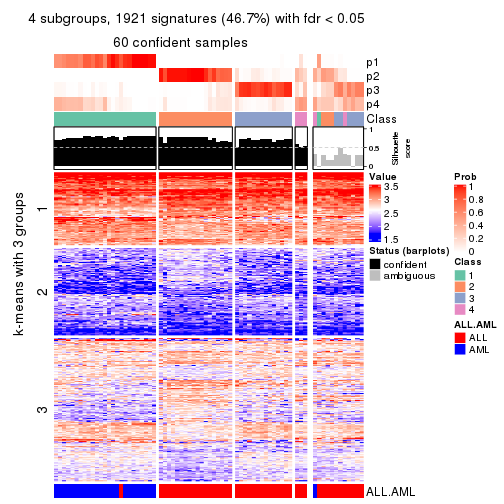
get_signatures(res, k = 5, scale_rows = FALSE)
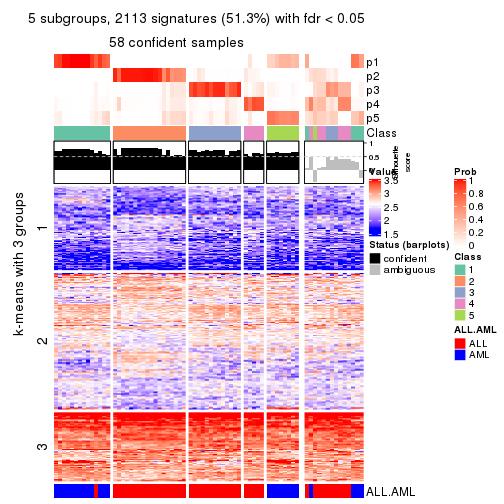
get_signatures(res, k = 6, scale_rows = FALSE)
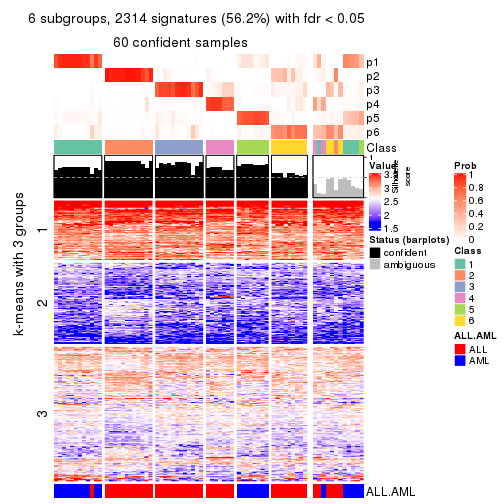
Compare the overlap of signatures from different k:
compare_signatures(res)
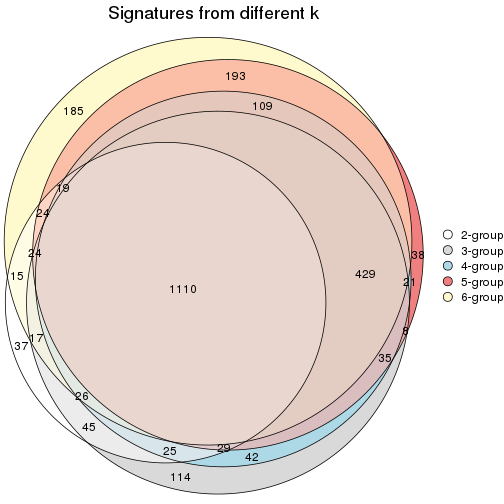
get_signature() returns a data frame invisibly. TO get the list of signatures, the function
call should be assigned to a variable explicitly. In following code, if plot argument is set
to FALSE, no heatmap is plotted while only the differential analysis is performed.
# code only for demonstration
tb = get_signature(res, k = ..., plot = FALSE)
An example of the output of tb is:
#> which_row fdr mean_1 mean_2 scaled_mean_1 scaled_mean_2 km
#> 1 38 0.042760348 8.373488 9.131774 -0.5533452 0.5164555 1
#> 2 40 0.018707592 7.106213 8.469186 -0.6173731 0.5762149 1
#> 3 55 0.019134737 10.221463 11.207825 -0.6159697 0.5749050 1
#> 4 59 0.006059896 5.921854 7.869574 -0.6899429 0.6439467 1
#> 5 60 0.018055526 8.928898 10.211722 -0.6204761 0.5791110 1
#> 6 98 0.009384629 15.714769 14.887706 0.6635654 -0.6193277 2
...
The columns in tb are:
which_row: row indices corresponding to the input matrix.fdr: FDR for the differential test. mean_x: The mean value in group x.scaled_mean_x: The mean value in group x after rows are scaled.km: Row groups if k-means clustering is applied to rows.UMAP plot which shows how samples are separated.
dimension_reduction(res, k = 2, method = "UMAP")
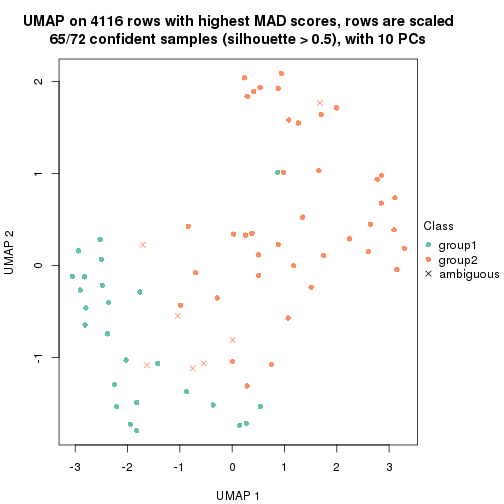
dimension_reduction(res, k = 3, method = "UMAP")
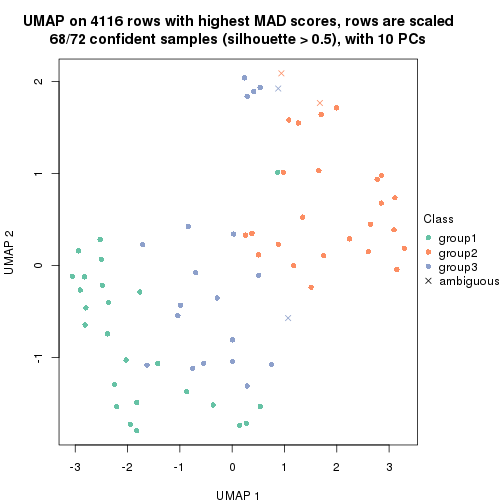
dimension_reduction(res, k = 4, method = "UMAP")
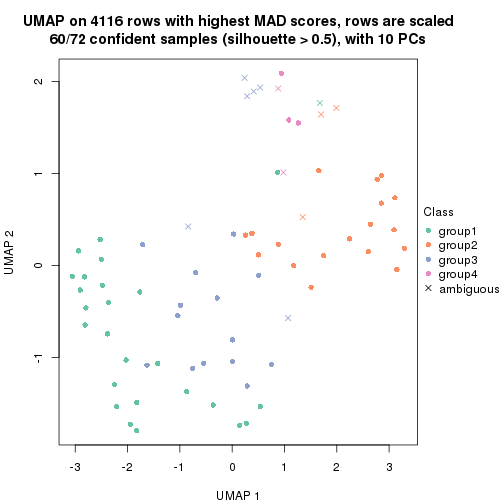
dimension_reduction(res, k = 5, method = "UMAP")
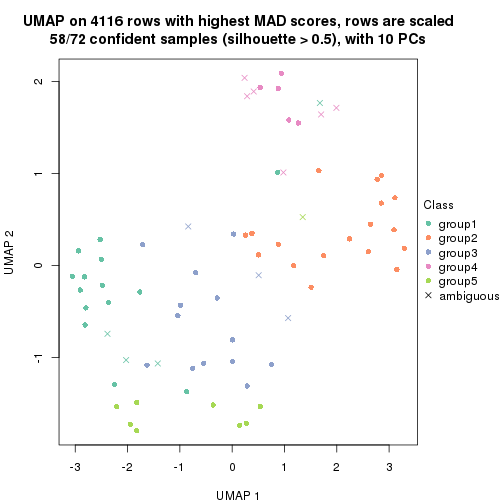
dimension_reduction(res, k = 6, method = "UMAP")
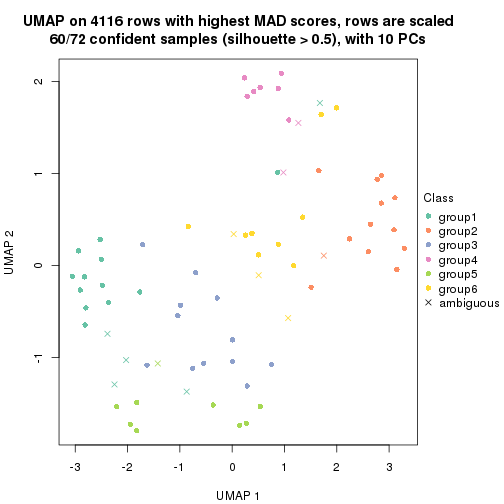
Following heatmap shows how subgroups are split when increasing k:
collect_classes(res)
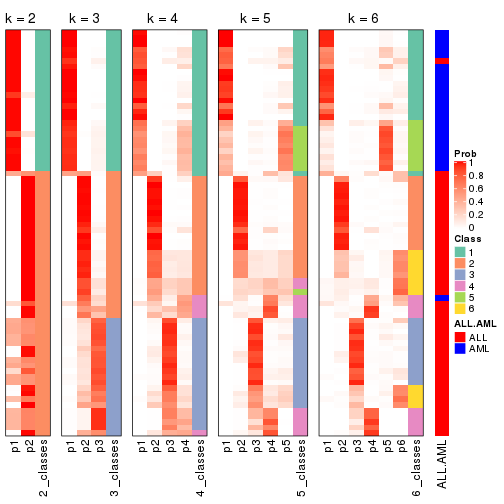
Test correlation between subgroups and known annotations. If the known annotation is numeric, one-way ANOVA test is applied, and if the known annotation is discrete, chi-squared contingency table test is applied.
test_to_known_factors(res)
#> n ALL.AML(p) k
#> MAD:kmeans 65 3.43e-13 2
#> MAD:kmeans 68 1.06e-13 3
#> MAD:kmeans 60 4.20e-12 4
#> MAD:kmeans 58 5.31e-11 5
#> MAD:kmeans 60 9.09e-11 6
If matrix rows can be associated to genes, consider to use functional_enrichment(res,
...) to perform function enrichment for the signature genes. See this vignette for more detailed explanations.
The object with results only for a single top-value method and a single partition method can be extracted as:
res = res_list["MAD", "skmeans"]
# you can also extract it by
# res = res_list["MAD:skmeans"]
A summary of res and all the functions that can be applied to it:
res
#> A 'ConsensusPartition' object with k = 2, 3, 4, 5, 6.
#> On a matrix with 4116 rows and 72 columns.
#> Top rows (412, 824, 1235, 1646, 2058) are extracted by 'MAD' method.
#> Subgroups are detected by 'skmeans' method.
#> Performed in total 1250 partitions by row resampling.
#> Best k for subgroups seems to be 3.
#>
#> Following methods can be applied to this 'ConsensusPartition' object:
#> [1] "cola_report" "collect_classes" "collect_plots"
#> [4] "collect_stats" "colnames" "compare_signatures"
#> [7] "consensus_heatmap" "dimension_reduction" "functional_enrichment"
#> [10] "get_anno_col" "get_anno" "get_classes"
#> [13] "get_consensus" "get_matrix" "get_membership"
#> [16] "get_param" "get_signatures" "get_stats"
#> [19] "is_best_k" "is_stable_k" "membership_heatmap"
#> [22] "ncol" "nrow" "plot_ecdf"
#> [25] "rownames" "select_partition_number" "show"
#> [28] "suggest_best_k" "test_to_known_factors"
collect_plots() function collects all the plots made from res for all k (number of partitions)
into one single page to provide an easy and fast comparison between different k.
collect_plots(res)
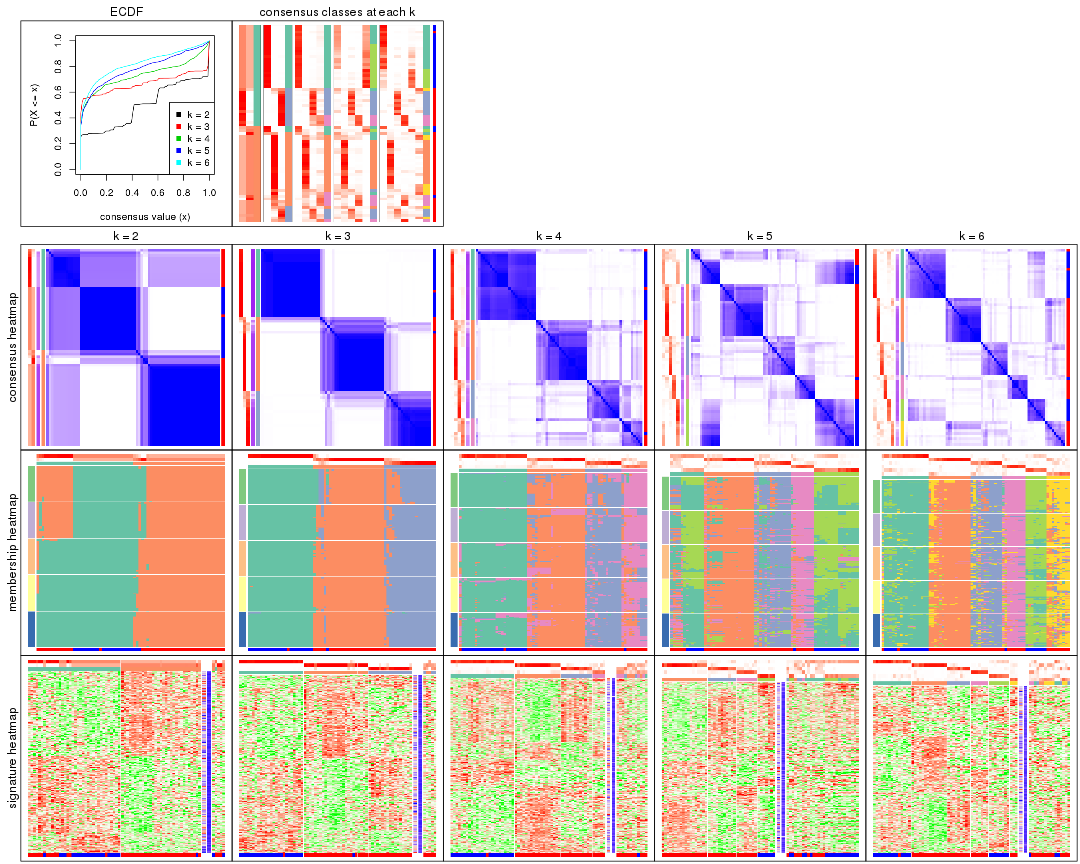
The plots are:
k and the heatmap of
predicted classes for each k.k.k.k.All the plots in panels can be made by individual functions and they are plotted later in this section.
select_partition_number() produces several plots showing different
statistics for choosing “optimized” k. There are following statistics:
k;k, the area increased is defined as \(A_k - A_{k-1}\).The detailed explanations of these statistics can be found in the cola vignette.
Generally speaking, lower PAC score, higher mean silhouette score or higher
concordance corresponds to better partition. Rand index and Jaccard index
measure how similar the current partition is compared to partition with k-1.
If they are too similar, we won't accept k is better than k-1.
select_partition_number(res)
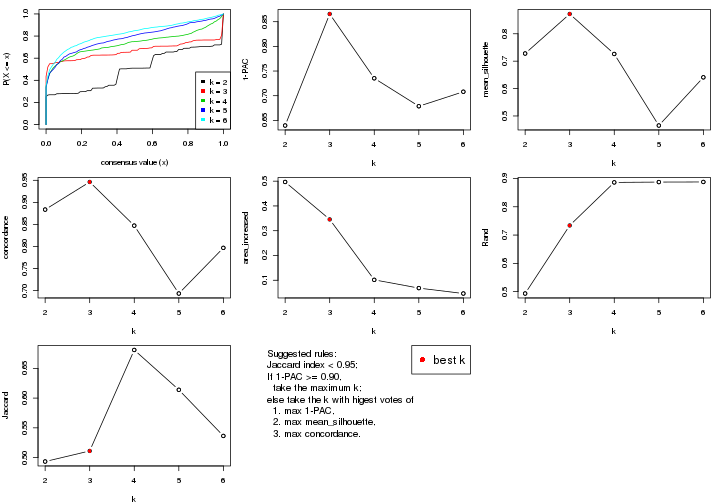
The numeric values for all these statistics can be obtained by get_stats().
get_stats(res)
#> k 1-PAC mean_silhouette concordance area_increased Rand Jaccard
#> 2 2 0.640 0.728 0.884 0.4967 0.493 0.493
#> 3 3 0.866 0.872 0.946 0.3456 0.734 0.511
#> 4 4 0.735 0.726 0.847 0.1017 0.886 0.681
#> 5 5 0.679 0.465 0.693 0.0684 0.887 0.614
#> 6 6 0.708 0.641 0.797 0.0465 0.888 0.536
suggest_best_k() suggests the best \(k\) based on these statistics. The rules are as follows:
suggest_best_k(res)
#> [1] 3
Following shows the table of the partitions (You need to click the show/hide
code output link to see it). The membership matrix (columns with name p*)
is inferred by
clue::cl_consensus()
function with the SE method. Basically the value in the membership matrix
represents the probability to belong to a certain group. The finall class
label for an item is determined with the group with highest probability it
belongs to.
In get_classes() function, the entropy is calculated from the membership
matrix and the silhouette score is calculated from the consensus matrix.
cbind(get_classes(res, k = 2), get_membership(res, k = 2))
#> class entropy silhouette p1 p2
#> sample_39 1 0.0376 0.520 0.996 0.004
#> sample_40 1 0.0000 0.526 1.000 0.000
#> sample_42 2 0.9710 0.906 0.400 0.600
#> sample_47 2 0.9710 0.906 0.400 0.600
#> sample_48 2 0.9710 0.906 0.400 0.600
#> sample_49 1 0.0000 0.526 1.000 0.000
#> sample_41 2 0.9710 0.906 0.400 0.600
#> sample_43 2 0.9710 0.906 0.400 0.600
#> sample_44 2 0.9710 0.906 0.400 0.600
#> sample_45 2 0.9710 0.906 0.400 0.600
#> sample_46 2 0.9710 0.906 0.400 0.600
#> sample_70 2 0.9710 0.906 0.400 0.600
#> sample_71 2 0.9686 0.902 0.396 0.604
#> sample_72 2 0.9710 0.906 0.400 0.600
#> sample_68 2 0.9710 0.906 0.400 0.600
#> sample_69 2 0.9710 0.906 0.400 0.600
#> sample_67 2 0.0672 0.296 0.008 0.992
#> sample_55 1 0.0000 0.526 1.000 0.000
#> sample_56 1 0.0672 0.514 0.992 0.008
#> sample_59 2 0.9710 0.906 0.400 0.600
#> sample_52 1 0.9710 0.810 0.600 0.400
#> sample_53 1 0.9710 0.810 0.600 0.400
#> sample_51 1 0.9710 0.810 0.600 0.400
#> sample_50 1 0.9710 0.810 0.600 0.400
#> sample_54 2 0.9248 -0.527 0.340 0.660
#> sample_57 1 0.9710 0.810 0.600 0.400
#> sample_58 1 0.9710 0.810 0.600 0.400
#> sample_60 1 0.9710 0.810 0.600 0.400
#> sample_61 1 0.9710 0.810 0.600 0.400
#> sample_65 1 0.9710 0.810 0.600 0.400
#> sample_66 2 0.6712 0.621 0.176 0.824
#> sample_63 1 0.9710 0.810 0.600 0.400
#> sample_64 1 0.9710 0.810 0.600 0.400
#> sample_62 1 0.9710 0.810 0.600 0.400
#> sample_1 2 0.9710 0.906 0.400 0.600
#> sample_2 2 0.0672 0.327 0.008 0.992
#> sample_3 1 0.0938 0.507 0.988 0.012
#> sample_4 2 0.9710 0.906 0.400 0.600
#> sample_5 2 0.9710 0.906 0.400 0.600
#> sample_6 1 0.0938 0.507 0.988 0.012
#> sample_7 1 0.0672 0.514 0.992 0.008
#> sample_8 1 0.0000 0.526 1.000 0.000
#> sample_9 2 0.9710 0.906 0.400 0.600
#> sample_10 1 0.4022 0.581 0.920 0.080
#> sample_11 2 0.9710 0.906 0.400 0.600
#> sample_12 1 0.9710 0.810 0.600 0.400
#> sample_13 2 0.9710 0.906 0.400 0.600
#> sample_14 2 0.9710 0.906 0.400 0.600
#> sample_15 2 0.9710 0.906 0.400 0.600
#> sample_16 2 0.9710 0.906 0.400 0.600
#> sample_17 2 0.9710 0.906 0.400 0.600
#> sample_18 2 0.9944 0.842 0.456 0.544
#> sample_19 2 0.9710 0.906 0.400 0.600
#> sample_20 2 0.9710 0.906 0.400 0.600
#> sample_21 2 0.9710 0.906 0.400 0.600
#> sample_22 1 0.5842 0.652 0.860 0.140
#> sample_23 1 0.0938 0.507 0.988 0.012
#> sample_24 2 0.9710 0.906 0.400 0.600
#> sample_25 1 0.8499 -0.328 0.724 0.276
#> sample_26 2 0.9710 0.906 0.400 0.600
#> sample_27 1 0.0000 0.526 1.000 0.000
#> sample_34 1 0.9710 0.810 0.600 0.400
#> sample_35 1 0.9710 0.810 0.600 0.400
#> sample_36 1 0.9710 0.810 0.600 0.400
#> sample_37 1 0.9710 0.810 0.600 0.400
#> sample_38 1 0.9710 0.810 0.600 0.400
#> sample_28 1 0.9710 0.810 0.600 0.400
#> sample_29 2 0.9795 -0.641 0.416 0.584
#> sample_30 1 0.9710 0.810 0.600 0.400
#> sample_31 1 0.9710 0.810 0.600 0.400
#> sample_32 1 0.9710 0.810 0.600 0.400
#> sample_33 1 0.9710 0.810 0.600 0.400
cbind(get_classes(res, k = 3), get_membership(res, k = 3))
#> class entropy silhouette p1 p2 p3
#> sample_39 3 0.4121 0.782 0.000 0.168 0.832
#> sample_40 3 0.0747 0.884 0.000 0.016 0.984
#> sample_42 2 0.0000 0.917 0.000 1.000 0.000
#> sample_47 2 0.0000 0.917 0.000 1.000 0.000
#> sample_48 2 0.0000 0.917 0.000 1.000 0.000
#> sample_49 3 0.0000 0.887 0.000 0.000 1.000
#> sample_41 2 0.0000 0.917 0.000 1.000 0.000
#> sample_43 2 0.0000 0.917 0.000 1.000 0.000
#> sample_44 2 0.0000 0.917 0.000 1.000 0.000
#> sample_45 2 0.0000 0.917 0.000 1.000 0.000
#> sample_46 2 0.0000 0.917 0.000 1.000 0.000
#> sample_70 3 0.4887 0.722 0.000 0.228 0.772
#> sample_71 2 0.0000 0.917 0.000 1.000 0.000
#> sample_72 2 0.0000 0.917 0.000 1.000 0.000
#> sample_68 2 0.0000 0.917 0.000 1.000 0.000
#> sample_69 2 0.0000 0.917 0.000 1.000 0.000
#> sample_67 2 0.6305 0.115 0.484 0.516 0.000
#> sample_55 3 0.0000 0.887 0.000 0.000 1.000
#> sample_56 3 0.0000 0.887 0.000 0.000 1.000
#> sample_59 3 0.6302 0.224 0.000 0.480 0.520
#> sample_52 1 0.0000 0.998 1.000 0.000 0.000
#> sample_53 1 0.0000 0.998 1.000 0.000 0.000
#> sample_51 1 0.0000 0.998 1.000 0.000 0.000
#> sample_50 1 0.0000 0.998 1.000 0.000 0.000
#> sample_54 1 0.0661 0.990 0.988 0.004 0.008
#> sample_57 1 0.0424 0.993 0.992 0.000 0.008
#> sample_58 1 0.0000 0.998 1.000 0.000 0.000
#> sample_60 1 0.0424 0.993 0.992 0.000 0.008
#> sample_61 1 0.0000 0.998 1.000 0.000 0.000
#> sample_65 1 0.0000 0.998 1.000 0.000 0.000
#> sample_66 2 0.5331 0.769 0.076 0.824 0.100
#> sample_63 1 0.0000 0.998 1.000 0.000 0.000
#> sample_64 1 0.0424 0.993 0.992 0.000 0.008
#> sample_62 1 0.0000 0.998 1.000 0.000 0.000
#> sample_1 3 0.4504 0.756 0.000 0.196 0.804
#> sample_2 2 0.5058 0.660 0.244 0.756 0.000
#> sample_3 3 0.0000 0.887 0.000 0.000 1.000
#> sample_4 3 0.1643 0.871 0.000 0.044 0.956
#> sample_5 2 0.0000 0.917 0.000 1.000 0.000
#> sample_6 3 0.0000 0.887 0.000 0.000 1.000
#> sample_7 3 0.0424 0.887 0.000 0.008 0.992
#> sample_8 3 0.0592 0.886 0.000 0.012 0.988
#> sample_9 3 0.6204 0.207 0.000 0.424 0.576
#> sample_10 3 0.0237 0.886 0.004 0.000 0.996
#> sample_11 2 0.6140 0.320 0.000 0.596 0.404
#> sample_12 1 0.0000 0.998 1.000 0.000 0.000
#> sample_13 2 0.0000 0.917 0.000 1.000 0.000
#> sample_14 2 0.5216 0.626 0.000 0.740 0.260
#> sample_15 2 0.0000 0.917 0.000 1.000 0.000
#> sample_16 2 0.0424 0.912 0.000 0.992 0.008
#> sample_17 2 0.0747 0.906 0.000 0.984 0.016
#> sample_18 3 0.0237 0.886 0.000 0.004 0.996
#> sample_19 2 0.0000 0.917 0.000 1.000 0.000
#> sample_20 2 0.0000 0.917 0.000 1.000 0.000
#> sample_21 2 0.0000 0.917 0.000 1.000 0.000
#> sample_22 3 0.0848 0.885 0.008 0.008 0.984
#> sample_23 3 0.0000 0.887 0.000 0.000 1.000
#> sample_24 2 0.0000 0.917 0.000 1.000 0.000
#> sample_25 3 0.6498 0.442 0.008 0.396 0.596
#> sample_26 2 0.4796 0.630 0.000 0.780 0.220
#> sample_27 3 0.0000 0.887 0.000 0.000 1.000
#> sample_34 1 0.0000 0.998 1.000 0.000 0.000
#> sample_35 1 0.0747 0.985 0.984 0.000 0.016
#> sample_36 1 0.0000 0.998 1.000 0.000 0.000
#> sample_37 1 0.0000 0.998 1.000 0.000 0.000
#> sample_38 1 0.0000 0.998 1.000 0.000 0.000
#> sample_28 1 0.0000 0.998 1.000 0.000 0.000
#> sample_29 1 0.0000 0.998 1.000 0.000 0.000
#> sample_30 1 0.0000 0.998 1.000 0.000 0.000
#> sample_31 1 0.0000 0.998 1.000 0.000 0.000
#> sample_32 1 0.0000 0.998 1.000 0.000 0.000
#> sample_33 1 0.0000 0.998 1.000 0.000 0.000
cbind(get_classes(res, k = 4), get_membership(res, k = 4))
#> class entropy silhouette p1 p2 p3 p4
#> sample_39 3 0.3196 0.719 0.000 0.008 0.856 0.136
#> sample_40 3 0.1975 0.775 0.016 0.028 0.944 0.012
#> sample_42 2 0.6682 0.486 0.000 0.576 0.112 0.312
#> sample_47 2 0.0592 0.833 0.000 0.984 0.000 0.016
#> sample_48 2 0.0000 0.834 0.000 1.000 0.000 0.000
#> sample_49 3 0.0707 0.774 0.000 0.000 0.980 0.020
#> sample_41 2 0.0469 0.832 0.000 0.988 0.000 0.012
#> sample_43 2 0.3249 0.781 0.000 0.852 0.008 0.140
#> sample_44 2 0.3856 0.774 0.000 0.832 0.032 0.136
#> sample_45 2 0.3763 0.771 0.000 0.832 0.024 0.144
#> sample_46 2 0.4105 0.758 0.000 0.812 0.032 0.156
#> sample_70 3 0.5874 0.574 0.000 0.112 0.696 0.192
#> sample_71 4 0.7442 -0.165 0.000 0.368 0.176 0.456
#> sample_72 2 0.7414 0.266 0.000 0.460 0.172 0.368
#> sample_68 2 0.0336 0.832 0.000 0.992 0.000 0.008
#> sample_69 2 0.0469 0.833 0.000 0.988 0.000 0.012
#> sample_67 1 0.7387 0.059 0.444 0.164 0.000 0.392
#> sample_55 3 0.4258 0.668 0.012 0.020 0.812 0.156
#> sample_56 3 0.0707 0.777 0.000 0.000 0.980 0.020
#> sample_59 2 0.6740 0.484 0.000 0.600 0.256 0.144
#> sample_52 1 0.1356 0.923 0.960 0.000 0.008 0.032
#> sample_53 1 0.1474 0.924 0.948 0.000 0.000 0.052
#> sample_51 1 0.1389 0.926 0.952 0.000 0.000 0.048
#> sample_50 1 0.1302 0.926 0.956 0.000 0.000 0.044
#> sample_54 1 0.4807 0.774 0.800 0.124 0.012 0.064
#> sample_57 1 0.1356 0.923 0.960 0.000 0.008 0.032
#> sample_58 1 0.1356 0.923 0.960 0.000 0.008 0.032
#> sample_60 1 0.2307 0.909 0.928 0.008 0.016 0.048
#> sample_61 1 0.0927 0.930 0.976 0.000 0.008 0.016
#> sample_65 1 0.0336 0.929 0.992 0.000 0.000 0.008
#> sample_66 4 0.5712 0.350 0.008 0.408 0.016 0.568
#> sample_63 1 0.1356 0.923 0.960 0.000 0.008 0.032
#> sample_64 1 0.1833 0.917 0.944 0.000 0.024 0.032
#> sample_62 1 0.1356 0.923 0.960 0.000 0.008 0.032
#> sample_1 3 0.2722 0.769 0.000 0.064 0.904 0.032
#> sample_2 4 0.5056 0.560 0.076 0.164 0.000 0.760
#> sample_3 4 0.4941 0.354 0.000 0.000 0.436 0.564
#> sample_4 3 0.4552 0.642 0.000 0.172 0.784 0.044
#> sample_5 2 0.0336 0.832 0.000 0.992 0.000 0.008
#> sample_6 4 0.4916 0.375 0.000 0.000 0.424 0.576
#> sample_7 3 0.3978 0.704 0.000 0.108 0.836 0.056
#> sample_8 3 0.0469 0.776 0.000 0.000 0.988 0.012
#> sample_9 4 0.6119 0.605 0.000 0.168 0.152 0.680
#> sample_10 4 0.4483 0.505 0.000 0.004 0.284 0.712
#> sample_11 4 0.5062 0.610 0.000 0.184 0.064 0.752
#> sample_12 1 0.3486 0.874 0.864 0.000 0.044 0.092
#> sample_13 2 0.0000 0.834 0.000 1.000 0.000 0.000
#> sample_14 4 0.5535 0.569 0.000 0.304 0.040 0.656
#> sample_15 2 0.0336 0.832 0.000 0.992 0.000 0.008
#> sample_16 2 0.1042 0.828 0.000 0.972 0.020 0.008
#> sample_17 2 0.3873 0.542 0.000 0.772 0.000 0.228
#> sample_18 3 0.5707 0.475 0.008 0.044 0.680 0.268
#> sample_19 2 0.2542 0.808 0.000 0.904 0.012 0.084
#> sample_20 2 0.0000 0.834 0.000 1.000 0.000 0.000
#> sample_21 2 0.0592 0.830 0.000 0.984 0.000 0.016
#> sample_22 3 0.3853 0.689 0.020 0.000 0.820 0.160
#> sample_23 4 0.4948 0.345 0.000 0.000 0.440 0.560
#> sample_24 2 0.0336 0.832 0.000 0.992 0.000 0.008
#> sample_25 3 0.8128 0.298 0.040 0.148 0.488 0.324
#> sample_26 2 0.7442 0.215 0.000 0.456 0.368 0.176
#> sample_27 3 0.0707 0.774 0.000 0.000 0.980 0.020
#> sample_34 1 0.0779 0.928 0.980 0.000 0.004 0.016
#> sample_35 1 0.2224 0.911 0.928 0.000 0.040 0.032
#> sample_36 1 0.1118 0.928 0.964 0.000 0.000 0.036
#> sample_37 1 0.1474 0.924 0.948 0.000 0.000 0.052
#> sample_38 1 0.2345 0.901 0.900 0.000 0.000 0.100
#> sample_28 1 0.1867 0.916 0.928 0.000 0.000 0.072
#> sample_29 1 0.2469 0.895 0.892 0.000 0.000 0.108
#> sample_30 1 0.1211 0.927 0.960 0.000 0.000 0.040
#> sample_31 1 0.0779 0.927 0.980 0.000 0.004 0.016
#> sample_32 1 0.1022 0.928 0.968 0.000 0.000 0.032
#> sample_33 1 0.1389 0.926 0.952 0.000 0.000 0.048
cbind(get_classes(res, k = 5), get_membership(res, k = 5))
#> class entropy silhouette p1 p2 p3 p4 p5
#> sample_39 3 0.4707 0.6173 0.212 0.000 0.716 0.072 0.000
#> sample_40 3 0.3099 0.6925 0.004 0.004 0.872 0.048 0.072
#> sample_42 1 0.7864 -0.3367 0.380 0.360 0.124 0.136 0.000
#> sample_47 2 0.1116 0.8593 0.028 0.964 0.004 0.004 0.000
#> sample_48 2 0.0000 0.8624 0.000 1.000 0.000 0.000 0.000
#> sample_49 3 0.0960 0.7100 0.004 0.000 0.972 0.016 0.008
#> sample_41 2 0.0807 0.8609 0.012 0.976 0.000 0.012 0.000
#> sample_43 2 0.5354 0.7006 0.208 0.696 0.028 0.068 0.000
#> sample_44 2 0.5248 0.7216 0.160 0.728 0.044 0.068 0.000
#> sample_45 2 0.5216 0.7012 0.212 0.700 0.020 0.068 0.000
#> sample_46 2 0.5693 0.6698 0.216 0.672 0.040 0.072 0.000
#> sample_70 3 0.7578 0.4693 0.244 0.100 0.508 0.144 0.004
#> sample_71 1 0.8240 -0.2290 0.404 0.228 0.184 0.184 0.000
#> sample_72 1 0.8309 -0.2500 0.364 0.276 0.204 0.156 0.000
#> sample_68 2 0.0693 0.8604 0.008 0.980 0.000 0.012 0.000
#> sample_69 2 0.1059 0.8584 0.020 0.968 0.004 0.008 0.000
#> sample_67 1 0.7529 0.0344 0.520 0.120 0.000 0.180 0.180
#> sample_55 3 0.6086 0.5063 0.056 0.000 0.648 0.084 0.212
#> sample_56 3 0.1471 0.7122 0.024 0.000 0.952 0.020 0.004
#> sample_59 2 0.8333 0.3209 0.216 0.472 0.188 0.076 0.048
#> sample_52 5 0.0703 0.5751 0.024 0.000 0.000 0.000 0.976
#> sample_53 1 0.4306 -0.1581 0.508 0.000 0.000 0.000 0.492
#> sample_51 1 0.4306 -0.1581 0.508 0.000 0.000 0.000 0.492
#> sample_50 5 0.4307 0.0553 0.500 0.000 0.000 0.000 0.500
#> sample_54 5 0.5366 0.4140 0.084 0.056 0.060 0.036 0.764
#> sample_57 5 0.3086 0.5171 0.048 0.000 0.060 0.016 0.876
#> sample_58 5 0.1728 0.5719 0.020 0.000 0.036 0.004 0.940
#> sample_60 5 0.4471 0.4623 0.076 0.016 0.076 0.024 0.808
#> sample_61 5 0.5466 0.2816 0.424 0.000 0.052 0.004 0.520
#> sample_65 5 0.4211 0.3568 0.360 0.000 0.004 0.000 0.636
#> sample_66 4 0.5245 0.4323 0.064 0.328 0.000 0.608 0.000
#> sample_63 5 0.0693 0.5763 0.012 0.000 0.008 0.000 0.980
#> sample_64 5 0.2270 0.5495 0.016 0.000 0.072 0.004 0.908
#> sample_62 5 0.0798 0.5731 0.016 0.000 0.008 0.000 0.976
#> sample_1 3 0.3820 0.6997 0.048 0.052 0.840 0.060 0.000
#> sample_2 4 0.5500 0.5645 0.268 0.084 0.000 0.640 0.008
#> sample_3 4 0.3074 0.7302 0.000 0.000 0.196 0.804 0.000
#> sample_4 3 0.6074 0.5053 0.032 0.228 0.632 0.108 0.000
#> sample_5 2 0.0693 0.8604 0.008 0.980 0.000 0.012 0.000
#> sample_6 4 0.3074 0.7302 0.000 0.000 0.196 0.804 0.000
#> sample_7 3 0.5107 0.6049 0.024 0.120 0.752 0.096 0.008
#> sample_8 3 0.1830 0.7046 0.040 0.000 0.932 0.028 0.000
#> sample_9 4 0.2903 0.7758 0.000 0.080 0.048 0.872 0.000
#> sample_10 4 0.2919 0.7586 0.024 0.000 0.104 0.868 0.004
#> sample_11 4 0.2673 0.7653 0.016 0.076 0.016 0.892 0.000
#> sample_12 1 0.5041 -0.0719 0.588 0.000 0.012 0.020 0.380
#> sample_13 2 0.0000 0.8624 0.000 1.000 0.000 0.000 0.000
#> sample_14 4 0.2890 0.7381 0.004 0.160 0.000 0.836 0.000
#> sample_15 2 0.0693 0.8604 0.008 0.980 0.000 0.012 0.000
#> sample_16 2 0.1507 0.8519 0.012 0.952 0.024 0.012 0.000
#> sample_17 2 0.4001 0.6208 0.020 0.768 0.000 0.204 0.008
#> sample_18 3 0.7822 0.3786 0.084 0.060 0.532 0.244 0.080
#> sample_19 2 0.4238 0.7816 0.104 0.808 0.040 0.048 0.000
#> sample_20 2 0.0290 0.8620 0.000 0.992 0.000 0.008 0.000
#> sample_21 2 0.1012 0.8569 0.012 0.968 0.000 0.020 0.000
#> sample_22 3 0.5168 0.5890 0.240 0.000 0.688 0.052 0.020
#> sample_23 4 0.3109 0.7254 0.000 0.000 0.200 0.800 0.000
#> sample_24 2 0.0693 0.8604 0.008 0.980 0.000 0.012 0.000
#> sample_25 1 0.7841 -0.3994 0.424 0.072 0.348 0.140 0.016
#> sample_26 3 0.7914 0.1996 0.260 0.272 0.388 0.080 0.000
#> sample_27 3 0.1153 0.7074 0.004 0.000 0.964 0.024 0.008
#> sample_34 5 0.3730 0.4517 0.288 0.000 0.000 0.000 0.712
#> sample_35 5 0.4747 0.5067 0.196 0.000 0.084 0.000 0.720
#> sample_36 5 0.4294 0.1255 0.468 0.000 0.000 0.000 0.532
#> sample_37 1 0.4307 -0.1678 0.504 0.000 0.000 0.000 0.496
#> sample_38 1 0.4415 -0.1069 0.552 0.000 0.000 0.004 0.444
#> sample_28 1 0.4283 -0.1138 0.544 0.000 0.000 0.000 0.456
#> sample_29 1 0.4882 -0.1422 0.532 0.000 0.000 0.024 0.444
#> sample_30 5 0.4307 0.0591 0.496 0.000 0.000 0.000 0.504
#> sample_31 5 0.3837 0.4325 0.308 0.000 0.000 0.000 0.692
#> sample_32 5 0.4306 0.0828 0.492 0.000 0.000 0.000 0.508
#> sample_33 1 0.4305 -0.1537 0.512 0.000 0.000 0.000 0.488
cbind(get_classes(res, k = 6), get_membership(res, k = 6))
#> class entropy silhouette p1 p2 p3 p4 p5 p6
#> sample_39 3 0.4026 0.3188 0.000 0.000 0.612 0.012 0.000 0.376
#> sample_40 3 0.2582 0.7246 0.000 0.000 0.888 0.020 0.060 0.032
#> sample_42 6 0.3876 0.5940 0.008 0.120 0.004 0.020 0.040 0.808
#> sample_47 2 0.2633 0.7631 0.000 0.864 0.000 0.004 0.020 0.112
#> sample_48 2 0.0458 0.8386 0.000 0.984 0.000 0.000 0.000 0.016
#> sample_49 3 0.1536 0.7322 0.000 0.000 0.944 0.020 0.012 0.024
#> sample_41 2 0.0779 0.8382 0.000 0.976 0.000 0.008 0.008 0.008
#> sample_43 6 0.4999 0.0751 0.000 0.460 0.020 0.000 0.032 0.488
#> sample_44 2 0.5448 0.0714 0.000 0.536 0.076 0.000 0.020 0.368
#> sample_45 2 0.4413 -0.1334 0.000 0.496 0.012 0.000 0.008 0.484
#> sample_46 6 0.4665 0.2413 0.000 0.412 0.024 0.000 0.012 0.552
#> sample_70 6 0.6190 0.3924 0.004 0.064 0.256 0.052 0.028 0.596
#> sample_71 6 0.5190 0.5262 0.024 0.064 0.036 0.076 0.044 0.756
#> sample_72 6 0.5610 0.5384 0.012 0.144 0.044 0.060 0.036 0.704
#> sample_68 2 0.0405 0.8392 0.000 0.988 0.000 0.008 0.004 0.000
#> sample_69 2 0.1007 0.8276 0.000 0.956 0.000 0.000 0.000 0.044
#> sample_67 1 0.7778 0.1854 0.456 0.092 0.000 0.132 0.084 0.236
#> sample_55 3 0.5424 0.5726 0.000 0.008 0.628 0.072 0.264 0.028
#> sample_56 3 0.2123 0.7267 0.000 0.000 0.912 0.012 0.052 0.024
#> sample_59 6 0.7411 0.3665 0.000 0.268 0.188 0.000 0.160 0.384
#> sample_52 5 0.3584 0.7675 0.308 0.000 0.000 0.004 0.688 0.000
#> sample_53 1 0.0146 0.7953 0.996 0.000 0.000 0.000 0.004 0.000
#> sample_51 1 0.0632 0.7950 0.976 0.000 0.000 0.000 0.024 0.000
#> sample_50 1 0.0632 0.7950 0.976 0.000 0.000 0.000 0.024 0.000
#> sample_54 5 0.2973 0.7626 0.060 0.036 0.012 0.004 0.876 0.012
#> sample_57 5 0.3010 0.8312 0.148 0.000 0.020 0.000 0.828 0.004
#> sample_58 5 0.4532 0.7823 0.292 0.000 0.044 0.000 0.656 0.008
#> sample_60 5 0.2763 0.7892 0.084 0.000 0.016 0.008 0.876 0.016
#> sample_61 1 0.4311 0.6463 0.760 0.000 0.056 0.000 0.148 0.036
#> sample_65 1 0.3359 0.6520 0.784 0.000 0.008 0.000 0.196 0.012
#> sample_66 4 0.6779 0.3371 0.008 0.240 0.000 0.524 0.108 0.120
#> sample_63 5 0.3722 0.8230 0.260 0.000 0.008 0.004 0.724 0.004
#> sample_64 5 0.4837 0.7947 0.248 0.000 0.076 0.000 0.664 0.012
#> sample_62 5 0.3674 0.8411 0.220 0.000 0.012 0.004 0.756 0.008
#> sample_1 3 0.4793 0.6489 0.000 0.088 0.748 0.052 0.008 0.104
#> sample_2 4 0.6995 0.4248 0.156 0.052 0.000 0.552 0.064 0.176
#> sample_3 4 0.2101 0.7914 0.000 0.000 0.100 0.892 0.004 0.004
#> sample_4 3 0.6061 0.5461 0.000 0.188 0.628 0.116 0.036 0.032
#> sample_5 2 0.0520 0.8394 0.000 0.984 0.000 0.008 0.008 0.000
#> sample_6 4 0.2149 0.7893 0.000 0.000 0.104 0.888 0.004 0.004
#> sample_7 3 0.4640 0.6795 0.000 0.080 0.768 0.092 0.040 0.020
#> sample_8 3 0.1367 0.7271 0.000 0.000 0.944 0.012 0.000 0.044
#> sample_9 4 0.1003 0.8134 0.000 0.020 0.016 0.964 0.000 0.000
#> sample_10 4 0.1230 0.8105 0.000 0.000 0.028 0.956 0.008 0.008
#> sample_11 4 0.1237 0.8059 0.000 0.020 0.004 0.956 0.000 0.020
#> sample_12 1 0.3351 0.7279 0.840 0.000 0.020 0.004 0.040 0.096
#> sample_13 2 0.0547 0.8382 0.000 0.980 0.000 0.000 0.000 0.020
#> sample_14 4 0.2122 0.7820 0.000 0.084 0.008 0.900 0.008 0.000
#> sample_15 2 0.0520 0.8394 0.000 0.984 0.000 0.008 0.008 0.000
#> sample_16 2 0.2214 0.7954 0.000 0.912 0.028 0.004 0.012 0.044
#> sample_17 2 0.4029 0.6347 0.000 0.784 0.000 0.124 0.068 0.024
#> sample_18 3 0.8015 0.3225 0.000 0.084 0.436 0.212 0.148 0.120
#> sample_19 2 0.4057 0.5111 0.000 0.704 0.016 0.004 0.008 0.268
#> sample_20 2 0.0547 0.8382 0.000 0.980 0.000 0.000 0.000 0.020
#> sample_21 2 0.0767 0.8333 0.000 0.976 0.000 0.008 0.004 0.012
#> sample_22 3 0.5881 0.4110 0.080 0.000 0.584 0.024 0.024 0.288
#> sample_23 4 0.2196 0.7853 0.000 0.000 0.108 0.884 0.004 0.004
#> sample_24 2 0.0520 0.8394 0.000 0.984 0.000 0.008 0.008 0.000
#> sample_25 6 0.4872 0.4704 0.076 0.004 0.132 0.024 0.020 0.744
#> sample_26 6 0.6109 0.4756 0.000 0.188 0.228 0.008 0.020 0.556
#> sample_27 3 0.1542 0.7336 0.000 0.000 0.944 0.024 0.016 0.016
#> sample_34 1 0.3895 0.4718 0.700 0.000 0.012 0.000 0.280 0.008
#> sample_35 1 0.5813 -0.2309 0.464 0.000 0.144 0.000 0.384 0.008
#> sample_36 1 0.1908 0.7665 0.900 0.000 0.000 0.004 0.096 0.000
#> sample_37 1 0.0603 0.7962 0.980 0.000 0.000 0.000 0.016 0.004
#> sample_38 1 0.1642 0.7789 0.936 0.000 0.004 0.000 0.028 0.032
#> sample_28 1 0.1168 0.7847 0.956 0.000 0.000 0.000 0.028 0.016
#> sample_29 1 0.3401 0.7171 0.824 0.000 0.000 0.008 0.104 0.064
#> sample_30 1 0.1349 0.7889 0.940 0.000 0.000 0.004 0.056 0.000
#> sample_31 1 0.3659 0.5200 0.720 0.000 0.004 0.004 0.268 0.004
#> sample_32 1 0.1672 0.7918 0.932 0.000 0.000 0.004 0.048 0.016
#> sample_33 1 0.0146 0.7959 0.996 0.000 0.000 0.000 0.004 0.000
Heatmaps for the consensus matrix. It visualizes the probability of two samples to be in a same group.
consensus_heatmap(res, k = 2)
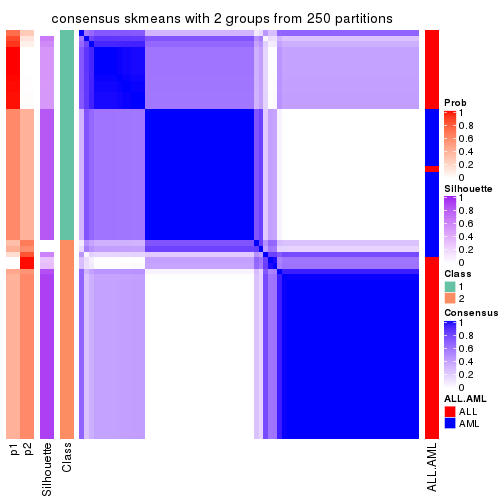
consensus_heatmap(res, k = 3)
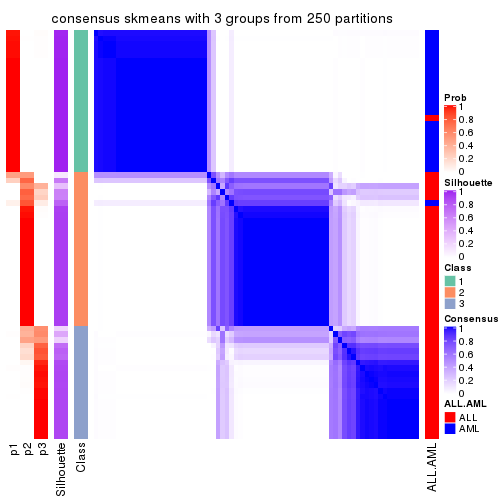
consensus_heatmap(res, k = 4)
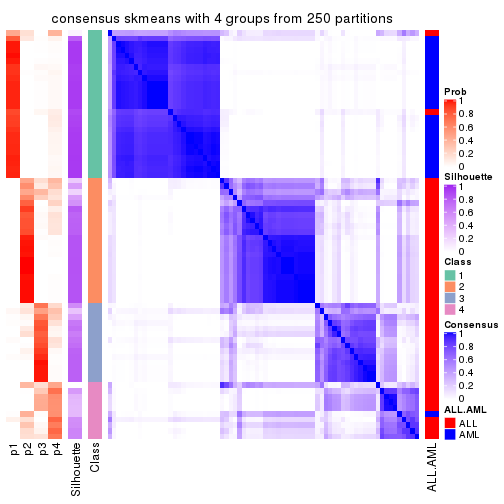
consensus_heatmap(res, k = 5)
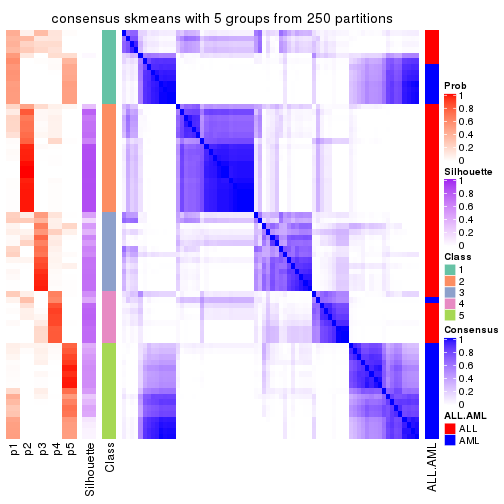
consensus_heatmap(res, k = 6)
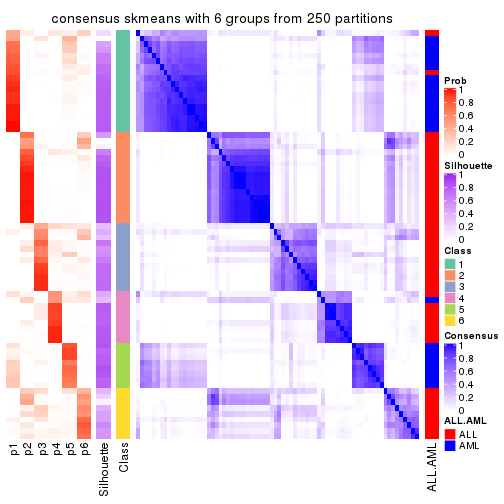
Heatmaps for the membership of samples in all partitions to see how consistent they are:
membership_heatmap(res, k = 2)
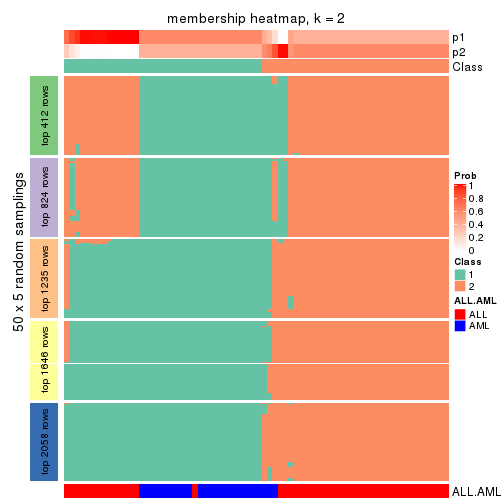
membership_heatmap(res, k = 3)
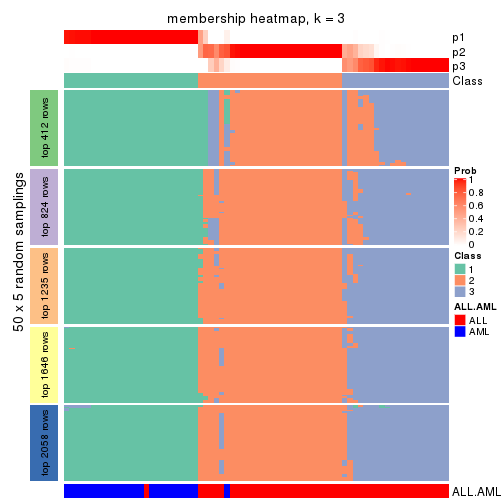
membership_heatmap(res, k = 4)
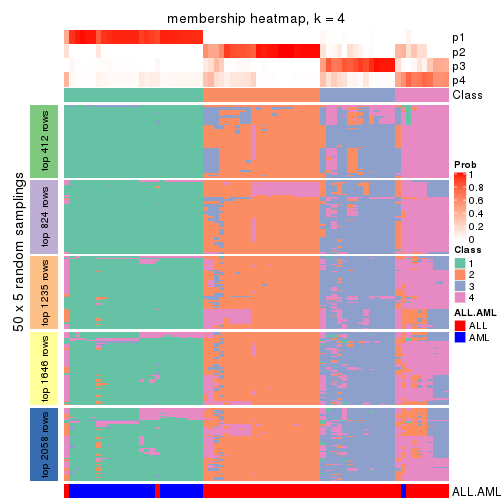
membership_heatmap(res, k = 5)
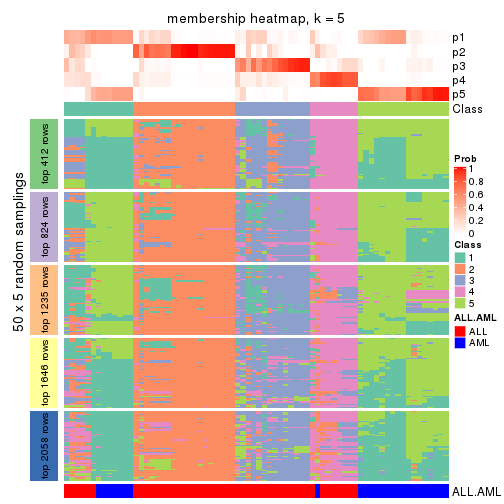
membership_heatmap(res, k = 6)
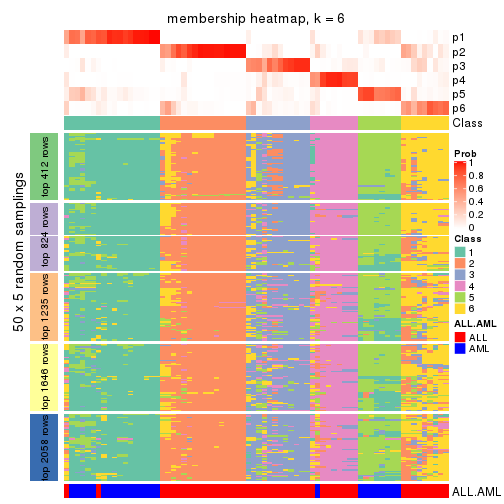
As soon as we have had the classes for columns, we can look for signatures which are significantly different between classes which can be candidate marks for certain classes. Following are the heatmaps for signatures.
Signature heatmaps where rows are scaled:
get_signatures(res, k = 2)
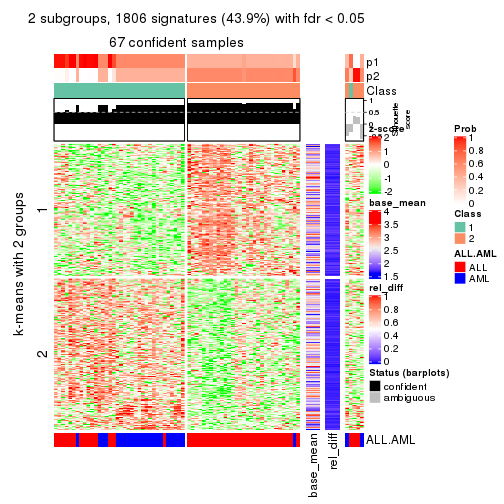
get_signatures(res, k = 3)
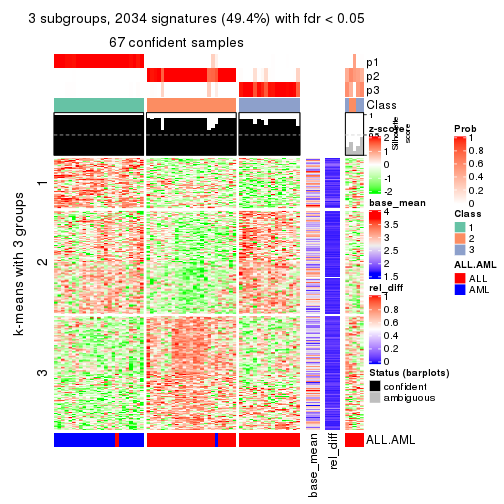
get_signatures(res, k = 4)
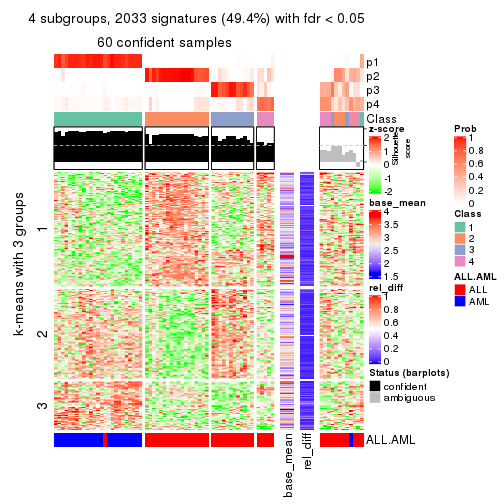
get_signatures(res, k = 5)
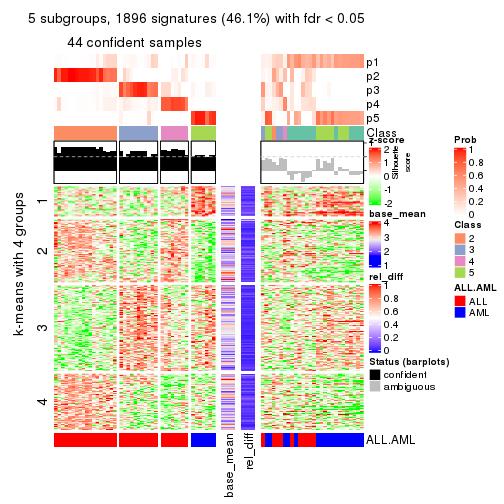
get_signatures(res, k = 6)
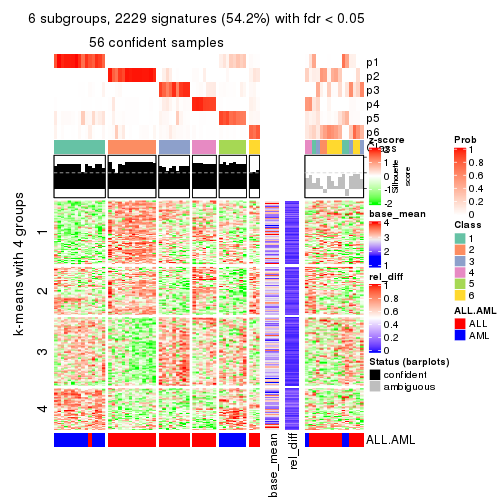
Signature heatmaps where rows are not scaled:
get_signatures(res, k = 2, scale_rows = FALSE)
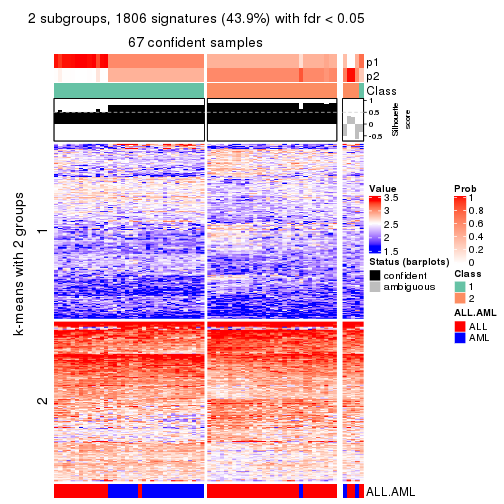
get_signatures(res, k = 3, scale_rows = FALSE)
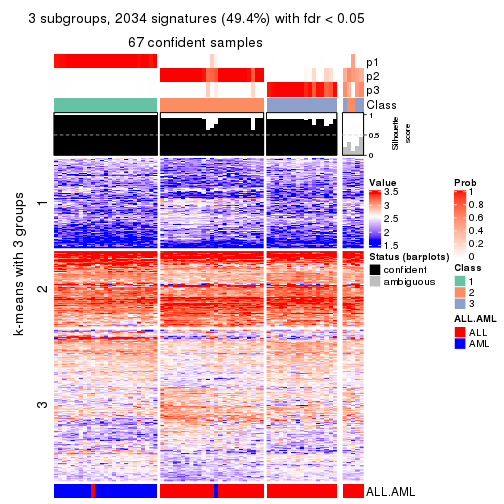
get_signatures(res, k = 4, scale_rows = FALSE)
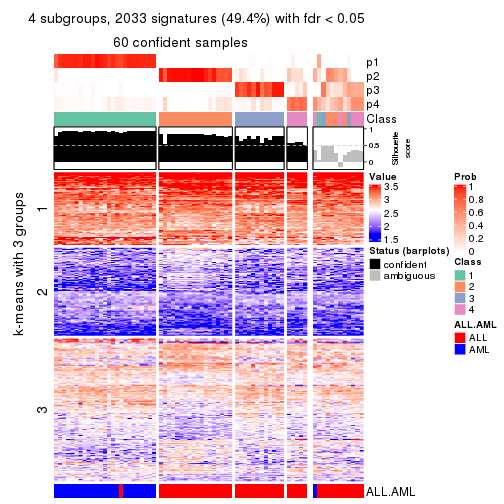
get_signatures(res, k = 5, scale_rows = FALSE)
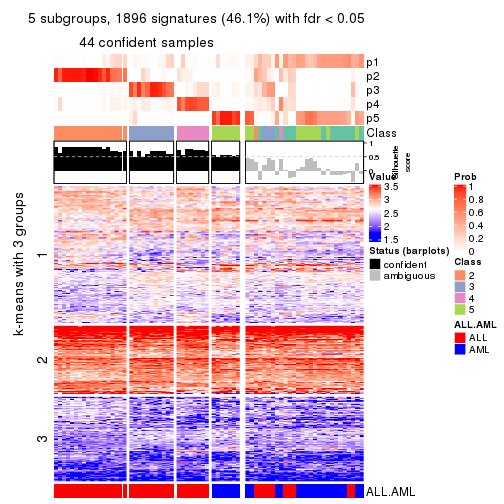
get_signatures(res, k = 6, scale_rows = FALSE)
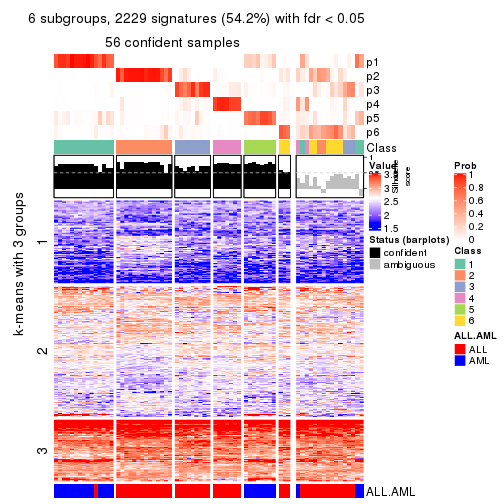
Compare the overlap of signatures from different k:
compare_signatures(res)
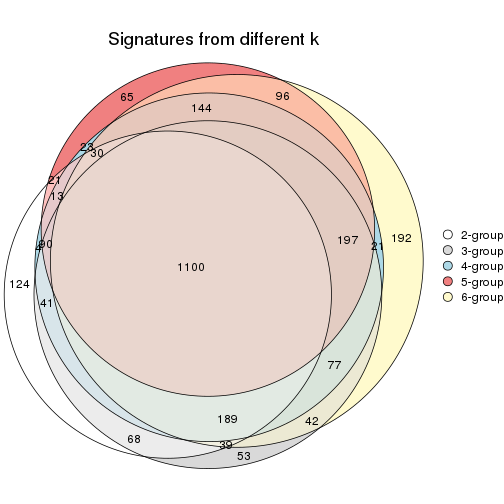
get_signature() returns a data frame invisibly. TO get the list of signatures, the function
call should be assigned to a variable explicitly. In following code, if plot argument is set
to FALSE, no heatmap is plotted while only the differential analysis is performed.
# code only for demonstration
tb = get_signature(res, k = ..., plot = FALSE)
An example of the output of tb is:
#> which_row fdr mean_1 mean_2 scaled_mean_1 scaled_mean_2 km
#> 1 38 0.042760348 8.373488 9.131774 -0.5533452 0.5164555 1
#> 2 40 0.018707592 7.106213 8.469186 -0.6173731 0.5762149 1
#> 3 55 0.019134737 10.221463 11.207825 -0.6159697 0.5749050 1
#> 4 59 0.006059896 5.921854 7.869574 -0.6899429 0.6439467 1
#> 5 60 0.018055526 8.928898 10.211722 -0.6204761 0.5791110 1
#> 6 98 0.009384629 15.714769 14.887706 0.6635654 -0.6193277 2
...
The columns in tb are:
which_row: row indices corresponding to the input matrix.fdr: FDR for the differential test. mean_x: The mean value in group x.scaled_mean_x: The mean value in group x after rows are scaled.km: Row groups if k-means clustering is applied to rows.UMAP plot which shows how samples are separated.
dimension_reduction(res, k = 2, method = "UMAP")
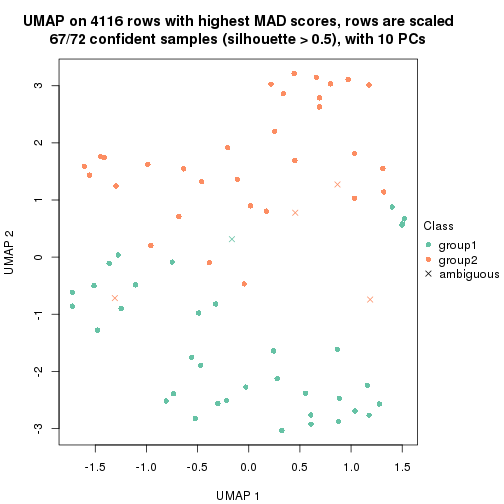
dimension_reduction(res, k = 3, method = "UMAP")
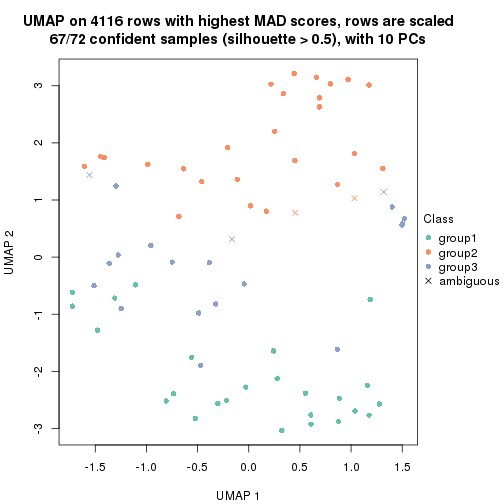
dimension_reduction(res, k = 4, method = "UMAP")
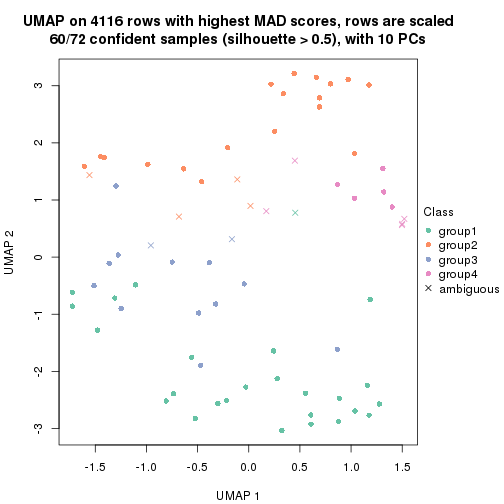
dimension_reduction(res, k = 5, method = "UMAP")
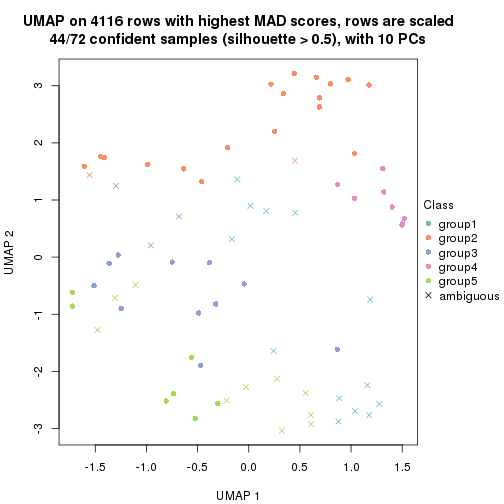
dimension_reduction(res, k = 6, method = "UMAP")
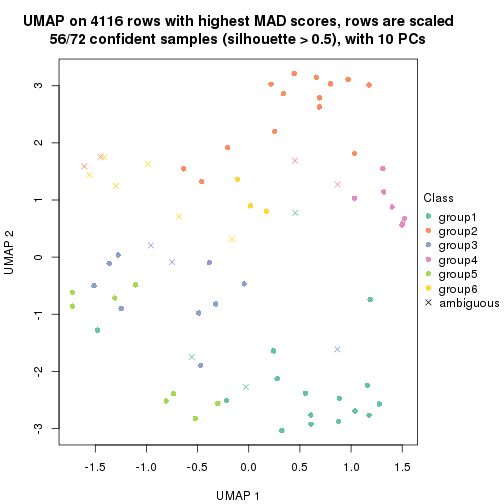
Following heatmap shows how subgroups are split when increasing k:
collect_classes(res)
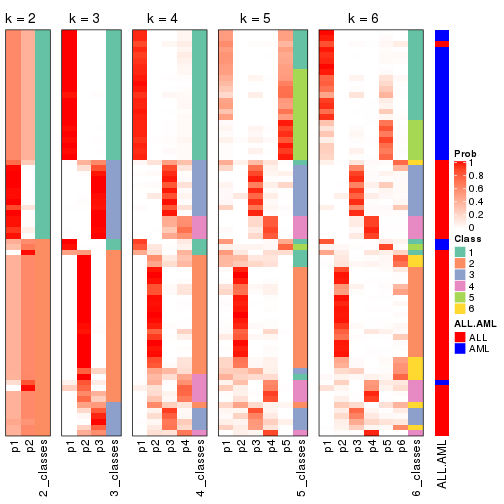
Test correlation between subgroups and known annotations. If the known annotation is numeric, one-way ANOVA test is applied, and if the known annotation is discrete, chi-squared contingency table test is applied.
test_to_known_factors(res)
#> n ALL.AML(p) k
#> MAD:skmeans 67 2.39e-06 2
#> MAD:skmeans 67 1.71e-13 3
#> MAD:skmeans 60 4.20e-12 4
#> MAD:skmeans 44 1.51e-09 5
#> MAD:skmeans 56 5.18e-10 6
If matrix rows can be associated to genes, consider to use functional_enrichment(res,
...) to perform function enrichment for the signature genes. See this vignette for more detailed explanations.
The object with results only for a single top-value method and a single partition method can be extracted as:
res = res_list["MAD", "pam"]
# you can also extract it by
# res = res_list["MAD:pam"]
A summary of res and all the functions that can be applied to it:
res
#> A 'ConsensusPartition' object with k = 2, 3, 4, 5, 6.
#> On a matrix with 4116 rows and 72 columns.
#> Top rows (412, 824, 1235, 1646, 2058) are extracted by 'MAD' method.
#> Subgroups are detected by 'pam' method.
#> Performed in total 1250 partitions by row resampling.
#> Best k for subgroups seems to be 2.
#>
#> Following methods can be applied to this 'ConsensusPartition' object:
#> [1] "cola_report" "collect_classes" "collect_plots"
#> [4] "collect_stats" "colnames" "compare_signatures"
#> [7] "consensus_heatmap" "dimension_reduction" "functional_enrichment"
#> [10] "get_anno_col" "get_anno" "get_classes"
#> [13] "get_consensus" "get_matrix" "get_membership"
#> [16] "get_param" "get_signatures" "get_stats"
#> [19] "is_best_k" "is_stable_k" "membership_heatmap"
#> [22] "ncol" "nrow" "plot_ecdf"
#> [25] "rownames" "select_partition_number" "show"
#> [28] "suggest_best_k" "test_to_known_factors"
collect_plots() function collects all the plots made from res for all k (number of partitions)
into one single page to provide an easy and fast comparison between different k.
collect_plots(res)
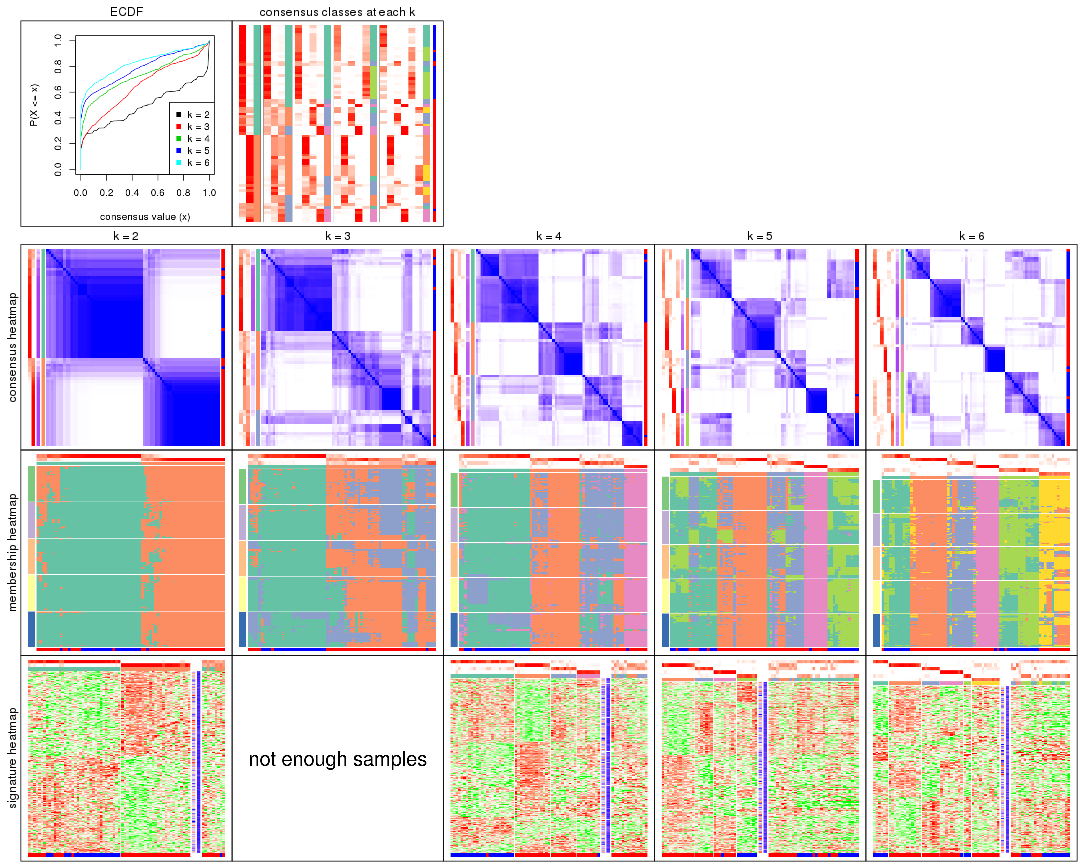
The plots are:
k and the heatmap of
predicted classes for each k.k.k.k.All the plots in panels can be made by individual functions and they are plotted later in this section.
select_partition_number() produces several plots showing different
statistics for choosing “optimized” k. There are following statistics:
k;k, the area increased is defined as \(A_k - A_{k-1}\).The detailed explanations of these statistics can be found in the cola vignette.
Generally speaking, lower PAC score, higher mean silhouette score or higher
concordance corresponds to better partition. Rand index and Jaccard index
measure how similar the current partition is compared to partition with k-1.
If they are too similar, we won't accept k is better than k-1.
select_partition_number(res)
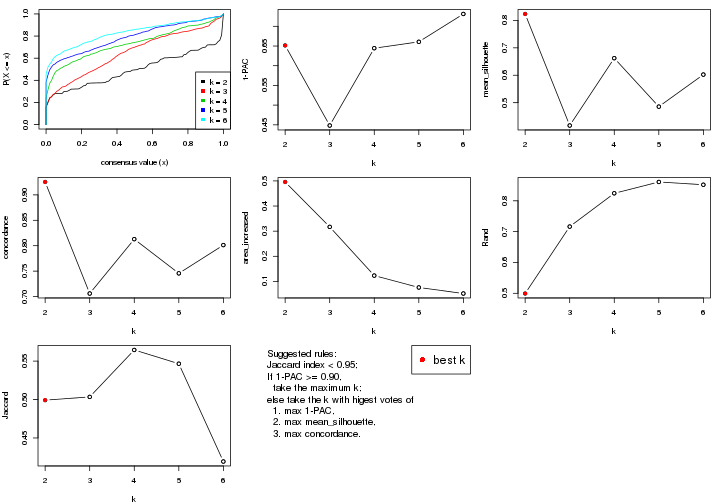
The numeric values for all these statistics can be obtained by get_stats().
get_stats(res)
#> k 1-PAC mean_silhouette concordance area_increased Rand Jaccard
#> 2 2 0.651 0.824 0.925 0.4957 0.499 0.499
#> 3 3 0.448 0.417 0.706 0.3170 0.716 0.503
#> 4 4 0.644 0.662 0.813 0.1232 0.824 0.565
#> 5 5 0.661 0.486 0.746 0.0759 0.861 0.547
#> 6 6 0.731 0.602 0.801 0.0519 0.852 0.419
suggest_best_k() suggests the best \(k\) based on these statistics. The rules are as follows:
suggest_best_k(res)
#> [1] 2
Following shows the table of the partitions (You need to click the show/hide
code output link to see it). The membership matrix (columns with name p*)
is inferred by
clue::cl_consensus()
function with the SE method. Basically the value in the membership matrix
represents the probability to belong to a certain group. The finall class
label for an item is determined with the group with highest probability it
belongs to.
In get_classes() function, the entropy is calculated from the membership
matrix and the silhouette score is calculated from the consensus matrix.
cbind(get_classes(res, k = 2), get_membership(res, k = 2))
#> class entropy silhouette p1 p2
#> sample_39 1 0.9427 0.464 0.640 0.360
#> sample_40 1 0.5629 0.824 0.868 0.132
#> sample_42 2 0.2603 0.881 0.044 0.956
#> sample_47 2 0.0000 0.906 0.000 1.000
#> sample_48 2 0.0000 0.906 0.000 1.000
#> sample_49 1 0.0938 0.918 0.988 0.012
#> sample_41 2 0.0000 0.906 0.000 1.000
#> sample_43 2 0.0000 0.906 0.000 1.000
#> sample_44 2 0.0000 0.906 0.000 1.000
#> sample_45 2 0.0000 0.906 0.000 1.000
#> sample_46 2 0.0000 0.906 0.000 1.000
#> sample_70 1 0.9491 0.445 0.632 0.368
#> sample_71 2 0.1414 0.896 0.020 0.980
#> sample_72 2 0.0672 0.903 0.008 0.992
#> sample_68 2 0.0000 0.906 0.000 1.000
#> sample_69 2 0.0000 0.906 0.000 1.000
#> sample_67 2 0.9993 0.126 0.484 0.516
#> sample_55 1 0.2236 0.907 0.964 0.036
#> sample_56 1 0.9833 0.296 0.576 0.424
#> sample_59 2 0.7219 0.723 0.200 0.800
#> sample_52 1 0.0000 0.922 1.000 0.000
#> sample_53 1 0.0000 0.922 1.000 0.000
#> sample_51 1 0.0000 0.922 1.000 0.000
#> sample_50 1 0.0000 0.922 1.000 0.000
#> sample_54 1 0.4562 0.852 0.904 0.096
#> sample_57 1 0.0000 0.922 1.000 0.000
#> sample_58 1 0.0000 0.922 1.000 0.000
#> sample_60 1 0.1633 0.913 0.976 0.024
#> sample_61 1 0.0000 0.922 1.000 0.000
#> sample_65 1 0.0000 0.922 1.000 0.000
#> sample_66 2 0.9248 0.483 0.340 0.660
#> sample_63 1 0.0000 0.922 1.000 0.000
#> sample_64 1 0.0000 0.922 1.000 0.000
#> sample_62 1 0.0672 0.919 0.992 0.008
#> sample_1 2 0.0376 0.904 0.004 0.996
#> sample_2 2 0.9866 0.291 0.432 0.568
#> sample_3 1 0.2236 0.906 0.964 0.036
#> sample_4 2 0.9881 0.207 0.436 0.564
#> sample_5 2 0.0000 0.906 0.000 1.000
#> sample_6 1 0.0938 0.918 0.988 0.012
#> sample_7 1 0.7674 0.713 0.776 0.224
#> sample_8 1 0.7674 0.711 0.776 0.224
#> sample_9 2 0.9427 0.435 0.360 0.640
#> sample_10 1 0.0938 0.918 0.988 0.012
#> sample_11 2 0.4690 0.835 0.100 0.900
#> sample_12 1 0.0000 0.922 1.000 0.000
#> sample_13 2 0.0000 0.906 0.000 1.000
#> sample_14 2 0.0000 0.906 0.000 1.000
#> sample_15 2 0.0000 0.906 0.000 1.000
#> sample_16 2 0.0000 0.906 0.000 1.000
#> sample_17 2 0.0000 0.906 0.000 1.000
#> sample_18 2 0.7453 0.710 0.212 0.788
#> sample_19 2 0.0000 0.906 0.000 1.000
#> sample_20 2 0.0000 0.906 0.000 1.000
#> sample_21 2 0.0000 0.906 0.000 1.000
#> sample_22 1 0.6973 0.759 0.812 0.188
#> sample_23 1 0.5408 0.832 0.876 0.124
#> sample_24 2 0.0000 0.906 0.000 1.000
#> sample_25 1 0.9850 0.286 0.572 0.428
#> sample_26 2 0.0672 0.903 0.008 0.992
#> sample_27 1 0.0938 0.918 0.988 0.012
#> sample_34 1 0.0000 0.922 1.000 0.000
#> sample_35 1 0.0000 0.922 1.000 0.000
#> sample_36 1 0.0000 0.922 1.000 0.000
#> sample_37 1 0.0000 0.922 1.000 0.000
#> sample_38 1 0.0000 0.922 1.000 0.000
#> sample_28 1 0.0000 0.922 1.000 0.000
#> sample_29 1 0.0376 0.921 0.996 0.004
#> sample_30 1 0.0000 0.922 1.000 0.000
#> sample_31 1 0.0000 0.922 1.000 0.000
#> sample_32 1 0.0000 0.922 1.000 0.000
#> sample_33 1 0.0000 0.922 1.000 0.000
cbind(get_classes(res, k = 3), get_membership(res, k = 3))
#> class entropy silhouette p1 p2 p3
#> sample_39 2 0.9433 0.14687 0.236 0.504 0.260
#> sample_40 1 0.9690 0.06631 0.408 0.376 0.216
#> sample_42 2 0.3310 0.38154 0.028 0.908 0.064
#> sample_47 2 0.5254 0.31702 0.000 0.736 0.264
#> sample_48 2 0.6267 0.15971 0.000 0.548 0.452
#> sample_49 2 0.9824 -0.00617 0.348 0.404 0.248
#> sample_41 3 0.6299 -0.16325 0.000 0.476 0.524
#> sample_43 2 0.5254 0.32761 0.000 0.736 0.264
#> sample_44 2 0.4974 0.36270 0.000 0.764 0.236
#> sample_45 2 0.3619 0.39336 0.000 0.864 0.136
#> sample_46 2 0.3816 0.38716 0.000 0.852 0.148
#> sample_70 2 0.9447 0.08927 0.188 0.464 0.348
#> sample_71 2 0.5004 0.34374 0.072 0.840 0.088
#> sample_72 2 0.0592 0.41152 0.000 0.988 0.012
#> sample_68 2 0.6267 0.15971 0.000 0.548 0.452
#> sample_69 2 0.6260 0.16195 0.000 0.552 0.448
#> sample_67 3 0.9842 0.16802 0.368 0.248 0.384
#> sample_55 1 0.8517 0.40919 0.584 0.128 0.288
#> sample_56 2 0.9100 0.17799 0.204 0.548 0.248
#> sample_59 2 0.4873 0.37936 0.024 0.824 0.152
#> sample_52 1 0.0000 0.85418 1.000 0.000 0.000
#> sample_53 1 0.1647 0.84374 0.960 0.004 0.036
#> sample_51 1 0.0592 0.85513 0.988 0.000 0.012
#> sample_50 1 0.0237 0.85473 0.996 0.004 0.000
#> sample_54 1 0.6894 0.47630 0.692 0.052 0.256
#> sample_57 1 0.0237 0.85437 0.996 0.000 0.004
#> sample_58 1 0.0237 0.85437 0.996 0.000 0.004
#> sample_60 1 0.3678 0.79022 0.892 0.028 0.080
#> sample_61 1 0.2636 0.84227 0.932 0.020 0.048
#> sample_65 1 0.0661 0.85489 0.988 0.008 0.004
#> sample_66 3 0.6894 0.30341 0.052 0.256 0.692
#> sample_63 1 0.0000 0.85418 1.000 0.000 0.000
#> sample_64 1 0.2860 0.80880 0.912 0.004 0.084
#> sample_62 1 0.1643 0.83126 0.956 0.000 0.044
#> sample_1 2 0.4796 0.34648 0.000 0.780 0.220
#> sample_2 3 0.8105 0.29095 0.156 0.196 0.648
#> sample_3 3 0.7460 -0.10103 0.440 0.036 0.524
#> sample_4 3 0.6834 0.26341 0.148 0.112 0.740
#> sample_5 2 0.6267 0.15971 0.000 0.548 0.452
#> sample_6 3 0.7571 -0.13197 0.452 0.040 0.508
#> sample_7 1 0.8226 0.31011 0.584 0.096 0.320
#> sample_8 2 0.9581 0.11868 0.288 0.476 0.236
#> sample_9 3 0.3695 0.34522 0.012 0.108 0.880
#> sample_10 1 0.8339 0.14296 0.472 0.080 0.448
#> sample_11 3 0.4531 0.33283 0.008 0.168 0.824
#> sample_12 1 0.3009 0.83640 0.920 0.028 0.052
#> sample_13 2 0.6267 0.15971 0.000 0.548 0.452
#> sample_14 3 0.3752 0.32440 0.000 0.144 0.856
#> sample_15 2 0.6267 0.15971 0.000 0.548 0.452
#> sample_16 2 0.6225 0.18857 0.000 0.568 0.432
#> sample_17 3 0.6295 -0.13730 0.000 0.472 0.528
#> sample_18 2 0.8370 0.08089 0.084 0.500 0.416
#> sample_19 2 0.2878 0.40300 0.000 0.904 0.096
#> sample_20 2 0.6267 0.15971 0.000 0.548 0.452
#> sample_21 2 0.6267 0.15971 0.000 0.548 0.452
#> sample_22 2 0.9641 0.09229 0.316 0.456 0.228
#> sample_23 3 0.7597 0.03911 0.384 0.048 0.568
#> sample_24 3 0.6299 -0.16084 0.000 0.476 0.524
#> sample_25 2 0.8435 0.15854 0.284 0.592 0.124
#> sample_26 2 0.1289 0.40525 0.000 0.968 0.032
#> sample_27 1 0.9680 0.20949 0.456 0.300 0.244
#> sample_34 1 0.0000 0.85418 1.000 0.000 0.000
#> sample_35 1 0.2496 0.82384 0.928 0.004 0.068
#> sample_36 1 0.0829 0.85277 0.984 0.004 0.012
#> sample_37 1 0.1832 0.84309 0.956 0.008 0.036
#> sample_38 1 0.2743 0.83658 0.928 0.020 0.052
#> sample_28 1 0.2806 0.83546 0.928 0.032 0.040
#> sample_29 1 0.2200 0.83530 0.940 0.004 0.056
#> sample_30 1 0.0000 0.85418 1.000 0.000 0.000
#> sample_31 1 0.0661 0.85417 0.988 0.004 0.008
#> sample_32 1 0.0661 0.85489 0.988 0.008 0.004
#> sample_33 1 0.1832 0.84309 0.956 0.008 0.036
cbind(get_classes(res, k = 4), get_membership(res, k = 4))
#> class entropy silhouette p1 p2 p3 p4
#> sample_39 3 0.0657 0.63106 0.012 0.000 0.984 0.004
#> sample_40 3 0.5618 0.58842 0.288 0.004 0.668 0.040
#> sample_42 3 0.4540 0.50079 0.008 0.248 0.740 0.004
#> sample_47 2 0.3831 0.64477 0.000 0.792 0.204 0.004
#> sample_48 2 0.0000 0.79017 0.000 1.000 0.000 0.000
#> sample_49 3 0.5927 0.59339 0.264 0.000 0.660 0.076
#> sample_41 2 0.1584 0.77080 0.000 0.952 0.036 0.012
#> sample_43 2 0.4770 0.53545 0.000 0.700 0.288 0.012
#> sample_44 2 0.5313 0.38343 0.000 0.608 0.376 0.016
#> sample_45 2 0.4776 0.34595 0.000 0.624 0.376 0.000
#> sample_46 2 0.4790 0.33129 0.000 0.620 0.380 0.000
#> sample_70 3 0.5979 0.60629 0.136 0.000 0.692 0.172
#> sample_71 3 0.3891 0.60006 0.036 0.100 0.852 0.012
#> sample_72 3 0.5050 0.24323 0.000 0.408 0.588 0.004
#> sample_68 2 0.0000 0.79017 0.000 1.000 0.000 0.000
#> sample_69 2 0.0188 0.78927 0.000 0.996 0.004 0.000
#> sample_67 3 0.7848 -0.14852 0.384 0.128 0.460 0.028
#> sample_55 1 0.8050 0.03164 0.500 0.036 0.312 0.152
#> sample_56 3 0.5922 0.61807 0.164 0.044 0.736 0.056
#> sample_59 3 0.6186 0.04481 0.016 0.444 0.516 0.024
#> sample_52 1 0.0188 0.81793 0.996 0.000 0.000 0.004
#> sample_53 1 0.4606 0.72793 0.724 0.000 0.264 0.012
#> sample_51 1 0.2198 0.82180 0.920 0.000 0.072 0.008
#> sample_50 1 0.1722 0.82474 0.944 0.000 0.048 0.008
#> sample_54 1 0.5811 0.60184 0.708 0.076 0.008 0.208
#> sample_57 1 0.0524 0.81624 0.988 0.000 0.008 0.004
#> sample_58 1 0.0657 0.81587 0.984 0.000 0.012 0.004
#> sample_60 1 0.2739 0.77270 0.912 0.044 0.036 0.008
#> sample_61 1 0.4343 0.73812 0.732 0.000 0.264 0.004
#> sample_65 1 0.1302 0.82495 0.956 0.000 0.044 0.000
#> sample_66 4 0.2142 0.94271 0.000 0.056 0.016 0.928
#> sample_63 1 0.0188 0.81793 0.996 0.000 0.000 0.004
#> sample_64 1 0.1909 0.79480 0.940 0.004 0.048 0.008
#> sample_62 1 0.0657 0.81358 0.984 0.000 0.012 0.004
#> sample_1 3 0.5358 0.45978 0.000 0.252 0.700 0.048
#> sample_2 4 0.3257 0.90966 0.008 0.052 0.052 0.888
#> sample_3 4 0.0672 0.95126 0.008 0.000 0.008 0.984
#> sample_4 2 0.8185 0.31456 0.092 0.568 0.132 0.208
#> sample_5 2 0.0000 0.79017 0.000 1.000 0.000 0.000
#> sample_6 4 0.0779 0.95194 0.016 0.000 0.004 0.980
#> sample_7 1 0.8956 0.01742 0.436 0.316 0.140 0.108
#> sample_8 3 0.3731 0.64706 0.120 0.000 0.844 0.036
#> sample_9 4 0.0921 0.95618 0.000 0.028 0.000 0.972
#> sample_10 4 0.1584 0.93720 0.012 0.000 0.036 0.952
#> sample_11 4 0.1398 0.95341 0.000 0.040 0.004 0.956
#> sample_12 1 0.4372 0.73404 0.728 0.000 0.268 0.004
#> sample_13 2 0.0000 0.79017 0.000 1.000 0.000 0.000
#> sample_14 4 0.1389 0.94885 0.000 0.048 0.000 0.952
#> sample_15 2 0.0000 0.79017 0.000 1.000 0.000 0.000
#> sample_16 2 0.3224 0.72960 0.000 0.864 0.120 0.016
#> sample_17 2 0.2469 0.72872 0.000 0.892 0.000 0.108
#> sample_18 3 0.7417 0.44338 0.016 0.200 0.580 0.204
#> sample_19 2 0.5155 -0.00421 0.000 0.528 0.468 0.004
#> sample_20 2 0.0000 0.79017 0.000 1.000 0.000 0.000
#> sample_21 2 0.0000 0.79017 0.000 1.000 0.000 0.000
#> sample_22 3 0.1109 0.62937 0.028 0.000 0.968 0.004
#> sample_23 4 0.0779 0.95194 0.016 0.000 0.004 0.980
#> sample_24 2 0.1798 0.76675 0.000 0.944 0.040 0.016
#> sample_25 3 0.3285 0.60915 0.020 0.080 0.884 0.016
#> sample_26 3 0.4936 0.31910 0.000 0.372 0.624 0.004
#> sample_27 3 0.6549 0.42142 0.356 0.000 0.556 0.088
#> sample_34 1 0.1557 0.82409 0.944 0.000 0.056 0.000
#> sample_35 1 0.2593 0.80550 0.892 0.000 0.104 0.004
#> sample_36 1 0.1584 0.82351 0.952 0.000 0.036 0.012
#> sample_37 1 0.4606 0.72793 0.724 0.000 0.264 0.012
#> sample_38 1 0.5169 0.71325 0.696 0.000 0.272 0.032
#> sample_28 1 0.4744 0.71750 0.704 0.000 0.284 0.012
#> sample_29 1 0.4813 0.72424 0.716 0.004 0.268 0.012
#> sample_30 1 0.0937 0.82235 0.976 0.000 0.012 0.012
#> sample_31 1 0.1302 0.82523 0.956 0.000 0.044 0.000
#> sample_32 1 0.1637 0.82318 0.940 0.000 0.060 0.000
#> sample_33 1 0.4606 0.72793 0.724 0.000 0.264 0.012
cbind(get_classes(res, k = 5), get_membership(res, k = 5))
#> class entropy silhouette p1 p2 p3 p4 p5
#> sample_39 1 0.4307 -0.18885 0.504 0.000 0.496 0.000 0.000
#> sample_40 3 0.2589 0.60686 0.012 0.008 0.888 0.000 0.092
#> sample_42 1 0.6584 -0.29372 0.412 0.208 0.380 0.000 0.000
#> sample_47 2 0.3930 0.65080 0.056 0.792 0.152 0.000 0.000
#> sample_48 2 0.0000 0.78214 0.000 1.000 0.000 0.000 0.000
#> sample_49 3 0.1682 0.62153 0.004 0.000 0.940 0.012 0.044
#> sample_41 2 0.1197 0.76086 0.000 0.952 0.048 0.000 0.000
#> sample_43 2 0.5758 0.41852 0.124 0.592 0.284 0.000 0.000
#> sample_44 2 0.5714 0.39364 0.108 0.580 0.312 0.000 0.000
#> sample_45 2 0.5776 0.37059 0.124 0.588 0.288 0.000 0.000
#> sample_46 2 0.5827 0.34120 0.124 0.576 0.300 0.000 0.000
#> sample_70 3 0.5462 0.54641 0.132 0.000 0.704 0.140 0.024
#> sample_71 1 0.5443 -0.17326 0.504 0.060 0.436 0.000 0.000
#> sample_72 3 0.6322 0.00934 0.156 0.408 0.436 0.000 0.000
#> sample_68 2 0.0000 0.78214 0.000 1.000 0.000 0.000 0.000
#> sample_69 2 0.0404 0.77950 0.012 0.988 0.000 0.000 0.000
#> sample_67 1 0.7076 0.32113 0.548 0.092 0.076 0.008 0.276
#> sample_55 3 0.6414 0.29970 0.084 0.028 0.616 0.020 0.252
#> sample_56 3 0.0955 0.62530 0.000 0.000 0.968 0.004 0.028
#> sample_59 3 0.6416 -0.00161 0.136 0.388 0.468 0.000 0.008
#> sample_52 5 0.1965 0.68967 0.096 0.000 0.000 0.000 0.904
#> sample_53 1 0.4030 0.34116 0.648 0.000 0.000 0.000 0.352
#> sample_51 1 0.3816 0.25811 0.696 0.000 0.000 0.000 0.304
#> sample_50 1 0.4088 0.21065 0.632 0.000 0.000 0.000 0.368
#> sample_54 5 0.2713 0.64037 0.020 0.008 0.008 0.068 0.896
#> sample_57 5 0.2929 0.65019 0.152 0.000 0.008 0.000 0.840
#> sample_58 5 0.1845 0.69106 0.056 0.000 0.016 0.000 0.928
#> sample_60 5 0.2818 0.66154 0.132 0.000 0.012 0.000 0.856
#> sample_61 1 0.4958 0.16162 0.592 0.000 0.036 0.000 0.372
#> sample_65 5 0.4182 0.34159 0.400 0.000 0.000 0.000 0.600
#> sample_66 4 0.0162 0.98291 0.000 0.004 0.000 0.996 0.000
#> sample_63 5 0.1478 0.68375 0.064 0.000 0.000 0.000 0.936
#> sample_64 5 0.4670 0.59732 0.200 0.000 0.076 0.000 0.724
#> sample_62 5 0.1341 0.68756 0.056 0.000 0.000 0.000 0.944
#> sample_1 3 0.2388 0.60619 0.072 0.028 0.900 0.000 0.000
#> sample_2 4 0.2451 0.89998 0.056 0.036 0.004 0.904 0.000
#> sample_3 4 0.0000 0.98556 0.000 0.000 0.000 1.000 0.000
#> sample_4 2 0.5556 0.01669 0.004 0.496 0.456 0.028 0.016
#> sample_5 2 0.0000 0.78214 0.000 1.000 0.000 0.000 0.000
#> sample_6 4 0.0000 0.98556 0.000 0.000 0.000 1.000 0.000
#> sample_7 3 0.7796 0.28379 0.116 0.216 0.504 0.008 0.156
#> sample_8 3 0.1216 0.62288 0.020 0.000 0.960 0.000 0.020
#> sample_9 4 0.0000 0.98556 0.000 0.000 0.000 1.000 0.000
#> sample_10 4 0.0000 0.98556 0.000 0.000 0.000 1.000 0.000
#> sample_11 4 0.0000 0.98556 0.000 0.000 0.000 1.000 0.000
#> sample_12 1 0.4538 0.21813 0.636 0.000 0.004 0.012 0.348
#> sample_13 2 0.0000 0.78214 0.000 1.000 0.000 0.000 0.000
#> sample_14 4 0.0404 0.97579 0.000 0.012 0.000 0.988 0.000
#> sample_15 2 0.0000 0.78214 0.000 1.000 0.000 0.000 0.000
#> sample_16 2 0.2230 0.73267 0.000 0.884 0.116 0.000 0.000
#> sample_17 2 0.2179 0.71275 0.000 0.888 0.000 0.112 0.000
#> sample_18 3 0.9318 0.29351 0.176 0.176 0.336 0.248 0.064
#> sample_19 2 0.5229 0.36447 0.064 0.612 0.324 0.000 0.000
#> sample_20 2 0.0000 0.78214 0.000 1.000 0.000 0.000 0.000
#> sample_21 2 0.0000 0.78214 0.000 1.000 0.000 0.000 0.000
#> sample_22 3 0.4249 0.08897 0.432 0.000 0.568 0.000 0.000
#> sample_23 4 0.0000 0.98556 0.000 0.000 0.000 1.000 0.000
#> sample_24 2 0.1341 0.75691 0.000 0.944 0.056 0.000 0.000
#> sample_25 1 0.4860 -0.13223 0.540 0.016 0.440 0.004 0.000
#> sample_26 3 0.6285 0.04977 0.152 0.392 0.456 0.000 0.000
#> sample_27 3 0.3346 0.58067 0.036 0.000 0.856 0.016 0.092
#> sample_34 1 0.4302 -0.01784 0.520 0.000 0.000 0.000 0.480
#> sample_35 1 0.5271 -0.00624 0.520 0.000 0.048 0.000 0.432
#> sample_36 5 0.3816 0.42973 0.304 0.000 0.000 0.000 0.696
#> sample_37 1 0.3949 0.35372 0.668 0.000 0.000 0.000 0.332
#> sample_38 1 0.3756 0.39524 0.744 0.000 0.000 0.008 0.248
#> sample_28 1 0.3707 0.39138 0.716 0.000 0.000 0.000 0.284
#> sample_29 1 0.3508 0.38918 0.748 0.000 0.000 0.000 0.252
#> sample_30 5 0.3966 0.37126 0.336 0.000 0.000 0.000 0.664
#> sample_31 5 0.4425 0.13955 0.452 0.000 0.004 0.000 0.544
#> sample_32 1 0.4294 0.00493 0.532 0.000 0.000 0.000 0.468
#> sample_33 1 0.3913 0.36198 0.676 0.000 0.000 0.000 0.324
cbind(get_classes(res, k = 6), get_membership(res, k = 6))
#> class entropy silhouette p1 p2 p3 p4 p5 p6
#> sample_39 6 0.3041 0.590 0.040 0.000 0.128 0.000 0.000 0.832
#> sample_40 3 0.1408 0.747 0.000 0.000 0.944 0.000 0.036 0.020
#> sample_42 6 0.3286 0.615 0.116 0.036 0.016 0.000 0.000 0.832
#> sample_47 2 0.3808 0.534 0.000 0.736 0.036 0.000 0.000 0.228
#> sample_48 2 0.0000 0.916 0.000 1.000 0.000 0.000 0.000 0.000
#> sample_49 3 0.1349 0.741 0.000 0.000 0.940 0.000 0.004 0.056
#> sample_41 2 0.0547 0.908 0.000 0.980 0.020 0.000 0.000 0.000
#> sample_43 6 0.4151 0.636 0.000 0.276 0.040 0.000 0.000 0.684
#> sample_44 6 0.4045 0.590 0.000 0.312 0.024 0.000 0.000 0.664
#> sample_45 6 0.3508 0.627 0.000 0.292 0.004 0.000 0.000 0.704
#> sample_46 6 0.3547 0.617 0.000 0.300 0.004 0.000 0.000 0.696
#> sample_70 6 0.4290 0.537 0.000 0.004 0.164 0.084 0.004 0.744
#> sample_71 6 0.2704 0.610 0.020 0.012 0.100 0.000 0.000 0.868
#> sample_72 6 0.4954 0.553 0.020 0.196 0.100 0.000 0.000 0.684
#> sample_68 2 0.0363 0.914 0.000 0.988 0.000 0.000 0.000 0.012
#> sample_69 2 0.0632 0.909 0.000 0.976 0.000 0.000 0.000 0.024
#> sample_67 1 0.6537 0.310 0.560 0.084 0.020 0.008 0.060 0.268
#> sample_55 3 0.2135 0.701 0.000 0.000 0.872 0.000 0.128 0.000
#> sample_56 3 0.1285 0.742 0.000 0.000 0.944 0.000 0.004 0.052
#> sample_59 6 0.4628 0.643 0.000 0.204 0.112 0.000 0.000 0.684
#> sample_52 5 0.3221 0.416 0.264 0.000 0.000 0.000 0.736 0.000
#> sample_53 1 0.1007 0.633 0.956 0.000 0.000 0.000 0.044 0.000
#> sample_51 1 0.3717 0.251 0.616 0.000 0.000 0.000 0.384 0.000
#> sample_50 1 0.3515 0.371 0.676 0.000 0.000 0.000 0.324 0.000
#> sample_54 5 0.5442 0.379 0.196 0.044 0.048 0.032 0.680 0.000
#> sample_57 5 0.0458 0.523 0.000 0.000 0.016 0.000 0.984 0.000
#> sample_58 5 0.2902 0.456 0.196 0.000 0.004 0.000 0.800 0.000
#> sample_60 5 0.2066 0.515 0.040 0.000 0.052 0.000 0.908 0.000
#> sample_61 5 0.4853 0.259 0.392 0.000 0.044 0.000 0.556 0.008
#> sample_65 5 0.3240 0.453 0.244 0.000 0.000 0.000 0.752 0.004
#> sample_66 4 0.0000 0.915 0.000 0.000 0.000 1.000 0.000 0.000
#> sample_63 5 0.3619 0.345 0.316 0.000 0.004 0.000 0.680 0.000
#> sample_64 5 0.1779 0.513 0.016 0.000 0.064 0.000 0.920 0.000
#> sample_62 5 0.3653 0.362 0.300 0.000 0.008 0.000 0.692 0.000
#> sample_1 3 0.3879 0.409 0.000 0.020 0.688 0.000 0.000 0.292
#> sample_2 4 0.2434 0.836 0.036 0.008 0.000 0.892 0.000 0.064
#> sample_3 4 0.0000 0.915 0.000 0.000 0.000 1.000 0.000 0.000
#> sample_4 3 0.3975 0.219 0.000 0.452 0.544 0.000 0.004 0.000
#> sample_5 2 0.0363 0.914 0.000 0.988 0.000 0.000 0.000 0.012
#> sample_6 4 0.0000 0.915 0.000 0.000 0.000 1.000 0.000 0.000
#> sample_7 3 0.4846 0.584 0.000 0.188 0.676 0.000 0.132 0.004
#> sample_8 3 0.1007 0.738 0.000 0.000 0.956 0.000 0.000 0.044
#> sample_9 4 0.0000 0.915 0.000 0.000 0.000 1.000 0.000 0.000
#> sample_10 4 0.0000 0.915 0.000 0.000 0.000 1.000 0.000 0.000
#> sample_11 4 0.0000 0.915 0.000 0.000 0.000 1.000 0.000 0.000
#> sample_12 5 0.5065 0.134 0.464 0.000 0.004 0.004 0.476 0.052
#> sample_13 2 0.0000 0.916 0.000 1.000 0.000 0.000 0.000 0.000
#> sample_14 4 0.0146 0.912 0.000 0.004 0.000 0.996 0.000 0.000
#> sample_15 2 0.0000 0.916 0.000 1.000 0.000 0.000 0.000 0.000
#> sample_16 2 0.1713 0.871 0.000 0.928 0.044 0.000 0.000 0.028
#> sample_17 2 0.1765 0.836 0.000 0.904 0.000 0.096 0.000 0.000
#> sample_18 4 0.9390 -0.113 0.128 0.172 0.236 0.292 0.064 0.108
#> sample_19 2 0.4539 0.464 0.000 0.688 0.096 0.000 0.000 0.216
#> sample_20 2 0.0260 0.915 0.000 0.992 0.000 0.000 0.000 0.008
#> sample_21 2 0.0000 0.916 0.000 1.000 0.000 0.000 0.000 0.000
#> sample_22 3 0.5822 0.224 0.276 0.000 0.492 0.000 0.000 0.232
#> sample_23 4 0.0000 0.915 0.000 0.000 0.000 1.000 0.000 0.000
#> sample_24 2 0.0865 0.897 0.000 0.964 0.036 0.000 0.000 0.000
#> sample_25 6 0.5094 0.361 0.336 0.000 0.096 0.000 0.000 0.568
#> sample_26 6 0.4825 0.564 0.012 0.184 0.112 0.000 0.000 0.692
#> sample_27 3 0.1401 0.746 0.000 0.000 0.948 0.004 0.028 0.020
#> sample_34 5 0.3717 0.313 0.384 0.000 0.000 0.000 0.616 0.000
#> sample_35 5 0.4648 0.334 0.340 0.000 0.056 0.000 0.604 0.000
#> sample_36 1 0.3765 0.131 0.596 0.000 0.000 0.000 0.404 0.000
#> sample_37 1 0.0632 0.636 0.976 0.000 0.000 0.000 0.024 0.000
#> sample_38 1 0.2048 0.620 0.880 0.000 0.000 0.000 0.120 0.000
#> sample_28 1 0.2442 0.607 0.852 0.000 0.000 0.000 0.144 0.004
#> sample_29 1 0.2664 0.565 0.816 0.000 0.000 0.000 0.184 0.000
#> sample_30 1 0.3578 0.259 0.660 0.000 0.000 0.000 0.340 0.000
#> sample_31 5 0.3619 0.382 0.316 0.000 0.004 0.000 0.680 0.000
#> sample_32 5 0.3841 0.316 0.380 0.000 0.000 0.000 0.616 0.004
#> sample_33 1 0.0363 0.637 0.988 0.000 0.000 0.000 0.012 0.000
Heatmaps for the consensus matrix. It visualizes the probability of two samples to be in a same group.
consensus_heatmap(res, k = 2)
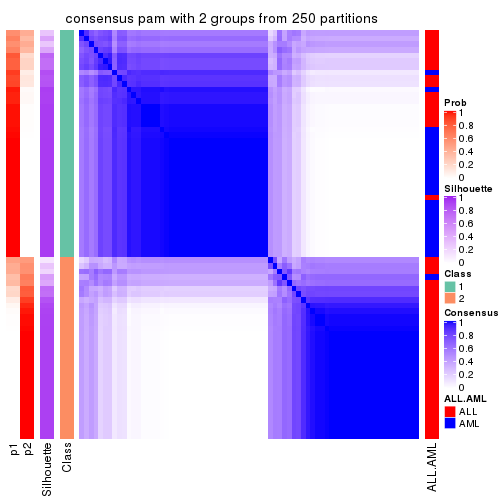
consensus_heatmap(res, k = 3)
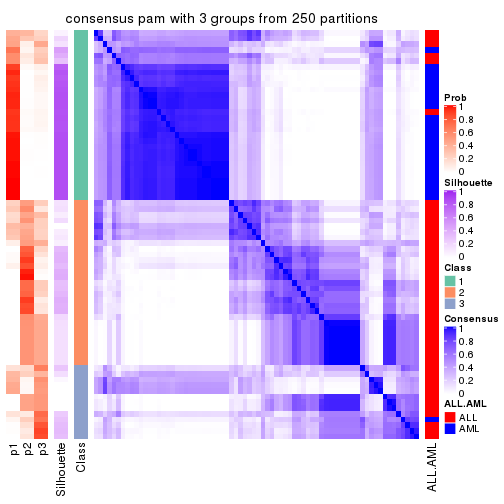
consensus_heatmap(res, k = 4)
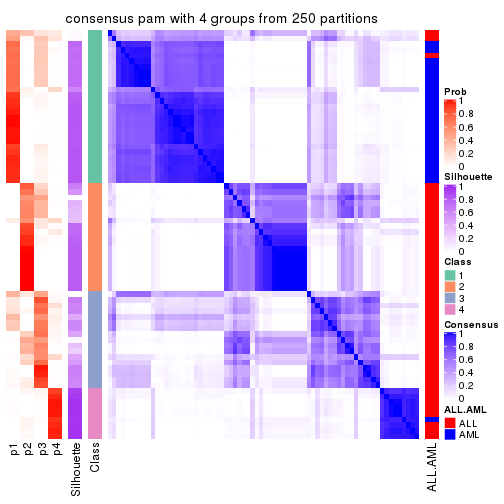
consensus_heatmap(res, k = 5)
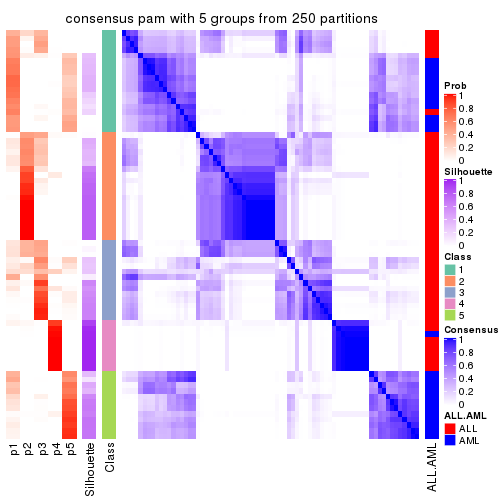
consensus_heatmap(res, k = 6)
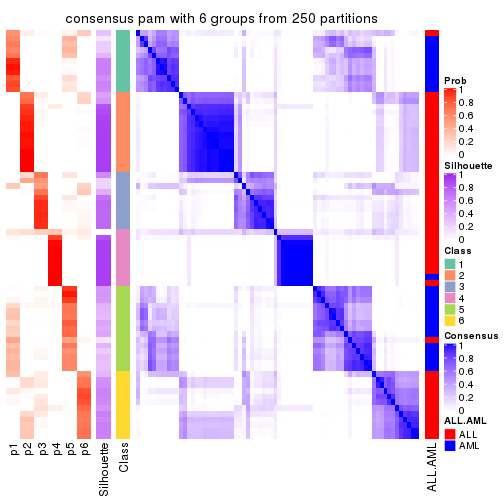
Heatmaps for the membership of samples in all partitions to see how consistent they are:
membership_heatmap(res, k = 2)
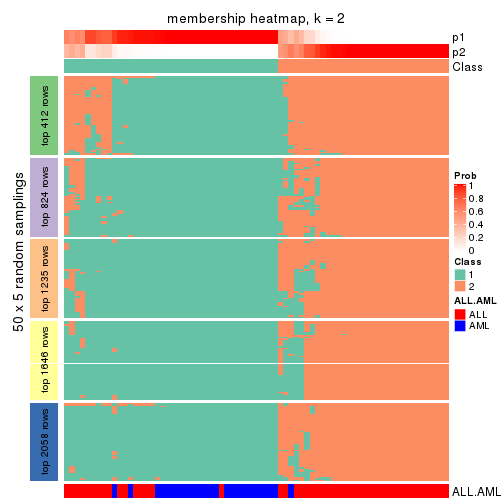
membership_heatmap(res, k = 3)
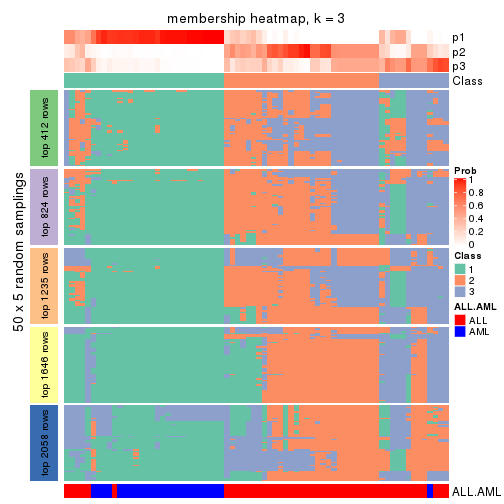
membership_heatmap(res, k = 4)
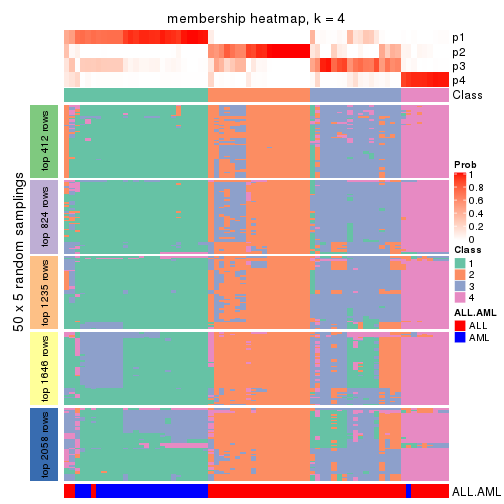
membership_heatmap(res, k = 5)
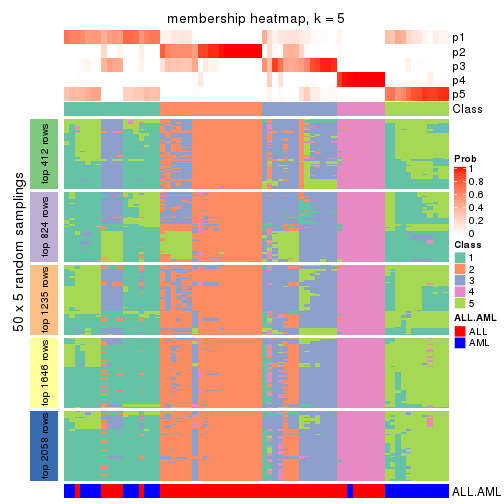
membership_heatmap(res, k = 6)
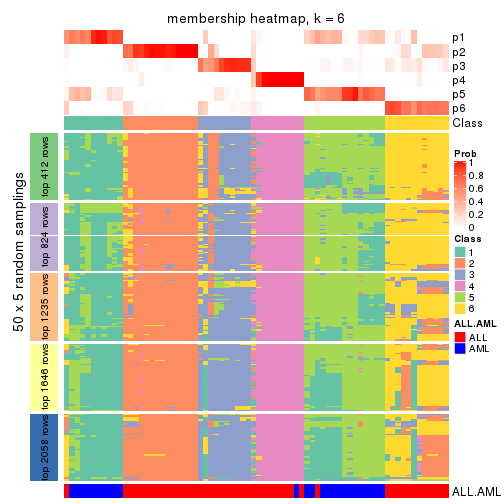
As soon as we have had the classes for columns, we can look for signatures which are significantly different between classes which can be candidate marks for certain classes. Following are the heatmaps for signatures.
Signature heatmaps where rows are scaled:
get_signatures(res, k = 2)
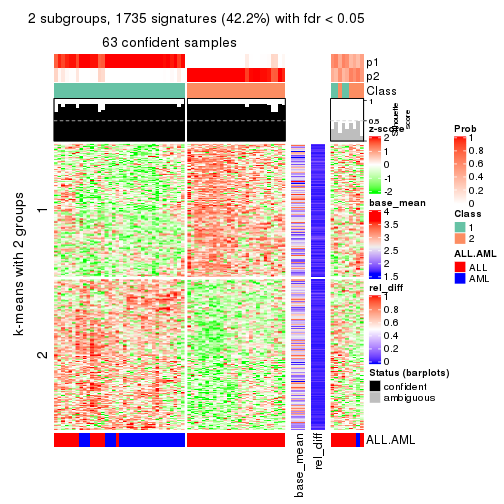
get_signatures(res, k = 3)

get_signatures(res, k = 4)
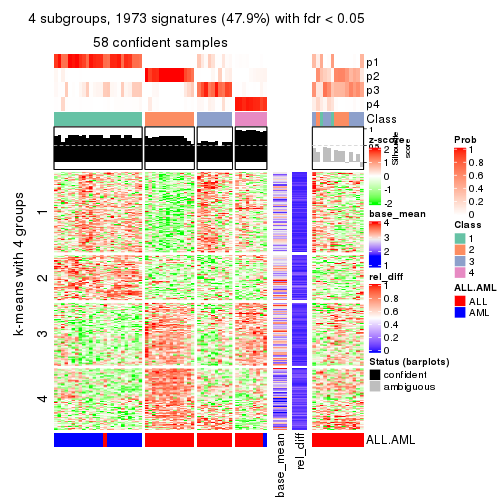
get_signatures(res, k = 5)
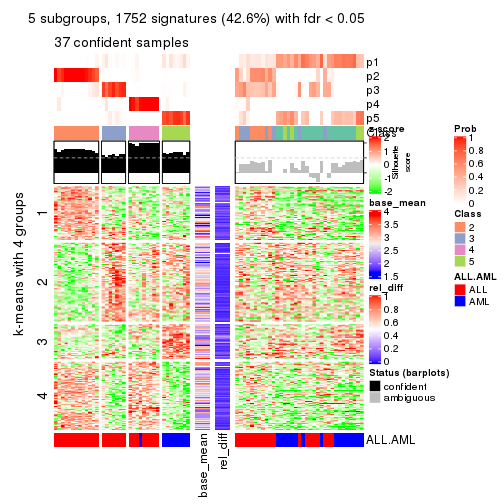
get_signatures(res, k = 6)
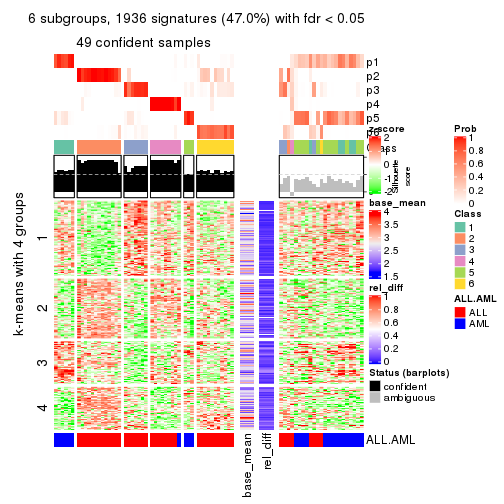
Signature heatmaps where rows are not scaled:
get_signatures(res, k = 2, scale_rows = FALSE)
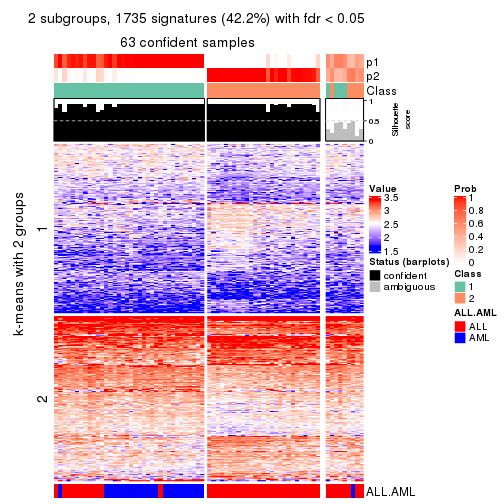
get_signatures(res, k = 3, scale_rows = FALSE)

get_signatures(res, k = 4, scale_rows = FALSE)
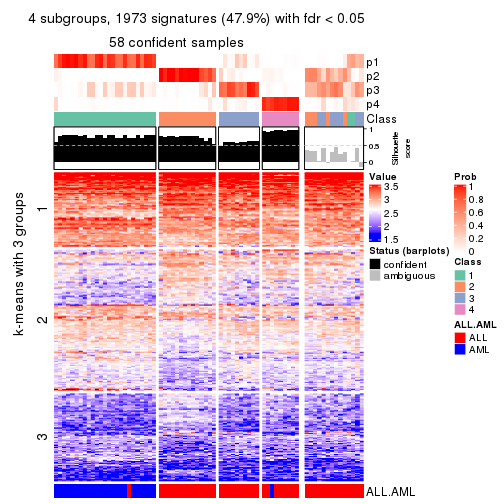
get_signatures(res, k = 5, scale_rows = FALSE)
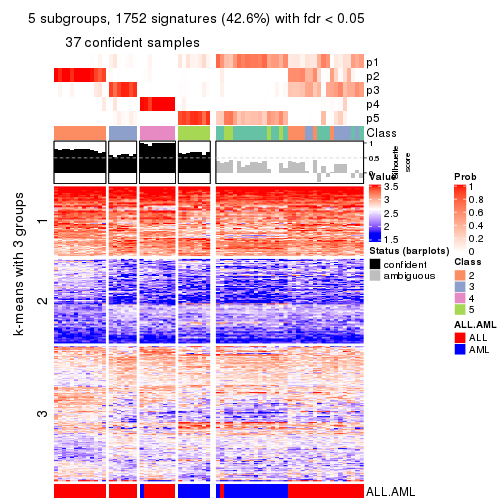
get_signatures(res, k = 6, scale_rows = FALSE)
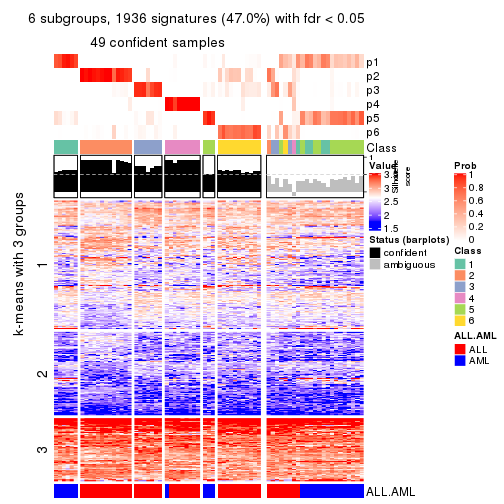
Compare the overlap of signatures from different k:
compare_signatures(res)
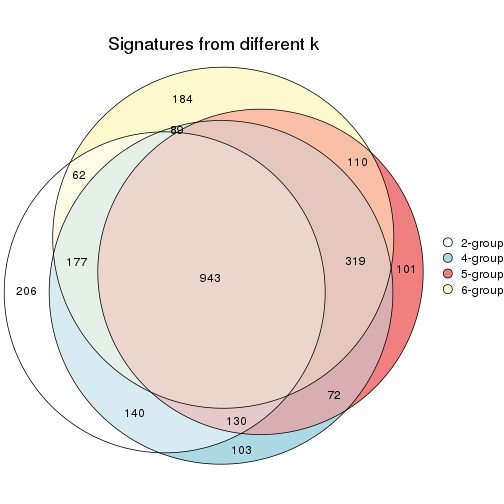
get_signature() returns a data frame invisibly. TO get the list of signatures, the function
call should be assigned to a variable explicitly. In following code, if plot argument is set
to FALSE, no heatmap is plotted while only the differential analysis is performed.
# code only for demonstration
tb = get_signature(res, k = ..., plot = FALSE)
An example of the output of tb is:
#> which_row fdr mean_1 mean_2 scaled_mean_1 scaled_mean_2 km
#> 1 38 0.042760348 8.373488 9.131774 -0.5533452 0.5164555 1
#> 2 40 0.018707592 7.106213 8.469186 -0.6173731 0.5762149 1
#> 3 55 0.019134737 10.221463 11.207825 -0.6159697 0.5749050 1
#> 4 59 0.006059896 5.921854 7.869574 -0.6899429 0.6439467 1
#> 5 60 0.018055526 8.928898 10.211722 -0.6204761 0.5791110 1
#> 6 98 0.009384629 15.714769 14.887706 0.6635654 -0.6193277 2
...
The columns in tb are:
which_row: row indices corresponding to the input matrix.fdr: FDR for the differential test. mean_x: The mean value in group x.scaled_mean_x: The mean value in group x after rows are scaled.km: Row groups if k-means clustering is applied to rows.UMAP plot which shows how samples are separated.
dimension_reduction(res, k = 2, method = "UMAP")
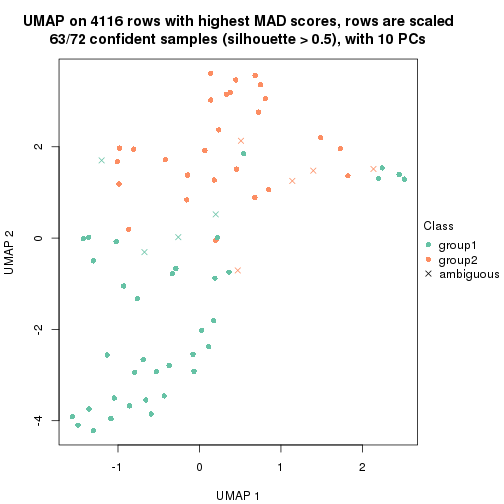
dimension_reduction(res, k = 3, method = "UMAP")
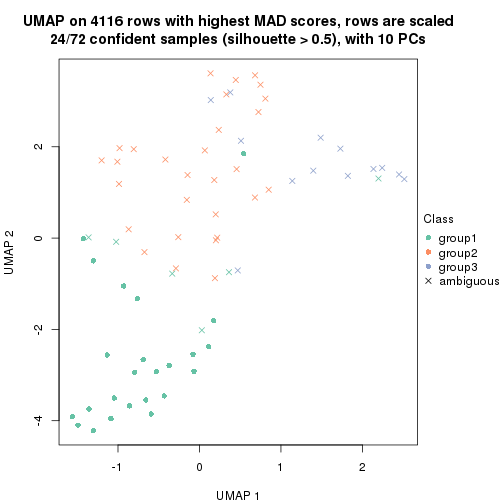
dimension_reduction(res, k = 4, method = "UMAP")
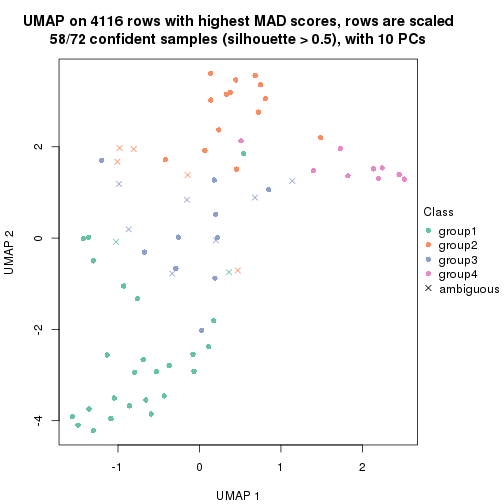
dimension_reduction(res, k = 5, method = "UMAP")
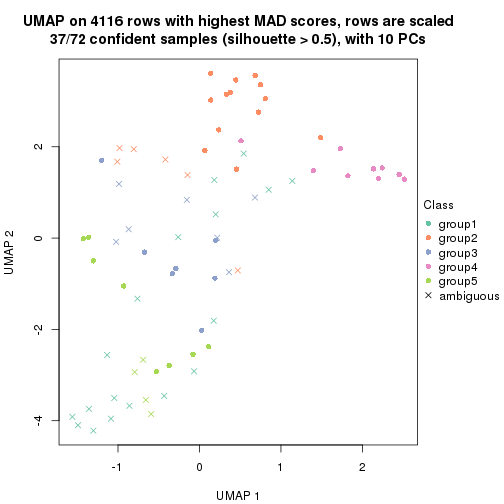
dimension_reduction(res, k = 6, method = "UMAP")
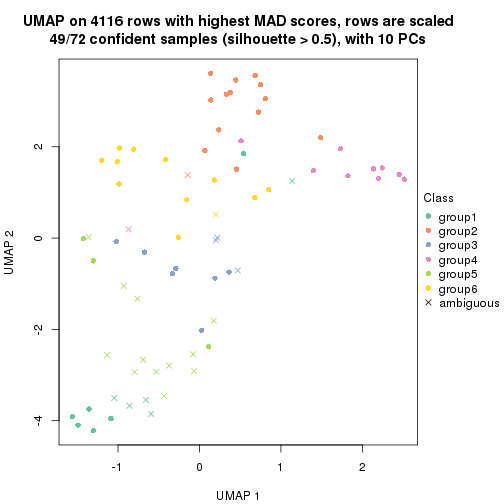
Following heatmap shows how subgroups are split when increasing k:
collect_classes(res)
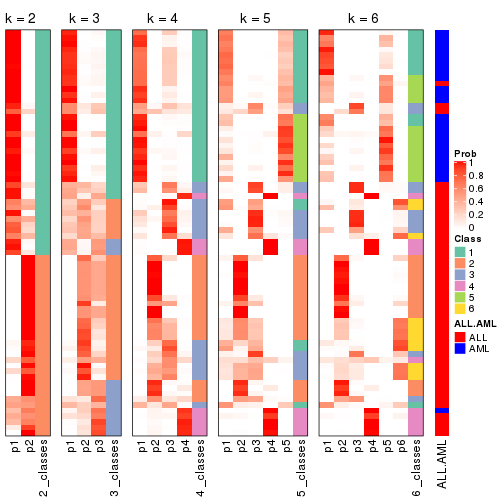
Test correlation between subgroups and known annotations. If the known annotation is numeric, one-way ANOVA test is applied, and if the known annotation is discrete, chi-squared contingency table test is applied.
test_to_known_factors(res)
#> n ALL.AML(p) k
#> MAD:pam 63 2.89e-07 2
#> MAD:pam 24 NA 3
#> MAD:pam 58 6.37e-11 4
#> MAD:pam 37 4.82e-07 5
#> MAD:pam 49 2.89e-08 6
If matrix rows can be associated to genes, consider to use functional_enrichment(res,
...) to perform function enrichment for the signature genes. See this vignette for more detailed explanations.
The object with results only for a single top-value method and a single partition method can be extracted as:
res = res_list["MAD", "mclust"]
# you can also extract it by
# res = res_list["MAD:mclust"]
A summary of res and all the functions that can be applied to it:
res
#> A 'ConsensusPartition' object with k = 2, 3, 4, 5, 6.
#> On a matrix with 4116 rows and 72 columns.
#> Top rows (412, 824, 1235, 1646, 2058) are extracted by 'MAD' method.
#> Subgroups are detected by 'mclust' method.
#> Performed in total 1250 partitions by row resampling.
#> Best k for subgroups seems to be 2.
#>
#> Following methods can be applied to this 'ConsensusPartition' object:
#> [1] "cola_report" "collect_classes" "collect_plots"
#> [4] "collect_stats" "colnames" "compare_signatures"
#> [7] "consensus_heatmap" "dimension_reduction" "functional_enrichment"
#> [10] "get_anno_col" "get_anno" "get_classes"
#> [13] "get_consensus" "get_matrix" "get_membership"
#> [16] "get_param" "get_signatures" "get_stats"
#> [19] "is_best_k" "is_stable_k" "membership_heatmap"
#> [22] "ncol" "nrow" "plot_ecdf"
#> [25] "rownames" "select_partition_number" "show"
#> [28] "suggest_best_k" "test_to_known_factors"
collect_plots() function collects all the plots made from res for all k (number of partitions)
into one single page to provide an easy and fast comparison between different k.
collect_plots(res)
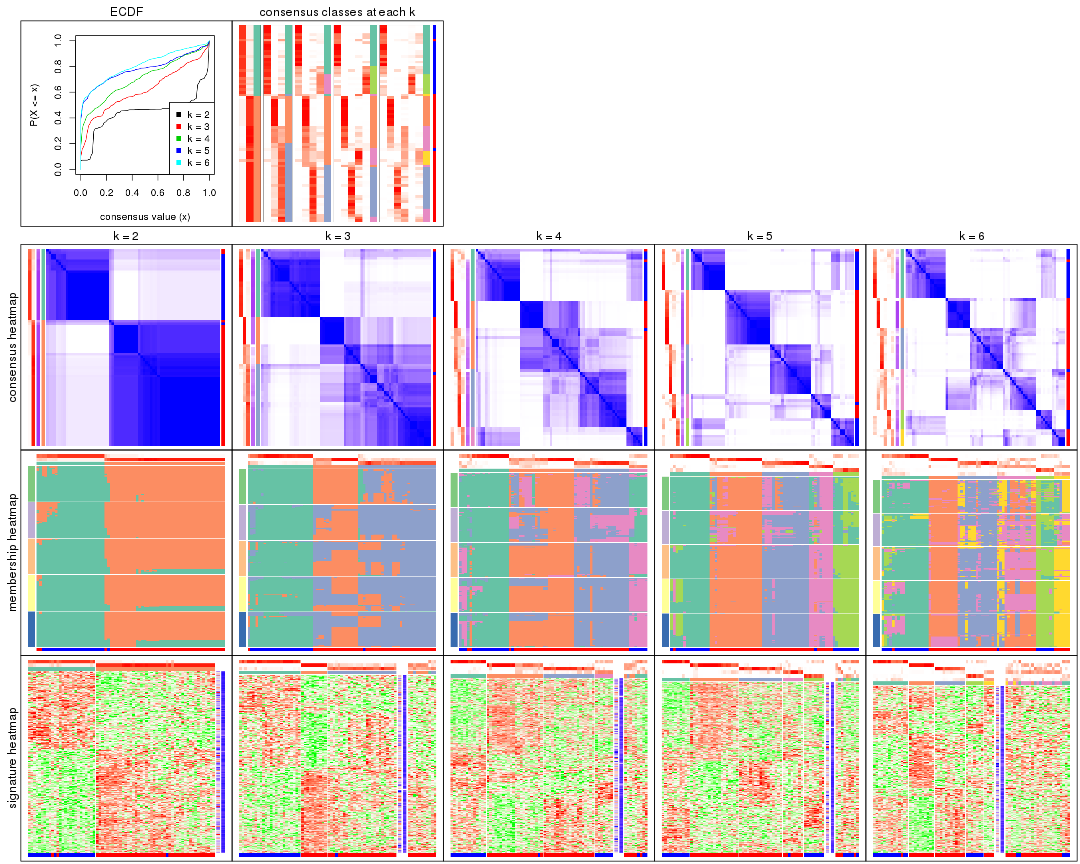
The plots are:
k and the heatmap of
predicted classes for each k.k.k.k.All the plots in panels can be made by individual functions and they are plotted later in this section.
select_partition_number() produces several plots showing different
statistics for choosing “optimized” k. There are following statistics:
k;k, the area increased is defined as \(A_k - A_{k-1}\).The detailed explanations of these statistics can be found in the cola vignette.
Generally speaking, lower PAC score, higher mean silhouette score or higher
concordance corresponds to better partition. Rand index and Jaccard index
measure how similar the current partition is compared to partition with k-1.
If they are too similar, we won't accept k is better than k-1.
select_partition_number(res)
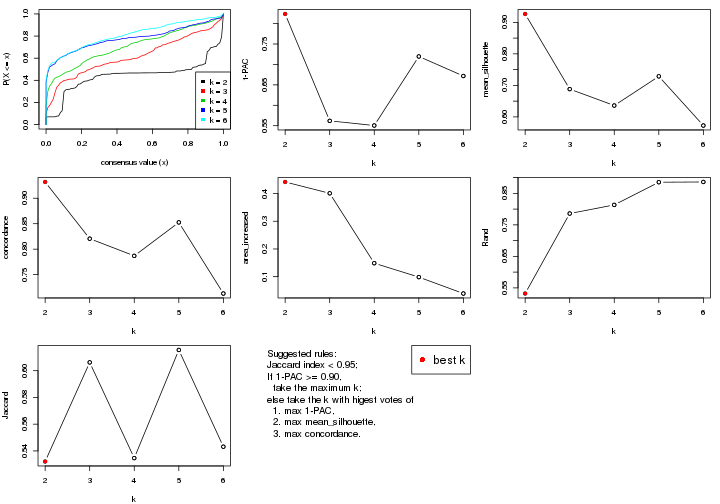
The numeric values for all these statistics can be obtained by get_stats().
get_stats(res)
#> k 1-PAC mean_silhouette concordance area_increased Rand Jaccard
#> 2 2 0.824 0.927 0.932 0.4416 0.532 0.532
#> 3 3 0.562 0.688 0.821 0.4007 0.786 0.606
#> 4 4 0.550 0.636 0.787 0.1485 0.813 0.535
#> 5 5 0.719 0.729 0.853 0.0984 0.885 0.615
#> 6 6 0.672 0.573 0.713 0.0392 0.886 0.543
suggest_best_k() suggests the best \(k\) based on these statistics. The rules are as follows:
suggest_best_k(res)
#> [1] 2
Following shows the table of the partitions (You need to click the show/hide
code output link to see it). The membership matrix (columns with name p*)
is inferred by
clue::cl_consensus()
function with the SE method. Basically the value in the membership matrix
represents the probability to belong to a certain group. The finall class
label for an item is determined with the group with highest probability it
belongs to.
In get_classes() function, the entropy is calculated from the membership
matrix and the silhouette score is calculated from the consensus matrix.
cbind(get_classes(res, k = 2), get_membership(res, k = 2))
#> class entropy silhouette p1 p2
#> sample_39 2 0.1633 0.959 0.024 0.976
#> sample_40 2 0.1633 0.959 0.024 0.976
#> sample_42 2 0.1633 0.959 0.024 0.976
#> sample_47 2 0.1184 0.942 0.016 0.984
#> sample_48 2 0.3733 0.907 0.072 0.928
#> sample_49 2 0.1633 0.959 0.024 0.976
#> sample_41 2 0.3733 0.907 0.072 0.928
#> sample_43 2 0.0938 0.956 0.012 0.988
#> sample_44 2 0.0672 0.954 0.008 0.992
#> sample_45 2 0.0672 0.951 0.008 0.992
#> sample_46 2 0.1184 0.957 0.016 0.984
#> sample_70 2 0.1633 0.959 0.024 0.976
#> sample_71 2 0.1633 0.959 0.024 0.976
#> sample_72 2 0.1633 0.959 0.024 0.976
#> sample_68 2 0.3733 0.907 0.072 0.928
#> sample_69 2 0.3733 0.907 0.072 0.928
#> sample_67 1 0.8661 0.738 0.712 0.288
#> sample_55 2 0.1633 0.959 0.024 0.976
#> sample_56 2 0.1633 0.959 0.024 0.976
#> sample_59 2 0.1633 0.959 0.024 0.976
#> sample_52 1 0.3733 0.950 0.928 0.072
#> sample_53 1 0.3733 0.950 0.928 0.072
#> sample_51 1 0.3733 0.950 0.928 0.072
#> sample_50 1 0.3733 0.950 0.928 0.072
#> sample_54 1 0.8081 0.806 0.752 0.248
#> sample_57 1 0.6247 0.902 0.844 0.156
#> sample_58 1 0.3733 0.950 0.928 0.072
#> sample_60 1 0.8144 0.800 0.748 0.252
#> sample_61 1 0.3733 0.950 0.928 0.072
#> sample_65 1 0.3733 0.950 0.928 0.072
#> sample_66 2 0.6531 0.784 0.168 0.832
#> sample_63 1 0.3733 0.950 0.928 0.072
#> sample_64 1 0.6623 0.889 0.828 0.172
#> sample_62 1 0.4022 0.946 0.920 0.080
#> sample_1 2 0.1633 0.959 0.024 0.976
#> sample_2 2 0.8763 0.527 0.296 0.704
#> sample_3 2 0.1633 0.959 0.024 0.976
#> sample_4 2 0.1633 0.959 0.024 0.976
#> sample_5 2 0.3733 0.907 0.072 0.928
#> sample_6 2 0.1633 0.959 0.024 0.976
#> sample_7 2 0.1633 0.959 0.024 0.976
#> sample_8 2 0.1633 0.959 0.024 0.976
#> sample_9 2 0.1633 0.959 0.024 0.976
#> sample_10 2 0.1633 0.959 0.024 0.976
#> sample_11 2 0.1633 0.959 0.024 0.976
#> sample_12 1 0.8081 0.804 0.752 0.248
#> sample_13 2 0.3733 0.907 0.072 0.928
#> sample_14 2 0.2043 0.951 0.032 0.968
#> sample_15 2 0.3733 0.907 0.072 0.928
#> sample_16 2 0.0376 0.953 0.004 0.996
#> sample_17 2 0.3431 0.923 0.064 0.936
#> sample_18 2 0.1633 0.959 0.024 0.976
#> sample_19 2 0.0376 0.953 0.004 0.996
#> sample_20 2 0.3733 0.907 0.072 0.928
#> sample_21 2 0.3733 0.907 0.072 0.928
#> sample_22 2 0.1633 0.959 0.024 0.976
#> sample_23 2 0.1633 0.959 0.024 0.976
#> sample_24 2 0.3733 0.907 0.072 0.928
#> sample_25 2 0.1633 0.959 0.024 0.976
#> sample_26 2 0.1633 0.959 0.024 0.976
#> sample_27 2 0.1633 0.959 0.024 0.976
#> sample_34 1 0.3733 0.950 0.928 0.072
#> sample_35 1 0.6887 0.878 0.816 0.184
#> sample_36 1 0.3733 0.950 0.928 0.072
#> sample_37 1 0.3733 0.950 0.928 0.072
#> sample_38 1 0.3733 0.950 0.928 0.072
#> sample_28 1 0.3733 0.950 0.928 0.072
#> sample_29 1 0.5946 0.910 0.856 0.144
#> sample_30 1 0.3733 0.950 0.928 0.072
#> sample_31 1 0.3733 0.950 0.928 0.072
#> sample_32 1 0.3733 0.950 0.928 0.072
#> sample_33 1 0.3733 0.950 0.928 0.072
cbind(get_classes(res, k = 3), get_membership(res, k = 3))
#> class entropy silhouette p1 p2 p3
#> sample_39 3 0.4172 0.757 0.004 0.156 0.840
#> sample_40 3 0.4409 0.761 0.004 0.172 0.824
#> sample_42 3 0.5156 0.553 0.008 0.216 0.776
#> sample_47 2 0.6330 0.172 0.004 0.600 0.396
#> sample_48 2 0.0424 0.719 0.000 0.992 0.008
#> sample_49 3 0.4409 0.760 0.004 0.172 0.824
#> sample_41 2 0.0424 0.719 0.000 0.992 0.008
#> sample_43 2 0.6302 -0.194 0.000 0.520 0.480
#> sample_44 2 0.5948 0.299 0.000 0.640 0.360
#> sample_45 2 0.6180 0.116 0.000 0.584 0.416
#> sample_46 2 0.6140 0.167 0.000 0.596 0.404
#> sample_70 3 0.4702 0.747 0.000 0.212 0.788
#> sample_71 3 0.5156 0.553 0.008 0.216 0.776
#> sample_72 3 0.5156 0.553 0.008 0.216 0.776
#> sample_68 2 0.0424 0.719 0.000 0.992 0.008
#> sample_69 2 0.0747 0.715 0.000 0.984 0.016
#> sample_67 3 0.8286 0.281 0.308 0.104 0.588
#> sample_55 3 0.4409 0.761 0.004 0.172 0.824
#> sample_56 3 0.4409 0.760 0.004 0.172 0.824
#> sample_59 3 0.6104 0.585 0.004 0.348 0.648
#> sample_52 1 0.1643 0.926 0.956 0.000 0.044
#> sample_53 1 0.0424 0.910 0.992 0.000 0.008
#> sample_51 1 0.0424 0.910 0.992 0.000 0.008
#> sample_50 1 0.0424 0.910 0.992 0.000 0.008
#> sample_54 1 0.5919 0.649 0.724 0.016 0.260
#> sample_57 1 0.2165 0.918 0.936 0.000 0.064
#> sample_58 1 0.1753 0.925 0.952 0.000 0.048
#> sample_60 1 0.5919 0.652 0.724 0.016 0.260
#> sample_61 1 0.2537 0.917 0.920 0.000 0.080
#> sample_65 1 0.1529 0.926 0.960 0.000 0.040
#> sample_66 3 0.6887 0.539 0.060 0.236 0.704
#> sample_63 1 0.1643 0.926 0.956 0.000 0.044
#> sample_64 1 0.2537 0.909 0.920 0.000 0.080
#> sample_62 1 0.1860 0.924 0.948 0.000 0.052
#> sample_1 3 0.5733 0.614 0.000 0.324 0.676
#> sample_2 3 0.8156 0.380 0.196 0.160 0.644
#> sample_3 3 0.4409 0.760 0.004 0.172 0.824
#> sample_4 3 0.5873 0.623 0.004 0.312 0.684
#> sample_5 2 0.0424 0.719 0.000 0.992 0.008
#> sample_6 3 0.4409 0.760 0.004 0.172 0.824
#> sample_7 3 0.4682 0.755 0.004 0.192 0.804
#> sample_8 3 0.4575 0.762 0.004 0.184 0.812
#> sample_9 3 0.5529 0.673 0.000 0.296 0.704
#> sample_10 3 0.3500 0.743 0.004 0.116 0.880
#> sample_11 3 0.4291 0.609 0.008 0.152 0.840
#> sample_12 1 0.6295 0.355 0.528 0.000 0.472
#> sample_13 2 0.0424 0.719 0.000 0.992 0.008
#> sample_14 3 0.6033 0.624 0.004 0.336 0.660
#> sample_15 2 0.0424 0.719 0.000 0.992 0.008
#> sample_16 2 0.5948 0.299 0.000 0.640 0.360
#> sample_17 3 0.6359 0.507 0.004 0.404 0.592
#> sample_18 3 0.4409 0.761 0.004 0.172 0.824
#> sample_19 2 0.6026 0.258 0.000 0.624 0.376
#> sample_20 2 0.0424 0.719 0.000 0.992 0.008
#> sample_21 2 0.0592 0.717 0.000 0.988 0.012
#> sample_22 3 0.1170 0.661 0.008 0.016 0.976
#> sample_23 3 0.4351 0.761 0.004 0.168 0.828
#> sample_24 2 0.0424 0.719 0.000 0.992 0.008
#> sample_25 3 0.3043 0.657 0.008 0.084 0.908
#> sample_26 3 0.6140 0.493 0.000 0.404 0.596
#> sample_27 3 0.4409 0.760 0.004 0.172 0.824
#> sample_34 1 0.1643 0.926 0.956 0.000 0.044
#> sample_35 1 0.2796 0.904 0.908 0.000 0.092
#> sample_36 1 0.0237 0.909 0.996 0.000 0.004
#> sample_37 1 0.0424 0.910 0.992 0.000 0.008
#> sample_38 1 0.2261 0.923 0.932 0.000 0.068
#> sample_28 1 0.1753 0.921 0.952 0.000 0.048
#> sample_29 1 0.4974 0.799 0.764 0.000 0.236
#> sample_30 1 0.0892 0.908 0.980 0.000 0.020
#> sample_31 1 0.1643 0.926 0.956 0.000 0.044
#> sample_32 1 0.1753 0.926 0.952 0.000 0.048
#> sample_33 1 0.1163 0.920 0.972 0.000 0.028
cbind(get_classes(res, k = 4), get_membership(res, k = 4))
#> class entropy silhouette p1 p2 p3 p4
#> sample_39 3 0.4567 0.724 0.000 0.008 0.716 0.276
#> sample_40 3 0.1389 0.827 0.000 0.000 0.952 0.048
#> sample_42 2 0.7838 0.525 0.008 0.476 0.224 0.292
#> sample_47 2 0.4079 0.734 0.000 0.800 0.180 0.020
#> sample_48 2 0.0188 0.744 0.000 0.996 0.004 0.000
#> sample_49 3 0.1022 0.829 0.000 0.000 0.968 0.032
#> sample_41 2 0.0376 0.743 0.000 0.992 0.004 0.004
#> sample_43 2 0.5929 0.697 0.000 0.688 0.204 0.108
#> sample_44 2 0.4361 0.726 0.000 0.772 0.208 0.020
#> sample_45 2 0.6908 0.646 0.000 0.592 0.188 0.220
#> sample_46 2 0.6457 0.679 0.000 0.644 0.200 0.156
#> sample_70 3 0.4452 0.735 0.000 0.008 0.732 0.260
#> sample_71 2 0.7838 0.525 0.008 0.476 0.224 0.292
#> sample_72 2 0.7838 0.525 0.008 0.476 0.224 0.292
#> sample_68 2 0.0188 0.744 0.000 0.996 0.004 0.000
#> sample_69 2 0.0592 0.746 0.000 0.984 0.016 0.000
#> sample_67 1 0.8753 -0.147 0.428 0.328 0.180 0.064
#> sample_55 3 0.1211 0.822 0.000 0.000 0.960 0.040
#> sample_56 3 0.1211 0.829 0.000 0.000 0.960 0.040
#> sample_59 3 0.4500 0.678 0.000 0.192 0.776 0.032
#> sample_52 4 0.4991 0.766 0.388 0.000 0.004 0.608
#> sample_53 1 0.0000 0.732 1.000 0.000 0.000 0.000
#> sample_51 1 0.0000 0.732 1.000 0.000 0.000 0.000
#> sample_50 1 0.0000 0.732 1.000 0.000 0.000 0.000
#> sample_54 4 0.6714 0.686 0.208 0.000 0.176 0.616
#> sample_57 4 0.5339 0.788 0.356 0.000 0.020 0.624
#> sample_58 1 0.6060 -0.538 0.516 0.000 0.044 0.440
#> sample_60 4 0.6617 0.682 0.196 0.000 0.176 0.628
#> sample_61 1 0.3674 0.611 0.852 0.000 0.104 0.044
#> sample_65 1 0.1854 0.701 0.940 0.000 0.012 0.048
#> sample_66 2 0.7014 0.520 0.036 0.520 0.396 0.048
#> sample_63 4 0.5080 0.723 0.420 0.000 0.004 0.576
#> sample_64 4 0.6840 0.694 0.372 0.000 0.108 0.520
#> sample_62 4 0.5055 0.781 0.368 0.000 0.008 0.624
#> sample_1 3 0.4261 0.758 0.000 0.112 0.820 0.068
#> sample_2 2 0.9083 0.483 0.216 0.464 0.208 0.112
#> sample_3 3 0.1557 0.816 0.000 0.000 0.944 0.056
#> sample_4 3 0.2174 0.806 0.000 0.052 0.928 0.020
#> sample_5 2 0.0188 0.744 0.000 0.996 0.004 0.000
#> sample_6 3 0.1557 0.816 0.000 0.000 0.944 0.056
#> sample_7 3 0.1743 0.817 0.000 0.004 0.940 0.056
#> sample_8 3 0.3837 0.766 0.000 0.000 0.776 0.224
#> sample_9 3 0.5497 -0.392 0.000 0.460 0.524 0.016
#> sample_10 3 0.1339 0.814 0.004 0.024 0.964 0.008
#> sample_11 2 0.5902 0.418 0.008 0.492 0.480 0.020
#> sample_12 1 0.5256 0.402 0.732 0.000 0.204 0.064
#> sample_13 2 0.0188 0.744 0.000 0.996 0.004 0.000
#> sample_14 2 0.5678 0.479 0.000 0.524 0.452 0.024
#> sample_15 2 0.0188 0.744 0.000 0.996 0.004 0.000
#> sample_16 2 0.4323 0.727 0.000 0.776 0.204 0.020
#> sample_17 2 0.5344 0.664 0.000 0.668 0.300 0.032
#> sample_18 3 0.0895 0.820 0.000 0.004 0.976 0.020
#> sample_19 2 0.5062 0.727 0.000 0.752 0.184 0.064
#> sample_20 2 0.0188 0.744 0.000 0.996 0.004 0.000
#> sample_21 2 0.0336 0.745 0.000 0.992 0.008 0.000
#> sample_22 3 0.5034 0.714 0.008 0.012 0.700 0.280
#> sample_23 3 0.1557 0.816 0.000 0.000 0.944 0.056
#> sample_24 2 0.0376 0.743 0.000 0.992 0.004 0.004
#> sample_25 3 0.5672 0.687 0.008 0.036 0.668 0.288
#> sample_26 3 0.5966 0.658 0.000 0.072 0.648 0.280
#> sample_27 3 0.0921 0.828 0.000 0.000 0.972 0.028
#> sample_34 1 0.2334 0.655 0.908 0.000 0.004 0.088
#> sample_35 1 0.7602 -0.233 0.420 0.000 0.380 0.200
#> sample_36 1 0.0000 0.732 1.000 0.000 0.000 0.000
#> sample_37 1 0.0000 0.732 1.000 0.000 0.000 0.000
#> sample_38 1 0.1256 0.718 0.964 0.000 0.028 0.008
#> sample_28 1 0.0779 0.726 0.980 0.000 0.004 0.016
#> sample_29 1 0.1675 0.698 0.948 0.004 0.044 0.004
#> sample_30 1 0.0000 0.732 1.000 0.000 0.000 0.000
#> sample_31 1 0.5800 -0.447 0.548 0.000 0.032 0.420
#> sample_32 1 0.1452 0.718 0.956 0.000 0.008 0.036
#> sample_33 1 0.0000 0.732 1.000 0.000 0.000 0.000
cbind(get_classes(res, k = 5), get_membership(res, k = 5))
#> class entropy silhouette p1 p2 p3 p4 p5
#> sample_39 3 0.4384 0.642 0.000 0.000 0.660 0.324 0.016
#> sample_40 3 0.0932 0.842 0.000 0.004 0.972 0.020 0.004
#> sample_42 4 0.0290 0.773 0.000 0.008 0.000 0.992 0.000
#> sample_47 2 0.1704 0.863 0.000 0.928 0.000 0.068 0.004
#> sample_48 2 0.0000 0.878 0.000 1.000 0.000 0.000 0.000
#> sample_49 3 0.1845 0.843 0.000 0.000 0.928 0.056 0.016
#> sample_41 2 0.0162 0.878 0.000 0.996 0.000 0.000 0.004
#> sample_43 2 0.3048 0.802 0.000 0.820 0.004 0.176 0.000
#> sample_44 2 0.2474 0.854 0.000 0.896 0.012 0.084 0.008
#> sample_45 2 0.3814 0.698 0.000 0.720 0.000 0.276 0.004
#> sample_46 2 0.3790 0.728 0.000 0.744 0.004 0.248 0.004
#> sample_70 3 0.3895 0.660 0.000 0.000 0.680 0.320 0.000
#> sample_71 4 0.0290 0.773 0.000 0.008 0.000 0.992 0.000
#> sample_72 4 0.0290 0.773 0.000 0.008 0.000 0.992 0.000
#> sample_68 2 0.0000 0.878 0.000 1.000 0.000 0.000 0.000
#> sample_69 2 0.0404 0.877 0.000 0.988 0.000 0.012 0.000
#> sample_67 4 0.4081 0.459 0.296 0.004 0.000 0.696 0.004
#> sample_55 3 0.0451 0.839 0.000 0.004 0.988 0.008 0.000
#> sample_56 3 0.1914 0.843 0.000 0.000 0.924 0.060 0.016
#> sample_59 3 0.4835 0.684 0.000 0.188 0.724 0.084 0.004
#> sample_52 5 0.3395 0.732 0.236 0.000 0.000 0.000 0.764
#> sample_53 1 0.0000 0.832 1.000 0.000 0.000 0.000 0.000
#> sample_51 1 0.0000 0.832 1.000 0.000 0.000 0.000 0.000
#> sample_50 1 0.0000 0.832 1.000 0.000 0.000 0.000 0.000
#> sample_54 5 0.1179 0.648 0.004 0.000 0.016 0.016 0.964
#> sample_57 5 0.2516 0.744 0.140 0.000 0.000 0.000 0.860
#> sample_58 5 0.4367 0.509 0.416 0.000 0.000 0.004 0.580
#> sample_60 5 0.1278 0.644 0.004 0.000 0.020 0.016 0.960
#> sample_61 1 0.4199 0.433 0.692 0.000 0.004 0.008 0.296
#> sample_65 1 0.3969 0.425 0.692 0.000 0.000 0.004 0.304
#> sample_66 4 0.7002 0.517 0.004 0.224 0.116 0.576 0.080
#> sample_63 5 0.3983 0.640 0.340 0.000 0.000 0.000 0.660
#> sample_64 5 0.3475 0.752 0.180 0.000 0.004 0.012 0.804
#> sample_62 5 0.2813 0.751 0.168 0.000 0.000 0.000 0.832
#> sample_1 3 0.4294 0.770 0.000 0.112 0.788 0.092 0.008
#> sample_2 4 0.3828 0.640 0.184 0.008 0.000 0.788 0.020
#> sample_3 3 0.0000 0.833 0.000 0.000 1.000 0.000 0.000
#> sample_4 3 0.3085 0.820 0.000 0.060 0.868 0.068 0.004
#> sample_5 2 0.0000 0.878 0.000 1.000 0.000 0.000 0.000
#> sample_6 3 0.0000 0.833 0.000 0.000 1.000 0.000 0.000
#> sample_7 3 0.0324 0.834 0.000 0.004 0.992 0.000 0.004
#> sample_8 3 0.3596 0.773 0.000 0.000 0.784 0.200 0.016
#> sample_9 2 0.6741 0.196 0.000 0.456 0.396 0.116 0.032
#> sample_10 3 0.4009 0.489 0.000 0.004 0.684 0.312 0.000
#> sample_11 4 0.4805 0.570 0.000 0.032 0.268 0.688 0.012
#> sample_12 1 0.4639 0.420 0.636 0.000 0.008 0.344 0.012
#> sample_13 2 0.0000 0.878 0.000 1.000 0.000 0.000 0.000
#> sample_14 2 0.5971 0.647 0.000 0.676 0.168 0.068 0.088
#> sample_15 2 0.0000 0.878 0.000 1.000 0.000 0.000 0.000
#> sample_16 2 0.1983 0.864 0.000 0.924 0.008 0.060 0.008
#> sample_17 2 0.4523 0.792 0.000 0.796 0.056 0.068 0.080
#> sample_18 3 0.1544 0.837 0.000 0.000 0.932 0.068 0.000
#> sample_19 2 0.2719 0.827 0.000 0.852 0.000 0.144 0.004
#> sample_20 2 0.0000 0.878 0.000 1.000 0.000 0.000 0.000
#> sample_21 2 0.0162 0.878 0.000 0.996 0.000 0.000 0.004
#> sample_22 4 0.3883 0.553 0.000 0.004 0.216 0.764 0.016
#> sample_23 3 0.0162 0.836 0.000 0.000 0.996 0.004 0.000
#> sample_24 2 0.0162 0.878 0.000 0.996 0.000 0.000 0.004
#> sample_25 4 0.1768 0.733 0.000 0.004 0.072 0.924 0.000
#> sample_26 3 0.5168 0.542 0.000 0.052 0.592 0.356 0.000
#> sample_27 3 0.1845 0.843 0.000 0.000 0.928 0.056 0.016
#> sample_34 1 0.4066 0.368 0.672 0.000 0.000 0.004 0.324
#> sample_35 5 0.6696 0.424 0.328 0.000 0.216 0.004 0.452
#> sample_36 1 0.0000 0.832 1.000 0.000 0.000 0.000 0.000
#> sample_37 1 0.0000 0.832 1.000 0.000 0.000 0.000 0.000
#> sample_38 1 0.0324 0.830 0.992 0.000 0.000 0.004 0.004
#> sample_28 1 0.0324 0.830 0.992 0.000 0.000 0.004 0.004
#> sample_29 1 0.2130 0.756 0.908 0.000 0.000 0.080 0.012
#> sample_30 1 0.0000 0.832 1.000 0.000 0.000 0.000 0.000
#> sample_31 5 0.4383 0.492 0.424 0.000 0.000 0.004 0.572
#> sample_32 1 0.3074 0.635 0.804 0.000 0.000 0.000 0.196
#> sample_33 1 0.0000 0.832 1.000 0.000 0.000 0.000 0.000
cbind(get_classes(res, k = 6), get_membership(res, k = 6))
#> class entropy silhouette p1 p2 p3 p4 p5 p6
#> sample_39 3 0.5197 0.6276 0.000 0.000 0.632 0.168 0.004 0.196
#> sample_40 3 0.2408 0.7669 0.000 0.004 0.892 0.076 0.004 0.024
#> sample_42 6 0.3851 0.7282 0.000 0.000 0.000 0.460 0.000 0.540
#> sample_47 2 0.3991 -0.3136 0.000 0.524 0.000 0.472 0.000 0.004
#> sample_48 2 0.0547 0.9036 0.000 0.980 0.000 0.020 0.000 0.000
#> sample_49 3 0.3123 0.7550 0.000 0.000 0.824 0.040 0.000 0.136
#> sample_41 2 0.0547 0.8971 0.000 0.980 0.000 0.020 0.000 0.000
#> sample_43 4 0.3950 0.3629 0.000 0.432 0.000 0.564 0.000 0.004
#> sample_44 4 0.4127 0.2979 0.000 0.484 0.004 0.508 0.000 0.004
#> sample_45 4 0.4473 0.4077 0.000 0.380 0.000 0.584 0.000 0.036
#> sample_46 4 0.4437 0.4001 0.000 0.392 0.000 0.576 0.000 0.032
#> sample_70 3 0.5844 0.2844 0.000 0.024 0.448 0.436 0.004 0.088
#> sample_71 6 0.3851 0.7282 0.000 0.000 0.000 0.460 0.000 0.540
#> sample_72 6 0.3851 0.7282 0.000 0.000 0.000 0.460 0.000 0.540
#> sample_68 2 0.0000 0.9078 0.000 1.000 0.000 0.000 0.000 0.000
#> sample_69 2 0.0713 0.8977 0.000 0.972 0.000 0.028 0.000 0.000
#> sample_67 6 0.6827 0.4710 0.268 0.000 0.000 0.248 0.056 0.428
#> sample_55 3 0.2504 0.7241 0.000 0.004 0.856 0.136 0.000 0.004
#> sample_56 3 0.3252 0.7658 0.000 0.000 0.824 0.068 0.000 0.108
#> sample_59 4 0.5515 0.2445 0.000 0.152 0.320 0.528 0.000 0.000
#> sample_52 5 0.3290 0.7673 0.252 0.000 0.000 0.000 0.744 0.004
#> sample_53 1 0.0458 0.7732 0.984 0.000 0.000 0.000 0.016 0.000
#> sample_51 1 0.0146 0.7737 0.996 0.000 0.000 0.000 0.004 0.000
#> sample_50 1 0.0363 0.7726 0.988 0.000 0.000 0.000 0.012 0.000
#> sample_54 5 0.1121 0.6817 0.004 0.000 0.008 0.016 0.964 0.008
#> sample_57 5 0.2703 0.8014 0.172 0.000 0.000 0.000 0.824 0.004
#> sample_58 1 0.5538 0.1468 0.512 0.000 0.000 0.000 0.340 0.148
#> sample_60 5 0.1026 0.6853 0.004 0.000 0.008 0.012 0.968 0.008
#> sample_61 1 0.4127 0.6794 0.684 0.000 0.004 0.000 0.028 0.284
#> sample_65 1 0.3834 0.6936 0.732 0.000 0.000 0.000 0.036 0.232
#> sample_66 4 0.8230 -0.4875 0.024 0.108 0.076 0.356 0.088 0.348
#> sample_63 5 0.3699 0.6287 0.336 0.000 0.000 0.000 0.660 0.004
#> sample_64 5 0.4787 0.7285 0.212 0.000 0.004 0.004 0.684 0.096
#> sample_62 5 0.2854 0.7983 0.208 0.000 0.000 0.000 0.792 0.000
#> sample_1 3 0.5777 0.0575 0.000 0.112 0.440 0.432 0.000 0.016
#> sample_2 6 0.6970 0.6473 0.148 0.020 0.000 0.308 0.060 0.464
#> sample_3 3 0.0146 0.7653 0.000 0.000 0.996 0.004 0.000 0.000
#> sample_4 4 0.5546 0.0590 0.000 0.092 0.396 0.500 0.008 0.004
#> sample_5 2 0.0000 0.9078 0.000 1.000 0.000 0.000 0.000 0.000
#> sample_6 3 0.0146 0.7653 0.000 0.000 0.996 0.004 0.000 0.000
#> sample_7 3 0.1843 0.7559 0.000 0.004 0.912 0.080 0.000 0.004
#> sample_8 3 0.4778 0.6812 0.000 0.000 0.680 0.116 0.004 0.200
#> sample_9 4 0.6567 0.4302 0.000 0.192 0.280 0.488 0.012 0.028
#> sample_10 3 0.4287 0.5791 0.008 0.000 0.728 0.216 0.008 0.040
#> sample_11 6 0.6887 0.4751 0.000 0.028 0.248 0.344 0.012 0.368
#> sample_12 1 0.5634 0.6294 0.664 0.000 0.052 0.096 0.012 0.176
#> sample_13 2 0.0547 0.9036 0.000 0.980 0.000 0.020 0.000 0.000
#> sample_14 4 0.6949 0.4485 0.000 0.292 0.128 0.488 0.068 0.024
#> sample_15 2 0.0000 0.9078 0.000 1.000 0.000 0.000 0.000 0.000
#> sample_16 4 0.4468 0.2980 0.000 0.484 0.020 0.492 0.000 0.004
#> sample_17 4 0.6501 0.4171 0.000 0.356 0.076 0.480 0.076 0.012
#> sample_18 3 0.4374 0.4665 0.000 0.016 0.632 0.340 0.008 0.004
#> sample_19 4 0.4076 0.3324 0.000 0.452 0.000 0.540 0.000 0.008
#> sample_20 2 0.0547 0.9036 0.000 0.980 0.000 0.020 0.000 0.000
#> sample_21 2 0.0363 0.9019 0.000 0.988 0.000 0.012 0.000 0.000
#> sample_22 4 0.6635 -0.3592 0.020 0.000 0.336 0.368 0.004 0.272
#> sample_23 3 0.0692 0.7675 0.000 0.000 0.976 0.020 0.000 0.004
#> sample_24 2 0.0547 0.8971 0.000 0.980 0.000 0.020 0.000 0.000
#> sample_25 4 0.5877 -0.5955 0.004 0.000 0.172 0.444 0.000 0.380
#> sample_26 4 0.5456 0.2776 0.000 0.064 0.216 0.648 0.000 0.072
#> sample_27 3 0.2983 0.7542 0.000 0.000 0.832 0.032 0.000 0.136
#> sample_34 1 0.4305 0.6559 0.708 0.000 0.000 0.000 0.076 0.216
#> sample_35 1 0.7194 0.2767 0.440 0.000 0.196 0.000 0.136 0.228
#> sample_36 1 0.0363 0.7726 0.988 0.000 0.000 0.000 0.012 0.000
#> sample_37 1 0.0363 0.7726 0.988 0.000 0.000 0.000 0.012 0.000
#> sample_38 1 0.1701 0.7641 0.920 0.000 0.000 0.000 0.008 0.072
#> sample_28 1 0.1812 0.7619 0.912 0.000 0.000 0.000 0.008 0.080
#> sample_29 1 0.5160 0.4802 0.672 0.000 0.000 0.040 0.080 0.208
#> sample_30 1 0.0363 0.7726 0.988 0.000 0.000 0.000 0.012 0.000
#> sample_31 1 0.5643 0.3611 0.536 0.000 0.000 0.000 0.248 0.216
#> sample_32 1 0.3269 0.7327 0.792 0.000 0.000 0.000 0.024 0.184
#> sample_33 1 0.0000 0.7740 1.000 0.000 0.000 0.000 0.000 0.000
Heatmaps for the consensus matrix. It visualizes the probability of two samples to be in a same group.
consensus_heatmap(res, k = 2)
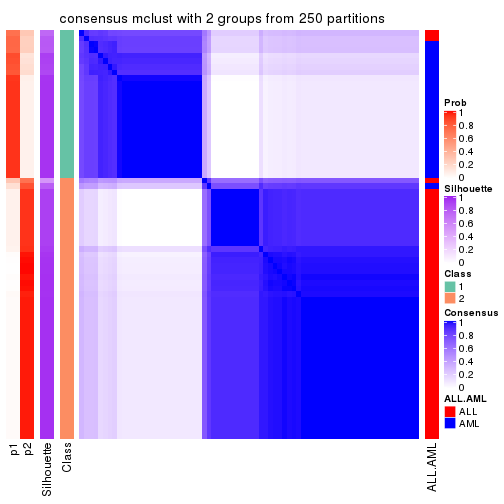
consensus_heatmap(res, k = 3)
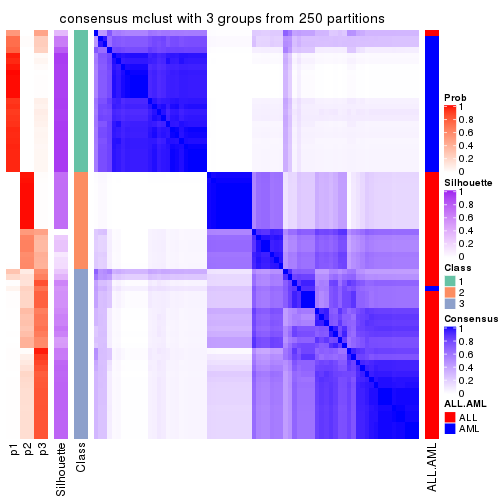
consensus_heatmap(res, k = 4)
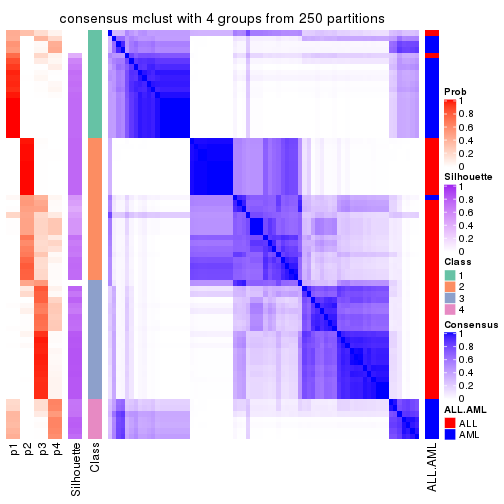
consensus_heatmap(res, k = 5)
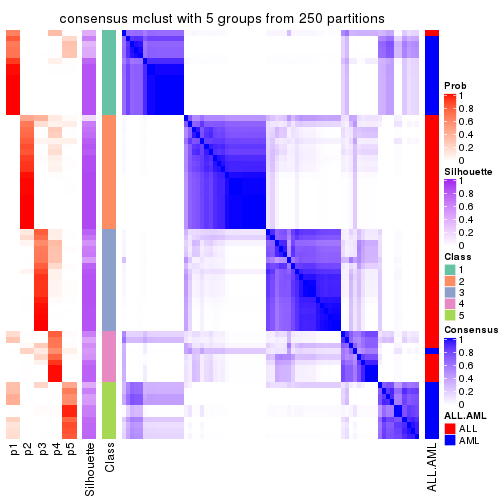
consensus_heatmap(res, k = 6)
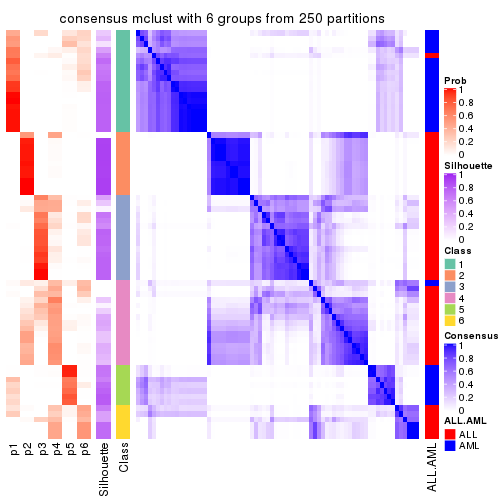
Heatmaps for the membership of samples in all partitions to see how consistent they are:
membership_heatmap(res, k = 2)
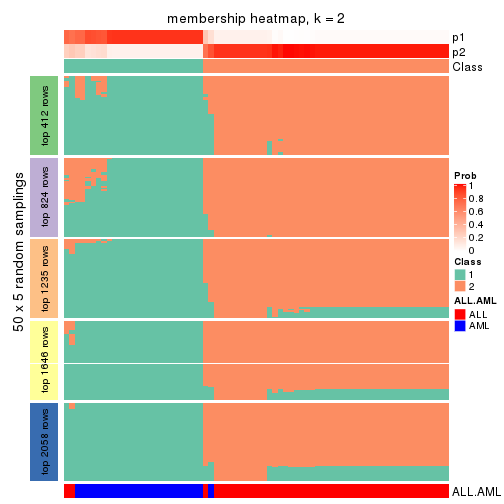
membership_heatmap(res, k = 3)
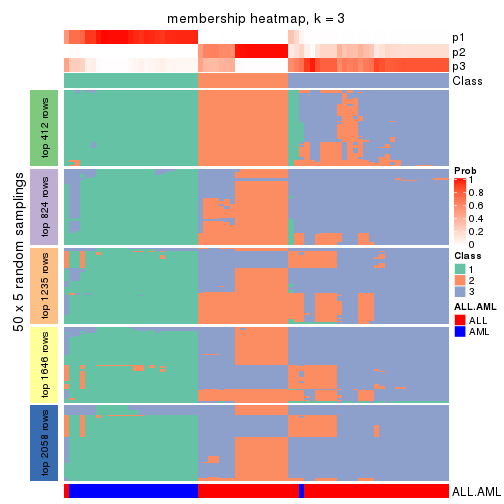
membership_heatmap(res, k = 4)
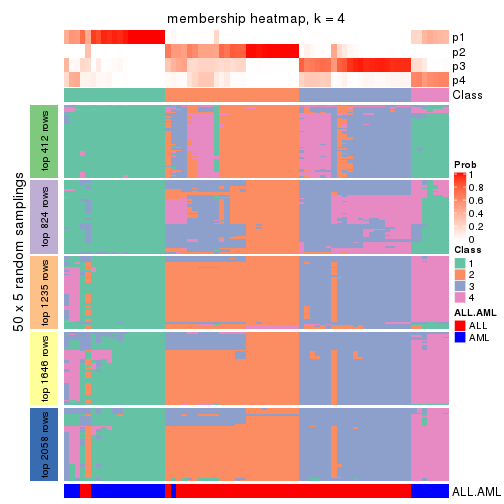
membership_heatmap(res, k = 5)
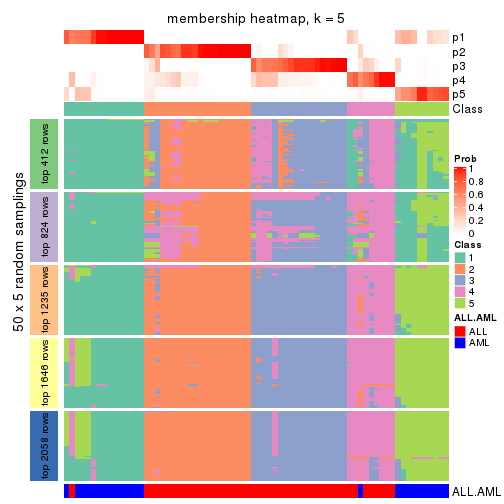
membership_heatmap(res, k = 6)
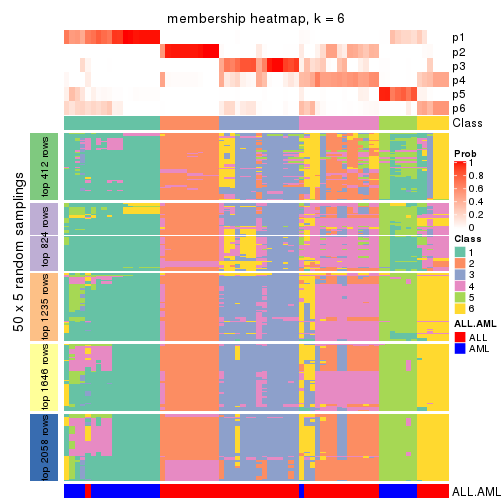
As soon as we have had the classes for columns, we can look for signatures which are significantly different between classes which can be candidate marks for certain classes. Following are the heatmaps for signatures.
Signature heatmaps where rows are scaled:
get_signatures(res, k = 2)
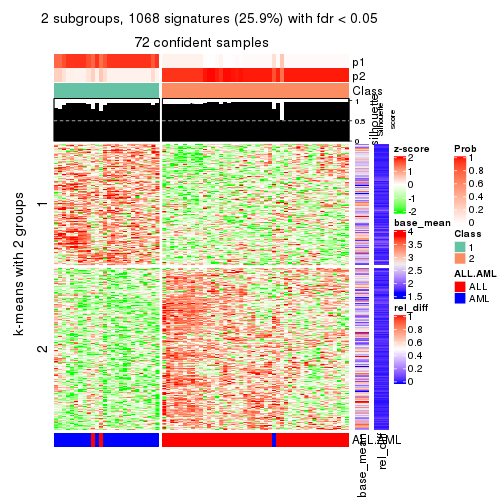
get_signatures(res, k = 3)
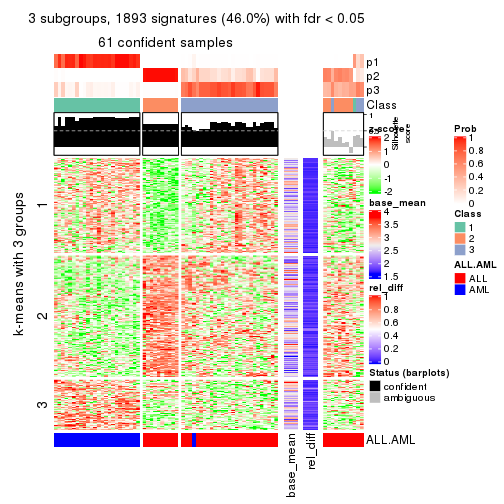
get_signatures(res, k = 4)
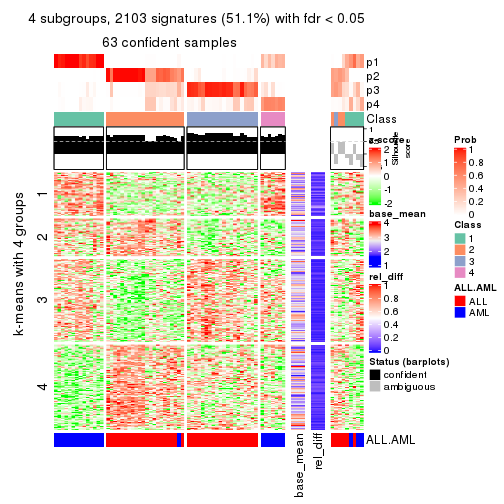
get_signatures(res, k = 5)
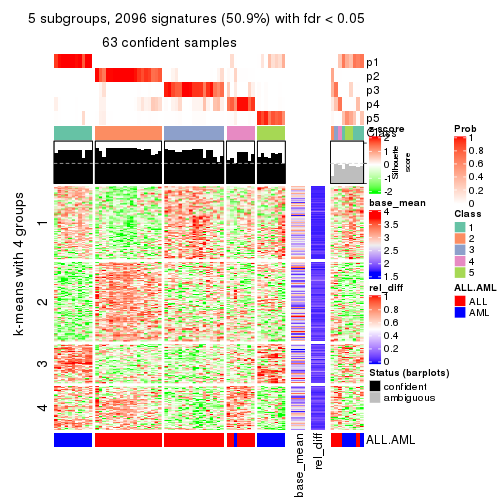
get_signatures(res, k = 6)
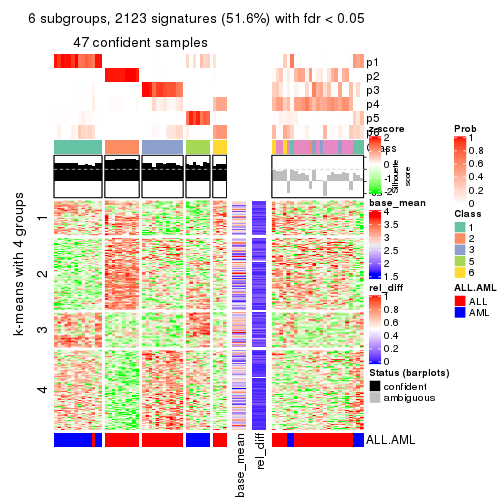
Signature heatmaps where rows are not scaled:
get_signatures(res, k = 2, scale_rows = FALSE)
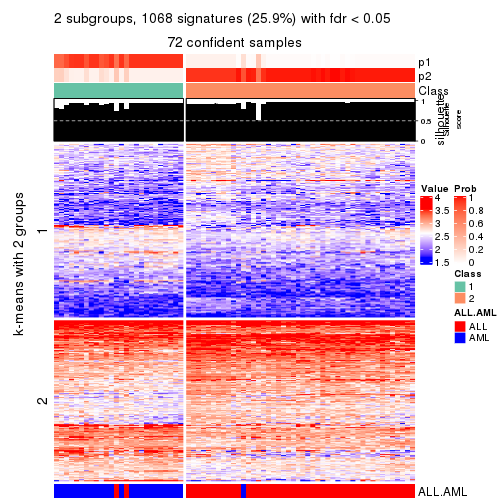
get_signatures(res, k = 3, scale_rows = FALSE)
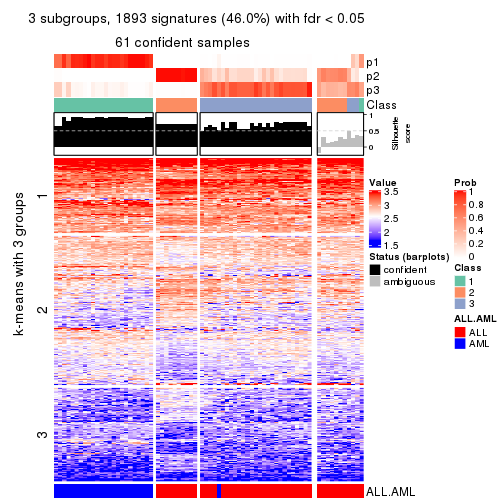
get_signatures(res, k = 4, scale_rows = FALSE)
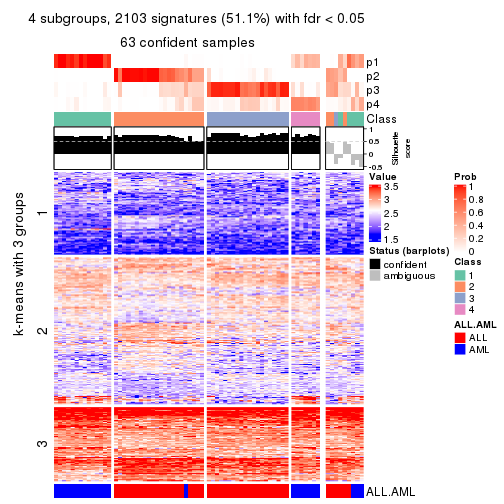
get_signatures(res, k = 5, scale_rows = FALSE)
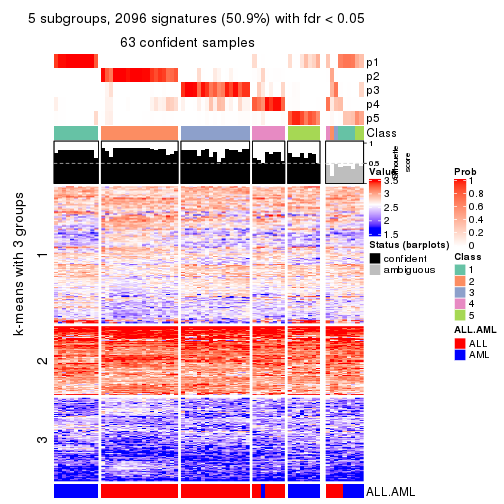
get_signatures(res, k = 6, scale_rows = FALSE)
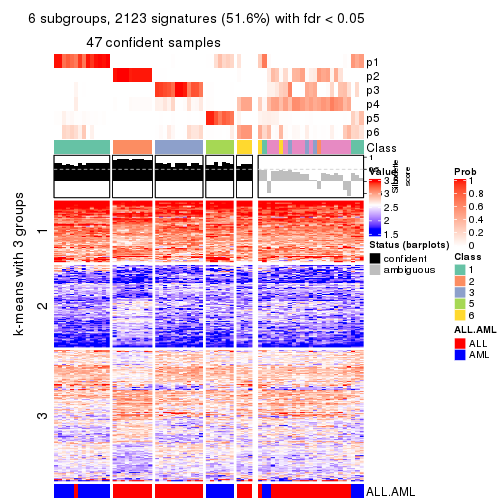
Compare the overlap of signatures from different k:
compare_signatures(res)
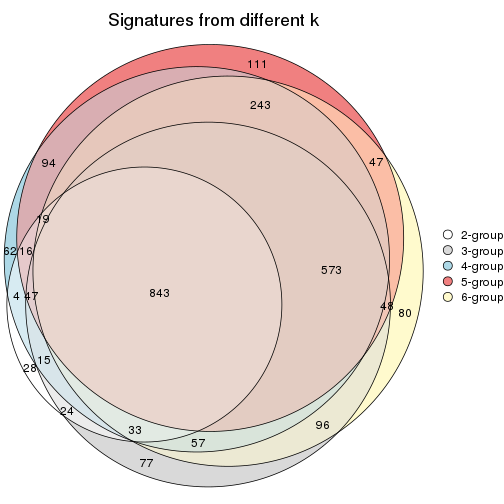
get_signature() returns a data frame invisibly. TO get the list of signatures, the function
call should be assigned to a variable explicitly. In following code, if plot argument is set
to FALSE, no heatmap is plotted while only the differential analysis is performed.
# code only for demonstration
tb = get_signature(res, k = ..., plot = FALSE)
An example of the output of tb is:
#> which_row fdr mean_1 mean_2 scaled_mean_1 scaled_mean_2 km
#> 1 38 0.042760348 8.373488 9.131774 -0.5533452 0.5164555 1
#> 2 40 0.018707592 7.106213 8.469186 -0.6173731 0.5762149 1
#> 3 55 0.019134737 10.221463 11.207825 -0.6159697 0.5749050 1
#> 4 59 0.006059896 5.921854 7.869574 -0.6899429 0.6439467 1
#> 5 60 0.018055526 8.928898 10.211722 -0.6204761 0.5791110 1
#> 6 98 0.009384629 15.714769 14.887706 0.6635654 -0.6193277 2
...
The columns in tb are:
which_row: row indices corresponding to the input matrix.fdr: FDR for the differential test. mean_x: The mean value in group x.scaled_mean_x: The mean value in group x after rows are scaled.km: Row groups if k-means clustering is applied to rows.UMAP plot which shows how samples are separated.
dimension_reduction(res, k = 2, method = "UMAP")
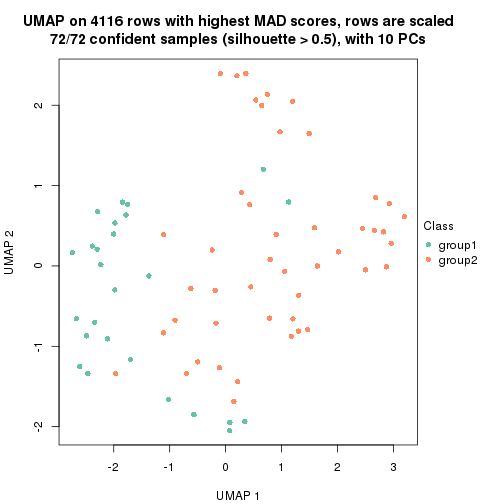
dimension_reduction(res, k = 3, method = "UMAP")
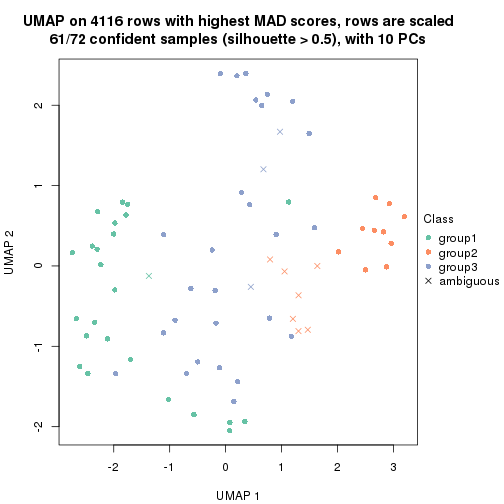
dimension_reduction(res, k = 4, method = "UMAP")
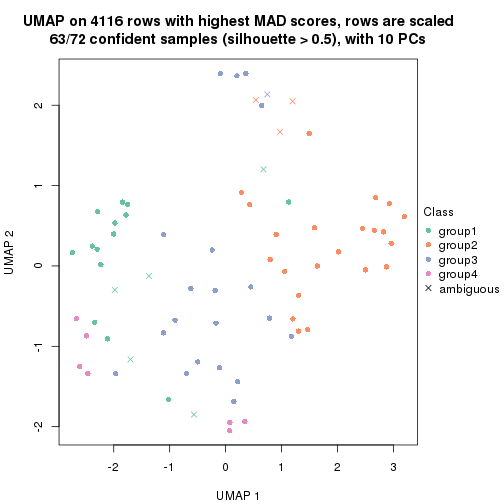
dimension_reduction(res, k = 5, method = "UMAP")
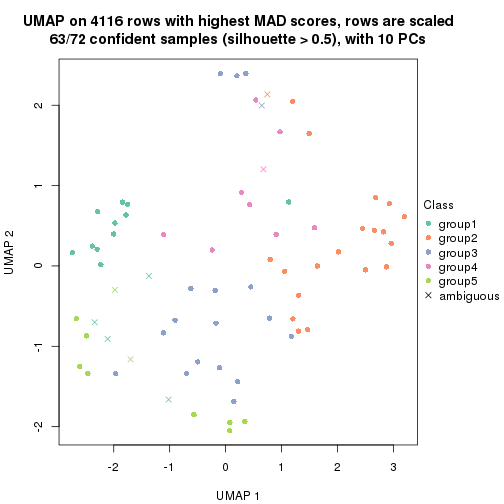
dimension_reduction(res, k = 6, method = "UMAP")
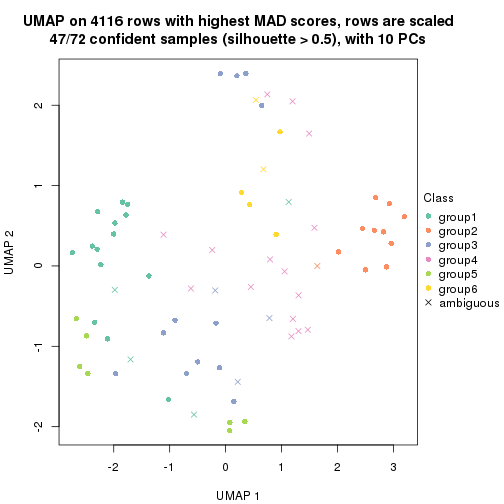
Following heatmap shows how subgroups are split when increasing k:
collect_classes(res)
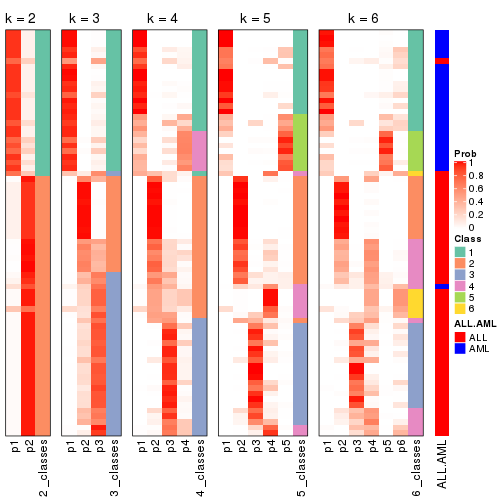
Test correlation between subgroups and known annotations. If the known annotation is numeric, one-way ANOVA test is applied, and if the known annotation is discrete, chi-squared contingency table test is applied.
test_to_known_factors(res)
#> n ALL.AML(p) k
#> MAD:mclust 72 8.75e-14 2
#> MAD:mclust 61 4.15e-13 3
#> MAD:mclust 63 1.06e-12 4
#> MAD:mclust 63 4.79e-12 5
#> MAD:mclust 47 9.40e-09 6
If matrix rows can be associated to genes, consider to use functional_enrichment(res,
...) to perform function enrichment for the signature genes. See this vignette for more detailed explanations.
The object with results only for a single top-value method and a single partition method can be extracted as:
res = res_list["MAD", "NMF"]
# you can also extract it by
# res = res_list["MAD:NMF"]
A summary of res and all the functions that can be applied to it:
res
#> A 'ConsensusPartition' object with k = 2, 3, 4, 5, 6.
#> On a matrix with 4116 rows and 72 columns.
#> Top rows (412, 824, 1235, 1646, 2058) are extracted by 'MAD' method.
#> Subgroups are detected by 'NMF' method.
#> Performed in total 1250 partitions by row resampling.
#> Best k for subgroups seems to be 2.
#>
#> Following methods can be applied to this 'ConsensusPartition' object:
#> [1] "cola_report" "collect_classes" "collect_plots"
#> [4] "collect_stats" "colnames" "compare_signatures"
#> [7] "consensus_heatmap" "dimension_reduction" "functional_enrichment"
#> [10] "get_anno_col" "get_anno" "get_classes"
#> [13] "get_consensus" "get_matrix" "get_membership"
#> [16] "get_param" "get_signatures" "get_stats"
#> [19] "is_best_k" "is_stable_k" "membership_heatmap"
#> [22] "ncol" "nrow" "plot_ecdf"
#> [25] "rownames" "select_partition_number" "show"
#> [28] "suggest_best_k" "test_to_known_factors"
collect_plots() function collects all the plots made from res for all k (number of partitions)
into one single page to provide an easy and fast comparison between different k.
collect_plots(res)
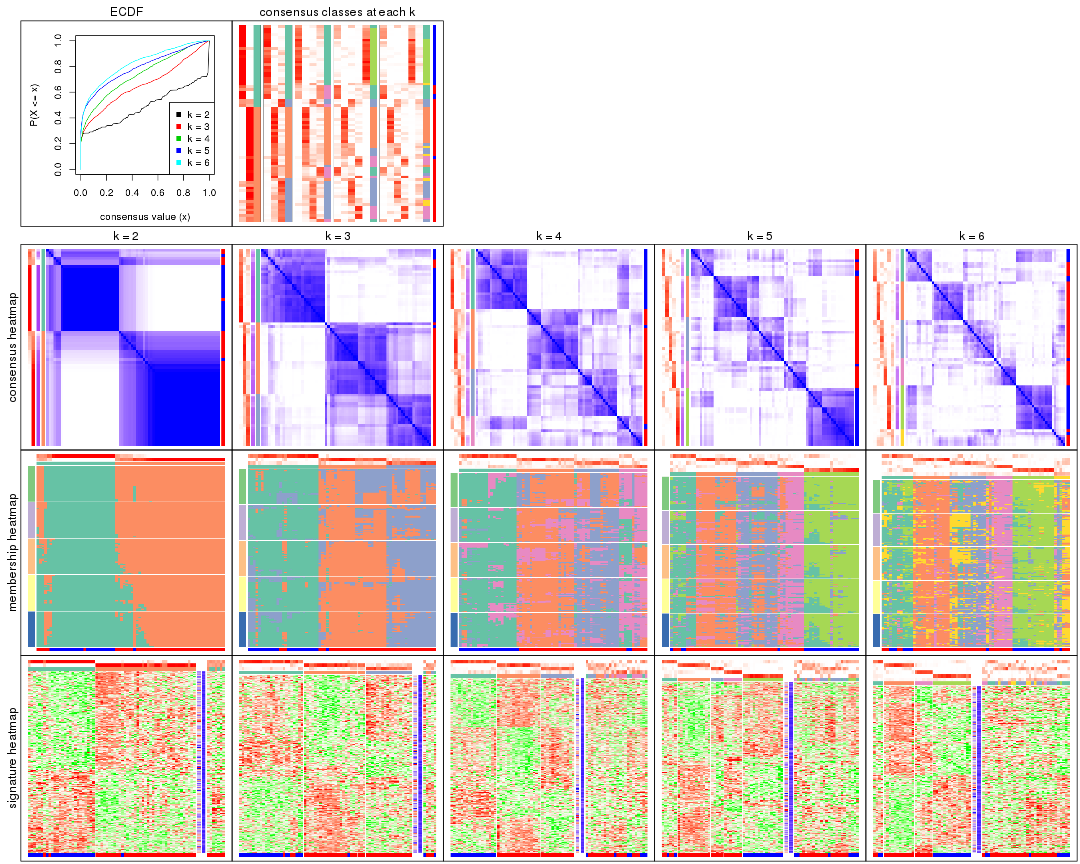
The plots are:
k and the heatmap of
predicted classes for each k.k.k.k.All the plots in panels can be made by individual functions and they are plotted later in this section.
select_partition_number() produces several plots showing different
statistics for choosing “optimized” k. There are following statistics:
k;k, the area increased is defined as \(A_k - A_{k-1}\).The detailed explanations of these statistics can be found in the cola vignette.
Generally speaking, lower PAC score, higher mean silhouette score or higher
concordance corresponds to better partition. Rand index and Jaccard index
measure how similar the current partition is compared to partition with k-1.
If they are too similar, we won't accept k is better than k-1.
select_partition_number(res)
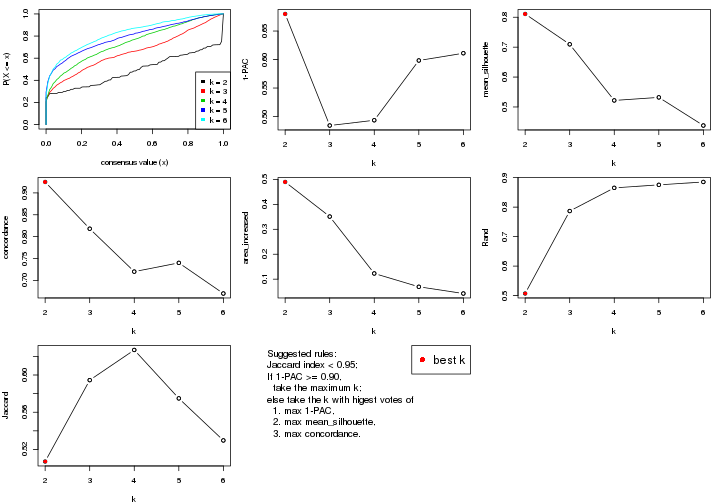
The numeric values for all these statistics can be obtained by get_stats().
get_stats(res)
#> k 1-PAC mean_silhouette concordance area_increased Rand Jaccard
#> 2 2 0.680 0.811 0.925 0.4899 0.507 0.507
#> 3 3 0.484 0.709 0.818 0.3511 0.787 0.594
#> 4 4 0.493 0.522 0.720 0.1228 0.865 0.627
#> 5 5 0.598 0.532 0.740 0.0694 0.876 0.575
#> 6 6 0.611 0.438 0.670 0.0424 0.885 0.530
suggest_best_k() suggests the best \(k\) based on these statistics. The rules are as follows:
suggest_best_k(res)
#> [1] 2
Following shows the table of the partitions (You need to click the show/hide
code output link to see it). The membership matrix (columns with name p*)
is inferred by
clue::cl_consensus()
function with the SE method. Basically the value in the membership matrix
represents the probability to belong to a certain group. The finall class
label for an item is determined with the group with highest probability it
belongs to.
In get_classes() function, the entropy is calculated from the membership
matrix and the silhouette score is calculated from the consensus matrix.
cbind(get_classes(res, k = 2), get_membership(res, k = 2))
#> class entropy silhouette p1 p2
#> sample_39 2 0.9460 0.47355 0.364 0.636
#> sample_40 2 0.9323 0.50751 0.348 0.652
#> sample_42 2 0.0000 0.91217 0.000 1.000
#> sample_47 2 0.0000 0.91217 0.000 1.000
#> sample_48 2 0.0000 0.91217 0.000 1.000
#> sample_49 2 0.9944 0.22386 0.456 0.544
#> sample_41 2 0.0000 0.91217 0.000 1.000
#> sample_43 2 0.0000 0.91217 0.000 1.000
#> sample_44 2 0.0000 0.91217 0.000 1.000
#> sample_45 2 0.0000 0.91217 0.000 1.000
#> sample_46 2 0.0000 0.91217 0.000 1.000
#> sample_70 2 0.0376 0.91020 0.004 0.996
#> sample_71 2 0.0938 0.90644 0.012 0.988
#> sample_72 2 0.0000 0.91217 0.000 1.000
#> sample_68 2 0.0000 0.91217 0.000 1.000
#> sample_69 2 0.0000 0.91217 0.000 1.000
#> sample_67 1 0.7139 0.71548 0.804 0.196
#> sample_55 2 0.6148 0.79467 0.152 0.848
#> sample_56 2 0.5629 0.81495 0.132 0.868
#> sample_59 2 0.0000 0.91217 0.000 1.000
#> sample_52 1 0.0000 0.91389 1.000 0.000
#> sample_53 1 0.0000 0.91389 1.000 0.000
#> sample_51 1 0.0000 0.91389 1.000 0.000
#> sample_50 1 0.0000 0.91389 1.000 0.000
#> sample_54 1 0.8016 0.64617 0.756 0.244
#> sample_57 1 0.0000 0.91389 1.000 0.000
#> sample_58 1 0.0000 0.91389 1.000 0.000
#> sample_60 1 0.0938 0.90467 0.988 0.012
#> sample_61 1 0.0000 0.91389 1.000 0.000
#> sample_65 1 0.0000 0.91389 1.000 0.000
#> sample_66 2 0.4431 0.83337 0.092 0.908
#> sample_63 1 0.0000 0.91389 1.000 0.000
#> sample_64 1 0.0000 0.91389 1.000 0.000
#> sample_62 1 0.0000 0.91389 1.000 0.000
#> sample_1 2 0.0000 0.91217 0.000 1.000
#> sample_2 1 0.9833 0.27353 0.576 0.424
#> sample_3 2 0.3584 0.86847 0.068 0.932
#> sample_4 2 0.0000 0.91217 0.000 1.000
#> sample_5 2 0.0000 0.91217 0.000 1.000
#> sample_6 2 0.9129 0.54748 0.328 0.672
#> sample_7 2 0.5294 0.82590 0.120 0.880
#> sample_8 1 0.9977 -0.00368 0.528 0.472
#> sample_9 2 0.0000 0.91217 0.000 1.000
#> sample_10 2 0.9996 0.09922 0.488 0.512
#> sample_11 2 0.0000 0.91217 0.000 1.000
#> sample_12 1 0.0000 0.91389 1.000 0.000
#> sample_13 2 0.0000 0.91217 0.000 1.000
#> sample_14 2 0.0000 0.91217 0.000 1.000
#> sample_15 2 0.0000 0.91217 0.000 1.000
#> sample_16 2 0.0000 0.91217 0.000 1.000
#> sample_17 2 0.0000 0.91217 0.000 1.000
#> sample_18 2 0.1414 0.90124 0.020 0.980
#> sample_19 2 0.0000 0.91217 0.000 1.000
#> sample_20 2 0.0000 0.91217 0.000 1.000
#> sample_21 2 0.0000 0.91217 0.000 1.000
#> sample_22 1 0.9491 0.34331 0.632 0.368
#> sample_23 2 0.8909 0.58335 0.308 0.692
#> sample_24 2 0.0000 0.91217 0.000 1.000
#> sample_25 2 0.9044 0.56124 0.320 0.680
#> sample_26 2 0.0000 0.91217 0.000 1.000
#> sample_27 1 0.9970 0.01229 0.532 0.468
#> sample_34 1 0.0000 0.91389 1.000 0.000
#> sample_35 1 0.0000 0.91389 1.000 0.000
#> sample_36 1 0.0000 0.91389 1.000 0.000
#> sample_37 1 0.0000 0.91389 1.000 0.000
#> sample_38 1 0.0000 0.91389 1.000 0.000
#> sample_28 1 0.0000 0.91389 1.000 0.000
#> sample_29 1 0.0000 0.91389 1.000 0.000
#> sample_30 1 0.0000 0.91389 1.000 0.000
#> sample_31 1 0.0000 0.91389 1.000 0.000
#> sample_32 1 0.0000 0.91389 1.000 0.000
#> sample_33 1 0.0000 0.91389 1.000 0.000
cbind(get_classes(res, k = 3), get_membership(res, k = 3))
#> class entropy silhouette p1 p2 p3
#> sample_39 3 0.2063 0.728 0.008 0.044 0.948
#> sample_40 3 0.4172 0.779 0.004 0.156 0.840
#> sample_42 2 0.6570 0.651 0.028 0.680 0.292
#> sample_47 2 0.3340 0.787 0.000 0.880 0.120
#> sample_48 2 0.3551 0.785 0.000 0.868 0.132
#> sample_49 3 0.3454 0.771 0.008 0.104 0.888
#> sample_41 2 0.1411 0.773 0.000 0.964 0.036
#> sample_43 2 0.4796 0.743 0.000 0.780 0.220
#> sample_44 2 0.5988 0.407 0.000 0.632 0.368
#> sample_45 2 0.4796 0.744 0.000 0.780 0.220
#> sample_46 2 0.5397 0.683 0.000 0.720 0.280
#> sample_70 3 0.5178 0.664 0.000 0.256 0.744
#> sample_71 2 0.7308 0.613 0.056 0.648 0.296
#> sample_72 2 0.5953 0.680 0.012 0.708 0.280
#> sample_68 2 0.0592 0.778 0.000 0.988 0.012
#> sample_69 2 0.3482 0.778 0.000 0.872 0.128
#> sample_67 1 0.6098 0.717 0.768 0.176 0.056
#> sample_55 3 0.5812 0.744 0.012 0.264 0.724
#> sample_56 3 0.3551 0.774 0.000 0.132 0.868
#> sample_59 3 0.6045 0.514 0.000 0.380 0.620
#> sample_52 1 0.1289 0.856 0.968 0.000 0.032
#> sample_53 1 0.0747 0.854 0.984 0.000 0.016
#> sample_51 1 0.0592 0.857 0.988 0.000 0.012
#> sample_50 1 0.0424 0.856 0.992 0.000 0.008
#> sample_54 1 0.7492 0.496 0.608 0.340 0.052
#> sample_57 1 0.4912 0.788 0.796 0.008 0.196
#> sample_58 1 0.5678 0.665 0.684 0.000 0.316
#> sample_60 1 0.5710 0.782 0.804 0.116 0.080
#> sample_61 1 0.5529 0.729 0.704 0.000 0.296
#> sample_65 1 0.2796 0.851 0.908 0.000 0.092
#> sample_66 2 0.6188 0.513 0.216 0.744 0.040
#> sample_63 1 0.2066 0.855 0.940 0.000 0.060
#> sample_64 1 0.6062 0.553 0.616 0.000 0.384
#> sample_62 1 0.1753 0.856 0.952 0.000 0.048
#> sample_1 3 0.5497 0.640 0.000 0.292 0.708
#> sample_2 1 0.7775 0.506 0.620 0.304 0.076
#> sample_3 3 0.5650 0.734 0.000 0.312 0.688
#> sample_4 2 0.6307 -0.453 0.000 0.512 0.488
#> sample_5 2 0.0424 0.772 0.000 0.992 0.008
#> sample_6 3 0.5404 0.743 0.004 0.256 0.740
#> sample_7 3 0.5560 0.745 0.000 0.300 0.700
#> sample_8 3 0.2584 0.745 0.008 0.064 0.928
#> sample_9 2 0.3482 0.695 0.000 0.872 0.128
#> sample_10 3 0.6473 0.734 0.020 0.312 0.668
#> sample_11 2 0.1860 0.777 0.000 0.948 0.052
#> sample_12 1 0.5591 0.718 0.696 0.000 0.304
#> sample_13 2 0.3551 0.784 0.000 0.868 0.132
#> sample_14 2 0.1950 0.762 0.008 0.952 0.040
#> sample_15 2 0.0892 0.776 0.000 0.980 0.020
#> sample_16 2 0.5363 0.553 0.000 0.724 0.276
#> sample_17 2 0.1163 0.771 0.000 0.972 0.028
#> sample_18 3 0.6204 0.565 0.000 0.424 0.576
#> sample_19 2 0.5216 0.707 0.000 0.740 0.260
#> sample_20 2 0.3686 0.779 0.000 0.860 0.140
#> sample_21 2 0.1643 0.787 0.000 0.956 0.044
#> sample_22 3 0.3237 0.683 0.056 0.032 0.912
#> sample_23 3 0.5254 0.752 0.000 0.264 0.736
#> sample_24 2 0.1529 0.775 0.000 0.960 0.040
#> sample_25 3 0.6007 0.614 0.048 0.184 0.768
#> sample_26 3 0.6235 0.154 0.000 0.436 0.564
#> sample_27 3 0.3845 0.773 0.012 0.116 0.872
#> sample_34 1 0.2878 0.847 0.904 0.000 0.096
#> sample_35 1 0.6280 0.377 0.540 0.000 0.460
#> sample_36 1 0.0747 0.856 0.984 0.000 0.016
#> sample_37 1 0.0747 0.855 0.984 0.000 0.016
#> sample_38 1 0.2537 0.846 0.920 0.000 0.080
#> sample_28 1 0.2625 0.841 0.916 0.000 0.084
#> sample_29 1 0.2599 0.838 0.932 0.052 0.016
#> sample_30 1 0.0829 0.854 0.984 0.004 0.012
#> sample_31 1 0.3116 0.844 0.892 0.000 0.108
#> sample_32 1 0.2796 0.854 0.908 0.000 0.092
#> sample_33 1 0.2261 0.857 0.932 0.000 0.068
cbind(get_classes(res, k = 4), get_membership(res, k = 4))
#> class entropy silhouette p1 p2 p3 p4
#> sample_39 3 0.592 0.53779 0.008 0.036 0.620 0.336
#> sample_40 3 0.507 0.68690 0.024 0.164 0.776 0.036
#> sample_42 4 0.395 0.41028 0.000 0.168 0.020 0.812
#> sample_47 2 0.400 0.68605 0.000 0.824 0.036 0.140
#> sample_48 2 0.328 0.69450 0.000 0.872 0.032 0.096
#> sample_49 3 0.513 0.69374 0.008 0.132 0.776 0.084
#> sample_41 2 0.141 0.67095 0.000 0.960 0.024 0.016
#> sample_43 2 0.597 0.60501 0.000 0.668 0.088 0.244
#> sample_44 2 0.714 0.37361 0.000 0.556 0.256 0.188
#> sample_45 2 0.622 0.57706 0.000 0.624 0.084 0.292
#> sample_46 2 0.690 0.50260 0.000 0.556 0.132 0.312
#> sample_70 3 0.654 0.59577 0.000 0.140 0.628 0.232
#> sample_71 4 0.310 0.47034 0.000 0.120 0.012 0.868
#> sample_72 4 0.460 0.34990 0.000 0.184 0.040 0.776
#> sample_68 2 0.139 0.68979 0.000 0.960 0.012 0.028
#> sample_69 2 0.505 0.65361 0.000 0.704 0.028 0.268
#> sample_67 4 0.639 0.25684 0.368 0.032 0.024 0.576
#> sample_55 3 0.803 0.47222 0.184 0.248 0.532 0.036
#> sample_56 3 0.588 0.67685 0.012 0.160 0.724 0.104
#> sample_59 2 0.761 -0.14871 0.016 0.452 0.404 0.128
#> sample_52 1 0.141 0.73421 0.960 0.000 0.020 0.020
#> sample_53 1 0.451 0.55538 0.708 0.000 0.004 0.288
#> sample_51 1 0.292 0.70990 0.860 0.000 0.000 0.140
#> sample_50 1 0.253 0.72440 0.888 0.000 0.000 0.112
#> sample_54 1 0.616 0.42347 0.664 0.268 0.040 0.028
#> sample_57 1 0.354 0.69305 0.868 0.008 0.092 0.032
#> sample_58 1 0.396 0.66007 0.820 0.000 0.152 0.028
#> sample_60 1 0.565 0.55981 0.748 0.164 0.060 0.028
#> sample_61 1 0.668 0.19951 0.524 0.000 0.092 0.384
#> sample_65 1 0.293 0.73300 0.880 0.000 0.012 0.108
#> sample_66 2 0.806 0.32614 0.064 0.568 0.164 0.204
#> sample_63 1 0.130 0.73515 0.964 0.000 0.020 0.016
#> sample_64 1 0.504 0.58191 0.748 0.012 0.212 0.028
#> sample_62 1 0.163 0.73055 0.952 0.000 0.024 0.024
#> sample_1 3 0.622 0.61974 0.000 0.188 0.668 0.144
#> sample_2 4 0.765 0.40406 0.224 0.060 0.116 0.600
#> sample_3 3 0.422 0.56239 0.004 0.080 0.832 0.084
#> sample_4 3 0.616 0.34470 0.004 0.448 0.508 0.040
#> sample_5 2 0.104 0.68140 0.000 0.972 0.020 0.008
#> sample_6 3 0.422 0.56386 0.004 0.080 0.832 0.084
#> sample_7 3 0.486 0.66034 0.020 0.228 0.744 0.008
#> sample_8 3 0.557 0.64779 0.008 0.064 0.724 0.204
#> sample_9 2 0.713 0.32344 0.000 0.532 0.312 0.156
#> sample_10 3 0.639 0.36473 0.012 0.100 0.668 0.220
#> sample_11 4 0.776 0.04145 0.000 0.316 0.256 0.428
#> sample_12 4 0.616 0.09656 0.416 0.000 0.052 0.532
#> sample_13 2 0.401 0.68891 0.000 0.816 0.028 0.156
#> sample_14 2 0.576 0.49453 0.004 0.708 0.204 0.084
#> sample_15 2 0.117 0.68089 0.000 0.968 0.020 0.012
#> sample_16 2 0.516 0.59983 0.000 0.756 0.156 0.088
#> sample_17 2 0.447 0.57140 0.004 0.796 0.164 0.036
#> sample_18 3 0.542 0.63184 0.008 0.240 0.712 0.040
#> sample_19 2 0.666 0.53878 0.000 0.580 0.112 0.308
#> sample_20 2 0.477 0.66993 0.000 0.740 0.028 0.232
#> sample_21 2 0.427 0.64654 0.000 0.820 0.072 0.108
#> sample_22 4 0.517 0.00127 0.008 0.004 0.352 0.636
#> sample_23 3 0.408 0.55727 0.000 0.068 0.832 0.100
#> sample_24 2 0.128 0.67582 0.000 0.964 0.024 0.012
#> sample_25 4 0.500 0.32557 0.000 0.052 0.200 0.748
#> sample_26 3 0.805 0.13505 0.004 0.316 0.376 0.304
#> sample_27 3 0.489 0.69549 0.008 0.140 0.788 0.064
#> sample_34 1 0.202 0.74043 0.936 0.000 0.024 0.040
#> sample_35 1 0.594 0.09502 0.488 0.000 0.476 0.036
#> sample_36 1 0.194 0.73430 0.924 0.000 0.000 0.076
#> sample_37 1 0.407 0.61021 0.748 0.000 0.000 0.252
#> sample_38 4 0.556 0.09888 0.436 0.000 0.020 0.544
#> sample_28 4 0.527 0.06349 0.452 0.000 0.008 0.540
#> sample_29 1 0.373 0.65356 0.788 0.000 0.000 0.212
#> sample_30 1 0.253 0.72377 0.888 0.000 0.000 0.112
#> sample_31 1 0.158 0.73585 0.952 0.000 0.036 0.012
#> sample_32 1 0.425 0.58025 0.724 0.000 0.000 0.276
#> sample_33 1 0.456 0.49384 0.672 0.000 0.000 0.328
cbind(get_classes(res, k = 5), get_membership(res, k = 5))
#> class entropy silhouette p1 p2 p3 p4 p5
#> sample_39 3 0.3167 0.5260 0.148 0.008 0.836 0.008 0.000
#> sample_40 3 0.5021 0.3938 0.008 0.008 0.692 0.252 0.040
#> sample_42 1 0.3735 0.5808 0.816 0.048 0.132 0.000 0.004
#> sample_47 2 0.3566 0.6777 0.024 0.812 0.160 0.000 0.004
#> sample_48 2 0.2452 0.7195 0.016 0.896 0.084 0.004 0.000
#> sample_49 3 0.3455 0.4696 0.000 0.000 0.784 0.208 0.008
#> sample_41 2 0.2408 0.6859 0.004 0.892 0.008 0.096 0.000
#> sample_43 2 0.5684 0.2943 0.096 0.564 0.340 0.000 0.000
#> sample_44 3 0.5352 -0.0835 0.052 0.468 0.480 0.000 0.000
#> sample_45 2 0.6072 0.1085 0.124 0.484 0.392 0.000 0.000
#> sample_46 3 0.6060 0.0878 0.124 0.384 0.492 0.000 0.000
#> sample_70 3 0.3913 0.5652 0.084 0.064 0.828 0.024 0.000
#> sample_71 1 0.2844 0.6151 0.876 0.028 0.092 0.004 0.000
#> sample_72 1 0.4793 0.4317 0.700 0.068 0.232 0.000 0.000
#> sample_68 2 0.1205 0.7219 0.004 0.956 0.000 0.040 0.000
#> sample_69 2 0.4998 0.6268 0.172 0.716 0.108 0.004 0.000
#> sample_67 1 0.3968 0.6367 0.816 0.016 0.000 0.056 0.112
#> sample_55 3 0.8210 0.1203 0.012 0.112 0.412 0.164 0.300
#> sample_56 3 0.1518 0.5834 0.000 0.016 0.952 0.020 0.012
#> sample_59 3 0.5458 0.2179 0.008 0.380 0.568 0.004 0.040
#> sample_52 5 0.0404 0.7723 0.012 0.000 0.000 0.000 0.988
#> sample_53 5 0.4803 0.2988 0.444 0.000 0.000 0.020 0.536
#> sample_51 5 0.3353 0.7007 0.196 0.000 0.000 0.008 0.796
#> sample_50 5 0.2280 0.7534 0.120 0.000 0.000 0.000 0.880
#> sample_54 5 0.3552 0.6797 0.012 0.116 0.028 0.004 0.840
#> sample_57 5 0.2333 0.7419 0.012 0.020 0.040 0.008 0.920
#> sample_58 5 0.2672 0.7209 0.008 0.000 0.116 0.004 0.872
#> sample_60 5 0.3483 0.6882 0.012 0.104 0.032 0.004 0.848
#> sample_61 1 0.6786 0.2537 0.384 0.000 0.292 0.000 0.324
#> sample_65 5 0.1892 0.7683 0.080 0.000 0.004 0.000 0.916
#> sample_66 4 0.6936 0.2760 0.200 0.344 0.000 0.440 0.016
#> sample_63 5 0.0162 0.7705 0.000 0.004 0.000 0.000 0.996
#> sample_64 5 0.2746 0.7127 0.008 0.000 0.112 0.008 0.872
#> sample_62 5 0.1362 0.7601 0.008 0.016 0.012 0.004 0.960
#> sample_1 3 0.3596 0.5913 0.036 0.060 0.852 0.052 0.000
#> sample_2 1 0.4766 0.4664 0.708 0.020 0.000 0.244 0.028
#> sample_3 4 0.1270 0.7076 0.000 0.000 0.052 0.948 0.000
#> sample_4 4 0.6672 0.3695 0.008 0.368 0.140 0.476 0.008
#> sample_5 2 0.1671 0.7061 0.000 0.924 0.000 0.076 0.000
#> sample_6 4 0.1205 0.7116 0.000 0.000 0.040 0.956 0.004
#> sample_7 4 0.6968 0.2068 0.004 0.188 0.320 0.472 0.016
#> sample_8 3 0.4060 0.5294 0.052 0.004 0.788 0.156 0.000
#> sample_9 4 0.2575 0.7127 0.012 0.100 0.004 0.884 0.000
#> sample_10 4 0.1743 0.7131 0.028 0.004 0.028 0.940 0.000
#> sample_11 4 0.3421 0.6846 0.080 0.080 0.000 0.840 0.000
#> sample_12 1 0.5576 0.5688 0.688 0.000 0.072 0.040 0.200
#> sample_13 2 0.3506 0.6938 0.044 0.824 0.132 0.000 0.000
#> sample_14 4 0.4003 0.5757 0.008 0.288 0.000 0.704 0.000
#> sample_15 2 0.1704 0.7106 0.004 0.928 0.000 0.068 0.000
#> sample_16 2 0.3989 0.5834 0.008 0.728 0.260 0.004 0.000
#> sample_17 2 0.3611 0.5244 0.008 0.780 0.000 0.208 0.004
#> sample_18 3 0.5802 0.2735 0.008 0.052 0.612 0.308 0.020
#> sample_19 3 0.6037 -0.0650 0.116 0.436 0.448 0.000 0.000
#> sample_20 2 0.4498 0.6788 0.108 0.772 0.112 0.008 0.000
#> sample_21 2 0.4622 0.5830 0.084 0.748 0.004 0.164 0.000
#> sample_22 3 0.5458 0.1630 0.380 0.000 0.552 0.068 0.000
#> sample_23 4 0.2077 0.6827 0.008 0.000 0.084 0.908 0.000
#> sample_24 2 0.2497 0.6746 0.004 0.880 0.004 0.112 0.000
#> sample_25 1 0.5068 0.2205 0.572 0.040 0.388 0.000 0.000
#> sample_26 3 0.5472 0.4263 0.140 0.208 0.652 0.000 0.000
#> sample_27 3 0.3957 0.3850 0.000 0.000 0.712 0.280 0.008
#> sample_34 5 0.0955 0.7730 0.028 0.000 0.000 0.004 0.968
#> sample_35 5 0.6658 0.1540 0.004 0.000 0.328 0.208 0.460
#> sample_36 5 0.1792 0.7664 0.084 0.000 0.000 0.000 0.916
#> sample_37 5 0.4403 0.4603 0.384 0.000 0.000 0.008 0.608
#> sample_38 1 0.4487 0.6197 0.756 0.000 0.000 0.104 0.140
#> sample_28 1 0.3650 0.5987 0.796 0.000 0.000 0.028 0.176
#> sample_29 5 0.4276 0.4663 0.380 0.000 0.000 0.004 0.616
#> sample_30 5 0.2329 0.7516 0.124 0.000 0.000 0.000 0.876
#> sample_31 5 0.0693 0.7727 0.012 0.000 0.000 0.008 0.980
#> sample_32 5 0.4102 0.5905 0.300 0.000 0.004 0.004 0.692
#> sample_33 5 0.4727 0.3992 0.408 0.000 0.008 0.008 0.576
cbind(get_classes(res, k = 6), get_membership(res, k = 6))
#> class entropy silhouette p1 p2 p3 p4 p5 p6
#> sample_39 3 0.2829 0.3892 0.024 0.000 0.864 0.016 0.000 0.096
#> sample_40 6 0.6805 -0.2676 0.000 0.020 0.368 0.192 0.024 0.396
#> sample_42 1 0.4943 0.2240 0.652 0.028 0.268 0.000 0.000 0.052
#> sample_47 2 0.5948 0.4276 0.028 0.604 0.188 0.004 0.004 0.172
#> sample_48 2 0.3165 0.6866 0.008 0.836 0.116 0.000 0.000 0.040
#> sample_49 3 0.5509 0.2481 0.000 0.000 0.512 0.120 0.004 0.364
#> sample_41 2 0.2883 0.6793 0.008 0.860 0.000 0.040 0.000 0.092
#> sample_43 6 0.7040 0.1898 0.032 0.308 0.296 0.008 0.004 0.352
#> sample_44 6 0.7121 0.1855 0.016 0.288 0.324 0.036 0.000 0.336
#> sample_45 3 0.6891 -0.1594 0.048 0.320 0.424 0.000 0.008 0.200
#> sample_46 3 0.5481 0.0846 0.024 0.224 0.624 0.000 0.000 0.128
#> sample_70 3 0.5897 0.1429 0.016 0.020 0.552 0.092 0.000 0.320
#> sample_71 1 0.5351 0.2365 0.624 0.036 0.292 0.012 0.004 0.032
#> sample_72 3 0.5459 0.1499 0.392 0.080 0.512 0.000 0.000 0.016
#> sample_68 2 0.1772 0.7182 0.004 0.936 0.008 0.012 0.004 0.036
#> sample_69 2 0.4783 0.6004 0.060 0.684 0.232 0.000 0.000 0.024
#> sample_67 1 0.6374 0.5394 0.668 0.060 0.024 0.084 0.100 0.064
#> sample_55 6 0.7478 0.1940 0.008 0.052 0.124 0.128 0.156 0.532
#> sample_56 3 0.3993 0.3007 0.000 0.000 0.676 0.024 0.000 0.300
#> sample_59 6 0.7592 0.2434 0.008 0.228 0.300 0.032 0.048 0.384
#> sample_52 5 0.0713 0.7827 0.000 0.000 0.000 0.000 0.972 0.028
#> sample_53 1 0.4527 0.1394 0.516 0.004 0.000 0.000 0.456 0.024
#> sample_51 5 0.4153 0.3848 0.340 0.000 0.000 0.000 0.636 0.024
#> sample_50 5 0.3201 0.6591 0.208 0.000 0.000 0.000 0.780 0.012
#> sample_54 5 0.3390 0.6885 0.016 0.028 0.000 0.000 0.816 0.140
#> sample_57 5 0.2110 0.7547 0.012 0.004 0.000 0.000 0.900 0.084
#> sample_58 5 0.2752 0.7451 0.004 0.000 0.036 0.000 0.864 0.096
#> sample_60 5 0.3893 0.6415 0.016 0.040 0.000 0.000 0.772 0.172
#> sample_61 1 0.7346 0.2303 0.320 0.000 0.288 0.012 0.316 0.064
#> sample_65 5 0.2350 0.7618 0.100 0.000 0.000 0.000 0.880 0.020
#> sample_66 4 0.8345 0.0454 0.172 0.192 0.016 0.320 0.024 0.276
#> sample_63 5 0.1141 0.7796 0.000 0.000 0.000 0.000 0.948 0.052
#> sample_64 5 0.5392 0.5264 0.012 0.024 0.036 0.024 0.664 0.240
#> sample_62 5 0.1753 0.7705 0.000 0.004 0.000 0.000 0.912 0.084
#> sample_1 3 0.5717 0.3191 0.000 0.060 0.624 0.100 0.000 0.216
#> sample_2 1 0.5481 0.3826 0.660 0.052 0.004 0.228 0.016 0.040
#> sample_3 4 0.2420 0.6435 0.000 0.008 0.008 0.876 0.000 0.108
#> sample_4 2 0.6778 -0.1956 0.000 0.372 0.048 0.360 0.000 0.220
#> sample_5 2 0.0964 0.7238 0.000 0.968 0.000 0.012 0.004 0.016
#> sample_6 4 0.2405 0.6570 0.000 0.016 0.004 0.880 0.000 0.100
#> sample_7 4 0.7255 0.0956 0.004 0.216 0.088 0.368 0.000 0.324
#> sample_8 3 0.6290 0.2473 0.020 0.012 0.488 0.144 0.000 0.336
#> sample_9 4 0.2365 0.6550 0.012 0.068 0.000 0.896 0.000 0.024
#> sample_10 4 0.2767 0.6555 0.016 0.024 0.004 0.876 0.000 0.080
#> sample_11 4 0.2784 0.6502 0.032 0.064 0.004 0.880 0.000 0.020
#> sample_12 1 0.5700 0.5315 0.672 0.000 0.136 0.012 0.108 0.072
#> sample_13 2 0.3852 0.6575 0.020 0.764 0.192 0.000 0.000 0.024
#> sample_14 4 0.4675 0.5208 0.012 0.232 0.000 0.692 0.004 0.060
#> sample_15 2 0.1218 0.7245 0.000 0.956 0.004 0.028 0.000 0.012
#> sample_16 2 0.4809 0.5152 0.000 0.628 0.308 0.012 0.000 0.052
#> sample_17 2 0.4330 0.6037 0.004 0.748 0.004 0.164 0.004 0.076
#> sample_18 4 0.7104 -0.0324 0.004 0.028 0.340 0.352 0.016 0.260
#> sample_19 3 0.5068 0.1742 0.032 0.280 0.636 0.000 0.000 0.052
#> sample_20 2 0.4176 0.6757 0.052 0.760 0.164 0.000 0.000 0.024
#> sample_21 2 0.3763 0.6687 0.028 0.808 0.008 0.128 0.000 0.028
#> sample_22 3 0.6679 0.3080 0.240 0.008 0.512 0.056 0.000 0.184
#> sample_23 4 0.2504 0.6365 0.000 0.004 0.004 0.856 0.000 0.136
#> sample_24 2 0.2760 0.7062 0.000 0.872 0.008 0.052 0.000 0.068
#> sample_25 3 0.4715 0.1707 0.416 0.008 0.544 0.000 0.000 0.032
#> sample_26 3 0.2282 0.3667 0.012 0.068 0.900 0.000 0.000 0.020
#> sample_27 3 0.5961 0.1697 0.000 0.000 0.420 0.188 0.004 0.388
#> sample_34 5 0.2907 0.7656 0.064 0.000 0.004 0.008 0.868 0.056
#> sample_35 6 0.7084 -0.0140 0.012 0.000 0.092 0.128 0.360 0.408
#> sample_36 5 0.2357 0.7488 0.116 0.000 0.000 0.000 0.872 0.012
#> sample_37 1 0.4402 0.2896 0.564 0.000 0.000 0.004 0.412 0.020
#> sample_38 1 0.2812 0.5955 0.872 0.000 0.000 0.016 0.072 0.040
#> sample_28 1 0.1897 0.5991 0.908 0.000 0.004 0.004 0.084 0.000
#> sample_29 1 0.4906 0.2854 0.544 0.004 0.000 0.004 0.404 0.044
#> sample_30 5 0.2814 0.7026 0.172 0.000 0.000 0.000 0.820 0.008
#> sample_31 5 0.1003 0.7838 0.020 0.000 0.000 0.000 0.964 0.016
#> sample_32 5 0.4486 0.5157 0.272 0.000 0.008 0.008 0.680 0.032
#> sample_33 1 0.4437 0.3101 0.576 0.000 0.000 0.000 0.392 0.032
Heatmaps for the consensus matrix. It visualizes the probability of two samples to be in a same group.
consensus_heatmap(res, k = 2)
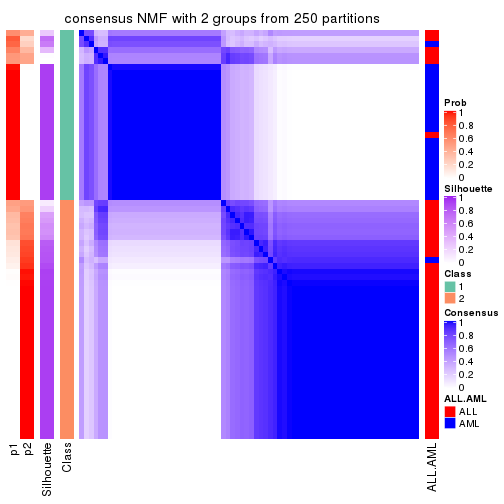
consensus_heatmap(res, k = 3)
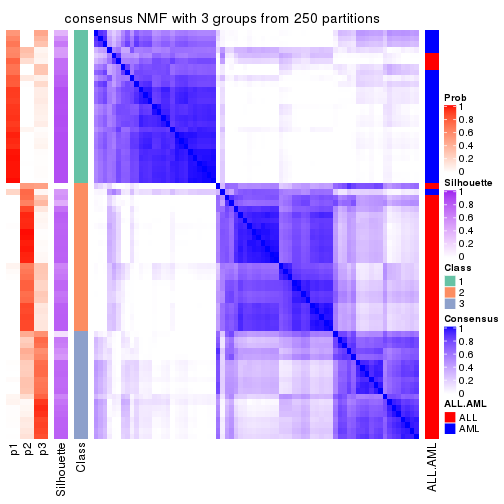
consensus_heatmap(res, k = 4)
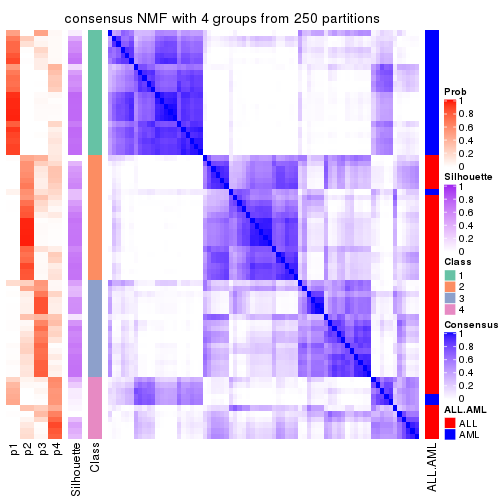
consensus_heatmap(res, k = 5)
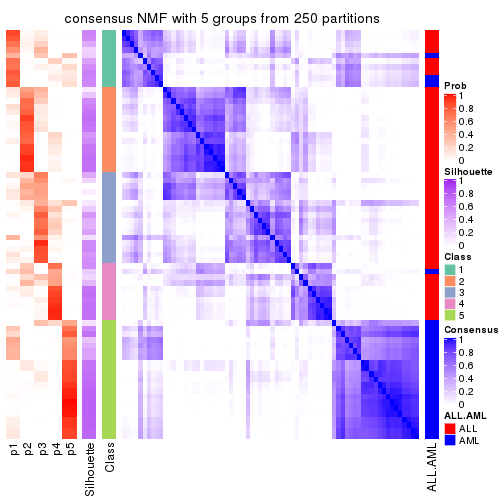
consensus_heatmap(res, k = 6)
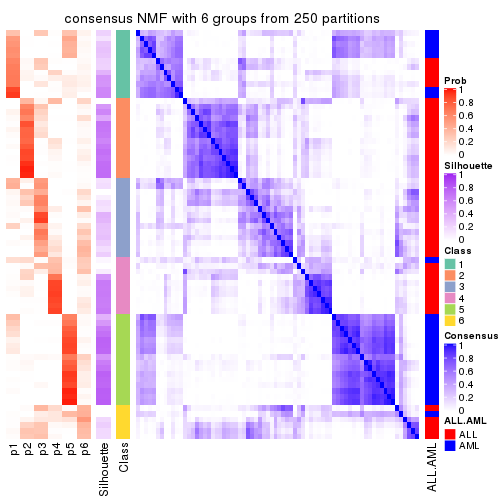
Heatmaps for the membership of samples in all partitions to see how consistent they are:
membership_heatmap(res, k = 2)
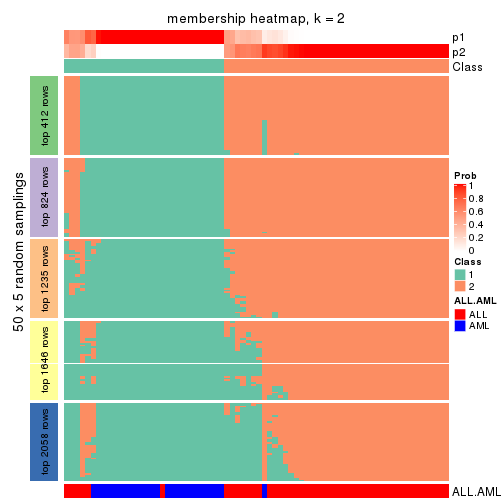
membership_heatmap(res, k = 3)
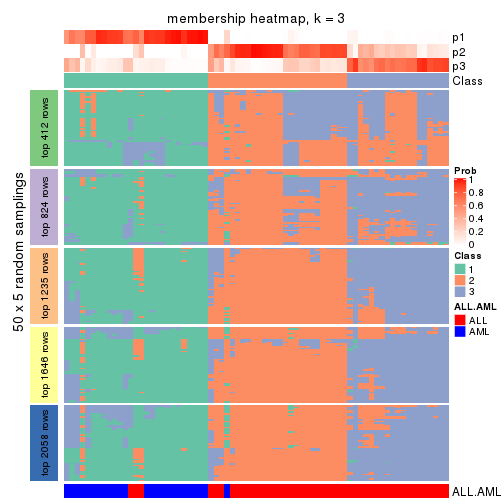
membership_heatmap(res, k = 4)
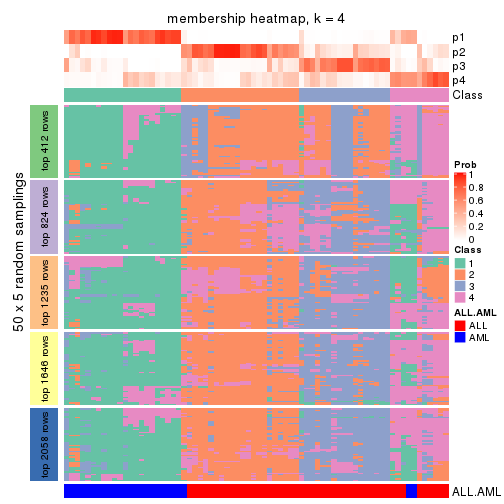
membership_heatmap(res, k = 5)
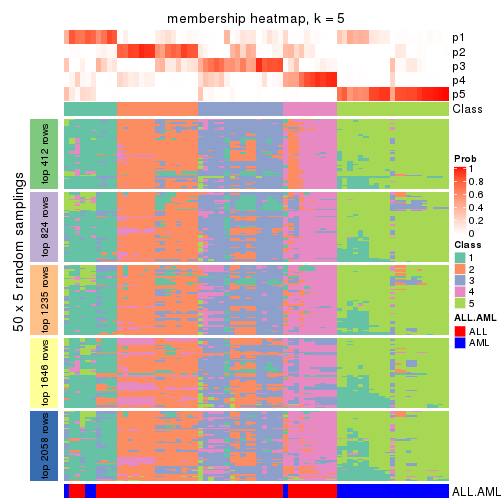
membership_heatmap(res, k = 6)
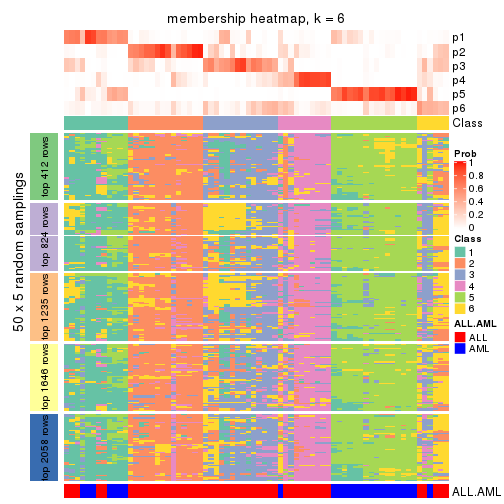
As soon as we have had the classes for columns, we can look for signatures which are significantly different between classes which can be candidate marks for certain classes. Following are the heatmaps for signatures.
Signature heatmaps where rows are scaled:
get_signatures(res, k = 2)
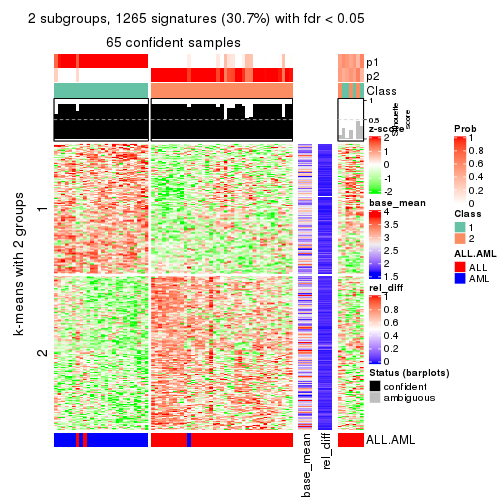
get_signatures(res, k = 3)
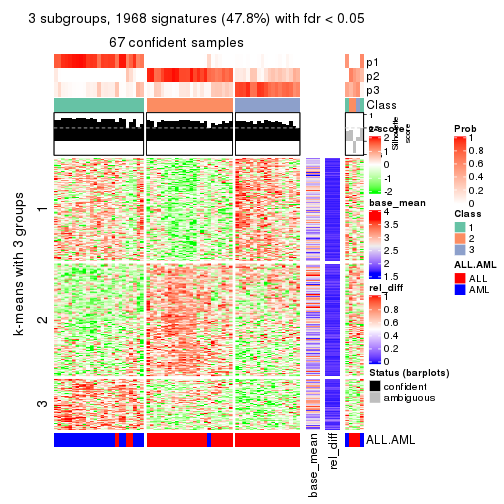
get_signatures(res, k = 4)
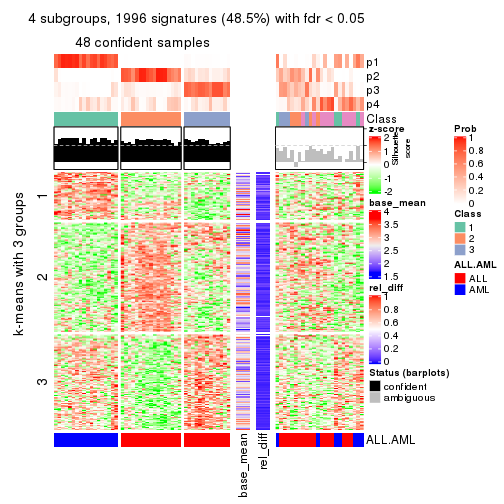
get_signatures(res, k = 5)
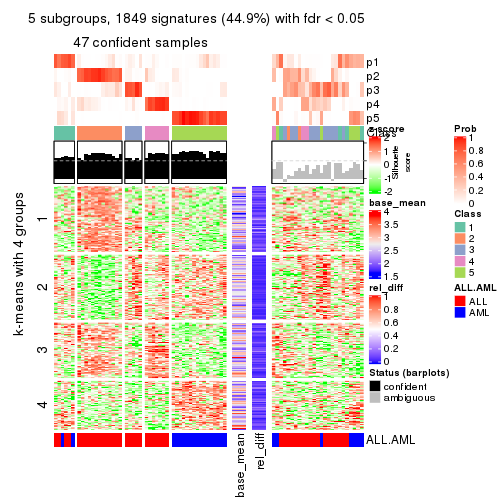
get_signatures(res, k = 6)
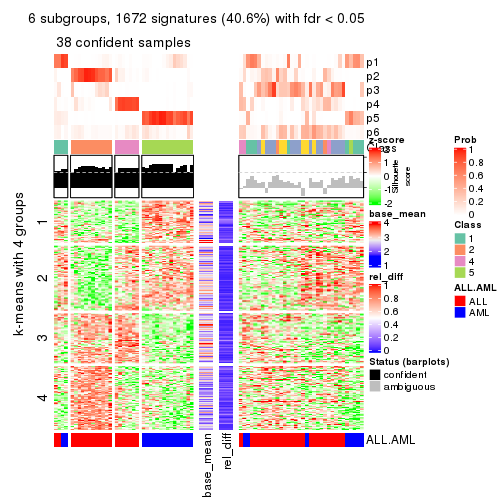
Signature heatmaps where rows are not scaled:
get_signatures(res, k = 2, scale_rows = FALSE)
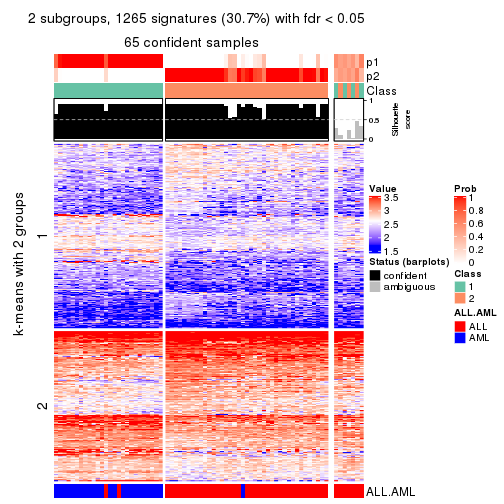
get_signatures(res, k = 3, scale_rows = FALSE)
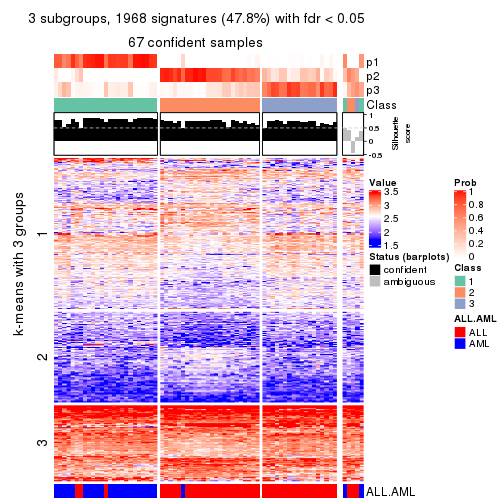
get_signatures(res, k = 4, scale_rows = FALSE)
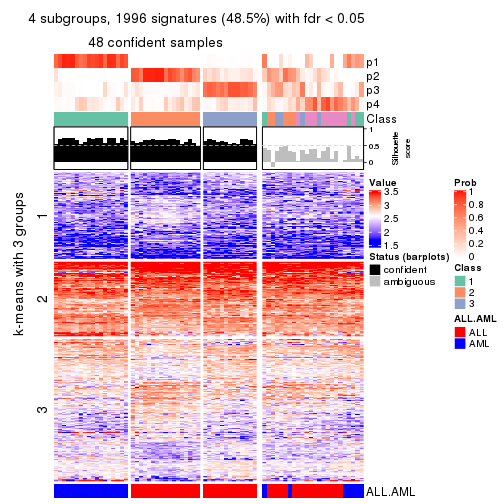
get_signatures(res, k = 5, scale_rows = FALSE)
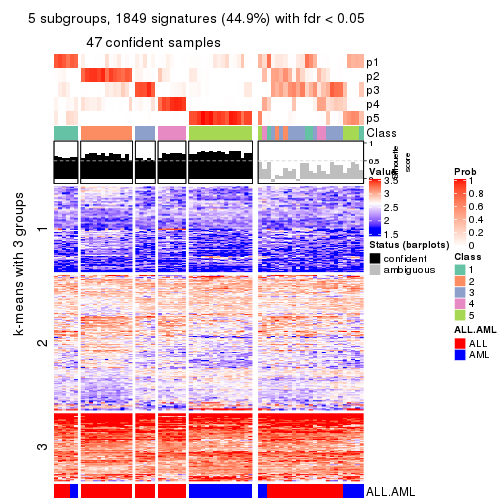
get_signatures(res, k = 6, scale_rows = FALSE)
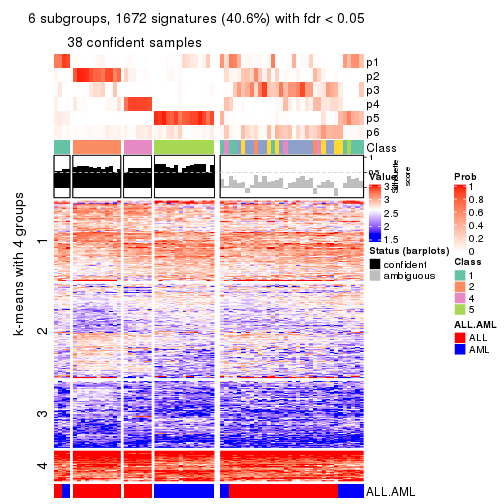
Compare the overlap of signatures from different k:
compare_signatures(res)
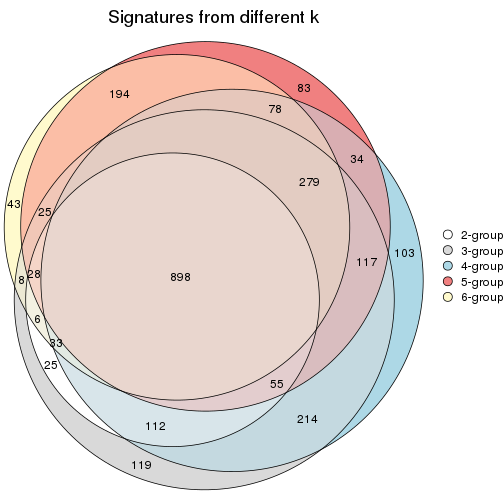
get_signature() returns a data frame invisibly. TO get the list of signatures, the function
call should be assigned to a variable explicitly. In following code, if plot argument is set
to FALSE, no heatmap is plotted while only the differential analysis is performed.
# code only for demonstration
tb = get_signature(res, k = ..., plot = FALSE)
An example of the output of tb is:
#> which_row fdr mean_1 mean_2 scaled_mean_1 scaled_mean_2 km
#> 1 38 0.042760348 8.373488 9.131774 -0.5533452 0.5164555 1
#> 2 40 0.018707592 7.106213 8.469186 -0.6173731 0.5762149 1
#> 3 55 0.019134737 10.221463 11.207825 -0.6159697 0.5749050 1
#> 4 59 0.006059896 5.921854 7.869574 -0.6899429 0.6439467 1
#> 5 60 0.018055526 8.928898 10.211722 -0.6204761 0.5791110 1
#> 6 98 0.009384629 15.714769 14.887706 0.6635654 -0.6193277 2
...
The columns in tb are:
which_row: row indices corresponding to the input matrix.fdr: FDR for the differential test. mean_x: The mean value in group x.scaled_mean_x: The mean value in group x after rows are scaled.km: Row groups if k-means clustering is applied to rows.UMAP plot which shows how samples are separated.
dimension_reduction(res, k = 2, method = "UMAP")
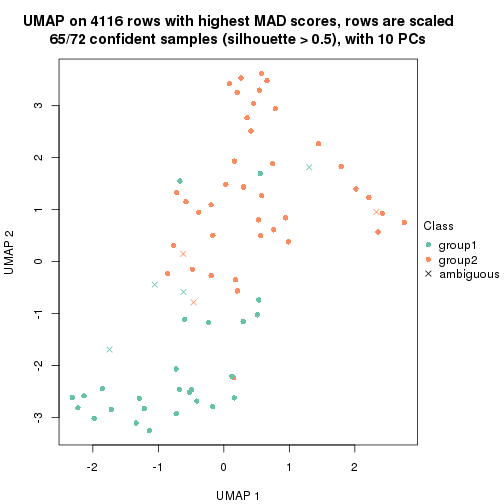
dimension_reduction(res, k = 3, method = "UMAP")
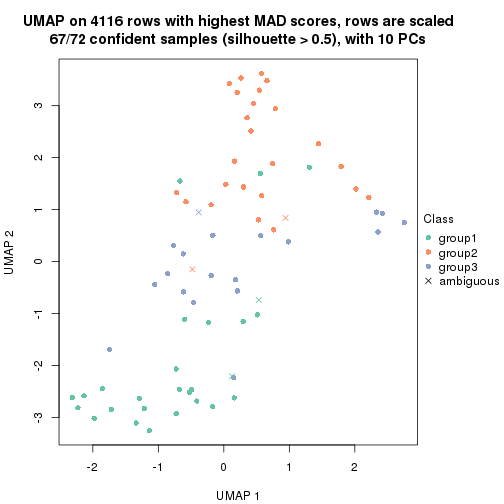
dimension_reduction(res, k = 4, method = "UMAP")
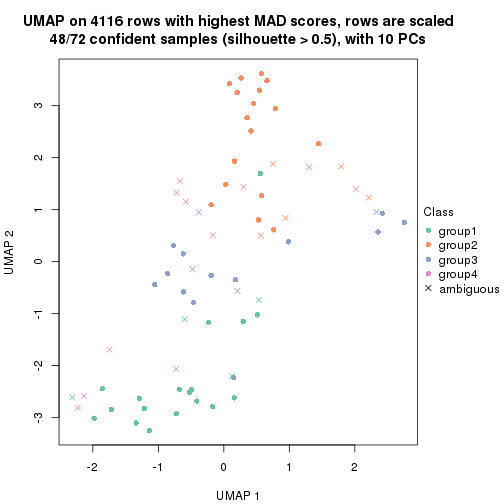
dimension_reduction(res, k = 5, method = "UMAP")
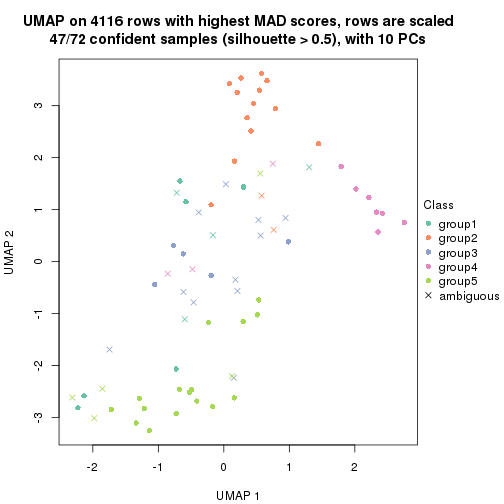
dimension_reduction(res, k = 6, method = "UMAP")
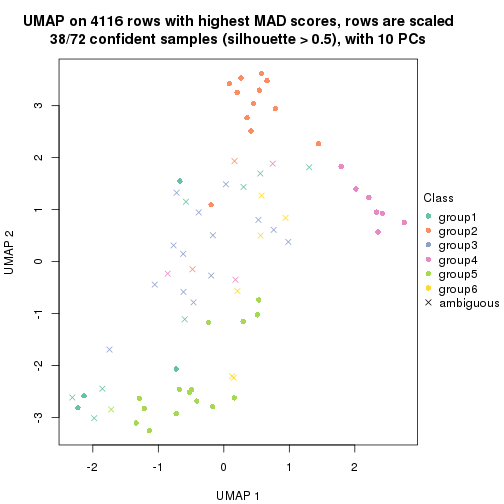
Following heatmap shows how subgroups are split when increasing k:
collect_classes(res)
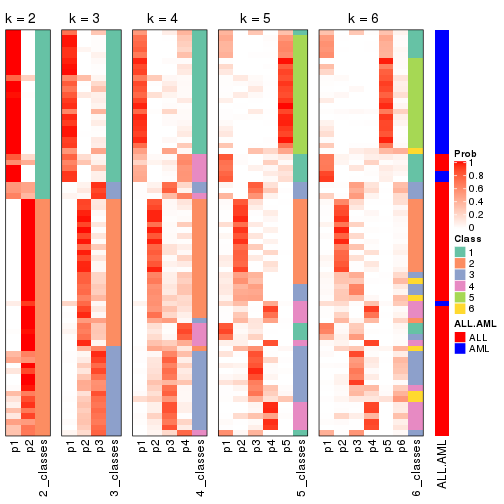
Test correlation between subgroups and known annotations. If the known annotation is numeric, one-way ANOVA test is applied, and if the known annotation is discrete, chi-squared contingency table test is applied.
test_to_known_factors(res)
#> n ALL.AML(p) k
#> MAD:NMF 65 2.13e-12 2
#> MAD:NMF 67 8.26e-12 3
#> MAD:NMF 48 3.78e-11 4
#> MAD:NMF 47 2.27e-08 5
#> MAD:NMF 38 2.02e-07 6
If matrix rows can be associated to genes, consider to use functional_enrichment(res,
...) to perform function enrichment for the signature genes. See this vignette for more detailed explanations.
The object with results only for a single top-value method and a single partition method can be extracted as:
res = res_list["ATC", "hclust"]
# you can also extract it by
# res = res_list["ATC:hclust"]
A summary of res and all the functions that can be applied to it:
res
#> A 'ConsensusPartition' object with k = 2, 3, 4, 5, 6.
#> On a matrix with 4116 rows and 72 columns.
#> Top rows (412, 824, 1235, 1646, 2058) are extracted by 'ATC' method.
#> Subgroups are detected by 'hclust' method.
#> Performed in total 1250 partitions by row resampling.
#> Best k for subgroups seems to be 2.
#>
#> Following methods can be applied to this 'ConsensusPartition' object:
#> [1] "cola_report" "collect_classes" "collect_plots"
#> [4] "collect_stats" "colnames" "compare_signatures"
#> [7] "consensus_heatmap" "dimension_reduction" "functional_enrichment"
#> [10] "get_anno_col" "get_anno" "get_classes"
#> [13] "get_consensus" "get_matrix" "get_membership"
#> [16] "get_param" "get_signatures" "get_stats"
#> [19] "is_best_k" "is_stable_k" "membership_heatmap"
#> [22] "ncol" "nrow" "plot_ecdf"
#> [25] "rownames" "select_partition_number" "show"
#> [28] "suggest_best_k" "test_to_known_factors"
collect_plots() function collects all the plots made from res for all k (number of partitions)
into one single page to provide an easy and fast comparison between different k.
collect_plots(res)
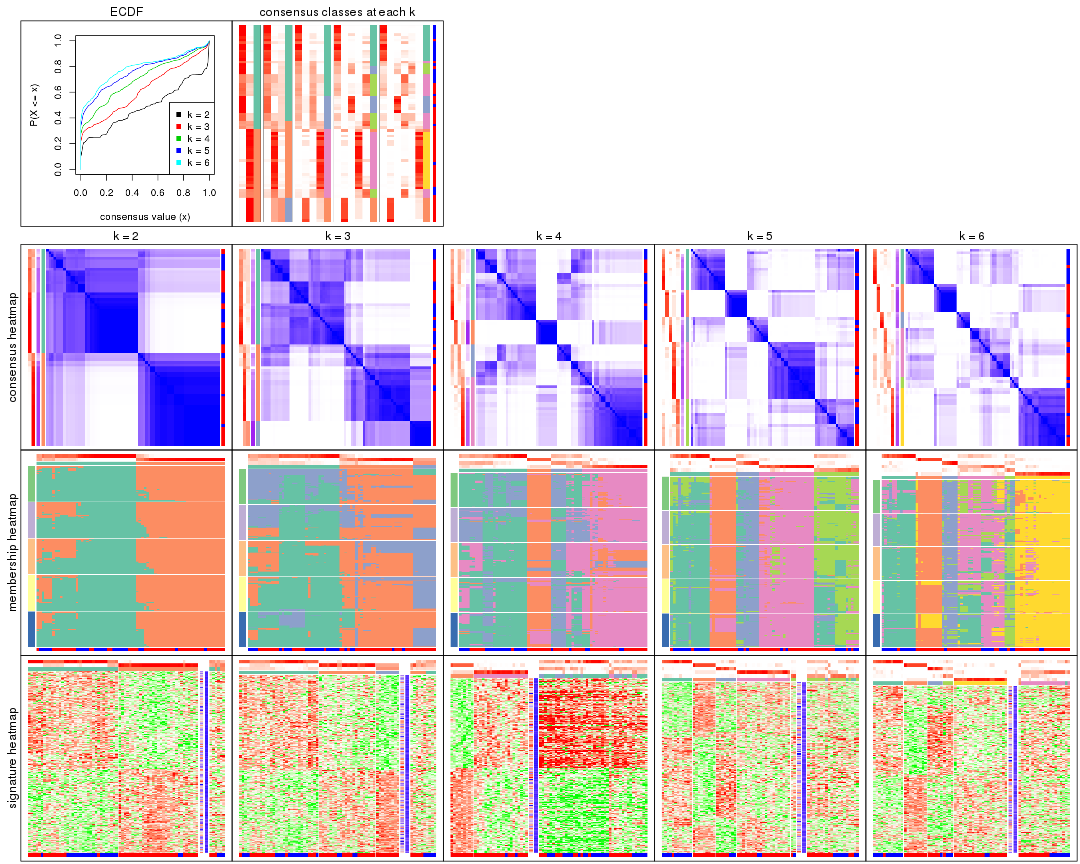
The plots are:
k and the heatmap of
predicted classes for each k.k.k.k.All the plots in panels can be made by individual functions and they are plotted later in this section.
select_partition_number() produces several plots showing different
statistics for choosing “optimized” k. There are following statistics:
k;k, the area increased is defined as \(A_k - A_{k-1}\).The detailed explanations of these statistics can be found in the cola vignette.
Generally speaking, lower PAC score, higher mean silhouette score or higher
concordance corresponds to better partition. Rand index and Jaccard index
measure how similar the current partition is compared to partition with k-1.
If they are too similar, we won't accept k is better than k-1.
select_partition_number(res)
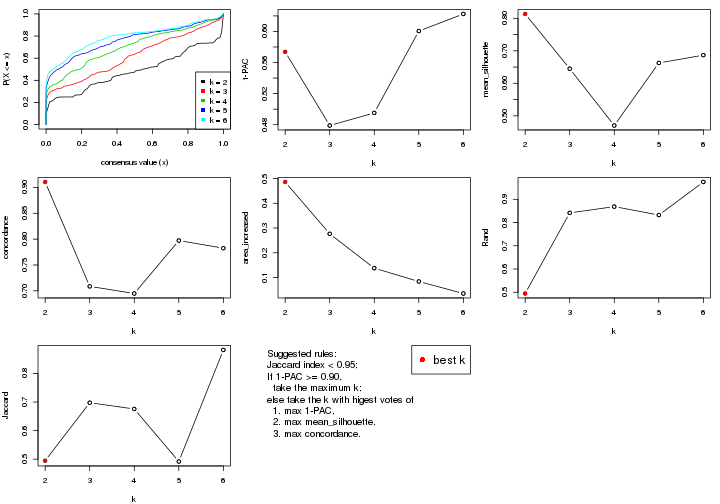
The numeric values for all these statistics can be obtained by get_stats().
get_stats(res)
#> k 1-PAC mean_silhouette concordance area_increased Rand Jaccard
#> 2 2 0.574 0.813 0.911 0.4864 0.495 0.495
#> 3 3 0.479 0.645 0.709 0.2767 0.842 0.698
#> 4 4 0.495 0.470 0.695 0.1376 0.869 0.676
#> 5 5 0.601 0.663 0.797 0.0839 0.832 0.492
#> 6 6 0.622 0.687 0.782 0.0352 0.975 0.882
suggest_best_k() suggests the best \(k\) based on these statistics. The rules are as follows:
suggest_best_k(res)
#> [1] 2
Following shows the table of the partitions (You need to click the show/hide
code output link to see it). The membership matrix (columns with name p*)
is inferred by
clue::cl_consensus()
function with the SE method. Basically the value in the membership matrix
represents the probability to belong to a certain group. The finall class
label for an item is determined with the group with highest probability it
belongs to.
In get_classes() function, the entropy is calculated from the membership
matrix and the silhouette score is calculated from the consensus matrix.
cbind(get_classes(res, k = 2), get_membership(res, k = 2))
#> class entropy silhouette p1 p2
#> sample_39 1 0.0000 0.856 1.000 0.000
#> sample_40 1 0.0376 0.855 0.996 0.004
#> sample_42 2 0.0672 0.939 0.008 0.992
#> sample_47 2 0.0000 0.940 0.000 1.000
#> sample_48 2 0.0000 0.940 0.000 1.000
#> sample_49 1 0.0000 0.856 1.000 0.000
#> sample_41 2 0.0000 0.940 0.000 1.000
#> sample_43 2 0.0672 0.939 0.008 0.992
#> sample_44 2 0.0000 0.940 0.000 1.000
#> sample_45 2 0.0000 0.940 0.000 1.000
#> sample_46 2 0.0672 0.939 0.008 0.992
#> sample_70 2 0.1184 0.935 0.016 0.984
#> sample_71 2 0.0938 0.937 0.012 0.988
#> sample_72 2 0.0938 0.937 0.012 0.988
#> sample_68 2 0.0000 0.940 0.000 1.000
#> sample_69 2 0.0000 0.940 0.000 1.000
#> sample_67 2 0.0938 0.937 0.012 0.988
#> sample_55 1 0.9963 0.307 0.536 0.464
#> sample_56 1 0.0000 0.856 1.000 0.000
#> sample_59 2 0.7139 0.709 0.196 0.804
#> sample_52 1 0.9491 0.540 0.632 0.368
#> sample_53 1 0.0000 0.856 1.000 0.000
#> sample_51 1 0.0000 0.856 1.000 0.000
#> sample_50 1 0.0000 0.856 1.000 0.000
#> sample_54 2 0.9129 0.420 0.328 0.672
#> sample_57 1 1.0000 0.193 0.500 0.500
#> sample_58 1 0.0000 0.856 1.000 0.000
#> sample_60 2 0.9358 0.351 0.352 0.648
#> sample_61 1 0.0000 0.856 1.000 0.000
#> sample_65 1 0.2043 0.851 0.968 0.032
#> sample_66 2 0.0000 0.940 0.000 1.000
#> sample_63 1 0.9491 0.540 0.632 0.368
#> sample_64 1 0.0000 0.856 1.000 0.000
#> sample_62 1 0.9491 0.540 0.632 0.368
#> sample_1 1 0.7815 0.748 0.768 0.232
#> sample_2 2 0.0376 0.940 0.004 0.996
#> sample_3 1 0.7950 0.739 0.760 0.240
#> sample_4 1 0.7376 0.766 0.792 0.208
#> sample_5 2 0.0000 0.940 0.000 1.000
#> sample_6 1 0.7950 0.739 0.760 0.240
#> sample_7 1 0.7376 0.766 0.792 0.208
#> sample_8 1 0.0000 0.856 1.000 0.000
#> sample_9 2 0.0376 0.940 0.004 0.996
#> sample_10 1 0.9833 0.419 0.576 0.424
#> sample_11 2 0.0376 0.940 0.004 0.996
#> sample_12 1 0.7299 0.771 0.796 0.204
#> sample_13 2 0.0000 0.940 0.000 1.000
#> sample_14 2 0.0000 0.940 0.000 1.000
#> sample_15 2 0.0000 0.940 0.000 1.000
#> sample_16 2 0.2778 0.907 0.048 0.952
#> sample_17 2 0.1184 0.934 0.016 0.984
#> sample_18 2 0.9491 0.303 0.368 0.632
#> sample_19 2 0.2778 0.907 0.048 0.952
#> sample_20 2 0.0000 0.940 0.000 1.000
#> sample_21 2 0.0000 0.940 0.000 1.000
#> sample_22 1 0.0672 0.855 0.992 0.008
#> sample_23 1 0.7950 0.739 0.760 0.240
#> sample_24 2 0.0000 0.940 0.000 1.000
#> sample_25 1 0.7528 0.763 0.784 0.216
#> sample_26 2 0.6247 0.774 0.156 0.844
#> sample_27 1 0.0000 0.856 1.000 0.000
#> sample_34 1 0.0000 0.856 1.000 0.000
#> sample_35 1 0.0000 0.856 1.000 0.000
#> sample_36 1 0.6148 0.785 0.848 0.152
#> sample_37 1 0.0000 0.856 1.000 0.000
#> sample_38 1 0.0000 0.856 1.000 0.000
#> sample_28 1 0.2948 0.844 0.948 0.052
#> sample_29 2 0.0376 0.940 0.004 0.996
#> sample_30 1 0.8555 0.680 0.720 0.280
#> sample_31 1 0.1184 0.854 0.984 0.016
#> sample_32 1 0.0938 0.855 0.988 0.012
#> sample_33 1 0.0000 0.856 1.000 0.000
cbind(get_classes(res, k = 3), get_membership(res, k = 3))
#> class entropy silhouette p1 p2 p3
#> sample_39 1 0.4842 0.7072 0.776 0.000 0.224
#> sample_40 1 0.4784 0.7476 0.796 0.004 0.200
#> sample_42 2 0.0237 0.7097 0.004 0.996 0.000
#> sample_47 2 0.3482 0.4739 0.000 0.872 0.128
#> sample_48 3 0.6260 0.9974 0.000 0.448 0.552
#> sample_49 1 0.4750 0.6977 0.784 0.000 0.216
#> sample_41 3 0.6267 0.9907 0.000 0.452 0.548
#> sample_43 2 0.0475 0.7109 0.004 0.992 0.004
#> sample_44 2 0.2711 0.5752 0.000 0.912 0.088
#> sample_45 2 0.2711 0.5752 0.000 0.912 0.088
#> sample_46 2 0.0475 0.7109 0.004 0.992 0.004
#> sample_70 2 0.0829 0.7112 0.004 0.984 0.012
#> sample_71 2 0.0661 0.7105 0.004 0.988 0.008
#> sample_72 2 0.0661 0.7105 0.004 0.988 0.008
#> sample_68 3 0.6260 0.9974 0.000 0.448 0.552
#> sample_69 3 0.6260 0.9974 0.000 0.448 0.552
#> sample_67 2 0.0661 0.7105 0.004 0.988 0.008
#> sample_55 2 0.9615 0.0641 0.324 0.456 0.220
#> sample_56 1 0.4842 0.7031 0.776 0.000 0.224
#> sample_59 2 0.5696 0.6059 0.056 0.796 0.148
#> sample_52 1 0.9483 0.2474 0.448 0.364 0.188
#> sample_53 1 0.0424 0.7618 0.992 0.000 0.008
#> sample_51 1 0.0424 0.7622 0.992 0.000 0.008
#> sample_50 1 0.0424 0.7622 0.992 0.000 0.008
#> sample_54 2 0.7917 0.5188 0.152 0.664 0.184
#> sample_57 2 0.9442 0.1696 0.288 0.496 0.216
#> sample_58 1 0.4605 0.6998 0.796 0.000 0.204
#> sample_60 2 0.8216 0.5008 0.172 0.640 0.188
#> sample_61 1 0.2448 0.7591 0.924 0.000 0.076
#> sample_65 1 0.3832 0.7494 0.888 0.036 0.076
#> sample_66 2 0.0892 0.6922 0.000 0.980 0.020
#> sample_63 1 0.9451 0.2544 0.452 0.364 0.184
#> sample_64 1 0.4178 0.7159 0.828 0.000 0.172
#> sample_62 1 0.9451 0.2544 0.452 0.364 0.184
#> sample_1 1 0.9086 0.5342 0.552 0.228 0.220
#> sample_2 2 0.0592 0.7004 0.000 0.988 0.012
#> sample_3 1 0.9081 0.5173 0.552 0.236 0.212
#> sample_4 1 0.8876 0.5634 0.576 0.204 0.220
#> sample_5 3 0.6260 0.9974 0.000 0.448 0.552
#> sample_6 1 0.9081 0.5173 0.552 0.236 0.212
#> sample_7 1 0.8876 0.5634 0.576 0.204 0.220
#> sample_8 1 0.4555 0.7074 0.800 0.000 0.200
#> sample_9 2 0.0592 0.7004 0.000 0.988 0.012
#> sample_10 2 0.9491 -0.1617 0.396 0.420 0.184
#> sample_11 2 0.0592 0.7004 0.000 0.988 0.012
#> sample_12 1 0.8568 0.5810 0.608 0.200 0.192
#> sample_13 3 0.6260 0.9974 0.000 0.448 0.552
#> sample_14 2 0.1860 0.6466 0.000 0.948 0.052
#> sample_15 3 0.6260 0.9974 0.000 0.448 0.552
#> sample_16 2 0.2550 0.6949 0.012 0.932 0.056
#> sample_17 2 0.1315 0.7104 0.008 0.972 0.020
#> sample_18 2 0.8399 0.4741 0.188 0.624 0.188
#> sample_19 2 0.2550 0.6949 0.012 0.932 0.056
#> sample_20 3 0.6260 0.9974 0.000 0.448 0.552
#> sample_21 3 0.6244 0.9862 0.000 0.440 0.560
#> sample_22 1 0.1170 0.7631 0.976 0.008 0.016
#> sample_23 1 0.9081 0.5173 0.552 0.236 0.212
#> sample_24 2 0.6095 -0.6202 0.000 0.608 0.392
#> sample_25 1 0.8643 0.5714 0.600 0.212 0.188
#> sample_26 2 0.4964 0.6329 0.048 0.836 0.116
#> sample_27 1 0.4750 0.6977 0.784 0.000 0.216
#> sample_34 1 0.4110 0.7527 0.844 0.004 0.152
#> sample_35 1 0.4121 0.7213 0.832 0.000 0.168
#> sample_36 1 0.6431 0.6595 0.760 0.156 0.084
#> sample_37 1 0.0237 0.7620 0.996 0.000 0.004
#> sample_38 1 0.0424 0.7618 0.992 0.000 0.008
#> sample_28 1 0.4689 0.7314 0.852 0.052 0.096
#> sample_29 2 0.0424 0.7027 0.000 0.992 0.008
#> sample_30 1 0.9042 0.4503 0.544 0.280 0.176
#> sample_31 1 0.3325 0.7528 0.904 0.020 0.076
#> sample_32 1 0.2703 0.7570 0.928 0.016 0.056
#> sample_33 1 0.1643 0.7581 0.956 0.000 0.044
cbind(get_classes(res, k = 4), get_membership(res, k = 4))
#> class entropy silhouette p1 p2 p3 p4
#> sample_39 3 0.6253 0.2380 0.372 0.064 0.564 0.000
#> sample_40 1 0.6143 0.0361 0.496 0.048 0.456 0.000
#> sample_42 4 0.0000 0.8201 0.000 0.000 0.000 1.000
#> sample_47 4 0.3528 0.6400 0.000 0.192 0.000 0.808
#> sample_48 2 0.3764 0.9796 0.000 0.784 0.000 0.216
#> sample_49 3 0.6398 0.2664 0.344 0.080 0.576 0.000
#> sample_41 2 0.3873 0.9646 0.000 0.772 0.000 0.228
#> sample_43 4 0.0188 0.8206 0.000 0.000 0.004 0.996
#> sample_44 4 0.3172 0.6935 0.000 0.160 0.000 0.840
#> sample_45 4 0.3123 0.6987 0.000 0.156 0.000 0.844
#> sample_46 4 0.0188 0.8206 0.000 0.000 0.004 0.996
#> sample_70 4 0.0469 0.8206 0.000 0.000 0.012 0.988
#> sample_71 4 0.0376 0.8208 0.000 0.004 0.004 0.992
#> sample_72 4 0.0376 0.8208 0.000 0.004 0.004 0.992
#> sample_68 2 0.3764 0.9796 0.000 0.784 0.000 0.216
#> sample_69 2 0.3764 0.9796 0.000 0.784 0.000 0.216
#> sample_67 4 0.0376 0.8208 0.000 0.004 0.004 0.992
#> sample_55 3 0.8486 -0.0410 0.244 0.028 0.400 0.328
#> sample_56 3 0.6324 0.2639 0.340 0.076 0.584 0.000
#> sample_59 4 0.4476 0.6999 0.008 0.032 0.160 0.800
#> sample_52 1 0.8453 0.1450 0.392 0.028 0.352 0.228
#> sample_53 1 0.0188 0.4915 0.996 0.000 0.004 0.000
#> sample_51 1 0.0188 0.4950 0.996 0.000 0.004 0.000
#> sample_50 1 0.0188 0.4950 0.996 0.000 0.004 0.000
#> sample_54 4 0.7414 0.3395 0.100 0.032 0.308 0.560
#> sample_57 3 0.8391 -0.0318 0.212 0.028 0.400 0.360
#> sample_58 3 0.6474 0.2241 0.388 0.076 0.536 0.000
#> sample_60 4 0.7720 0.2566 0.120 0.032 0.328 0.520
#> sample_61 1 0.3142 0.4112 0.860 0.008 0.132 0.000
#> sample_65 1 0.3324 0.4898 0.852 0.000 0.136 0.012
#> sample_66 4 0.1022 0.8099 0.000 0.032 0.000 0.968
#> sample_63 1 0.8450 0.1489 0.396 0.028 0.348 0.228
#> sample_64 1 0.6120 -0.1603 0.520 0.048 0.432 0.000
#> sample_62 1 0.8450 0.1489 0.396 0.028 0.348 0.228
#> sample_1 3 0.6926 -0.1876 0.400 0.004 0.500 0.096
#> sample_2 4 0.0592 0.8168 0.000 0.016 0.000 0.984
#> sample_3 1 0.6845 0.1598 0.452 0.000 0.448 0.100
#> sample_4 3 0.6650 -0.2058 0.424 0.004 0.500 0.072
#> sample_5 2 0.3764 0.9796 0.000 0.784 0.000 0.216
#> sample_6 1 0.6845 0.1598 0.452 0.000 0.448 0.100
#> sample_7 3 0.6650 -0.2058 0.424 0.004 0.500 0.072
#> sample_8 3 0.6499 0.2206 0.400 0.076 0.524 0.000
#> sample_9 4 0.0707 0.8160 0.000 0.020 0.000 0.980
#> sample_10 3 0.8066 -0.0789 0.328 0.004 0.360 0.308
#> sample_11 4 0.0592 0.8168 0.000 0.016 0.000 0.984
#> sample_12 1 0.6592 0.2303 0.524 0.000 0.392 0.084
#> sample_13 2 0.3764 0.9796 0.000 0.784 0.000 0.216
#> sample_14 4 0.2281 0.7628 0.000 0.096 0.000 0.904
#> sample_15 2 0.3764 0.9796 0.000 0.784 0.000 0.216
#> sample_16 4 0.2984 0.7840 0.000 0.028 0.084 0.888
#> sample_17 4 0.1543 0.8150 0.004 0.008 0.032 0.956
#> sample_18 4 0.7816 0.2456 0.132 0.032 0.320 0.516
#> sample_19 4 0.2984 0.7840 0.000 0.028 0.084 0.888
#> sample_20 2 0.3764 0.9796 0.000 0.784 0.000 0.216
#> sample_21 2 0.2530 0.8613 0.000 0.888 0.000 0.112
#> sample_22 1 0.1339 0.4865 0.964 0.008 0.024 0.004
#> sample_23 1 0.6845 0.1598 0.452 0.000 0.448 0.100
#> sample_24 4 0.4989 -0.3169 0.000 0.472 0.000 0.528
#> sample_25 1 0.6804 0.2236 0.520 0.000 0.376 0.104
#> sample_26 4 0.4568 0.6773 0.024 0.004 0.200 0.772
#> sample_27 3 0.6398 0.2664 0.344 0.080 0.576 0.000
#> sample_34 1 0.5827 0.0495 0.568 0.036 0.396 0.000
#> sample_35 1 0.6187 -0.1563 0.516 0.052 0.432 0.000
#> sample_36 1 0.5912 0.3961 0.724 0.012 0.148 0.116
#> sample_37 1 0.0000 0.4936 1.000 0.000 0.000 0.000
#> sample_38 1 0.0188 0.4915 0.996 0.000 0.004 0.000
#> sample_28 1 0.3743 0.4687 0.824 0.000 0.160 0.016
#> sample_29 4 0.0469 0.8180 0.000 0.012 0.000 0.988
#> sample_30 1 0.7822 0.2421 0.492 0.024 0.340 0.144
#> sample_31 1 0.2814 0.4920 0.868 0.000 0.132 0.000
#> sample_32 1 0.2281 0.4968 0.904 0.000 0.096 0.000
#> sample_33 1 0.1716 0.4421 0.936 0.000 0.064 0.000
cbind(get_classes(res, k = 5), get_membership(res, k = 5))
#> class entropy silhouette p1 p2 p3 p4 p5
#> sample_39 3 0.2519 0.764 0.100 0.000 0.884 0.000 0.016
#> sample_40 3 0.6830 0.211 0.380 0.016 0.432 0.000 0.172
#> sample_42 4 0.0000 0.896 0.000 0.000 0.000 1.000 0.000
#> sample_47 4 0.3720 0.676 0.000 0.228 0.000 0.760 0.012
#> sample_48 2 0.2377 0.929 0.000 0.872 0.000 0.128 0.000
#> sample_49 3 0.1121 0.768 0.044 0.000 0.956 0.000 0.000
#> sample_41 2 0.2561 0.915 0.000 0.856 0.000 0.144 0.000
#> sample_43 4 0.0162 0.896 0.000 0.000 0.000 0.996 0.004
#> sample_44 4 0.2852 0.766 0.000 0.172 0.000 0.828 0.000
#> sample_45 4 0.2813 0.771 0.000 0.168 0.000 0.832 0.000
#> sample_46 4 0.0162 0.896 0.000 0.000 0.000 0.996 0.004
#> sample_70 4 0.0404 0.895 0.000 0.000 0.000 0.988 0.012
#> sample_71 4 0.0451 0.897 0.000 0.004 0.000 0.988 0.008
#> sample_72 4 0.0451 0.897 0.000 0.004 0.000 0.988 0.008
#> sample_68 2 0.2377 0.929 0.000 0.872 0.000 0.128 0.000
#> sample_69 2 0.2377 0.929 0.000 0.872 0.000 0.128 0.000
#> sample_67 4 0.0324 0.897 0.000 0.004 0.000 0.992 0.004
#> sample_55 5 0.4688 0.569 0.092 0.000 0.016 0.128 0.764
#> sample_56 3 0.1444 0.766 0.040 0.000 0.948 0.000 0.012
#> sample_59 4 0.3461 0.695 0.004 0.000 0.000 0.772 0.224
#> sample_52 5 0.3424 0.454 0.240 0.000 0.000 0.000 0.760
#> sample_53 1 0.0162 0.772 0.996 0.000 0.004 0.000 0.000
#> sample_51 1 0.0566 0.774 0.984 0.000 0.004 0.000 0.012
#> sample_50 1 0.0566 0.774 0.984 0.000 0.004 0.000 0.012
#> sample_54 5 0.3707 0.423 0.000 0.000 0.000 0.284 0.716
#> sample_57 5 0.3572 0.557 0.064 0.000 0.008 0.088 0.840
#> sample_58 3 0.3182 0.739 0.124 0.000 0.844 0.000 0.032
#> sample_60 5 0.3607 0.489 0.004 0.000 0.000 0.244 0.752
#> sample_61 1 0.3812 0.599 0.772 0.000 0.204 0.000 0.024
#> sample_65 1 0.3039 0.696 0.836 0.000 0.012 0.000 0.152
#> sample_66 4 0.0880 0.888 0.000 0.032 0.000 0.968 0.000
#> sample_63 5 0.3452 0.452 0.244 0.000 0.000 0.000 0.756
#> sample_64 3 0.5790 0.511 0.392 0.012 0.532 0.000 0.064
#> sample_62 5 0.3452 0.452 0.244 0.000 0.000 0.000 0.756
#> sample_1 5 0.6847 0.459 0.300 0.004 0.136 0.032 0.528
#> sample_2 4 0.0510 0.895 0.000 0.016 0.000 0.984 0.000
#> sample_3 5 0.6086 0.448 0.364 0.000 0.072 0.024 0.540
#> sample_4 5 0.6526 0.442 0.324 0.004 0.136 0.012 0.524
#> sample_5 2 0.2377 0.929 0.000 0.872 0.000 0.128 0.000
#> sample_6 5 0.6096 0.446 0.368 0.000 0.072 0.024 0.536
#> sample_7 5 0.6526 0.442 0.324 0.004 0.136 0.012 0.524
#> sample_8 3 0.3881 0.723 0.180 0.008 0.788 0.000 0.024
#> sample_9 4 0.0609 0.895 0.000 0.020 0.000 0.980 0.000
#> sample_10 5 0.7474 0.413 0.280 0.000 0.044 0.248 0.428
#> sample_11 4 0.0510 0.895 0.000 0.016 0.000 0.984 0.000
#> sample_12 5 0.5813 0.280 0.460 0.000 0.048 0.020 0.472
#> sample_13 2 0.2377 0.929 0.000 0.872 0.000 0.128 0.000
#> sample_14 4 0.2127 0.838 0.000 0.108 0.000 0.892 0.000
#> sample_15 2 0.2377 0.929 0.000 0.872 0.000 0.128 0.000
#> sample_16 4 0.3351 0.809 0.000 0.028 0.004 0.836 0.132
#> sample_17 4 0.2136 0.859 0.000 0.008 0.000 0.904 0.088
#> sample_18 5 0.4380 0.443 0.016 0.000 0.004 0.292 0.688
#> sample_19 4 0.3351 0.809 0.000 0.028 0.004 0.836 0.132
#> sample_20 2 0.2377 0.929 0.000 0.872 0.000 0.128 0.000
#> sample_21 2 0.0510 0.787 0.000 0.984 0.000 0.016 0.000
#> sample_22 1 0.1750 0.756 0.936 0.000 0.036 0.000 0.028
#> sample_23 5 0.6096 0.446 0.368 0.000 0.072 0.024 0.536
#> sample_24 2 0.4302 0.211 0.000 0.520 0.000 0.480 0.000
#> sample_25 1 0.6155 -0.366 0.456 0.000 0.048 0.040 0.456
#> sample_26 4 0.4230 0.586 0.008 0.000 0.008 0.704 0.280
#> sample_27 3 0.1121 0.768 0.044 0.000 0.956 0.000 0.000
#> sample_34 1 0.6040 -0.253 0.496 0.004 0.396 0.000 0.104
#> sample_35 3 0.5696 0.508 0.400 0.012 0.532 0.000 0.056
#> sample_36 1 0.4196 0.371 0.640 0.000 0.004 0.000 0.356
#> sample_37 1 0.0451 0.773 0.988 0.000 0.004 0.000 0.008
#> sample_38 1 0.0162 0.772 0.996 0.000 0.004 0.000 0.000
#> sample_28 1 0.3282 0.610 0.804 0.000 0.008 0.000 0.188
#> sample_29 4 0.0404 0.895 0.000 0.012 0.000 0.988 0.000
#> sample_30 5 0.4074 0.309 0.364 0.000 0.000 0.000 0.636
#> sample_31 1 0.2771 0.713 0.860 0.000 0.012 0.000 0.128
#> sample_32 1 0.2248 0.742 0.900 0.000 0.012 0.000 0.088
#> sample_33 1 0.1725 0.730 0.936 0.000 0.044 0.000 0.020
cbind(get_classes(res, k = 6), get_membership(res, k = 6))
#> class entropy silhouette p1 p2 p3 p4 p5 p6
#> sample_39 3 0.2344 0.766 0.052 0.000 0.896 0.004 0.048 0.000
#> sample_40 5 0.4754 0.508 0.108 0.000 0.180 0.012 0.700 0.000
#> sample_42 6 0.0146 0.893 0.000 0.000 0.000 0.004 0.000 0.996
#> sample_47 6 0.3431 0.683 0.000 0.228 0.000 0.016 0.000 0.756
#> sample_48 2 0.1957 0.920 0.000 0.888 0.000 0.000 0.000 0.112
#> sample_49 3 0.0000 0.834 0.000 0.000 1.000 0.000 0.000 0.000
#> sample_41 2 0.2219 0.898 0.000 0.864 0.000 0.000 0.000 0.136
#> sample_43 6 0.0458 0.892 0.000 0.000 0.000 0.016 0.000 0.984
#> sample_44 6 0.2912 0.766 0.000 0.172 0.000 0.012 0.000 0.816
#> sample_45 6 0.2877 0.772 0.000 0.168 0.000 0.012 0.000 0.820
#> sample_46 6 0.0458 0.892 0.000 0.000 0.000 0.016 0.000 0.984
#> sample_70 6 0.0692 0.892 0.000 0.000 0.000 0.020 0.004 0.976
#> sample_71 6 0.0665 0.893 0.000 0.004 0.000 0.008 0.008 0.980
#> sample_72 6 0.0665 0.893 0.000 0.004 0.000 0.008 0.008 0.980
#> sample_68 2 0.1957 0.920 0.000 0.888 0.000 0.000 0.000 0.112
#> sample_69 2 0.1957 0.920 0.000 0.888 0.000 0.000 0.000 0.112
#> sample_67 6 0.0551 0.893 0.000 0.004 0.000 0.004 0.008 0.984
#> sample_55 4 0.5478 0.490 0.068 0.000 0.004 0.680 0.144 0.104
#> sample_56 3 0.0777 0.828 0.000 0.000 0.972 0.004 0.024 0.000
#> sample_59 6 0.3445 0.678 0.000 0.000 0.000 0.244 0.012 0.744
#> sample_52 4 0.3558 0.340 0.212 0.000 0.000 0.760 0.028 0.000
#> sample_53 1 0.0405 0.842 0.988 0.000 0.000 0.004 0.008 0.000
#> sample_51 1 0.0146 0.846 0.996 0.000 0.000 0.004 0.000 0.000
#> sample_50 1 0.0146 0.846 0.996 0.000 0.000 0.004 0.000 0.000
#> sample_54 4 0.3290 0.384 0.000 0.000 0.000 0.744 0.004 0.252
#> sample_57 4 0.3724 0.450 0.056 0.000 0.000 0.820 0.052 0.072
#> sample_58 3 0.3307 0.669 0.044 0.000 0.808 0.000 0.148 0.000
#> sample_60 4 0.3163 0.407 0.004 0.000 0.000 0.780 0.004 0.212
#> sample_61 1 0.4049 0.623 0.740 0.000 0.208 0.008 0.044 0.000
#> sample_65 1 0.3346 0.774 0.816 0.000 0.008 0.140 0.036 0.000
#> sample_66 6 0.0790 0.888 0.000 0.032 0.000 0.000 0.000 0.968
#> sample_63 4 0.3586 0.337 0.216 0.000 0.000 0.756 0.028 0.000
#> sample_64 5 0.5470 0.619 0.136 0.000 0.348 0.000 0.516 0.000
#> sample_62 4 0.3586 0.337 0.216 0.000 0.000 0.756 0.028 0.000
#> sample_1 4 0.7499 0.434 0.184 0.000 0.092 0.368 0.336 0.020
#> sample_2 6 0.0603 0.893 0.000 0.016 0.000 0.004 0.000 0.980
#> sample_3 4 0.6923 0.447 0.280 0.000 0.044 0.424 0.244 0.008
#> sample_4 4 0.7149 0.436 0.208 0.000 0.092 0.356 0.344 0.000
#> sample_5 2 0.1957 0.920 0.000 0.888 0.000 0.000 0.000 0.112
#> sample_6 4 0.6920 0.445 0.284 0.000 0.044 0.424 0.240 0.008
#> sample_7 4 0.7149 0.436 0.208 0.000 0.092 0.356 0.344 0.000
#> sample_8 3 0.3766 0.544 0.040 0.000 0.748 0.000 0.212 0.000
#> sample_9 6 0.0692 0.893 0.000 0.020 0.000 0.004 0.000 0.976
#> sample_10 4 0.7951 0.412 0.232 0.000 0.036 0.380 0.128 0.224
#> sample_11 6 0.0603 0.893 0.000 0.016 0.000 0.004 0.000 0.980
#> sample_12 4 0.6578 0.267 0.396 0.000 0.040 0.412 0.144 0.008
#> sample_13 2 0.1957 0.920 0.000 0.888 0.000 0.000 0.000 0.112
#> sample_14 6 0.1910 0.839 0.000 0.108 0.000 0.000 0.000 0.892
#> sample_15 2 0.1957 0.920 0.000 0.888 0.000 0.000 0.000 0.112
#> sample_16 6 0.3435 0.804 0.000 0.028 0.000 0.128 0.024 0.820
#> sample_17 6 0.2163 0.855 0.000 0.008 0.000 0.096 0.004 0.892
#> sample_18 4 0.4708 0.409 0.016 0.000 0.000 0.672 0.056 0.256
#> sample_19 6 0.3435 0.804 0.000 0.028 0.000 0.128 0.024 0.820
#> sample_20 2 0.1957 0.920 0.000 0.888 0.000 0.000 0.000 0.112
#> sample_21 2 0.0146 0.758 0.000 0.996 0.000 0.000 0.004 0.000
#> sample_22 1 0.2401 0.795 0.900 0.000 0.028 0.024 0.048 0.000
#> sample_23 4 0.6920 0.445 0.284 0.000 0.044 0.424 0.240 0.008
#> sample_24 2 0.3860 0.205 0.000 0.528 0.000 0.000 0.000 0.472
#> sample_25 4 0.6907 0.287 0.388 0.000 0.040 0.404 0.140 0.028
#> sample_26 6 0.4351 0.589 0.008 0.000 0.000 0.256 0.044 0.692
#> sample_27 3 0.0000 0.834 0.000 0.000 1.000 0.000 0.000 0.000
#> sample_34 5 0.6810 0.538 0.312 0.000 0.244 0.048 0.396 0.000
#> sample_35 5 0.5536 0.634 0.144 0.000 0.352 0.000 0.504 0.000
#> sample_36 1 0.3992 0.412 0.624 0.000 0.000 0.364 0.012 0.000
#> sample_37 1 0.0146 0.846 0.996 0.000 0.000 0.004 0.000 0.000
#> sample_38 1 0.0405 0.842 0.988 0.000 0.000 0.004 0.008 0.000
#> sample_28 1 0.3628 0.697 0.784 0.000 0.004 0.168 0.044 0.000
#> sample_29 6 0.0363 0.894 0.000 0.012 0.000 0.000 0.000 0.988
#> sample_30 4 0.4278 0.163 0.336 0.000 0.000 0.632 0.032 0.000
#> sample_31 1 0.2949 0.797 0.848 0.000 0.008 0.116 0.028 0.000
#> sample_32 1 0.2401 0.823 0.892 0.000 0.008 0.072 0.028 0.000
#> sample_33 1 0.1644 0.802 0.932 0.000 0.040 0.000 0.028 0.000
Heatmaps for the consensus matrix. It visualizes the probability of two samples to be in a same group.
consensus_heatmap(res, k = 2)
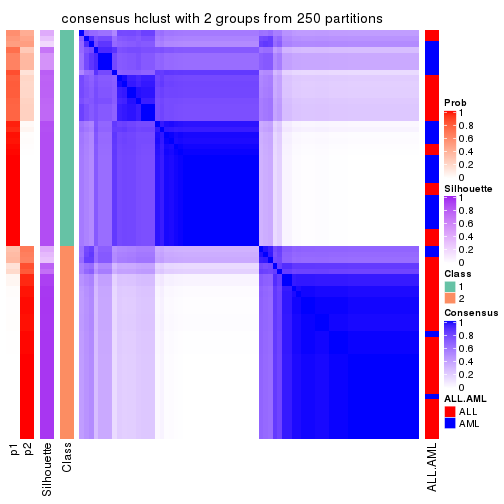
consensus_heatmap(res, k = 3)
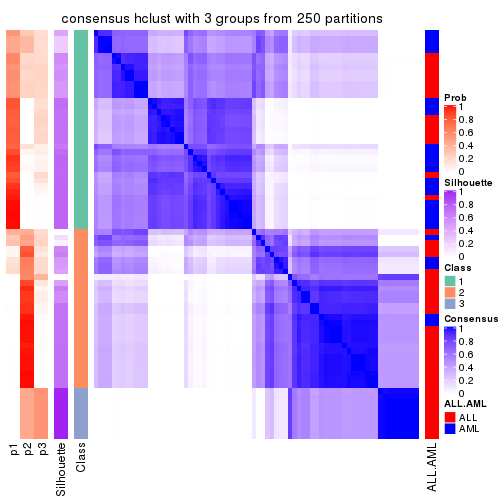
consensus_heatmap(res, k = 4)
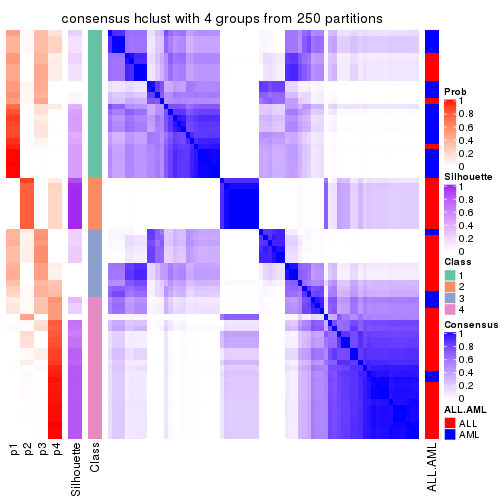
consensus_heatmap(res, k = 5)
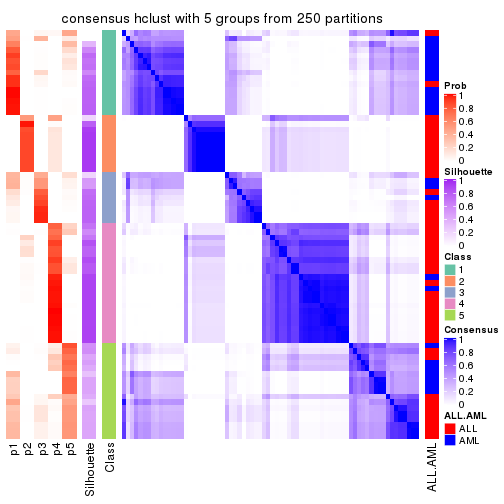
consensus_heatmap(res, k = 6)
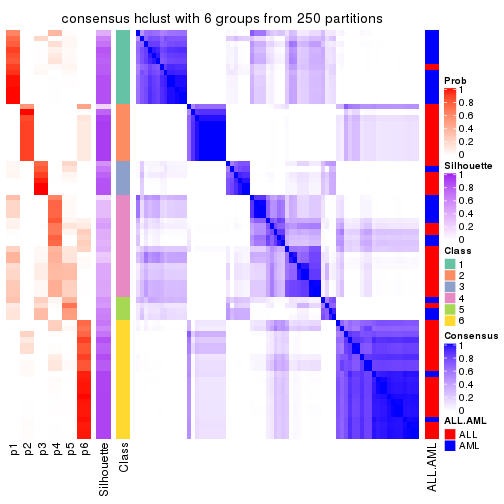
Heatmaps for the membership of samples in all partitions to see how consistent they are:
membership_heatmap(res, k = 2)
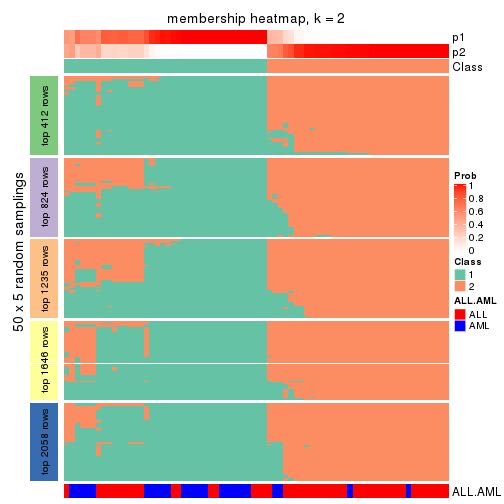
membership_heatmap(res, k = 3)
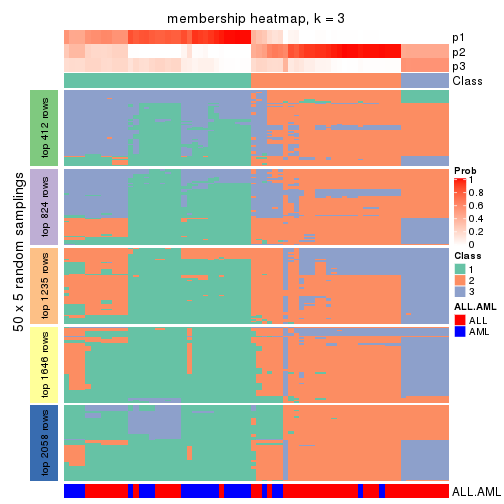
membership_heatmap(res, k = 4)
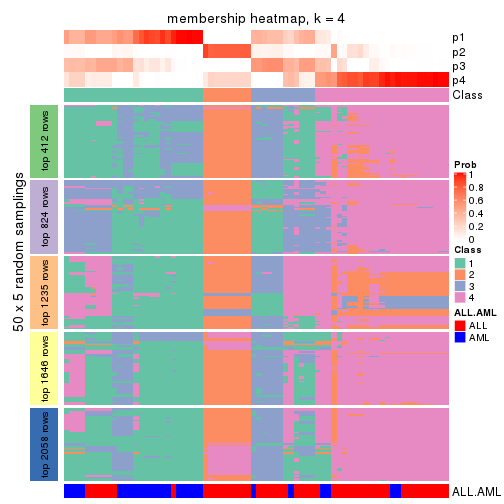
membership_heatmap(res, k = 5)
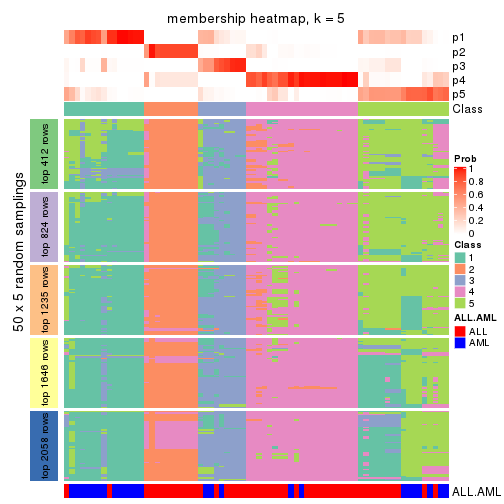
membership_heatmap(res, k = 6)
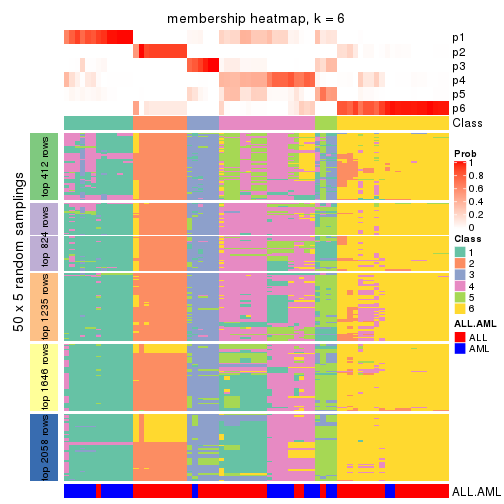
As soon as we have had the classes for columns, we can look for signatures which are significantly different between classes which can be candidate marks for certain classes. Following are the heatmaps for signatures.
Signature heatmaps where rows are scaled:
get_signatures(res, k = 2)
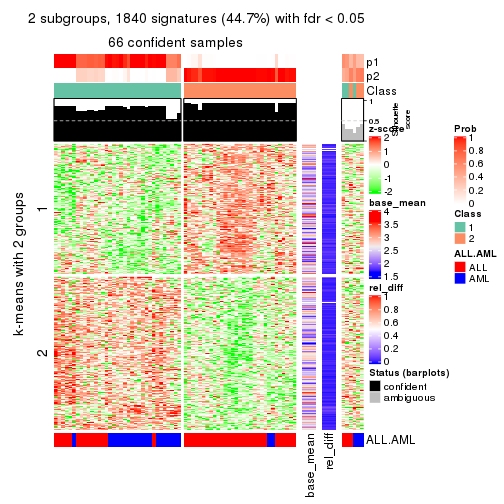
get_signatures(res, k = 3)
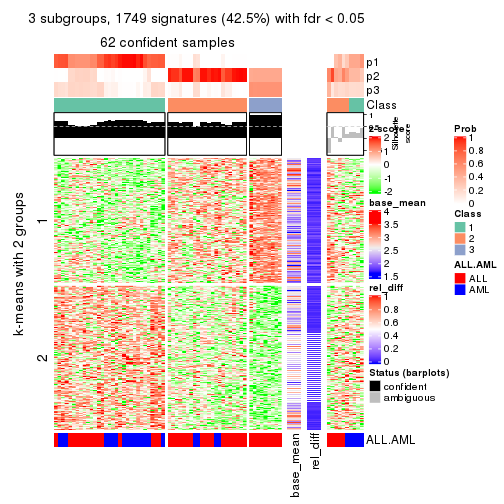
get_signatures(res, k = 4)
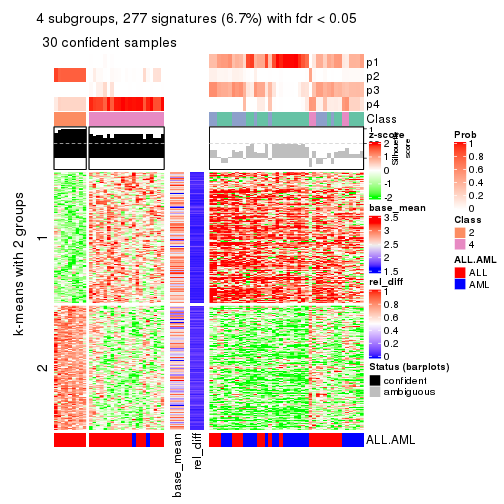
get_signatures(res, k = 5)
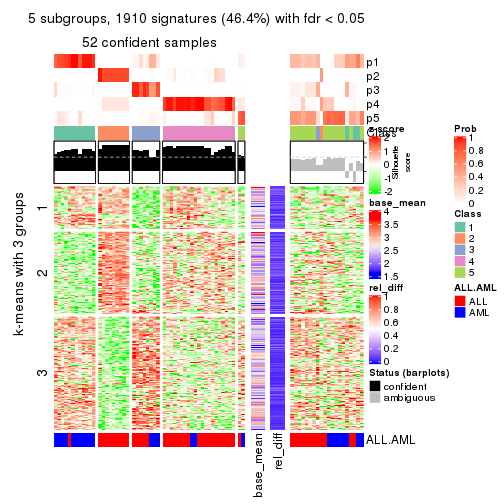
get_signatures(res, k = 6)
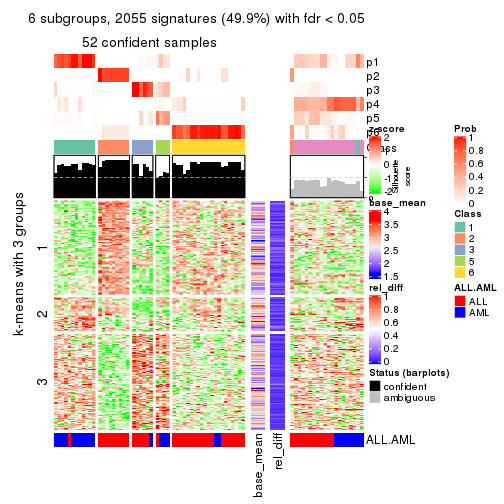
Signature heatmaps where rows are not scaled:
get_signatures(res, k = 2, scale_rows = FALSE)
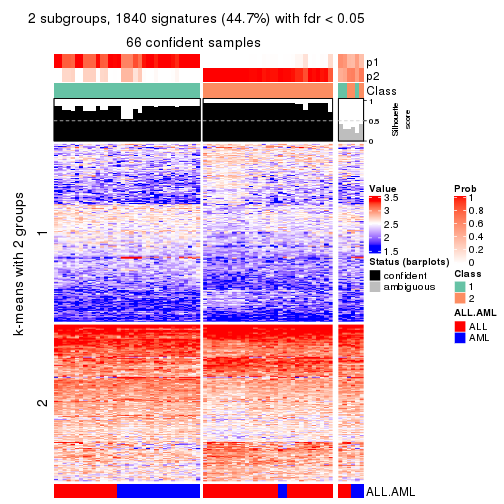
get_signatures(res, k = 3, scale_rows = FALSE)
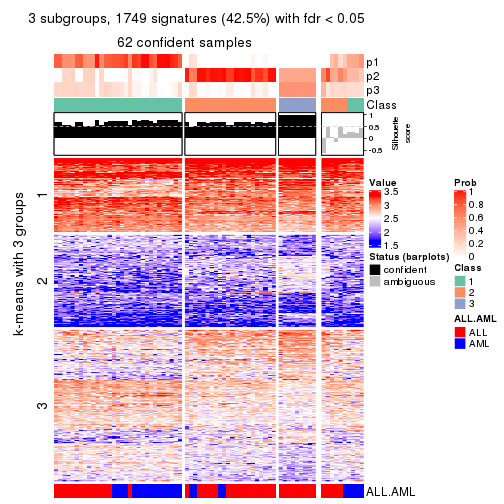
get_signatures(res, k = 4, scale_rows = FALSE)
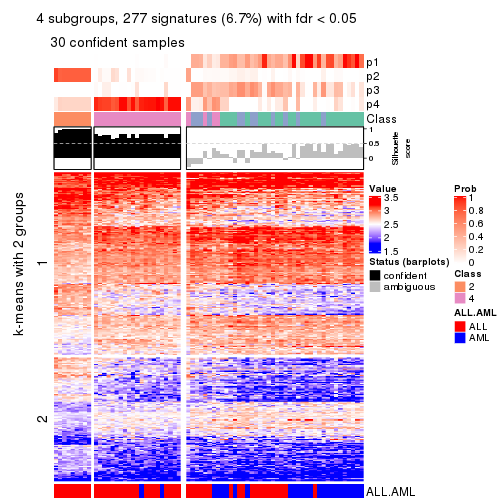
get_signatures(res, k = 5, scale_rows = FALSE)
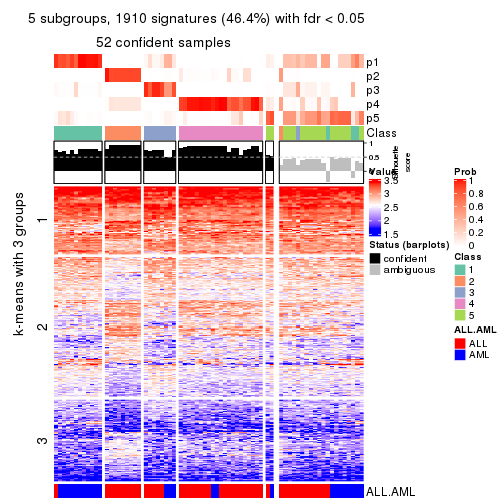
get_signatures(res, k = 6, scale_rows = FALSE)
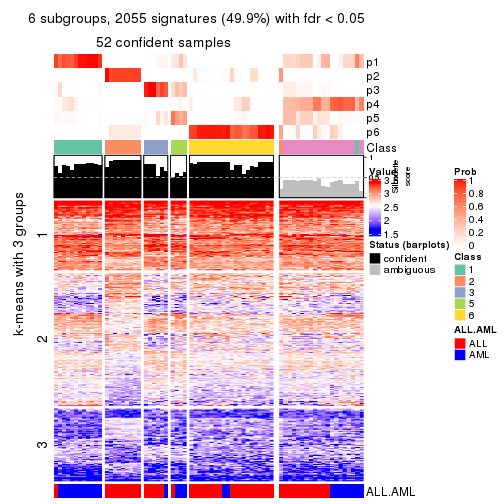
Compare the overlap of signatures from different k:
compare_signatures(res)
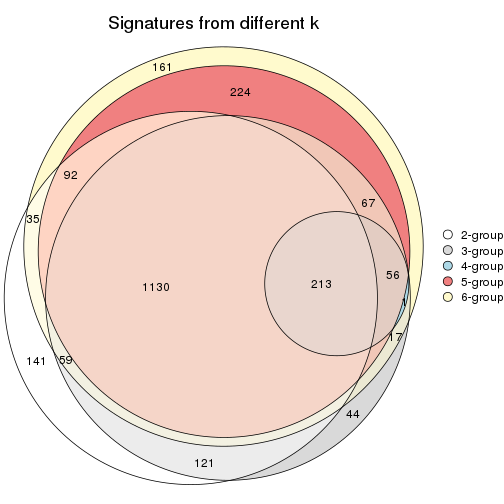
get_signature() returns a data frame invisibly. TO get the list of signatures, the function
call should be assigned to a variable explicitly. In following code, if plot argument is set
to FALSE, no heatmap is plotted while only the differential analysis is performed.
# code only for demonstration
tb = get_signature(res, k = ..., plot = FALSE)
An example of the output of tb is:
#> which_row fdr mean_1 mean_2 scaled_mean_1 scaled_mean_2 km
#> 1 38 0.042760348 8.373488 9.131774 -0.5533452 0.5164555 1
#> 2 40 0.018707592 7.106213 8.469186 -0.6173731 0.5762149 1
#> 3 55 0.019134737 10.221463 11.207825 -0.6159697 0.5749050 1
#> 4 59 0.006059896 5.921854 7.869574 -0.6899429 0.6439467 1
#> 5 60 0.018055526 8.928898 10.211722 -0.6204761 0.5791110 1
#> 6 98 0.009384629 15.714769 14.887706 0.6635654 -0.6193277 2
...
The columns in tb are:
which_row: row indices corresponding to the input matrix.fdr: FDR for the differential test. mean_x: The mean value in group x.scaled_mean_x: The mean value in group x after rows are scaled.km: Row groups if k-means clustering is applied to rows.UMAP plot which shows how samples are separated.
dimension_reduction(res, k = 2, method = "UMAP")
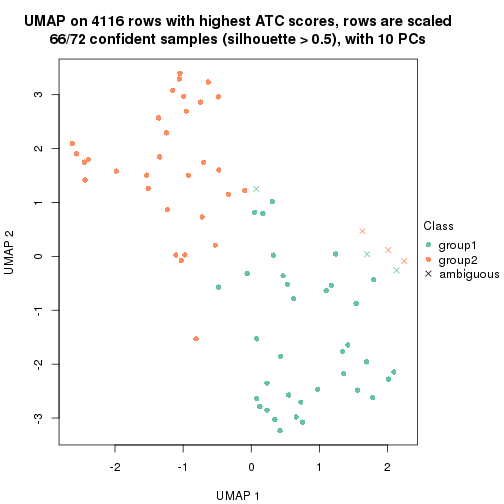
dimension_reduction(res, k = 3, method = "UMAP")
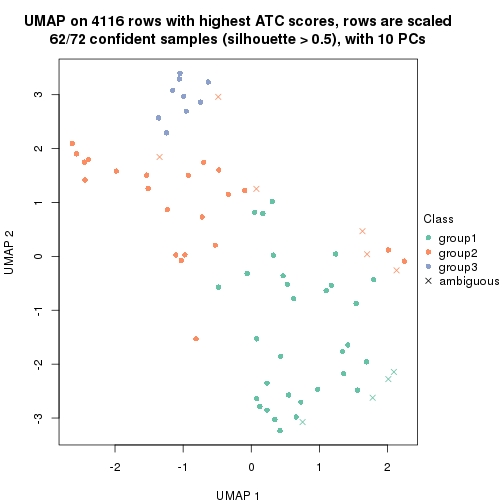
dimension_reduction(res, k = 4, method = "UMAP")
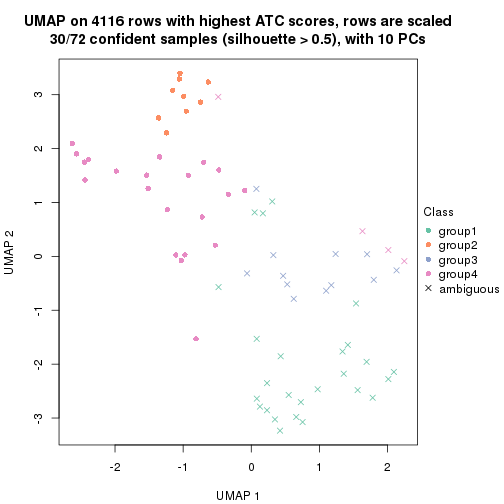
dimension_reduction(res, k = 5, method = "UMAP")
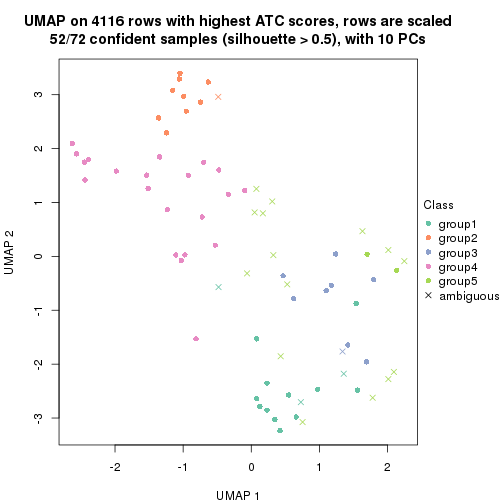
dimension_reduction(res, k = 6, method = "UMAP")
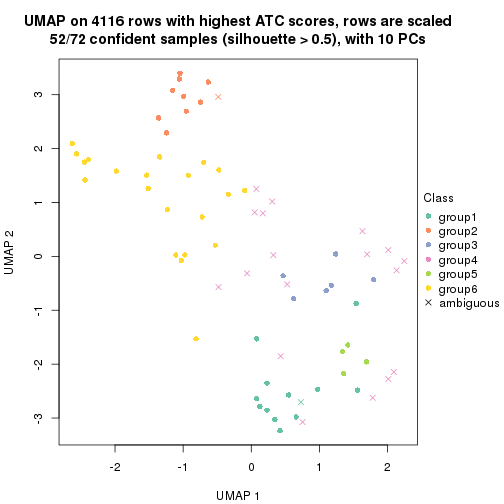
Following heatmap shows how subgroups are split when increasing k:
collect_classes(res)
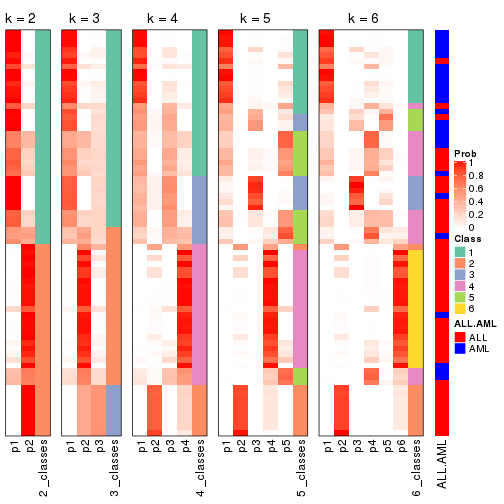
Test correlation between subgroups and known annotations. If the known annotation is numeric, one-way ANOVA test is applied, and if the known annotation is discrete, chi-squared contingency table test is applied.
test_to_known_factors(res)
#> n ALL.AML(p) k
#> ATC:hclust 66 4.16e-05 2
#> ATC:hclust 62 3.04e-03 3
#> ATC:hclust 30 8.73e-01 4
#> ATC:hclust 52 8.51e-06 5
#> ATC:hclust 52 1.57e-06 6
If matrix rows can be associated to genes, consider to use functional_enrichment(res,
...) to perform function enrichment for the signature genes. See this vignette for more detailed explanations.
The object with results only for a single top-value method and a single partition method can be extracted as:
res = res_list["ATC", "kmeans"]
# you can also extract it by
# res = res_list["ATC:kmeans"]
A summary of res and all the functions that can be applied to it:
res
#> A 'ConsensusPartition' object with k = 2, 3, 4, 5, 6.
#> On a matrix with 4116 rows and 72 columns.
#> Top rows (412, 824, 1235, 1646, 2058) are extracted by 'ATC' method.
#> Subgroups are detected by 'kmeans' method.
#> Performed in total 1250 partitions by row resampling.
#> Best k for subgroups seems to be 2.
#>
#> Following methods can be applied to this 'ConsensusPartition' object:
#> [1] "cola_report" "collect_classes" "collect_plots"
#> [4] "collect_stats" "colnames" "compare_signatures"
#> [7] "consensus_heatmap" "dimension_reduction" "functional_enrichment"
#> [10] "get_anno_col" "get_anno" "get_classes"
#> [13] "get_consensus" "get_matrix" "get_membership"
#> [16] "get_param" "get_signatures" "get_stats"
#> [19] "is_best_k" "is_stable_k" "membership_heatmap"
#> [22] "ncol" "nrow" "plot_ecdf"
#> [25] "rownames" "select_partition_number" "show"
#> [28] "suggest_best_k" "test_to_known_factors"
collect_plots() function collects all the plots made from res for all k (number of partitions)
into one single page to provide an easy and fast comparison between different k.
collect_plots(res)
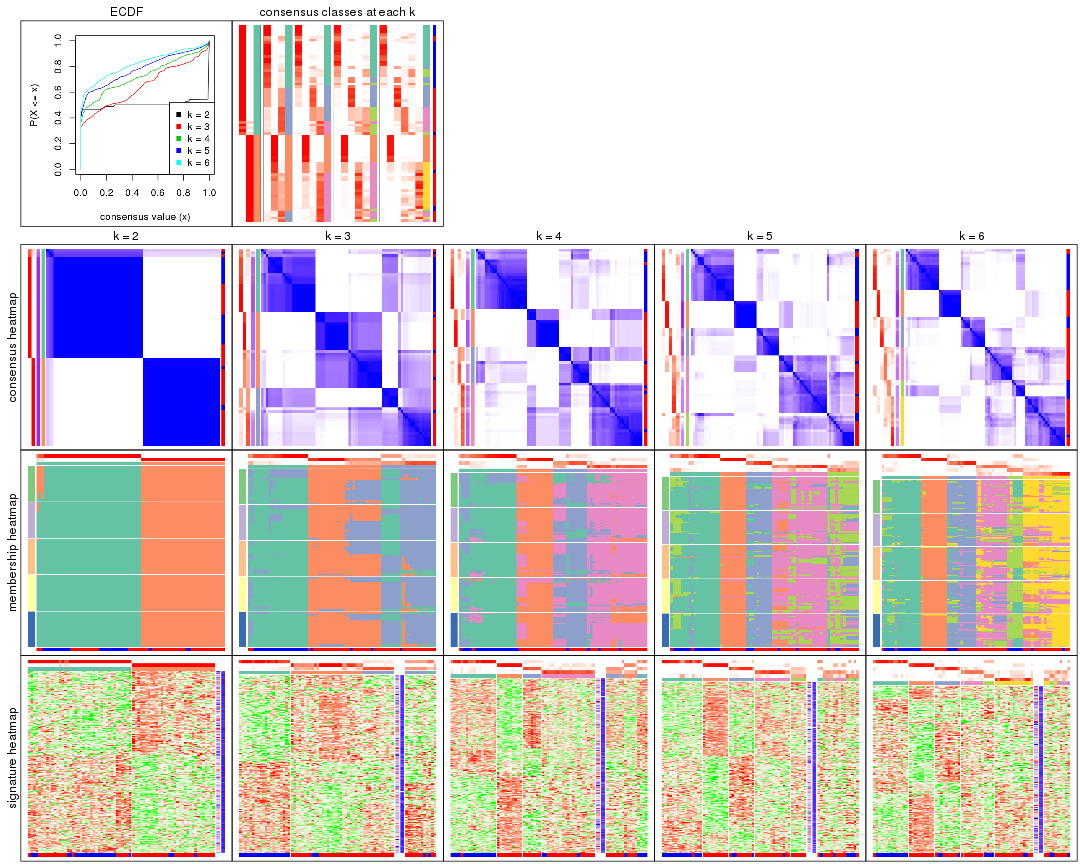
The plots are:
k and the heatmap of
predicted classes for each k.k.k.k.All the plots in panels can be made by individual functions and they are plotted later in this section.
select_partition_number() produces several plots showing different
statistics for choosing “optimized” k. There are following statistics:
k;k, the area increased is defined as \(A_k - A_{k-1}\).The detailed explanations of these statistics can be found in the cola vignette.
Generally speaking, lower PAC score, higher mean silhouette score or higher
concordance corresponds to better partition. Rand index and Jaccard index
measure how similar the current partition is compared to partition with k-1.
If they are too similar, we won't accept k is better than k-1.
select_partition_number(res)
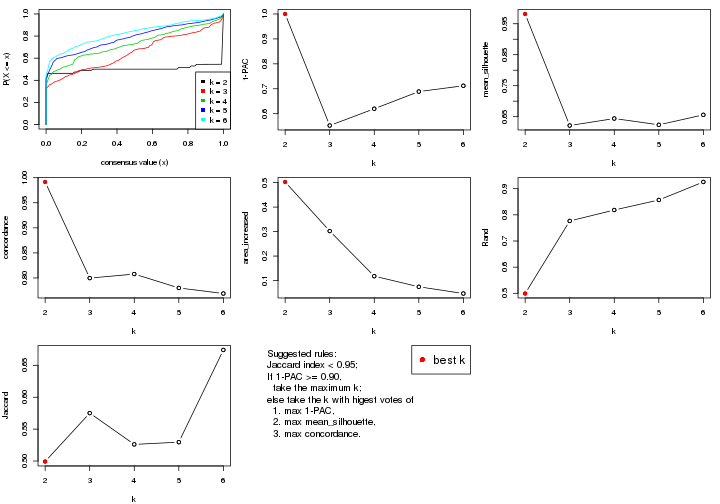
The numeric values for all these statistics can be obtained by get_stats().
get_stats(res)
#> k 1-PAC mean_silhouette concordance area_increased Rand Jaccard
#> 2 2 1.000 0.982 0.992 0.5025 0.499 0.499
#> 3 3 0.553 0.621 0.800 0.3021 0.777 0.575
#> 4 4 0.620 0.644 0.808 0.1179 0.818 0.526
#> 5 5 0.689 0.624 0.780 0.0746 0.857 0.530
#> 6 6 0.712 0.656 0.769 0.0471 0.926 0.674
suggest_best_k() suggests the best \(k\) based on these statistics. The rules are as follows:
suggest_best_k(res)
#> [1] 2
Following shows the table of the partitions (You need to click the show/hide
code output link to see it). The membership matrix (columns with name p*)
is inferred by
clue::cl_consensus()
function with the SE method. Basically the value in the membership matrix
represents the probability to belong to a certain group. The finall class
label for an item is determined with the group with highest probability it
belongs to.
In get_classes() function, the entropy is calculated from the membership
matrix and the silhouette score is calculated from the consensus matrix.
cbind(get_classes(res, k = 2), get_membership(res, k = 2))
#> class entropy silhouette p1 p2
#> sample_39 1 0.0000 0.985 1.000 0.000
#> sample_40 1 0.0000 0.985 1.000 0.000
#> sample_42 2 0.0000 1.000 0.000 1.000
#> sample_47 2 0.0000 1.000 0.000 1.000
#> sample_48 2 0.0000 1.000 0.000 1.000
#> sample_49 1 0.0000 0.985 1.000 0.000
#> sample_41 2 0.0000 1.000 0.000 1.000
#> sample_43 2 0.0000 1.000 0.000 1.000
#> sample_44 2 0.0000 1.000 0.000 1.000
#> sample_45 2 0.0000 1.000 0.000 1.000
#> sample_46 2 0.0000 1.000 0.000 1.000
#> sample_70 2 0.0000 1.000 0.000 1.000
#> sample_71 2 0.0376 0.996 0.004 0.996
#> sample_72 2 0.0000 1.000 0.000 1.000
#> sample_68 2 0.0000 1.000 0.000 1.000
#> sample_69 2 0.0000 1.000 0.000 1.000
#> sample_67 2 0.0000 1.000 0.000 1.000
#> sample_55 1 0.0000 0.985 1.000 0.000
#> sample_56 1 0.0000 0.985 1.000 0.000
#> sample_59 2 0.0376 0.996 0.004 0.996
#> sample_52 1 0.0000 0.985 1.000 0.000
#> sample_53 1 0.0000 0.985 1.000 0.000
#> sample_51 1 0.0000 0.985 1.000 0.000
#> sample_50 1 0.0000 0.985 1.000 0.000
#> sample_54 2 0.0000 1.000 0.000 1.000
#> sample_57 1 0.0000 0.985 1.000 0.000
#> sample_58 1 0.0000 0.985 1.000 0.000
#> sample_60 1 0.6887 0.783 0.816 0.184
#> sample_61 1 0.0000 0.985 1.000 0.000
#> sample_65 1 0.0000 0.985 1.000 0.000
#> sample_66 2 0.0000 1.000 0.000 1.000
#> sample_63 1 0.0000 0.985 1.000 0.000
#> sample_64 1 0.0000 0.985 1.000 0.000
#> sample_62 1 0.0000 0.985 1.000 0.000
#> sample_1 1 0.0000 0.985 1.000 0.000
#> sample_2 2 0.0000 1.000 0.000 1.000
#> sample_3 1 0.0000 0.985 1.000 0.000
#> sample_4 1 0.0000 0.985 1.000 0.000
#> sample_5 2 0.0000 1.000 0.000 1.000
#> sample_6 1 0.0000 0.985 1.000 0.000
#> sample_7 1 0.0000 0.985 1.000 0.000
#> sample_8 1 0.0000 0.985 1.000 0.000
#> sample_9 2 0.0000 1.000 0.000 1.000
#> sample_10 1 0.8267 0.664 0.740 0.260
#> sample_11 2 0.0000 1.000 0.000 1.000
#> sample_12 1 0.0000 0.985 1.000 0.000
#> sample_13 2 0.0000 1.000 0.000 1.000
#> sample_14 2 0.0000 1.000 0.000 1.000
#> sample_15 2 0.0000 1.000 0.000 1.000
#> sample_16 2 0.0000 1.000 0.000 1.000
#> sample_17 2 0.0000 1.000 0.000 1.000
#> sample_18 1 0.6247 0.820 0.844 0.156
#> sample_19 2 0.0000 1.000 0.000 1.000
#> sample_20 2 0.0000 1.000 0.000 1.000
#> sample_21 2 0.0000 1.000 0.000 1.000
#> sample_22 1 0.0000 0.985 1.000 0.000
#> sample_23 1 0.0000 0.985 1.000 0.000
#> sample_24 2 0.0000 1.000 0.000 1.000
#> sample_25 1 0.0000 0.985 1.000 0.000
#> sample_26 2 0.0376 0.996 0.004 0.996
#> sample_27 1 0.0000 0.985 1.000 0.000
#> sample_34 1 0.0000 0.985 1.000 0.000
#> sample_35 1 0.0000 0.985 1.000 0.000
#> sample_36 1 0.0000 0.985 1.000 0.000
#> sample_37 1 0.0000 0.985 1.000 0.000
#> sample_38 1 0.0000 0.985 1.000 0.000
#> sample_28 1 0.0000 0.985 1.000 0.000
#> sample_29 2 0.0000 1.000 0.000 1.000
#> sample_30 1 0.0000 0.985 1.000 0.000
#> sample_31 1 0.0000 0.985 1.000 0.000
#> sample_32 1 0.0000 0.985 1.000 0.000
#> sample_33 1 0.0000 0.985 1.000 0.000
cbind(get_classes(res, k = 3), get_membership(res, k = 3))
#> class entropy silhouette p1 p2 p3
#> sample_39 3 0.6307 -0.0172 0.488 0.000 0.512
#> sample_40 3 0.6291 0.0191 0.468 0.000 0.532
#> sample_42 2 0.6180 0.6793 0.000 0.584 0.416
#> sample_47 2 0.2165 0.7677 0.000 0.936 0.064
#> sample_48 2 0.0000 0.7584 0.000 1.000 0.000
#> sample_49 3 0.6307 -0.0172 0.488 0.000 0.512
#> sample_41 2 0.0000 0.7584 0.000 1.000 0.000
#> sample_43 2 0.5591 0.7304 0.000 0.696 0.304
#> sample_44 2 0.2356 0.7677 0.000 0.928 0.072
#> sample_45 2 0.2356 0.7677 0.000 0.928 0.072
#> sample_46 2 0.4887 0.7478 0.000 0.772 0.228
#> sample_70 3 0.5650 0.5032 0.084 0.108 0.808
#> sample_71 3 0.8627 -0.3232 0.104 0.392 0.504
#> sample_72 2 0.6180 0.6781 0.000 0.584 0.416
#> sample_68 2 0.0000 0.7584 0.000 1.000 0.000
#> sample_69 2 0.0000 0.7584 0.000 1.000 0.000
#> sample_67 2 0.6126 0.6936 0.000 0.600 0.400
#> sample_55 3 0.4121 0.6488 0.168 0.000 0.832
#> sample_56 3 0.6295 0.0185 0.472 0.000 0.528
#> sample_59 3 0.5889 0.5233 0.108 0.096 0.796
#> sample_52 1 0.5178 0.4491 0.744 0.000 0.256
#> sample_53 1 0.0000 0.8560 1.000 0.000 0.000
#> sample_51 1 0.0000 0.8560 1.000 0.000 0.000
#> sample_50 1 0.0000 0.8560 1.000 0.000 0.000
#> sample_54 2 0.7396 0.5178 0.032 0.488 0.480
#> sample_57 1 0.2356 0.8075 0.928 0.000 0.072
#> sample_58 1 0.3482 0.7853 0.872 0.000 0.128
#> sample_60 3 0.6713 0.3145 0.416 0.012 0.572
#> sample_61 1 0.3412 0.7874 0.876 0.000 0.124
#> sample_65 1 0.0237 0.8544 0.996 0.000 0.004
#> sample_66 2 0.2165 0.7677 0.000 0.936 0.064
#> sample_63 1 0.2066 0.8144 0.940 0.000 0.060
#> sample_64 1 0.3482 0.7853 0.872 0.000 0.128
#> sample_62 1 0.2537 0.7931 0.920 0.000 0.080
#> sample_1 3 0.3879 0.6530 0.152 0.000 0.848
#> sample_2 2 0.6126 0.6936 0.000 0.600 0.400
#> sample_3 3 0.4121 0.6499 0.168 0.000 0.832
#> sample_4 3 0.3752 0.6507 0.144 0.000 0.856
#> sample_5 2 0.0000 0.7584 0.000 1.000 0.000
#> sample_6 3 0.4235 0.6459 0.176 0.000 0.824
#> sample_7 3 0.6280 0.0365 0.460 0.000 0.540
#> sample_8 3 0.6307 -0.0172 0.488 0.000 0.512
#> sample_9 2 0.6140 0.6909 0.000 0.596 0.404
#> sample_10 3 0.3989 0.6275 0.124 0.012 0.864
#> sample_11 2 0.6126 0.6936 0.000 0.600 0.400
#> sample_12 1 0.6235 -0.0104 0.564 0.000 0.436
#> sample_13 2 0.0000 0.7584 0.000 1.000 0.000
#> sample_14 2 0.5859 0.7177 0.000 0.656 0.344
#> sample_15 2 0.0000 0.7584 0.000 1.000 0.000
#> sample_16 2 0.6180 0.6793 0.000 0.584 0.416
#> sample_17 2 0.6180 0.6793 0.000 0.584 0.416
#> sample_18 3 0.3989 0.6275 0.124 0.012 0.864
#> sample_19 2 0.6140 0.6909 0.000 0.596 0.404
#> sample_20 2 0.0000 0.7584 0.000 1.000 0.000
#> sample_21 2 0.0424 0.7536 0.000 0.992 0.008
#> sample_22 1 0.5905 0.2518 0.648 0.000 0.352
#> sample_23 3 0.4452 0.6342 0.192 0.000 0.808
#> sample_24 2 0.0000 0.7584 0.000 1.000 0.000
#> sample_25 3 0.4178 0.6497 0.172 0.000 0.828
#> sample_26 3 0.4558 0.5926 0.100 0.044 0.856
#> sample_27 3 0.6307 -0.0172 0.488 0.000 0.512
#> sample_34 1 0.3192 0.7939 0.888 0.000 0.112
#> sample_35 1 0.3752 0.7749 0.856 0.000 0.144
#> sample_36 1 0.0237 0.8544 0.996 0.000 0.004
#> sample_37 1 0.0000 0.8560 1.000 0.000 0.000
#> sample_38 1 0.0000 0.8560 1.000 0.000 0.000
#> sample_28 1 0.0000 0.8560 1.000 0.000 0.000
#> sample_29 2 0.6126 0.6936 0.000 0.600 0.400
#> sample_30 1 0.3412 0.7238 0.876 0.000 0.124
#> sample_31 1 0.0000 0.8560 1.000 0.000 0.000
#> sample_32 1 0.0000 0.8560 1.000 0.000 0.000
#> sample_33 1 0.3192 0.7939 0.888 0.000 0.112
cbind(get_classes(res, k = 4), get_membership(res, k = 4))
#> class entropy silhouette p1 p2 p3 p4
#> sample_39 3 0.3400 0.6000 0.180 0.000 0.820 0.000
#> sample_40 3 0.2976 0.6128 0.120 0.000 0.872 0.008
#> sample_42 4 0.4452 0.7741 0.000 0.156 0.048 0.796
#> sample_47 2 0.4790 0.4191 0.000 0.620 0.000 0.380
#> sample_48 2 0.0188 0.8498 0.000 0.996 0.000 0.004
#> sample_49 3 0.3400 0.6000 0.180 0.000 0.820 0.000
#> sample_41 2 0.0188 0.8498 0.000 0.996 0.000 0.004
#> sample_43 4 0.4891 0.5724 0.000 0.308 0.012 0.680
#> sample_44 2 0.4964 0.4142 0.000 0.616 0.004 0.380
#> sample_45 2 0.4964 0.4142 0.000 0.616 0.004 0.380
#> sample_46 4 0.5217 0.3861 0.000 0.380 0.012 0.608
#> sample_70 4 0.2342 0.7294 0.008 0.000 0.080 0.912
#> sample_71 4 0.3994 0.7845 0.008 0.088 0.056 0.848
#> sample_72 4 0.4532 0.7754 0.000 0.156 0.052 0.792
#> sample_68 2 0.0188 0.8498 0.000 0.996 0.000 0.004
#> sample_69 2 0.0188 0.8498 0.000 0.996 0.000 0.004
#> sample_67 4 0.4452 0.7741 0.000 0.156 0.048 0.796
#> sample_55 4 0.5407 -0.2407 0.012 0.000 0.484 0.504
#> sample_56 3 0.3306 0.6106 0.156 0.000 0.840 0.004
#> sample_59 4 0.2799 0.7017 0.008 0.000 0.108 0.884
#> sample_52 1 0.5763 0.6578 0.712 0.000 0.132 0.156
#> sample_53 1 0.0000 0.8237 1.000 0.000 0.000 0.000
#> sample_51 1 0.0000 0.8237 1.000 0.000 0.000 0.000
#> sample_50 1 0.0188 0.8240 0.996 0.000 0.000 0.004
#> sample_54 4 0.1639 0.7408 0.004 0.008 0.036 0.952
#> sample_57 1 0.5266 0.7012 0.752 0.000 0.108 0.140
#> sample_58 1 0.5387 0.3476 0.584 0.000 0.400 0.016
#> sample_60 4 0.4359 0.6183 0.084 0.000 0.100 0.816
#> sample_61 1 0.4814 0.4982 0.676 0.000 0.316 0.008
#> sample_65 1 0.0657 0.8227 0.984 0.000 0.004 0.012
#> sample_66 2 0.5298 0.4095 0.000 0.612 0.016 0.372
#> sample_63 1 0.4646 0.7353 0.796 0.000 0.084 0.120
#> sample_64 1 0.5586 0.2198 0.528 0.000 0.452 0.020
#> sample_62 1 0.4888 0.7240 0.780 0.000 0.096 0.124
#> sample_1 3 0.5378 0.2594 0.012 0.000 0.540 0.448
#> sample_2 4 0.4452 0.7741 0.000 0.156 0.048 0.796
#> sample_3 3 0.5378 0.2592 0.012 0.000 0.540 0.448
#> sample_4 3 0.5383 0.2491 0.012 0.000 0.536 0.452
#> sample_5 2 0.0188 0.8498 0.000 0.996 0.000 0.004
#> sample_6 3 0.5478 0.2653 0.016 0.000 0.540 0.444
#> sample_7 3 0.2831 0.6131 0.120 0.000 0.876 0.004
#> sample_8 3 0.3444 0.5960 0.184 0.000 0.816 0.000
#> sample_9 4 0.3479 0.7858 0.000 0.148 0.012 0.840
#> sample_10 4 0.3196 0.6874 0.008 0.000 0.136 0.856
#> sample_11 4 0.4197 0.7764 0.000 0.156 0.036 0.808
#> sample_12 1 0.5902 0.6307 0.700 0.000 0.160 0.140
#> sample_13 2 0.0188 0.8498 0.000 0.996 0.000 0.004
#> sample_14 4 0.3831 0.7506 0.000 0.204 0.004 0.792
#> sample_15 2 0.0188 0.8498 0.000 0.996 0.000 0.004
#> sample_16 4 0.3529 0.7845 0.000 0.152 0.012 0.836
#> sample_17 4 0.3695 0.7841 0.000 0.156 0.016 0.828
#> sample_18 4 0.3529 0.6634 0.012 0.000 0.152 0.836
#> sample_19 4 0.3591 0.7781 0.000 0.168 0.008 0.824
#> sample_20 2 0.0188 0.8498 0.000 0.996 0.000 0.004
#> sample_21 2 0.0707 0.8352 0.000 0.980 0.020 0.000
#> sample_22 1 0.4992 0.0174 0.524 0.000 0.476 0.000
#> sample_23 3 0.5478 0.2653 0.016 0.000 0.540 0.444
#> sample_24 2 0.0336 0.8480 0.000 0.992 0.000 0.008
#> sample_25 4 0.4253 0.6135 0.016 0.000 0.208 0.776
#> sample_26 4 0.2773 0.7074 0.004 0.000 0.116 0.880
#> sample_27 3 0.3400 0.6000 0.180 0.000 0.820 0.000
#> sample_34 1 0.1388 0.8110 0.960 0.000 0.028 0.012
#> sample_35 3 0.5310 0.0810 0.412 0.000 0.576 0.012
#> sample_36 1 0.0188 0.8240 0.996 0.000 0.000 0.004
#> sample_37 1 0.0188 0.8240 0.996 0.000 0.000 0.004
#> sample_38 1 0.0000 0.8237 1.000 0.000 0.000 0.000
#> sample_28 1 0.0592 0.8214 0.984 0.000 0.016 0.000
#> sample_29 4 0.5596 0.7486 0.040 0.156 0.048 0.756
#> sample_30 1 0.3099 0.7698 0.876 0.000 0.104 0.020
#> sample_31 1 0.1677 0.8126 0.948 0.000 0.040 0.012
#> sample_32 1 0.0000 0.8237 1.000 0.000 0.000 0.000
#> sample_33 1 0.0707 0.8148 0.980 0.000 0.020 0.000
cbind(get_classes(res, k = 5), get_membership(res, k = 5))
#> class entropy silhouette p1 p2 p3 p4 p5
#> sample_39 3 0.1430 0.8525 0.052 0.000 0.944 0.000 0.004
#> sample_40 3 0.2054 0.8166 0.028 0.000 0.920 0.000 0.052
#> sample_42 4 0.1612 0.6418 0.000 0.024 0.016 0.948 0.012
#> sample_47 4 0.6470 0.3917 0.000 0.388 0.016 0.476 0.120
#> sample_48 2 0.0162 0.9941 0.000 0.996 0.000 0.004 0.000
#> sample_49 3 0.1270 0.8526 0.052 0.000 0.948 0.000 0.000
#> sample_41 2 0.0162 0.9941 0.000 0.996 0.000 0.004 0.000
#> sample_43 4 0.5979 0.5582 0.000 0.212 0.020 0.636 0.132
#> sample_44 4 0.6639 0.3825 0.000 0.380 0.020 0.468 0.132
#> sample_45 4 0.6639 0.3825 0.000 0.380 0.020 0.468 0.132
#> sample_46 4 0.6155 0.5441 0.000 0.240 0.020 0.608 0.132
#> sample_70 4 0.4714 0.3411 0.000 0.000 0.032 0.644 0.324
#> sample_71 4 0.1756 0.6169 0.000 0.008 0.016 0.940 0.036
#> sample_72 4 0.2082 0.6286 0.000 0.024 0.016 0.928 0.032
#> sample_68 2 0.0162 0.9941 0.000 0.996 0.000 0.004 0.000
#> sample_69 2 0.0162 0.9941 0.000 0.996 0.000 0.004 0.000
#> sample_67 4 0.1386 0.6412 0.000 0.032 0.016 0.952 0.000
#> sample_55 5 0.5775 0.5623 0.008 0.000 0.188 0.160 0.644
#> sample_56 3 0.1408 0.8480 0.044 0.000 0.948 0.000 0.008
#> sample_59 5 0.4696 0.1690 0.000 0.004 0.012 0.400 0.584
#> sample_52 1 0.4557 0.4715 0.516 0.000 0.000 0.008 0.476
#> sample_53 1 0.0324 0.8148 0.992 0.000 0.004 0.000 0.004
#> sample_51 1 0.0324 0.8148 0.992 0.000 0.004 0.000 0.004
#> sample_50 1 0.0771 0.8181 0.976 0.000 0.004 0.000 0.020
#> sample_54 5 0.4621 -0.0712 0.000 0.004 0.008 0.412 0.576
#> sample_57 5 0.4304 -0.4898 0.484 0.000 0.000 0.000 0.516
#> sample_58 3 0.5304 0.5689 0.292 0.000 0.628 0.000 0.080
#> sample_60 5 0.3527 0.3490 0.016 0.000 0.000 0.192 0.792
#> sample_61 1 0.5431 -0.0631 0.516 0.000 0.424 0.000 0.060
#> sample_65 1 0.2127 0.8029 0.892 0.000 0.000 0.000 0.108
#> sample_66 4 0.6010 0.4263 0.000 0.360 0.016 0.544 0.080
#> sample_63 1 0.4268 0.5348 0.556 0.000 0.000 0.000 0.444
#> sample_64 3 0.5167 0.6538 0.248 0.000 0.664 0.000 0.088
#> sample_62 1 0.4434 0.5080 0.536 0.000 0.000 0.004 0.460
#> sample_1 5 0.6882 0.5995 0.008 0.000 0.304 0.248 0.440
#> sample_2 4 0.1547 0.6404 0.000 0.032 0.016 0.948 0.004
#> sample_3 5 0.6887 0.5995 0.008 0.000 0.300 0.252 0.440
#> sample_4 5 0.6873 0.6012 0.008 0.000 0.300 0.248 0.444
#> sample_5 2 0.0162 0.9941 0.000 0.996 0.000 0.004 0.000
#> sample_6 5 0.6957 0.6016 0.012 0.000 0.296 0.248 0.444
#> sample_7 3 0.3257 0.7409 0.024 0.000 0.852 0.012 0.112
#> sample_8 3 0.1845 0.8504 0.056 0.000 0.928 0.000 0.016
#> sample_9 4 0.3124 0.5932 0.000 0.016 0.004 0.844 0.136
#> sample_10 4 0.4390 -0.1941 0.000 0.000 0.004 0.568 0.428
#> sample_11 4 0.1891 0.6355 0.000 0.032 0.016 0.936 0.016
#> sample_12 1 0.4858 0.5774 0.656 0.000 0.012 0.024 0.308
#> sample_13 2 0.0162 0.9941 0.000 0.996 0.000 0.004 0.000
#> sample_14 4 0.3570 0.6327 0.000 0.048 0.008 0.836 0.108
#> sample_15 2 0.0162 0.9941 0.000 0.996 0.000 0.004 0.000
#> sample_16 4 0.4148 0.5297 0.000 0.028 0.004 0.752 0.216
#> sample_17 4 0.3988 0.5504 0.000 0.036 0.000 0.768 0.196
#> sample_18 5 0.4787 0.3255 0.000 0.000 0.020 0.432 0.548
#> sample_19 4 0.3602 0.6174 0.000 0.036 0.004 0.820 0.140
#> sample_20 2 0.0162 0.9941 0.000 0.996 0.000 0.004 0.000
#> sample_21 2 0.1364 0.9559 0.000 0.952 0.012 0.000 0.036
#> sample_22 1 0.4716 0.3623 0.656 0.000 0.308 0.000 0.036
#> sample_23 5 0.6967 0.6003 0.012 0.000 0.300 0.248 0.440
#> sample_24 2 0.0404 0.9869 0.000 0.988 0.000 0.012 0.000
#> sample_25 5 0.5920 0.3576 0.020 0.000 0.056 0.448 0.476
#> sample_26 4 0.4557 -0.0341 0.000 0.000 0.012 0.584 0.404
#> sample_27 3 0.1270 0.8526 0.052 0.000 0.948 0.000 0.000
#> sample_34 1 0.1914 0.7951 0.924 0.000 0.016 0.000 0.060
#> sample_35 3 0.4558 0.7213 0.216 0.000 0.724 0.000 0.060
#> sample_36 1 0.0703 0.8180 0.976 0.000 0.000 0.000 0.024
#> sample_37 1 0.0771 0.8181 0.976 0.000 0.004 0.000 0.020
#> sample_38 1 0.0324 0.8148 0.992 0.000 0.004 0.000 0.004
#> sample_28 1 0.0794 0.8173 0.972 0.000 0.000 0.000 0.028
#> sample_29 4 0.3531 0.6190 0.020 0.040 0.016 0.864 0.060
#> sample_30 1 0.2536 0.7834 0.868 0.000 0.000 0.004 0.128
#> sample_31 1 0.2020 0.8052 0.900 0.000 0.000 0.000 0.100
#> sample_32 1 0.0162 0.8157 0.996 0.000 0.004 0.000 0.000
#> sample_33 1 0.1403 0.7952 0.952 0.000 0.024 0.000 0.024
cbind(get_classes(res, k = 6), get_membership(res, k = 6))
#> class entropy silhouette p1 p2 p3 p4 p5 p6
#> sample_39 3 0.0951 0.8075 0.020 0.000 0.968 0.008 0.004 0.000
#> sample_40 3 0.2483 0.7717 0.004 0.004 0.892 0.056 0.044 0.000
#> sample_42 6 0.0405 0.6454 0.000 0.000 0.000 0.008 0.004 0.988
#> sample_47 6 0.7289 0.5309 0.000 0.204 0.000 0.148 0.224 0.424
#> sample_48 2 0.0508 0.9852 0.000 0.984 0.000 0.000 0.004 0.012
#> sample_49 3 0.0547 0.8086 0.020 0.000 0.980 0.000 0.000 0.000
#> sample_41 2 0.0363 0.9857 0.000 0.988 0.000 0.000 0.000 0.012
#> sample_43 6 0.6679 0.5712 0.000 0.096 0.000 0.160 0.228 0.516
#> sample_44 6 0.7261 0.5306 0.000 0.184 0.000 0.156 0.228 0.432
#> sample_45 6 0.7261 0.5306 0.000 0.184 0.000 0.156 0.228 0.432
#> sample_46 6 0.6885 0.5621 0.000 0.120 0.000 0.160 0.228 0.492
#> sample_70 4 0.6107 -0.2853 0.000 0.000 0.004 0.384 0.228 0.384
#> sample_71 6 0.1760 0.6215 0.000 0.000 0.004 0.048 0.020 0.928
#> sample_72 6 0.1760 0.6236 0.000 0.000 0.004 0.048 0.020 0.928
#> sample_68 2 0.0363 0.9857 0.000 0.988 0.000 0.000 0.000 0.012
#> sample_69 2 0.0363 0.9857 0.000 0.988 0.000 0.000 0.000 0.012
#> sample_67 6 0.0767 0.6425 0.000 0.000 0.004 0.008 0.012 0.976
#> sample_55 4 0.4813 0.5918 0.000 0.000 0.116 0.708 0.156 0.020
#> sample_56 3 0.0603 0.8067 0.016 0.000 0.980 0.004 0.000 0.000
#> sample_59 4 0.5814 0.2250 0.000 0.000 0.004 0.516 0.280 0.200
#> sample_52 5 0.5094 0.6007 0.348 0.000 0.004 0.080 0.568 0.000
#> sample_53 1 0.0820 0.8328 0.972 0.000 0.000 0.016 0.012 0.000
#> sample_51 1 0.0146 0.8385 0.996 0.000 0.000 0.000 0.004 0.000
#> sample_50 1 0.0260 0.8381 0.992 0.000 0.000 0.000 0.008 0.000
#> sample_54 5 0.5148 0.0303 0.000 0.000 0.000 0.196 0.624 0.180
#> sample_57 5 0.5214 0.6127 0.308 0.000 0.004 0.104 0.584 0.000
#> sample_58 3 0.5239 0.6830 0.120 0.004 0.700 0.052 0.124 0.000
#> sample_60 5 0.4609 0.1675 0.008 0.000 0.000 0.344 0.612 0.036
#> sample_61 3 0.6542 0.3037 0.344 0.004 0.468 0.060 0.124 0.000
#> sample_65 1 0.3650 0.6409 0.756 0.000 0.004 0.024 0.216 0.000
#> sample_66 6 0.6010 0.5974 0.000 0.144 0.000 0.072 0.176 0.608
#> sample_63 5 0.4945 0.6018 0.344 0.000 0.004 0.068 0.584 0.000
#> sample_64 3 0.5653 0.6893 0.108 0.008 0.664 0.060 0.160 0.000
#> sample_62 5 0.4945 0.6018 0.344 0.000 0.004 0.068 0.584 0.000
#> sample_1 4 0.4447 0.6920 0.000 0.000 0.224 0.704 0.008 0.064
#> sample_2 6 0.0458 0.6420 0.000 0.000 0.000 0.016 0.000 0.984
#> sample_3 4 0.4500 0.6896 0.000 0.000 0.224 0.700 0.008 0.068
#> sample_4 4 0.4447 0.6920 0.000 0.000 0.224 0.704 0.008 0.064
#> sample_5 2 0.0363 0.9857 0.000 0.988 0.000 0.000 0.000 0.012
#> sample_6 4 0.4629 0.6854 0.000 0.000 0.224 0.696 0.016 0.064
#> sample_7 3 0.3705 0.5600 0.004 0.000 0.748 0.224 0.024 0.000
#> sample_8 3 0.1536 0.8031 0.020 0.000 0.944 0.012 0.024 0.000
#> sample_9 6 0.4939 0.4574 0.000 0.000 0.000 0.292 0.096 0.612
#> sample_10 4 0.3855 0.5672 0.000 0.000 0.000 0.704 0.024 0.272
#> sample_11 6 0.1625 0.6172 0.000 0.000 0.000 0.060 0.012 0.928
#> sample_12 1 0.5916 0.0832 0.524 0.000 0.012 0.312 0.148 0.004
#> sample_13 2 0.0508 0.9852 0.000 0.984 0.000 0.000 0.004 0.012
#> sample_14 6 0.5075 0.5894 0.000 0.016 0.000 0.180 0.132 0.672
#> sample_15 2 0.0363 0.9857 0.000 0.988 0.000 0.000 0.000 0.012
#> sample_16 6 0.5863 0.2759 0.000 0.008 0.000 0.384 0.152 0.456
#> sample_17 6 0.5024 0.3583 0.000 0.000 0.000 0.340 0.088 0.572
#> sample_18 4 0.4297 0.6328 0.000 0.000 0.016 0.756 0.096 0.132
#> sample_19 6 0.5384 0.5636 0.000 0.008 0.000 0.200 0.176 0.616
#> sample_20 2 0.0508 0.9852 0.000 0.984 0.000 0.000 0.004 0.012
#> sample_21 2 0.2534 0.9198 0.000 0.896 0.012 0.032 0.052 0.008
#> sample_22 1 0.4540 0.5856 0.732 0.000 0.168 0.076 0.024 0.000
#> sample_23 4 0.4629 0.6854 0.000 0.000 0.224 0.696 0.016 0.064
#> sample_24 2 0.1511 0.9557 0.000 0.940 0.000 0.004 0.044 0.012
#> sample_25 4 0.4851 0.6377 0.012 0.000 0.036 0.728 0.060 0.164
#> sample_26 4 0.5125 0.3779 0.000 0.000 0.004 0.612 0.108 0.276
#> sample_27 3 0.0547 0.8086 0.020 0.000 0.980 0.000 0.000 0.000
#> sample_34 1 0.4325 0.6718 0.768 0.008 0.024 0.060 0.140 0.000
#> sample_35 3 0.5471 0.7078 0.100 0.008 0.684 0.060 0.148 0.000
#> sample_36 1 0.0363 0.8374 0.988 0.000 0.000 0.000 0.012 0.000
#> sample_37 1 0.0260 0.8381 0.992 0.000 0.000 0.000 0.008 0.000
#> sample_38 1 0.0820 0.8328 0.972 0.000 0.000 0.016 0.012 0.000
#> sample_28 1 0.0717 0.8391 0.976 0.000 0.000 0.008 0.016 0.000
#> sample_29 6 0.0622 0.6457 0.000 0.000 0.000 0.008 0.012 0.980
#> sample_30 1 0.2636 0.7331 0.860 0.000 0.004 0.016 0.120 0.000
#> sample_31 1 0.3329 0.6856 0.792 0.000 0.004 0.020 0.184 0.000
#> sample_32 1 0.0520 0.8389 0.984 0.000 0.000 0.008 0.008 0.000
#> sample_33 1 0.1700 0.8112 0.936 0.000 0.012 0.024 0.028 0.000
Heatmaps for the consensus matrix. It visualizes the probability of two samples to be in a same group.
consensus_heatmap(res, k = 2)
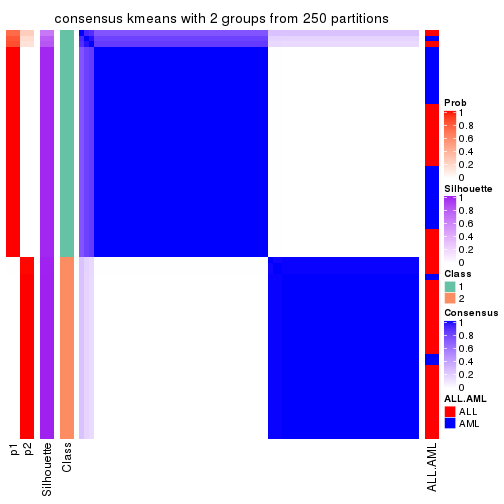
consensus_heatmap(res, k = 3)
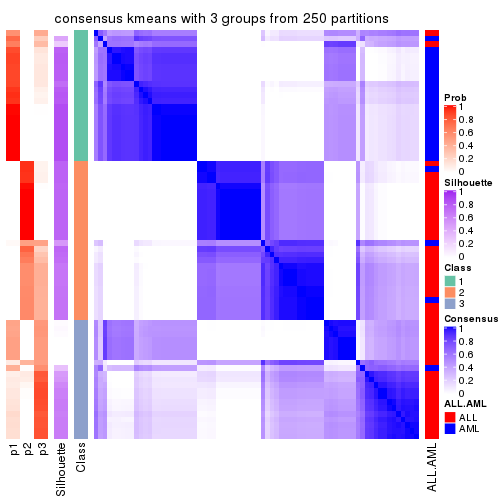
consensus_heatmap(res, k = 4)
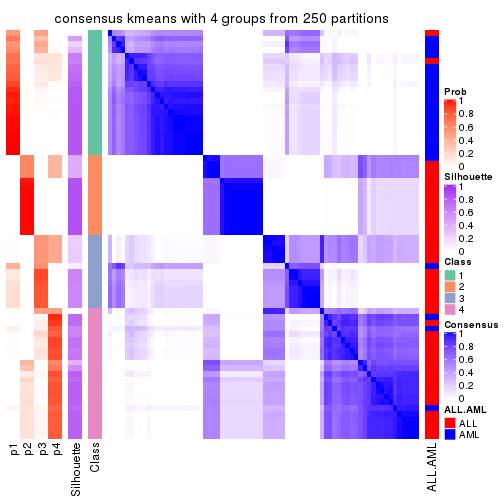
consensus_heatmap(res, k = 5)
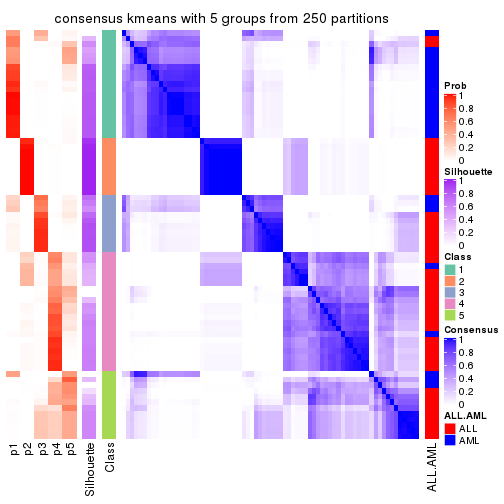
consensus_heatmap(res, k = 6)
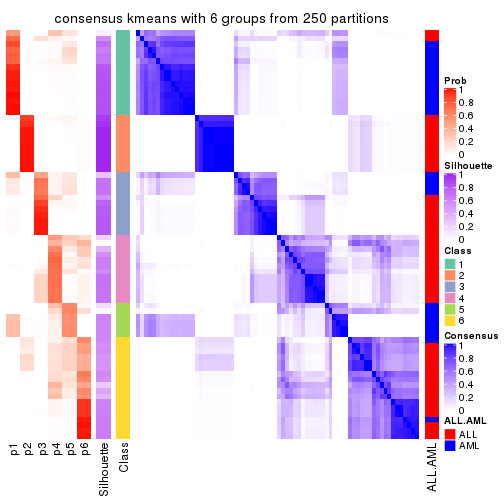
Heatmaps for the membership of samples in all partitions to see how consistent they are:
membership_heatmap(res, k = 2)
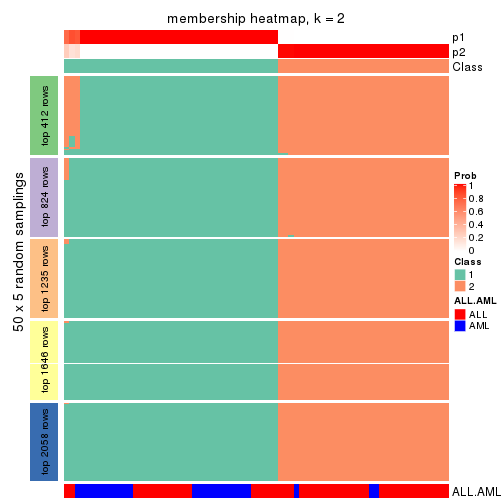
membership_heatmap(res, k = 3)
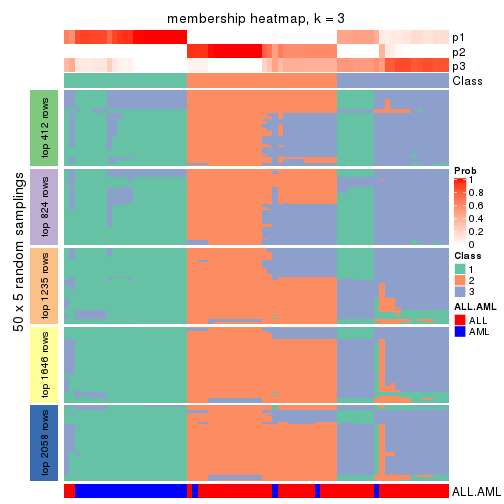
membership_heatmap(res, k = 4)
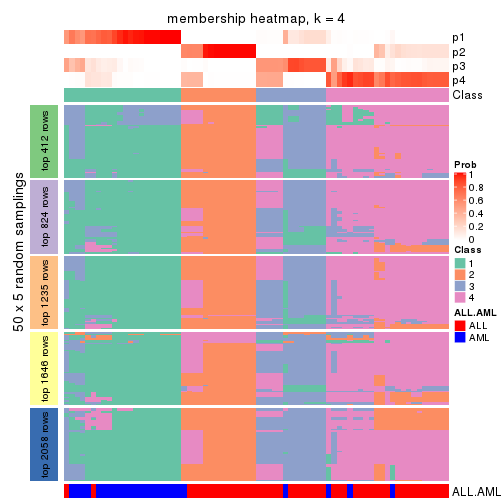
membership_heatmap(res, k = 5)
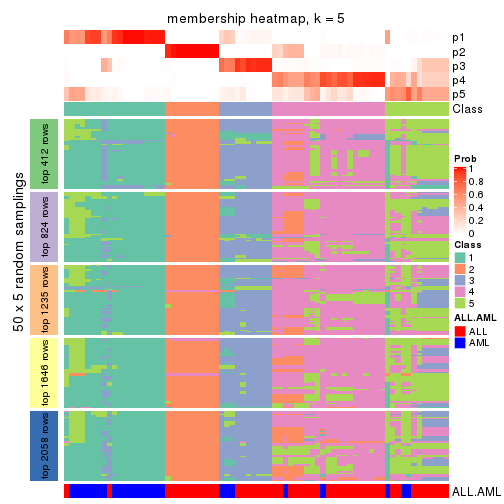
membership_heatmap(res, k = 6)
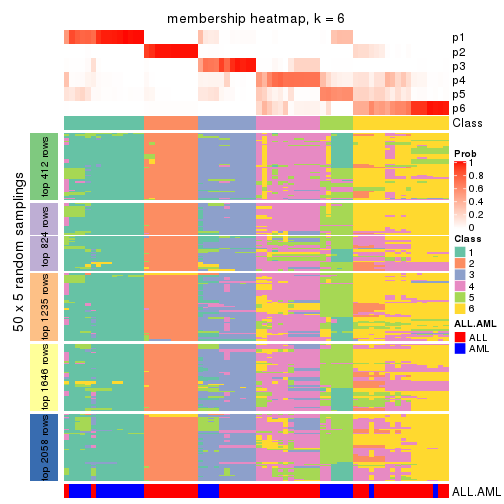
As soon as we have had the classes for columns, we can look for signatures which are significantly different between classes which can be candidate marks for certain classes. Following are the heatmaps for signatures.
Signature heatmaps where rows are scaled:
get_signatures(res, k = 2)
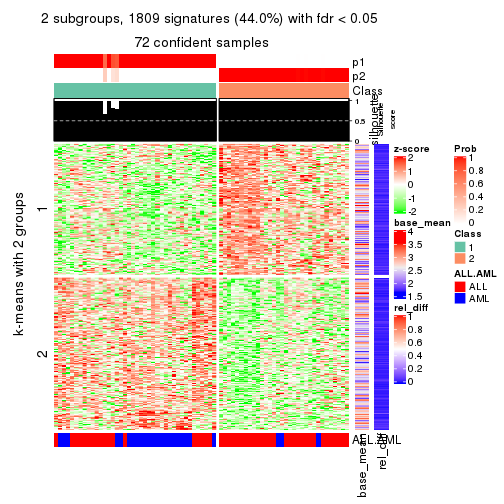
get_signatures(res, k = 3)
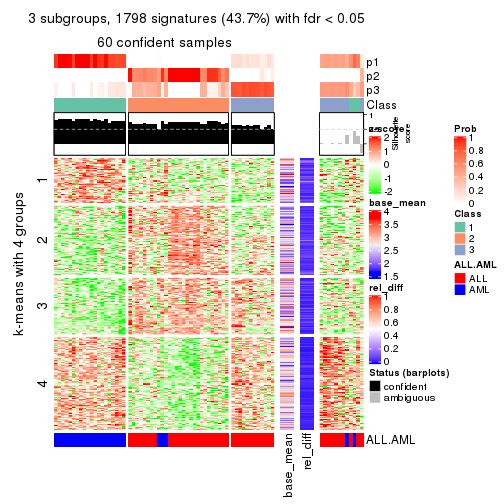
get_signatures(res, k = 4)
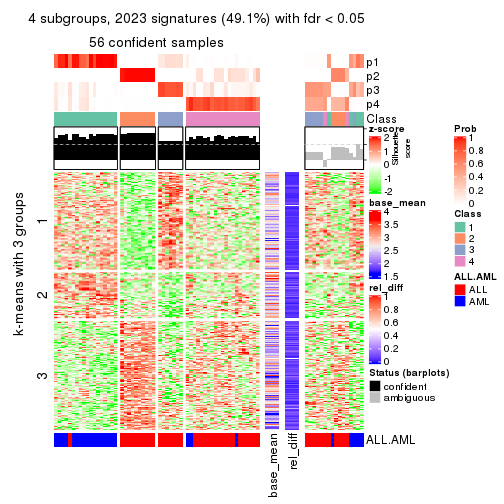
get_signatures(res, k = 5)
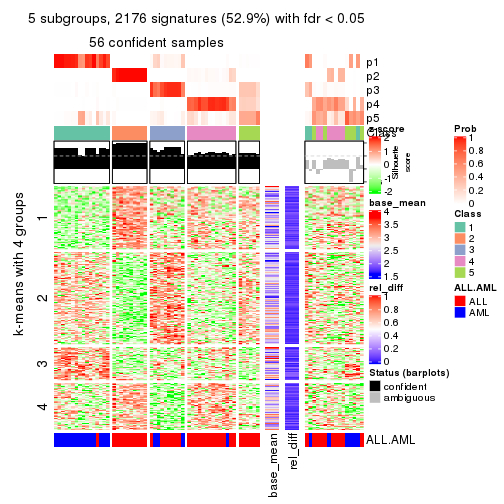
get_signatures(res, k = 6)
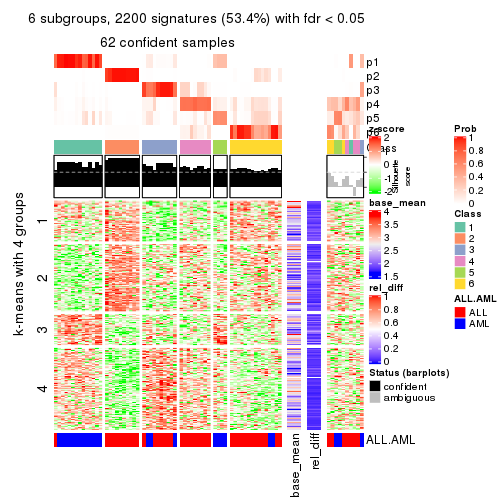
Signature heatmaps where rows are not scaled:
get_signatures(res, k = 2, scale_rows = FALSE)
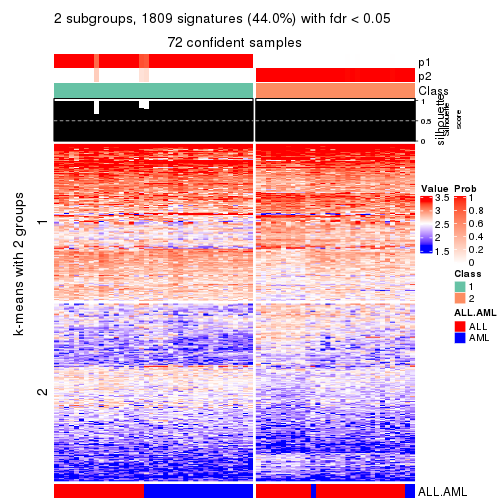
get_signatures(res, k = 3, scale_rows = FALSE)
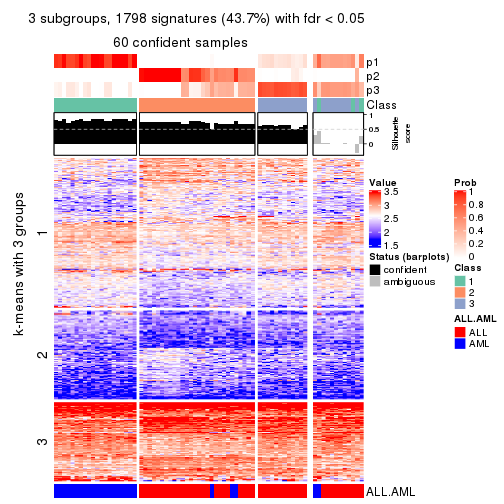
get_signatures(res, k = 4, scale_rows = FALSE)
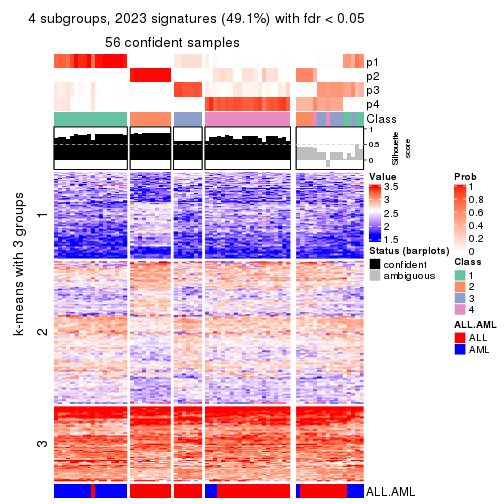
get_signatures(res, k = 5, scale_rows = FALSE)
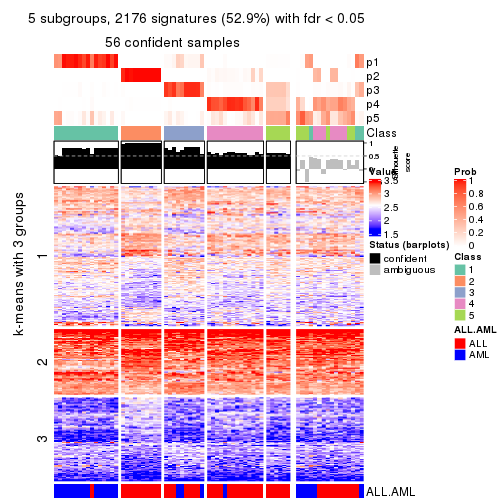
get_signatures(res, k = 6, scale_rows = FALSE)
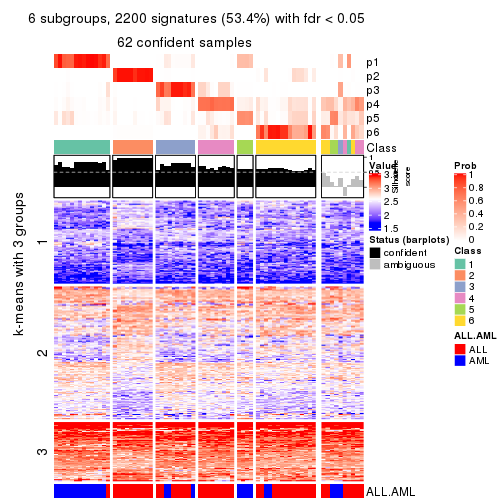
Compare the overlap of signatures from different k:
compare_signatures(res)
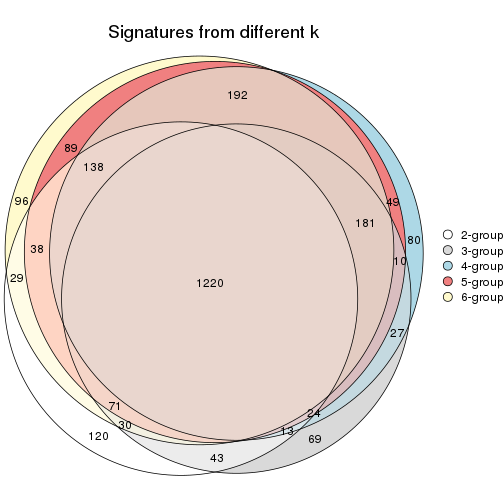
get_signature() returns a data frame invisibly. TO get the list of signatures, the function
call should be assigned to a variable explicitly. In following code, if plot argument is set
to FALSE, no heatmap is plotted while only the differential analysis is performed.
# code only for demonstration
tb = get_signature(res, k = ..., plot = FALSE)
An example of the output of tb is:
#> which_row fdr mean_1 mean_2 scaled_mean_1 scaled_mean_2 km
#> 1 38 0.042760348 8.373488 9.131774 -0.5533452 0.5164555 1
#> 2 40 0.018707592 7.106213 8.469186 -0.6173731 0.5762149 1
#> 3 55 0.019134737 10.221463 11.207825 -0.6159697 0.5749050 1
#> 4 59 0.006059896 5.921854 7.869574 -0.6899429 0.6439467 1
#> 5 60 0.018055526 8.928898 10.211722 -0.6204761 0.5791110 1
#> 6 98 0.009384629 15.714769 14.887706 0.6635654 -0.6193277 2
...
The columns in tb are:
which_row: row indices corresponding to the input matrix.fdr: FDR for the differential test. mean_x: The mean value in group x.scaled_mean_x: The mean value in group x after rows are scaled.km: Row groups if k-means clustering is applied to rows.UMAP plot which shows how samples are separated.
dimension_reduction(res, k = 2, method = "UMAP")
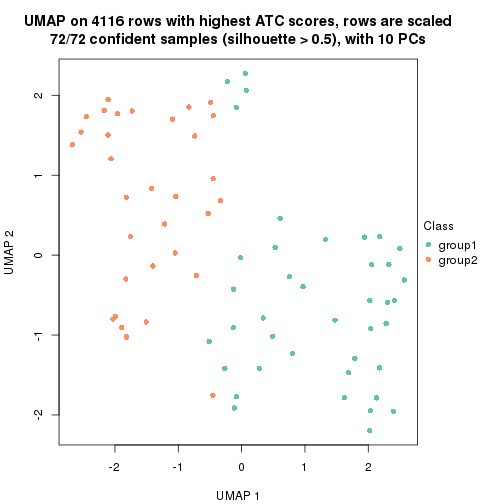
dimension_reduction(res, k = 3, method = "UMAP")
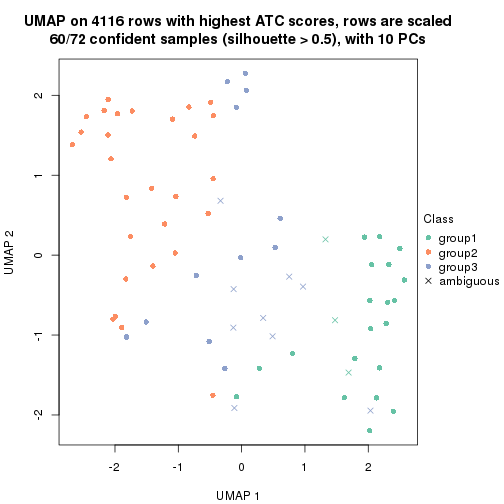
dimension_reduction(res, k = 4, method = "UMAP")
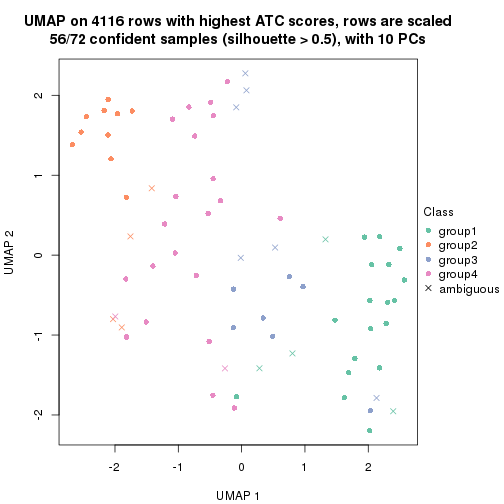
dimension_reduction(res, k = 5, method = "UMAP")
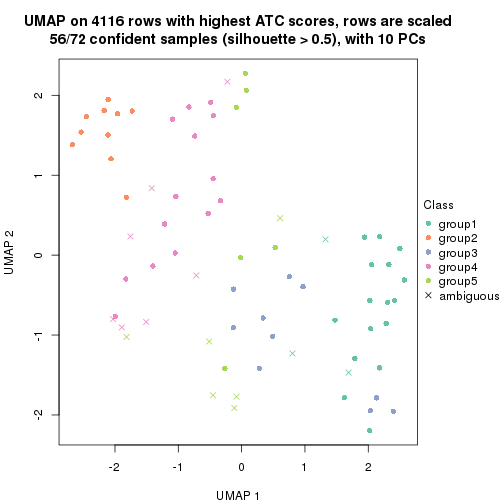
dimension_reduction(res, k = 6, method = "UMAP")
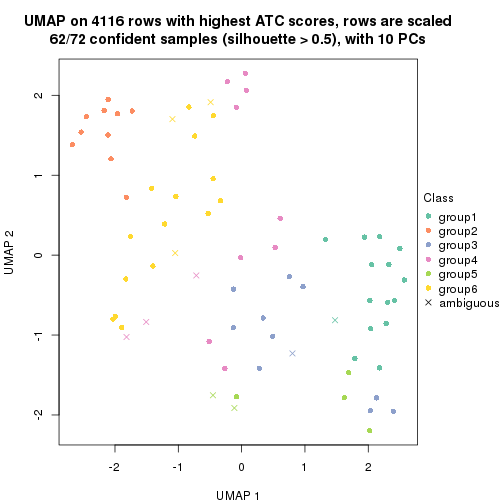
Following heatmap shows how subgroups are split when increasing k:
collect_classes(res)
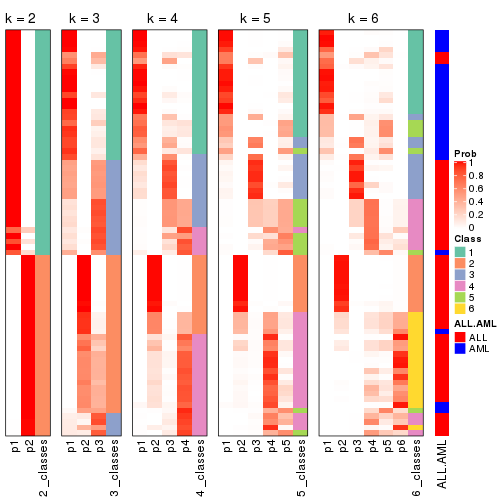
Test correlation between subgroups and known annotations. If the known annotation is numeric, one-way ANOVA test is applied, and if the known annotation is discrete, chi-squared contingency table test is applied.
test_to_known_factors(res)
#> n ALL.AML(p) k
#> ATC:kmeans 72 1.50e-04 2
#> ATC:kmeans 60 2.70e-11 3
#> ATC:kmeans 56 7.62e-09 4
#> ATC:kmeans 56 9.68e-08 5
#> ATC:kmeans 62 8.55e-08 6
If matrix rows can be associated to genes, consider to use functional_enrichment(res,
...) to perform function enrichment for the signature genes. See this vignette for more detailed explanations.
The object with results only for a single top-value method and a single partition method can be extracted as:
res = res_list["ATC", "skmeans"]
# you can also extract it by
# res = res_list["ATC:skmeans"]
A summary of res and all the functions that can be applied to it:
res
#> A 'ConsensusPartition' object with k = 2, 3, 4, 5, 6.
#> On a matrix with 4116 rows and 72 columns.
#> Top rows (412, 824, 1235, 1646, 2058) are extracted by 'ATC' method.
#> Subgroups are detected by 'skmeans' method.
#> Performed in total 1250 partitions by row resampling.
#> Best k for subgroups seems to be 3.
#>
#> Following methods can be applied to this 'ConsensusPartition' object:
#> [1] "cola_report" "collect_classes" "collect_plots"
#> [4] "collect_stats" "colnames" "compare_signatures"
#> [7] "consensus_heatmap" "dimension_reduction" "functional_enrichment"
#> [10] "get_anno_col" "get_anno" "get_classes"
#> [13] "get_consensus" "get_matrix" "get_membership"
#> [16] "get_param" "get_signatures" "get_stats"
#> [19] "is_best_k" "is_stable_k" "membership_heatmap"
#> [22] "ncol" "nrow" "plot_ecdf"
#> [25] "rownames" "select_partition_number" "show"
#> [28] "suggest_best_k" "test_to_known_factors"
collect_plots() function collects all the plots made from res for all k (number of partitions)
into one single page to provide an easy and fast comparison between different k.
collect_plots(res)
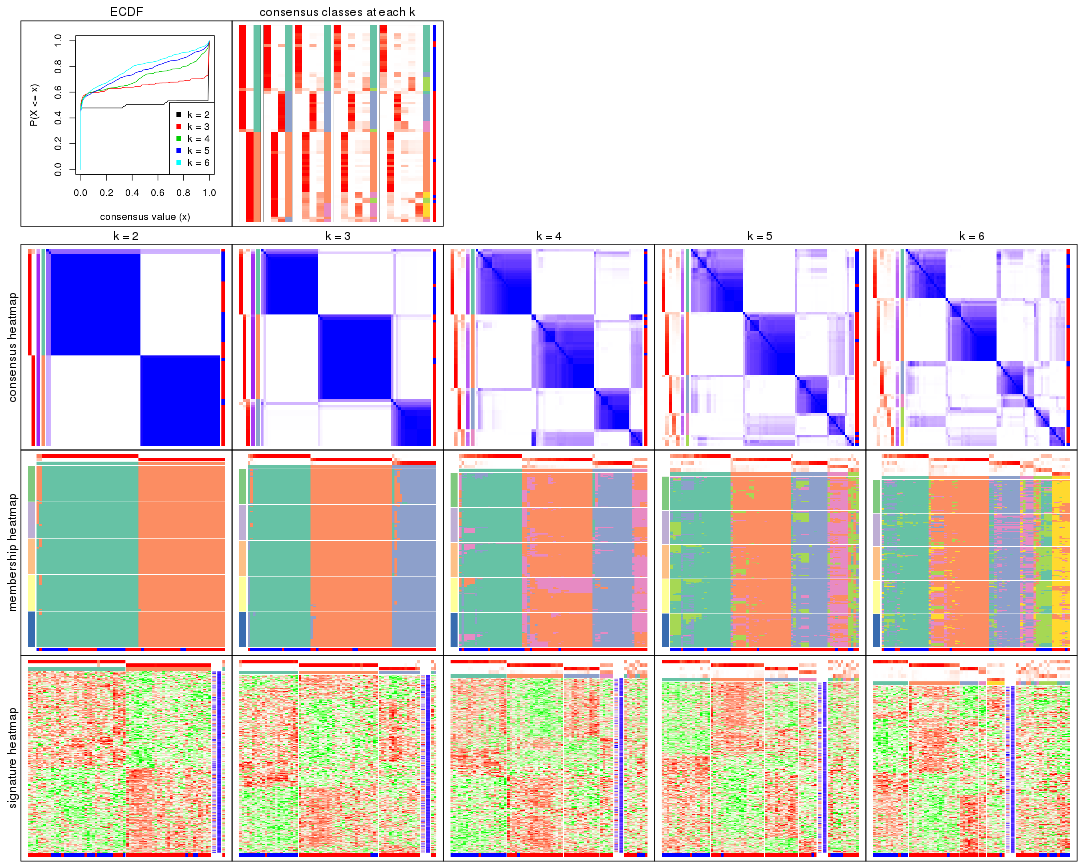
The plots are:
k and the heatmap of
predicted classes for each k.k.k.k.All the plots in panels can be made by individual functions and they are plotted later in this section.
select_partition_number() produces several plots showing different
statistics for choosing “optimized” k. There are following statistics:
k;k, the area increased is defined as \(A_k - A_{k-1}\).The detailed explanations of these statistics can be found in the cola vignette.
Generally speaking, lower PAC score, higher mean silhouette score or higher
concordance corresponds to better partition. Rand index and Jaccard index
measure how similar the current partition is compared to partition with k-1.
If they are too similar, we won't accept k is better than k-1.
select_partition_number(res)
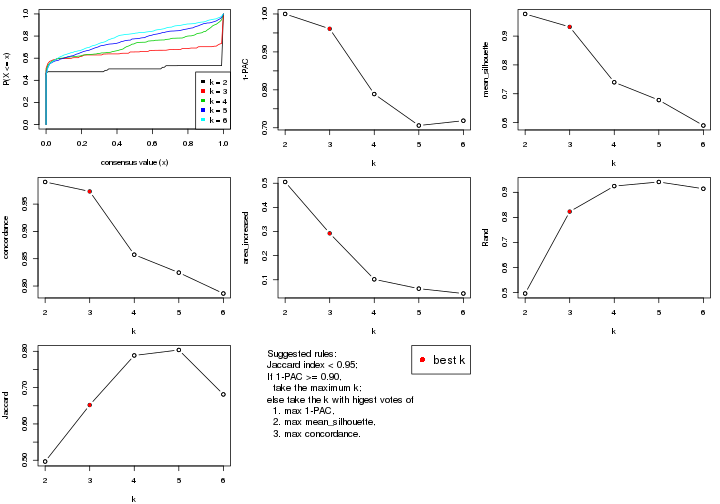
The numeric values for all these statistics can be obtained by get_stats().
get_stats(res)
#> k 1-PAC mean_silhouette concordance area_increased Rand Jaccard
#> 2 2 1.000 0.977 0.991 0.5052 0.496 0.496
#> 3 3 0.961 0.932 0.973 0.2923 0.823 0.652
#> 4 4 0.789 0.740 0.857 0.1018 0.925 0.789
#> 5 5 0.706 0.678 0.825 0.0633 0.941 0.804
#> 6 6 0.719 0.590 0.786 0.0431 0.914 0.681
suggest_best_k() suggests the best \(k\) based on these statistics. The rules are as follows:
suggest_best_k(res)
#> [1] 3
#> attr(,"optional")
#> [1] 2
There is also optional best \(k\) = 2 that is worth to check.
Following shows the table of the partitions (You need to click the show/hide
code output link to see it). The membership matrix (columns with name p*)
is inferred by
clue::cl_consensus()
function with the SE method. Basically the value in the membership matrix
represents the probability to belong to a certain group. The finall class
label for an item is determined with the group with highest probability it
belongs to.
In get_classes() function, the entropy is calculated from the membership
matrix and the silhouette score is calculated from the consensus matrix.
cbind(get_classes(res, k = 2), get_membership(res, k = 2))
#> class entropy silhouette p1 p2
#> sample_39 1 0.0000 0.982 1.000 0.000
#> sample_40 1 0.0000 0.982 1.000 0.000
#> sample_42 2 0.0000 1.000 0.000 1.000
#> sample_47 2 0.0000 1.000 0.000 1.000
#> sample_48 2 0.0000 1.000 0.000 1.000
#> sample_49 1 0.0000 0.982 1.000 0.000
#> sample_41 2 0.0000 1.000 0.000 1.000
#> sample_43 2 0.0000 1.000 0.000 1.000
#> sample_44 2 0.0000 1.000 0.000 1.000
#> sample_45 2 0.0000 1.000 0.000 1.000
#> sample_46 2 0.0000 1.000 0.000 1.000
#> sample_70 2 0.0000 1.000 0.000 1.000
#> sample_71 2 0.0000 1.000 0.000 1.000
#> sample_72 2 0.0000 1.000 0.000 1.000
#> sample_68 2 0.0000 1.000 0.000 1.000
#> sample_69 2 0.0000 1.000 0.000 1.000
#> sample_67 2 0.0000 1.000 0.000 1.000
#> sample_55 1 0.0000 0.982 1.000 0.000
#> sample_56 1 0.0000 0.982 1.000 0.000
#> sample_59 2 0.0000 1.000 0.000 1.000
#> sample_52 1 0.0000 0.982 1.000 0.000
#> sample_53 1 0.0000 0.982 1.000 0.000
#> sample_51 1 0.0000 0.982 1.000 0.000
#> sample_50 1 0.0000 0.982 1.000 0.000
#> sample_54 2 0.0000 1.000 0.000 1.000
#> sample_57 1 0.0000 0.982 1.000 0.000
#> sample_58 1 0.0000 0.982 1.000 0.000
#> sample_60 1 0.9170 0.515 0.668 0.332
#> sample_61 1 0.0000 0.982 1.000 0.000
#> sample_65 1 0.0000 0.982 1.000 0.000
#> sample_66 2 0.0000 1.000 0.000 1.000
#> sample_63 1 0.0000 0.982 1.000 0.000
#> sample_64 1 0.0000 0.982 1.000 0.000
#> sample_62 1 0.0000 0.982 1.000 0.000
#> sample_1 1 0.0000 0.982 1.000 0.000
#> sample_2 2 0.0000 1.000 0.000 1.000
#> sample_3 1 0.0000 0.982 1.000 0.000
#> sample_4 1 0.0000 0.982 1.000 0.000
#> sample_5 2 0.0000 1.000 0.000 1.000
#> sample_6 1 0.0000 0.982 1.000 0.000
#> sample_7 1 0.0000 0.982 1.000 0.000
#> sample_8 1 0.0000 0.982 1.000 0.000
#> sample_9 2 0.0000 1.000 0.000 1.000
#> sample_10 2 0.0672 0.992 0.008 0.992
#> sample_11 2 0.0000 1.000 0.000 1.000
#> sample_12 1 0.0000 0.982 1.000 0.000
#> sample_13 2 0.0000 1.000 0.000 1.000
#> sample_14 2 0.0000 1.000 0.000 1.000
#> sample_15 2 0.0000 1.000 0.000 1.000
#> sample_16 2 0.0000 1.000 0.000 1.000
#> sample_17 2 0.0000 1.000 0.000 1.000
#> sample_18 1 0.9286 0.489 0.656 0.344
#> sample_19 2 0.0000 1.000 0.000 1.000
#> sample_20 2 0.0000 1.000 0.000 1.000
#> sample_21 2 0.0000 1.000 0.000 1.000
#> sample_22 1 0.0000 0.982 1.000 0.000
#> sample_23 1 0.0000 0.982 1.000 0.000
#> sample_24 2 0.0000 1.000 0.000 1.000
#> sample_25 1 0.0000 0.982 1.000 0.000
#> sample_26 2 0.0000 1.000 0.000 1.000
#> sample_27 1 0.0000 0.982 1.000 0.000
#> sample_34 1 0.0000 0.982 1.000 0.000
#> sample_35 1 0.0000 0.982 1.000 0.000
#> sample_36 1 0.0000 0.982 1.000 0.000
#> sample_37 1 0.0000 0.982 1.000 0.000
#> sample_38 1 0.0000 0.982 1.000 0.000
#> sample_28 1 0.0000 0.982 1.000 0.000
#> sample_29 2 0.0000 1.000 0.000 1.000
#> sample_30 1 0.0000 0.982 1.000 0.000
#> sample_31 1 0.0000 0.982 1.000 0.000
#> sample_32 1 0.0000 0.982 1.000 0.000
#> sample_33 1 0.0000 0.982 1.000 0.000
cbind(get_classes(res, k = 3), get_membership(res, k = 3))
#> class entropy silhouette p1 p2 p3
#> sample_39 3 0.0592 0.922 0.012 0.000 0.988
#> sample_40 3 0.0237 0.927 0.004 0.000 0.996
#> sample_42 2 0.0000 0.994 0.000 1.000 0.000
#> sample_47 2 0.0000 0.994 0.000 1.000 0.000
#> sample_48 2 0.0000 0.994 0.000 1.000 0.000
#> sample_49 3 0.0237 0.927 0.004 0.000 0.996
#> sample_41 2 0.0000 0.994 0.000 1.000 0.000
#> sample_43 2 0.0000 0.994 0.000 1.000 0.000
#> sample_44 2 0.0000 0.994 0.000 1.000 0.000
#> sample_45 2 0.0000 0.994 0.000 1.000 0.000
#> sample_46 2 0.0000 0.994 0.000 1.000 0.000
#> sample_70 2 0.3752 0.819 0.000 0.856 0.144
#> sample_71 2 0.0000 0.994 0.000 1.000 0.000
#> sample_72 2 0.0000 0.994 0.000 1.000 0.000
#> sample_68 2 0.0000 0.994 0.000 1.000 0.000
#> sample_69 2 0.0000 0.994 0.000 1.000 0.000
#> sample_67 2 0.0000 0.994 0.000 1.000 0.000
#> sample_55 3 0.0000 0.927 0.000 0.000 1.000
#> sample_56 3 0.0237 0.927 0.004 0.000 0.996
#> sample_59 2 0.1411 0.958 0.000 0.964 0.036
#> sample_52 1 0.0000 0.967 1.000 0.000 0.000
#> sample_53 1 0.0000 0.967 1.000 0.000 0.000
#> sample_51 1 0.0000 0.967 1.000 0.000 0.000
#> sample_50 1 0.0000 0.967 1.000 0.000 0.000
#> sample_54 2 0.0000 0.994 0.000 1.000 0.000
#> sample_57 1 0.0000 0.967 1.000 0.000 0.000
#> sample_58 1 0.0000 0.967 1.000 0.000 0.000
#> sample_60 1 0.5680 0.670 0.764 0.212 0.024
#> sample_61 1 0.0000 0.967 1.000 0.000 0.000
#> sample_65 1 0.0000 0.967 1.000 0.000 0.000
#> sample_66 2 0.0000 0.994 0.000 1.000 0.000
#> sample_63 1 0.0000 0.967 1.000 0.000 0.000
#> sample_64 1 0.0237 0.964 0.996 0.000 0.004
#> sample_62 1 0.0000 0.967 1.000 0.000 0.000
#> sample_1 3 0.0000 0.927 0.000 0.000 1.000
#> sample_2 2 0.0000 0.994 0.000 1.000 0.000
#> sample_3 3 0.0000 0.927 0.000 0.000 1.000
#> sample_4 3 0.0000 0.927 0.000 0.000 1.000
#> sample_5 2 0.0000 0.994 0.000 1.000 0.000
#> sample_6 3 0.0000 0.927 0.000 0.000 1.000
#> sample_7 3 0.0000 0.927 0.000 0.000 1.000
#> sample_8 3 0.0592 0.922 0.012 0.000 0.988
#> sample_9 2 0.0000 0.994 0.000 1.000 0.000
#> sample_10 3 0.4399 0.756 0.000 0.188 0.812
#> sample_11 2 0.0000 0.994 0.000 1.000 0.000
#> sample_12 1 0.0000 0.967 1.000 0.000 0.000
#> sample_13 2 0.0000 0.994 0.000 1.000 0.000
#> sample_14 2 0.0000 0.994 0.000 1.000 0.000
#> sample_15 2 0.0000 0.994 0.000 1.000 0.000
#> sample_16 2 0.0000 0.994 0.000 1.000 0.000
#> sample_17 2 0.0000 0.994 0.000 1.000 0.000
#> sample_18 3 0.1860 0.890 0.000 0.052 0.948
#> sample_19 2 0.0000 0.994 0.000 1.000 0.000
#> sample_20 2 0.0000 0.994 0.000 1.000 0.000
#> sample_21 2 0.0000 0.994 0.000 1.000 0.000
#> sample_22 1 0.6180 0.242 0.584 0.000 0.416
#> sample_23 3 0.0237 0.927 0.004 0.000 0.996
#> sample_24 2 0.0000 0.994 0.000 1.000 0.000
#> sample_25 3 0.5678 0.520 0.316 0.000 0.684
#> sample_26 3 0.6291 0.144 0.000 0.468 0.532
#> sample_27 3 0.0237 0.927 0.004 0.000 0.996
#> sample_34 1 0.0000 0.967 1.000 0.000 0.000
#> sample_35 1 0.1163 0.942 0.972 0.000 0.028
#> sample_36 1 0.0000 0.967 1.000 0.000 0.000
#> sample_37 1 0.0000 0.967 1.000 0.000 0.000
#> sample_38 1 0.0000 0.967 1.000 0.000 0.000
#> sample_28 1 0.0000 0.967 1.000 0.000 0.000
#> sample_29 2 0.0000 0.994 0.000 1.000 0.000
#> sample_30 1 0.0000 0.967 1.000 0.000 0.000
#> sample_31 1 0.0000 0.967 1.000 0.000 0.000
#> sample_32 1 0.0000 0.967 1.000 0.000 0.000
#> sample_33 1 0.0000 0.967 1.000 0.000 0.000
cbind(get_classes(res, k = 4), get_membership(res, k = 4))
#> class entropy silhouette p1 p2 p3 p4
#> sample_39 3 0.0000 0.9246 0.000 0.000 1.000 0.000
#> sample_40 3 0.0188 0.9230 0.000 0.000 0.996 0.004
#> sample_42 4 0.4992 0.7177 0.000 0.476 0.000 0.524
#> sample_47 2 0.0469 0.8039 0.000 0.988 0.000 0.012
#> sample_48 2 0.0000 0.8048 0.000 1.000 0.000 0.000
#> sample_49 3 0.0000 0.9246 0.000 0.000 1.000 0.000
#> sample_41 2 0.0469 0.8039 0.000 0.988 0.000 0.012
#> sample_43 2 0.2216 0.7632 0.000 0.908 0.000 0.092
#> sample_44 2 0.2216 0.7632 0.000 0.908 0.000 0.092
#> sample_45 2 0.2149 0.7649 0.000 0.912 0.000 0.088
#> sample_46 2 0.2281 0.7602 0.000 0.904 0.000 0.096
#> sample_70 2 0.4418 0.6225 0.000 0.784 0.032 0.184
#> sample_71 4 0.5050 0.7465 0.004 0.408 0.000 0.588
#> sample_72 4 0.4941 0.7571 0.000 0.436 0.000 0.564
#> sample_68 2 0.0000 0.8048 0.000 1.000 0.000 0.000
#> sample_69 2 0.0000 0.8048 0.000 1.000 0.000 0.000
#> sample_67 4 0.4989 0.7451 0.000 0.472 0.000 0.528
#> sample_55 3 0.2647 0.8625 0.000 0.000 0.880 0.120
#> sample_56 3 0.0000 0.9246 0.000 0.000 1.000 0.000
#> sample_59 2 0.4964 0.3751 0.000 0.616 0.004 0.380
#> sample_52 1 0.3219 0.8384 0.836 0.000 0.000 0.164
#> sample_53 1 0.0000 0.9132 1.000 0.000 0.000 0.000
#> sample_51 1 0.0000 0.9132 1.000 0.000 0.000 0.000
#> sample_50 1 0.0000 0.9132 1.000 0.000 0.000 0.000
#> sample_54 2 0.4564 0.4369 0.000 0.672 0.000 0.328
#> sample_57 1 0.4365 0.8113 0.784 0.000 0.028 0.188
#> sample_58 1 0.2214 0.8936 0.928 0.000 0.044 0.028
#> sample_60 1 0.7834 0.2702 0.444 0.196 0.008 0.352
#> sample_61 1 0.1452 0.9013 0.956 0.000 0.036 0.008
#> sample_65 1 0.0524 0.9110 0.988 0.000 0.004 0.008
#> sample_66 2 0.0707 0.7992 0.000 0.980 0.000 0.020
#> sample_63 1 0.3300 0.8493 0.848 0.000 0.008 0.144
#> sample_64 1 0.2909 0.8659 0.888 0.000 0.092 0.020
#> sample_62 1 0.3157 0.8503 0.852 0.000 0.004 0.144
#> sample_1 3 0.0921 0.9198 0.000 0.000 0.972 0.028
#> sample_2 2 0.5000 -0.7479 0.000 0.504 0.000 0.496
#> sample_3 3 0.1792 0.9073 0.000 0.000 0.932 0.068
#> sample_4 3 0.1022 0.9188 0.000 0.000 0.968 0.032
#> sample_5 2 0.0000 0.8048 0.000 1.000 0.000 0.000
#> sample_6 3 0.1716 0.9090 0.000 0.000 0.936 0.064
#> sample_7 3 0.0000 0.9246 0.000 0.000 1.000 0.000
#> sample_8 3 0.0000 0.9246 0.000 0.000 1.000 0.000
#> sample_9 2 0.1716 0.7620 0.000 0.936 0.000 0.064
#> sample_10 4 0.6013 0.1072 0.000 0.064 0.312 0.624
#> sample_11 4 0.4994 0.7231 0.000 0.480 0.000 0.520
#> sample_12 1 0.0376 0.9110 0.992 0.000 0.004 0.004
#> sample_13 2 0.0000 0.8048 0.000 1.000 0.000 0.000
#> sample_14 2 0.0817 0.7924 0.000 0.976 0.000 0.024
#> sample_15 2 0.0000 0.8048 0.000 1.000 0.000 0.000
#> sample_16 2 0.1637 0.7766 0.000 0.940 0.000 0.060
#> sample_17 2 0.2081 0.7481 0.000 0.916 0.000 0.084
#> sample_18 3 0.4910 0.7176 0.000 0.020 0.704 0.276
#> sample_19 2 0.0921 0.8006 0.000 0.972 0.000 0.028
#> sample_20 2 0.0000 0.8048 0.000 1.000 0.000 0.000
#> sample_21 2 0.0000 0.8048 0.000 1.000 0.000 0.000
#> sample_22 1 0.5097 0.2297 0.568 0.000 0.428 0.004
#> sample_23 3 0.1716 0.9090 0.000 0.000 0.936 0.064
#> sample_24 2 0.0000 0.8048 0.000 1.000 0.000 0.000
#> sample_25 3 0.6176 0.3528 0.368 0.000 0.572 0.060
#> sample_26 2 0.7717 -0.0682 0.000 0.448 0.288 0.264
#> sample_27 3 0.0000 0.9246 0.000 0.000 1.000 0.000
#> sample_34 1 0.1151 0.9058 0.968 0.000 0.024 0.008
#> sample_35 1 0.4086 0.7318 0.776 0.000 0.216 0.008
#> sample_36 1 0.0000 0.9132 1.000 0.000 0.000 0.000
#> sample_37 1 0.0000 0.9132 1.000 0.000 0.000 0.000
#> sample_38 1 0.0000 0.9132 1.000 0.000 0.000 0.000
#> sample_28 1 0.0000 0.9132 1.000 0.000 0.000 0.000
#> sample_29 2 0.5167 -0.7191 0.004 0.508 0.000 0.488
#> sample_30 1 0.0000 0.9132 1.000 0.000 0.000 0.000
#> sample_31 1 0.0188 0.9125 0.996 0.000 0.000 0.004
#> sample_32 1 0.0000 0.9132 1.000 0.000 0.000 0.000
#> sample_33 1 0.0000 0.9132 1.000 0.000 0.000 0.000
cbind(get_classes(res, k = 5), get_membership(res, k = 5))
#> class entropy silhouette p1 p2 p3 p4 p5
#> sample_39 3 0.0324 0.8073 0.004 0.000 0.992 0.000 0.004
#> sample_40 3 0.0510 0.8003 0.000 0.000 0.984 0.000 0.016
#> sample_42 4 0.4157 0.7685 0.000 0.264 0.000 0.716 0.020
#> sample_47 2 0.0566 0.8652 0.000 0.984 0.000 0.012 0.004
#> sample_48 2 0.0000 0.8676 0.000 1.000 0.000 0.000 0.000
#> sample_49 3 0.0162 0.8090 0.000 0.000 0.996 0.000 0.004
#> sample_41 2 0.0451 0.8652 0.000 0.988 0.000 0.008 0.004
#> sample_43 2 0.3526 0.7496 0.000 0.832 0.000 0.072 0.096
#> sample_44 2 0.3234 0.7683 0.000 0.852 0.000 0.064 0.084
#> sample_45 2 0.3110 0.7745 0.000 0.860 0.000 0.060 0.080
#> sample_46 2 0.3517 0.7479 0.000 0.832 0.000 0.068 0.100
#> sample_70 2 0.5782 0.4295 0.000 0.644 0.012 0.128 0.216
#> sample_71 4 0.3006 0.7504 0.004 0.156 0.000 0.836 0.004
#> sample_72 4 0.3123 0.7713 0.000 0.184 0.000 0.812 0.004
#> sample_68 2 0.0000 0.8676 0.000 1.000 0.000 0.000 0.000
#> sample_69 2 0.0000 0.8676 0.000 1.000 0.000 0.000 0.000
#> sample_67 4 0.3398 0.7868 0.000 0.216 0.000 0.780 0.004
#> sample_55 3 0.4491 0.5410 0.000 0.000 0.652 0.020 0.328
#> sample_56 3 0.0162 0.8090 0.000 0.000 0.996 0.000 0.004
#> sample_59 5 0.6162 0.1140 0.000 0.436 0.012 0.092 0.460
#> sample_52 1 0.4597 0.4845 0.564 0.000 0.000 0.012 0.424
#> sample_53 1 0.0000 0.8138 1.000 0.000 0.000 0.000 0.000
#> sample_51 1 0.0000 0.8138 1.000 0.000 0.000 0.000 0.000
#> sample_50 1 0.0000 0.8138 1.000 0.000 0.000 0.000 0.000
#> sample_54 5 0.4560 0.1341 0.000 0.484 0.000 0.008 0.508
#> sample_57 1 0.6092 0.4178 0.480 0.000 0.108 0.004 0.408
#> sample_58 1 0.5205 0.6580 0.672 0.000 0.224 0.000 0.104
#> sample_60 5 0.4718 0.2605 0.168 0.072 0.012 0.000 0.748
#> sample_61 1 0.4298 0.7121 0.756 0.000 0.184 0.000 0.060
#> sample_65 1 0.2233 0.7941 0.904 0.000 0.016 0.000 0.080
#> sample_66 2 0.1195 0.8506 0.000 0.960 0.000 0.028 0.012
#> sample_63 1 0.5076 0.5513 0.600 0.000 0.024 0.012 0.364
#> sample_64 1 0.5652 0.5217 0.564 0.000 0.344 0.000 0.092
#> sample_62 1 0.4975 0.5246 0.584 0.000 0.016 0.012 0.388
#> sample_1 3 0.2628 0.7800 0.000 0.000 0.884 0.028 0.088
#> sample_2 4 0.4046 0.7765 0.000 0.296 0.000 0.696 0.008
#> sample_3 3 0.5120 0.6720 0.000 0.000 0.684 0.104 0.212
#> sample_4 3 0.3608 0.7510 0.000 0.000 0.812 0.040 0.148
#> sample_5 2 0.0000 0.8676 0.000 1.000 0.000 0.000 0.000
#> sample_6 3 0.5060 0.6785 0.000 0.000 0.692 0.104 0.204
#> sample_7 3 0.0451 0.8086 0.000 0.000 0.988 0.004 0.008
#> sample_8 3 0.0000 0.8089 0.000 0.000 1.000 0.000 0.000
#> sample_9 2 0.4266 0.6275 0.000 0.776 0.000 0.120 0.104
#> sample_10 4 0.7086 0.2233 0.000 0.048 0.156 0.504 0.292
#> sample_11 4 0.4748 0.7385 0.000 0.300 0.000 0.660 0.040
#> sample_12 1 0.0960 0.8096 0.972 0.000 0.008 0.004 0.016
#> sample_13 2 0.0000 0.8676 0.000 1.000 0.000 0.000 0.000
#> sample_14 2 0.1310 0.8466 0.000 0.956 0.000 0.020 0.024
#> sample_15 2 0.0000 0.8676 0.000 1.000 0.000 0.000 0.000
#> sample_16 2 0.1725 0.8353 0.000 0.936 0.000 0.020 0.044
#> sample_17 2 0.2595 0.7856 0.000 0.888 0.000 0.032 0.080
#> sample_18 5 0.5613 -0.3478 0.000 0.004 0.412 0.064 0.520
#> sample_19 2 0.0703 0.8620 0.000 0.976 0.000 0.024 0.000
#> sample_20 2 0.0000 0.8676 0.000 1.000 0.000 0.000 0.000
#> sample_21 2 0.0290 0.8646 0.000 0.992 0.000 0.008 0.000
#> sample_22 1 0.4504 0.3341 0.564 0.000 0.428 0.008 0.000
#> sample_23 3 0.5060 0.6785 0.000 0.000 0.692 0.104 0.204
#> sample_24 2 0.0000 0.8676 0.000 1.000 0.000 0.000 0.000
#> sample_25 3 0.7185 0.0147 0.396 0.000 0.424 0.116 0.064
#> sample_26 2 0.8598 -0.4169 0.000 0.276 0.256 0.228 0.240
#> sample_27 3 0.0162 0.8090 0.000 0.000 0.996 0.000 0.004
#> sample_34 1 0.2922 0.7827 0.872 0.000 0.072 0.000 0.056
#> sample_35 1 0.5414 0.4138 0.528 0.000 0.412 0.000 0.060
#> sample_36 1 0.0290 0.8128 0.992 0.000 0.000 0.000 0.008
#> sample_37 1 0.0000 0.8138 1.000 0.000 0.000 0.000 0.000
#> sample_38 1 0.0162 0.8141 0.996 0.000 0.004 0.000 0.000
#> sample_28 1 0.0162 0.8141 0.996 0.000 0.004 0.000 0.000
#> sample_29 4 0.4806 0.7335 0.012 0.336 0.000 0.636 0.016
#> sample_30 1 0.0955 0.8057 0.968 0.000 0.000 0.004 0.028
#> sample_31 1 0.1282 0.8064 0.952 0.000 0.000 0.004 0.044
#> sample_32 1 0.0162 0.8141 0.996 0.000 0.004 0.000 0.000
#> sample_33 1 0.0162 0.8141 0.996 0.000 0.004 0.000 0.000
cbind(get_classes(res, k = 6), get_membership(res, k = 6))
#> class entropy silhouette p1 p2 p3 p4 p5 p6
#> sample_39 3 0.0810 0.65026 0.004 0.000 0.976 0.008 0.004 0.008
#> sample_40 3 0.1546 0.63483 0.004 0.000 0.944 0.028 0.020 0.004
#> sample_42 6 0.4280 0.77106 0.000 0.212 0.000 0.040 0.020 0.728
#> sample_47 2 0.0520 0.81819 0.000 0.984 0.000 0.008 0.008 0.000
#> sample_48 2 0.0000 0.82147 0.000 1.000 0.000 0.000 0.000 0.000
#> sample_49 3 0.0000 0.65447 0.000 0.000 1.000 0.000 0.000 0.000
#> sample_41 2 0.0260 0.82023 0.000 0.992 0.000 0.000 0.000 0.008
#> sample_43 2 0.5305 0.61397 0.000 0.684 0.000 0.160 0.084 0.072
#> sample_44 2 0.4933 0.64434 0.000 0.716 0.000 0.152 0.072 0.060
#> sample_45 2 0.4900 0.64817 0.000 0.720 0.000 0.148 0.068 0.064
#> sample_46 2 0.5414 0.60120 0.000 0.672 0.000 0.168 0.088 0.072
#> sample_70 2 0.7213 0.21823 0.000 0.408 0.012 0.340 0.136 0.104
#> sample_71 6 0.2238 0.74163 0.008 0.068 0.000 0.016 0.004 0.904
#> sample_72 6 0.2163 0.77001 0.000 0.096 0.000 0.008 0.004 0.892
#> sample_68 2 0.0000 0.82147 0.000 1.000 0.000 0.000 0.000 0.000
#> sample_69 2 0.0000 0.82147 0.000 1.000 0.000 0.000 0.000 0.000
#> sample_67 6 0.2773 0.80868 0.000 0.152 0.000 0.008 0.004 0.836
#> sample_55 3 0.5497 0.08140 0.000 0.000 0.608 0.172 0.208 0.012
#> sample_56 3 0.0146 0.65434 0.000 0.000 0.996 0.004 0.000 0.000
#> sample_59 5 0.7451 0.00521 0.000 0.280 0.008 0.268 0.352 0.092
#> sample_52 5 0.3804 0.45019 0.336 0.000 0.000 0.008 0.656 0.000
#> sample_53 1 0.0260 0.78130 0.992 0.000 0.000 0.000 0.008 0.000
#> sample_51 1 0.0000 0.78109 1.000 0.000 0.000 0.000 0.000 0.000
#> sample_50 1 0.0508 0.77863 0.984 0.000 0.000 0.004 0.012 0.000
#> sample_54 5 0.4769 0.21572 0.000 0.336 0.000 0.056 0.604 0.004
#> sample_57 5 0.5546 0.34916 0.336 0.000 0.120 0.008 0.536 0.000
#> sample_58 1 0.5954 0.27331 0.492 0.000 0.372 0.016 0.112 0.008
#> sample_60 5 0.3842 0.37365 0.044 0.040 0.008 0.080 0.824 0.004
#> sample_61 1 0.5224 0.45833 0.620 0.000 0.288 0.012 0.072 0.008
#> sample_65 1 0.4044 0.64604 0.784 0.000 0.052 0.016 0.140 0.008
#> sample_66 2 0.2095 0.78581 0.000 0.916 0.000 0.028 0.016 0.040
#> sample_63 5 0.4968 0.39733 0.360 0.000 0.048 0.004 0.580 0.008
#> sample_64 3 0.5941 0.01201 0.364 0.000 0.500 0.016 0.112 0.008
#> sample_62 5 0.4585 0.45347 0.336 0.000 0.028 0.004 0.624 0.008
#> sample_1 3 0.3518 0.36759 0.000 0.000 0.784 0.184 0.024 0.008
#> sample_2 6 0.4026 0.80468 0.000 0.252 0.000 0.032 0.004 0.712
#> sample_3 4 0.3695 0.65184 0.000 0.000 0.376 0.624 0.000 0.000
#> sample_4 3 0.4216 0.06796 0.000 0.000 0.676 0.288 0.032 0.004
#> sample_5 2 0.0000 0.82147 0.000 1.000 0.000 0.000 0.000 0.000
#> sample_6 4 0.3890 0.64083 0.000 0.000 0.400 0.596 0.000 0.004
#> sample_7 3 0.1674 0.59106 0.000 0.000 0.924 0.068 0.004 0.004
#> sample_8 3 0.0508 0.65191 0.012 0.000 0.984 0.004 0.000 0.000
#> sample_9 2 0.4538 0.38127 0.000 0.612 0.000 0.340 0.000 0.048
#> sample_10 4 0.5404 0.39948 0.000 0.016 0.076 0.668 0.032 0.208
#> sample_11 6 0.5214 0.71827 0.000 0.216 0.000 0.172 0.000 0.612
#> sample_12 1 0.3067 0.71211 0.860 0.000 0.012 0.060 0.064 0.004
#> sample_13 2 0.0000 0.82147 0.000 1.000 0.000 0.000 0.000 0.000
#> sample_14 2 0.1594 0.78828 0.000 0.932 0.000 0.052 0.000 0.016
#> sample_15 2 0.0000 0.82147 0.000 1.000 0.000 0.000 0.000 0.000
#> sample_16 2 0.2245 0.77907 0.000 0.908 0.000 0.040 0.016 0.036
#> sample_17 2 0.3308 0.71418 0.000 0.848 0.000 0.048 0.056 0.048
#> sample_18 4 0.7109 0.24033 0.000 0.008 0.340 0.348 0.252 0.052
#> sample_19 2 0.1167 0.81176 0.000 0.960 0.000 0.020 0.008 0.012
#> sample_20 2 0.0000 0.82147 0.000 1.000 0.000 0.000 0.000 0.000
#> sample_21 2 0.0000 0.82147 0.000 1.000 0.000 0.000 0.000 0.000
#> sample_22 1 0.4394 0.34199 0.584 0.000 0.392 0.012 0.012 0.000
#> sample_23 4 0.3747 0.64619 0.000 0.000 0.396 0.604 0.000 0.000
#> sample_24 2 0.0000 0.82147 0.000 1.000 0.000 0.000 0.000 0.000
#> sample_25 1 0.7789 0.02085 0.392 0.000 0.300 0.136 0.040 0.132
#> sample_26 2 0.8848 -0.24391 0.000 0.260 0.196 0.168 0.140 0.236
#> sample_27 3 0.0000 0.65447 0.000 0.000 1.000 0.000 0.000 0.000
#> sample_34 1 0.4326 0.62648 0.764 0.000 0.140 0.016 0.072 0.008
#> sample_35 3 0.5694 -0.06860 0.404 0.000 0.496 0.020 0.072 0.008
#> sample_36 1 0.0858 0.77415 0.968 0.000 0.000 0.004 0.028 0.000
#> sample_37 1 0.0692 0.77689 0.976 0.000 0.000 0.004 0.020 0.000
#> sample_38 1 0.0436 0.78076 0.988 0.000 0.004 0.004 0.004 0.000
#> sample_28 1 0.0520 0.77863 0.984 0.000 0.000 0.008 0.008 0.000
#> sample_29 6 0.4860 0.76633 0.008 0.296 0.000 0.032 0.020 0.644
#> sample_30 1 0.2302 0.70012 0.872 0.000 0.000 0.008 0.120 0.000
#> sample_31 1 0.2339 0.74125 0.896 0.000 0.020 0.012 0.072 0.000
#> sample_32 1 0.1065 0.77752 0.964 0.000 0.008 0.008 0.020 0.000
#> sample_33 1 0.0291 0.78092 0.992 0.000 0.004 0.000 0.004 0.000
Heatmaps for the consensus matrix. It visualizes the probability of two samples to be in a same group.
consensus_heatmap(res, k = 2)
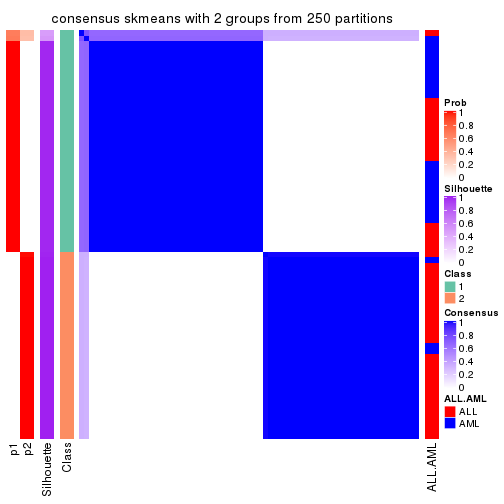
consensus_heatmap(res, k = 3)
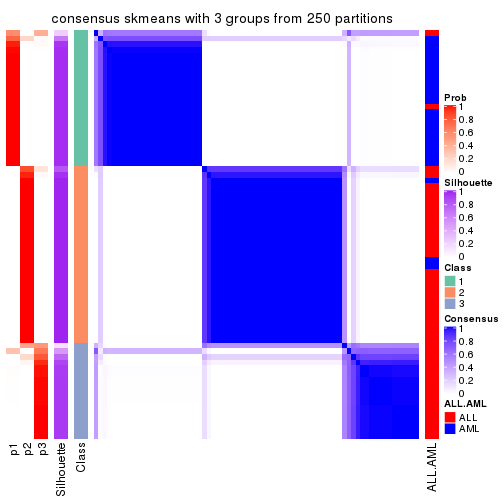
consensus_heatmap(res, k = 4)
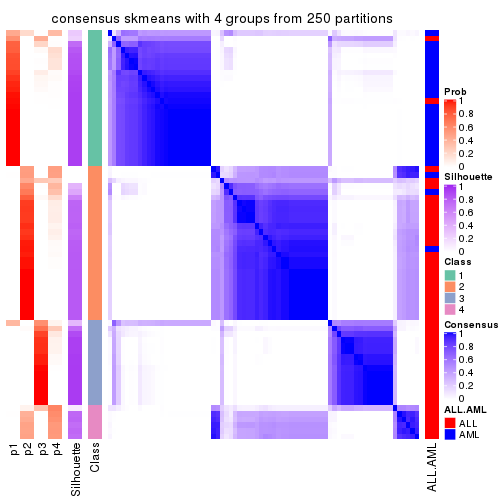
consensus_heatmap(res, k = 5)
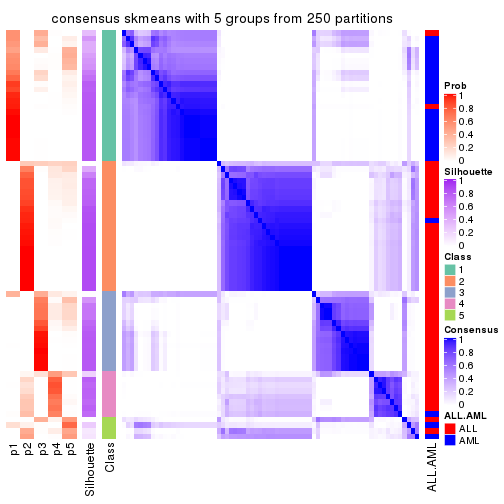
consensus_heatmap(res, k = 6)
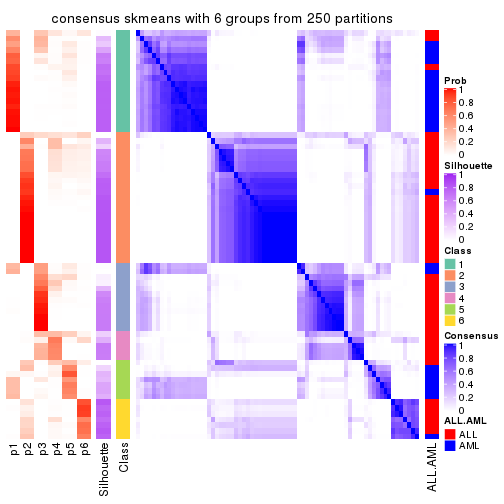
Heatmaps for the membership of samples in all partitions to see how consistent they are:
membership_heatmap(res, k = 2)
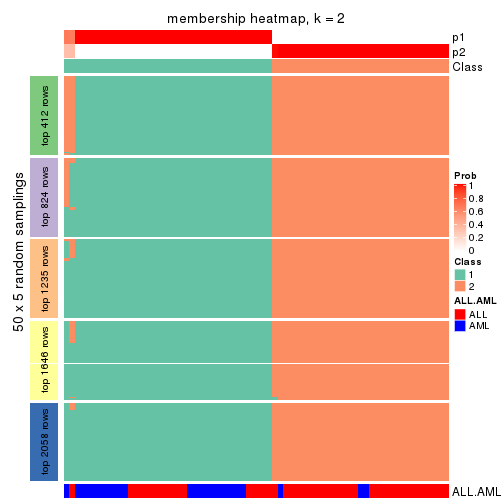
membership_heatmap(res, k = 3)
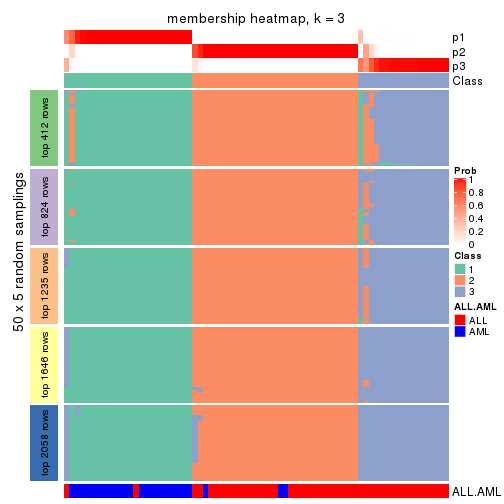
membership_heatmap(res, k = 4)
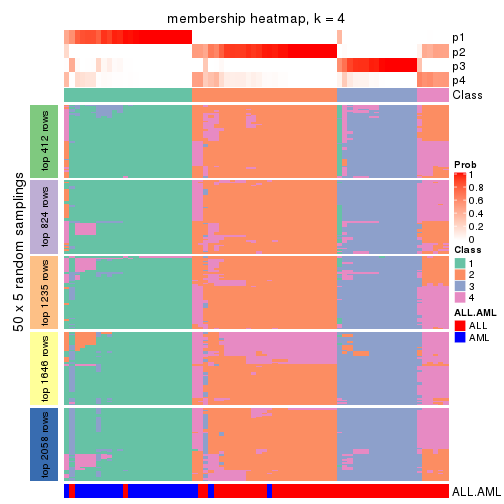
membership_heatmap(res, k = 5)
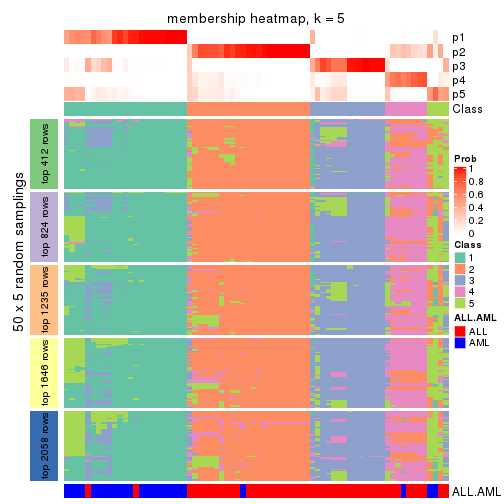
membership_heatmap(res, k = 6)
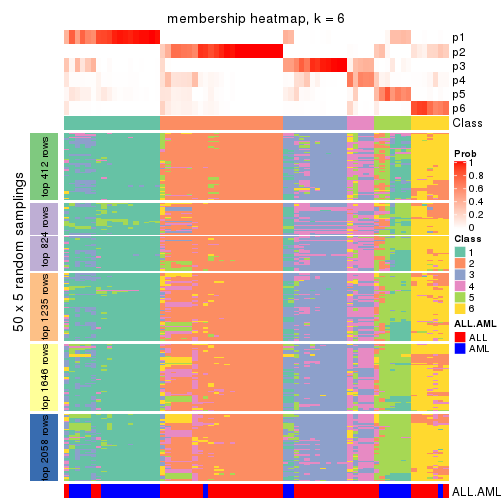
As soon as we have had the classes for columns, we can look for signatures which are significantly different between classes which can be candidate marks for certain classes. Following are the heatmaps for signatures.
Signature heatmaps where rows are scaled:
get_signatures(res, k = 2)
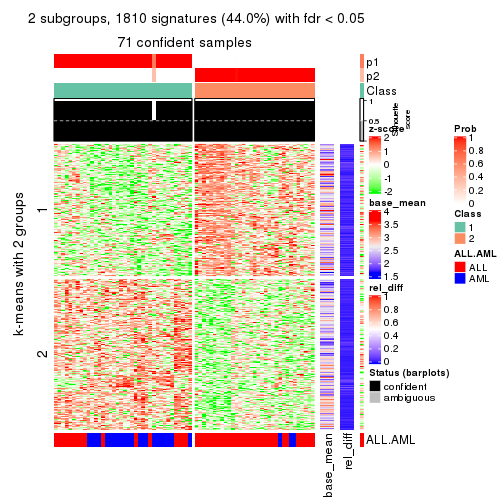
get_signatures(res, k = 3)
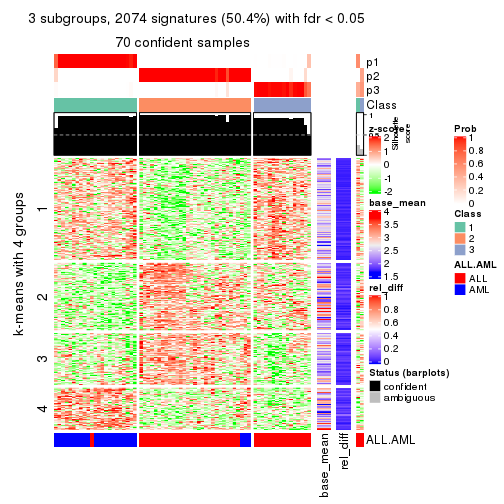
get_signatures(res, k = 4)
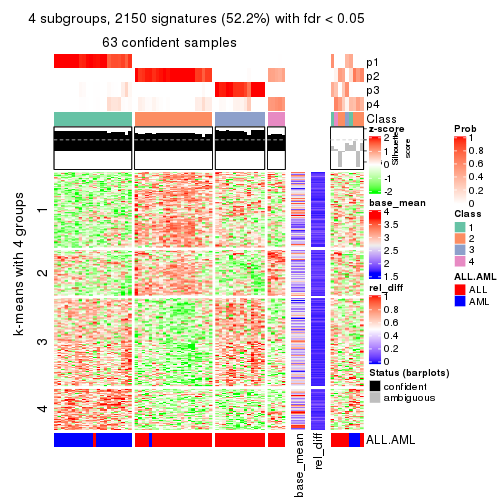
get_signatures(res, k = 5)
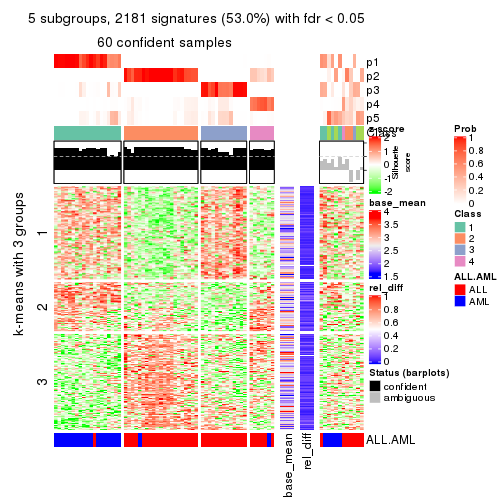
get_signatures(res, k = 6)
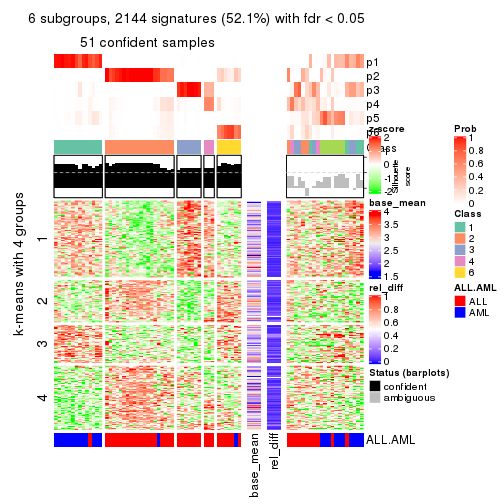
Signature heatmaps where rows are not scaled:
get_signatures(res, k = 2, scale_rows = FALSE)
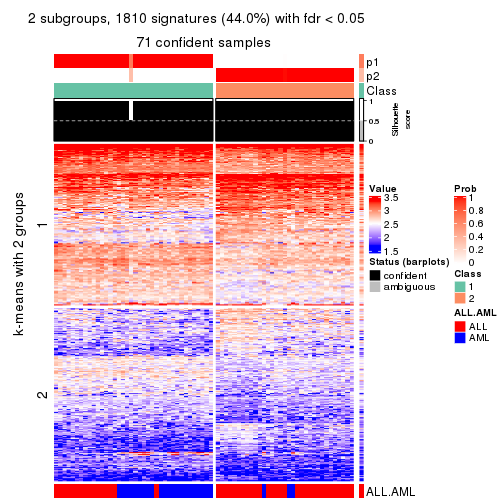
get_signatures(res, k = 3, scale_rows = FALSE)
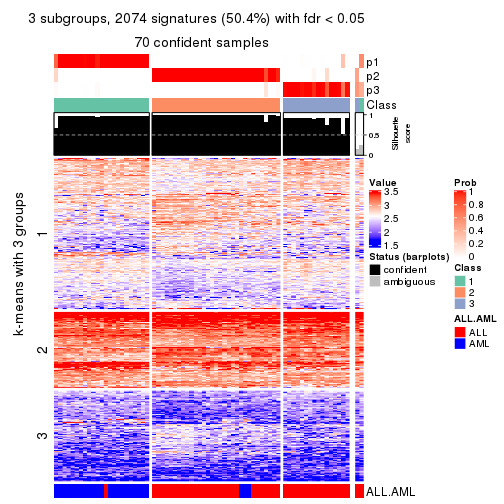
get_signatures(res, k = 4, scale_rows = FALSE)
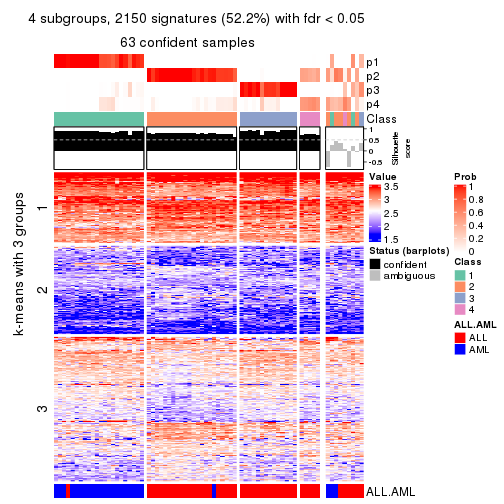
get_signatures(res, k = 5, scale_rows = FALSE)
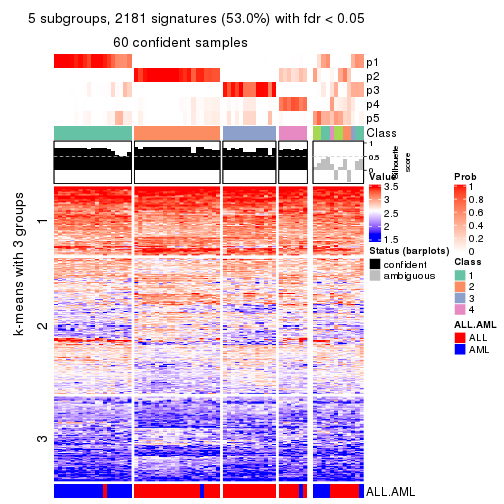
get_signatures(res, k = 6, scale_rows = FALSE)
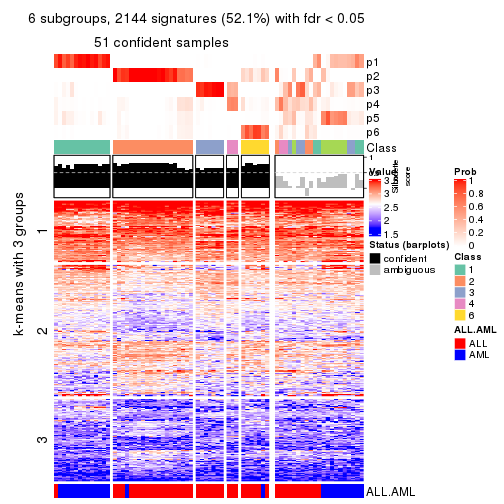
Compare the overlap of signatures from different k:
compare_signatures(res)
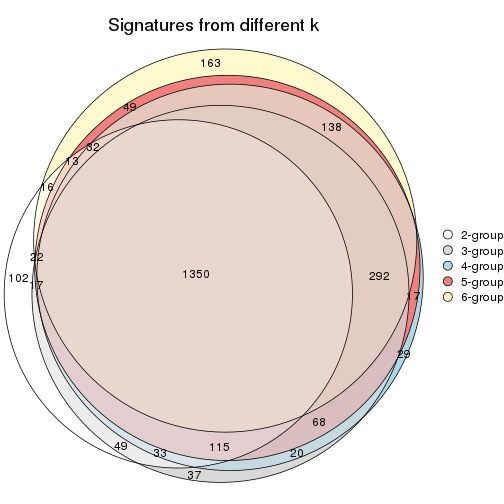
get_signature() returns a data frame invisibly. TO get the list of signatures, the function
call should be assigned to a variable explicitly. In following code, if plot argument is set
to FALSE, no heatmap is plotted while only the differential analysis is performed.
# code only for demonstration
tb = get_signature(res, k = ..., plot = FALSE)
An example of the output of tb is:
#> which_row fdr mean_1 mean_2 scaled_mean_1 scaled_mean_2 km
#> 1 38 0.042760348 8.373488 9.131774 -0.5533452 0.5164555 1
#> 2 40 0.018707592 7.106213 8.469186 -0.6173731 0.5762149 1
#> 3 55 0.019134737 10.221463 11.207825 -0.6159697 0.5749050 1
#> 4 59 0.006059896 5.921854 7.869574 -0.6899429 0.6439467 1
#> 5 60 0.018055526 8.928898 10.211722 -0.6204761 0.5791110 1
#> 6 98 0.009384629 15.714769 14.887706 0.6635654 -0.6193277 2
...
The columns in tb are:
which_row: row indices corresponding to the input matrix.fdr: FDR for the differential test. mean_x: The mean value in group x.scaled_mean_x: The mean value in group x after rows are scaled.km: Row groups if k-means clustering is applied to rows.UMAP plot which shows how samples are separated.
dimension_reduction(res, k = 2, method = "UMAP")
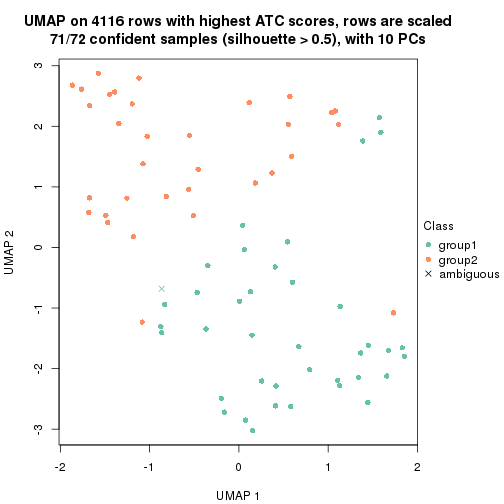
dimension_reduction(res, k = 3, method = "UMAP")
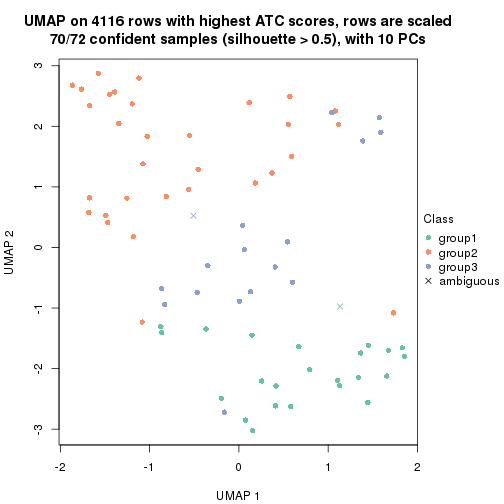
dimension_reduction(res, k = 4, method = "UMAP")
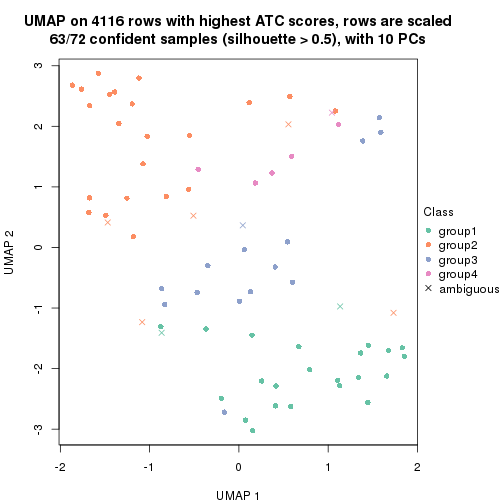
dimension_reduction(res, k = 5, method = "UMAP")
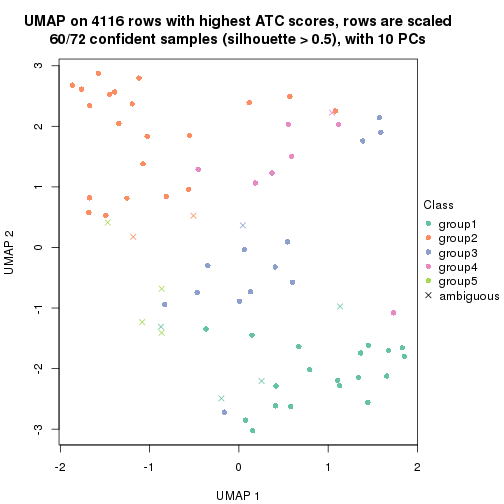
dimension_reduction(res, k = 6, method = "UMAP")
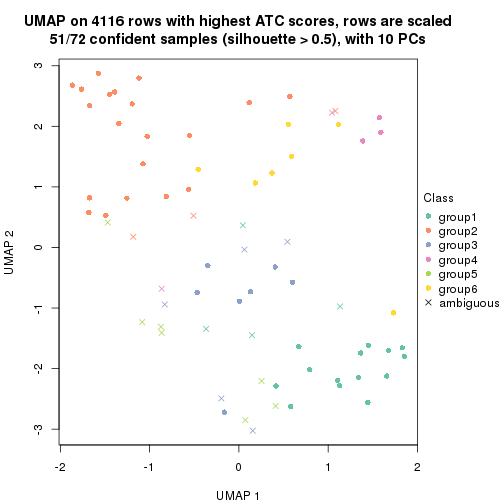
Following heatmap shows how subgroups are split when increasing k:
collect_classes(res)
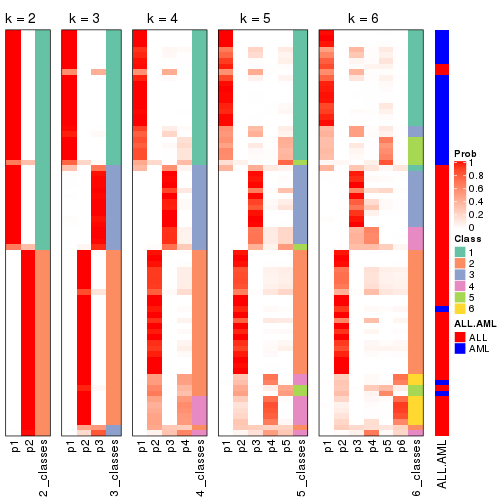
Test correlation between subgroups and known annotations. If the known annotation is numeric, one-way ANOVA test is applied, and if the known annotation is discrete, chi-squared contingency table test is applied.
test_to_known_factors(res)
#> n ALL.AML(p) k
#> ATC:skmeans 71 5.23e-05 2
#> ATC:skmeans 70 1.85e-12 3
#> ATC:skmeans 63 8.36e-12 4
#> ATC:skmeans 60 2.60e-10 5
#> ATC:skmeans 51 1.22e-07 6
If matrix rows can be associated to genes, consider to use functional_enrichment(res,
...) to perform function enrichment for the signature genes. See this vignette for more detailed explanations.
The object with results only for a single top-value method and a single partition method can be extracted as:
res = res_list["ATC", "pam"]
# you can also extract it by
# res = res_list["ATC:pam"]
A summary of res and all the functions that can be applied to it:
res
#> A 'ConsensusPartition' object with k = 2, 3, 4, 5, 6.
#> On a matrix with 4116 rows and 72 columns.
#> Top rows (412, 824, 1235, 1646, 2058) are extracted by 'ATC' method.
#> Subgroups are detected by 'pam' method.
#> Performed in total 1250 partitions by row resampling.
#> Best k for subgroups seems to be 2.
#>
#> Following methods can be applied to this 'ConsensusPartition' object:
#> [1] "cola_report" "collect_classes" "collect_plots"
#> [4] "collect_stats" "colnames" "compare_signatures"
#> [7] "consensus_heatmap" "dimension_reduction" "functional_enrichment"
#> [10] "get_anno_col" "get_anno" "get_classes"
#> [13] "get_consensus" "get_matrix" "get_membership"
#> [16] "get_param" "get_signatures" "get_stats"
#> [19] "is_best_k" "is_stable_k" "membership_heatmap"
#> [22] "ncol" "nrow" "plot_ecdf"
#> [25] "rownames" "select_partition_number" "show"
#> [28] "suggest_best_k" "test_to_known_factors"
collect_plots() function collects all the plots made from res for all k (number of partitions)
into one single page to provide an easy and fast comparison between different k.
collect_plots(res)
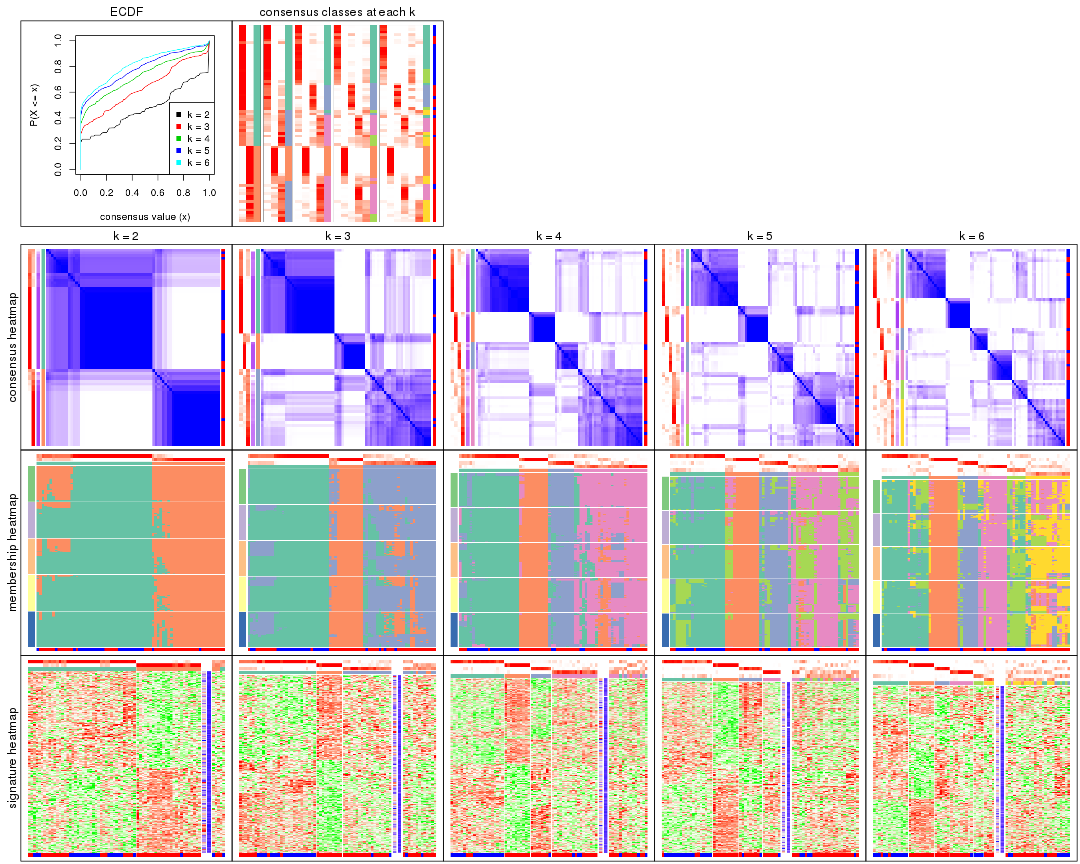
The plots are:
k and the heatmap of
predicted classes for each k.k.k.k.All the plots in panels can be made by individual functions and they are plotted later in this section.
select_partition_number() produces several plots showing different
statistics for choosing “optimized” k. There are following statistics:
k;k, the area increased is defined as \(A_k - A_{k-1}\).The detailed explanations of these statistics can be found in the cola vignette.
Generally speaking, lower PAC score, higher mean silhouette score or higher
concordance corresponds to better partition. Rand index and Jaccard index
measure how similar the current partition is compared to partition with k-1.
If they are too similar, we won't accept k is better than k-1.
select_partition_number(res)
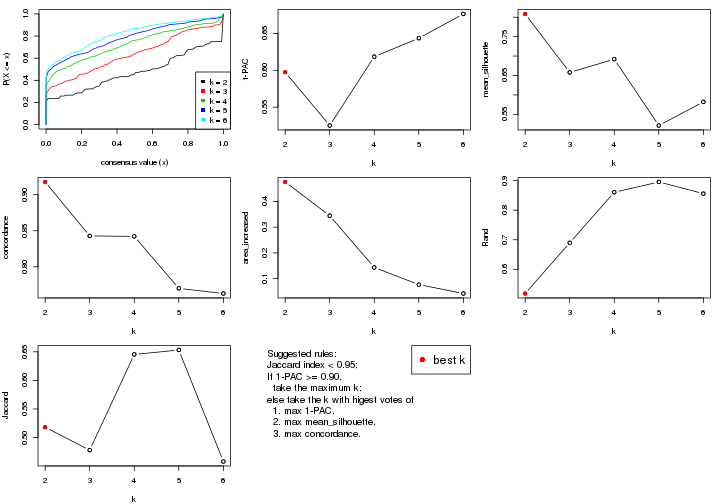
The numeric values for all these statistics can be obtained by get_stats().
get_stats(res)
#> k 1-PAC mean_silhouette concordance area_increased Rand Jaccard
#> 2 2 0.597 0.808 0.918 0.4755 0.518 0.518
#> 3 3 0.525 0.658 0.843 0.3445 0.690 0.478
#> 4 4 0.619 0.692 0.842 0.1433 0.861 0.645
#> 5 5 0.644 0.521 0.770 0.0768 0.896 0.653
#> 6 6 0.676 0.582 0.763 0.0422 0.856 0.458
suggest_best_k() suggests the best \(k\) based on these statistics. The rules are as follows:
suggest_best_k(res)
#> [1] 2
Following shows the table of the partitions (You need to click the show/hide
code output link to see it). The membership matrix (columns with name p*)
is inferred by
clue::cl_consensus()
function with the SE method. Basically the value in the membership matrix
represents the probability to belong to a certain group. The finall class
label for an item is determined with the group with highest probability it
belongs to.
In get_classes() function, the entropy is calculated from the membership
matrix and the silhouette score is calculated from the consensus matrix.
cbind(get_classes(res, k = 2), get_membership(res, k = 2))
#> class entropy silhouette p1 p2
#> sample_39 1 0.0000 0.8929 1.000 0.000
#> sample_40 1 0.0000 0.8929 1.000 0.000
#> sample_42 2 0.9491 0.3684 0.368 0.632
#> sample_47 2 0.0000 0.9141 0.000 1.000
#> sample_48 2 0.0000 0.9141 0.000 1.000
#> sample_49 1 0.0000 0.8929 1.000 0.000
#> sample_41 2 0.0000 0.9141 0.000 1.000
#> sample_43 2 0.0000 0.9141 0.000 1.000
#> sample_44 2 0.0000 0.9141 0.000 1.000
#> sample_45 2 0.0000 0.9141 0.000 1.000
#> sample_46 2 0.0000 0.9141 0.000 1.000
#> sample_70 1 0.8909 0.6109 0.692 0.308
#> sample_71 1 0.9170 0.5669 0.668 0.332
#> sample_72 2 0.3879 0.8601 0.076 0.924
#> sample_68 2 0.0000 0.9141 0.000 1.000
#> sample_69 2 0.0000 0.9141 0.000 1.000
#> sample_67 2 0.8327 0.6100 0.264 0.736
#> sample_55 1 0.7376 0.7403 0.792 0.208
#> sample_56 1 0.0376 0.8908 0.996 0.004
#> sample_59 2 0.7299 0.7095 0.204 0.796
#> sample_52 1 0.0376 0.8910 0.996 0.004
#> sample_53 1 0.0000 0.8929 1.000 0.000
#> sample_51 1 0.0000 0.8929 1.000 0.000
#> sample_50 1 0.0000 0.8929 1.000 0.000
#> sample_54 2 0.9977 -0.0261 0.472 0.528
#> sample_57 1 0.0000 0.8929 1.000 0.000
#> sample_58 1 0.0000 0.8929 1.000 0.000
#> sample_60 1 0.8555 0.6527 0.720 0.280
#> sample_61 1 0.0000 0.8929 1.000 0.000
#> sample_65 1 0.0000 0.8929 1.000 0.000
#> sample_66 2 0.0000 0.9141 0.000 1.000
#> sample_63 1 0.0000 0.8929 1.000 0.000
#> sample_64 1 0.0000 0.8929 1.000 0.000
#> sample_62 1 0.0000 0.8929 1.000 0.000
#> sample_1 1 0.8909 0.6109 0.692 0.308
#> sample_2 1 1.0000 0.0788 0.500 0.500
#> sample_3 1 0.7602 0.7278 0.780 0.220
#> sample_4 1 0.8909 0.6109 0.692 0.308
#> sample_5 2 0.0000 0.9141 0.000 1.000
#> sample_6 1 0.6438 0.7817 0.836 0.164
#> sample_7 1 0.0000 0.8929 1.000 0.000
#> sample_8 1 0.0000 0.8929 1.000 0.000
#> sample_9 2 0.3733 0.8624 0.072 0.928
#> sample_10 1 0.8813 0.6236 0.700 0.300
#> sample_11 2 0.6148 0.7802 0.152 0.848
#> sample_12 1 0.0000 0.8929 1.000 0.000
#> sample_13 2 0.0000 0.9141 0.000 1.000
#> sample_14 2 0.0000 0.9141 0.000 1.000
#> sample_15 2 0.0000 0.9141 0.000 1.000
#> sample_16 2 0.0000 0.9141 0.000 1.000
#> sample_17 2 0.0376 0.9118 0.004 0.996
#> sample_18 1 0.8861 0.6173 0.696 0.304
#> sample_19 2 0.0000 0.9141 0.000 1.000
#> sample_20 2 0.0000 0.9141 0.000 1.000
#> sample_21 2 0.0000 0.9141 0.000 1.000
#> sample_22 1 0.0000 0.8929 1.000 0.000
#> sample_23 1 0.4815 0.8285 0.896 0.104
#> sample_24 2 0.0000 0.9141 0.000 1.000
#> sample_25 1 0.7528 0.7317 0.784 0.216
#> sample_26 2 0.9358 0.4048 0.352 0.648
#> sample_27 1 0.0000 0.8929 1.000 0.000
#> sample_34 1 0.0000 0.8929 1.000 0.000
#> sample_35 1 0.0000 0.8929 1.000 0.000
#> sample_36 1 0.0000 0.8929 1.000 0.000
#> sample_37 1 0.0000 0.8929 1.000 0.000
#> sample_38 1 0.0000 0.8929 1.000 0.000
#> sample_28 1 0.0000 0.8929 1.000 0.000
#> sample_29 1 0.9754 0.3881 0.592 0.408
#> sample_30 1 0.0000 0.8929 1.000 0.000
#> sample_31 1 0.0000 0.8929 1.000 0.000
#> sample_32 1 0.0000 0.8929 1.000 0.000
#> sample_33 1 0.0000 0.8929 1.000 0.000
cbind(get_classes(res, k = 3), get_membership(res, k = 3))
#> class entropy silhouette p1 p2 p3
#> sample_39 1 0.5178 0.7208 0.744 0.000 0.256
#> sample_40 1 0.5650 0.6674 0.688 0.000 0.312
#> sample_42 3 0.7875 0.5796 0.176 0.156 0.668
#> sample_47 2 0.5926 0.3646 0.000 0.644 0.356
#> sample_48 2 0.0000 0.8430 0.000 1.000 0.000
#> sample_49 1 0.5560 0.6815 0.700 0.000 0.300
#> sample_41 2 0.0000 0.8430 0.000 1.000 0.000
#> sample_43 3 0.6008 0.3418 0.000 0.372 0.628
#> sample_44 3 0.6062 0.3327 0.000 0.384 0.616
#> sample_45 2 0.6308 -0.0714 0.000 0.508 0.492
#> sample_46 2 0.6295 0.0198 0.000 0.528 0.472
#> sample_70 3 0.0000 0.6692 0.000 0.000 1.000
#> sample_71 3 0.5016 0.6374 0.240 0.000 0.760
#> sample_72 3 0.5956 0.3783 0.004 0.324 0.672
#> sample_68 2 0.0000 0.8430 0.000 1.000 0.000
#> sample_69 2 0.0000 0.8430 0.000 1.000 0.000
#> sample_67 3 0.7216 0.6089 0.176 0.112 0.712
#> sample_55 3 0.6308 -0.1998 0.492 0.000 0.508
#> sample_56 1 0.5733 0.6522 0.676 0.000 0.324
#> sample_59 3 0.0983 0.6694 0.004 0.016 0.980
#> sample_52 1 0.0424 0.8711 0.992 0.000 0.008
#> sample_53 1 0.0000 0.8765 1.000 0.000 0.000
#> sample_51 1 0.0000 0.8765 1.000 0.000 0.000
#> sample_50 1 0.0000 0.8765 1.000 0.000 0.000
#> sample_54 3 0.5243 0.6672 0.100 0.072 0.828
#> sample_57 1 0.0000 0.8765 1.000 0.000 0.000
#> sample_58 1 0.0592 0.8722 0.988 0.000 0.012
#> sample_60 3 0.6045 0.4507 0.380 0.000 0.620
#> sample_61 1 0.0000 0.8765 1.000 0.000 0.000
#> sample_65 1 0.0000 0.8765 1.000 0.000 0.000
#> sample_66 3 0.6204 0.2561 0.000 0.424 0.576
#> sample_63 1 0.0237 0.8753 0.996 0.000 0.004
#> sample_64 1 0.4796 0.7461 0.780 0.000 0.220
#> sample_62 1 0.5016 0.7273 0.760 0.000 0.240
#> sample_1 3 0.0000 0.6692 0.000 0.000 1.000
#> sample_2 3 0.7233 0.5906 0.264 0.064 0.672
#> sample_3 3 0.4346 0.5944 0.184 0.000 0.816
#> sample_4 3 0.0000 0.6692 0.000 0.000 1.000
#> sample_5 2 0.0000 0.8430 0.000 1.000 0.000
#> sample_6 3 0.5138 0.5096 0.252 0.000 0.748
#> sample_7 1 0.5650 0.6674 0.688 0.000 0.312
#> sample_8 1 0.5560 0.6815 0.700 0.000 0.300
#> sample_9 3 0.1751 0.6744 0.012 0.028 0.960
#> sample_10 3 0.5882 0.5781 0.348 0.000 0.652
#> sample_11 3 0.6882 0.5977 0.096 0.172 0.732
#> sample_12 1 0.0000 0.8765 1.000 0.000 0.000
#> sample_13 2 0.0000 0.8430 0.000 1.000 0.000
#> sample_14 3 0.5465 0.4763 0.000 0.288 0.712
#> sample_15 2 0.0000 0.8430 0.000 1.000 0.000
#> sample_16 3 0.1860 0.6664 0.000 0.052 0.948
#> sample_17 3 0.3816 0.6261 0.000 0.148 0.852
#> sample_18 3 0.4178 0.6639 0.172 0.000 0.828
#> sample_19 3 0.6299 0.0495 0.000 0.476 0.524
#> sample_20 2 0.0000 0.8430 0.000 1.000 0.000
#> sample_21 2 0.0000 0.8430 0.000 1.000 0.000
#> sample_22 1 0.1964 0.8480 0.944 0.000 0.056
#> sample_23 3 0.5948 0.2387 0.360 0.000 0.640
#> sample_24 2 0.3267 0.7385 0.000 0.884 0.116
#> sample_25 1 0.6267 -0.0884 0.548 0.000 0.452
#> sample_26 3 0.1163 0.6700 0.000 0.028 0.972
#> sample_27 1 0.5560 0.6815 0.700 0.000 0.300
#> sample_34 1 0.0000 0.8765 1.000 0.000 0.000
#> sample_35 1 0.0892 0.8698 0.980 0.000 0.020
#> sample_36 1 0.0000 0.8765 1.000 0.000 0.000
#> sample_37 1 0.0000 0.8765 1.000 0.000 0.000
#> sample_38 1 0.0000 0.8765 1.000 0.000 0.000
#> sample_28 1 0.0000 0.8765 1.000 0.000 0.000
#> sample_29 3 0.7660 0.5579 0.324 0.064 0.612
#> sample_30 1 0.0000 0.8765 1.000 0.000 0.000
#> sample_31 1 0.0000 0.8765 1.000 0.000 0.000
#> sample_32 1 0.0000 0.8765 1.000 0.000 0.000
#> sample_33 1 0.0000 0.8765 1.000 0.000 0.000
cbind(get_classes(res, k = 4), get_membership(res, k = 4))
#> class entropy silhouette p1 p2 p3 p4
#> sample_39 3 0.1118 0.8490 0.036 0.000 0.964 0.000
#> sample_40 3 0.1474 0.8491 0.052 0.000 0.948 0.000
#> sample_42 4 0.4015 0.6916 0.116 0.052 0.000 0.832
#> sample_47 2 0.4679 0.3282 0.000 0.648 0.000 0.352
#> sample_48 2 0.0000 0.9390 0.000 1.000 0.000 0.000
#> sample_49 3 0.1211 0.8513 0.040 0.000 0.960 0.000
#> sample_41 2 0.0000 0.9390 0.000 1.000 0.000 0.000
#> sample_43 4 0.4072 0.5818 0.000 0.252 0.000 0.748
#> sample_44 4 0.3400 0.6515 0.000 0.180 0.000 0.820
#> sample_45 4 0.4933 0.3025 0.000 0.432 0.000 0.568
#> sample_46 4 0.4989 0.1728 0.000 0.472 0.000 0.528
#> sample_70 4 0.1474 0.7055 0.000 0.000 0.052 0.948
#> sample_71 1 0.7521 0.1381 0.488 0.000 0.220 0.292
#> sample_72 4 0.7761 0.3136 0.008 0.340 0.188 0.464
#> sample_68 2 0.0000 0.9390 0.000 1.000 0.000 0.000
#> sample_69 2 0.0000 0.9390 0.000 1.000 0.000 0.000
#> sample_67 4 0.1284 0.7120 0.024 0.012 0.000 0.964
#> sample_55 3 0.6423 0.3840 0.336 0.000 0.580 0.084
#> sample_56 3 0.0592 0.8407 0.016 0.000 0.984 0.000
#> sample_59 4 0.5268 0.5449 0.012 0.004 0.348 0.636
#> sample_52 1 0.1510 0.8737 0.956 0.000 0.016 0.028
#> sample_53 1 0.0336 0.8872 0.992 0.000 0.008 0.000
#> sample_51 1 0.0336 0.8872 0.992 0.000 0.008 0.000
#> sample_50 1 0.0188 0.8874 0.996 0.000 0.004 0.000
#> sample_54 4 0.0000 0.7089 0.000 0.000 0.000 1.000
#> sample_57 1 0.1256 0.8782 0.964 0.000 0.008 0.028
#> sample_58 3 0.5587 0.4137 0.372 0.000 0.600 0.028
#> sample_60 4 0.5791 0.5254 0.284 0.000 0.060 0.656
#> sample_61 1 0.3486 0.6893 0.812 0.000 0.188 0.000
#> sample_65 1 0.1151 0.8801 0.968 0.000 0.008 0.024
#> sample_66 4 0.3024 0.6593 0.000 0.148 0.000 0.852
#> sample_63 1 0.1256 0.8782 0.964 0.000 0.008 0.028
#> sample_64 3 0.4365 0.7220 0.188 0.000 0.784 0.028
#> sample_62 1 0.4410 0.7251 0.808 0.000 0.128 0.064
#> sample_1 4 0.4925 0.4477 0.000 0.000 0.428 0.572
#> sample_2 4 0.2530 0.6886 0.112 0.000 0.000 0.888
#> sample_3 4 0.6267 0.5686 0.148 0.000 0.188 0.664
#> sample_4 4 0.4925 0.4477 0.000 0.000 0.428 0.572
#> sample_5 2 0.0000 0.9390 0.000 1.000 0.000 0.000
#> sample_6 4 0.6813 0.4144 0.292 0.000 0.132 0.576
#> sample_7 3 0.0592 0.8407 0.016 0.000 0.984 0.000
#> sample_8 3 0.0921 0.8485 0.028 0.000 0.972 0.000
#> sample_9 4 0.0921 0.7078 0.000 0.000 0.028 0.972
#> sample_10 4 0.3266 0.6546 0.168 0.000 0.000 0.832
#> sample_11 4 0.1004 0.7078 0.004 0.024 0.000 0.972
#> sample_12 1 0.0707 0.8798 0.980 0.000 0.020 0.000
#> sample_13 2 0.0000 0.9390 0.000 1.000 0.000 0.000
#> sample_14 4 0.1118 0.7061 0.000 0.036 0.000 0.964
#> sample_15 2 0.0000 0.9390 0.000 1.000 0.000 0.000
#> sample_16 4 0.4888 0.6404 0.000 0.036 0.224 0.740
#> sample_17 4 0.1042 0.7088 0.000 0.020 0.008 0.972
#> sample_18 4 0.7717 0.3445 0.304 0.000 0.252 0.444
#> sample_19 4 0.4972 0.2259 0.000 0.456 0.000 0.544
#> sample_20 2 0.0000 0.9390 0.000 1.000 0.000 0.000
#> sample_21 2 0.0000 0.9390 0.000 1.000 0.000 0.000
#> sample_22 1 0.3837 0.6535 0.776 0.000 0.224 0.000
#> sample_23 4 0.7281 0.1179 0.412 0.000 0.148 0.440
#> sample_24 2 0.2589 0.8004 0.000 0.884 0.000 0.116
#> sample_25 1 0.5466 0.5823 0.712 0.000 0.220 0.068
#> sample_26 4 0.4103 0.6233 0.000 0.000 0.256 0.744
#> sample_27 3 0.1716 0.8444 0.064 0.000 0.936 0.000
#> sample_34 1 0.0336 0.8872 0.992 0.000 0.008 0.000
#> sample_35 1 0.4933 0.0984 0.568 0.000 0.432 0.000
#> sample_36 1 0.0188 0.8874 0.996 0.000 0.004 0.000
#> sample_37 1 0.0592 0.8812 0.984 0.000 0.016 0.000
#> sample_38 1 0.0188 0.8874 0.996 0.000 0.004 0.000
#> sample_28 1 0.0592 0.8812 0.984 0.000 0.016 0.000
#> sample_29 4 0.4916 0.3220 0.424 0.000 0.000 0.576
#> sample_30 1 0.1182 0.8789 0.968 0.000 0.016 0.016
#> sample_31 1 0.0188 0.8875 0.996 0.000 0.004 0.000
#> sample_32 1 0.0336 0.8872 0.992 0.000 0.008 0.000
#> sample_33 1 0.0336 0.8872 0.992 0.000 0.008 0.000
cbind(get_classes(res, k = 5), get_membership(res, k = 5))
#> class entropy silhouette p1 p2 p3 p4 p5
#> sample_39 3 0.0880 0.72718 0.000 0.000 0.968 0.000 0.032
#> sample_40 3 0.3734 0.67285 0.036 0.000 0.796 0.000 0.168
#> sample_42 4 0.6644 -0.06468 0.132 0.020 0.000 0.464 0.384
#> sample_47 2 0.6172 0.09988 0.000 0.500 0.000 0.144 0.356
#> sample_48 2 0.0000 0.81558 0.000 1.000 0.000 0.000 0.000
#> sample_49 3 0.0510 0.72742 0.000 0.000 0.984 0.000 0.016
#> sample_41 2 0.0000 0.81558 0.000 1.000 0.000 0.000 0.000
#> sample_43 4 0.6545 0.01906 0.000 0.180 0.004 0.468 0.348
#> sample_44 4 0.5785 0.17396 0.000 0.112 0.000 0.568 0.320
#> sample_45 4 0.6455 0.05457 0.000 0.352 0.000 0.460 0.188
#> sample_46 2 0.6751 -0.07919 0.000 0.408 0.000 0.296 0.296
#> sample_70 4 0.4283 0.22180 0.000 0.000 0.008 0.644 0.348
#> sample_71 5 0.5916 0.41533 0.268 0.000 0.056 0.048 0.628
#> sample_72 5 0.6313 0.36311 0.004 0.260 0.052 0.072 0.612
#> sample_68 2 0.0000 0.81558 0.000 1.000 0.000 0.000 0.000
#> sample_69 2 0.0000 0.81558 0.000 1.000 0.000 0.000 0.000
#> sample_67 4 0.4446 0.04571 0.004 0.000 0.000 0.520 0.476
#> sample_55 3 0.7420 -0.06603 0.256 0.000 0.364 0.032 0.348
#> sample_56 3 0.1732 0.70265 0.000 0.000 0.920 0.000 0.080
#> sample_59 5 0.6605 0.44213 0.004 0.016 0.156 0.276 0.548
#> sample_52 1 0.3932 0.63891 0.672 0.000 0.000 0.000 0.328
#> sample_53 1 0.0451 0.82978 0.988 0.000 0.008 0.000 0.004
#> sample_51 1 0.0510 0.82881 0.984 0.000 0.000 0.000 0.016
#> sample_50 1 0.0000 0.82815 1.000 0.000 0.000 0.000 0.000
#> sample_54 4 0.4210 0.19762 0.000 0.000 0.000 0.588 0.412
#> sample_57 1 0.5505 0.59669 0.588 0.000 0.084 0.000 0.328
#> sample_58 3 0.4026 0.59474 0.020 0.000 0.736 0.000 0.244
#> sample_60 5 0.4400 0.23804 0.052 0.000 0.000 0.212 0.736
#> sample_61 1 0.4905 0.44891 0.624 0.000 0.336 0.000 0.040
#> sample_65 1 0.5066 0.69001 0.676 0.000 0.084 0.000 0.240
#> sample_66 4 0.0880 0.54854 0.000 0.032 0.000 0.968 0.000
#> sample_63 1 0.4890 0.62256 0.628 0.000 0.040 0.000 0.332
#> sample_64 3 0.4491 0.54162 0.020 0.000 0.652 0.000 0.328
#> sample_62 1 0.5131 0.53594 0.540 0.000 0.040 0.000 0.420
#> sample_1 5 0.6667 0.39604 0.000 0.000 0.244 0.328 0.428
#> sample_2 4 0.0162 0.56108 0.004 0.000 0.000 0.996 0.000
#> sample_3 4 0.3308 0.41611 0.004 0.000 0.020 0.832 0.144
#> sample_4 5 0.6700 0.35821 0.000 0.000 0.244 0.356 0.400
#> sample_5 2 0.0000 0.81558 0.000 1.000 0.000 0.000 0.000
#> sample_6 4 0.4358 0.39223 0.100 0.000 0.012 0.788 0.100
#> sample_7 3 0.2732 0.64112 0.000 0.000 0.840 0.000 0.160
#> sample_8 3 0.1121 0.72440 0.000 0.000 0.956 0.000 0.044
#> sample_9 4 0.0000 0.56117 0.000 0.000 0.000 1.000 0.000
#> sample_10 4 0.0162 0.56108 0.004 0.000 0.000 0.996 0.000
#> sample_11 4 0.0000 0.56117 0.000 0.000 0.000 1.000 0.000
#> sample_12 1 0.0794 0.82890 0.972 0.000 0.000 0.000 0.028
#> sample_13 2 0.0000 0.81558 0.000 1.000 0.000 0.000 0.000
#> sample_14 4 0.0290 0.56073 0.000 0.008 0.000 0.992 0.000
#> sample_15 2 0.0000 0.81558 0.000 1.000 0.000 0.000 0.000
#> sample_16 4 0.6298 -0.16017 0.000 0.028 0.076 0.476 0.420
#> sample_17 4 0.0290 0.55949 0.000 0.000 0.000 0.992 0.008
#> sample_18 5 0.7896 0.30142 0.340 0.000 0.076 0.236 0.348
#> sample_19 2 0.6729 -0.17462 0.000 0.376 0.000 0.252 0.372
#> sample_20 2 0.0000 0.81558 0.000 1.000 0.000 0.000 0.000
#> sample_21 2 0.0000 0.81558 0.000 1.000 0.000 0.000 0.000
#> sample_22 1 0.3821 0.70811 0.800 0.000 0.052 0.000 0.148
#> sample_23 4 0.6229 0.15543 0.240 0.000 0.020 0.600 0.140
#> sample_24 2 0.2470 0.71773 0.000 0.884 0.000 0.104 0.012
#> sample_25 1 0.4628 0.52225 0.688 0.000 0.032 0.004 0.276
#> sample_26 5 0.5342 0.37233 0.000 0.000 0.076 0.312 0.612
#> sample_27 3 0.0000 0.72318 0.000 0.000 1.000 0.000 0.000
#> sample_34 1 0.2813 0.80025 0.876 0.000 0.084 0.000 0.040
#> sample_35 3 0.5173 -0.05379 0.460 0.000 0.500 0.000 0.040
#> sample_36 1 0.0290 0.82898 0.992 0.000 0.000 0.000 0.008
#> sample_37 1 0.0162 0.82734 0.996 0.000 0.000 0.000 0.004
#> sample_38 1 0.0000 0.82815 1.000 0.000 0.000 0.000 0.000
#> sample_28 1 0.0290 0.82849 0.992 0.000 0.000 0.000 0.008
#> sample_29 4 0.5042 0.00192 0.460 0.000 0.000 0.508 0.032
#> sample_30 1 0.2329 0.78694 0.876 0.000 0.000 0.000 0.124
#> sample_31 1 0.2770 0.80366 0.880 0.000 0.076 0.000 0.044
#> sample_32 1 0.2228 0.81442 0.912 0.000 0.048 0.000 0.040
#> sample_33 1 0.0404 0.82890 0.988 0.000 0.000 0.000 0.012
cbind(get_classes(res, k = 6), get_membership(res, k = 6))
#> class entropy silhouette p1 p2 p3 p4 p5 p6
#> sample_39 3 0.0260 0.8238 0.000 0.000 0.992 0.000 0.008 0.000
#> sample_40 3 0.5042 0.2355 0.016 0.000 0.484 0.000 0.460 0.040
#> sample_42 6 0.6163 0.4178 0.088 0.012 0.000 0.344 0.040 0.516
#> sample_47 2 0.5595 -0.2086 0.000 0.468 0.000 0.124 0.004 0.404
#> sample_48 2 0.0000 0.9194 0.000 1.000 0.000 0.000 0.000 0.000
#> sample_49 3 0.0458 0.8214 0.000 0.000 0.984 0.000 0.016 0.000
#> sample_41 2 0.0000 0.9194 0.000 1.000 0.000 0.000 0.000 0.000
#> sample_43 6 0.5165 0.5073 0.000 0.108 0.000 0.244 0.012 0.636
#> sample_44 6 0.4799 0.4737 0.000 0.048 0.000 0.320 0.012 0.620
#> sample_45 6 0.6148 0.3731 0.000 0.212 0.000 0.312 0.012 0.464
#> sample_46 6 0.5969 0.4486 0.000 0.228 0.000 0.236 0.012 0.524
#> sample_70 6 0.3940 0.4565 0.000 0.000 0.000 0.348 0.012 0.640
#> sample_71 6 0.5663 0.4910 0.096 0.000 0.048 0.024 0.156 0.676
#> sample_72 6 0.6256 0.5166 0.000 0.132 0.040 0.044 0.160 0.624
#> sample_68 2 0.0000 0.9194 0.000 1.000 0.000 0.000 0.000 0.000
#> sample_69 2 0.0000 0.9194 0.000 1.000 0.000 0.000 0.000 0.000
#> sample_67 6 0.5601 0.3639 0.004 0.000 0.000 0.348 0.136 0.512
#> sample_55 6 0.7742 0.0180 0.204 0.000 0.332 0.028 0.100 0.336
#> sample_56 3 0.0000 0.8217 0.000 0.000 1.000 0.000 0.000 0.000
#> sample_59 6 0.3108 0.5382 0.004 0.004 0.008 0.136 0.012 0.836
#> sample_52 5 0.4057 0.5502 0.388 0.000 0.000 0.000 0.600 0.012
#> sample_53 1 0.0790 0.7234 0.968 0.000 0.000 0.000 0.032 0.000
#> sample_51 1 0.1501 0.7097 0.924 0.000 0.000 0.000 0.076 0.000
#> sample_50 1 0.0000 0.7202 1.000 0.000 0.000 0.000 0.000 0.000
#> sample_54 4 0.5160 0.2276 0.000 0.000 0.000 0.564 0.332 0.104
#> sample_57 5 0.3373 0.6202 0.248 0.000 0.000 0.000 0.744 0.008
#> sample_58 3 0.4045 0.3046 0.008 0.000 0.564 0.000 0.428 0.000
#> sample_60 5 0.6307 0.1398 0.032 0.000 0.020 0.204 0.576 0.168
#> sample_61 1 0.5366 0.4135 0.568 0.000 0.148 0.000 0.284 0.000
#> sample_65 5 0.3797 0.1146 0.420 0.000 0.000 0.000 0.580 0.000
#> sample_66 4 0.0547 0.7980 0.000 0.020 0.000 0.980 0.000 0.000
#> sample_63 5 0.3482 0.6220 0.316 0.000 0.000 0.000 0.684 0.000
#> sample_64 5 0.3564 0.2365 0.012 0.000 0.264 0.000 0.724 0.000
#> sample_62 5 0.4091 0.6424 0.224 0.000 0.000 0.000 0.720 0.056
#> sample_1 6 0.6755 0.3692 0.000 0.000 0.240 0.268 0.052 0.440
#> sample_2 4 0.0260 0.8054 0.000 0.000 0.000 0.992 0.000 0.008
#> sample_3 4 0.3291 0.6653 0.000 0.000 0.040 0.840 0.024 0.096
#> sample_4 6 0.6538 0.3062 0.000 0.000 0.240 0.316 0.028 0.416
#> sample_5 2 0.0000 0.9194 0.000 1.000 0.000 0.000 0.000 0.000
#> sample_6 4 0.4227 0.6365 0.076 0.000 0.012 0.796 0.044 0.072
#> sample_7 3 0.2618 0.7157 0.000 0.000 0.860 0.000 0.024 0.116
#> sample_8 3 0.0146 0.8235 0.000 0.000 0.996 0.000 0.004 0.000
#> sample_9 4 0.0000 0.8074 0.000 0.000 0.000 1.000 0.000 0.000
#> sample_10 4 0.0000 0.8074 0.000 0.000 0.000 1.000 0.000 0.000
#> sample_11 4 0.0146 0.8059 0.000 0.000 0.000 0.996 0.000 0.004
#> sample_12 1 0.2266 0.6778 0.880 0.000 0.000 0.000 0.108 0.012
#> sample_13 2 0.0000 0.9194 0.000 1.000 0.000 0.000 0.000 0.000
#> sample_14 4 0.0291 0.8060 0.000 0.004 0.000 0.992 0.000 0.004
#> sample_15 2 0.0000 0.9194 0.000 1.000 0.000 0.000 0.000 0.000
#> sample_16 6 0.5953 0.3749 0.000 0.008 0.056 0.436 0.048 0.452
#> sample_17 4 0.1152 0.7693 0.000 0.000 0.000 0.952 0.004 0.044
#> sample_18 6 0.7708 0.2937 0.316 0.000 0.060 0.208 0.052 0.364
#> sample_19 6 0.6497 0.4592 0.000 0.288 0.000 0.244 0.028 0.440
#> sample_20 2 0.0000 0.9194 0.000 1.000 0.000 0.000 0.000 0.000
#> sample_21 2 0.0000 0.9194 0.000 1.000 0.000 0.000 0.000 0.000
#> sample_22 1 0.4774 0.5910 0.736 0.000 0.060 0.000 0.124 0.080
#> sample_23 4 0.6154 0.3924 0.212 0.000 0.032 0.616 0.048 0.092
#> sample_24 2 0.2218 0.7812 0.000 0.884 0.000 0.104 0.000 0.012
#> sample_25 1 0.5367 0.4620 0.656 0.000 0.052 0.012 0.044 0.236
#> sample_26 6 0.4617 0.5388 0.000 0.000 0.060 0.088 0.100 0.752
#> sample_27 3 0.0790 0.8111 0.000 0.000 0.968 0.000 0.032 0.000
#> sample_34 1 0.3547 0.5393 0.668 0.000 0.000 0.000 0.332 0.000
#> sample_35 1 0.6069 0.1117 0.404 0.000 0.288 0.000 0.308 0.000
#> sample_36 1 0.0260 0.7183 0.992 0.000 0.000 0.000 0.008 0.000
#> sample_37 1 0.0000 0.7202 1.000 0.000 0.000 0.000 0.000 0.000
#> sample_38 1 0.0146 0.7217 0.996 0.000 0.000 0.000 0.004 0.000
#> sample_28 1 0.0909 0.7186 0.968 0.000 0.000 0.000 0.020 0.012
#> sample_29 1 0.4651 0.0144 0.484 0.000 0.000 0.476 0.000 0.040
#> sample_30 1 0.2572 0.5652 0.852 0.000 0.000 0.000 0.136 0.012
#> sample_31 1 0.3547 0.5680 0.696 0.000 0.000 0.000 0.300 0.004
#> sample_32 1 0.3151 0.6098 0.748 0.000 0.000 0.000 0.252 0.000
#> sample_33 1 0.0937 0.7201 0.960 0.000 0.000 0.000 0.040 0.000
Heatmaps for the consensus matrix. It visualizes the probability of two samples to be in a same group.
consensus_heatmap(res, k = 2)
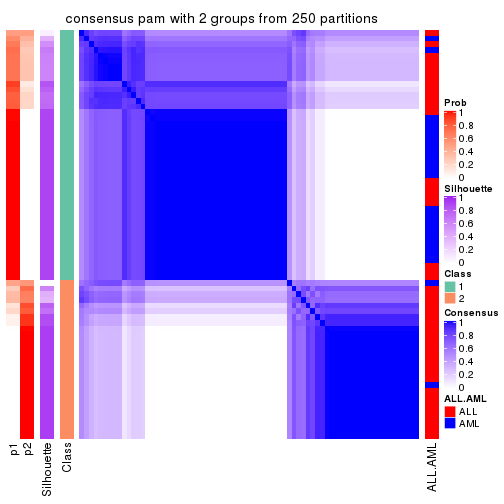
consensus_heatmap(res, k = 3)
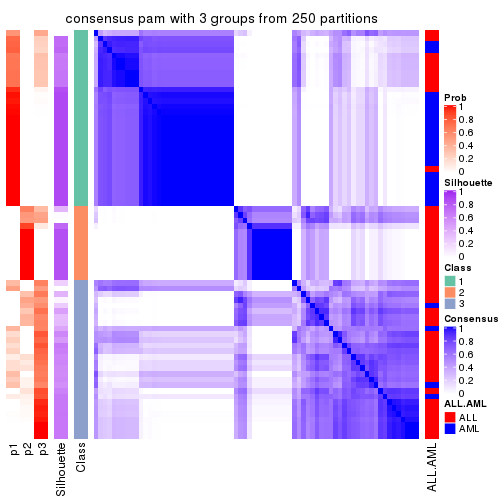
consensus_heatmap(res, k = 4)
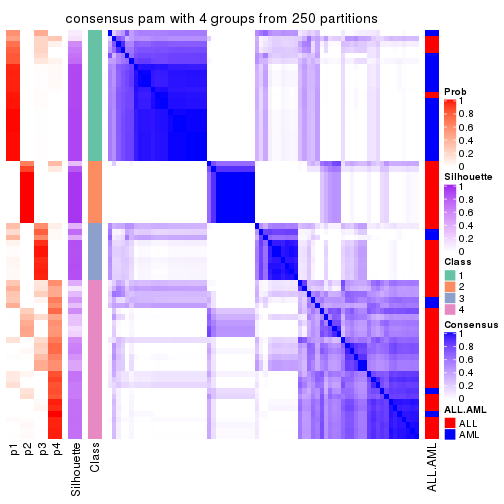
consensus_heatmap(res, k = 5)
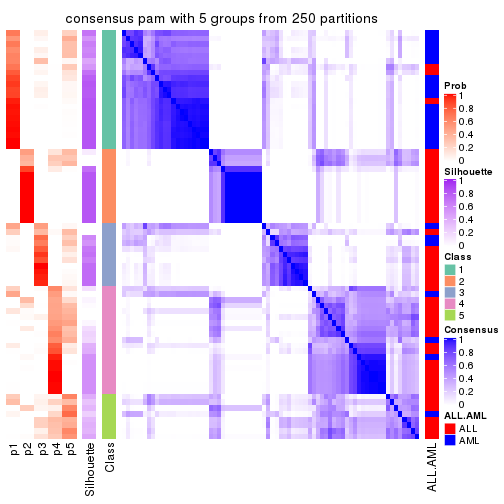
consensus_heatmap(res, k = 6)
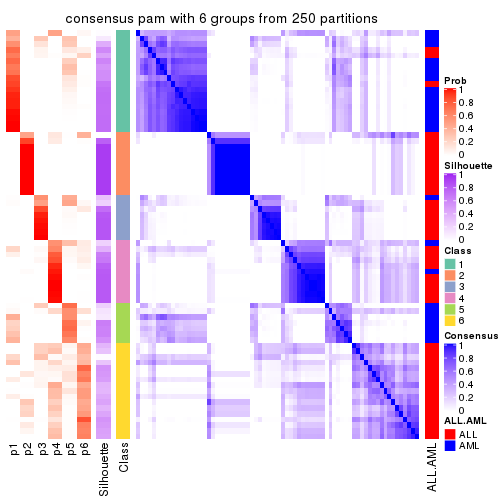
Heatmaps for the membership of samples in all partitions to see how consistent they are:
membership_heatmap(res, k = 2)
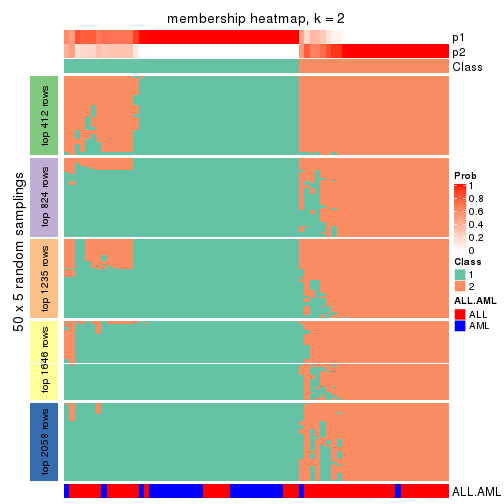
membership_heatmap(res, k = 3)
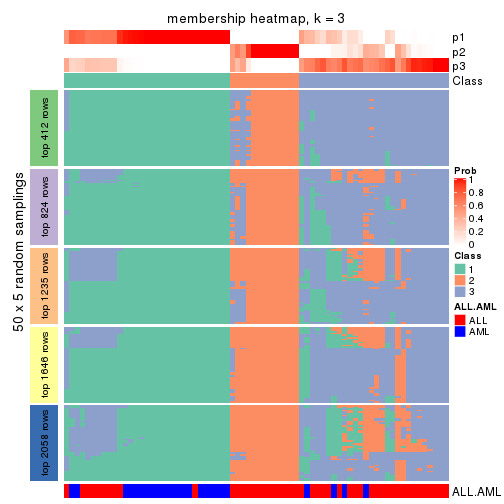
membership_heatmap(res, k = 4)
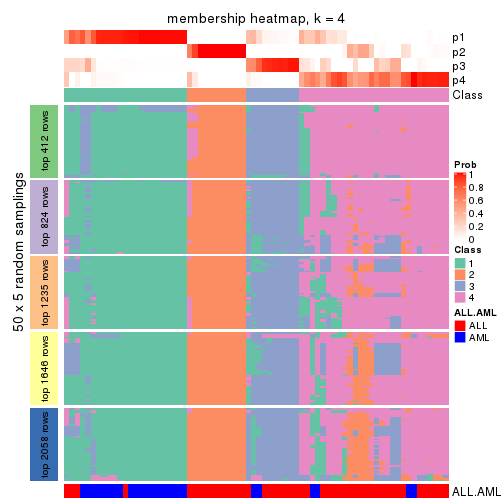
membership_heatmap(res, k = 5)
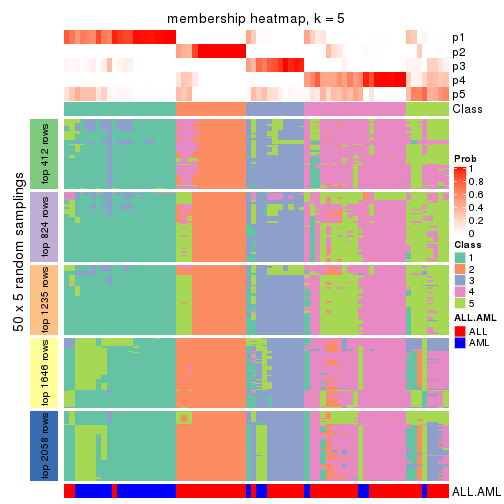
membership_heatmap(res, k = 6)
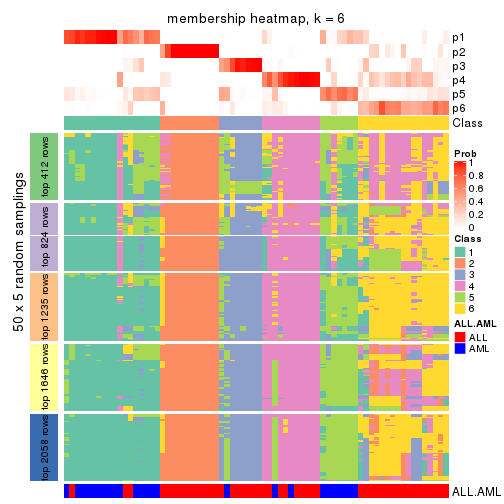
As soon as we have had the classes for columns, we can look for signatures which are significantly different between classes which can be candidate marks for certain classes. Following are the heatmaps for signatures.
Signature heatmaps where rows are scaled:
get_signatures(res, k = 2)
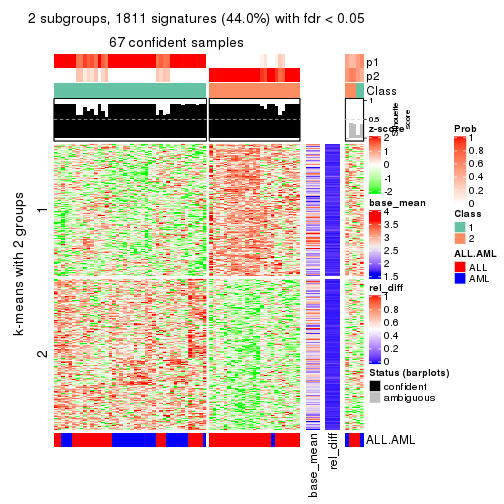
get_signatures(res, k = 3)
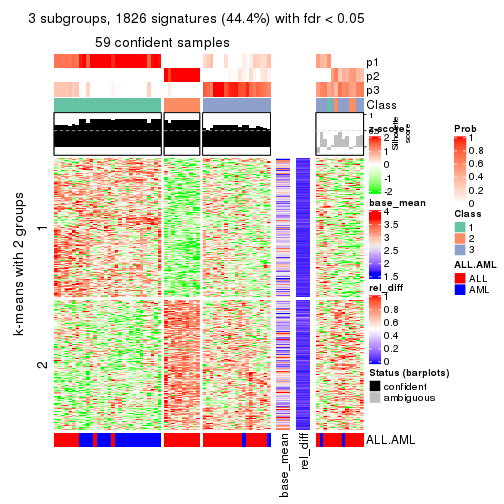
get_signatures(res, k = 4)
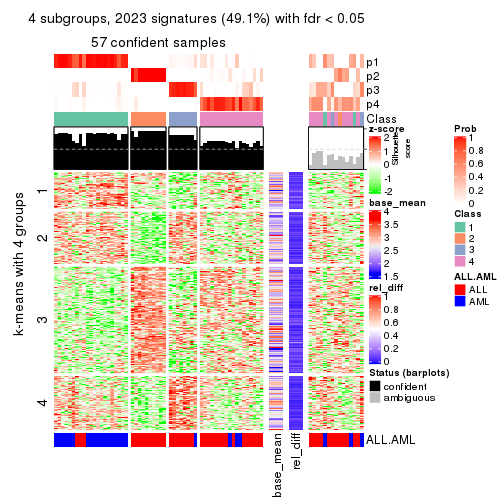
get_signatures(res, k = 5)
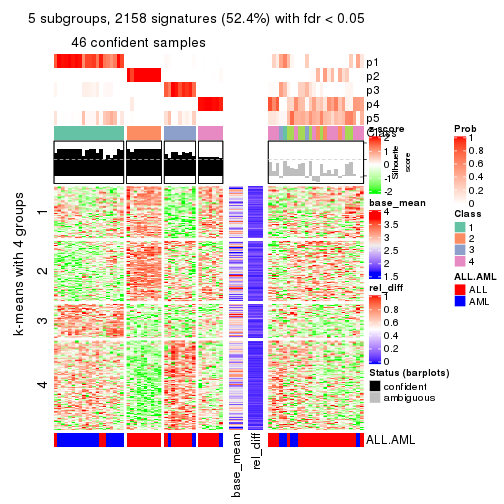
get_signatures(res, k = 6)
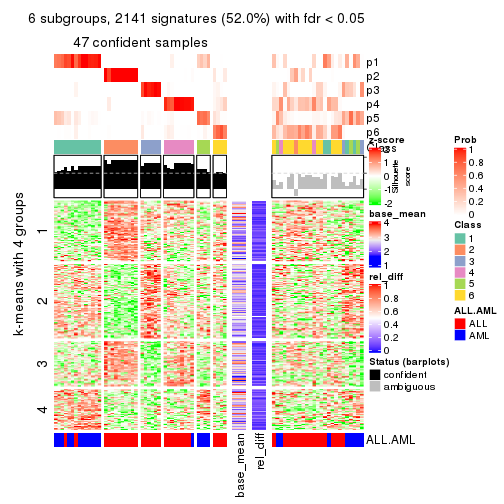
Signature heatmaps where rows are not scaled:
get_signatures(res, k = 2, scale_rows = FALSE)
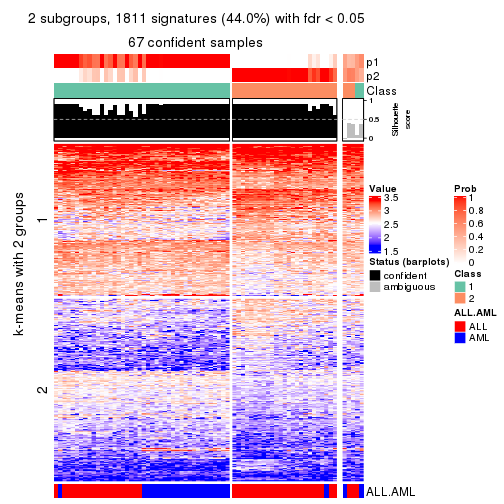
get_signatures(res, k = 3, scale_rows = FALSE)
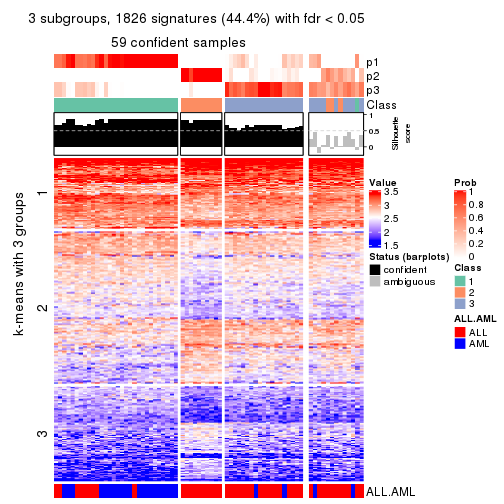
get_signatures(res, k = 4, scale_rows = FALSE)
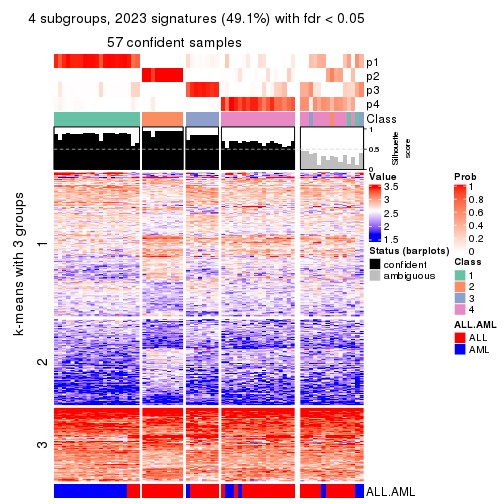
get_signatures(res, k = 5, scale_rows = FALSE)
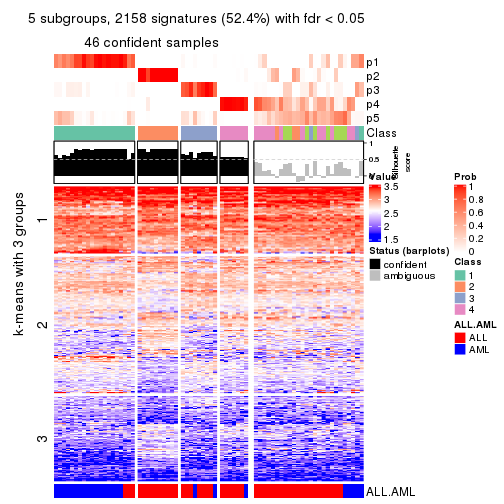
get_signatures(res, k = 6, scale_rows = FALSE)
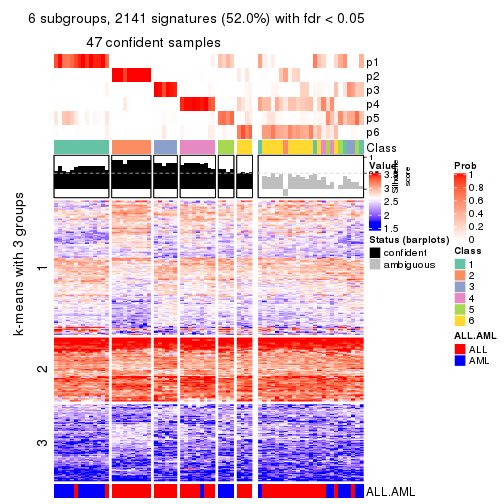
Compare the overlap of signatures from different k:
compare_signatures(res)
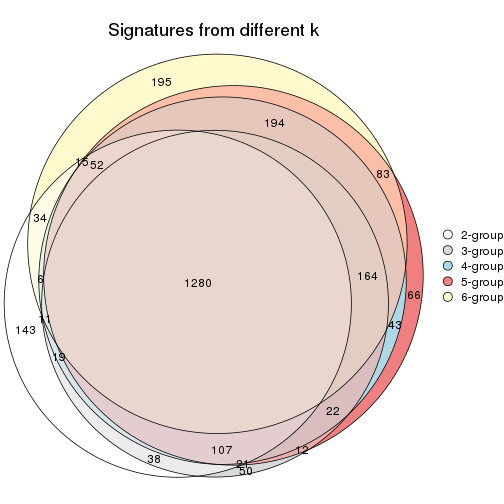
get_signature() returns a data frame invisibly. TO get the list of signatures, the function
call should be assigned to a variable explicitly. In following code, if plot argument is set
to FALSE, no heatmap is plotted while only the differential analysis is performed.
# code only for demonstration
tb = get_signature(res, k = ..., plot = FALSE)
An example of the output of tb is:
#> which_row fdr mean_1 mean_2 scaled_mean_1 scaled_mean_2 km
#> 1 38 0.042760348 8.373488 9.131774 -0.5533452 0.5164555 1
#> 2 40 0.018707592 7.106213 8.469186 -0.6173731 0.5762149 1
#> 3 55 0.019134737 10.221463 11.207825 -0.6159697 0.5749050 1
#> 4 59 0.006059896 5.921854 7.869574 -0.6899429 0.6439467 1
#> 5 60 0.018055526 8.928898 10.211722 -0.6204761 0.5791110 1
#> 6 98 0.009384629 15.714769 14.887706 0.6635654 -0.6193277 2
...
The columns in tb are:
which_row: row indices corresponding to the input matrix.fdr: FDR for the differential test. mean_x: The mean value in group x.scaled_mean_x: The mean value in group x after rows are scaled.km: Row groups if k-means clustering is applied to rows.UMAP plot which shows how samples are separated.
dimension_reduction(res, k = 2, method = "UMAP")
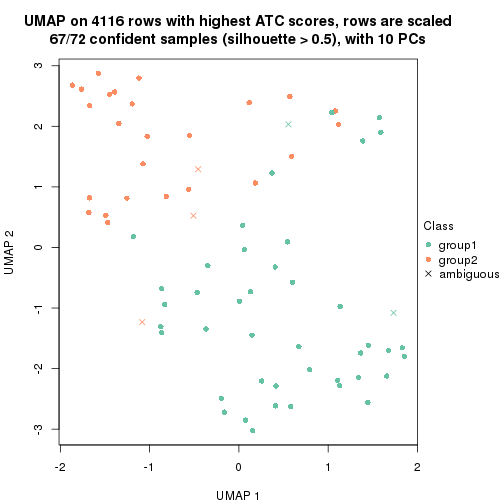
dimension_reduction(res, k = 3, method = "UMAP")
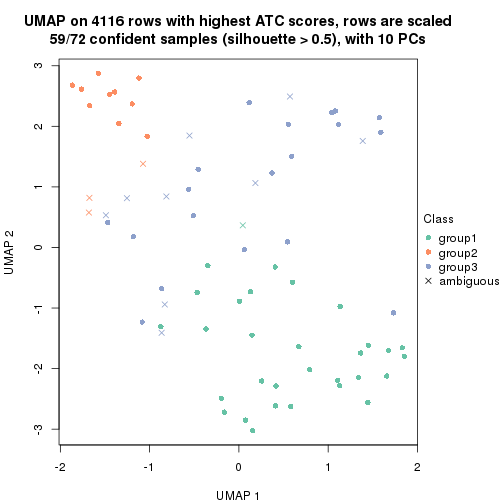
dimension_reduction(res, k = 4, method = "UMAP")
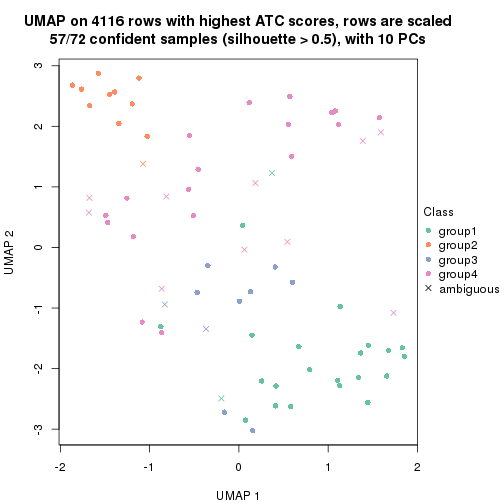
dimension_reduction(res, k = 5, method = "UMAP")
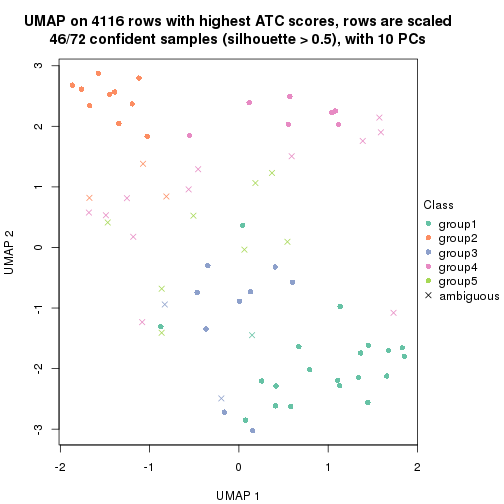
dimension_reduction(res, k = 6, method = "UMAP")
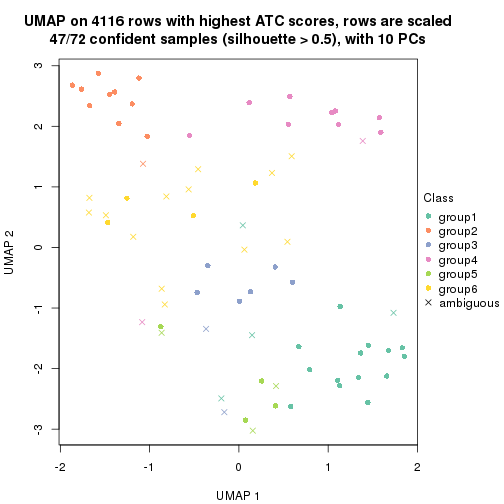
Following heatmap shows how subgroups are split when increasing k:
collect_classes(res)
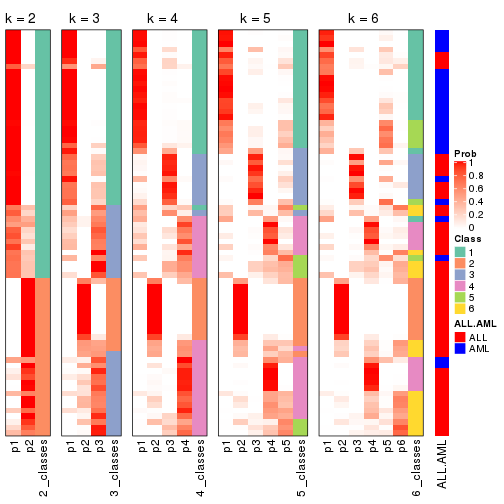
Test correlation between subgroups and known annotations. If the known annotation is numeric, one-way ANOVA test is applied, and if the known annotation is discrete, chi-squared contingency table test is applied.
test_to_known_factors(res)
#> n ALL.AML(p) k
#> ATC:pam 67 1.65e-04 2
#> ATC:pam 59 3.74e-06 3
#> ATC:pam 57 5.47e-07 4
#> ATC:pam 46 1.05e-05 5
#> ATC:pam 47 1.08e-06 6
If matrix rows can be associated to genes, consider to use functional_enrichment(res,
...) to perform function enrichment for the signature genes. See this vignette for more detailed explanations.
The object with results only for a single top-value method and a single partition method can be extracted as:
res = res_list["ATC", "mclust"]
# you can also extract it by
# res = res_list["ATC:mclust"]
A summary of res and all the functions that can be applied to it:
res
#> A 'ConsensusPartition' object with k = 2, 3, 4, 5, 6.
#> On a matrix with 4116 rows and 72 columns.
#> Top rows (412, 824, 1235, 1646, 2058) are extracted by 'ATC' method.
#> Subgroups are detected by 'mclust' method.
#> Performed in total 1250 partitions by row resampling.
#> Best k for subgroups seems to be 2.
#>
#> Following methods can be applied to this 'ConsensusPartition' object:
#> [1] "cola_report" "collect_classes" "collect_plots"
#> [4] "collect_stats" "colnames" "compare_signatures"
#> [7] "consensus_heatmap" "dimension_reduction" "functional_enrichment"
#> [10] "get_anno_col" "get_anno" "get_classes"
#> [13] "get_consensus" "get_matrix" "get_membership"
#> [16] "get_param" "get_signatures" "get_stats"
#> [19] "is_best_k" "is_stable_k" "membership_heatmap"
#> [22] "ncol" "nrow" "plot_ecdf"
#> [25] "rownames" "select_partition_number" "show"
#> [28] "suggest_best_k" "test_to_known_factors"
collect_plots() function collects all the plots made from res for all k (number of partitions)
into one single page to provide an easy and fast comparison between different k.
collect_plots(res)
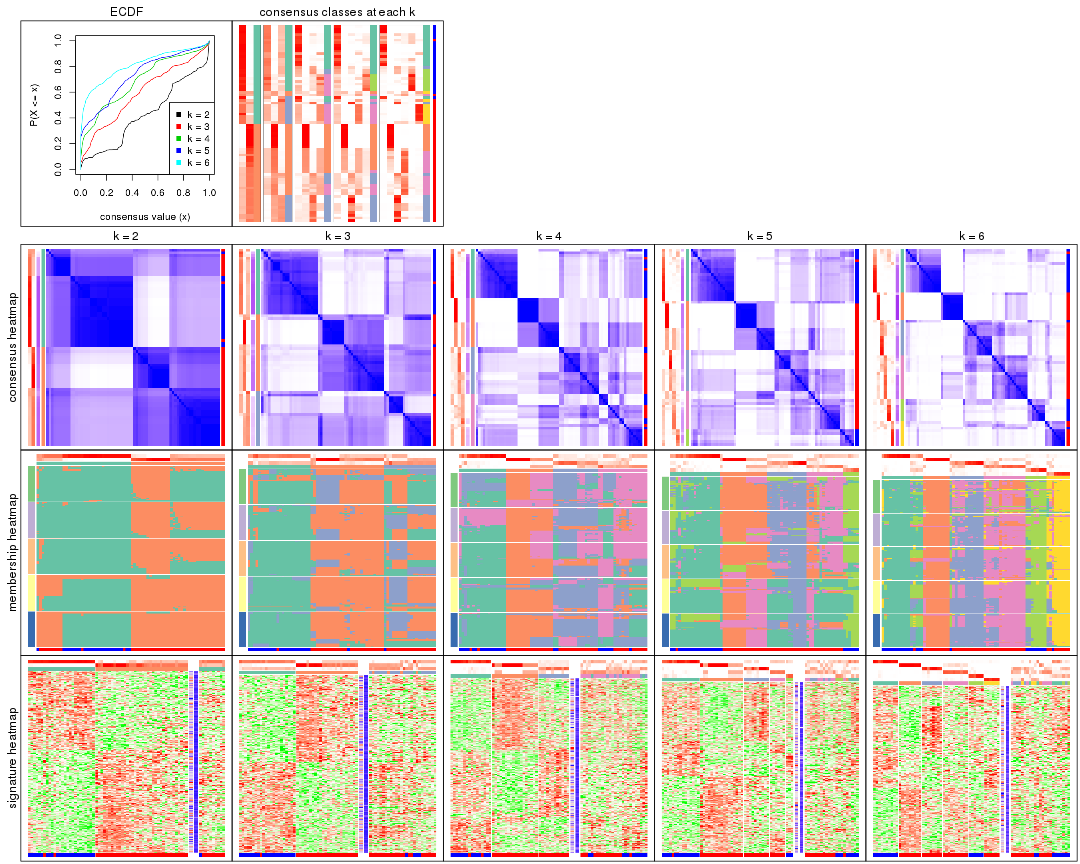
The plots are:
k and the heatmap of
predicted classes for each k.k.k.k.All the plots in panels can be made by individual functions and they are plotted later in this section.
select_partition_number() produces several plots showing different
statistics for choosing “optimized” k. There are following statistics:
k;k, the area increased is defined as \(A_k - A_{k-1}\).The detailed explanations of these statistics can be found in the cola vignette.
Generally speaking, lower PAC score, higher mean silhouette score or higher
concordance corresponds to better partition. Rand index and Jaccard index
measure how similar the current partition is compared to partition with k-1.
If they are too similar, we won't accept k is better than k-1.
select_partition_number(res)
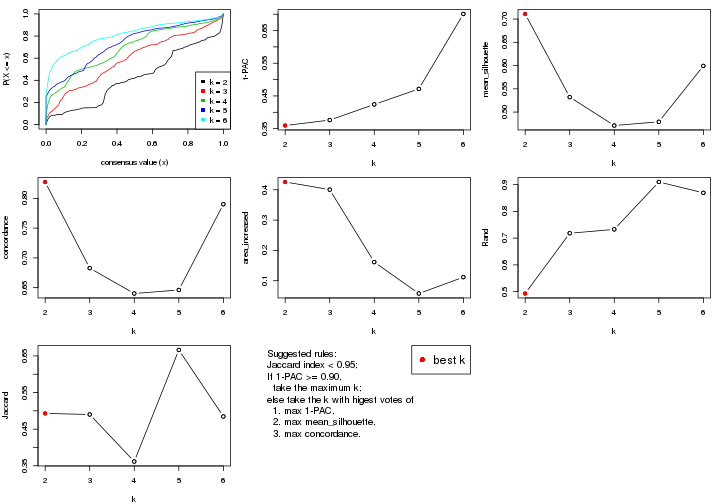
The numeric values for all these statistics can be obtained by get_stats().
get_stats(res)
#> k 1-PAC mean_silhouette concordance area_increased Rand Jaccard
#> 2 2 0.360 0.711 0.828 0.4257 0.493 0.493
#> 3 3 0.376 0.532 0.683 0.4004 0.718 0.490
#> 4 4 0.424 0.471 0.640 0.1614 0.733 0.362
#> 5 5 0.471 0.479 0.646 0.0578 0.910 0.666
#> 6 6 0.701 0.599 0.790 0.1118 0.869 0.485
suggest_best_k() suggests the best \(k\) based on these statistics. The rules are as follows:
suggest_best_k(res)
#> [1] 2
Following shows the table of the partitions (You need to click the show/hide
code output link to see it). The membership matrix (columns with name p*)
is inferred by
clue::cl_consensus()
function with the SE method. Basically the value in the membership matrix
represents the probability to belong to a certain group. The finall class
label for an item is determined with the group with highest probability it
belongs to.
In get_classes() function, the entropy is calculated from the membership
matrix and the silhouette score is calculated from the consensus matrix.
cbind(get_classes(res, k = 2), get_membership(res, k = 2))
#> class entropy silhouette p1 p2
#> sample_39 1 1.0000 -0.361 0.504 0.496
#> sample_40 2 0.9209 0.748 0.336 0.664
#> sample_42 1 0.8713 0.475 0.708 0.292
#> sample_47 2 0.5408 0.745 0.124 0.876
#> sample_48 2 0.0000 0.692 0.000 1.000
#> sample_49 2 0.9044 0.766 0.320 0.680
#> sample_41 2 0.0672 0.697 0.008 0.992
#> sample_43 2 0.9460 0.697 0.364 0.636
#> sample_44 2 0.4431 0.736 0.092 0.908
#> sample_45 2 0.4431 0.736 0.092 0.908
#> sample_46 2 0.7056 0.759 0.192 0.808
#> sample_70 2 0.9044 0.765 0.320 0.680
#> sample_71 1 0.8713 0.475 0.708 0.292
#> sample_72 1 0.8713 0.475 0.708 0.292
#> sample_68 2 0.0000 0.692 0.000 1.000
#> sample_69 2 0.0000 0.692 0.000 1.000
#> sample_67 1 0.1633 0.844 0.976 0.024
#> sample_55 2 0.9209 0.749 0.336 0.664
#> sample_56 2 0.9044 0.766 0.320 0.680
#> sample_59 2 0.9795 0.596 0.416 0.584
#> sample_52 1 0.0938 0.851 0.988 0.012
#> sample_53 1 0.0376 0.850 0.996 0.004
#> sample_51 1 0.0376 0.850 0.996 0.004
#> sample_50 1 0.0000 0.846 1.000 0.000
#> sample_54 1 0.2948 0.822 0.948 0.052
#> sample_57 1 0.1633 0.845 0.976 0.024
#> sample_58 1 0.1184 0.849 0.984 0.016
#> sample_60 1 0.2948 0.822 0.948 0.052
#> sample_61 1 0.0672 0.852 0.992 0.008
#> sample_65 1 0.0672 0.852 0.992 0.008
#> sample_66 1 0.9963 0.108 0.536 0.464
#> sample_63 1 0.1414 0.847 0.980 0.020
#> sample_64 1 0.1414 0.847 0.980 0.020
#> sample_62 1 0.1414 0.847 0.980 0.020
#> sample_1 2 0.9044 0.766 0.320 0.680
#> sample_2 1 0.8713 0.475 0.708 0.292
#> sample_3 2 0.9358 0.728 0.352 0.648
#> sample_4 2 0.9044 0.766 0.320 0.680
#> sample_5 2 0.0000 0.692 0.000 1.000
#> sample_6 2 0.9129 0.760 0.328 0.672
#> sample_7 2 0.9044 0.766 0.320 0.680
#> sample_8 2 0.9933 0.500 0.452 0.548
#> sample_9 2 0.9129 0.760 0.328 0.672
#> sample_10 1 0.9608 0.157 0.616 0.384
#> sample_11 1 0.8813 0.455 0.700 0.300
#> sample_12 1 0.0672 0.852 0.992 0.008
#> sample_13 2 0.0000 0.692 0.000 1.000
#> sample_14 2 0.6438 0.754 0.164 0.836
#> sample_15 2 0.0000 0.692 0.000 1.000
#> sample_16 2 0.9044 0.766 0.320 0.680
#> sample_17 2 0.8955 0.768 0.312 0.688
#> sample_18 2 0.9087 0.763 0.324 0.676
#> sample_19 2 0.8955 0.768 0.312 0.688
#> sample_20 2 0.0000 0.692 0.000 1.000
#> sample_21 2 0.1184 0.701 0.016 0.984
#> sample_22 1 0.8713 0.475 0.708 0.292
#> sample_23 2 0.9922 0.520 0.448 0.552
#> sample_24 2 0.4690 0.738 0.100 0.900
#> sample_25 1 0.8713 0.475 0.708 0.292
#> sample_26 2 0.9044 0.766 0.320 0.680
#> sample_27 2 0.9044 0.766 0.320 0.680
#> sample_34 1 0.0672 0.852 0.992 0.008
#> sample_35 1 0.0672 0.852 0.992 0.008
#> sample_36 1 0.0000 0.846 1.000 0.000
#> sample_37 1 0.0000 0.846 1.000 0.000
#> sample_38 1 0.0376 0.850 0.996 0.004
#> sample_28 1 0.0672 0.852 0.992 0.008
#> sample_29 1 0.0672 0.852 0.992 0.008
#> sample_30 1 0.0376 0.850 0.996 0.004
#> sample_31 1 0.0672 0.852 0.992 0.008
#> sample_32 1 0.0672 0.852 0.992 0.008
#> sample_33 1 0.0672 0.852 0.992 0.008
cbind(get_classes(res, k = 3), get_membership(res, k = 3))
#> class entropy silhouette p1 p2 p3
#> sample_39 3 0.7029 0.303 0.020 0.440 0.540
#> sample_40 3 0.6819 0.252 0.012 0.476 0.512
#> sample_42 3 0.8338 0.249 0.400 0.084 0.516
#> sample_47 2 0.6522 0.705 0.272 0.696 0.032
#> sample_48 2 0.0237 0.615 0.000 0.996 0.004
#> sample_49 3 0.6489 0.284 0.004 0.456 0.540
#> sample_41 2 0.0000 0.613 0.000 1.000 0.000
#> sample_43 2 0.6556 0.704 0.276 0.692 0.032
#> sample_44 2 0.6161 0.704 0.272 0.708 0.020
#> sample_45 2 0.6522 0.705 0.272 0.696 0.032
#> sample_46 2 0.6522 0.705 0.272 0.696 0.032
#> sample_70 2 0.7587 0.651 0.288 0.640 0.072
#> sample_71 3 0.7940 0.266 0.416 0.060 0.524
#> sample_72 3 0.8140 0.258 0.404 0.072 0.524
#> sample_68 2 0.0000 0.613 0.000 1.000 0.000
#> sample_69 2 0.0237 0.610 0.000 0.996 0.004
#> sample_67 3 0.7940 0.266 0.416 0.060 0.524
#> sample_55 2 0.6955 -0.272 0.016 0.496 0.488
#> sample_56 3 0.6489 0.284 0.004 0.456 0.540
#> sample_59 2 0.7872 0.632 0.296 0.620 0.084
#> sample_52 1 0.7512 0.790 0.656 0.076 0.268
#> sample_53 1 0.5760 0.834 0.672 0.000 0.328
#> sample_51 1 0.5760 0.834 0.672 0.000 0.328
#> sample_50 1 0.5785 0.833 0.668 0.000 0.332
#> sample_54 1 0.4489 0.379 0.856 0.108 0.036
#> sample_57 1 0.7208 0.793 0.644 0.048 0.308
#> sample_58 1 0.6079 0.786 0.612 0.000 0.388
#> sample_60 1 0.6250 0.547 0.776 0.104 0.120
#> sample_61 1 0.5650 0.837 0.688 0.000 0.312
#> sample_65 1 0.5465 0.839 0.712 0.000 0.288
#> sample_66 2 0.9228 0.464 0.316 0.508 0.176
#> sample_63 1 0.7512 0.790 0.656 0.076 0.268
#> sample_64 1 0.6079 0.786 0.612 0.000 0.388
#> sample_62 1 0.7512 0.790 0.656 0.076 0.268
#> sample_1 3 0.6941 0.268 0.016 0.464 0.520
#> sample_2 3 0.8140 0.258 0.404 0.072 0.524
#> sample_3 3 0.6735 0.302 0.012 0.424 0.564
#> sample_4 2 0.9082 0.111 0.140 0.468 0.392
#> sample_5 2 0.0000 0.613 0.000 1.000 0.000
#> sample_6 3 0.7063 0.276 0.020 0.464 0.516
#> sample_7 3 0.6500 0.274 0.004 0.464 0.532
#> sample_8 3 0.6779 0.299 0.012 0.444 0.544
#> sample_9 2 0.7851 0.673 0.256 0.644 0.100
#> sample_10 2 0.9162 0.411 0.368 0.480 0.152
#> sample_11 3 0.8201 0.254 0.400 0.076 0.524
#> sample_12 1 0.6318 0.812 0.636 0.008 0.356
#> sample_13 2 0.0237 0.615 0.000 0.996 0.004
#> sample_14 2 0.6632 0.704 0.272 0.692 0.036
#> sample_15 2 0.0000 0.613 0.000 1.000 0.000
#> sample_16 2 0.7979 0.674 0.272 0.628 0.100
#> sample_17 2 0.7911 0.673 0.272 0.632 0.096
#> sample_18 2 0.9178 0.526 0.240 0.540 0.220
#> sample_19 2 0.7124 0.694 0.272 0.672 0.056
#> sample_20 2 0.0000 0.613 0.000 1.000 0.000
#> sample_21 2 0.0475 0.616 0.004 0.992 0.004
#> sample_22 3 0.4121 -0.106 0.168 0.000 0.832
#> sample_23 3 0.7438 0.306 0.040 0.392 0.568
#> sample_24 2 0.5884 0.702 0.272 0.716 0.012
#> sample_25 3 0.9229 0.299 0.168 0.336 0.496
#> sample_26 2 0.8966 0.583 0.256 0.560 0.184
#> sample_27 3 0.6489 0.284 0.004 0.456 0.540
#> sample_34 1 0.5497 0.839 0.708 0.000 0.292
#> sample_35 1 0.6079 0.785 0.612 0.000 0.388
#> sample_36 1 0.5733 0.837 0.676 0.000 0.324
#> sample_37 1 0.5785 0.833 0.668 0.000 0.332
#> sample_38 1 0.5760 0.835 0.672 0.000 0.328
#> sample_28 3 0.6291 -0.631 0.468 0.000 0.532
#> sample_29 1 0.6309 -0.170 0.504 0.000 0.496
#> sample_30 1 0.6299 0.688 0.524 0.000 0.476
#> sample_31 1 0.6570 0.829 0.668 0.024 0.308
#> sample_32 1 0.5591 0.839 0.696 0.000 0.304
#> sample_33 1 0.5733 0.835 0.676 0.000 0.324
cbind(get_classes(res, k = 4), get_membership(res, k = 4))
#> class entropy silhouette p1 p2 p3 p4
#> sample_39 3 0.5701 0.6449 0.124 0.132 0.736 0.008
#> sample_40 3 0.4740 0.6208 0.132 0.080 0.788 0.000
#> sample_42 4 0.5680 0.3581 0.392 0.012 0.012 0.584
#> sample_47 2 0.5417 0.5639 0.000 0.572 0.016 0.412
#> sample_48 2 0.0000 0.6676 0.000 1.000 0.000 0.000
#> sample_49 3 0.4898 0.6450 0.116 0.104 0.780 0.000
#> sample_41 2 0.0000 0.6676 0.000 1.000 0.000 0.000
#> sample_43 2 0.5589 0.5600 0.004 0.568 0.016 0.412
#> sample_44 2 0.5408 0.5661 0.000 0.576 0.016 0.408
#> sample_45 2 0.5417 0.5639 0.000 0.572 0.016 0.412
#> sample_46 2 0.5589 0.5600 0.004 0.568 0.016 0.412
#> sample_70 4 0.8224 -0.0651 0.016 0.308 0.252 0.424
#> sample_71 4 0.5300 0.3421 0.408 0.000 0.012 0.580
#> sample_72 4 0.5584 0.3525 0.400 0.008 0.012 0.580
#> sample_68 2 0.0000 0.6676 0.000 1.000 0.000 0.000
#> sample_69 2 0.0000 0.6676 0.000 1.000 0.000 0.000
#> sample_67 4 0.5097 0.3286 0.428 0.000 0.004 0.568
#> sample_55 3 0.7972 0.5455 0.108 0.084 0.576 0.232
#> sample_56 3 0.4469 0.6252 0.112 0.080 0.808 0.000
#> sample_59 4 0.8358 -0.0773 0.044 0.160 0.352 0.444
#> sample_52 4 0.7749 -0.0982 0.348 0.004 0.204 0.444
#> sample_53 1 0.0336 0.8468 0.992 0.000 0.000 0.008
#> sample_51 1 0.0000 0.8481 1.000 0.000 0.000 0.000
#> sample_50 1 0.0188 0.8479 0.996 0.000 0.004 0.000
#> sample_54 4 0.4644 0.2391 0.028 0.028 0.136 0.808
#> sample_57 4 0.7868 -0.1614 0.404 0.012 0.176 0.408
#> sample_58 3 0.6354 0.0821 0.416 0.000 0.520 0.064
#> sample_60 4 0.6166 0.2175 0.104 0.028 0.148 0.720
#> sample_61 1 0.4426 0.6524 0.772 0.000 0.204 0.024
#> sample_65 1 0.2111 0.8396 0.932 0.000 0.044 0.024
#> sample_66 4 0.7695 0.2876 0.292 0.184 0.012 0.512
#> sample_63 4 0.7611 -0.1644 0.400 0.004 0.172 0.424
#> sample_64 3 0.6179 0.1636 0.392 0.000 0.552 0.056
#> sample_62 4 0.7772 -0.1243 0.364 0.004 0.204 0.428
#> sample_1 3 0.8046 0.5343 0.060 0.136 0.552 0.252
#> sample_2 4 0.5595 0.3493 0.404 0.008 0.012 0.576
#> sample_3 3 0.7943 0.5394 0.060 0.124 0.560 0.256
#> sample_4 3 0.7965 0.4088 0.032 0.144 0.492 0.332
#> sample_5 2 0.0000 0.6676 0.000 1.000 0.000 0.000
#> sample_6 3 0.8412 0.5596 0.096 0.136 0.540 0.228
#> sample_7 3 0.5067 0.6463 0.116 0.116 0.768 0.000
#> sample_8 3 0.5596 0.6458 0.116 0.132 0.744 0.008
#> sample_9 4 0.7604 -0.2611 0.004 0.388 0.172 0.436
#> sample_10 4 0.8997 0.0359 0.116 0.160 0.256 0.468
#> sample_11 4 0.6036 0.3684 0.380 0.028 0.012 0.580
#> sample_12 1 0.2565 0.8325 0.912 0.000 0.056 0.032
#> sample_13 2 0.0000 0.6676 0.000 1.000 0.000 0.000
#> sample_14 2 0.5589 0.5600 0.004 0.568 0.016 0.412
#> sample_15 2 0.0000 0.6676 0.000 1.000 0.000 0.000
#> sample_16 4 0.7838 -0.2004 0.004 0.220 0.352 0.424
#> sample_17 2 0.6134 0.5039 0.004 0.532 0.040 0.424
#> sample_18 3 0.7704 0.2654 0.008 0.168 0.432 0.392
#> sample_19 2 0.5714 0.5280 0.004 0.552 0.020 0.424
#> sample_20 2 0.0000 0.6676 0.000 1.000 0.000 0.000
#> sample_21 2 0.0188 0.6653 0.004 0.996 0.000 0.000
#> sample_22 1 0.3873 0.7715 0.844 0.000 0.060 0.096
#> sample_23 3 0.8603 0.5801 0.148 0.116 0.532 0.204
#> sample_24 2 0.5223 0.5656 0.004 0.584 0.004 0.408
#> sample_25 4 0.8938 -0.0262 0.328 0.056 0.244 0.372
#> sample_26 3 0.7648 0.2797 0.008 0.160 0.440 0.392
#> sample_27 3 0.4898 0.6450 0.116 0.104 0.780 0.000
#> sample_34 1 0.2546 0.8316 0.912 0.000 0.060 0.028
#> sample_35 1 0.5510 -0.0868 0.504 0.000 0.480 0.016
#> sample_36 1 0.0469 0.8506 0.988 0.000 0.012 0.000
#> sample_37 1 0.0188 0.8479 0.996 0.000 0.004 0.000
#> sample_38 1 0.0336 0.8468 0.992 0.000 0.000 0.008
#> sample_28 1 0.0804 0.8515 0.980 0.000 0.012 0.008
#> sample_29 1 0.5000 -0.3041 0.504 0.000 0.000 0.496
#> sample_30 1 0.1356 0.8487 0.960 0.000 0.032 0.008
#> sample_31 1 0.3611 0.7876 0.860 0.000 0.060 0.080
#> sample_32 1 0.1042 0.8507 0.972 0.000 0.020 0.008
#> sample_33 1 0.1389 0.8439 0.952 0.000 0.048 0.000
cbind(get_classes(res, k = 5), get_membership(res, k = 5))
#> class entropy silhouette p1 p2 p3 p4 p5
#> sample_39 3 0.1270 0.5318 0.000 0.000 0.948 0.052 0.000
#> sample_40 3 0.4199 0.5715 0.180 0.000 0.772 0.008 0.040
#> sample_42 4 0.4428 0.5263 0.268 0.000 0.000 0.700 0.032
#> sample_47 2 0.6458 0.5570 0.000 0.452 0.008 0.400 0.140
#> sample_48 2 0.0000 0.6664 0.000 1.000 0.000 0.000 0.000
#> sample_49 3 0.0000 0.5416 0.000 0.000 1.000 0.000 0.000
#> sample_41 2 0.0162 0.6660 0.000 0.996 0.000 0.004 0.000
#> sample_43 2 0.6879 0.5229 0.000 0.424 0.036 0.416 0.124
#> sample_44 2 0.6150 0.5598 0.000 0.464 0.000 0.404 0.132
#> sample_45 2 0.6639 0.5529 0.000 0.444 0.016 0.400 0.140
#> sample_46 2 0.6863 0.5430 0.000 0.432 0.028 0.400 0.140
#> sample_70 4 0.8905 0.2251 0.220 0.304 0.140 0.308 0.028
#> sample_71 4 0.4780 0.5166 0.280 0.000 0.000 0.672 0.048
#> sample_72 4 0.4452 0.5263 0.272 0.000 0.000 0.696 0.032
#> sample_68 2 0.0000 0.6664 0.000 1.000 0.000 0.000 0.000
#> sample_69 2 0.0000 0.6664 0.000 1.000 0.000 0.000 0.000
#> sample_67 4 0.4288 0.5004 0.324 0.000 0.000 0.664 0.012
#> sample_55 3 0.7333 0.5100 0.220 0.000 0.532 0.152 0.096
#> sample_56 3 0.0000 0.5416 0.000 0.000 1.000 0.000 0.000
#> sample_59 4 0.9757 0.0681 0.220 0.112 0.176 0.276 0.216
#> sample_52 5 0.3695 0.5909 0.164 0.000 0.000 0.036 0.800
#> sample_53 1 0.0703 0.7642 0.976 0.000 0.000 0.024 0.000
#> sample_51 1 0.0000 0.7667 1.000 0.000 0.000 0.000 0.000
#> sample_50 1 0.0000 0.7667 1.000 0.000 0.000 0.000 0.000
#> sample_54 5 0.7184 0.2965 0.252 0.008 0.020 0.236 0.484
#> sample_57 5 0.4696 0.3421 0.428 0.000 0.016 0.000 0.556
#> sample_58 1 0.6244 -0.1526 0.480 0.000 0.128 0.004 0.388
#> sample_60 5 0.6679 0.4799 0.220 0.012 0.020 0.164 0.584
#> sample_61 1 0.4628 0.6435 0.772 0.000 0.124 0.020 0.084
#> sample_65 1 0.2389 0.7204 0.880 0.000 0.000 0.004 0.116
#> sample_66 2 0.8004 -0.4243 0.292 0.328 0.020 0.324 0.036
#> sample_63 5 0.4066 0.5484 0.324 0.000 0.004 0.000 0.672
#> sample_64 1 0.6244 -0.2576 0.444 0.000 0.144 0.000 0.412
#> sample_62 5 0.3427 0.5746 0.192 0.000 0.000 0.012 0.796
#> sample_1 3 0.6998 0.5266 0.216 0.004 0.564 0.164 0.052
#> sample_2 4 0.4227 0.5194 0.292 0.000 0.000 0.692 0.016
#> sample_3 3 0.7537 0.4450 0.220 0.004 0.468 0.256 0.052
#> sample_4 3 0.7022 0.5022 0.216 0.000 0.544 0.188 0.052
#> sample_5 2 0.0000 0.6664 0.000 1.000 0.000 0.000 0.000
#> sample_6 3 0.7605 0.4764 0.220 0.012 0.492 0.224 0.052
#> sample_7 3 0.3454 0.5875 0.156 0.000 0.816 0.000 0.028
#> sample_8 3 0.1043 0.5363 0.000 0.000 0.960 0.040 0.000
#> sample_9 4 0.6558 -0.1813 0.056 0.336 0.032 0.552 0.024
#> sample_10 4 0.8174 0.3578 0.260 0.120 0.088 0.484 0.048
#> sample_11 4 0.4404 0.5251 0.264 0.000 0.000 0.704 0.032
#> sample_12 1 0.4726 0.5993 0.752 0.000 0.008 0.108 0.132
#> sample_13 2 0.0000 0.6664 0.000 1.000 0.000 0.000 0.000
#> sample_14 2 0.6692 0.5484 0.000 0.440 0.020 0.404 0.136
#> sample_15 2 0.0000 0.6664 0.000 1.000 0.000 0.000 0.000
#> sample_16 4 0.6455 -0.3557 0.000 0.352 0.108 0.516 0.024
#> sample_17 4 0.7606 -0.4484 0.000 0.340 0.120 0.432 0.108
#> sample_18 3 0.8388 0.3446 0.224 0.052 0.428 0.244 0.052
#> sample_19 2 0.6556 0.5470 0.000 0.444 0.016 0.412 0.128
#> sample_20 2 0.0000 0.6664 0.000 1.000 0.000 0.000 0.000
#> sample_21 2 0.0162 0.6637 0.000 0.996 0.000 0.004 0.000
#> sample_22 4 0.5564 0.0884 0.456 0.000 0.032 0.492 0.020
#> sample_23 3 0.7557 0.3415 0.220 0.000 0.412 0.316 0.052
#> sample_24 2 0.5812 0.5431 0.000 0.476 0.000 0.432 0.092
#> sample_25 4 0.6264 0.4581 0.324 0.024 0.028 0.580 0.044
#> sample_26 3 0.8678 0.2090 0.216 0.088 0.380 0.276 0.040
#> sample_27 3 0.0000 0.5416 0.000 0.000 1.000 0.000 0.000
#> sample_34 1 0.3023 0.7152 0.860 0.000 0.024 0.004 0.112
#> sample_35 1 0.6061 0.3563 0.600 0.004 0.248 0.004 0.144
#> sample_36 1 0.0290 0.7664 0.992 0.000 0.000 0.000 0.008
#> sample_37 1 0.0000 0.7667 1.000 0.000 0.000 0.000 0.000
#> sample_38 1 0.1792 0.7259 0.916 0.000 0.000 0.084 0.000
#> sample_28 1 0.1216 0.7687 0.960 0.000 0.000 0.020 0.020
#> sample_29 1 0.4161 0.3190 0.704 0.000 0.000 0.280 0.016
#> sample_30 1 0.0609 0.7660 0.980 0.000 0.000 0.000 0.020
#> sample_31 1 0.3333 0.6199 0.788 0.000 0.000 0.004 0.208
#> sample_32 1 0.1469 0.7648 0.948 0.000 0.000 0.016 0.036
#> sample_33 1 0.0703 0.7657 0.976 0.000 0.024 0.000 0.000
cbind(get_classes(res, k = 6), get_membership(res, k = 6))
#> class entropy silhouette p1 p2 p3 p4 p5 p6
#> sample_39 3 0.2569 0.6805 0.008 0.000 0.892 0.056 0.008 0.036
#> sample_40 3 0.1816 0.6885 0.004 0.000 0.928 0.048 0.016 0.004
#> sample_42 6 0.0914 0.7687 0.016 0.000 0.000 0.016 0.000 0.968
#> sample_47 4 0.3215 0.6636 0.000 0.240 0.000 0.756 0.000 0.004
#> sample_48 2 0.0000 0.9495 0.000 1.000 0.000 0.000 0.000 0.000
#> sample_49 3 0.0146 0.6868 0.000 0.000 0.996 0.004 0.000 0.000
#> sample_41 2 0.0000 0.9495 0.000 1.000 0.000 0.000 0.000 0.000
#> sample_43 4 0.3104 0.7015 0.000 0.184 0.000 0.800 0.000 0.016
#> sample_44 4 0.3915 0.3596 0.000 0.412 0.000 0.584 0.000 0.004
#> sample_45 4 0.3189 0.6698 0.000 0.236 0.000 0.760 0.000 0.004
#> sample_46 4 0.2980 0.6958 0.000 0.192 0.000 0.800 0.000 0.008
#> sample_70 4 0.5992 0.6435 0.008 0.120 0.092 0.680 0.044 0.056
#> sample_71 6 0.1065 0.7665 0.020 0.000 0.000 0.008 0.008 0.964
#> sample_72 6 0.0820 0.7673 0.016 0.000 0.000 0.012 0.000 0.972
#> sample_68 2 0.0146 0.9477 0.000 0.996 0.000 0.004 0.000 0.000
#> sample_69 2 0.0146 0.9477 0.000 0.996 0.000 0.004 0.000 0.000
#> sample_67 6 0.1728 0.7432 0.064 0.000 0.000 0.008 0.004 0.924
#> sample_55 3 0.4950 0.5507 0.008 0.000 0.680 0.232 0.060 0.020
#> sample_56 3 0.0458 0.6885 0.000 0.000 0.984 0.016 0.000 0.000
#> sample_59 4 0.7012 0.4423 0.008 0.056 0.184 0.560 0.148 0.044
#> sample_52 5 0.0458 0.7680 0.016 0.000 0.000 0.000 0.984 0.000
#> sample_53 1 0.0146 0.7692 0.996 0.000 0.000 0.000 0.000 0.004
#> sample_51 1 0.0000 0.7691 1.000 0.000 0.000 0.000 0.000 0.000
#> sample_50 1 0.0000 0.7691 1.000 0.000 0.000 0.000 0.000 0.000
#> sample_54 5 0.3610 0.6757 0.008 0.000 0.008 0.116 0.816 0.052
#> sample_57 5 0.2255 0.7413 0.028 0.000 0.080 0.000 0.892 0.000
#> sample_58 5 0.6771 0.2853 0.116 0.000 0.364 0.060 0.444 0.016
#> sample_60 5 0.2442 0.7340 0.004 0.012 0.008 0.064 0.900 0.012
#> sample_61 1 0.7410 0.0383 0.376 0.000 0.268 0.092 0.256 0.008
#> sample_65 1 0.5285 0.4918 0.628 0.000 0.016 0.076 0.272 0.008
#> sample_66 6 0.6657 0.0446 0.036 0.176 0.004 0.324 0.004 0.456
#> sample_63 5 0.0547 0.7679 0.020 0.000 0.000 0.000 0.980 0.000
#> sample_64 5 0.6101 0.3150 0.068 0.000 0.380 0.040 0.496 0.016
#> sample_62 5 0.0458 0.7680 0.016 0.000 0.000 0.000 0.984 0.000
#> sample_1 3 0.5631 0.3505 0.008 0.004 0.540 0.372 0.044 0.032
#> sample_2 6 0.0914 0.7687 0.016 0.000 0.000 0.016 0.000 0.968
#> sample_3 3 0.6112 0.3840 0.008 0.004 0.520 0.352 0.044 0.072
#> sample_4 4 0.5793 -0.1051 0.008 0.000 0.416 0.484 0.044 0.048
#> sample_5 2 0.0000 0.9495 0.000 1.000 0.000 0.000 0.000 0.000
#> sample_6 3 0.6021 0.3634 0.008 0.004 0.508 0.376 0.044 0.060
#> sample_7 3 0.1198 0.6931 0.004 0.000 0.960 0.020 0.012 0.004
#> sample_8 3 0.1261 0.6868 0.004 0.000 0.956 0.028 0.008 0.004
#> sample_9 4 0.3493 0.6982 0.000 0.112 0.000 0.812 0.004 0.072
#> sample_10 4 0.6965 0.1545 0.012 0.012 0.220 0.488 0.036 0.232
#> sample_11 6 0.1151 0.7625 0.012 0.000 0.000 0.032 0.000 0.956
#> sample_12 1 0.8004 0.0862 0.388 0.000 0.188 0.064 0.264 0.096
#> sample_13 2 0.0000 0.9495 0.000 1.000 0.000 0.000 0.000 0.000
#> sample_14 4 0.3043 0.6933 0.000 0.200 0.000 0.792 0.000 0.008
#> sample_15 2 0.0000 0.9495 0.000 1.000 0.000 0.000 0.000 0.000
#> sample_16 4 0.4168 0.7002 0.000 0.184 0.012 0.752 0.004 0.048
#> sample_17 4 0.3368 0.7129 0.000 0.124 0.016 0.828 0.004 0.028
#> sample_18 4 0.5839 0.1917 0.008 0.008 0.324 0.568 0.040 0.052
#> sample_19 4 0.3134 0.7155 0.000 0.168 0.000 0.808 0.000 0.024
#> sample_20 2 0.0000 0.9495 0.000 1.000 0.000 0.000 0.000 0.000
#> sample_21 2 0.0260 0.9454 0.000 0.992 0.000 0.008 0.000 0.000
#> sample_22 6 0.5824 0.3283 0.140 0.000 0.260 0.004 0.020 0.576
#> sample_23 3 0.6314 0.3919 0.008 0.000 0.496 0.344 0.044 0.108
#> sample_24 2 0.4180 0.3460 0.000 0.628 0.000 0.348 0.000 0.024
#> sample_25 6 0.7387 0.0359 0.040 0.000 0.228 0.256 0.048 0.428
#> sample_26 4 0.6044 0.3774 0.008 0.040 0.256 0.612 0.040 0.044
#> sample_27 3 0.0146 0.6868 0.000 0.000 0.996 0.004 0.000 0.000
#> sample_34 1 0.5562 0.4658 0.604 0.000 0.028 0.076 0.284 0.008
#> sample_35 3 0.7192 -0.2237 0.176 0.000 0.420 0.080 0.312 0.012
#> sample_36 1 0.0291 0.7685 0.992 0.000 0.000 0.004 0.004 0.000
#> sample_37 1 0.0000 0.7691 1.000 0.000 0.000 0.000 0.000 0.000
#> sample_38 1 0.0458 0.7665 0.984 0.000 0.000 0.000 0.000 0.016
#> sample_28 1 0.1630 0.7577 0.940 0.000 0.000 0.020 0.024 0.016
#> sample_29 1 0.4602 0.2813 0.608 0.000 0.004 0.016 0.016 0.356
#> sample_30 1 0.0363 0.7662 0.988 0.000 0.000 0.000 0.012 0.000
#> sample_31 1 0.6052 0.2972 0.512 0.000 0.048 0.072 0.360 0.008
#> sample_32 1 0.2737 0.7170 0.868 0.000 0.000 0.044 0.084 0.004
#> sample_33 1 0.0508 0.7665 0.984 0.000 0.012 0.000 0.004 0.000
Heatmaps for the consensus matrix. It visualizes the probability of two samples to be in a same group.
consensus_heatmap(res, k = 2)
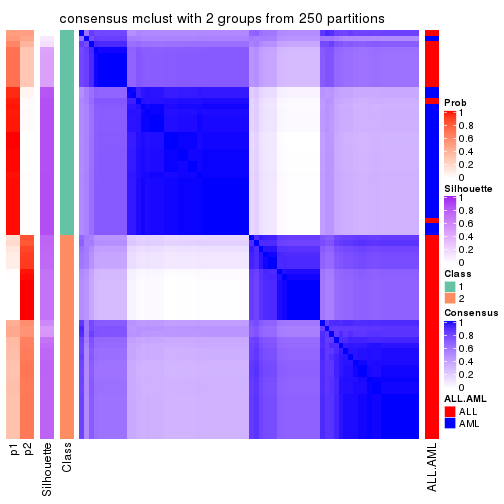
consensus_heatmap(res, k = 3)
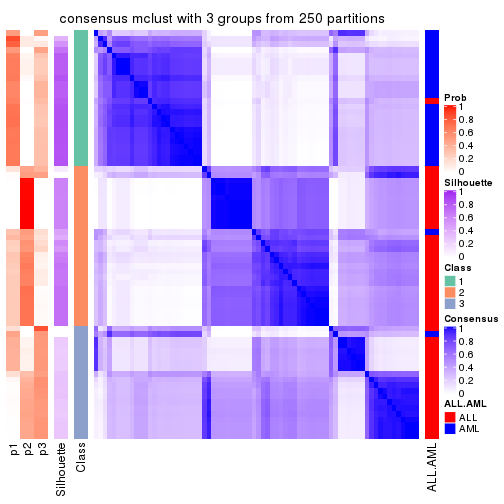
consensus_heatmap(res, k = 4)
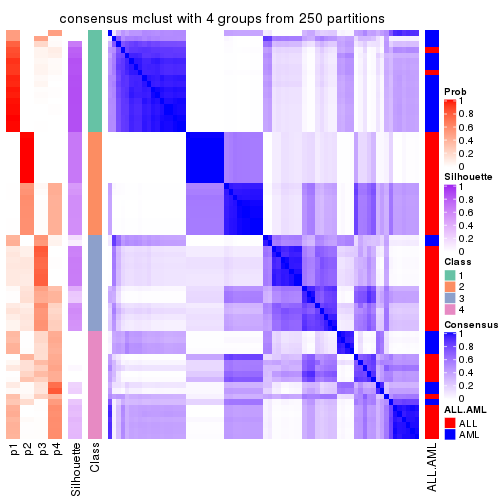
consensus_heatmap(res, k = 5)
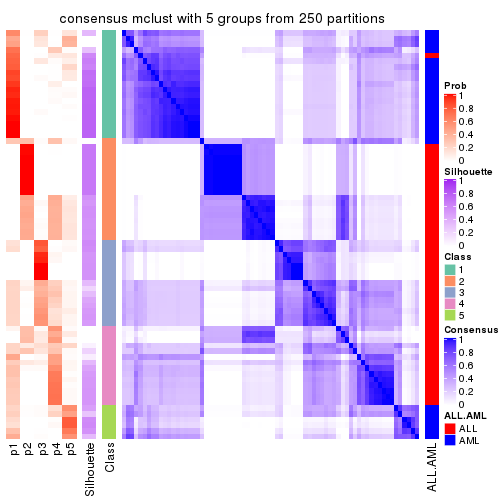
consensus_heatmap(res, k = 6)
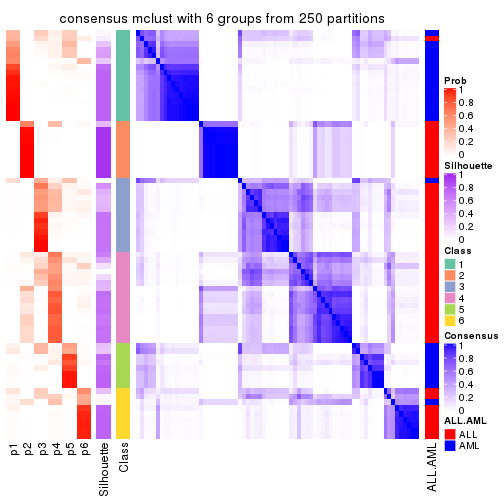
Heatmaps for the membership of samples in all partitions to see how consistent they are:
membership_heatmap(res, k = 2)
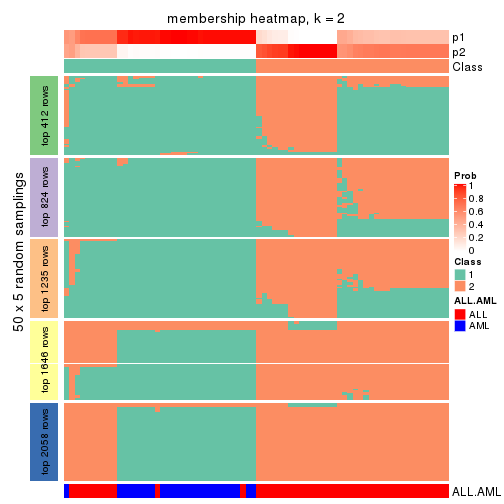
membership_heatmap(res, k = 3)
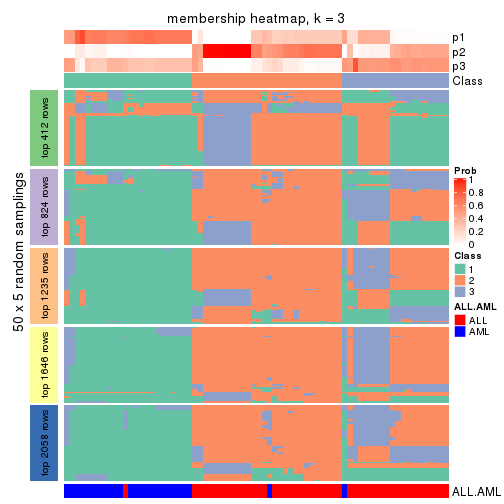
membership_heatmap(res, k = 4)
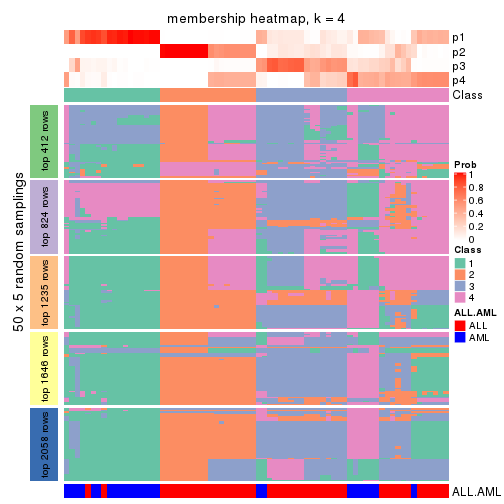
membership_heatmap(res, k = 5)
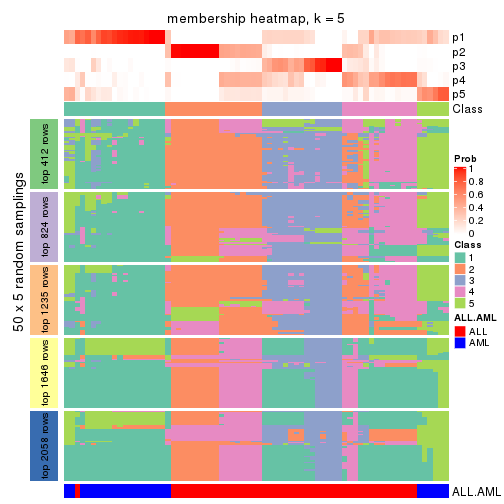
membership_heatmap(res, k = 6)
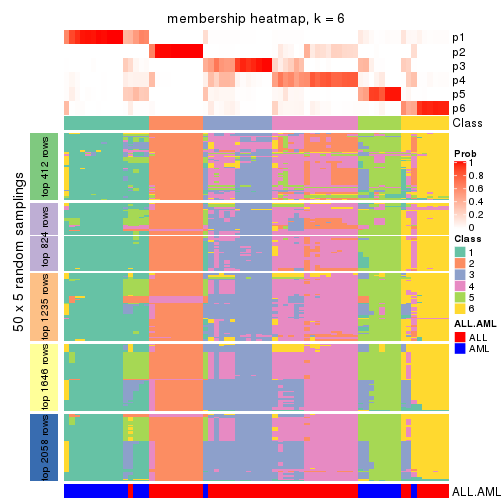
As soon as we have had the classes for columns, we can look for signatures which are significantly different between classes which can be candidate marks for certain classes. Following are the heatmaps for signatures.
Signature heatmaps where rows are scaled:
get_signatures(res, k = 2)
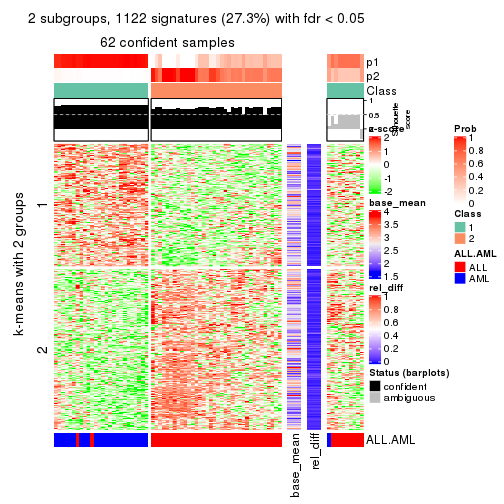
get_signatures(res, k = 3)
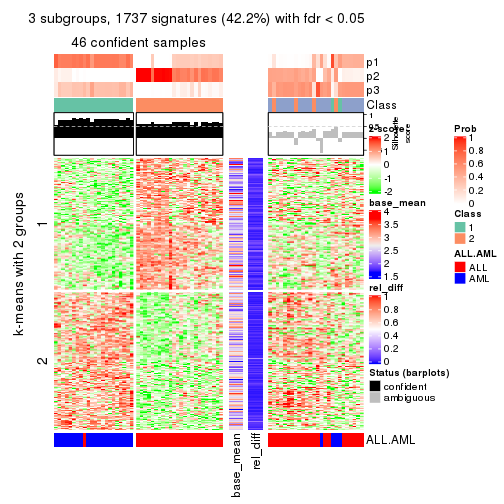
get_signatures(res, k = 4)
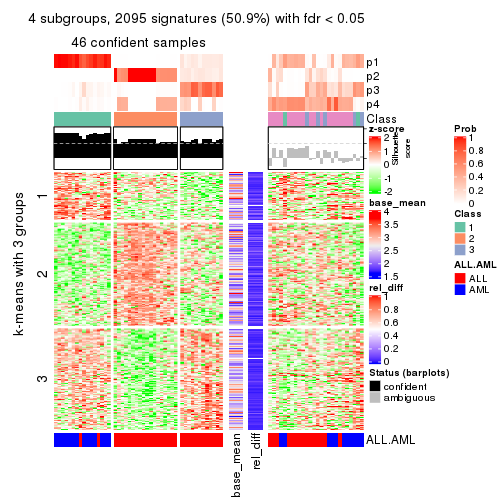
get_signatures(res, k = 5)
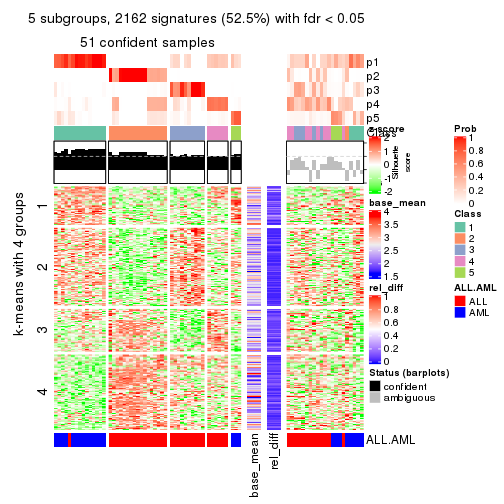
get_signatures(res, k = 6)
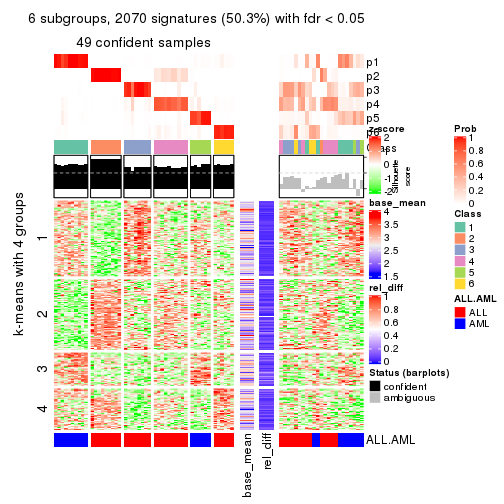
Signature heatmaps where rows are not scaled:
get_signatures(res, k = 2, scale_rows = FALSE)
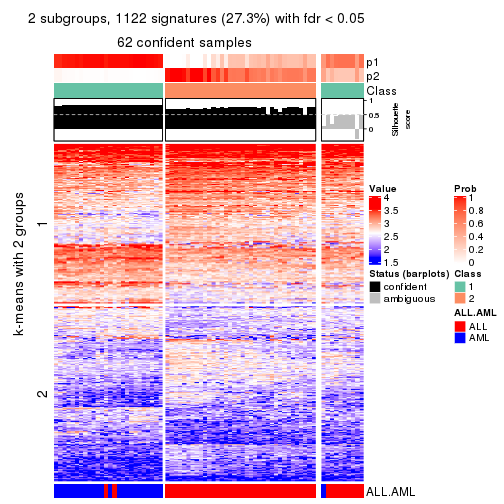
get_signatures(res, k = 3, scale_rows = FALSE)
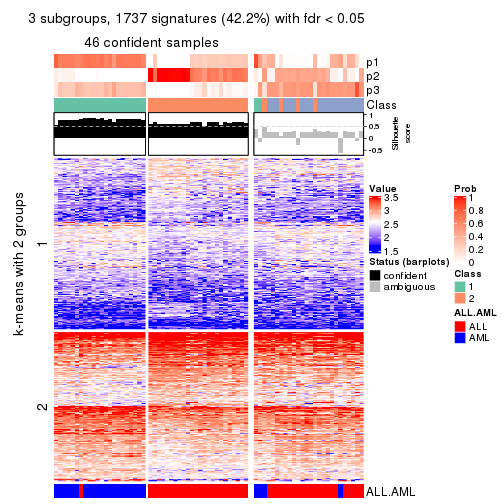
get_signatures(res, k = 4, scale_rows = FALSE)
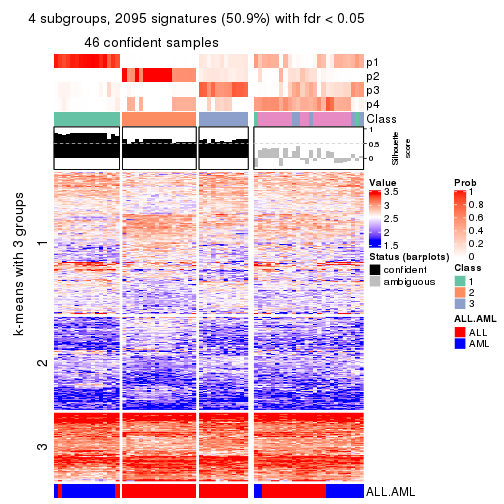
get_signatures(res, k = 5, scale_rows = FALSE)
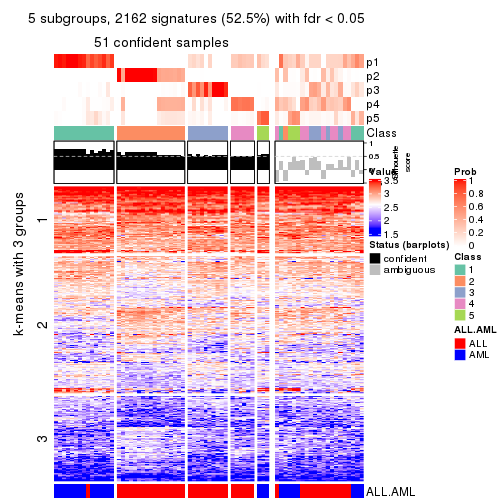
get_signatures(res, k = 6, scale_rows = FALSE)
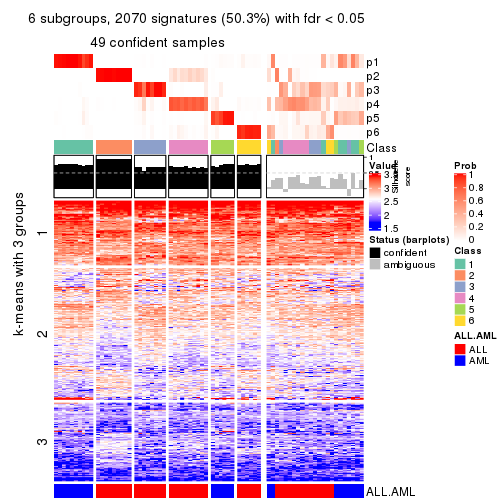
Compare the overlap of signatures from different k:
compare_signatures(res)
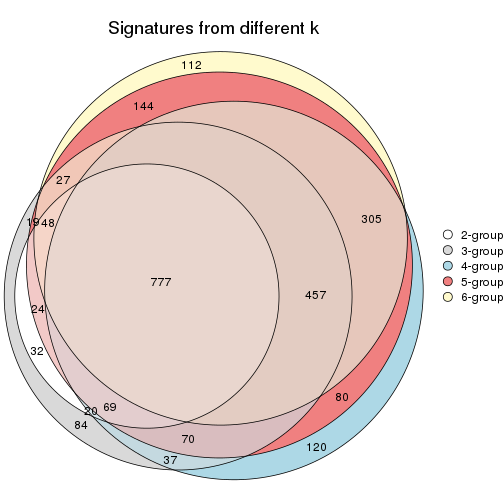
get_signature() returns a data frame invisibly. TO get the list of signatures, the function
call should be assigned to a variable explicitly. In following code, if plot argument is set
to FALSE, no heatmap is plotted while only the differential analysis is performed.
# code only for demonstration
tb = get_signature(res, k = ..., plot = FALSE)
An example of the output of tb is:
#> which_row fdr mean_1 mean_2 scaled_mean_1 scaled_mean_2 km
#> 1 38 0.042760348 8.373488 9.131774 -0.5533452 0.5164555 1
#> 2 40 0.018707592 7.106213 8.469186 -0.6173731 0.5762149 1
#> 3 55 0.019134737 10.221463 11.207825 -0.6159697 0.5749050 1
#> 4 59 0.006059896 5.921854 7.869574 -0.6899429 0.6439467 1
#> 5 60 0.018055526 8.928898 10.211722 -0.6204761 0.5791110 1
#> 6 98 0.009384629 15.714769 14.887706 0.6635654 -0.6193277 2
...
The columns in tb are:
which_row: row indices corresponding to the input matrix.fdr: FDR for the differential test. mean_x: The mean value in group x.scaled_mean_x: The mean value in group x after rows are scaled.km: Row groups if k-means clustering is applied to rows.UMAP plot which shows how samples are separated.
dimension_reduction(res, k = 2, method = "UMAP")
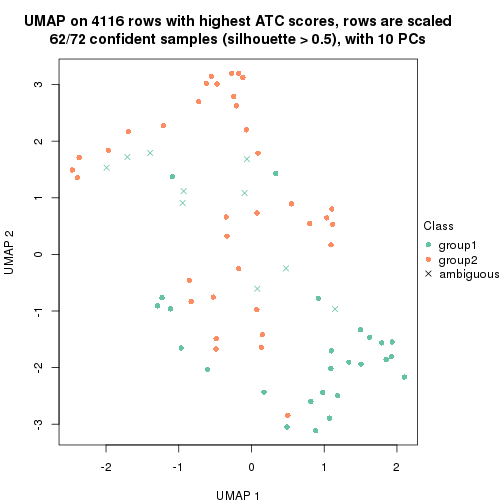
dimension_reduction(res, k = 3, method = "UMAP")
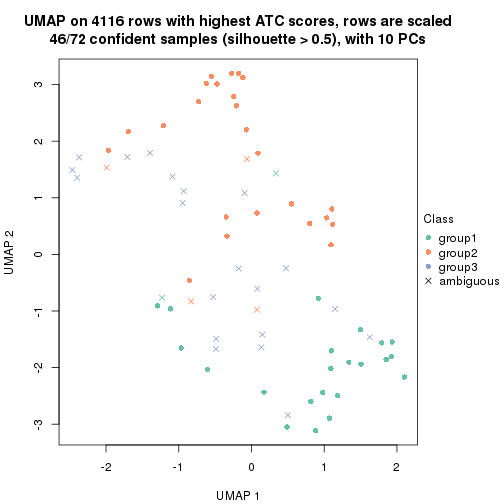
dimension_reduction(res, k = 4, method = "UMAP")
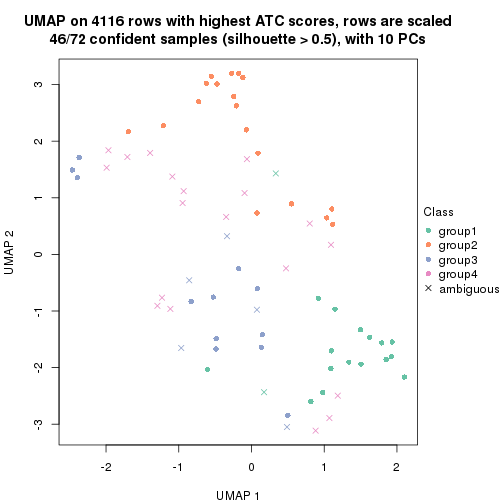
dimension_reduction(res, k = 5, method = "UMAP")
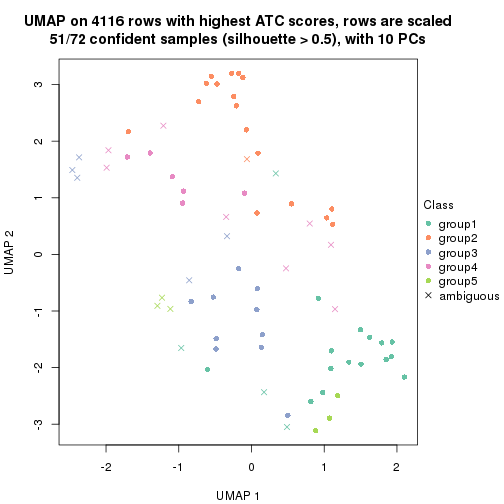
dimension_reduction(res, k = 6, method = "UMAP")
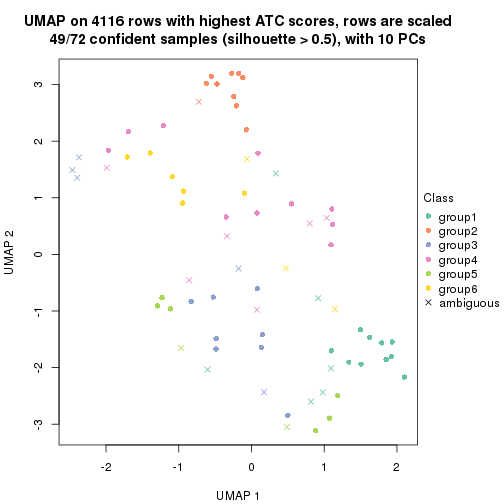
Following heatmap shows how subgroups are split when increasing k:
collect_classes(res)
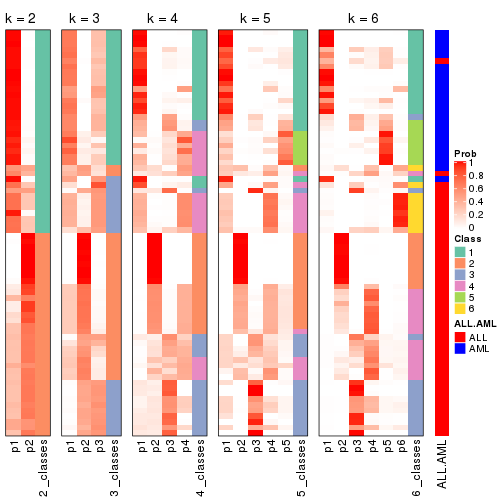
Test correlation between subgroups and known annotations. If the known annotation is numeric, one-way ANOVA test is applied, and if the known annotation is discrete, chi-squared contingency table test is applied.
test_to_known_factors(res)
#> n ALL.AML(p) k
#> ATC:mclust 62 1.26e-12 2
#> ATC:mclust 46 5.78e-10 3
#> ATC:mclust 46 6.40e-09 4
#> ATC:mclust 51 1.68e-09 5
#> ATC:mclust 49 2.22e-09 6
If matrix rows can be associated to genes, consider to use functional_enrichment(res,
...) to perform function enrichment for the signature genes. See this vignette for more detailed explanations.
The object with results only for a single top-value method and a single partition method can be extracted as:
res = res_list["ATC", "NMF"]
# you can also extract it by
# res = res_list["ATC:NMF"]
A summary of res and all the functions that can be applied to it:
res
#> A 'ConsensusPartition' object with k = 2, 3, 4, 5, 6.
#> On a matrix with 4116 rows and 72 columns.
#> Top rows (412, 824, 1235, 1646, 2058) are extracted by 'ATC' method.
#> Subgroups are detected by 'NMF' method.
#> Performed in total 1250 partitions by row resampling.
#> Best k for subgroups seems to be 2.
#>
#> Following methods can be applied to this 'ConsensusPartition' object:
#> [1] "cola_report" "collect_classes" "collect_plots"
#> [4] "collect_stats" "colnames" "compare_signatures"
#> [7] "consensus_heatmap" "dimension_reduction" "functional_enrichment"
#> [10] "get_anno_col" "get_anno" "get_classes"
#> [13] "get_consensus" "get_matrix" "get_membership"
#> [16] "get_param" "get_signatures" "get_stats"
#> [19] "is_best_k" "is_stable_k" "membership_heatmap"
#> [22] "ncol" "nrow" "plot_ecdf"
#> [25] "rownames" "select_partition_number" "show"
#> [28] "suggest_best_k" "test_to_known_factors"
collect_plots() function collects all the plots made from res for all k (number of partitions)
into one single page to provide an easy and fast comparison between different k.
collect_plots(res)
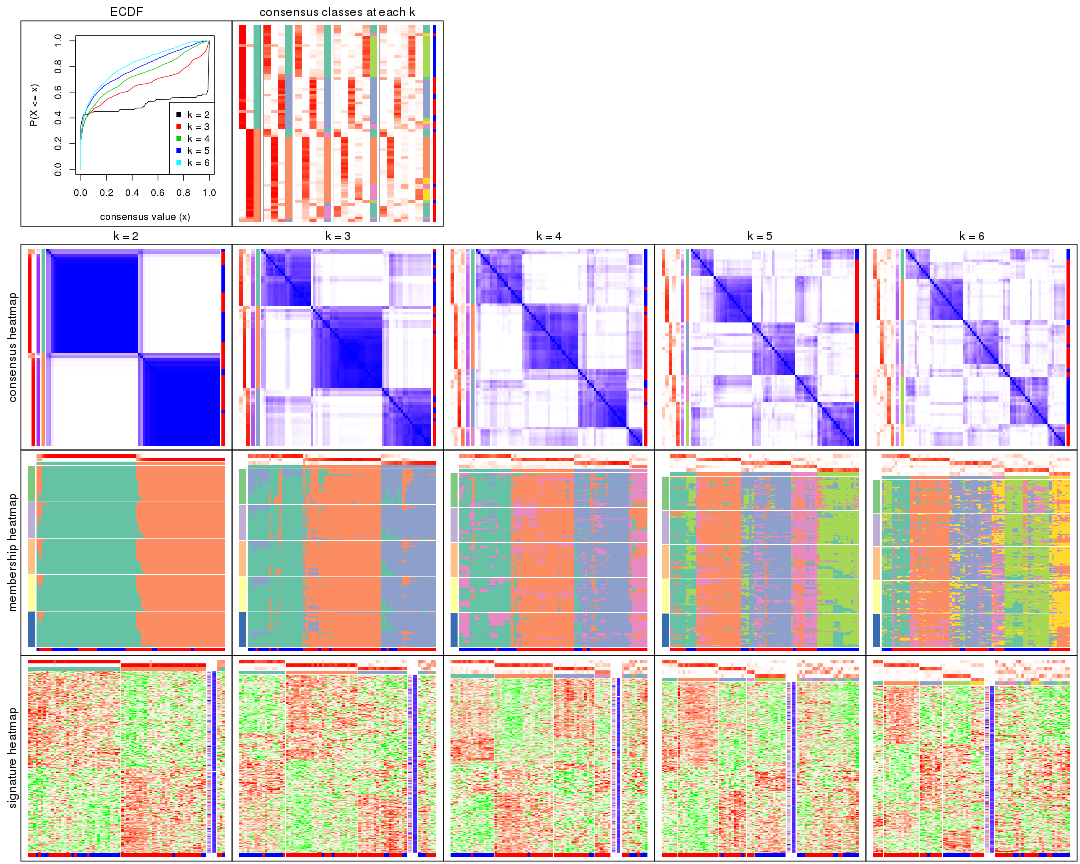
The plots are:
k and the heatmap of
predicted classes for each k.k.k.k.All the plots in panels can be made by individual functions and they are plotted later in this section.
select_partition_number() produces several plots showing different
statistics for choosing “optimized” k. There are following statistics:
k;k, the area increased is defined as \(A_k - A_{k-1}\).The detailed explanations of these statistics can be found in the cola vignette.
Generally speaking, lower PAC score, higher mean silhouette score or higher
concordance corresponds to better partition. Rand index and Jaccard index
measure how similar the current partition is compared to partition with k-1.
If they are too similar, we won't accept k is better than k-1.
select_partition_number(res)
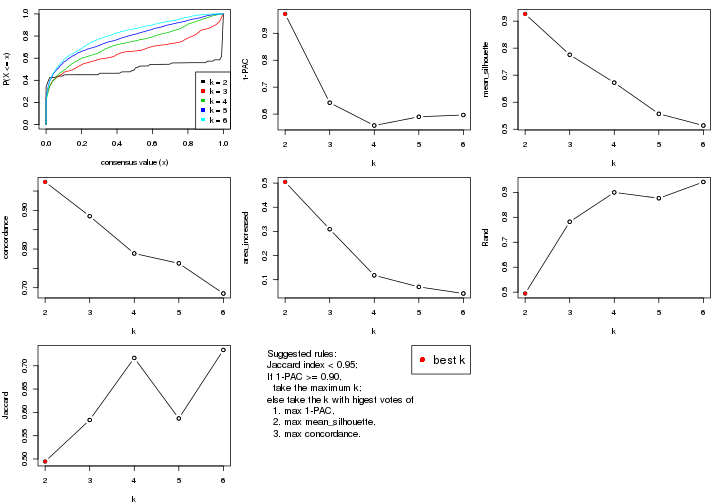
The numeric values for all these statistics can be obtained by get_stats().
get_stats(res)
#> k 1-PAC mean_silhouette concordance area_increased Rand Jaccard
#> 2 2 0.972 0.927 0.973 0.5047 0.495 0.495
#> 3 3 0.642 0.776 0.885 0.3090 0.782 0.584
#> 4 4 0.558 0.673 0.788 0.1178 0.900 0.717
#> 5 5 0.590 0.557 0.763 0.0700 0.876 0.587
#> 6 6 0.597 0.514 0.685 0.0426 0.942 0.734
suggest_best_k() suggests the best \(k\) based on these statistics. The rules are as follows:
suggest_best_k(res)
#> [1] 2
Following shows the table of the partitions (You need to click the show/hide
code output link to see it). The membership matrix (columns with name p*)
is inferred by
clue::cl_consensus()
function with the SE method. Basically the value in the membership matrix
represents the probability to belong to a certain group. The finall class
label for an item is determined with the group with highest probability it
belongs to.
In get_classes() function, the entropy is calculated from the membership
matrix and the silhouette score is calculated from the consensus matrix.
cbind(get_classes(res, k = 2), get_membership(res, k = 2))
#> class entropy silhouette p1 p2
#> sample_39 1 0.0000 0.9711 1.000 0.000
#> sample_40 1 0.0000 0.9711 1.000 0.000
#> sample_42 2 0.0000 0.9719 0.000 1.000
#> sample_47 2 0.0000 0.9719 0.000 1.000
#> sample_48 2 0.0000 0.9719 0.000 1.000
#> sample_49 1 0.0000 0.9711 1.000 0.000
#> sample_41 2 0.0000 0.9719 0.000 1.000
#> sample_43 2 0.0000 0.9719 0.000 1.000
#> sample_44 2 0.0000 0.9719 0.000 1.000
#> sample_45 2 0.0000 0.9719 0.000 1.000
#> sample_46 2 0.0000 0.9719 0.000 1.000
#> sample_70 2 0.1184 0.9594 0.016 0.984
#> sample_71 2 0.3114 0.9196 0.056 0.944
#> sample_72 2 0.0000 0.9719 0.000 1.000
#> sample_68 2 0.0000 0.9719 0.000 1.000
#> sample_69 2 0.0000 0.9719 0.000 1.000
#> sample_67 2 0.0000 0.9719 0.000 1.000
#> sample_55 1 0.0376 0.9679 0.996 0.004
#> sample_56 1 0.0000 0.9711 1.000 0.000
#> sample_59 2 0.0376 0.9691 0.004 0.996
#> sample_52 1 0.0000 0.9711 1.000 0.000
#> sample_53 1 0.0000 0.9711 1.000 0.000
#> sample_51 1 0.0000 0.9711 1.000 0.000
#> sample_50 1 0.0000 0.9711 1.000 0.000
#> sample_54 2 0.0376 0.9691 0.004 0.996
#> sample_57 1 0.0000 0.9711 1.000 0.000
#> sample_58 1 0.0000 0.9711 1.000 0.000
#> sample_60 1 0.9833 0.2488 0.576 0.424
#> sample_61 1 0.0000 0.9711 1.000 0.000
#> sample_65 1 0.0000 0.9711 1.000 0.000
#> sample_66 2 0.0000 0.9719 0.000 1.000
#> sample_63 1 0.0000 0.9711 1.000 0.000
#> sample_64 1 0.0000 0.9711 1.000 0.000
#> sample_62 1 0.0000 0.9711 1.000 0.000
#> sample_1 1 0.4690 0.8683 0.900 0.100
#> sample_2 2 0.0000 0.9719 0.000 1.000
#> sample_3 1 0.0376 0.9679 0.996 0.004
#> sample_4 2 1.0000 -0.0262 0.500 0.500
#> sample_5 2 0.0000 0.9719 0.000 1.000
#> sample_6 1 0.0000 0.9711 1.000 0.000
#> sample_7 1 0.0000 0.9711 1.000 0.000
#> sample_8 1 0.0000 0.9711 1.000 0.000
#> sample_9 2 0.0000 0.9719 0.000 1.000
#> sample_10 2 0.8763 0.5652 0.296 0.704
#> sample_11 2 0.0000 0.9719 0.000 1.000
#> sample_12 1 0.0000 0.9711 1.000 0.000
#> sample_13 2 0.0000 0.9719 0.000 1.000
#> sample_14 2 0.0000 0.9719 0.000 1.000
#> sample_15 2 0.0000 0.9719 0.000 1.000
#> sample_16 2 0.0000 0.9719 0.000 1.000
#> sample_17 2 0.0000 0.9719 0.000 1.000
#> sample_18 1 0.9983 0.0707 0.524 0.476
#> sample_19 2 0.0000 0.9719 0.000 1.000
#> sample_20 2 0.0000 0.9719 0.000 1.000
#> sample_21 2 0.0000 0.9719 0.000 1.000
#> sample_22 1 0.0000 0.9711 1.000 0.000
#> sample_23 1 0.0000 0.9711 1.000 0.000
#> sample_24 2 0.0000 0.9719 0.000 1.000
#> sample_25 1 0.1184 0.9572 0.984 0.016
#> sample_26 2 0.0938 0.9629 0.012 0.988
#> sample_27 1 0.0000 0.9711 1.000 0.000
#> sample_34 1 0.0000 0.9711 1.000 0.000
#> sample_35 1 0.0000 0.9711 1.000 0.000
#> sample_36 1 0.0000 0.9711 1.000 0.000
#> sample_37 1 0.0000 0.9711 1.000 0.000
#> sample_38 1 0.0000 0.9711 1.000 0.000
#> sample_28 1 0.0000 0.9711 1.000 0.000
#> sample_29 2 0.0000 0.9719 0.000 1.000
#> sample_30 1 0.0000 0.9711 1.000 0.000
#> sample_31 1 0.0000 0.9711 1.000 0.000
#> sample_32 1 0.0000 0.9711 1.000 0.000
#> sample_33 1 0.0000 0.9711 1.000 0.000
cbind(get_classes(res, k = 3), get_membership(res, k = 3))
#> class entropy silhouette p1 p2 p3
#> sample_39 3 0.1315 0.839 0.020 0.008 0.972
#> sample_40 3 0.1170 0.839 0.008 0.016 0.976
#> sample_42 2 0.2550 0.888 0.056 0.932 0.012
#> sample_47 2 0.0592 0.919 0.000 0.988 0.012
#> sample_48 2 0.0747 0.919 0.000 0.984 0.016
#> sample_49 3 0.0829 0.839 0.012 0.004 0.984
#> sample_41 2 0.0237 0.919 0.004 0.996 0.000
#> sample_43 2 0.0237 0.920 0.000 0.996 0.004
#> sample_44 2 0.0747 0.919 0.000 0.984 0.016
#> sample_45 2 0.0237 0.920 0.000 0.996 0.004
#> sample_46 2 0.0424 0.920 0.000 0.992 0.008
#> sample_70 2 0.3816 0.808 0.000 0.852 0.148
#> sample_71 2 0.6735 0.273 0.424 0.564 0.012
#> sample_72 2 0.1877 0.902 0.032 0.956 0.012
#> sample_68 2 0.1015 0.914 0.008 0.980 0.012
#> sample_69 2 0.0424 0.918 0.000 0.992 0.008
#> sample_67 1 0.4692 0.685 0.820 0.168 0.012
#> sample_55 3 0.2537 0.800 0.000 0.080 0.920
#> sample_56 3 0.0747 0.837 0.000 0.016 0.984
#> sample_59 2 0.4504 0.755 0.000 0.804 0.196
#> sample_52 1 0.1399 0.824 0.968 0.004 0.028
#> sample_53 1 0.0892 0.824 0.980 0.000 0.020
#> sample_51 1 0.1529 0.827 0.960 0.000 0.040
#> sample_50 1 0.1289 0.826 0.968 0.000 0.032
#> sample_54 2 0.1525 0.905 0.032 0.964 0.004
#> sample_57 3 0.5621 0.506 0.308 0.000 0.692
#> sample_58 3 0.4062 0.741 0.164 0.000 0.836
#> sample_60 1 0.6865 0.357 0.596 0.384 0.020
#> sample_61 3 0.6062 0.308 0.384 0.000 0.616
#> sample_65 1 0.4346 0.770 0.816 0.000 0.184
#> sample_66 2 0.5220 0.731 0.208 0.780 0.012
#> sample_63 1 0.4931 0.724 0.768 0.000 0.232
#> sample_64 3 0.2165 0.823 0.064 0.000 0.936
#> sample_62 1 0.4346 0.766 0.816 0.000 0.184
#> sample_1 3 0.4291 0.710 0.000 0.180 0.820
#> sample_2 1 0.6647 0.242 0.592 0.396 0.012
#> sample_3 3 0.2651 0.822 0.012 0.060 0.928
#> sample_4 3 0.5397 0.565 0.000 0.280 0.720
#> sample_5 2 0.0424 0.918 0.000 0.992 0.008
#> sample_6 3 0.1774 0.840 0.016 0.024 0.960
#> sample_7 3 0.0983 0.838 0.004 0.016 0.980
#> sample_8 3 0.1163 0.837 0.028 0.000 0.972
#> sample_9 2 0.0000 0.920 0.000 1.000 0.000
#> sample_10 2 0.6100 0.781 0.120 0.784 0.096
#> sample_11 2 0.3771 0.840 0.112 0.876 0.012
#> sample_12 1 0.4172 0.787 0.840 0.004 0.156
#> sample_13 2 0.0747 0.919 0.000 0.984 0.016
#> sample_14 2 0.0000 0.920 0.000 1.000 0.000
#> sample_15 2 0.0000 0.920 0.000 1.000 0.000
#> sample_16 2 0.3752 0.817 0.000 0.856 0.144
#> sample_17 2 0.1163 0.914 0.000 0.972 0.028
#> sample_18 3 0.6168 0.275 0.000 0.412 0.588
#> sample_19 2 0.0892 0.917 0.000 0.980 0.020
#> sample_20 2 0.0592 0.919 0.000 0.988 0.012
#> sample_21 2 0.0475 0.918 0.004 0.992 0.004
#> sample_22 3 0.5138 0.642 0.252 0.000 0.748
#> sample_23 3 0.3091 0.827 0.072 0.016 0.912
#> sample_24 2 0.0747 0.919 0.000 0.984 0.016
#> sample_25 3 0.4397 0.797 0.116 0.028 0.856
#> sample_26 2 0.6260 0.206 0.000 0.552 0.448
#> sample_27 3 0.1163 0.837 0.028 0.000 0.972
#> sample_34 1 0.5948 0.500 0.640 0.000 0.360
#> sample_35 3 0.3686 0.773 0.140 0.000 0.860
#> sample_36 1 0.1643 0.826 0.956 0.000 0.044
#> sample_37 1 0.0892 0.824 0.980 0.000 0.020
#> sample_38 1 0.1163 0.826 0.972 0.000 0.028
#> sample_28 1 0.1964 0.825 0.944 0.000 0.056
#> sample_29 1 0.3377 0.751 0.896 0.092 0.012
#> sample_30 1 0.1182 0.802 0.976 0.012 0.012
#> sample_31 1 0.4291 0.772 0.820 0.000 0.180
#> sample_32 1 0.4654 0.749 0.792 0.000 0.208
#> sample_33 1 0.5178 0.691 0.744 0.000 0.256
cbind(get_classes(res, k = 4), get_membership(res, k = 4))
#> class entropy silhouette p1 p2 p3 p4
#> sample_39 3 0.0657 0.785 0.004 0.000 0.984 0.012
#> sample_40 3 0.2400 0.782 0.028 0.004 0.924 0.044
#> sample_42 4 0.4720 0.710 0.000 0.324 0.004 0.672
#> sample_47 2 0.1867 0.791 0.000 0.928 0.000 0.072
#> sample_48 2 0.1940 0.790 0.000 0.924 0.000 0.076
#> sample_49 3 0.0336 0.786 0.008 0.000 0.992 0.000
#> sample_41 2 0.2088 0.792 0.004 0.928 0.004 0.064
#> sample_43 2 0.3544 0.756 0.008 0.852 0.012 0.128
#> sample_44 2 0.3703 0.751 0.012 0.840 0.008 0.140
#> sample_45 2 0.3317 0.767 0.008 0.868 0.012 0.112
#> sample_46 2 0.3134 0.776 0.008 0.880 0.012 0.100
#> sample_70 2 0.7326 0.517 0.036 0.620 0.140 0.204
#> sample_71 4 0.5487 0.769 0.048 0.228 0.008 0.716
#> sample_72 4 0.5060 0.749 0.004 0.288 0.016 0.692
#> sample_68 2 0.1661 0.802 0.000 0.944 0.004 0.052
#> sample_69 2 0.3311 0.703 0.000 0.828 0.000 0.172
#> sample_67 4 0.5982 0.572 0.204 0.112 0.000 0.684
#> sample_55 3 0.7397 0.577 0.056 0.152 0.636 0.156
#> sample_56 3 0.0712 0.785 0.004 0.004 0.984 0.008
#> sample_59 2 0.6845 0.538 0.020 0.640 0.116 0.224
#> sample_52 1 0.2675 0.714 0.892 0.008 0.000 0.100
#> sample_53 1 0.5686 0.511 0.592 0.000 0.032 0.376
#> sample_51 1 0.3105 0.742 0.868 0.000 0.012 0.120
#> sample_50 1 0.2048 0.754 0.928 0.000 0.008 0.064
#> sample_54 2 0.7760 0.141 0.352 0.456 0.008 0.184
#> sample_57 1 0.6586 0.559 0.656 0.008 0.152 0.184
#> sample_58 3 0.5558 0.378 0.364 0.000 0.608 0.028
#> sample_60 1 0.7858 0.301 0.536 0.232 0.024 0.208
#> sample_61 3 0.5970 0.338 0.348 0.000 0.600 0.052
#> sample_65 1 0.1724 0.754 0.948 0.000 0.032 0.020
#> sample_66 2 0.5192 0.692 0.076 0.760 0.004 0.160
#> sample_63 1 0.3828 0.722 0.848 0.000 0.068 0.084
#> sample_64 3 0.5298 0.593 0.244 0.000 0.708 0.048
#> sample_62 1 0.4093 0.713 0.832 0.000 0.072 0.096
#> sample_1 3 0.1510 0.783 0.000 0.016 0.956 0.028
#> sample_2 4 0.5952 0.715 0.124 0.184 0.000 0.692
#> sample_3 3 0.3325 0.764 0.012 0.012 0.872 0.104
#> sample_4 3 0.4513 0.680 0.004 0.160 0.796 0.040
#> sample_5 2 0.1389 0.801 0.000 0.952 0.000 0.048
#> sample_6 3 0.5079 0.724 0.048 0.020 0.780 0.152
#> sample_7 3 0.0895 0.787 0.020 0.004 0.976 0.000
#> sample_8 3 0.1109 0.784 0.004 0.000 0.968 0.028
#> sample_9 2 0.4334 0.752 0.008 0.808 0.028 0.156
#> sample_10 4 0.9200 0.185 0.072 0.292 0.292 0.344
#> sample_11 4 0.4663 0.756 0.012 0.272 0.000 0.716
#> sample_12 1 0.4798 0.707 0.768 0.000 0.052 0.180
#> sample_13 2 0.2654 0.773 0.000 0.888 0.004 0.108
#> sample_14 2 0.1489 0.807 0.000 0.952 0.004 0.044
#> sample_15 2 0.0657 0.804 0.000 0.984 0.004 0.012
#> sample_16 2 0.4245 0.702 0.000 0.820 0.116 0.064
#> sample_17 2 0.3621 0.749 0.000 0.860 0.068 0.072
#> sample_18 3 0.5426 0.469 0.004 0.316 0.656 0.024
#> sample_19 2 0.2048 0.796 0.000 0.928 0.008 0.064
#> sample_20 2 0.3024 0.735 0.000 0.852 0.000 0.148
#> sample_21 2 0.2266 0.791 0.000 0.912 0.004 0.084
#> sample_22 3 0.6037 0.492 0.068 0.000 0.628 0.304
#> sample_23 3 0.4551 0.730 0.044 0.004 0.796 0.156
#> sample_24 2 0.1807 0.800 0.000 0.940 0.008 0.052
#> sample_25 3 0.4962 0.699 0.032 0.020 0.776 0.172
#> sample_26 3 0.6123 0.292 0.000 0.372 0.572 0.056
#> sample_27 3 0.0804 0.786 0.012 0.000 0.980 0.008
#> sample_34 1 0.4679 0.690 0.772 0.000 0.184 0.044
#> sample_35 3 0.3495 0.733 0.140 0.000 0.844 0.016
#> sample_36 1 0.1722 0.755 0.944 0.000 0.008 0.048
#> sample_37 1 0.3196 0.736 0.856 0.000 0.008 0.136
#> sample_38 1 0.6270 0.437 0.536 0.000 0.060 0.404
#> sample_28 1 0.5478 0.548 0.628 0.000 0.028 0.344
#> sample_29 1 0.5326 0.424 0.604 0.016 0.000 0.380
#> sample_30 1 0.2466 0.746 0.900 0.000 0.004 0.096
#> sample_31 1 0.2256 0.741 0.924 0.000 0.020 0.056
#> sample_32 1 0.6078 0.673 0.684 0.000 0.152 0.164
#> sample_33 1 0.6155 0.664 0.676 0.000 0.176 0.148
cbind(get_classes(res, k = 5), get_membership(res, k = 5))
#> class entropy silhouette p1 p2 p3 p4 p5
#> sample_39 3 0.2179 0.68252 0.004 0.000 0.896 0.100 0.000
#> sample_40 3 0.2214 0.69501 0.004 0.000 0.916 0.028 0.052
#> sample_42 1 0.3437 0.61434 0.808 0.176 0.004 0.012 0.000
#> sample_47 2 0.2305 0.81621 0.028 0.916 0.000 0.044 0.012
#> sample_48 2 0.0693 0.82996 0.012 0.980 0.000 0.008 0.000
#> sample_49 3 0.1197 0.69955 0.000 0.000 0.952 0.048 0.000
#> sample_41 2 0.3944 0.69725 0.020 0.764 0.000 0.212 0.004
#> sample_43 2 0.4317 0.53424 0.008 0.668 0.000 0.320 0.004
#> sample_44 4 0.4147 0.44458 0.000 0.316 0.008 0.676 0.000
#> sample_45 4 0.4287 0.07093 0.000 0.460 0.000 0.540 0.000
#> sample_46 4 0.4473 0.24822 0.000 0.412 0.008 0.580 0.000
#> sample_70 4 0.3205 0.61689 0.000 0.072 0.056 0.864 0.008
#> sample_71 1 0.3584 0.63811 0.828 0.132 0.028 0.012 0.000
#> sample_72 1 0.5252 0.53552 0.704 0.208 0.056 0.032 0.000
#> sample_68 2 0.2005 0.82871 0.016 0.924 0.000 0.056 0.004
#> sample_69 2 0.2707 0.75544 0.132 0.860 0.000 0.008 0.000
#> sample_67 1 0.2577 0.66637 0.892 0.084 0.000 0.008 0.016
#> sample_55 3 0.5510 0.36219 0.000 0.020 0.588 0.352 0.040
#> sample_56 3 0.1041 0.70240 0.000 0.000 0.964 0.032 0.004
#> sample_59 2 0.6732 0.00615 0.012 0.496 0.056 0.384 0.052
#> sample_52 5 0.1928 0.70331 0.004 0.004 0.000 0.072 0.920
#> sample_53 1 0.4807 0.00253 0.532 0.000 0.020 0.000 0.448
#> sample_51 5 0.3870 0.59256 0.260 0.000 0.004 0.004 0.732
#> sample_50 5 0.2806 0.69344 0.152 0.000 0.004 0.000 0.844
#> sample_54 5 0.6593 0.26496 0.036 0.324 0.008 0.084 0.548
#> sample_57 5 0.3423 0.69651 0.016 0.000 0.068 0.060 0.856
#> sample_58 3 0.4800 0.05984 0.004 0.000 0.508 0.012 0.476
#> sample_60 5 0.4849 0.59498 0.028 0.120 0.012 0.064 0.776
#> sample_61 3 0.5035 0.50446 0.044 0.000 0.696 0.020 0.240
#> sample_65 5 0.3362 0.72623 0.064 0.000 0.032 0.040 0.864
#> sample_66 4 0.6292 0.29856 0.068 0.332 0.000 0.556 0.044
#> sample_63 5 0.2478 0.70784 0.008 0.000 0.060 0.028 0.904
#> sample_64 3 0.5221 0.39018 0.004 0.004 0.612 0.040 0.340
#> sample_62 5 0.2737 0.70556 0.020 0.000 0.052 0.032 0.896
#> sample_1 3 0.2026 0.69665 0.008 0.012 0.924 0.056 0.000
#> sample_2 1 0.2541 0.66235 0.900 0.068 0.000 0.020 0.012
#> sample_3 3 0.4874 0.18333 0.016 0.000 0.528 0.452 0.004
#> sample_4 3 0.5415 0.47722 0.000 0.092 0.648 0.256 0.004
#> sample_5 2 0.1798 0.82627 0.004 0.928 0.000 0.064 0.004
#> sample_6 4 0.3937 0.43472 0.000 0.004 0.252 0.736 0.008
#> sample_7 3 0.2694 0.69835 0.000 0.000 0.884 0.076 0.040
#> sample_8 3 0.0955 0.70090 0.000 0.000 0.968 0.028 0.004
#> sample_9 4 0.5168 0.58813 0.036 0.188 0.056 0.720 0.000
#> sample_10 4 0.5011 0.57057 0.072 0.040 0.104 0.772 0.012
#> sample_11 1 0.4359 0.57520 0.776 0.092 0.000 0.128 0.004
#> sample_12 4 0.6610 0.32973 0.132 0.000 0.072 0.616 0.180
#> sample_13 2 0.1310 0.81505 0.024 0.956 0.000 0.020 0.000
#> sample_14 2 0.4317 0.52597 0.008 0.668 0.004 0.320 0.000
#> sample_15 2 0.2286 0.80590 0.004 0.888 0.000 0.108 0.000
#> sample_16 2 0.1399 0.82253 0.000 0.952 0.020 0.028 0.000
#> sample_17 2 0.2967 0.82255 0.032 0.884 0.024 0.060 0.000
#> sample_18 3 0.4318 0.57054 0.004 0.176 0.772 0.040 0.008
#> sample_19 2 0.0992 0.82623 0.008 0.968 0.000 0.024 0.000
#> sample_20 2 0.1845 0.80329 0.056 0.928 0.000 0.016 0.000
#> sample_21 2 0.3803 0.77152 0.056 0.804 0.000 0.140 0.000
#> sample_22 3 0.5318 0.33486 0.364 0.004 0.592 0.016 0.024
#> sample_23 4 0.5175 0.14710 0.040 0.000 0.372 0.584 0.004
#> sample_24 2 0.1205 0.83314 0.004 0.956 0.000 0.040 0.000
#> sample_25 3 0.6227 0.46564 0.128 0.024 0.624 0.220 0.004
#> sample_26 3 0.5612 0.21534 0.012 0.420 0.520 0.048 0.000
#> sample_27 3 0.1341 0.69805 0.000 0.000 0.944 0.056 0.000
#> sample_34 5 0.4982 0.64517 0.076 0.000 0.180 0.016 0.728
#> sample_35 3 0.3970 0.60636 0.000 0.000 0.752 0.024 0.224
#> sample_36 5 0.2127 0.71408 0.108 0.000 0.000 0.000 0.892
#> sample_37 5 0.4518 0.47142 0.320 0.000 0.004 0.016 0.660
#> sample_38 1 0.5329 0.29339 0.608 0.000 0.032 0.020 0.340
#> sample_28 1 0.6306 0.32871 0.576 0.000 0.048 0.072 0.304
#> sample_29 1 0.5499 0.19344 0.532 0.000 0.000 0.068 0.400
#> sample_30 5 0.3616 0.68095 0.164 0.000 0.000 0.032 0.804
#> sample_31 5 0.3923 0.68357 0.040 0.000 0.016 0.132 0.812
#> sample_32 5 0.5702 0.43224 0.320 0.000 0.104 0.000 0.576
#> sample_33 5 0.5982 0.47934 0.276 0.000 0.136 0.004 0.584
cbind(get_classes(res, k = 6), get_membership(res, k = 6))
#> class entropy silhouette p1 p2 p3 p4 p5 p6
#> sample_39 3 0.4964 0.3946 0.012 0.000 0.596 0.056 0.000 0.336
#> sample_40 3 0.4447 0.6211 0.008 0.000 0.764 0.136 0.036 0.056
#> sample_42 1 0.4614 0.4707 0.720 0.120 0.000 0.012 0.000 0.148
#> sample_47 2 0.2610 0.7989 0.004 0.884 0.000 0.060 0.004 0.048
#> sample_48 2 0.1933 0.8180 0.032 0.924 0.000 0.012 0.000 0.032
#> sample_49 3 0.1552 0.6484 0.000 0.000 0.940 0.020 0.004 0.036
#> sample_41 2 0.3516 0.7409 0.004 0.812 0.000 0.088 0.000 0.096
#> sample_43 6 0.5423 0.5205 0.012 0.316 0.008 0.060 0.008 0.596
#> sample_44 6 0.3998 0.5856 0.000 0.248 0.000 0.040 0.000 0.712
#> sample_45 6 0.3957 0.5810 0.000 0.280 0.004 0.020 0.000 0.696
#> sample_46 6 0.3657 0.5993 0.012 0.204 0.004 0.012 0.000 0.768
#> sample_70 6 0.4334 0.3512 0.000 0.048 0.052 0.136 0.000 0.764
#> sample_71 1 0.3532 0.5555 0.836 0.032 0.004 0.056 0.000 0.072
#> sample_72 1 0.4932 0.5153 0.752 0.096 0.028 0.068 0.000 0.056
#> sample_68 2 0.1794 0.8237 0.028 0.932 0.000 0.024 0.000 0.016
#> sample_69 2 0.5533 0.6379 0.172 0.660 0.000 0.072 0.000 0.096
#> sample_67 1 0.2507 0.5769 0.892 0.072 0.000 0.008 0.016 0.012
#> sample_55 3 0.6852 0.3717 0.004 0.020 0.524 0.120 0.068 0.264
#> sample_56 3 0.4089 0.5891 0.000 0.000 0.752 0.052 0.012 0.184
#> sample_59 6 0.5670 0.5689 0.004 0.216 0.056 0.076 0.004 0.644
#> sample_52 5 0.2494 0.6530 0.000 0.000 0.000 0.120 0.864 0.016
#> sample_53 1 0.5688 0.1852 0.536 0.000 0.016 0.056 0.368 0.024
#> sample_51 5 0.5345 0.5002 0.200 0.000 0.016 0.052 0.680 0.052
#> sample_50 5 0.4167 0.5954 0.124 0.000 0.004 0.044 0.784 0.044
#> sample_54 5 0.6041 0.3699 0.004 0.236 0.000 0.156 0.572 0.032
#> sample_57 5 0.3708 0.6435 0.008 0.000 0.052 0.116 0.812 0.012
#> sample_58 5 0.5424 0.0516 0.004 0.000 0.432 0.068 0.484 0.012
#> sample_60 5 0.4913 0.5831 0.004 0.104 0.012 0.128 0.732 0.020
#> sample_61 3 0.5382 0.4496 0.028 0.000 0.644 0.052 0.256 0.020
#> sample_65 5 0.3583 0.6624 0.020 0.000 0.036 0.096 0.832 0.016
#> sample_66 4 0.7056 0.2840 0.040 0.308 0.000 0.440 0.028 0.184
#> sample_63 5 0.2403 0.6597 0.008 0.000 0.032 0.044 0.904 0.012
#> sample_64 3 0.6883 0.2059 0.008 0.012 0.448 0.152 0.340 0.040
#> sample_62 5 0.3082 0.6529 0.008 0.004 0.036 0.068 0.868 0.016
#> sample_1 3 0.2948 0.6459 0.012 0.000 0.868 0.060 0.004 0.056
#> sample_2 1 0.3587 0.5252 0.804 0.132 0.000 0.056 0.008 0.000
#> sample_3 3 0.6129 0.1589 0.020 0.020 0.556 0.280 0.000 0.124
#> sample_4 3 0.5746 0.4755 0.000 0.100 0.648 0.148 0.000 0.104
#> sample_5 2 0.2278 0.8103 0.032 0.904 0.000 0.052 0.000 0.012
#> sample_6 4 0.6357 0.4146 0.004 0.016 0.192 0.396 0.000 0.392
#> sample_7 3 0.4038 0.6268 0.004 0.000 0.796 0.100 0.028 0.072
#> sample_8 3 0.2830 0.6465 0.008 0.000 0.872 0.072 0.004 0.044
#> sample_9 4 0.7035 0.4703 0.016 0.288 0.044 0.428 0.000 0.224
#> sample_10 4 0.7644 0.5279 0.052 0.104 0.116 0.500 0.012 0.216
#> sample_11 1 0.6149 0.1456 0.548 0.180 0.016 0.244 0.000 0.012
#> sample_12 6 0.6997 -0.0306 0.076 0.000 0.024 0.228 0.156 0.516
#> sample_13 2 0.3036 0.8006 0.052 0.864 0.000 0.032 0.000 0.052
#> sample_14 2 0.4621 0.3815 0.012 0.632 0.012 0.328 0.000 0.016
#> sample_15 2 0.1464 0.8150 0.004 0.944 0.000 0.036 0.000 0.016
#> sample_16 2 0.3103 0.8020 0.020 0.868 0.064 0.024 0.000 0.024
#> sample_17 2 0.4909 0.6919 0.064 0.756 0.076 0.084 0.004 0.016
#> sample_18 3 0.5490 0.5426 0.000 0.108 0.704 0.108 0.032 0.048
#> sample_19 2 0.4484 0.6797 0.036 0.752 0.000 0.080 0.000 0.132
#> sample_20 2 0.3399 0.7833 0.132 0.820 0.000 0.024 0.000 0.024
#> sample_21 2 0.3457 0.7927 0.084 0.832 0.000 0.060 0.000 0.024
#> sample_22 1 0.6144 0.1146 0.488 0.000 0.392 0.052 0.036 0.032
#> sample_23 4 0.6816 0.3431 0.024 0.008 0.320 0.348 0.000 0.300
#> sample_24 2 0.2145 0.8055 0.020 0.912 0.004 0.056 0.000 0.008
#> sample_25 6 0.6012 0.1512 0.088 0.004 0.300 0.052 0.000 0.556
#> sample_26 3 0.7654 0.1070 0.016 0.156 0.440 0.136 0.008 0.244
#> sample_27 3 0.0909 0.6501 0.000 0.000 0.968 0.012 0.000 0.020
#> sample_34 5 0.5580 0.4467 0.024 0.000 0.268 0.068 0.620 0.020
#> sample_35 3 0.4492 0.5929 0.004 0.000 0.744 0.088 0.148 0.016
#> sample_36 5 0.3168 0.6328 0.092 0.000 0.004 0.028 0.852 0.024
#> sample_37 5 0.5695 0.3859 0.264 0.000 0.004 0.056 0.608 0.068
#> sample_38 1 0.6278 0.3716 0.588 0.000 0.052 0.068 0.252 0.040
#> sample_28 1 0.7157 0.2797 0.492 0.000 0.052 0.108 0.280 0.068
#> sample_29 1 0.6156 0.2097 0.508 0.004 0.000 0.084 0.348 0.056
#> sample_30 5 0.4017 0.6280 0.104 0.000 0.000 0.072 0.792 0.032
#> sample_31 5 0.4508 0.6134 0.012 0.000 0.012 0.172 0.740 0.064
#> sample_32 5 0.6637 0.3935 0.244 0.000 0.112 0.052 0.556 0.036
#> sample_33 5 0.7239 0.2974 0.264 0.000 0.124 0.060 0.492 0.060
Heatmaps for the consensus matrix. It visualizes the probability of two samples to be in a same group.
consensus_heatmap(res, k = 2)
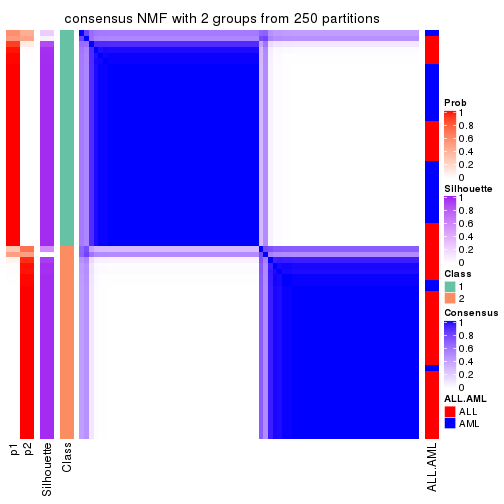
consensus_heatmap(res, k = 3)
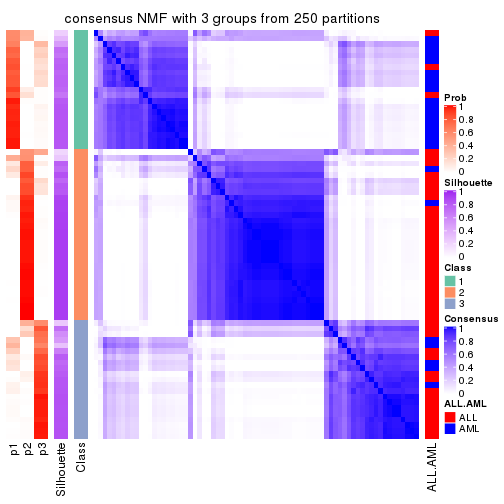
consensus_heatmap(res, k = 4)
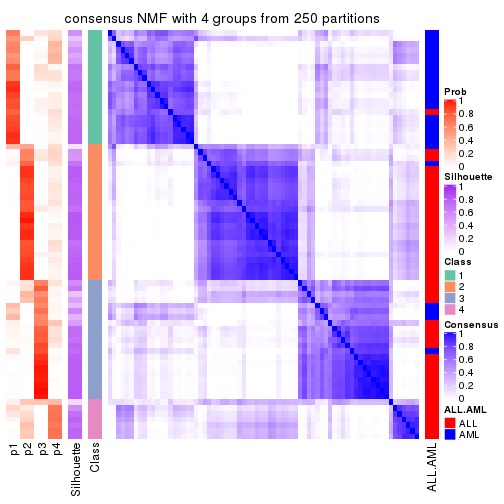
consensus_heatmap(res, k = 5)
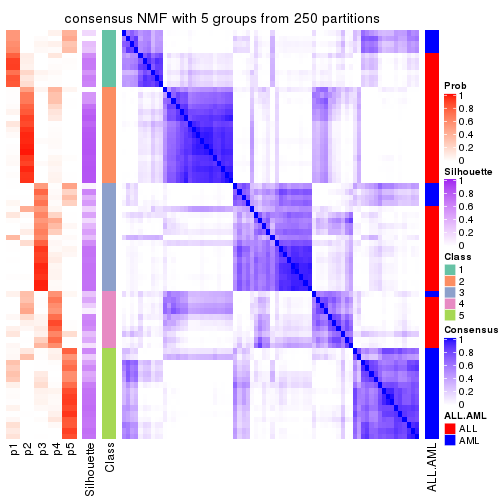
consensus_heatmap(res, k = 6)
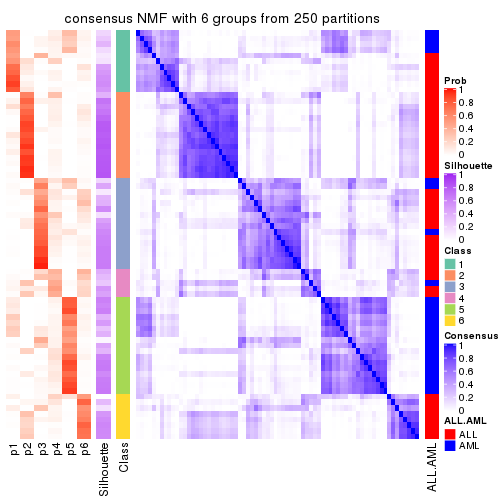
Heatmaps for the membership of samples in all partitions to see how consistent they are:
membership_heatmap(res, k = 2)
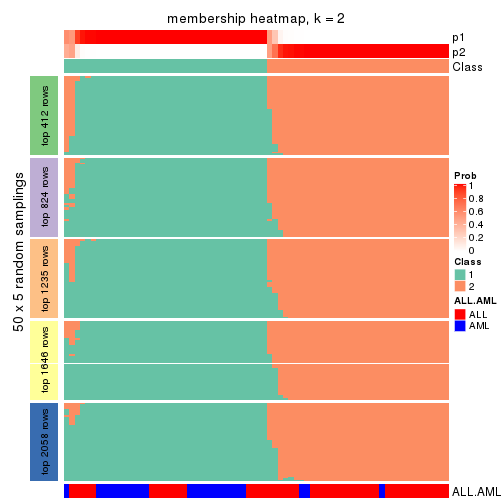
membership_heatmap(res, k = 3)
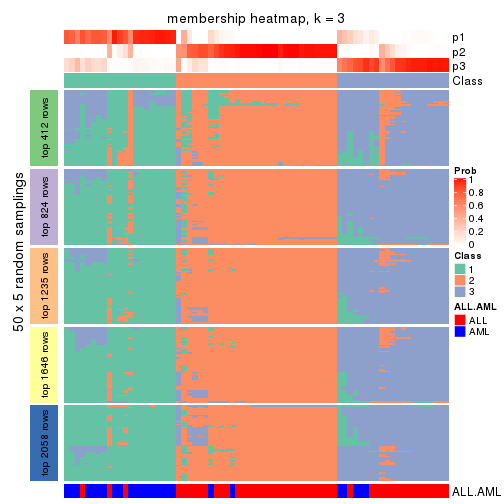
membership_heatmap(res, k = 4)
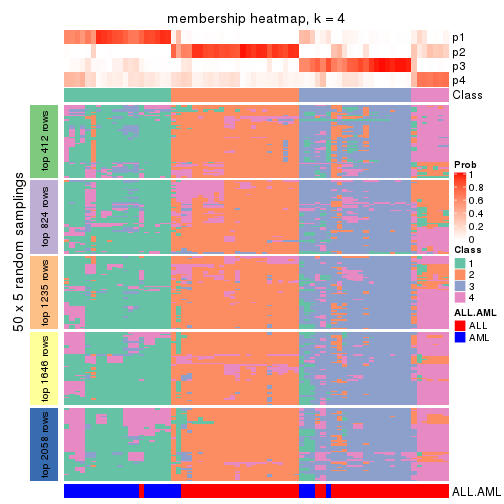
membership_heatmap(res, k = 5)
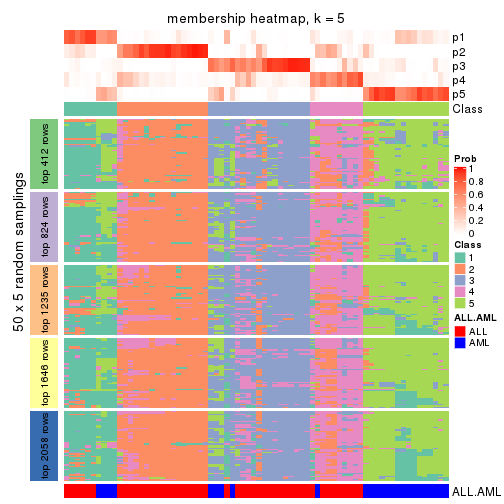
membership_heatmap(res, k = 6)
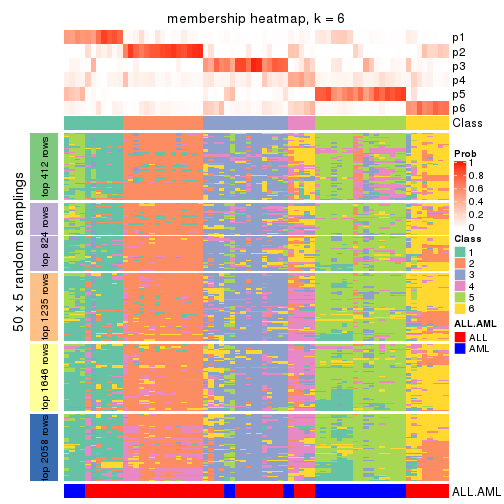
As soon as we have had the classes for columns, we can look for signatures which are significantly different between classes which can be candidate marks for certain classes. Following are the heatmaps for signatures.
Signature heatmaps where rows are scaled:
get_signatures(res, k = 2)
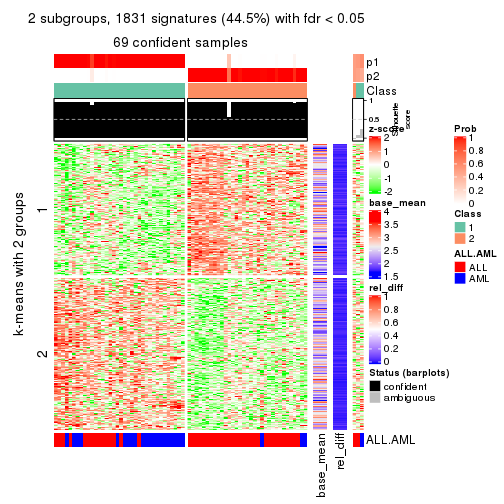
get_signatures(res, k = 3)
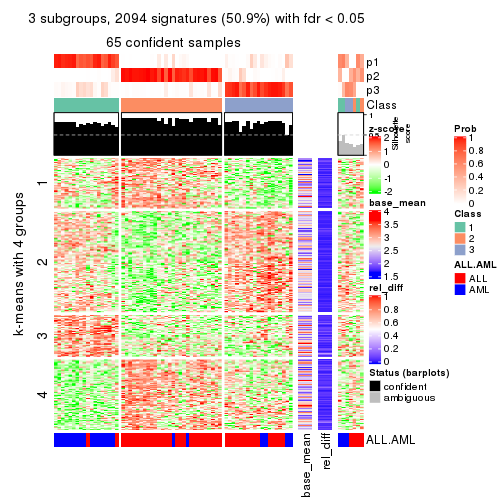
get_signatures(res, k = 4)
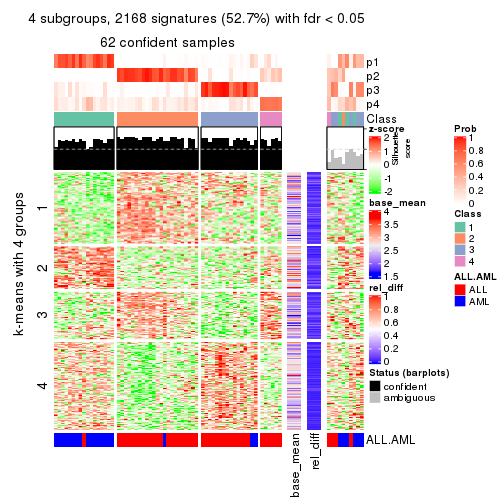
get_signatures(res, k = 5)
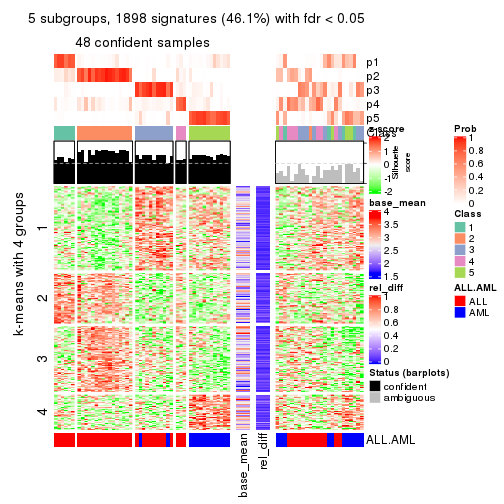
get_signatures(res, k = 6)
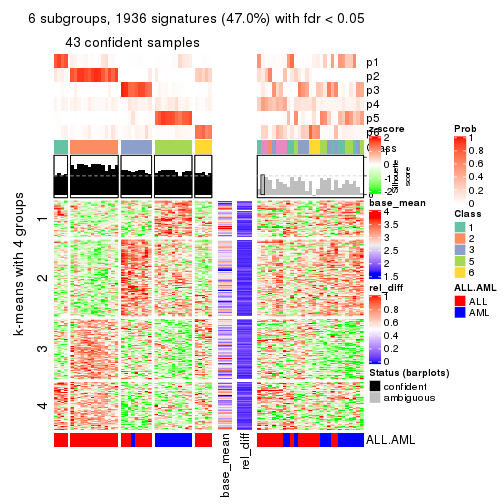
Signature heatmaps where rows are not scaled:
get_signatures(res, k = 2, scale_rows = FALSE)
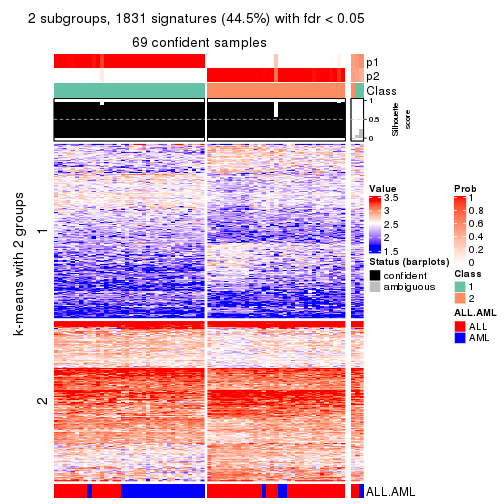
get_signatures(res, k = 3, scale_rows = FALSE)
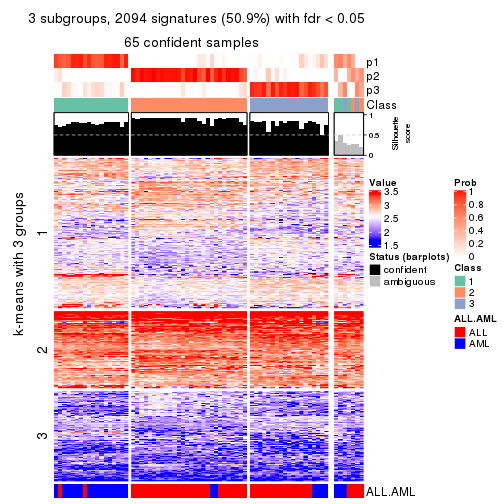
get_signatures(res, k = 4, scale_rows = FALSE)
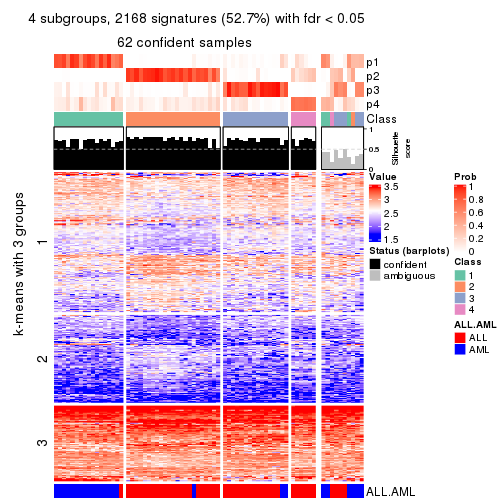
get_signatures(res, k = 5, scale_rows = FALSE)
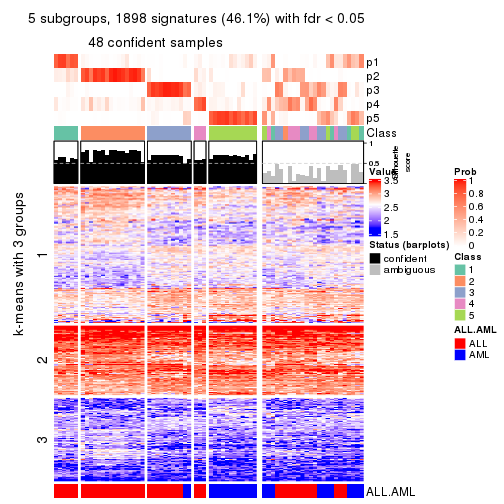
get_signatures(res, k = 6, scale_rows = FALSE)
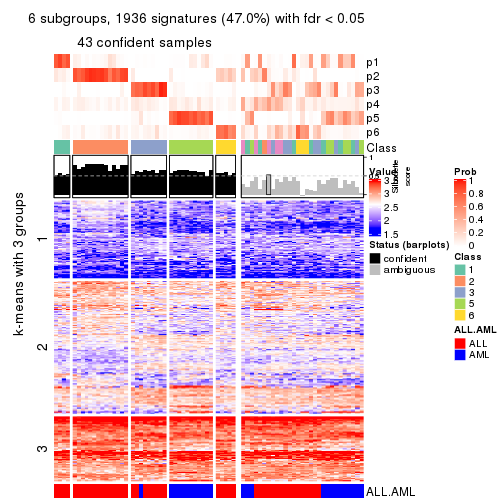
Compare the overlap of signatures from different k:
compare_signatures(res)
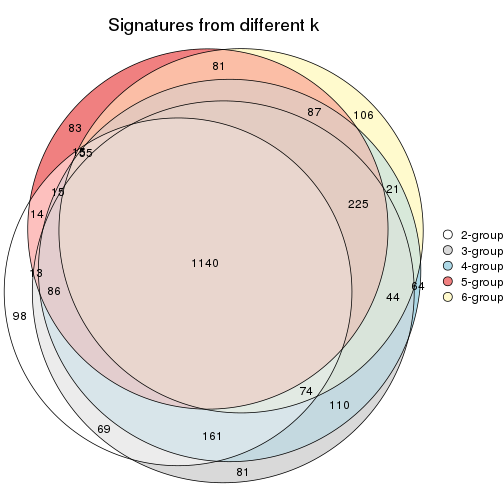
get_signature() returns a data frame invisibly. TO get the list of signatures, the function
call should be assigned to a variable explicitly. In following code, if plot argument is set
to FALSE, no heatmap is plotted while only the differential analysis is performed.
# code only for demonstration
tb = get_signature(res, k = ..., plot = FALSE)
An example of the output of tb is:
#> which_row fdr mean_1 mean_2 scaled_mean_1 scaled_mean_2 km
#> 1 38 0.042760348 8.373488 9.131774 -0.5533452 0.5164555 1
#> 2 40 0.018707592 7.106213 8.469186 -0.6173731 0.5762149 1
#> 3 55 0.019134737 10.221463 11.207825 -0.6159697 0.5749050 1
#> 4 59 0.006059896 5.921854 7.869574 -0.6899429 0.6439467 1
#> 5 60 0.018055526 8.928898 10.211722 -0.6204761 0.5791110 1
#> 6 98 0.009384629 15.714769 14.887706 0.6635654 -0.6193277 2
...
The columns in tb are:
which_row: row indices corresponding to the input matrix.fdr: FDR for the differential test. mean_x: The mean value in group x.scaled_mean_x: The mean value in group x after rows are scaled.km: Row groups if k-means clustering is applied to rows.UMAP plot which shows how samples are separated.
dimension_reduction(res, k = 2, method = "UMAP")
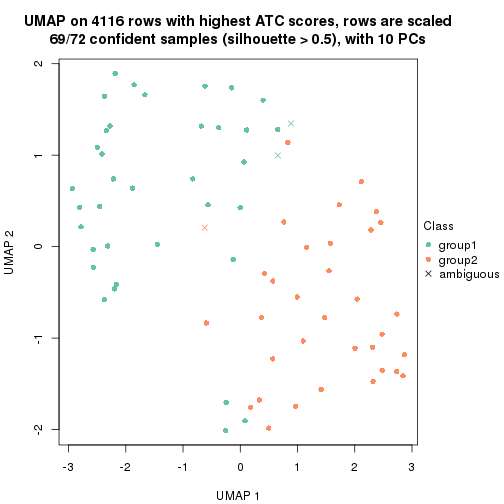
dimension_reduction(res, k = 3, method = "UMAP")
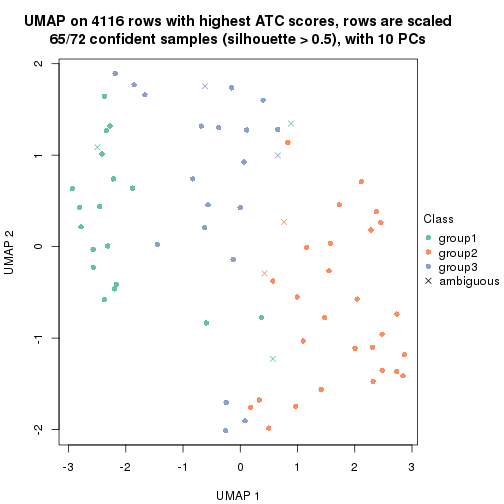
dimension_reduction(res, k = 4, method = "UMAP")
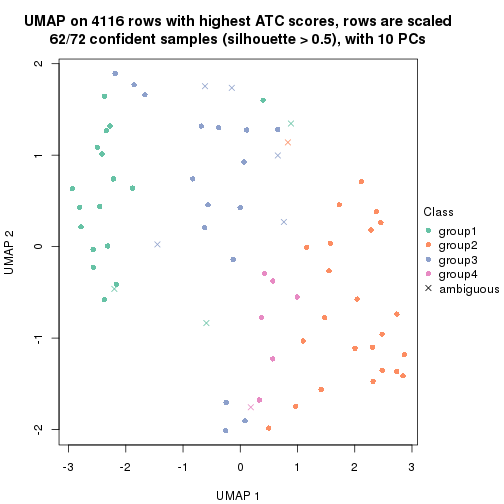
dimension_reduction(res, k = 5, method = "UMAP")
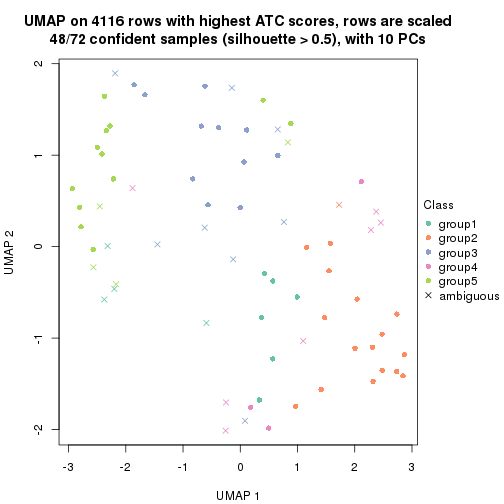
dimension_reduction(res, k = 6, method = "UMAP")
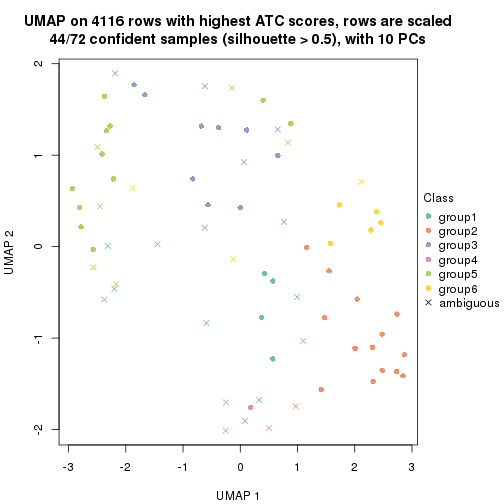
Following heatmap shows how subgroups are split when increasing k:
collect_classes(res)
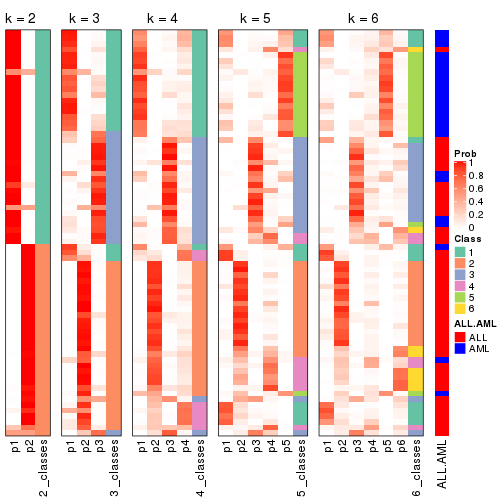
Test correlation between subgroups and known annotations. If the known annotation is numeric, one-way ANOVA test is applied, and if the known annotation is discrete, chi-squared contingency table test is applied.
test_to_known_factors(res)
#> n ALL.AML(p) k
#> ATC:NMF 69 5.41e-05 2
#> ATC:NMF 65 2.97e-08 3
#> ATC:NMF 62 1.00e-09 4
#> ATC:NMF 48 4.17e-08 5
#> ATC:NMF 44 1.87e-07 6
If matrix rows can be associated to genes, consider to use functional_enrichment(res,
...) to perform function enrichment for the signature genes. See this vignette for more detailed explanations.
sessionInfo()
#> R version 3.6.0 (2019-04-26)
#> Platform: x86_64-pc-linux-gnu (64-bit)
#> Running under: CentOS Linux 7 (Core)
#>
#> Matrix products: default
#> BLAS: /usr/lib64/libblas.so.3.4.2
#> LAPACK: /usr/lib64/liblapack.so.3.4.2
#>
#> locale:
#> [1] LC_CTYPE=en_GB.UTF-8 LC_NUMERIC=C LC_TIME=en_GB.UTF-8
#> [4] LC_COLLATE=en_GB.UTF-8 LC_MONETARY=en_GB.UTF-8 LC_MESSAGES=en_GB.UTF-8
#> [7] LC_PAPER=en_GB.UTF-8 LC_NAME=C LC_ADDRESS=C
#> [10] LC_TELEPHONE=C LC_MEASUREMENT=en_GB.UTF-8 LC_IDENTIFICATION=C
#>
#> attached base packages:
#> [1] grid stats graphics grDevices utils datasets methods base
#>
#> other attached packages:
#> [1] genefilter_1.66.0 ComplexHeatmap_2.3.1 markdown_1.1 knitr_1.26
#> [5] GetoptLong_0.1.7 cola_1.3.2
#>
#> loaded via a namespace (and not attached):
#> [1] circlize_0.4.8 shape_1.4.4 xfun_0.11 slam_0.1-46
#> [5] lattice_0.20-38 splines_3.6.0 colorspace_1.4-1 vctrs_0.2.0
#> [9] stats4_3.6.0 blob_1.2.0 XML_3.98-1.20 survival_2.44-1.1
#> [13] rlang_0.4.2 pillar_1.4.2 DBI_1.0.0 BiocGenerics_0.30.0
#> [17] bit64_0.9-7 RColorBrewer_1.1-2 matrixStats_0.55.0 stringr_1.4.0
#> [21] GlobalOptions_0.1.1 evaluate_0.14 memoise_1.1.0 Biobase_2.44.0
#> [25] IRanges_2.18.3 parallel_3.6.0 AnnotationDbi_1.46.1 highr_0.8
#> [29] Rcpp_1.0.3 xtable_1.8-4 backports_1.1.5 S4Vectors_0.22.1
#> [33] annotate_1.62.0 skmeans_0.2-11 bit_1.1-14 microbenchmark_1.4-7
#> [37] brew_1.0-6 impute_1.58.0 rjson_0.2.20 png_0.1-7
#> [41] digest_0.6.23 stringi_1.4.3 polyclip_1.10-0 clue_0.3-57
#> [45] tools_3.6.0 bitops_1.0-6 magrittr_1.5 eulerr_6.0.0
#> [49] RCurl_1.95-4.12 RSQLite_2.1.4 tibble_2.1.3 cluster_2.1.0
#> [53] crayon_1.3.4 pkgconfig_2.0.3 zeallot_0.1.0 Matrix_1.2-17
#> [57] xml2_1.2.2 httr_1.4.1 R6_2.4.1 mclust_5.4.5
#> [61] compiler_3.6.0